WINONASTATE UNIVERSITY
A History of One Hundred Twenty-Five Years
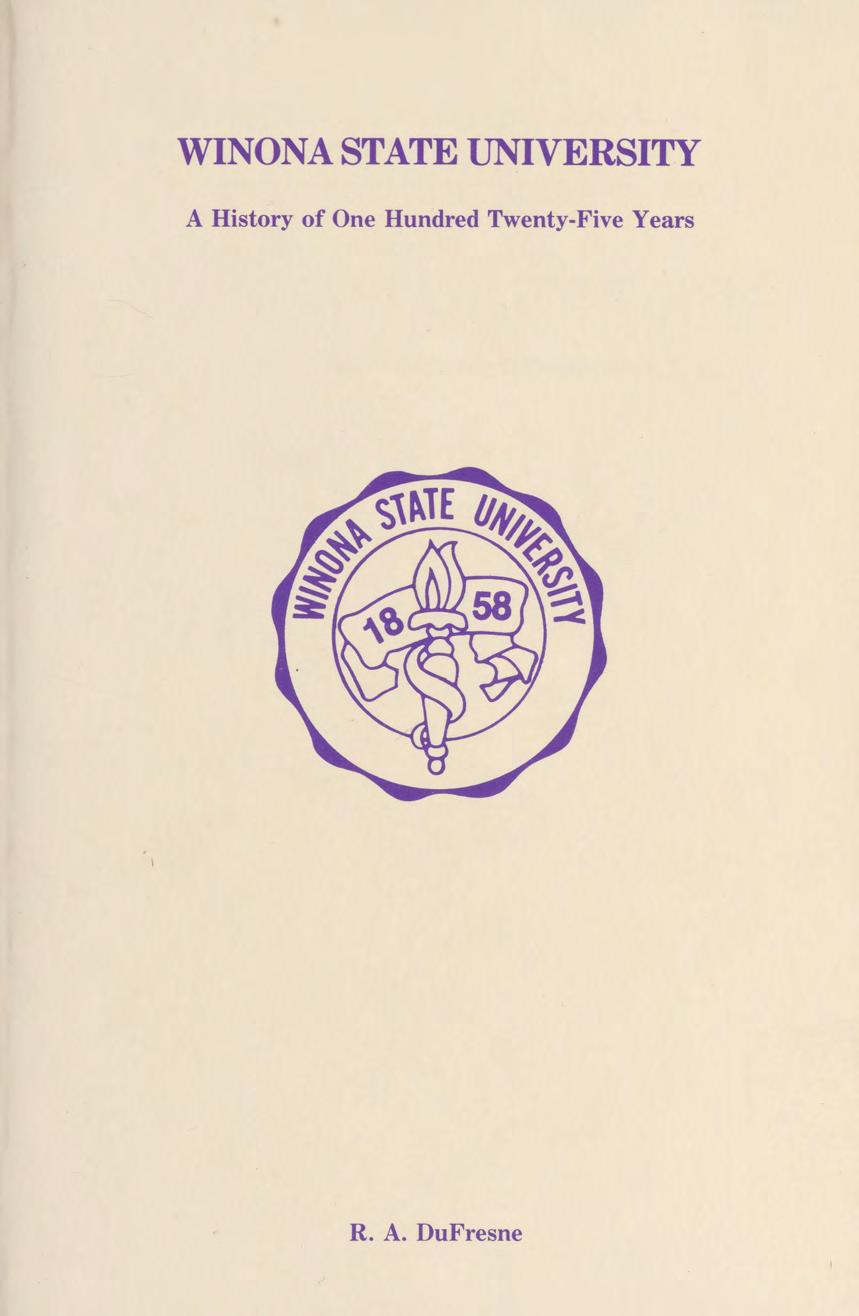
R. A. DuFresne

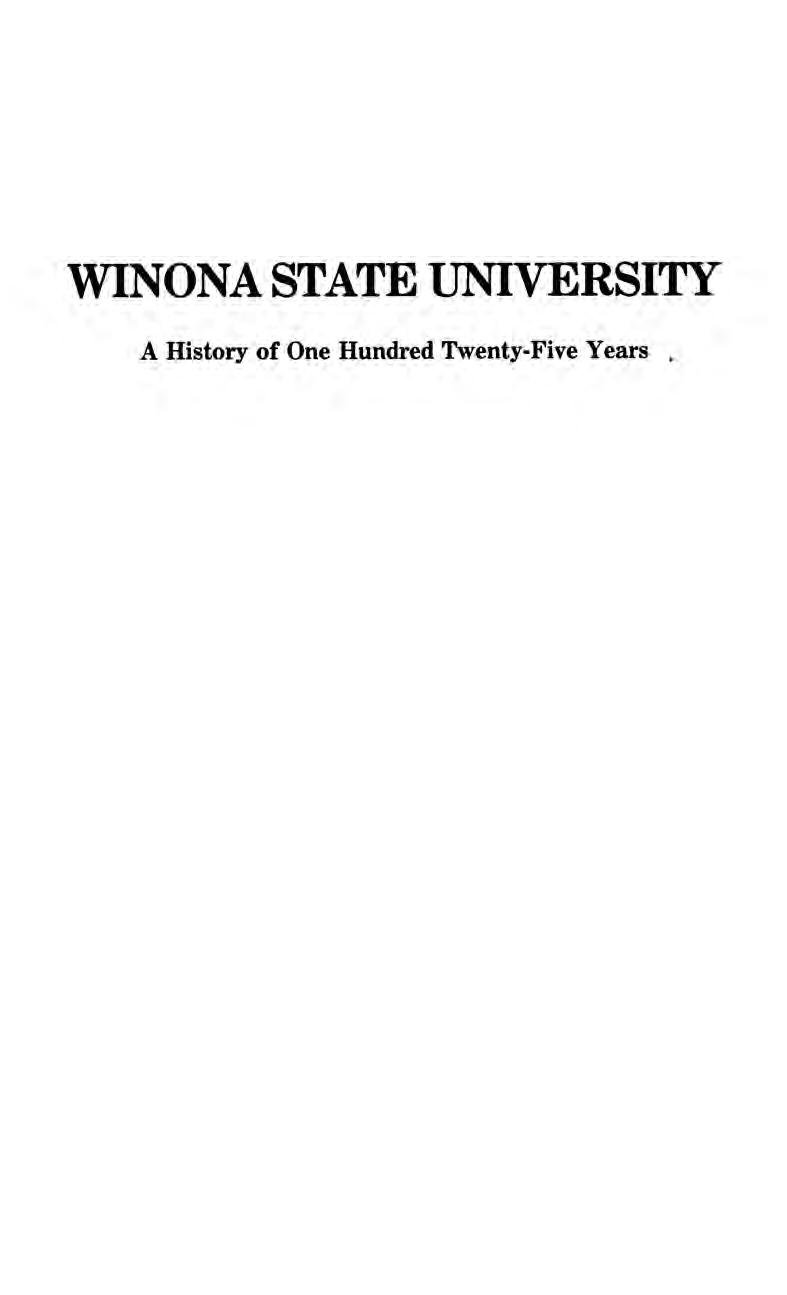

A History of One Hundred Twenty-Five Years

R. A. DuFresne


A History of One Hundred Twenty-Five Years


To thosesteadfast souls whose vision and courage established here the foundations upon which succeeding generations would build.

Copyright 1985 by Winona State University Library of Congress Catalog Card Number: 85-50717
Printed in the United States of America
All Rights Reserved
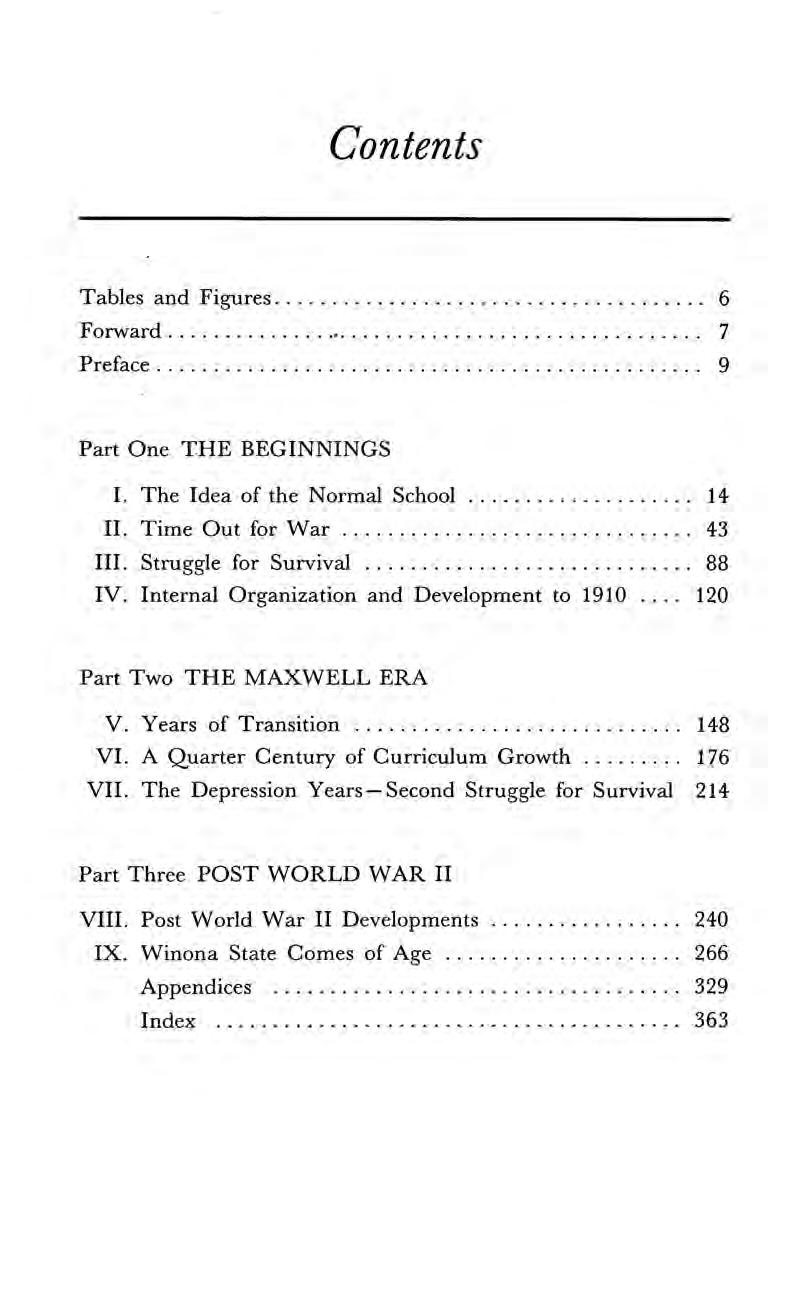
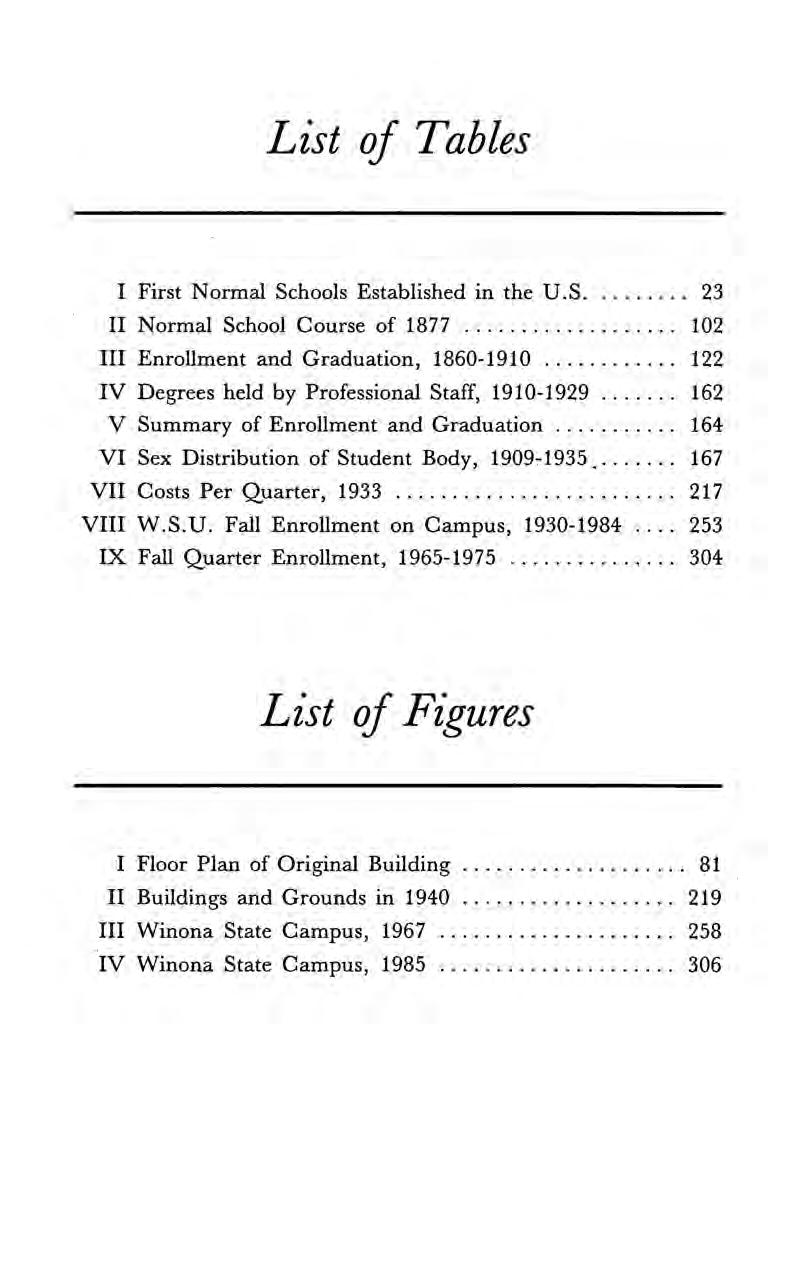

Everyone admires success. In relating the history of Winona State University, Dr. Robert DuFresne shares with his readers a great success story —the events and circumstances that have created this outstanding institution. Published on the occasion of the one hundred and twenty-fifth anniversary of the founding of Winona State, the book is timely, serving to remind us that if we are to plan our future, we must have an understanding of from whence we have come.
No one is better qualified to tell the story of Winona State than is Dr. DuFresne. Having served with distinction as President of Winona State for over a decade, from 1967 to 1977, he is currently a Distinguished Service Professor in political science. In addition to his professional duties Dr. DuFresne serves the University in special areas where his experience and expertise are unusually beneficial. While we know that writing a university history is usually a labor of love—and this work is no exception—it is also a task demanding long hours of painstaking detail. With clarity and great care Dr. DuFresne chroniclesthe transformation of a struggling normal school with thirty-one students into a regional comprehensive university with a student body of over five thousand. ‘Throughout the book the reader will be impressed with the strong resolve shown by faculty and staff in building and maintaininga fine institution of higher learning designed to serve the citizens of Minnesota. Through strong commitment and dedication the school became not only a place to prepare teachers (thousands of them) to teach children (millions of them), but it also became a symbol of civilization in a pioneer land.
I trust that the readers of this book will find, as I have, that the book describes a legacy and creates an appreciation for Winona State’s distinguished past. At the same time the book heightens an understanding of the present and sharpens a focus on the future for this fine old institution.
Thomas F. Stark President Winona State University


The history of WSU falls rather neatly into three eras. The first began in 1860 when the doors first opened, and continued up to the turn of the Century, a span of forty years during which the school struggled just to exist in this rugged pioneer land during the early years of Minnesota’s statehood.
By 1900 the institution had become firmly established, at least to the point where it was receiving regular if insufficient funding from the legislature, and was beginning to assume a few of the physical and scholarly characteristics of an academic enterprise. At that point it needed a strong president who would lead it out from its historic confines of “normal training” to where it could become a regular four-year teachers college with full accreditation and genuine degree offerings.
It found that leader in the person of Guy Maxwell who was to be its mentor for nearly forty years and under whom the Normal would mature and develop in spite of a major war and a major depression. This period extended from about 1900 to the time of Maxwell’s death in 1939 and the beginning of World War II.
The third period began at that point and continues on through the date of this publication, again a period of about forty years. During this era the institution changed even more dramatically than during the Maxwell years, going from the status of a well-established teachers college through that of a rapidly growing state college whose teacher education role was steadily being challenged by the growth of other professional and liberal arts programs, until in 1975 it assumed the title, Winona State University. By then it was a regional institution of 4,000 students offering a variety of programs and options not even dreamed of forty years earlier.
The development of Winona State from its beginnings in 1860 through its Centennial in 1960 has been recorded in three separate works. The first of these, entitled HISTORICAL SKETCHES AND NOTES: Winona State Normal School 1860-1910, was compiled by C. O. Ruggles, a member of the history faculty. It is a relatively com-
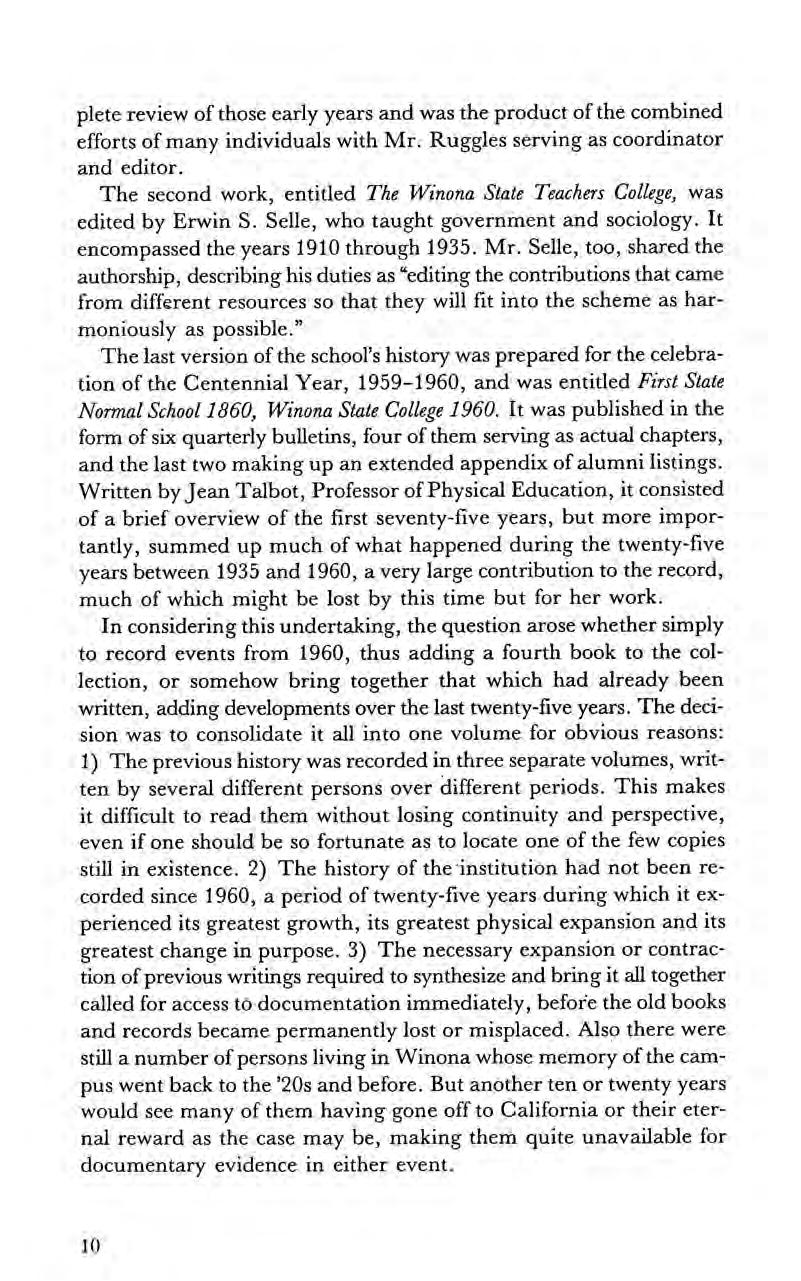
plete review of those early years and was the product of the combined efforts of many individuals with Mr. Ruggles serving as coordinator and editor.
The second work, entitled The Winona State Teachers College, was edited by Erwin S. Selle, who taught government and sociology. It encompassed the years 1910 through 1935. Mr. Selle, too, shared the authorship, describing his duties as “editing the contributions that came from different resources so that they will fit into the scheme as harmoniously as possible.”
The last version of the school’s history was prepared for the celebration of the Centennial Year, 1959-1960, and was entitled First State Normal School 1860, Winona State College 1960. It was published in the form of six quarterly bulletins, four of them serving as actual chapters, and the last two making up an extended appendix of alumni listings. Written byJean Talbot, Professor of Physical Education, it consisted of a brief overview of the first seventy-five years, but more importantly, summed up much of what happened during the twenty-five years between 1935 and 1960, a very large contribution to the record, much of which might be lost by this time but for her work.
In considering this undertaking, the question arose whether simply to record events from 1960, thus adding a fourth book to the collection, or somehow bring together that which had already been written, adding developments over the last twenty-five years. The decision was to consolidate it all into one volume for obvious reasons: 1) The previous history was recorded in three separate volumes, written by several different persons over different periods. This makes it difficult to read them without losing continuity and perspective, even if one should be so fortunate as to locate one of the few copies still in existence. 2) The history of the institution had not been recorded since 1960, a period of twenty-five years during which it experienced its greatest growth, its greatest physical expansion and its greatest change in purpose. 3) The necessary expansion or contraction of previous writings required to synthesize and bring it all together called for access to documentation immediately, before the old books and records became permanently lost or misplaced. Also there were still a number of persons living in Winona whose memory of the campus went back to the ’20s and before. But another ten or twenty years would see many of them having gone off to California or their eternal reward as the case may be, making them quite unavailable for documentary evidence in either event.
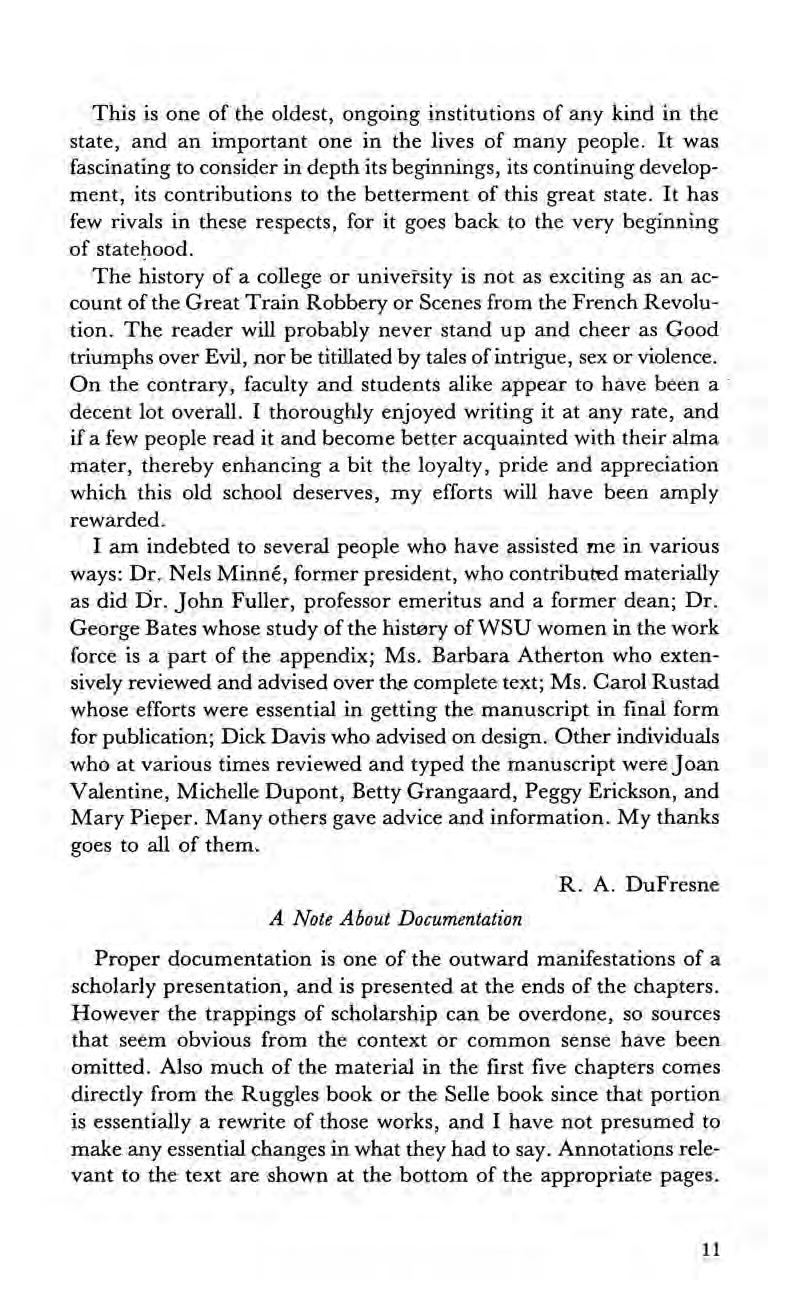
This is one of the oldest, ongoing institutions of any kind in the state, and an important one in the lives of many people. It was fascinating to consider in depth its beginnings, its continuing development, its contributions to the betterment of this great state. It has few rivals in these respects, for it goes back to the very beginning of statehood.
The history of a college or univefYsity is not as exciting as an account of the Great Train Robbery or Scenes from the French Revolution. The reader will probably never stand up and cheer as Good triumphs over Evil, nor be titillated by tales of intrigue, sex or violence. On the contrary, faculty and students alike appear to have been a’ decent lot overall. I thoroughly enjoyed writing it at any rate, and if a few people read it and become better acquainted with their alma mater, thereby enhancinga bit the loyalty, pride and appreciation which this old school deserves, my efforts will have been amply rewarded.
I am indebted to several people who have assisted me in various ways: Dr. Nels Minné, former president, who contributed materially as did Dr. John Fuller, professor emeritus and a former dean; Dr. George Bates whose study of the histery of WSU women in the work force is a part of the appendix; Ms. Barbara Atherton who extensively reviewed and advised over the complete text; Ms. Carol Rustad whose efforts were essential in getting the manuscript in final form for publication; Dick Davis who advised on design. Other individuals who at various times reviewed and typed the manuscript were Joan Valentine, Michelle Dupont, Betty Grangaard, Peggy Erickson, and Mary Pieper. Many others gave advice and information. My thanks goes to all of them.
R. A. DuFresne
Proper documentation is one of the outward manifestations of a scholarly presentation, and is presented at the ends of the chapters. However the trappings of scholarship can be overdone, so sources that seem obvious from the context or common sense have been omitted. Also much of the material in the first five chapters comes directly from the Ruggles book or the Selle book since that portion is essentially a rewrite of those works, and I have not presumed to make any essential changes in what they had to say. Annotations relevant to the text are shown at the bottom of the appropriate pages.


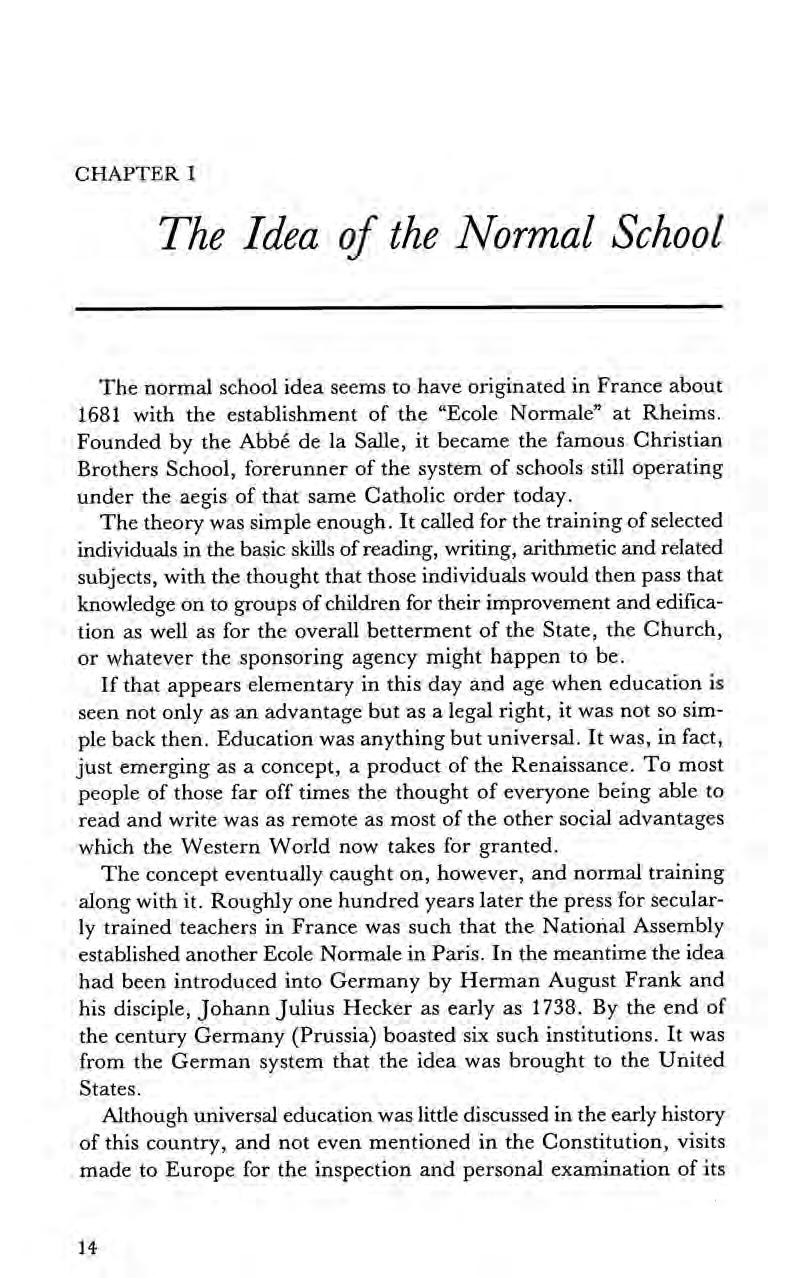
The normal school idea seems to have originated in France about 1681 with the establishment of the “Ecole Normale” at Rheims.
Founded by the Abbé de la Salle, it became the famous Christian Brothers School, forerunner of the system of schools still operating under the aegis of that same Catholic order today.
The theory was simple enough. It called for the training of selected individuals in the basic skills of reading, writing, arithmetic and related subjects, with the thought that those individuals would then pass that knowledge on to groups of children for their improvement and edification as well as for the overall betterment of the State, the Church, or whatever the sponsoring agency might happen to be.
If that appears elementary in this day and age when education is seen not only as an advantage but as a legal right, it was not so simple back then. Education was anything but universal. It was, in fact, just emerging as a concept, a product of the Renaissance. To most people of those far off times the thought of everyone being able to read and write was as remote as most of the other social advantages which the Western World now takes for granted.
The concept eventually caught on, however, and normal training along withit. Roughly one hundred years later the press for secularly trained teachers in France was such that the National Assembly established another Ecole Normale in Paris. In the meantime the idea had been introduced into Germany by Herman August Frank and his disciple, Johann Julius Hecker as early as 1738. By the end of the century Germany (Prussia) boasted six such institutions. It was from the German system that the idea was brought to the United States.
Although universal education was little discussed in the early history of this country, and not even mentioned in the Constitution, visits made to Europe for the inspection and personal examination of its
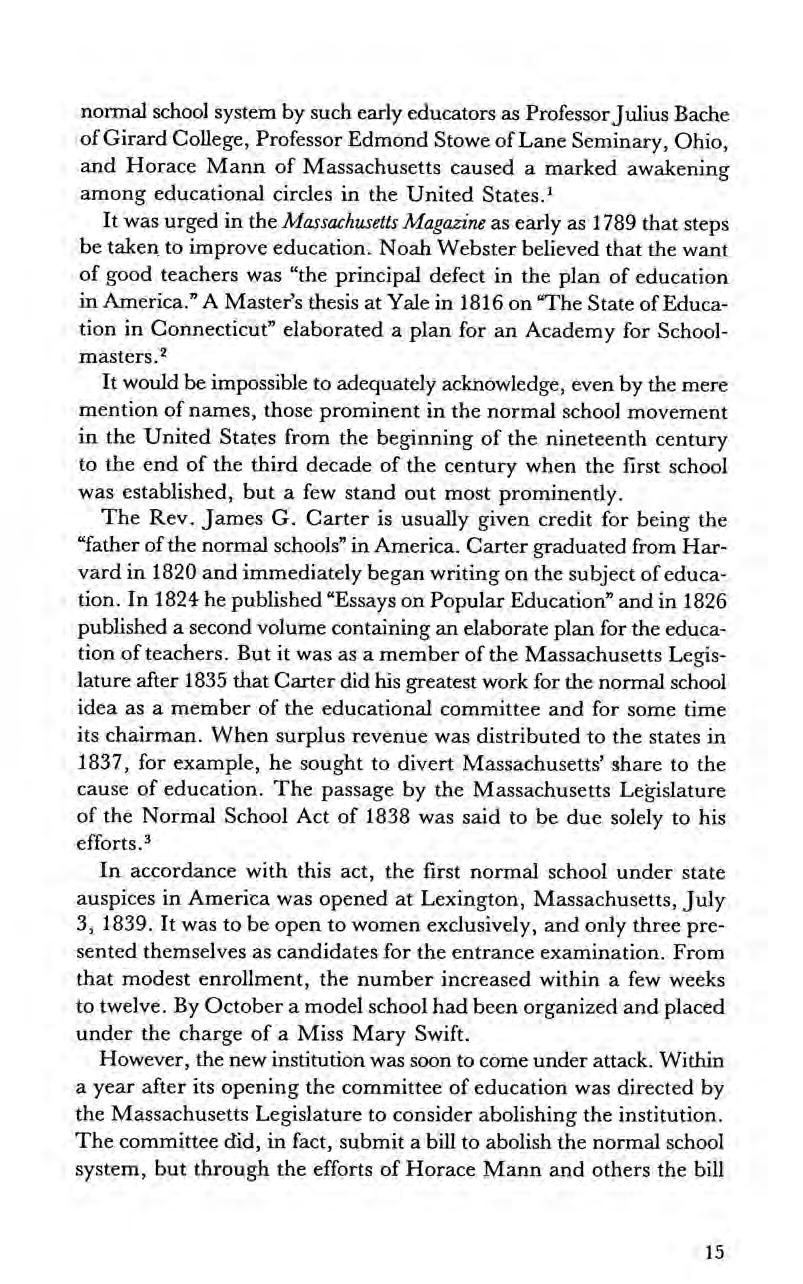
normal school system by such early educators as Professor Julius Bache ofGirard College, Professor Edmond Stowe of Lane Seminary, Ohio, and Horace Mann of Massachusetts caused a marked awakening among educational circles in the United States.!
It was urged in the Massachusetts Magazine as early as 1789 that steps be taken to improve education. Noah Webster believed that the want of good teachers was “the principal defect in the plan of education in America.” A Master’s thesis at Yale in 1816 on “The State of Education in Connecticut” elaborated a plan for an Academy for Schoolmasters.”
It would be impossible to adequately acknowledge, even by the mere mention of names, those prominent in the normal school movement in the United States from the beginning of the nineteenth century to the end of the third decade of the century when the first school was established, but a few stand out most prominently.
The Rev. James G. Carter is usually given credit for being the “father ofthe normal schools” in America. Carter graduated from Harvard in 1820 and immediately began writing on the subject of education. In 1824 he published “Essays on Popular Education” and in 1826 published a second volume containing an elaborate plan for the education of teachers. But it was as a member of the Massachusetts Legislature after 1835 that Carter did his greatest work for the normal school idea as a member of the educational committee and for some time its chairman. When surplus revenue was distributed to the states in 1837, for example, he sought to divert Massachusetts’ share to the cause of education. The passage by the Massachusetts Legislature of the Normal School Act of 1838 was said to be due solely to his efforts.%
In accordance with this act, the first normal school under state auspices in America was opened at Lexington, Massachusetts, July 3, 1839. It was to be open to women exclusively, and only three presented themselves as candidates for the entrance examination. From that modest enrollment, the number increased within a few weeks to twelve. By October a model school had been organized and placed under the charge of a Miss Mary Swift.
However, the new institution was soon to come under attack. Within a year after its opening the committee of education was directed by the Massachusetts Legislature to consider abolishing the institution. The committee did, in fact, submita bill to abolish the normal school system, but through the efforts of Horace Mann and others the bill
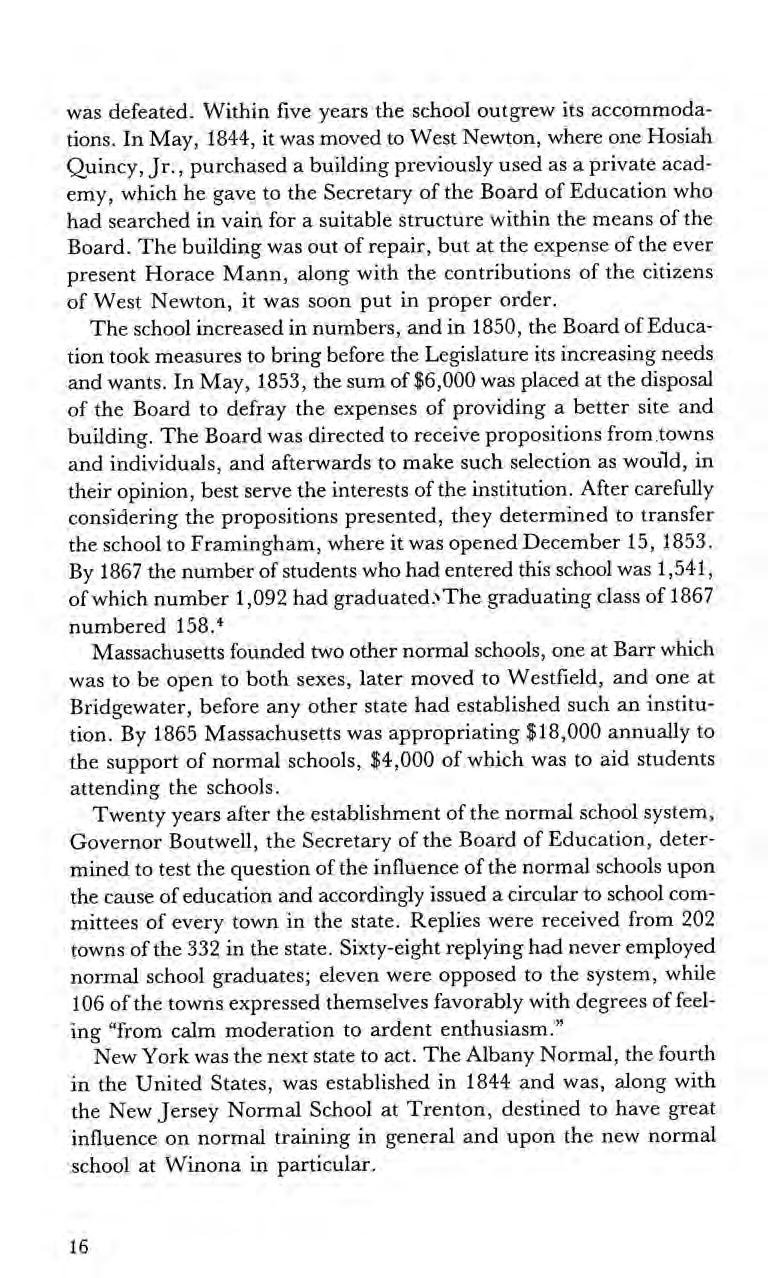
was defeated. Within five years the school outgrew its accommodations. In May, 1844, it was moved to West Newton, where one Hosiah Quincy, Jr., purchased a building previously used as a private academy, which he gave to the Secretary of the Board of Education who had searched in vain for a suitable structure within the means of the Board. The building was out of repair, but at the expense of the ever present Horace Mann, along with the contributions of the citizens of West Newton, it was soon put in proper order.
The school increased in numbers, and in 1850, the Board of Education took measures to bring before the Legislature its increasing needs and wants. In May, 1853, the sum of $6,000 was placed at the disposal of the Board to defray the expenses of providing a better site and building. The Board was directed to receive propositions from towns and individuals, and afterwards to make such selection as would, in their opinion, best serve the interests of the institution. After carefully considering the propositions presented, they determined to transfer the school to Framingham, where it was opened December 15, 1853. By 1867 the number of students who had entered this school was 1,541, ofwhich number 1,092 had graduated»The graduating class of 1867 numbered 158.
Massachusetts founded two other normal schools, one at Barr which was to be open to both sexes, later moved to Westfield, and one at Bridgewater, before any other state had established such an institution. By 1865 Massachusetts was appropriating $18,000 annually to the support of normal schools, $4,000 of which was to aid students attending the schools.
Twenty years after the establishment of the normal school system, Governor Boutwell, the Secretary of the Board of Education, determined to test the question of the influence of the normal schools upon the cause of education and accordingly issueda circular to school committees of every town in the state. Replies were received from 202 towns of the 332 in the state. Sixty-eight replying had never employed normal school graduates; eleven were opposed to the system, while 106 of the towns expressed themselves favorably with degrees of feeling “from calm moderation to ardent enthusiasm.”
New York was the next state to act. The Albany Normal, the fourth in the United States, was established in 1844 and was, along with the New Jersey Normal School at Trenton, destined to have great influence on normal training in general and upon the new normal school at Winona in particular.

The importance of education seems to have been recognized early on in Minnesota. In the act of March 3, 1849, which organized Minnesota into a territory, the school system of the future was duly considered.> According to section eighteen of this act, one eighteenth of all the land in the territory was to be set aside for school purposes. This liberal support of education was no small factor in bringing many eastern people into the new territory as can be surmised from a paragraph taken from the report of the First Normal Board:
The pioneers ofthe Territory (now State) from 1849 to 1857 came here many of them expecting mote than ordinary educational advantages when we becamea state on account of the very large appropriation of lands for that purpose. The present population has had an average of four or five years’ residence, and unless these anticipated advantages shall be enjoyed within the next five years, that class of persons between the ages of six and sixteen at the time of emigration will have passed beyond their reach; a more meritorious class will never occupy their places. Their deprivations cannot be computed in dollars and cents; even now with the most prompt action, but little can be done for them. But what they lost, it is our duty to secure to their children.®
The framers of Minnesota’s constitution also warmly endorsed the idea of popular education. It was their belief that it was the duty of the Legislature to establish and provide for public education, and they placed in the constitution (Art. VIII, Section 1) a positive declaration to that effect.
The Governor of Minnesota in his message to the Legislature in 1857 stated that the cause of education had “by no means been neglected in the midst of the strife for wealth and speculation,” and he called legislators’ special attention to the report of the superintendent of public instruction. This report maintained that “to make a state requires more than the axe, the saw and the water-wheel; mind, knowledge, and education are required as well to make as to govern; for the children of today may be the rulers a quarter of a century hence.” The superintendent further maintained that it was doubly important, in new countries whose institutions in a measure are yet to be formed, and formed by the people themselves, that school facilities should be as numerous and widely extended as possible. He noted

that small communities wereno sooner settled within a tew miles of each otherthan the voice of all demanded a school for their children.’
The bill which actually established the normal school system of Minnesota was introduced into the House of Representatives on July 17, 1858, byJoseph Peckham. It was read a second time July 23, 1858, and passed by the House bya vote of forty-five to four 6n July 27, 1858.
On July 28 the bill was reada first time in the Senate. On July 29 the Senate Committee to which the bill had been referred, recommended its passage without amendments. By a unanimous vote of twenty to zero the bill passed the Senate on July 30, 1858, and on August 2 was approved by Governor Sibley.® Because of its historical significance in establishing the normal school system the act is reproduced here in its entirety.
Sec. 1. There shall be established within five years after the passage of this act, an institution to educate and prepare teachers for teaching in the common schools of this State, to be called a State Normal School. There shall be established within ten years after the passage of this act, a second State Normal School, and within fifteen years a third: PROVIDED, there shall be no obligations to establish the first Normal School until the sum of $5,000 is donated to the State in money and lands, or in money alone, for the erection of the necessary buildings and for the support of the professors or teachers in such institution, but when such sum is donated for such purpose, a like sum of $5,000 shall be, and hereby is appropriated by the legislature on the order of the proper officers, and shall be paid out of any moneys in the Treasury not otherwise appropriated by law, for the use and benefit of such institution.
Sec. 2. Whenever a second sum of $5,000 shall have been donated to the State for the establishment of a second State Normal School, a like sum of $5,000 shall be and hereby is appropriated by the legislature, and shall be on order of the proper

officers, paid out of any moneys in the Treasury not otherwise appropriated by law, for the use and benefit of such institution.
Sec. 3. Whenever a third sum of $5,000 shall havebeen donated to the State for the establishment of a third State Normal School, a like sum of $5,000 shall be and hereby is appropriated by the legislature, and on the order of the proper officers shall be paid out of any moneys in the Treasury, not otherwise appropriated by law, for the use and benefit of such institution.
Sec. 4. The Governor, within thirty days after the passage of this act, shall appoint six electors, one from each judicial district, who shall constitute the State Normal School Board of Instruction. Those appointed from the even judicial districts shall hold their offices for the term of four years, and those appointed from the odd judicial districts shall hold their office for the term of two years. The Legislature shall, during its session in 1860, elect three Normal Directors to fill the vacancies created by the expiration of the term of office of the three directors appointed from odd districts, and biennially thereafter, the Legislature shall elect three directors to fill the vacancies created by this act. The Legislature shall also fill from time to time all vacancies that may arise by death, resignation, removal from the State, or otherwise; PROVIDED, that the Normal Board shall have power to fill any vacancy occurring during the recess of the Legislature till its next meeting.
Sec. 5. The Normal Board, at their first meeting, which shall be held at the capitol of the State, shall severally take and subscribe an oath or affirmation to support the constitution of the United States and of the State of Minnesota, and faithfully to execute the trust and discharge the duties of their office. ‘They shall elect one oftheir number president, who shall continue in office for two years and until his successor is chosen, and they shall appoint some suitable person as treasurer, who shall hold his office for one year, but may be removed at any time at the pleasure of the Board. The treasurer, before entering upon the duties of his office, shall give bonds in the penal sum of $5,000, faithfully to execute the trust and discharge the duties of his office. The State Superintendent of Public Instruction shall be exofficio a member of the Normal Board, and shall be secretary of the same.

Sec. 6. Immediately after the organization of the Board, they shall proceed to divide the State into three Normal Districts, uniting in the formation of the first, two contiguous Judicial districts, of the second, two, and of the third, two.
Sec. 7. The Normal Schools provided for in this act shall be located by the Normal Board, but only one shall be located in any one Normal District. In locating any one Normal School, the Board shall have due regard to healthfulness and beauty of situation, to accessibility and general convenience, to the wants of the common schools, and the wishes of donorswho may make munificent donations, conditioned upon a particular location.
Sec. 8. It shall not be within the province of the Legislature or of the Normal Board, to remove any State Normal School from its original location, during the period of ten years from its establishment, without the consent of the donor or donors, who made to the State the first donation of $5,000 for the foundation of such school.
Sec. 9. The Normal Boards are authorized and empowered to contract for the erection of all buildings connected with the State Normal Schools, to appoint all professors or teachers in such institution, to prescribe the course of study and the prerequisites for admission, and in general to adopt all needful rules for the government of said schools.
Sec. 10. The Normal Board are authorized annually to appoint for each Normal School a Prudential Committee, consisting of three persons, one of whom shall be a member of said Board. Said Prudential Committee shall have the general oversight and management of the prudential affairs of the several schools, subject to the order of the Board, to whom they shall each make a detailed report of their doings, and of the condition and wants of the particular institution committed to their care.
Sec. 11. There shall be no charge for tution to persons who may be admitted to the privileges of any State Normal School and who shall sacredly engage to become teachers of the public schools of the State for such times and on such conditions as shall be prescribed by the Normal Board.
Sec. 12. The Board, through the State Superintendent, shall make an annual and detailed report of their doings to the Gover-
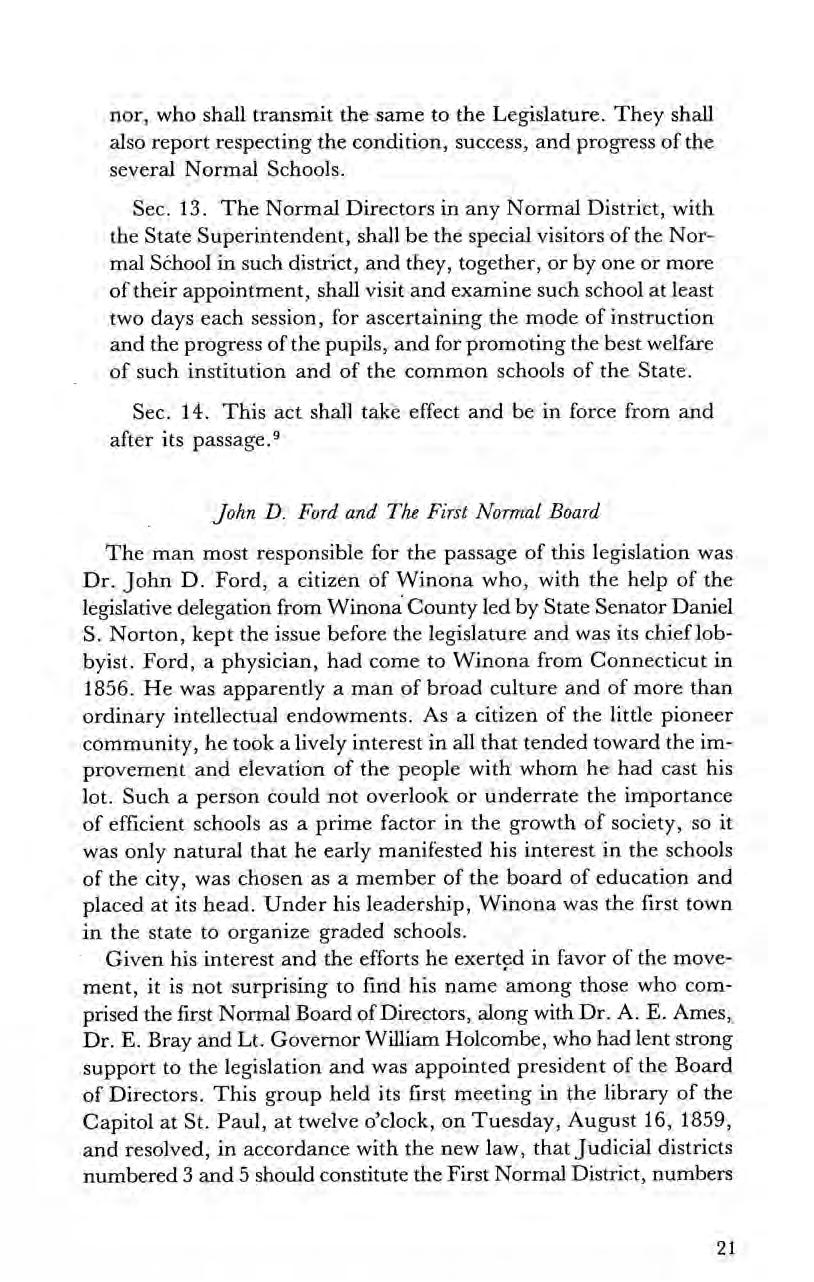
nor, who shall transmit the same to the Legislature. They shall also report respecting the condition, success, and progress of the several Normal Schools.
Sec. 13. The Normal Directors in any Normal District, with the State Superintendent, shall be the special visitors of the Normal School in such district, and they, together, or by one or more of their appointment, shall visit and examine such school at least two days each session, for ascertaining the mode of instruction and the progress of the pupils, and for promoting the best welfare of such institution and of the common schools of the State.
Sec. 14. This act shall take effect and be in force from and after its passage.?
The man most responsible for the passage of this legislation was Dr. John D. Ford, a citizen of Winona who, with the help of the legislative delegation from Winona County led by State Senator Daniel S. Norton, kept the issue before the legislature and was its chief lobbyist. Ford, a physician, had come to Winona from Connecticut in 1856. He was apparently a man of broad culture and of more than ordinary intellectual endowments. Asa citizen of the little pioneer community, he tooka lively interest in all that tended toward the improvement and elevation of the people with whom he had cast his lot. Such a person could not overlook or underrate the importance of efficient schools as a prime factor in the growth of society, so it was only natural that he early manifested his interest in the schools of the city, was chosen as a member of the board of education and placed at its head. Under his leadership, Winona was the first town in the state to organize graded schools. Given his interest and the efforts he exerted in favor of the movement, it is not surprising to find his name among those who comprised the first Normal Board of Directors, along with Dr. A. E. Ames, Dr. E. Bray and Lt. Governor William Holcombe, who had lent strong support to the legislation and was appointed president of the Board of Directors. This group held its first meeting in the library of the Capitol at St. Paul, at twelve o’clock, on Tuesday, August 16, 1859, and resolved, in accordance with the new law, that Judicial districts numbered 3 and 5 should constitute the First Normal District, numbers
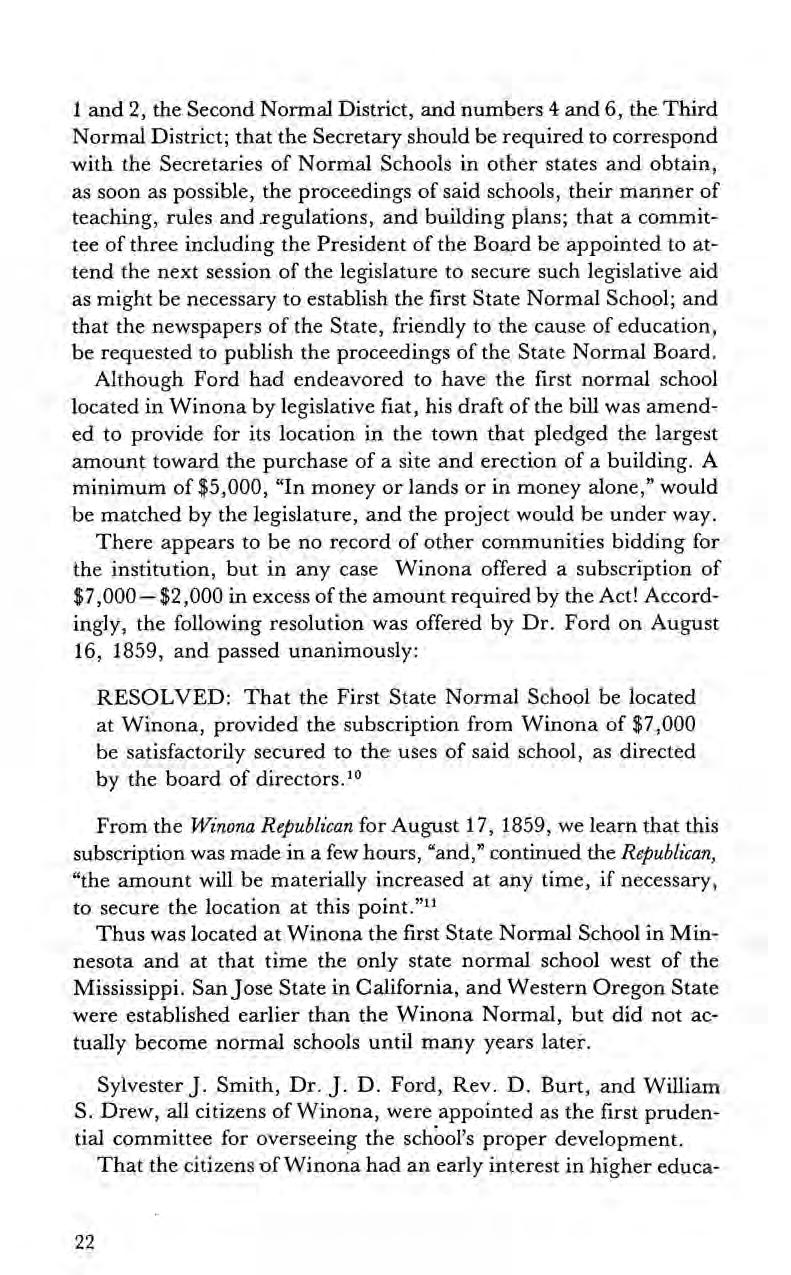
1 and 2, the Second Normal District, and numbers 4 and 6, the Third Normal District; that the Secretary should be required to correspond with the Secretaries of Normal Schools in other states and obtain, as soon as possible, the proceedings of said schools, their manner of teaching, rules and regulations, and building plans; that a committee of three including the President of the Board be appointed to attend the next session of the legislature to secure such legislative aid as might be necessary to establish the first State Normal School; and that the newspapers of the State, friendly to the cause of education, be requested to publish the proceedings of the State Normal Board.
Although Ford had endeavored to have the first normal school located in Winona by legislative fiat, his draft of the bill was amended to provide for its location in the town that pledged the largest amount toward the purchase of a site and erection of a building. A minimum of $5,000, “In money or lands or in money alone,” would be matched by the legislature, and the project would be under way. There appears to be no record of other communities bidding for the institution, but in any case Winona offered a subscription of $7,000 $2,000 in excess of the amount required by the Act! Accordingly, the following resolution was offered by Dr. Ford on August 16, 1859, and passed unanimously:
RESOLVED: That the First State Normal School be located at Winona, provided the subscription fromWinona of $7,000 be satisfactorily secured to the uses of said school, as directed by the board of directors.'°
From the Winona Republican for August 17, 1859, we learn that this subscription was made in a few hours, “and,” continued the Republican, “the amount will be materially increased at any time, if necessary, to secure the location at this point.”
Thus was located at Winona the first State Normal School in Minnesota and at that time the only state normal school west of the Mississippi. San Jose State in California, and Western Oregon State were established earlier than the Winona Normal, but did not actually become normal schools until many years later.
Sylvester J. Smith, Dr. J. D. Ford, Rev. D. Burt, and William S. Drew, all citizens of Winona, were appointed as the first prudential committee for overseeing the school’s proper development. That the citizens of Winona had an early interest in higher educa-
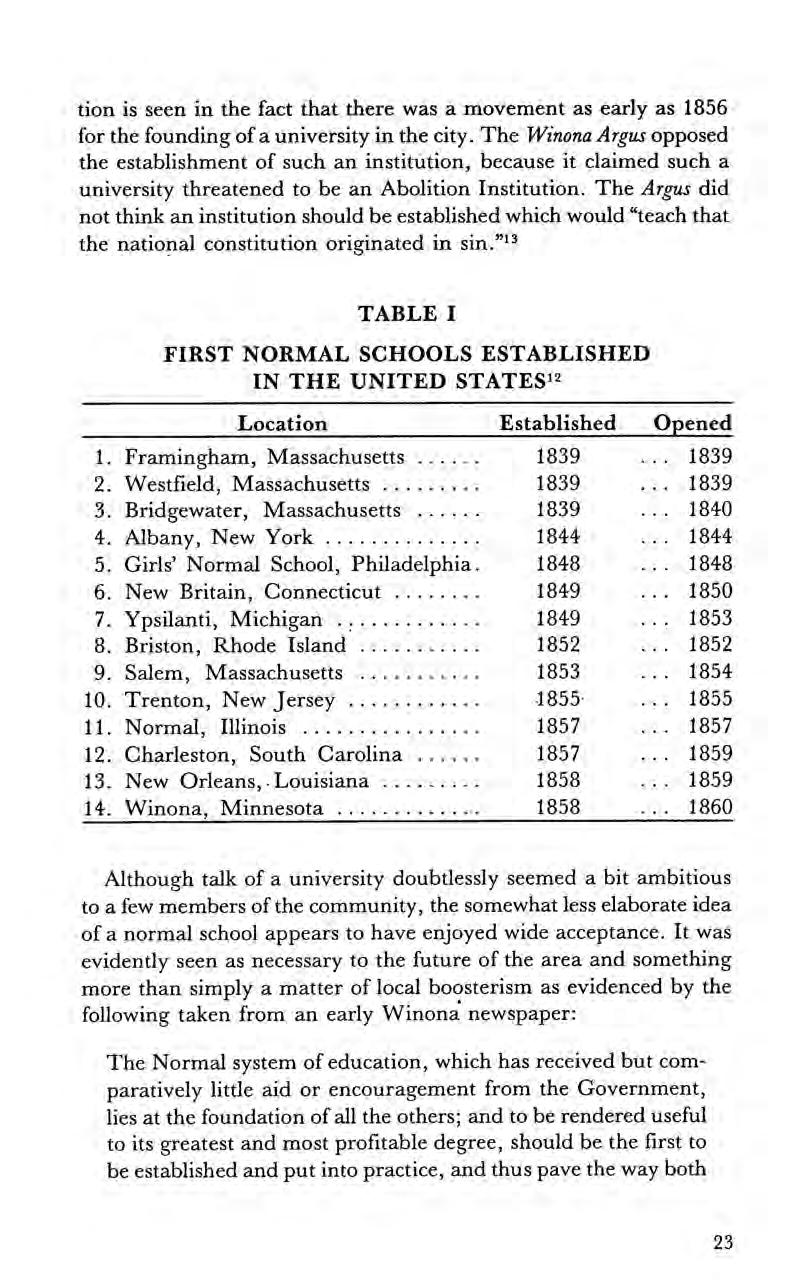
tion is seen in the fact that there was a movement as early as 1856 for the founding of a university in the city. The Winona Argus opposed the establishment of such an institution, because it claimed such a university threatened to be an Abolition Institution. The Argus did not think an institution should be established which would “teach that the national constitution originated in sin.”1%
1. Framingham, Massachusetts 1839 1839
2. Westfield, Massachusetts 1839 1839
3. Bridgewater, Massachusetts 1839 1840
4. Albany, New York 1844 1844
5. Girls’ Normal School, Philadelphia. 1848 1848
6. New Britain, Connecticut 1849 1850
7. Ypsilanti, Michigan 1849 1853
8. Briston, Rhode Island 1852 1852
9. Salem, Massachusetts 1853 1854
10. Trenton, New Jersey 1855- 1855
11. Normal, [llinois 1857 1857
12. Charleston, South Carolina 1857 1859
13. New Orleans,-Louisiana 1858 1859
14. Winona, Minnesota 1858 1860
Although talk of a university doubtlessly seemed a bit ambitious to a few members of the community, the somewhat less elaborate idea of a normal school appears to have enjoyed wide acceptance. It was evidently seen as necessary to the future of the area and something more than simply a matter of local boosterism as evidenced by the following taken from an early Winona newspaper:
The Normal system of education, which has received but comparatively little aid or encouragement from the Government, lies at the foundation of all the others; and to be rendered useful to its greatest and most profitable degree, should be the first to be established and put into practice, and thus pave the way both

for a flourishing common school system and for the more advanced collegiate course.
The friends of education throughout the State entertain this view with regard to the system of Normal Schools; and many of them we are happy to learn, are active in their endeavors to aid in the establishing of the firstNormal School in Winona.'*
The second meeting of the Board was held at Winona, November 9, 1859, at which meeting block 17, Sanborn’s addition was, after considerable deliberation, selected as a suitable site for the proposed school, the Board preferring a central location in order that a “model department” might be maintained in connection with the normal school.* At this meeting the Board resolved “that the first State Normal School be opened for the reception of pupils at the earliest period practicable,” and the Secretary of the Board was directed to procure a principal for the school and plans and specifications for the normal school building. The first state tax for school purposes was authorized and levied upon the recommendation of this Board as part of the financial undergirding necessary to the carrying out of their plans. Apparently there was a great demand for places for the Board decided that candidates for admission should be apportioned throughout the state:
Two candidatesshall be admitted for each senator in the State Senate, as now districted. Where two counties compose a senatorial district each county shall have equal opportunity, if both claim the privilege. Where three or more counties compose a senatorial district the applicants from each county shallhave preference in the order of application. If any applicant shall be rejected upon subsequent examination, the next applicant in point of time trom the same district shall be in order for admission. All candidates shall have preference in the order of application. Candidates from districts entitled to admission must apply two weeks before the term commences: Other applicants not entitled to admission by appointment shall be next in order. All
*Model departments were composed of regular classes of children who would be taught by experienced teachers and by student teachers under supervision.

applications must be made to the principal, either by mail or in person.
Any candidate having signified his or her intention in writing to teach for a term of at least two years in the common schools of Minnesota, and having presented satisfactory testimonials of good moral character and natural adaptation for the office of teacher, shall, upon a satisfactory examination by the principal and prudential committee of said school, be admitted to all the privileges of the State Normal School, according to the rules of appointment in the previous resolution; provided, that such applicant be at least sixteen years of age, and of sound physical health; and provided further, that if fifty candidates do not apply who will pledge themselves to teach in the State the required term, then the number of fifty may be filled by students without such pledge, upon payment of tuition.’®
This pledge to teach in the schools of the state, adopted so early in the history of the normal schools, remained in effect until 1933. It also included free tuition for those who planned to become teachers. The discharge of this pledge rested upon the honor of the student, but failure to meet this obligation was said to be very infrequent; not more than two per cent of the entire number. Students who found it inconvenient to teach generally secured an honorable release from the obligation by payment of full tuition for the time of attendance at rates fixed for non-professional students. The following is the form of a pledge used:
I, being at least sixteen years of age, do solemnly declare that I will faithfully attend this Normal School for one term or more, for the purpose of fitting myself for the work of teaching, and that, thereupon, I will, to the best of my judgment and ability, teach in the Common, Graded, or Normal Schools of this State for a period of two years, immediately after ceasing to be a student of this school. And I further agree to make a report semiannually to the President of this school, until the above pledge shall have been fulfilled, stating in such report when, where, and how long I have taught. Sickness or unavoidable cause only may excuse me from the strict performance of this obligation.*®
The first Normal Board was composed of serious minded members, a fact which becomes obvious as one views the results of their labors.
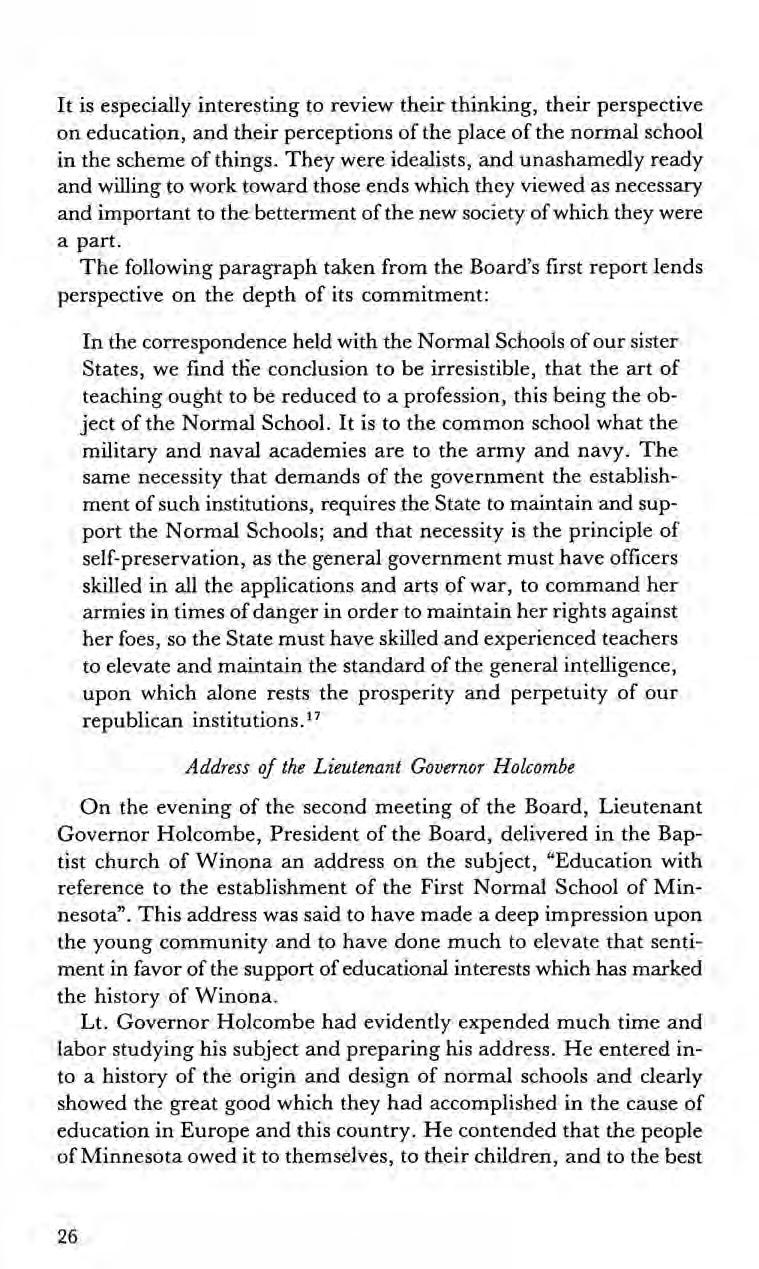
It is especially interesting to review their thinking, their perspective on education, and their perceptions of the place of the normal school in the scheme of things. They were idealists, and unashamedly ready and willing to work toward thoseends which they viewed as necessary and important to the betterment of the new society ofwhich they were a part.
The following paragraph taken from theBoard’s first report lends perspective on the depth of its commitment:
In the correspondence held with the Normal Schools of our sister States, we find the conclusion to be irresistible, that the art of teaching ought to be reduced to a profession, this being theobject of the Normal School. It is to the common school what the military and naval academies are to the army and navy. The same necessity that demands of the government the establishment of such institutions, requires the State to maintain and support the Normal Schools; and that necessity is the principle of self-preservation, as the general government must have officers skilled in all the applications and arts of war, to command her armies in times of danger in order to maintain her rights against her foes, so the State must have skilled and experienced teachers to elevate and maintain the standard of the general intelligence, upon which alone rests the prosperity and perpetuity of our republican institutions. !”
Address of the Lieutenant Governor Holcombe
On the evening of the second meeting of the Board, Lieutenant Governor Holcombe, President of the Board, delivered in the Baptist church of Winona an address on the subject, “Education with reference to the establishment of the First Normal School of Minnesota”. This address was said to have made a deep impression upon the young community and to have done much to elevate that sentiment in favor of the support of educational interests which has marked the history of Winona.
Lt. Governor Holcombe had evidently expended much time and labor studying his subject and preparing his address. He entered into a history of the origin and design of normal schools and clearly showed the great good which they had accomplished in the cause of education in Europe and this country. He contended that the people of Minnesota owed it to themselves, to their children, and to the best

interests of the state to set up a high standard of education in the common schools so liberally provided for in the organization of the state government, and maintained that this could in no way be done as well as by the establishment and proper maintenance of normal schools in Minnesota. He highly commended the location of the school at Winona and he hoped that the energy and liberality which had secured that location would not be permitted to languish, but that the institution would soon be placed upon an enduring foundation. The address was lengthy and was replete with information and encouragement for the furtherance of the design which formed the topic of his discourse. In the closing paragraph of his address, Lt. Governor Holcombe referred to the subscriptions already given:
I have in my hand a paper which contains the origin, and source, and the earnest of the first Normal School of Minnesota. It has its origin here in this city, and the names written on that paper are as pictures of gold, and should be handed down to future generations as evidence of their wisdom and benevolence. This paper subscribes about $7,000 to the establishment of the Normal School here, the most ofwhich, over $5,000 has been secured promptly to the state for that object. The duty I have discharged is every way an agreeable one, no circumstances could have occurred with respect to the interests on the state to afford me higher gratification than to meet you here on such an occasion as this. The City ofWinona has distinguished herself in taking the lead in establishing for the benefit of the rising generation of this state for allwho shall yet call the state their home. I think the Normal Schools should precede the common schools of the country, for then we would have trained teachers to conduct them. When this school shall be in operation it may be regarded as an auspicious era, whence to date in the future the origin of many blessings, and the commencement of a perpetual course of improvement and prosperity to the people at large.'®
One of the first responsibilities ofthe newly appointed normal board was that of locating a principal for the school—a formidable task in a day when there were few enough university graduates, let alone one having normal school experience in addition.

JOHN OGDEN Principal, 1860-1861

However a candidate was located and at its next meeting the board resolved, among other things, “that Professor John Ogden be engaged as Principal of the State Normal School at Winona, the ensuing year, and that his salary be $1,400 per annum, to be paid quarterly in State Warrants out of or from the balance now placed to the credit of the State Normal School Board upon the books of the State Auditor.” !9 William Stearns, a graduate of Harvard University, was chosen tutor. John Ogden was born in Ohio in 1824. At nineteen, while working at blacksmithing, he was kicked by a horse and his arm was broken. He later stated that, not being able to work at his trade for some time, he decided to enter teaching, and found it so congenial that he made it hishfe work.
He studied and taught in the Ohio Wesleyan University at Delaware, Ohio; was principal of one of the schools in Columbus, and later was president of the Hopedale Normal School, Hopedale, Ohio. He had been engaged in institute work for a number of years before coming to Winona. He was clearly a well-qualified individual and, as the history of the next few years would show, a patriot as well as a man of courage and vision.
The board had decided that “the Principal should be requested to visit all important localities and present the necessity of normal schools to the permanent prosperity of the state, and the desirableness of citizens demanding competent teachers for their children.” This he did during the months ofJuly and August. He was back in Winona to take charge when the new schoo! was opened for admission on September 2, 1860.
A teachers’ Institute, the first ever held in the state, was conducted during the opening week. “A goodly number of teachers from various parts of the state were present, and a number of distinguished gentlemen including the Rev. F. D. Neill, Chancellor of the University, Ex-Lieutenant Governor Holcombe, J. W. Taylor, Esq., and many others. A large number of letters were received and read from the Principals of other normal schools and other noted educators throughout the country.”°
The order of exercises for the opening ofthe institution of September 3, 1860, was as follows:
Nine o’clock a.m.— Examination of candidates at the school-
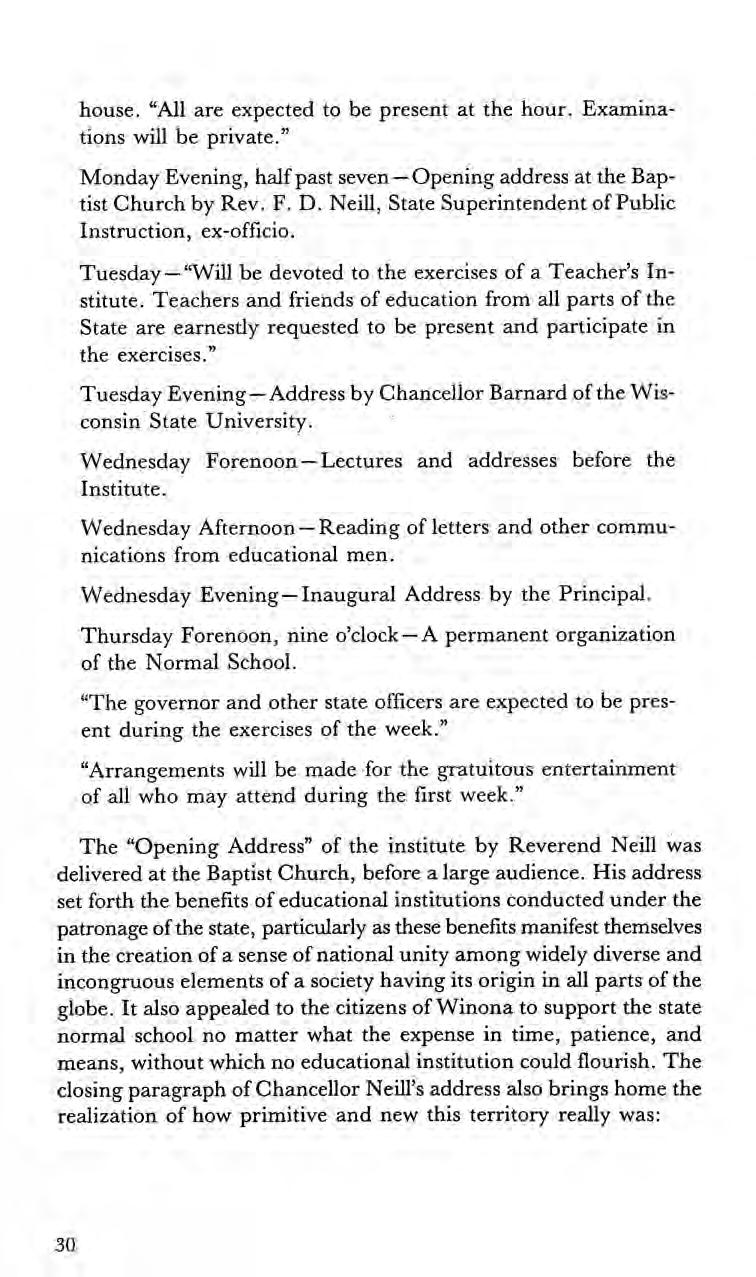
house. “All are expected to be present at the hour. Examinations will be private.”
Monday Evening, half past seven Opening address at the Baptist Church by Rev. F. D. Neill, State Superintendent of Public Instruction, ex-officio.
Tuesday “Will be devoted to the exercises of a Teacher’s Institute. Teachers and friends of education from all parts of the State are earnestly requested to be present and participate in the exercises.”
Tuesday Evening Address by Chancellor Barnard of the Wisconsin State University.
Wednesday Forenoon—Lectures and addresses before the Institute.
Wednesday Afternoon Reading of letters and other communications from educational men.
Wednesday Evening—Inaugural Address by the Principal.
Thursday Forenoon, nine o’clock—A permanent organization of the Normal School.
“The governor and other state officers are expected to be present during the exercises of the week.”
“Arrangements will be made for the gratuitous entertainment of all who may attend during the first week.”
The “Opening Address” of the institute by Reverend Neill was delivered at the Baptist Church, before a large audience. His address set forth the benefits of educational institutions conducted under the patronage ofthe state, particularly as these benefits manifest themselves in the creation of a sense of national unity among widely diverse and incongruous elements of a society having its origin in all parts of the globe. It also appealed to the citizens of Winona to support the state normal school no matter what the expense in time, patience, and means, without which no educational institution could flourish.The closing paragraph of Chancellor Neill’s address also brings home the realization of how primitive and new this territory really was:

Twelve years ago the Winnebago nation, bya treaty stipulation abandoned their homes in Iowa and commenced their long weary march to their new home near Sauk Rapids, in the northern part of this state. In the charming month ofJune, by mutual agreement, parties by Jand and water to the number of 2,000 arrived on this prairie. As they viewed the vast amphitheatre of lofty bluffs, the narrow lake on one side, the great river in front, they felt that it was the spot above all others for an Indian’s Lodge, and purchasing the privilege ofWabasha, the chief of the Dakota band that then lived here, they drew themselves up in battle array, and signified to the United States troops that they would die before they would leave.
Twelve years hence, if the citizenswho have taken the place of the rude aborigines will be large-hearted and foster the normal school, the public schools, and thechurches of Christ, Winona will be lovelier than the “Sweet Auburn”of the poet; and educated men and cultivated women, as they gaze on your public edifices and other evidences of refinement, will be attracted, and feel that here is the spot for a home, and like the indians in 1848, they will desire to tarry until they die.?!
Principal Ogden occupied much of the attention of the Institute, touching in a general manner on the design of the normal school and the object of education. He declared that education is not merely the acquisition ofknowledge, “but the development ofthe whole character of the individual, physically, educationally, morally, and religiously.” He spoke of the relationship of such a school to the wants of the rising generation, of the need for insuring the sufficiency ofthe educational supply to meet those wants. He emphasized the importance of raising the teachers’ calling to the rank of a profession. Education had not yet receivedits proper attention, he said. While the learned professions had received the highest degree of systematic development, the vocation of the ceacher, the basis of all professions, had dropped into the rear rank of the professional movement of the age. He also conducted drills in grammar which, says the Winona Republican “were highly instructive and interesting, and elicited a good many hints in regard to teaching grammar.” “But these exercises,” continues the Republican, “should have been witnessed to be properly appreciated.”??
A-canvass of the institute members showed seventeen names from New England, eighteen from New York, two from Pennsylvania, two

from Ohio, one each from NewJersey and Wisconsin, and two from Illinois.
The inaugural address of Mr. Ogden was also delivered at the Baptist Church to a large audience of citizens and students. Dr. Ford had invited Lieutenant Governor Holcombe of Stillwater to preside, and in so doing, alluded to theactive efforts of that gentleman in behalf of the normal school enterprise and the warm interest which he hadmanifested in its success from the very beginning up to that auspicious moment.
Letters were then read from the Rev. Neill and Governor Ramsey, at the close of which Mr. Ogden delivered his inaugural address.
Actually, there were seven major speeches that week in addition to a variety of other activities. The audience must have been well informed on such topics as morality, patriotism and educationby the time Principal Ogden, the last of the speakers, took over the podium. If they were not, they certainly were after he finished, for his speech was the longest of the lot and seems to have covered the entire spectrum of educational thought of the middle eighteen hundreds.
All of the speeches that week were highly moralistic in tone and replete with references to God and country in keeping with the mood of the times. Mr. Ogden’s was no exception. Secularization as we know it today was clearly not large in the thinking of the founders of the Winona Normal School. Religion and education were inextricably bound and there was little agonizing over where to draw the line separating church and state.
It is understandable then, that many, if not most ofthe young people who enrolled at the “Normal” developed a kind of missionary zeal for what they were setting out to do, something, which for some of them at least, transcended the merely vocational aspect of their efforts. A short exerpt from Principal Ogden’s speech will suffice to show some of the flavor of that period:
It shall be the leading object ofthe Normal School, so to distribute its labors and other exercises, that all the faculties of the pupil physical, intellectual, moral, and spiritual, shall be addressed in due preparation, at the proper time, and in the proper manner; and so to develop, strengthen, elevate, and purify these powers in the student; and so to train him in the education pro-
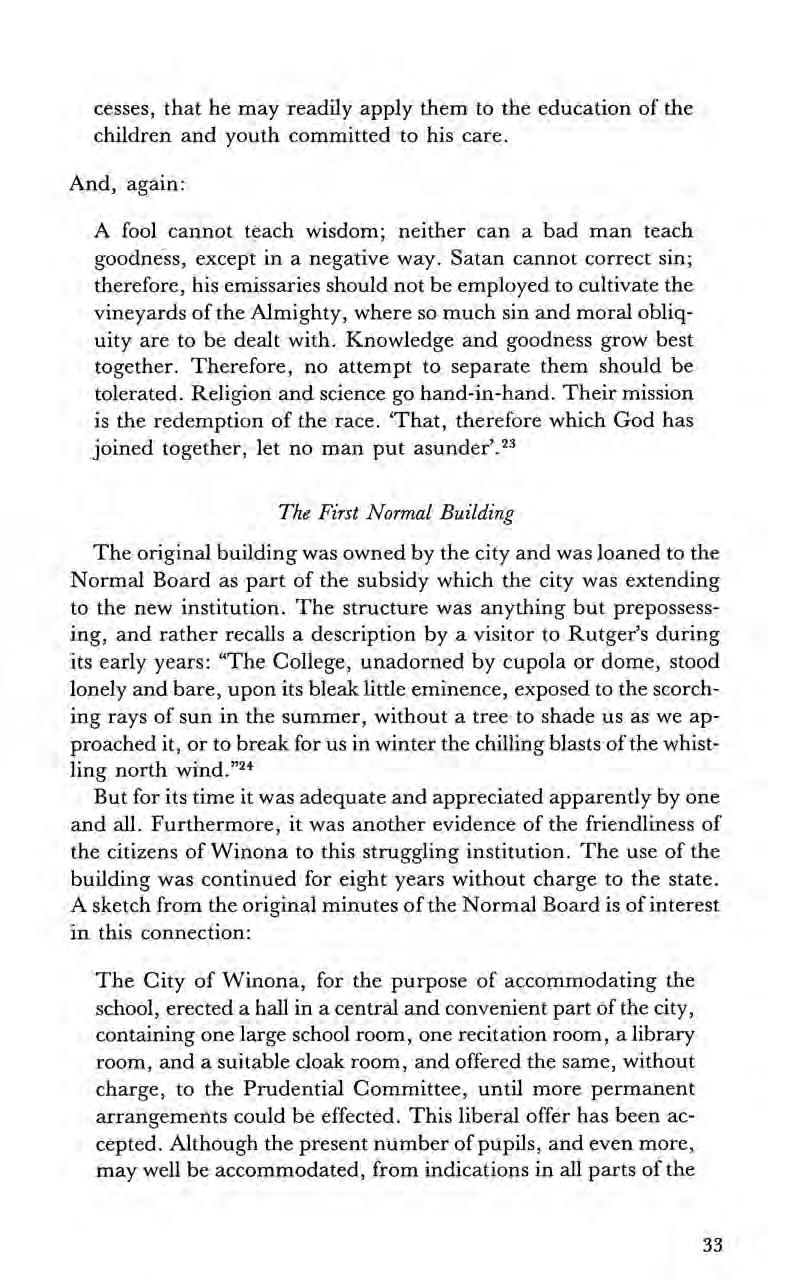
cesses, that he may readily apply them to the education of the children and youth committed to his care.
And, again:
A fool cannot teach wisdom; neither can a bad man teach goodness, except in a negative way. Satan cannot correct sin; therefore, his emissaries should not be employed to cultivate the vineyards of the Almighty, where so much sin and moral obliquity are to be dealt with. Knowledge and goodness grow best together. Therefore, no attempt to separate them should be tolerated. Religion and science go hand-in-hand. Their mission is the redemption of the race. “That, therefore which God has joined together, let no man put asunder’.”?
The original building was owned by the city and was loaned to the Normal Board as part of the subsidy which the city was extending to the new institution. The structure was anything but prepossessing, and rather recalls a description by a visitor to Rutger’s during its early years: “The College, unadorned by cupola or dome, stood lonely and bare, upon its bleak little eminence, exposed to the scorching rays of sun in the summer, without a tree to shade us as we approached it, or to break for us in winter the chilling blasts ofthe whistling north wind.”2*
But for its time it was adequate and appreciated apparently by one and all. Furthermore, it was another evidence of the friendliness of the citizens of Winona to this struggling institution. The use of the building was continued for eight years without charge to the state. A sketch from the original minutes of the Normal Board is of interest in this connection:
The City of Winona, for the purpose of accommodating the school, erected a hall in a central and convenient part of the city, containing one large school room, one recitation room, a library room, and a suitable cloak room, and offered the same, without charge, to the Prudential Committee, until more permanent arrangements could be effected. This liberal offer has been accepted. Although the present number of pupils, and even more, may well be accommodated, from indications in all parts of the
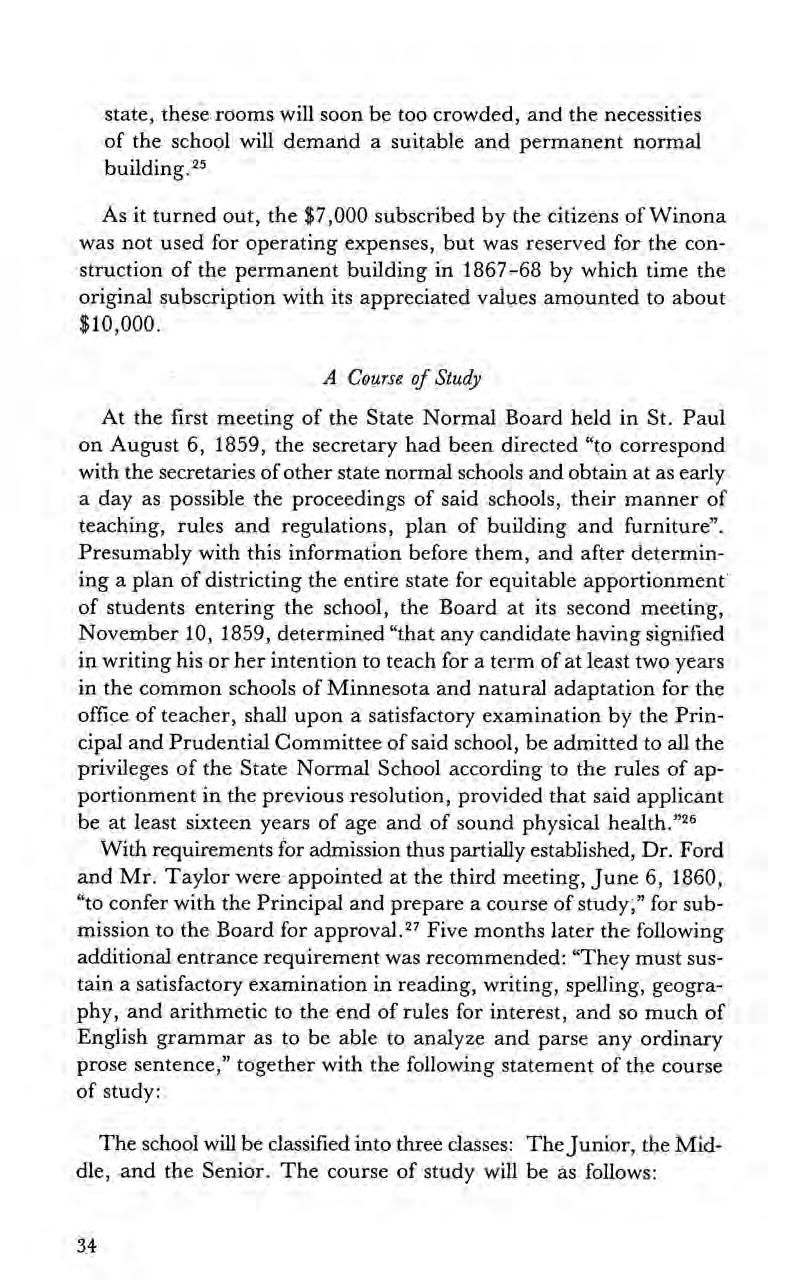
state, these rooms will soon be too crowded, and the necessities of the school will demand a suitable and permanent normal building.?®
As it turned out, the $7,000 subscribed by the citizens of Winona was not used for operating expenses, but was reserved for the construction of the permanent building in 1867-68 by which time the original subscription with its appreciated values amounted to about $10,000.
At the first meeting of the State Normal Board held in St. Paul on August 6, 1859, the secretary had been directed “to correspond with the secretaries of other state normal schools and obtain at as early a day as possible the proceedings of said schools, their manner of teaching, rules and regulations, plan of building and furniture”. Presumably with this information before them, and after determining a plan of districting the entire state for equitable apportionment of students entering the school, the Board at its second meeting, November 10, 1859, determined “that any candidate having signified in writing his or her intention to teach for a term of at least two years in the common schools of Minnesota and natural adaptation for the office of teacher, shall upona satisfactory examination by the Principal and Prudential Committee of said school, be admitted to all the privileges of the State Normal School according to the rules of apportionment in the previous resolution, provided that said applicant be at least sixteen years of age and of sound physical health.”?6
With requirements for admission thus partially established, Dr. Ford and Mr. Taylor were appointed at the third meeting, June 6, 1860, “to confer with the Principal and prepare a course of study,” for submission to the Board for approval.” Five months later the following additional entrance requirement was recommended: “They must sustain a satisfactory examination in reading, writing, spelling, geography, and arithmetic to the end of rules for interest, and so much of English grammar as to be able to analyze and parse any ordinary prose sentence,” together with the following statement of the course of study:
The school will be classified into three classes: ,TheJunior, the Middle, and the Senior. The course of study will be as follows:
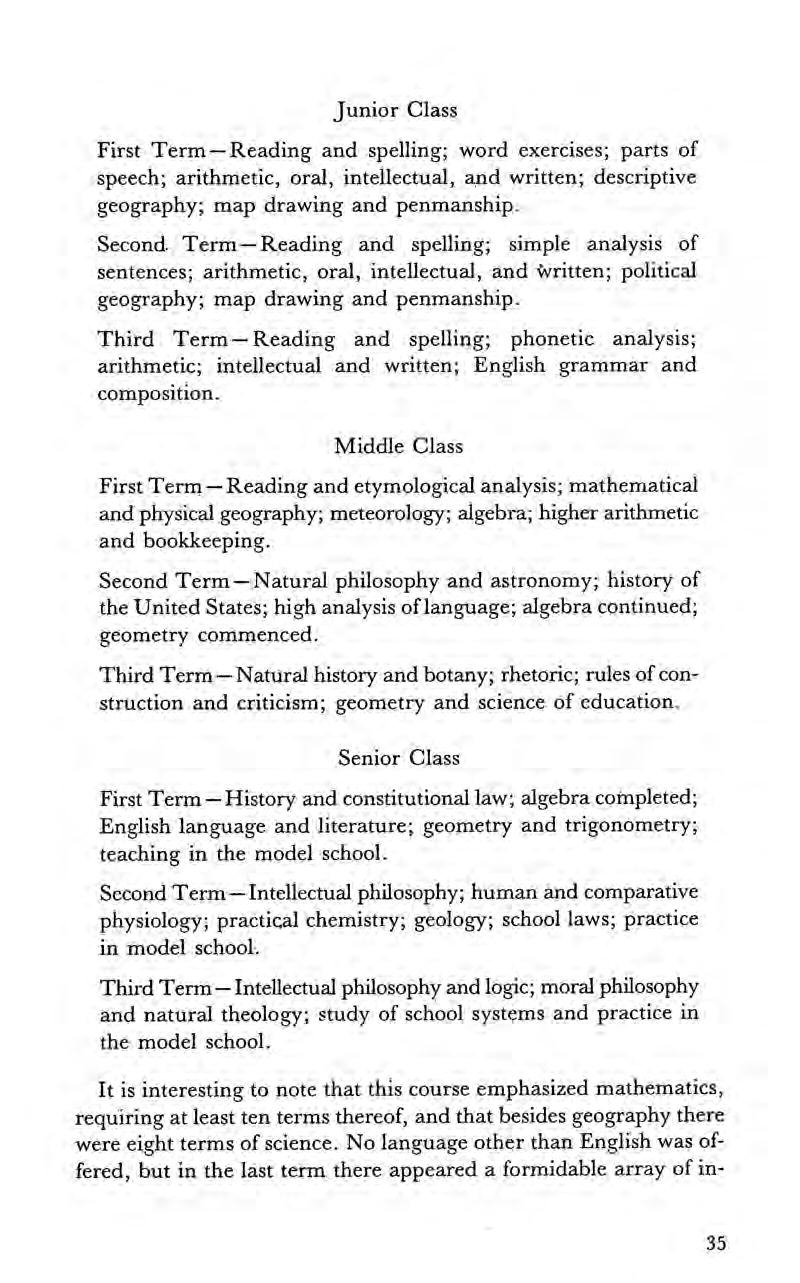
First Term— Reading and spelling; word exercises; parts of speech; arithmetic, oral, intellectual, and written; descriptive geography; map drawing and penmanship.
Second. Term—Reading and spelling; simple analysis of sentences; arithmetic, oral, intellectual, and written; political geography; map drawing and penmanship.
Third Term—Reading and spelling; phonetic analysis; arithmetic; intellectual and written; English grammar and composition.
First Term Reading and etymological analysis; mathematical and physical geography; meteorology; algebra; higher arithmetic and bookkeeping.
Second Term — Natural philosophy and astronomy; history of the United States; high analysis oflanguage; algebra continued; geometry commenced.
Third Term Natural history and botany; rhetoric; rules of construction and criticism; geometry and science of education.
First Term History and constitutional law; algebra completed; English language and literature; geometry and trigonometry; teaching in the model school.
Second Term — Intellectual philosophy; human and comparative physiology; practical chemistry; geology; school laws; practice in model school.
Third Term Intellectual philosophy and logic; moral philosophy and natural theology; study of school systems and practice in the model school.
It is interesting to note that this course emphasized mathematics, requiring at least ten terms thereof, and that besides geography there were eight terms of science. No language other than English was offered, but in the last term there appeared a formidable array of in-

tellectual philosophy, logic, moral philosophy, and natural theology. Practice teaching, carried throughout the senior year, with a study of school laws and school systems, and the science of education, made up the pedagogical work of the course.
Because of the closing of the school for the period from March, 1862, to November, 1864, no students completed the course as outlined, but several had completed a year, and it can be safely assumed, went out to teach in rural schools of the day, often barely one year ahead of their young charges.
In spite of its newness, the first year seems to have been most successful, and “commencement” time came and went without incident. Although there was not as yet a graduating class, end-of-term exercises were nevertheless held the last week in June, 1861, at the Baptist Church. They continued the entire week and closed with a strawberry festival for the benefit of the school. According to the Daily Republican the visitors present included a Mr. Hickok, Ex-Superintendent of Public Instruction to the State ofPennsylvania, a Mr. Allen, secretary of the Board of Normal Regents of Wisconsin, C. C. Andrews of St. Cloud, Lieutenant Governor Ignatius Donnelly and a Dr. Reid of St. Paul. Hickok, Donnelly and Andrews delivered addresses. The Board of Examiners consisted of a Mr. Markham of St. Paul, a Mr. Stone of Minneapolis and a Mr. Williams ofWasioja.”°
The Republican describes the scene: Over the wide platform of the Baptist Church, stretching from wall to wall, two American flags were hung, on one the word “God” on the other “Liberty”. Above these, in letters of living green was the motto, “The Education of the people, the strength of the Republic”. Beneath them hung the portrait of Washington. Over the doorway hung the portrait of Lincoln.
Concerning this picture the Republican observed:
“He looks a little lean and lank; butstill the Old Abe of antisecnotoriety; we thought he was pleased with what he saw before him, and that he occasionally nodded at Washington and nudged Webster, whose picture is nearby, as much as to say, ‘Good for Minnesota’.”
High on the gallery wall was a circle of green enclosing the words, “The true Emblem of Education”. Another important picture in the room was the representation of the first prayer in Congress. Other
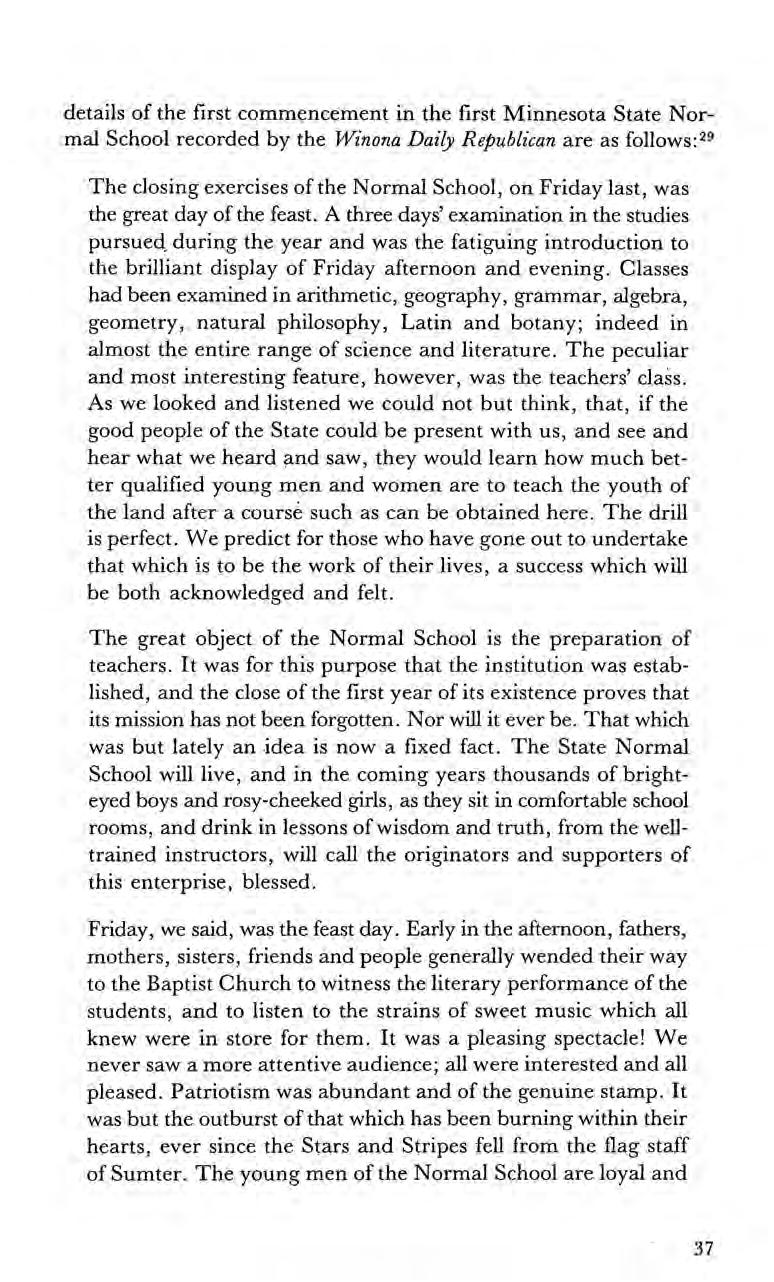
details of the first commencement in the first Minnesota State Normal School recorded by the Winona Daily Republican are as follows:?9
The closing exercises of the Normal School, on Friday last, was the great day of the feast. A three days’ examination in the studies pursued during the year and was the fatiguing introduction to the brilliant display of Friday afternoon and evening. Classes had been examined in arithmetic, geography, grammar, algebra, geometry, natural philosophy, Latin and botany; indeed in almost the entire range of science and literature. The peculiar and most interesting feature, however, was the teachers’ class. As we looked and listened we could not but think, that, if the good people of the State could be present with us, and see and hear what we heard and saw, they wouldlearn how much better qualified young men and women are to teach the youth of the land after a course such as can be obtained here. The drill is perfect. We predict for those who have gone out to undertake that which is to be the work of their lives, a success which will be both acknowledged and felt.
The great object of the Normal School is the preparation of teachers. It was for this purpose that the institution was established, and the close of the first year of its existence proves that its mission has not been forgotten. Nor will it ever be. ‘That which was but lately an idea is nowa fixed fact. The State Normal School will live, and in the coming years thousands of brighteyed boys and rosy-cheeked girls, as they sit in comfortable school rooms, and drink in lessons of wisdom and truth, from the welltrained instructors, will callthe originators and supporters of this enterprise, blessed.
Friday, we said, was the feast day. Early in the afternoon, fathers, mothers, sisters, friends and people generally wended their way to the Baptist Church to witness the literary performance of the students, and to listen to the strains of sweet music which all knew were in store for them. It was a pleasing spectacle! We never saw a more attentive audience; all were interested and all pleased. Patriotism was abundant and of the genuine stamp. It was but the outburst of that which has been burning within their hearts, ever since the Stars and Stripes fell from the flag staff of Sumter. The young men of the Normal School are loyal and

full of fight; they will stand by the right and battle for their country through storm and sunshine.
They will teach our children not only knowledge, but patriotism. Long may they wave.
The ladies, too, acquitted themselves with honor and we feel proud to think that these were to go out as representatives of Minnesota culture and thought. Their essays were attractive, both in shape and matter; and while womanly, were noble. ‘Their articulation was distinct and full, yet having that subdued melody which tells of the gentle and quiet spirit.
We forebear any further comments. It is only allowed us to allude to the presentation of Professor Ogden, the Principal of the school, of a magnificently bound copy of the Holy Scriptures. The remarks, by one of the young ladies of the school, on the occasion, were peculiarly touching, and the reply of Professor Ogden brought tears to eyes unused to weep. In the evening, Honorable C.C. Andrews and Lieutenant Governor Donnelly delivered able lectures: after which a social reunion was had at the home of the Principal, and the first commencement of the Normal School was ended.
We print herewith the programme of exercises on Friday afternoon, to which allusion has been made above:
Music Prayer Music
Salutatory: R. C. Olin, Northfield
Diversion: A. A. Bates, Northfield
Popular Education: D. D. Kimball, Winona
Music: Our Country: Anna M. White, Plainview
A Scripture Proverb: Mary E. Hoffman, Minneapolis
Douglas: G. R. Tucker, Winona
Events of the Century: G. G. Gray, Warren
Debate: “Is it right to use force to extend civilization?”
Affirmative: A. W. Williamson, Pajutazee
Negative: H. P. Hubbell, Winona
American Oratory: P. G. Hubbell, Winona
Colloquy: Etta R. Howe, Winona

Lottie I. Denman, Winona
Bessie M. Thorne, Winona
Music
Flowers, an Allegory: Nellie M. Temple, New Boston
Death before Life: Gussie A. Brewster, Stillwater
Necessities: S. T. Robinson, Winona
Ellsworth: G. W. Knox, Winona
Music: A Family in Heaven: Mary E. Winter, Winona
Memories of Western Life: M. Louise Worthington, Winona
Valedictory: Joseph D. Ford, Winona
Music
Benediction
The foregoing, which would today seem a bit overdone, was typical of that day and age. There are numerous such examples in the archives.
A conflict was impending however, which wassoon to disrupt these deliberate and traditional ways of doing things, and which would substitute for poetry and debate the death and destruction of war. The local Prudential Committee had announced that, “Encouraged by the decided success, so fully conceded by the Board of Examiners and others competent to judge, the State Normal Board has directed the committee to announce that the second school year will commence on Monday, September 2, 1861”.
But there was a feeling of tentativeness. Mr. J. D.McMynn, for example, who had been engaged as an assistant teacher, resigned in October to become a major in a Wisconsin regiment. Many of the students of the school had already entered the volunteer army in defense of the Union. Finally, Mr. Ogden, himself, resigned his principalship on December 14, 1861, at the close of the fall term. His letter of resignation clearly reflects the spirit of those stirring times:°°
Winona, Minnesota, December 14, 1861.
To the Prudential Committee of the First State Normal School of Minnesota.
Gentlemen:
I hereby tender you my resignation of the principalship of the

institution intrusted by my care, thanking you most sincerely for the generous support and counsel you have given me.
In taking this step, it is proper that you and the public should understand the reason that impels me to it.
My distracted and dishonored country calls louder for my poor service just now than the school does. I have, ever since our national flag was dishonored, cherished the desire and indulged in the determination that— whenever I could do so without violation of a sense of duty —I would lay aside the habiliments of the school room and assume those of the camp, and now I am resolved to heed that call and rush to the breach, and with my life, if necessary, stay, if possible, the impious hands that are now Clutching at the very existence of our free institutions. What are our schools worth? What is our country without these? Our sons and daughters must be slaves. Our beloved land must be a hissing and a byword among nations of the earth. Shall this fair and goodly land, this glorious Northwest become a stench in the nostrils of the Almighty, who made it so fair and so free? No, not while there is one living soul to thrust a sword attreason. I confess my blood boils when I think of the deep disgrace of our country.
My brethren and fellow-teachers are in the field. some of them the bravest and the best — have already fallen. Their blood will do more to cleanse this nation than their teaching would. So will mine. I feel ashamed to tarry longer. You may not urge me to stay.
With these feelings, I am, with very great respect,
Your most obedient servant, John Ogden
In the Winona Daily Republican appears the following commentary concerning Principal Ogden’s resignation:
Professor John Ogden, who as Principal of the Minnesota State Normal School, has successfully conducted that institution from the beginning, has resigned his situation, and will shortly leave our city for another and widely different field oflabor. The causes
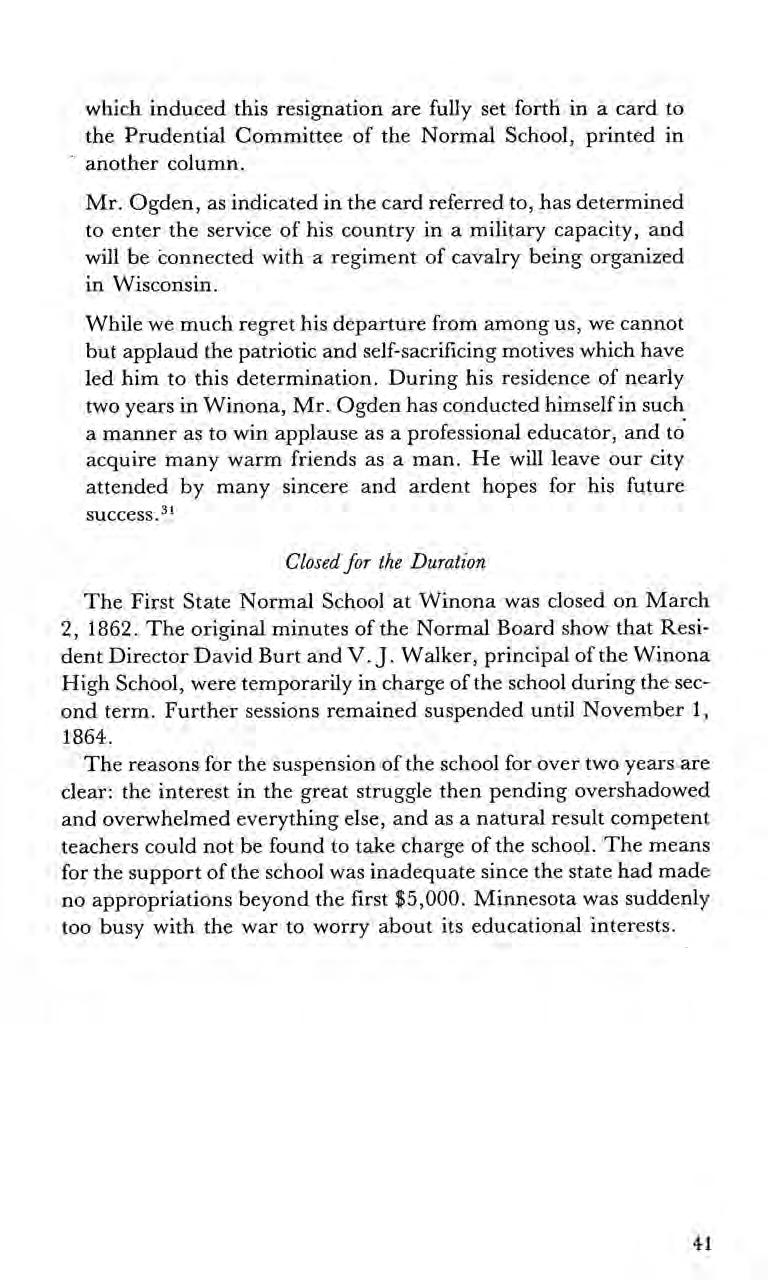
which induced this resignation are fully set forth in a card to the Prudential Committee of the Normal School, printed in another column.
Mr. Ogden, as indicated in the card referred to, has determined to enter the service of his country in a military capacity, and will be connected with a regiment of cavalry being organized in Wisconsin.
While we much regret his departure from among us, we cannot but applaud the patriotic and self-sacrificing motives which have led him to this determination. During his residence of nearly two years in Winona, Mr. Ogden has conducted himself in such a manner as to win applause as a professional educator, and to acquire many warm friends as a man. He will leave our city attended by many sincere and ardent hopes for his future success.*!
TheFirst State Normal School at Winona was closed on March 2, 1862. The original minutes of the Normal Board show that Resident Director David Burt and V. J. Walker, principal of the Winona High School, were temporarily in charge of the school during the second term. Further sessions remained suspended until November 1, 1864.
The reasons for the suspension of the school for over two years are clear: the interest in the great struggle then pending overshadowed and overwhelmed everything else, and as a natural result competent teachers could not be found to take charge of the school. ‘The means for the support of the school was inadequate since the state had made no appropriations beyond the first $5,000. Minnesota was suddenly too busy with the war to worry about its educational interests.
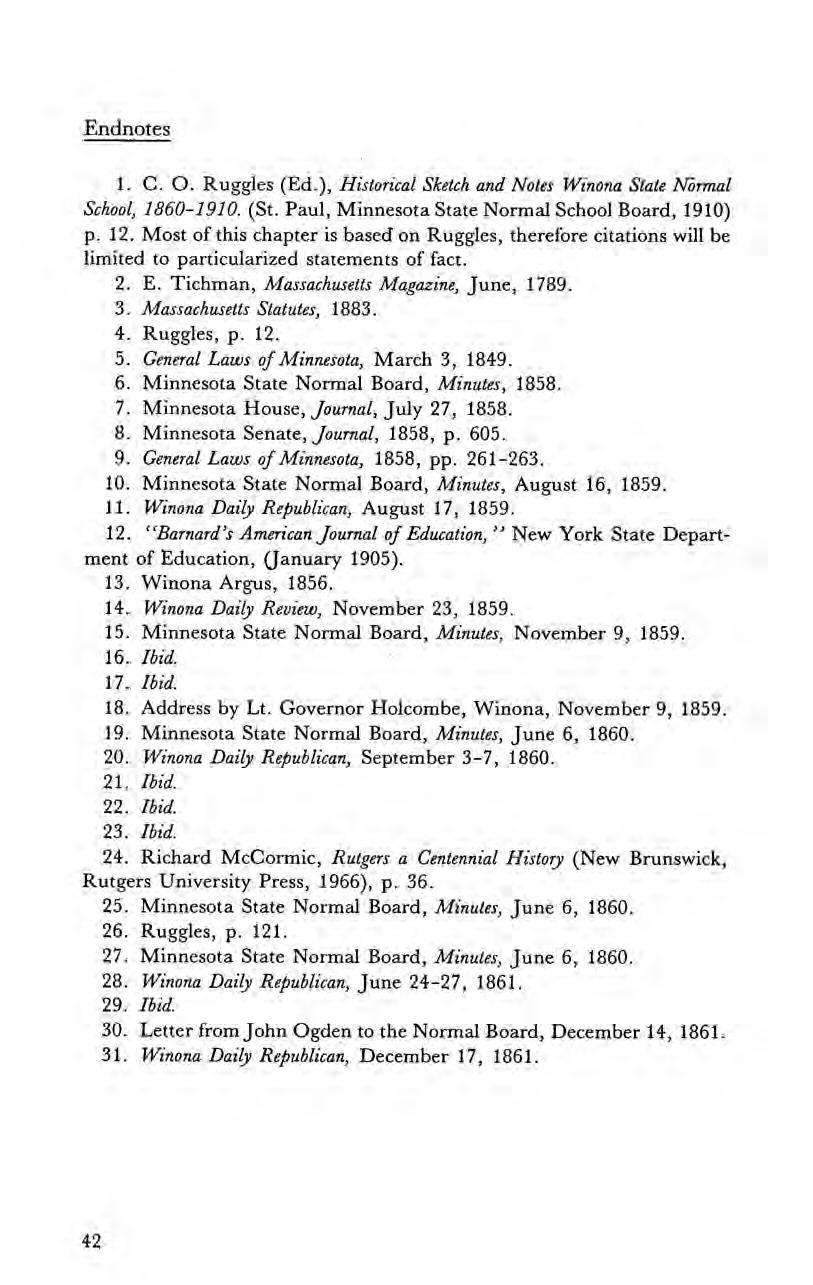
1. C. O. Ruggles (Ed.), Historical Sketch and Notes Winona State Normal School, 1860-1910. (St. Paul, Minnesota State Normal School Board, 1910) p. 12. Most of this chapter is based on Ruggles, therefore citations will be limited to particularized statements of fact.
E. Tichman, Massachusetts Magazine, June, 1789. Massachusetts Statutes, 1883.
Ruggles, p. 12.
General Laws ofMinnesota, March 3, 1849.
Minnesota State Normal Board, Minutes, 1858.
Minnesota House, Journal, July 27, 1858.
Minnesota Senate, Journal, 1858, p. 605.
General Laws ofMinnesota, 1858, pp. 261-263.
Minnesota State Normal Board, Minutes, August 16, 1859.
Winona Daily Republican, August 17, 1859.
Winona Argus, 1856.
Winona Daily Review, November 23, 1859.
Minnesota State Normal Board, Minutes, November 9, 1859.
Ibid.
Ibid.
Address by Lt. Governor Holcombe, Winona, November 9, 1859.
Minnesota State Normal Board, Minutes, June 6, 1860.
Winona Daily Republican, September 3-7, 1860.
Ibid.
Tbid. Ibid.
12. “‘Barnard’s American Journal of Education,’? New York State Department of Education, (January 1905). 13. 14. 15. 16. 17. 18. 19, 20. 21. 22. 23. 24.
Richard McCormic, Rutgers a Centennial History (New Brunswick, Rutgers University Press, 1966), p. 36. 25. 26. 27. 28. 29. 30. 31.
Minnesota State Normal Board, Minutes, June 6, 1860.
Ruggles, p. 121.
Minnesota State Normal Board, Minutes, June 6, 1860.
Winona Daily Republican, June 24-27, 1861.
Ibid.
Letter from John Ogden to the Normal Board, December 14, 1861. Winona Daily Republican, December 17, 1861.

By May 11, 1858, when Congress finally approved Minnesota’s constitution(s)* and awarded the territory full statehood, the fires of rebellion were already burning brightly in the South. Southern leaders had warned that if Lincoln were elected, secession would follow, and they were true to their word, with South Carolina leading the way on December 20, 1860. On April 13, 1861, Fort Sumter fell; on April 15, Lincoln called for 75,000 volunteers; on April 19, he ordered the blockade of the seceding states. The Civil War was underway! Several months earlier Governor Ramsey had wired Lieutenant Governor Ignatious Donnelly to begin to organize volunteers from the new state to fight in the War. On April 14, 1861, one day before Lincoln’s general call for militia, Governor Ramsey offered the President 1,000 men, giving Minnesota the distinction of being the first state to offer troops to the Union cause. The First Minnesota Regiment left Fort Snelling on June 22, 1861."
Among those new troops were men who had been students at the normal school as well as faculty members like PrincipalJohn Ogden who had resigned to fight for the cause. As with every great war, and particularly this one, practically everything constructive came to a halt as energies and resources were concentrated on the war effort. There were no funds for the normal school nor for any other kind of school for that matter except for the occasional building of a one-
*Minnesota actually had two constitutions. During the territory’s Constitutional Convention ofJuly, 1857, there was sucha rift between Democrats and Republicans that two constitutions were adopted, one by each party since neither side would vote for the other. Because they were fundamentally the same, however, they were both adopted on October 3 of that year, and state officials then were appointed. On May 11 the following year Congress gave Minnesota statehood.
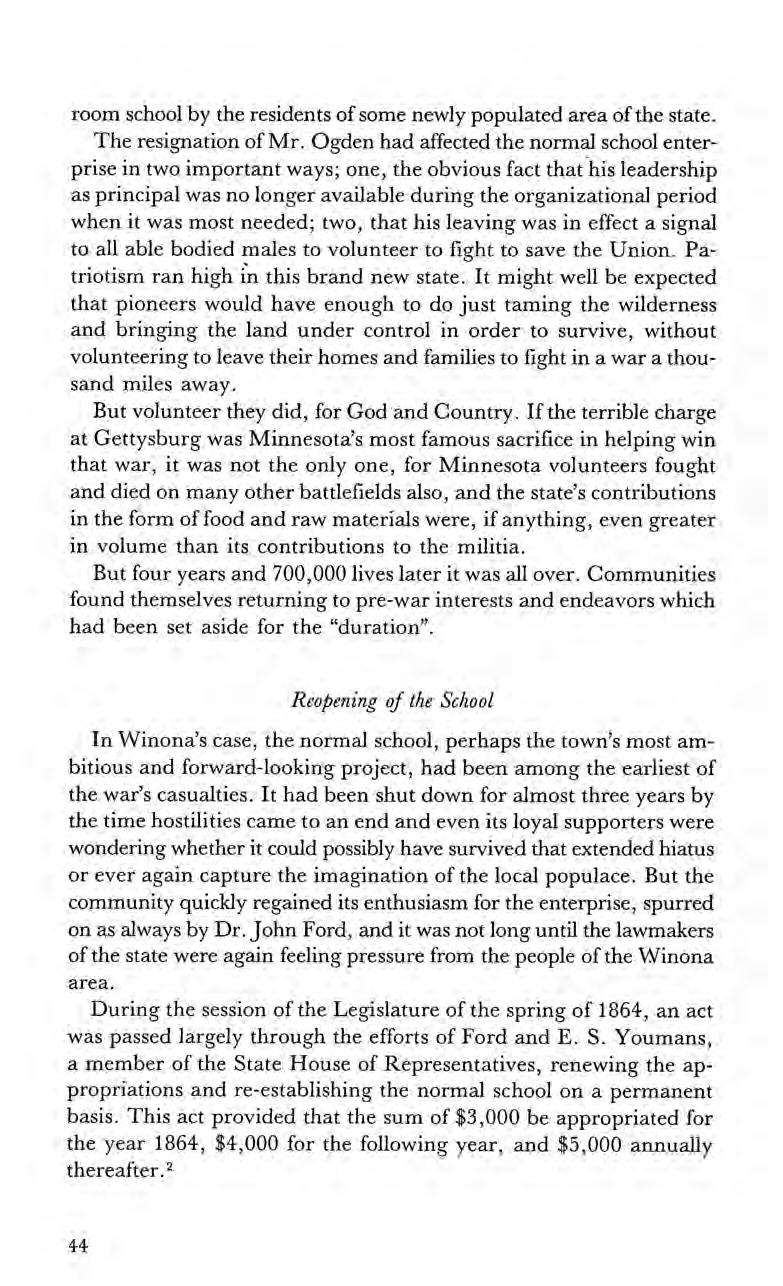
room school by the residents of some newlypopulated area ofthe state.
The resignation of Mr. Ogden had affected the normal school enterprise in two important ways; one, the obviousfact that his leadership as principal was no longer available during the organizational period when it was most needed; two, that his leaving was in effect a signal to all able bodied males to volunteer to fight to save the Union. Patriotism ran high in this brand new state. It might well be expected that pioneers would have enough to do just taming the wilderness and bringing the land under control in order to survive, without volunteering to leave their homes and families to fight in a war a thousand miles away.
But volunteer they did, for God'and Country. If the terrible charge at Gettysburg was Minnesota’s most famoussacrifice in helping win that war, it was not the only one, for Minnesota volunteers fought and died on many other battlefields also, and the state’s contributions in the form of food and raw materials were, if anything, even greater in volume than its contributions to the militia.
But four years and 700,000 lives later it was all over. Communities found themselves returning to pre-war interests and endeavors which had been set aside for the “duration”.
In Winona’s case, the normal school, perhaps the town’s most ambitious and forward-looking project, had been among the earliest of the war’s casualties. It had been shut down for almost three years by the time hostilities came to an end and even its loyal supporters were wondering whether it could possibly have survived that extended hiatus or ever again capture the imagination of the local populace. But the communityquickly regained its enthusiasm for the enterprise, spurred on as always by Dr. John Ford, and it was not long until the lawmakers of the state were again feeling pressure from the people of the Winona area.
During the session of the Legislature of the spring of 1864, an act was passed largely through the efforts of Ford and E. S. Youmans, a member of the State House of Representatives, renewing the appropriations and re-establishing the normal school on a permanent basis. This act provided that the sum of $3,000 be appropriated for the year 1864, $4,000 for the following year, and $5,000 annually thereafter.”
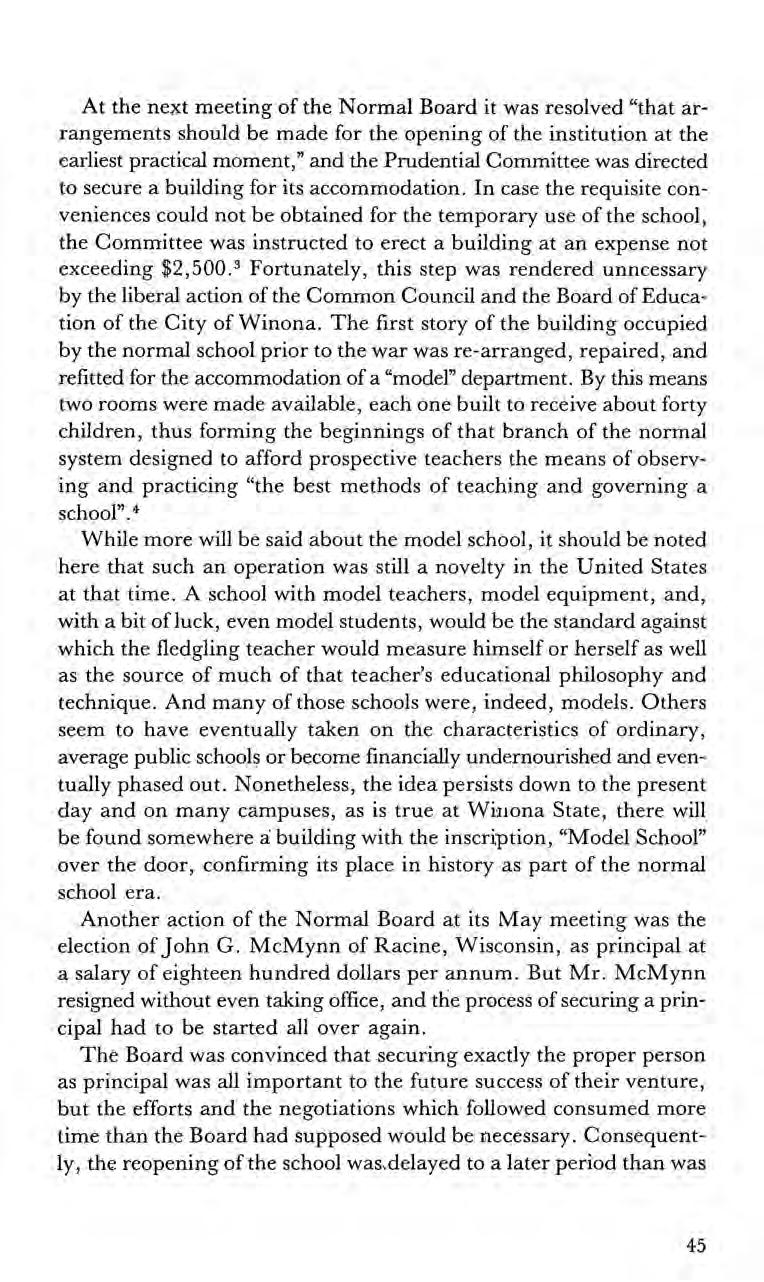
At the next meeting of the Normal Board it was resolved “that arrangements should be made for the opening of the institution at the earliest practical moment,” and the Prudential Committee was directed to secure a building for its accommodation. In case the requisite conveniences could not be obtained for the temporary use of the school, the Committee was instructed to erect a building at an expense not exceeding $2,500. Fortunately, this step was rendered unncessary by the liberal action of the Common Council and the Board of Education of the City of Winona. The first story of the building occupied by the normal school prior to the war was re-arranged,repaired, and refitted for the accommodation of a “model” department. By this means two rooms were made available, each one built to receive about forty children, thus forming the beginnings of that branch of the normal system designed to afford prospective teachers the means of observing and practicing “the best methods of teaching and governing a school”.*
While more will be said about the model school, it should be noted here that such an operation was still a novelty in the United States at that time. A school with model teachers, model equipment, and, with a bit of luck, even model students, would be the standard against which the fledgling teacher would measure himself or herself as well as the source of much of that teacher’s educational philosophy and technique. And many of those schools were, indeed, models. Others seem to have eventually taken on the characteristics of ordinary, average public schools or become financially undernourished and eventually phased out. Nonetheless, the idea persists down to the present day and on many campuses, as is true at Winona State, there will be found somewhere a building with the inscription, “Model School” over the door, confirming its placein history as part of the normal school era.
Another action of the Normal Board at its May meeting was the election ofJohn G. McMynn of Racine, Wisconsin, as principal at a salary of eighteen hundred dollars per annum. But Mr. McMynn resigned without even taking office, and the process of securing a principal had to be started all over again.
The Board was convinced that securing exactly the proper person as principal was all important to the future success of their venture, but the efforts and the negotiations which followed consumed more time than the Board had supposed would be necessary. Consequently, the reopening of the school was.delayed to a later period than was
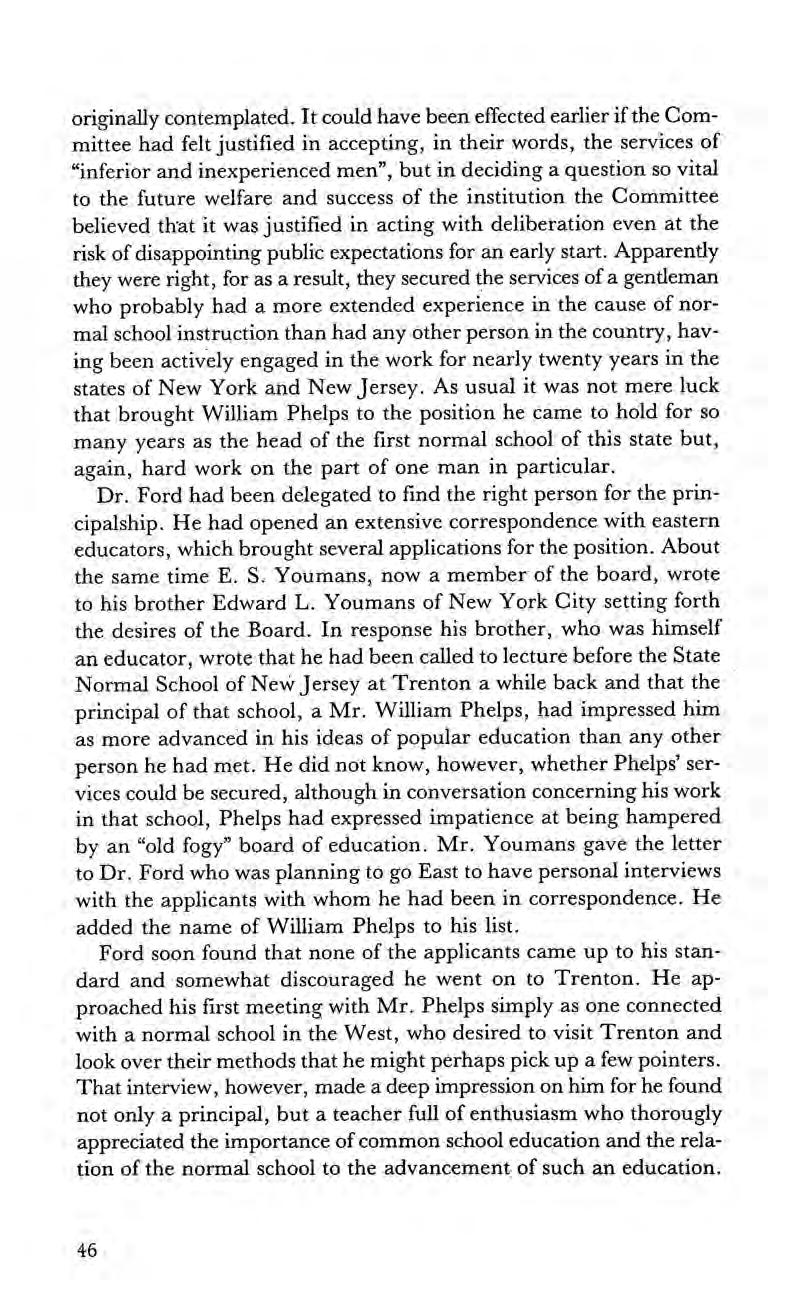
originally contemplated. It could have been effected earlier ifthe Committee had felt justified in accepting, in their words, the services of “inferior and inexperienced men”, but in deciding a question so vital to the future welfare and success of the institution the Committee believed that it was justified in acting with deliberation even at the risk of disappointing public expectations for an early start. Apparently they were right, for as a result, they secured the services of a gentleman who probably had a more extended experience in the cause of normal school instruction than had any other person in the country, having been actively engaged in the work for nearly twenty years in the states of New York and New Jersey. As usual it was not mere luck that brought William Phelps to the position he came to hold for so many years as the head of the first normal school of this state but, again, hard work on the part of one man in particular.
Dr. Ford had been delegated to find the right person for the principalship. He had opened an extensive correspondence with eastern educators, which brought several applications for the position. About the same time E. S. Youmans, now a member of the board, wrote to his brother Edward L. Youmans of New York City setting forth the desires of the Board. In response his brother, who was himself an educator, wrote that he had been called to lecture before the State Normal School of New Jersey at Trenton a while back and that the principal of that school, a Mr. William Phelps, had impressed him as more advanced in his ideas of popular education than any other person he had met. He did not know, however, whether Phelps’ services could be secured, although in conversation concerning his work in that school, Phelps had expressed impatience at being hampered by an “old fogy” board of education. Mr. Youmans gave the letter to Dr. Ford who was planning to go East to have personal interviews with the applicants with whom he had been in correspondence. He added the name of William Phelps to his list.
Ford soon found that none of the applicants came up to his standard and somewhat discouraged he went on to Trenton. He approached his first meeting with Mr. Phelps simply as one connected with a normal school in the West, who desired to visit Trenton and look over their methods that he might perhaps pick up a few pointers. That interview, however, made a deep impression on him for he found not only a principal, but a teacher full of enthusiasm who thorougly appreciated the importance of common school education and the relation of the normal school to the advancement of such an education.
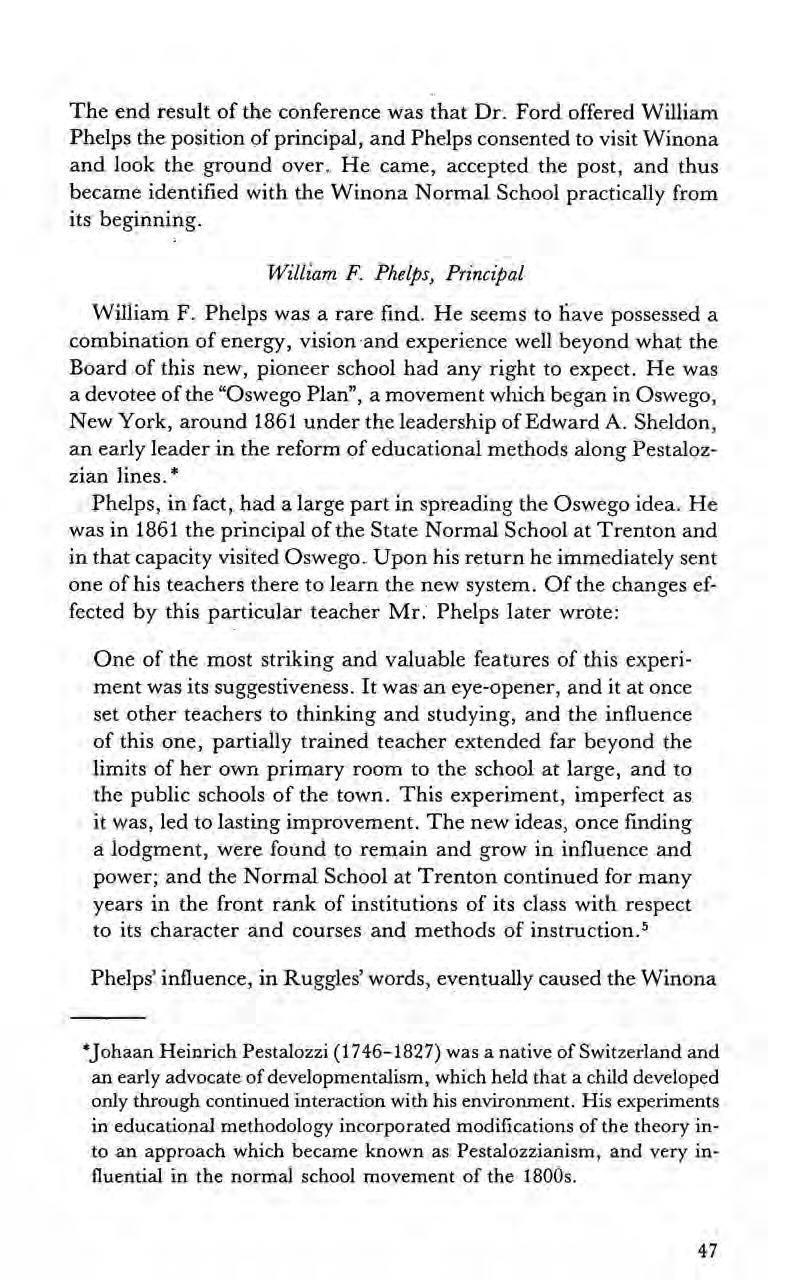
The end result of theconference was that Dr. Ford offered William Phelps the position of principal, and Phelps consented to visit Winona and look the ground over. He came, accepted the post, and thus became identified with the Winona Normal School practically from its beginning.
William F. Phelps was a rare find. He seems to have possessed a combination of energy, vision-and experience well beyond what the Board of this new, pioneer school had any right to expect. He was a devotee of the “Oswego Plan”, a movement which began in Oswego, New York, around 1861 under the leadership of Edward A. Sheldon, an early leader in the reform of educational methods along Pestalozzian lines. *
Phelps, in fact, had a large part in spreading the Oswego idea. He was in 1861 the principal of the State Normal School at Trenton and in that capacity visited Oswego. Upon his return he immediately sent one of his teachers there to learn the new system. Of the changes effected by this particular teacher Mr. Phelps later wrote:
One of the most striking and valuable features of this experiment was its suggestiveness. It was an eye-opener, and it at once set other teachers to thinking and studying, and the influence of this one, partially trained teacher extended far beyond the limits of her own primary room to the school at large, and to the public schools of the town. This experiment,imperfect as it was, led to lasting improvement. The new ideas, once finding a lodgment, were found to remain and grow in influence and power; and the Normal School at Trenton continued for many years in the front rank of institutions of its class with respect to its character and courses and methods of instruction.°®
Phelps’ influence, in Ruggles’ words, eventually caused the Winona
*Johaan Heinrich Pestalozzi (1746-1827) was a native of Switzerland and an early advocate ofdevelopmentalism, which held that a child developed only through continued interaction with his environment. His experiments in educational methodology incorporated modifications of the theory into an approach which became known as Pestalozzianism, and very influential in the normal school movement of the 1800s.

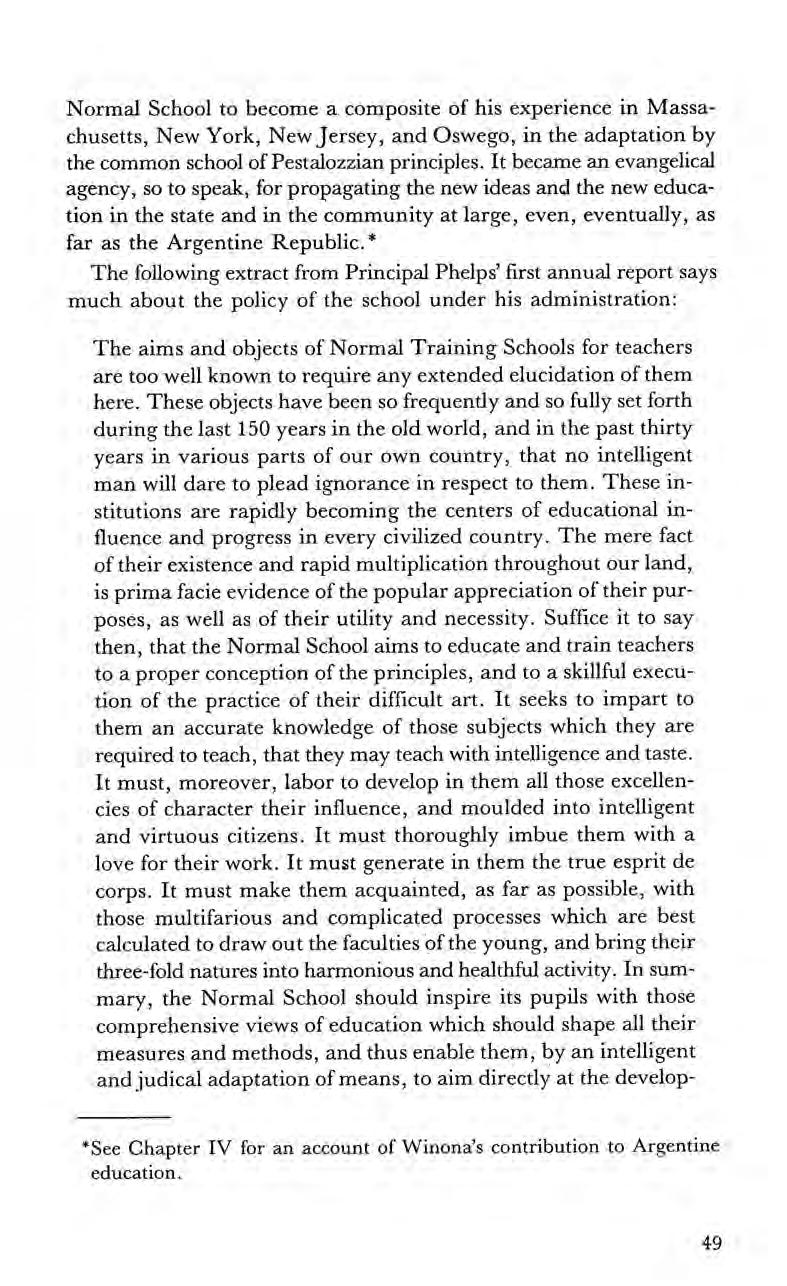
Normal School to become a composite of his experience in Massachusetts, New York, New Jersey, and Oswego, in the adaptation by the common school of Pestalozzian principles. It became an evangelical agency, so to speak, for propagating the new ideas and the new education in the state and in the community at large, even, eventually, as far as the Argentine Republic.*
The following extract from Principal Phelps’ first annual report says much about the policy of the school under his administration:
The aimsand objects of Normal Training Schools for teachers are too well known to require any extended elucidation of them here. These objects have been so frequently and so fully set forth during the last 150 years in the old world, and in the past thirty years in various parts of our own country, that no intelligent man will dare to plead ignorance in respect to them. These institutions are rapidly becoming the centers of educational influence and progress in every civilized country. The mere fact of their existence and rapid multiplication throughout our land, is prima facie evidence of the popular appreciation of their purposés, as well as oftheir utility and necessity. Suffice it to say then, that the Normal School aims to educate and train teachers to a proper conception of the principles, and to a skillful execution of the practice of their difficult art. It seeks to impart to them an accurate knowledge of those subjects which they are required to teach, that they may teach with intelligence and taste. It must, moreover, labor to develop in them all those excellencies of character their influence, and moulded into intelligent and virtuous citizens. It must thoroughly imbue them with a love for their work. It must generate in them the true esprit de corps. It must make them acquainted, as far as possible, with those multifarious and complicated processes which are best calculated to draw out the faculties of the young, and bring their three-fold natures into harmonious and healthful activity. In summary, the Normal School should inspire its pupils with those comprehensive views of education which should shape all their measures and methods, and thus enable them, by an intelligent and judical adaptation of means, to aim directly at the develop-
*See Chapter IV for an account of Winona’s contribution to Argentine education.
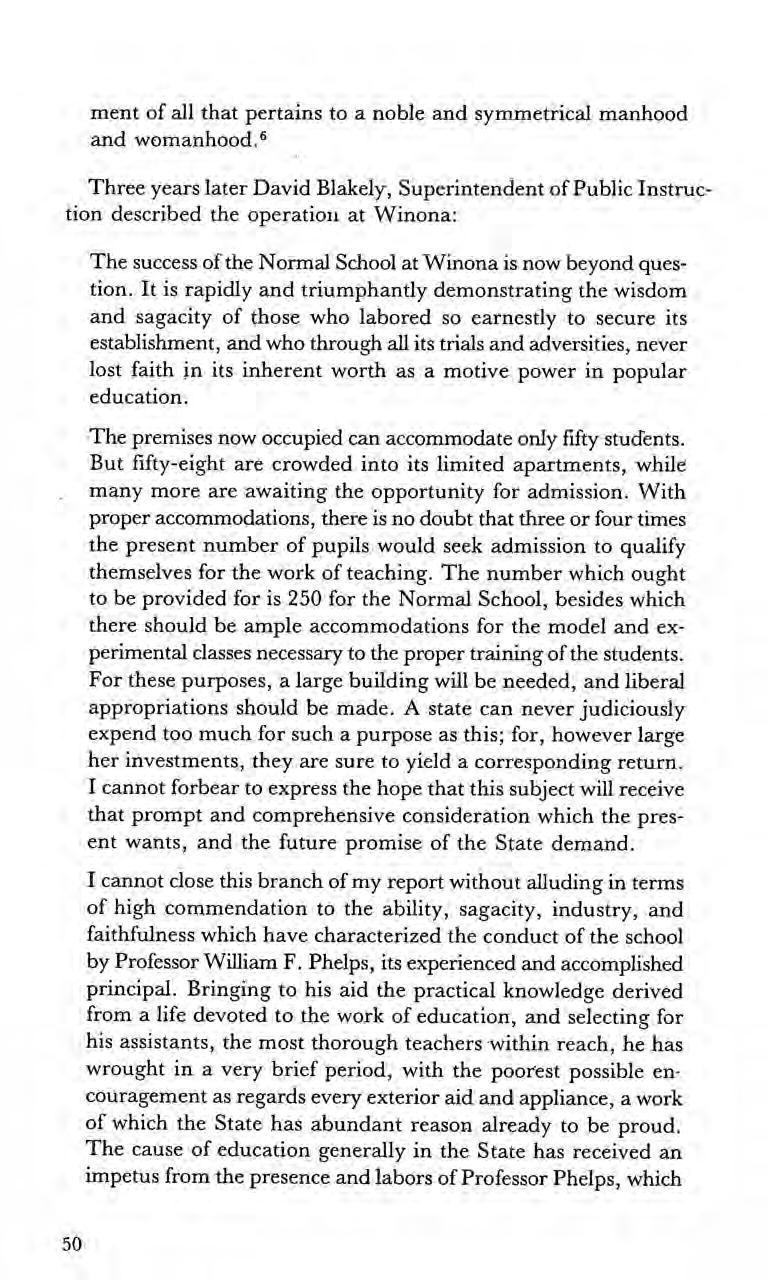
ment of all that pertains to a noble and symmetrical manhood and womanhood.®
Three years later David Blakely, Superintendent of Public Instruction described the operation at Winona:
The success ofthe Normal School at Winona is now beyond question. It is rapidly and triumphantly demonstrating the wisdom and sagacity of those who labored so earnestly to secure its establishment, and who through all its trials and adversities, never lost faith in its inherent worth as a motive power in popular education.
‘The premises now occupied can accommodate only fifty students. But fifty-eight are crowded into its limited apartments, while many more are awaiting the opportunity for admission. With proper accommodations, there is no doubt that three or four times the present number of pupils would seek admission to qualify themselves for the work of teaching. The number which ought to be provided for is 250 for the Normal School, besides which there should be ample accommodations for the model and experimental classes necessary to the proper training ofthe students. For these purposes, a large building will be needed, and liberal appropriations should be made. A state can never judiciously expend too much for such a purpose as this; for, however large her investments, they aresure to yield a corresponding return. I cannot forbear to express the hope that this subject will receive that prompt and comprehensive consideration which the present wants, andthe future promise of the State demand.
I cannot close this branch of my report without alluding in terms of high commendation to the ability, sagacity, industry, and faithfulness which have characterized the conduct of the school by Professor William F. Phelps, its experienced and accomplished principal. Bringing to his aid the practical knowledge derived froma life devoted to the work of education, and selecting for his assistants, the most thorough teachers within reach, he has wrought in a very brief period, with the poorest possible encouragement as regards every exterior aid and appliance, a work of which the State has abundant reason already to be proud. The cause of education generally in the State has received an impetus from the presence and labors of Professor Phelps, which

this department is glad to recognize, and which the Legislature will doubtless be prompt to acknowledge.’
By the time the school was reopened on November 1, 1864, Principal Phelps had divided the school year into two terms instead of three as at the beginning, a plan retained until 1880. Also, with the reopening ofthe school a course of study prepared by Principal Phelps, more extensive as it turned out, than was justified by the Pioneer conditions of the state, appeared in his first report.
The studies indicated are arranged ag far as possible according to their natural affinities, and not according to the order in which they will be prosecuted by the student.
ENGLISH LANGUAGE-— Elementary sounds of the languages; pronunciation; spelling; analysis and definition ofwords; reading and elocution; grammar, including the analysis, synthesis and classification of sentences; composition, rhetoric; and criticism; English literature; THE BEST METHODS OF TEACHING THE ABOVE.
MATHEMATICS
Number; its properties and laws; intellectual and written arithmetic; form, the facts of geometry; theoretical and practical geometry; elements of algebra; bookkeeping; surveying and civil engineering; BEST METHODS OF TEACHING THE ABOVE.
PHYSICAL AND NATURAL SCIENCES — Natural philosophy; physical and political geography; chemistry; botany; natural history; human philosophy, geology; elements of agriculture; astronomy; BEST METHODS OF TEACHING THE ABOVE.
GRAPHICS Principles and practice of penmanship; isometric and perspective drawing; object drawing; industrial drawing; topographical drawing; drawing applied to illustrative teaching: BEST METHODS OF TEACHING DRAWING.
POLITICAL ECONOMY — Science of government; constitution of the United States and of Minnesota; lectures on the resources of the United States and Minnesota; history of the United States.

Intellectual and moral philosophy; lectures on the principles of education; history of education; didactic exercises or sublectures; observation in model school; preparation of sketches; criticism; lessons in teaching; teaching in practice school; school laws of Minnesota.®
The content of this course again shows the influence ofthe “Oswego Movement”. Pushed forward as it was by a person who was thoroughly acquainted with the normal schools at Albany, Trenton, and Oswego, it represented the standard normal school course of that day adapted to the pioneer conditions of the new state.
A marked feature ofthe course was the attention given to agriculture and the sciences collateral to it. The students of the normal school were all sons and daughters of the working and rural classes of the state and it was expected that they would one day return to their various homes, mingle with their friends and communicate to them that knowledge which they had acquired relative to industrial and agricultural pursuits.
But it was all too ambitious! Phelps had overestimated the ability ofthese pioneer students who were to seek the benefits ofnormal school instruction, and is quoted as saying in 1860: “As an indication of the deficient character of the instruction prevalent at the present time, it may be stated that, although one year and three months have elapsed since the reopening of the normal school, no class has yet beenable to advance beyond what are known as the common or elementary branches.”® This course therefore never became fully effective. While it was intended to require three years for completion, the entrance requirements remained the same as in 1860. The records show that lack of sufficient room, the pressing demand for teachers in the state, and the unprepared condition of the students prevented the retention of classes for the completion of the entire course as outlined on paper. Graduation was finally recommended on the completion of two years of the work.
In spite of the principal’s overly ambitious early expectations and consequent disappointment, adjustments were eventually made and the quality of the student body upgraded to the point where by the end of the 1865 spring term the normal school could successfully undergo its first public examination. It was carefully chronicled by the Winona Daily Republican. Regarding the results of that examination the superintendent of Steele County, Mr. A. A. Harwood, in

his report to the Superintendent of Public Instruction, waxed enthusiastic:
I cannot close this report without alluding to the highly beneficialinfluence which the State Normal School, if properly fostered, is destined to exert for the improvement of our public schools. It has already begun, and will continue more rapidly to furnish properly qualified teachers for the district schools. It was my privilege, as one of the committee, to participate in the examination at the close of the term endingJune 28th, 1865. And to express myself briefly, I will say that persons emanating from that institution are denuded of everything pertaining to education of character which is improper or unchaste, and robed with a vestiture which imparts a grace to worth and adds the charm of loveliness to beauty of thought and propriety of action. If we afford material aid to the normal school, so as to enlarge its capacity and increase its influence, time will reimburse us with a golden wealth of moral and intellectual purity.'°
The last week in June, 1866, was something of a landmark in the history of the new normal school. The following notice appeared in the Winona Dialy Republican for June 25:
The annual examination of the State Normal School will take place this week, commencing at nine o’clock tomorrow morning at the Methodist Church. The exercises will be of a public character, and will be of great interest throughout. There will doubtless be a large attendance of the prominent friends of education from various parts of the State. Among these, Governor Marshall has announced his intention to be present, as also exLeut. Governor Holcombe, and others. Our own citizens and especially those who have children or friends in attendance should not neglect to witness the examination exercises."
Fayette Cook, a member of the first graduating class, in describing these graduating exercises noted that much was made of the public examinations in those early years of the institution.* This is easy to
*Mr. Cook later became President of the Spearfish, South Dakota, Normal School.
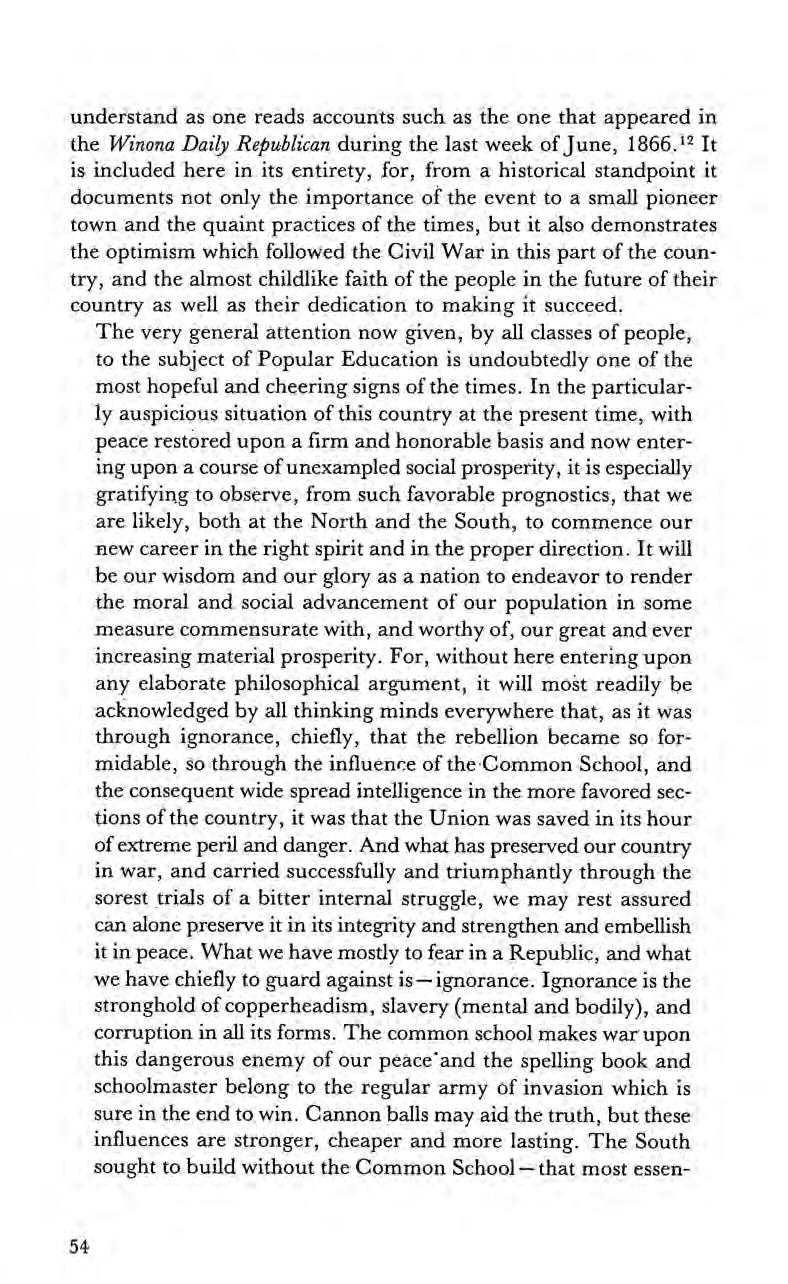
understand as one reads accounts such as the one that appeared in the Winona Daily Republican during the last week ofJune, 1866.'? It is included here in its entirety, for, from a historical standpoint it documents not only the importance of the eventto a small pioneer town and the quaint practices of the times, but it also demonstrates the optimism which followed the Civil War in this part of the country, and the almost childlike faith of the people in the future of their country as well as their dedication to making it succeed. The very general attention now given, by all classes of people, to the subject of Popular Education is undoubtedly one of the most hopeful and cheering signs of the times. In the particularly auspicious situation of this country at the present time, with peace restored upona firm and honorable basis and now entering upon a course ofunexampled social prosperity, it is especially gratifying to observe, from such favorable prognostics, that we are likely, both at the North and the South, to commence our new career in the right spirit and in the proper direction. It will be our wisdom and our glory as a nation to endeavor to render the moral and social advancement of our population in some measure commensurate with, and worthy of, our great and ever increasing material prosperity. For, without here entering upon any elaborate philosophical argument, it will most readily be acknowledged by all thinking minds everywhere that, as it was through ignorance, chiefly, that the rebellion became so formidable, so through the influence of the Common School, and the consequent wide spread intelligence in the more favored sections of the country, it was that the Union was saved in its hour of extreme peril and danger. And what has preserved our country in war, and carried successfully and triumphantly through the sorest trials of a bitter internal struggle, we may rest assured can alone preserve it in its integrity and strengthen and embellish it in peace. What we have mostly to fear in a Republic, and what we have chiefly to guard against is— ignorance. Ignorance is the stronghold of copperheadism, slavery (mental and bodily), and corruption in all its forms. The common school makes war upon this dangerous enemy of our peace‘and the spelling book and schoolmaster belong to the regular army of invasion which is sure in the end to win. Cannon balls may aid the truth, but these influences are stronger, cheaper and more lasting. The South sought to build without the Common School —that most essen-

tial pillar of all genuine and lasting national prosperity and progress, and their house fell and could not help falling because it was founded upon sand. Their case is a lesson to the whole country; for all more or less need reconstructing. It proves that only as we are true to the vital and lasting interests of humanity can we hope to build up the social temple upon an enduring foundation never to be shaken.
We have thought proper to devote some considerable portion of our space this week to educational matters, partly on account of their intrinsic importance to our State, in which they might more appropriately find a place.
The examination of the State Normal School, as previously announced, commenced this morning at nine o'clock in the Methodist Church. The day being fine, the meeting was very well attended, not only by our own citizens but many prominent friends and patrons of education throughout the state.
The exercises, the first day, were of the most interesting character. After prayers and singing, Professor Phelps introduced a class from the Normal department to illustrate the best methods of teaching arithmetic in some of its more advanced branches. The students answered with great readiness and accuracy the various questions proposed, which were of a thorough and searching character and which showed the complete training they had received at the hands of their accomplished teacher. ‘They showed clearly that they understood the rationale of the subject, and had mastered the fundamental principles of arithmetic, a correct and comprehensive knowledge of which is essential to those who would teach it with success. In solving questions the blackboard was freely used, every step in the process of arriving at a definition or a solution was closely examined; nothing was taken for granted, but everything subjected to the most searching Socratic ordeal of interrogation, and brought fothe test of a minute and exhaustible discussion. This method of teaching arithmetic is decidedly preferable to the mere mechanical solution of problems. By meansof it, the intellectual faculties are more rigidly exercised than by any other system, for all, but especially for those who intend to be teachers by profession, it is a most valuable exercise. No rule can ever be thoroughly understood without
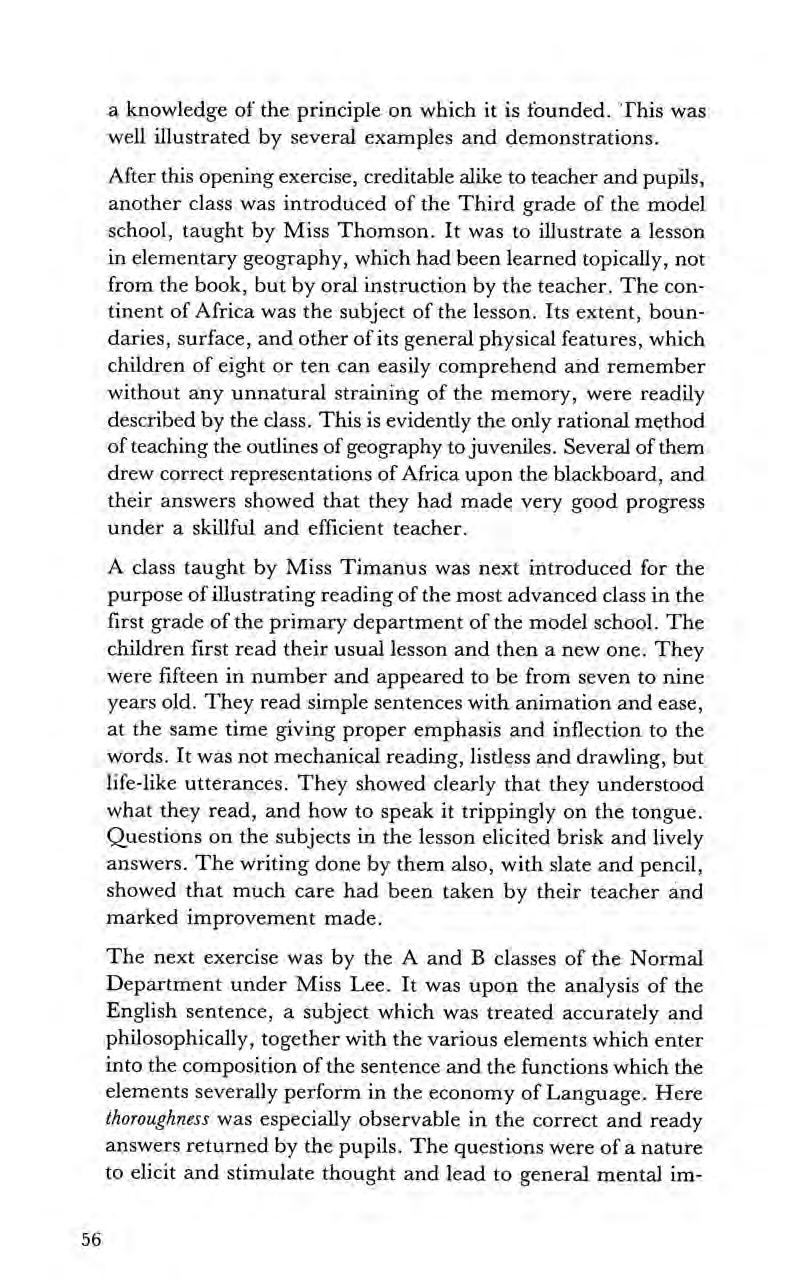
a knowledge of the principle on which it is founded. ‘This was well illustrated by several examples and demonstrations.
After this opening exercise, creditable alike to teacher and pupils, another class was introduced of the Third grade of the model school, taught by Miss Thomson. It was to illustrate a lesson in elementary geography, which had been learned topically, not from the book, but by oral instruction by the teacher. The continent of Africa was the subject of the lesson. Its extent, boundaries, surface, and other of its general physical features, which children of eight or ten can easily comprehend and remember without any unnatural straining of the memory, were readily described by the class. This is evidently the only rational method of teaching the outlines of geography to juveniles. Several of them drew correct representations of Africa upon the blackboard, and their answers showed that they had made very good progress under a skillful and efficient teacher.
A class taught by Miss Timanus was next introduced for the purpose of illustrating reading of the most advanced class in the first grade of the primary department of the model school. The children first read their usual lesson and then a new one. They were fifteen in number and appeared to be from seven to nine years old. They read simple sentences with animation and ease, at the same time giving proper emphasis and inflection to the words. It was not mechanical reading, listless and drawling, but life-like utterances. They showed clearly that they understood what they read, and how to speak it trippingly on the tongue. Questions on the subjects in the lesson elicited brisk and lively answers. The writing done by them also, with slate and pencil, showed that much care had been taken by their teacher and marked improvement made.
The next exercise was by the A and B classes of the Normal Department under Miss Lee. It was upon the analysis of the English sentence, a subject which was treated accurately and philosophically, together with the various elements which enter into the composition of the sentence and the functions which the elements severally perform in the economy of Language. Here thoroughness was especially observable in the correct and ready answers returned by the pupils. The questions were of a nature to elicit and stimulate thought and lead to general mental im-

provement. This method of analysis, applied to the English language, is a very good substitute for the training received by the critical study of the ancient classic languages of Greece and Rome. It affords at once an interesting and agreeable exercise to pupils who have any turn for literature, and develops beauty of expression and gems of thought which are apt to be passed over by the less critical student of language.
After a short interval, which was well filled by the singing of a lively air, a class in the Second Department of the model school, taught by Miss Gilbert, was introduced. The scholars were fifteen in number, averaging about eight years old. It was to illustrate the rule of subtraction, taught in its simplest and most philosophical method. The chidren all did remarkably well, and showed that great pains had been taken to initiate them into the mysteries of “borrowing ten.” Specimens of their writing on slates were very creditable likewise.
The first exhibition in the afternoon was an exercise given by one of the students of the Normal School, selected at random, to develop, in the form of a class lesson, theidea of angles and the different kinds of angles. This, the Principal observed, was one of the means resorted to for educating the teaching talent of the young ladies and gentlemen attending the institution. Miss Sheldon, of Hennepin County, was the pupil selected to conduct the examination in this instance, and the young lady did so with considerable tact and ability. It is the object of the teacher, in such a case, to labor to impart some knowledge of angles to those who are old enough to understand the nature of angles; and the class is made up either of those who do not know, or are supposed not to be acquainted with the subject. It is clear that the possession of fundamental ideas of this kind is a far more valuable acquistion, as well as a more improving exercise, than the memorizing of a number of problems in geometry, which are but imperfectly understood. After the exercise was completed, a searching criticism by various pupils followed. Defects were pointed out and excellencies commended, and by repeated exercises of this description, when they became in turn the critic and the criticized, the pupils came at length, by the hard tasking of their powers, to a full knowledge of the requirements of their profession, which they could do in no other way.
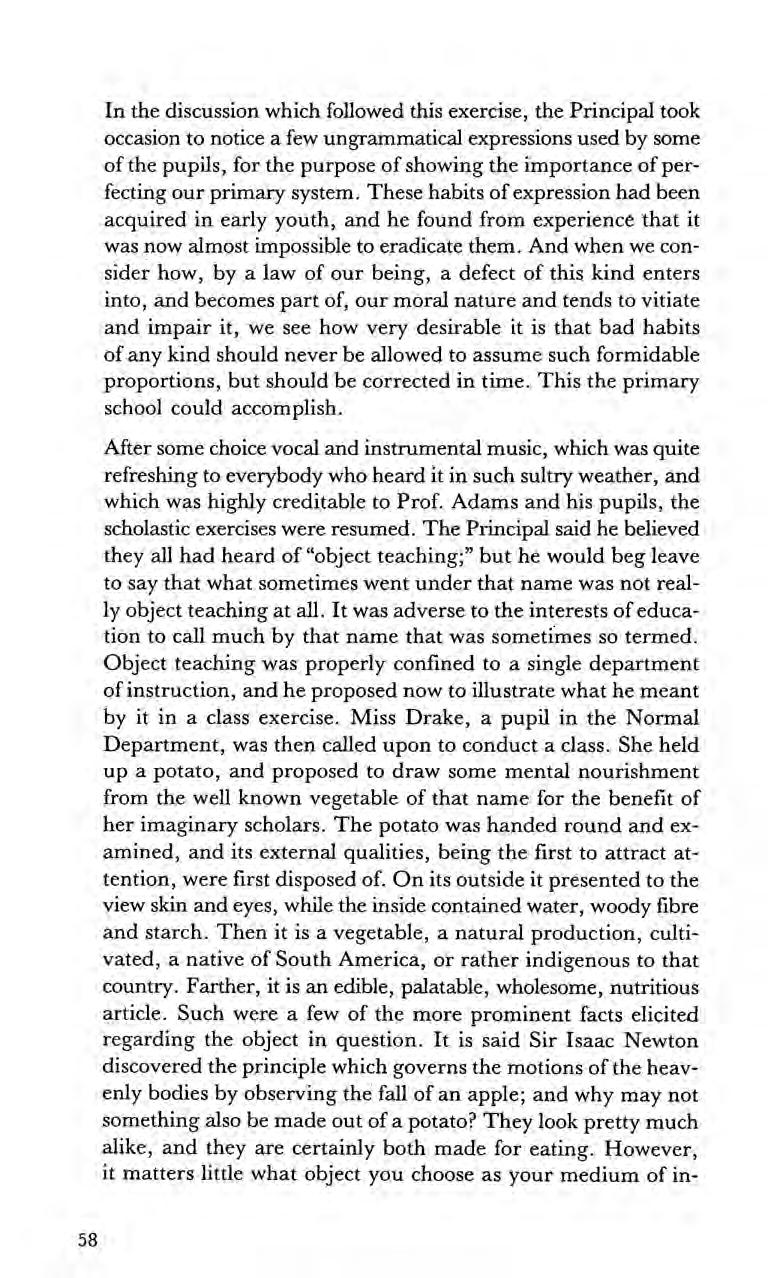
In the discussion which followed this exercise, the Principal took occasion to notice a few ungrammatical expressions used by some of the pupils, for the purpose of showing the importance of perfecting our primary system. These habits of expression had been acquired in early youth, and he found from experience that it was now almost impossible to eradicate them. And when we consider how, by a law of our being, a defect of this kind enters into, and becomes part of, our moral nature and tends to vitiate and impair it, we see how very desirable it is that bad habits of any kind should never be allowed to assume such formidable proportions, but should be corrected in time. This the primary school could accomplish.
After some choice vocal and instrumental music, which was quite refreshing to everybody who heard it in such sultry weather, and which was highly creditable to Prof. Adams and his pupils, the scholastic exercises were resumed. The Principal said he believed they all had heard of “object teaching;” but he would beg leave to say that what sometimes went under that name was not really object teaching at all. It was adverse to theinterests of education to call much by that name that was sometimes so termed. Object teaching was properly confined to a single department of instruction, and he proposed now to illustrate what he meant by it in a class exercise. Miss Drake, a pupil in the Normal Department, was then called upon to conduct a class. She held up a potato, and proposed to draw some mental nourishment from the wellknown vegetable of that name for the benefit of her imaginary scholars. The potato was handed round and examined, and its external qualities, being the first to attract attention, were first disposed of. On its outside it présented to the view skin and eyes, while the inside contained water, woody fibre and starch. Then it is a vegetable, a natural production, cultivated, a native of South America, or rather indigenous to that country. Farther, it is an edible, palatable, wholesome, nutritious article. Such were a few of the more prominent facts elicited regarding the object in question. It is said Sir Isaac Newton discovered the principle which governs the motions of theheavenly bodies by observing the fall of an apple; and why may not something also be made out of a potato? They look pretty much alike, and they are certainly both made for eating. However, it matters little what object you choose as your medium of in-

struction, although it is not every one that can turn their apples to so good an account as Newton. Every object in nature is related to all the rest, and the-whole to each. It is proposed to investigate those relations, and in proportion as your knowledge is accurate and well defined will it be reliable and valuable. With any object in your hand—a leaf, a stone, a metal, anything, you’ can travel in imagination round the wide realms of nature, animate and inanimate, and by this process of questioning, properly followed out, correct your knowledge of information as well as greatly enlarge its boundaries. After the recitation, a criticism upon the method of evolving the ideas, the accuracy of the statements made, and the language used in discussing the potato, was pronounced by several of the pupils, and the weak and strong points of the case duly indicated. In Normal training, this is a first rate exercise for the mind. The danger is in dwelling upon a superficial view of the qualities of an object. Thorough and accurate knowledge is the great thing aimed at, and with this in view an “object lesson” ought always to be as carefully prepared as any other. Without this, as Prof. Phelps well observed, the lesson might as well be omitted altogether.
A primary lesson in geography, conducted by Miss Gilbert, was the next exercise. The class consisted of some twelve children of from seven to ten years of age. The primary definitions were gone into and expressed in clear, comprehensive, and yet simple language. The appearance was highly satisfactory.
The next class examined was one taught by Miss Thomson, belonging to the third grade, model school. The pupils averaged ten to twelve years and the exercise was upon common or vulgar fractions, ofwhich the children had evidently very correct ideas, as evidenced by their answers. With regard to this class, Prof. Phelps stated that they had never before studied fractions, nor indeed been accustomed to a rational explanation of anything. Their progress was certainly remarkable under the circumstances and was creditable to the skill and industry of the teacher.
Next came forward some thirty or forty small children, under the care of Miss Timanus of the model school, to recite a scripture lesson. Previous however, to the lesson, they gave an exhibition of physical exercises such as they are accustomed to daily. The scripture lesson consisted of the most prominent facts in
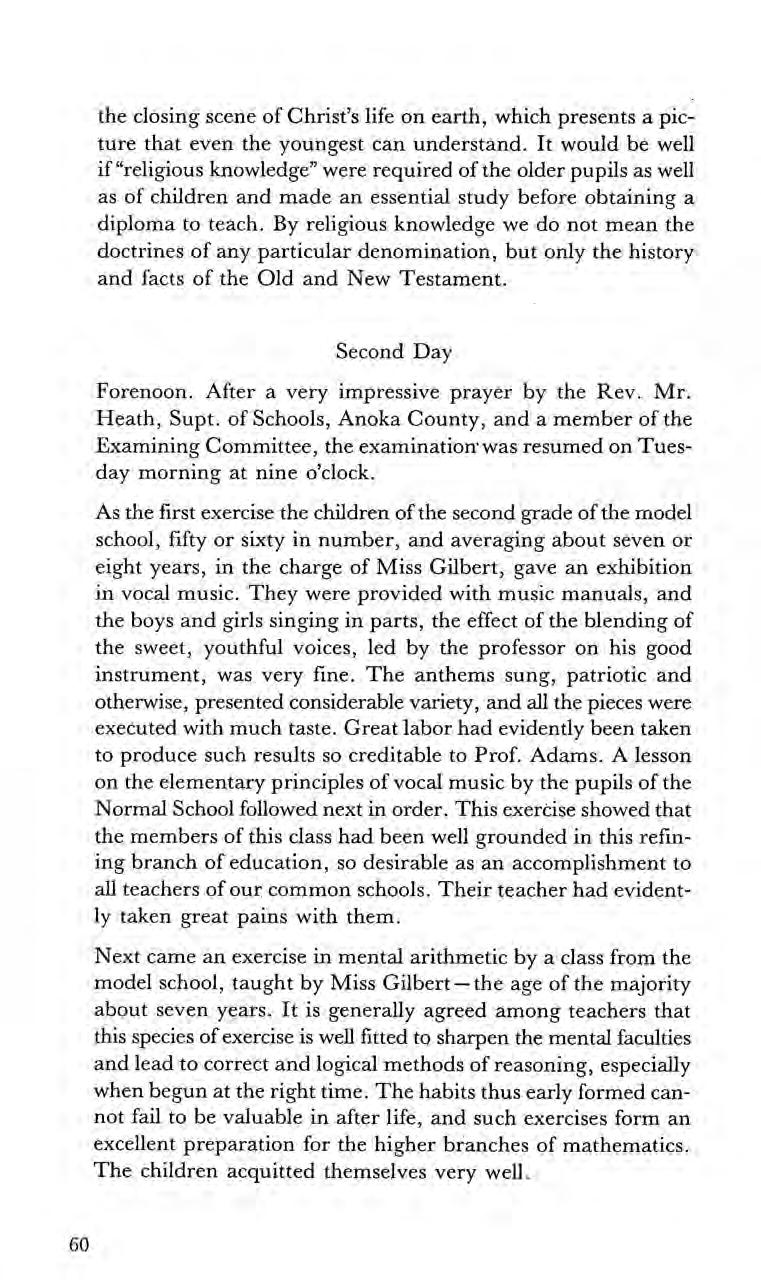
the closing scene of Christ’s life on earth, which presents a picture that even the youngest can understand. It would be well if “religious knowledge” were required of the older pupils as well as of children and made an essential study before obtaining a diploma to teach. By religious knowledge we do not mean the doctrines of any particular denomination, but only the history and facts of the Old and New Testament.
Forenoon. After a very impressive prayer by the Rev. Mr. Heath, Supt. of Schools, Anoka County, and a member of the Examining Committee, the examination was resumed on Tuesday morning at nine o'clock.
As the first exercise the children of the second grade ofthe model school, fifty or sixty in number, and averaging about seven or eight years, in the charge of Miss Gilbert, gave an exhibition in vocal music. They were provided with music manuals, and the boys and girls singing in parts, the effect of the blending of the sweet, youthful voices, led by the professor on his good instrument, was very fine. The anthems sung, patriotic and otherwise, presented considerable variety, and all the pieces were executed with much taste. Great labor had evidently been taken to produce such results so creditable to Prof. Adams. A lesson on the elementary principles of vocal music by the pupils of the Normal School followed next in order. This exercise showed that the members of this class had been well grounded in this refining branch of education, so desirable as an accomplishment to all teachers of our common schools. Their teacherhad evidently taken great pains with them.
Next came an exercise in mental arithmetic by a class from the model school, taught by Miss Gilbert — the age of the majority about seven years. It is generally agreed among teachers that this species of exercise is well fitted to sharpen the mental faculties and lead to correct and logical methods of reasoning, especially when begun at the right time. The habits thus early formed cannot fail to be valuable in after life, and such exercises form an excellent preparation for the higher branches of mathematics. The children acquitted themselves very well.
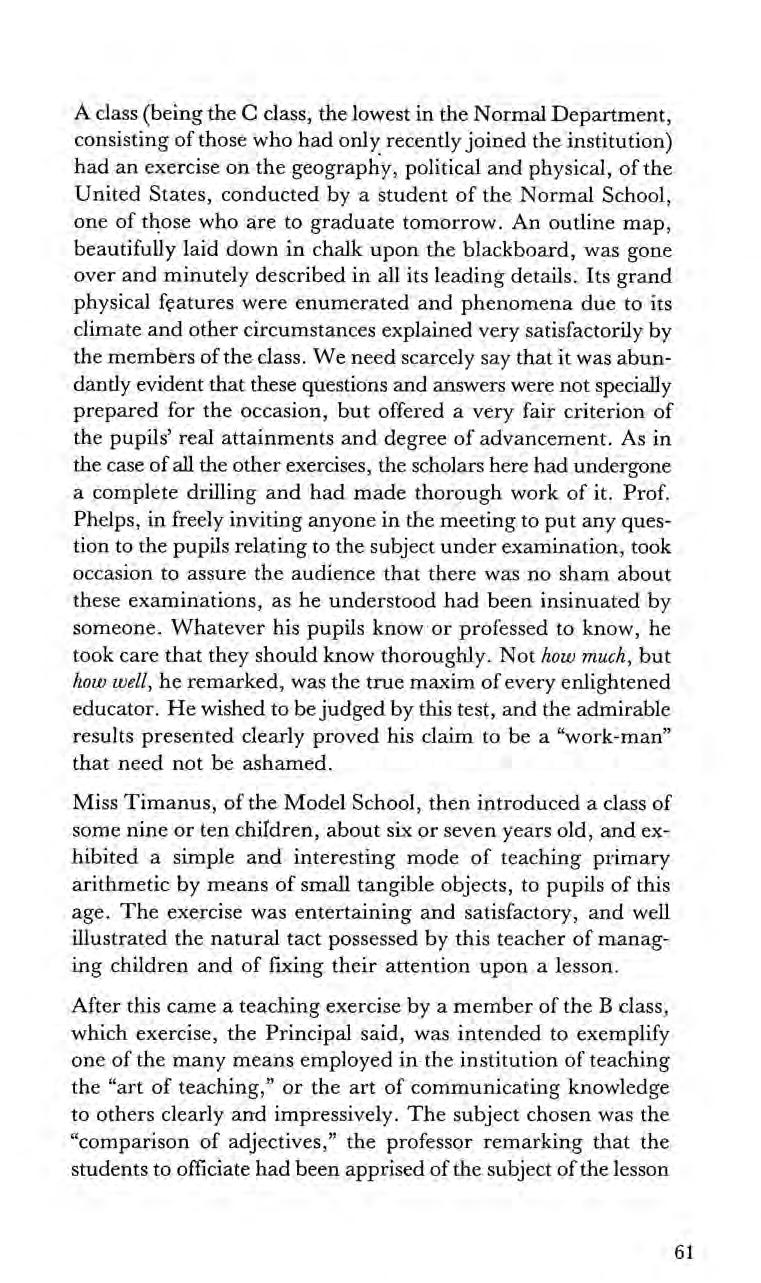
A class (being the C class, the lowest in the Normal Department, consisting of those who had only recentlyjoined the institution) had an exercise on the geography, political and physical, of the United States, conducted by a student of the Normal School, one of those who are to graduate tomorrow. An outline map, beautifully laid down in chalk upon the blackboard, was gone over and minutely described in all its leading details. Its grand physical features were enumerated and phenomena due to its climate and other circumstances explained very satisfactorily by the members ofthe class. We need scarcely say that it was abundantly evident that these questions and answers were not specially prepared for the occasion, but offered a very fair criterion of the pupils’ real attainments and degree of advancement. As in the case of all the other exercises, the scholars here had undergone a complete drilling and had made thorough work of it. Prof. Phelps, in freely inviting anyone in the meeting to put any question to the pupils relating to the subject under examination, took occasion to assure the audience that there was no sham about these examinations, as he understood had been insinuated by someone. Whatever his pupils know or professed to know, he took care that they should know thoroughly. Not how much, but how well, he remarked, was the true maxim of every enlightened educator. He wished to be judged by this test, and the admirable results presented clearly proved his claim to be a “work-man” that need not be ashamed.
Miss Timanus, of the Model School, then introduceda class of some nine or ten children, about six or seven years old, and exhibited a simple and interesting mode of teaching primary arithmetic by means of small tangible objects, to pupils of this age. The exercise was entertaining and satisfactory, and well illustrated the natural tact possessed by this teacher of managing children and of fixing their attention upon a lesson.
After this came a teaching exercise by a member of theB class, which exercise, the Principal said, was intended to exemplify one of the many means employedin the institution of teaching the “art of teaching,” or the art of communicating knowledge to others clearly and impressively. ‘The subject chosen was the “comparison of adjectives,” the professor remarking that the students to officiate had been apprised ofthe subject ofthe lesson
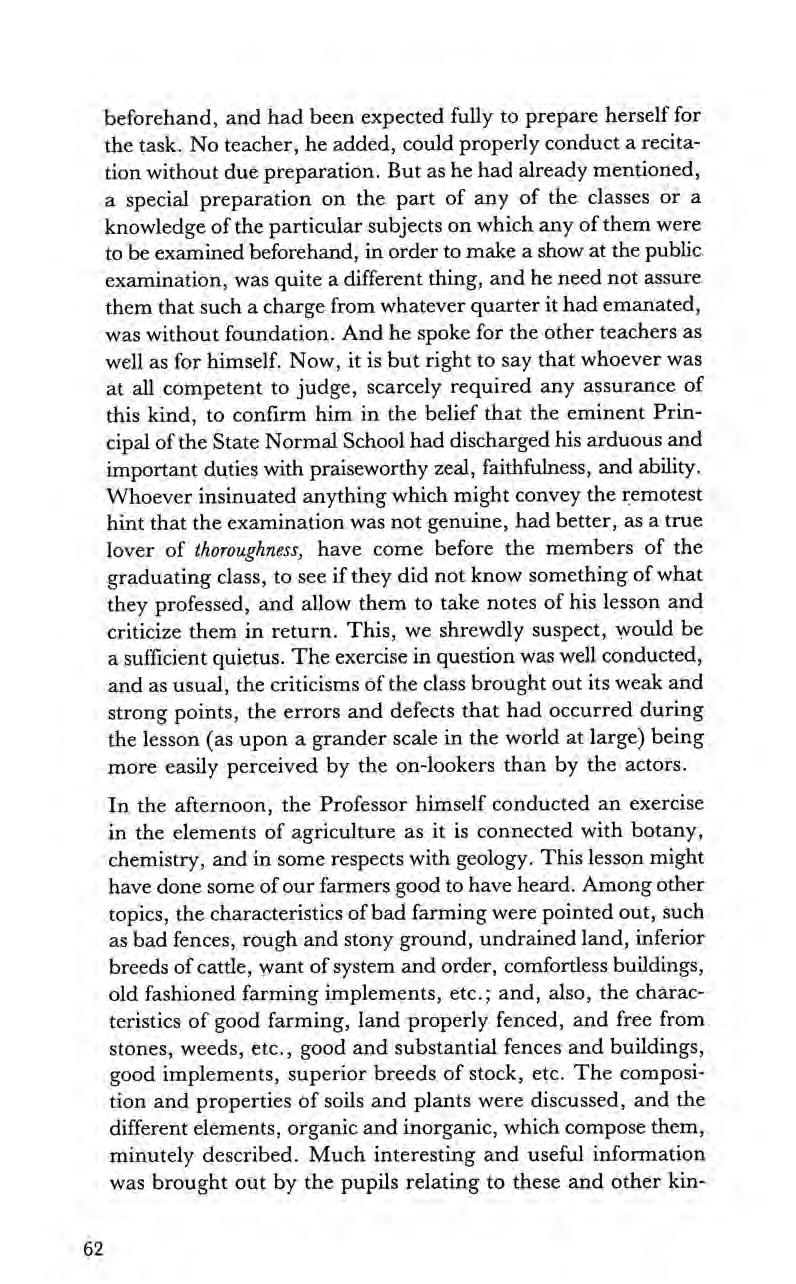
beforehand, and had been expected fully to prepare herself for the task. No teacher, he added, could properly conduct a recitation without due preparation. But as he had already mentioned, a special preparation on the part of any of the classes or a knowledge of the particular subjects on which any of them were to be examined beforehand, in order to makea show at the public examination, was quite a different thing, and he need not assure them that such a charge from whatever quarter it had emanated, was without foundation. And he spoke for the other teachers as well as for himself. Now, it is but right to say that whoever was at all competent to judge, scarcely required any assurance of this kind, to confirm him in the belief that the eminent Principal of the State Normal School had discharged his arduous and important duties with praiseworthy zeal, faithfulness, and ability. Whoever insinuated anything which might convey the remotest hint that the examination was not genuine, had better, as a true lover of thoroughness, have come before the members of the graduating class, to see if they did not know something of what they professed, and allow them to take notes of his lesson and criticize them in return. This, we shrewdly suspect, would be a sufficient quietus. The exercise in question was well conducted, and as usual, the criticisms of the class brought out its weak and strong points, the errors and defects that had occurred during the lesson (as upon a grander scale in the world at large) being more easily perceived by the on-lookers than by the actors.
In the afternoon, the Professor himself conducted an exercise in the elements of agriculture as it is connected with botany, chemistry, and in some respects with geology. This lesson might have done some of our farmers good to have heard. Among other topics, the characteristics of bad farming were pointed out, such as bad fences, rough and stony ground, undrained land, inferior breeds of cattle, want of system and order, comfortless buildings, old fashioned farming implements, etc.; and, also, the characteristics of good farming, land properly fenced, and free from stones, weeds, etc., good and substantial fences and buildings, good implements, superior breeds of stock, etc. The composition and properties of soils and plants were discussed, and the different elements, organic and inorganic, which compose them, minutely described. Much interesting and useful information was brought out by the pupils relating to these and other kin-

dred topics. Under every disadvantage, a great deal of what is known as popular or familiar science had been learned and learned thoroughly. But it is to be hoped that the time will soon come when the Normal School of Minnesota will be supplied with all the means and appliances for teaching agriculture, chemistry, and other kindred sciences.
A class in reading, taught by Miss Timanus, followed, belonging to the second department of the Model School. This class ofjuveniles first read an old and then a new lesson. They read -with fluency, accuracy, and propriety, paying always strict attention to the meaning, and duly observing also the rules for rising and falling inflections. The audience sees the most pleasant part of it when they hear those children read so correctly, but they can scarcely realize the labor and patience expended upona class of this kind.
The afternoon’s proceedings closed with a recitation by a class in geography, taught by Miss Lees, subject—South America, which was thoroughly discussed in all its minutest details. It is needless to say that this exhibition was likewise very creditable to the teacher as well as to the pupils.
On the third and closing day the examination of the Normal School was very well attended throughout the proceedings by a most attentive audience, consisting of many of our own citizens, the parents of pupils from a distance, and other friends of education. It is gratifying to notice that with the exception of the Secretary of State, all the members of the Normal School Board were in attendance. The names ofthese gentlemen are as follows: Dr. Ford, ofWinona, President of the Board—a gentleman who has ever manifested the warmest interest in the cause and who attended during the whole examination closely; H. T. Parker, Austin; Mr. Haskell, Afton; Geo. W. Prescott, St. Paul; Mr. Barnes, St. Cloud; and Mr. Buck, Mankato. After singing and prayer, the proceedings of the Normal School commenced, on Thursday, by an exercise in vocal music. A class of some forty or fifty children, from the Model School, under Miss Gilbert, sang a variety ofbeautiful anthems with much spirit and animation, and at the same time very tastefully and cor-
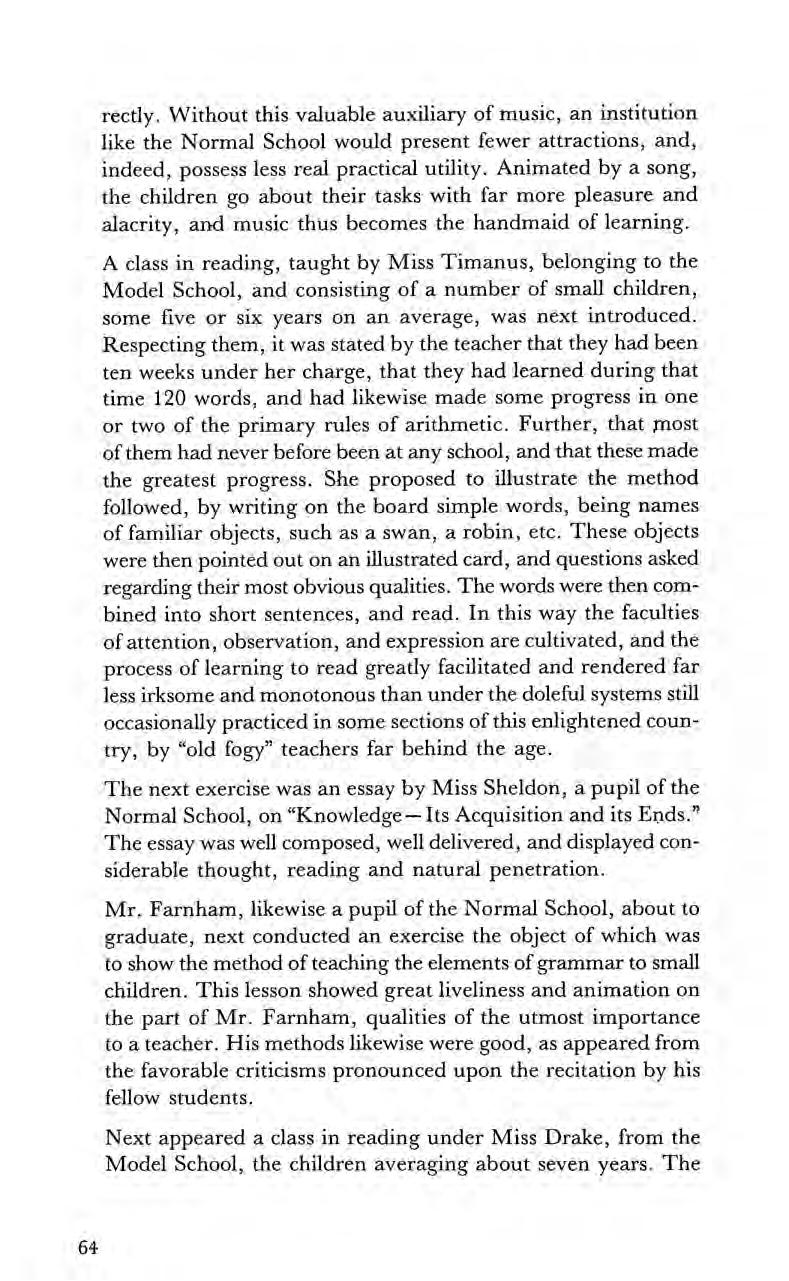
rectly. Without this valuable auxiliary of music, an institution like the Normal School would present fewer attractions, and, indeed, possess less real practical utility. Animated by a song, the children go about their tasks with far more pleasure and alacrity, and music thus becomes the handmaid of learning.
A class in reading, taught by Miss Timanus, belonging to the Model School, and consisting of a number of small children, some five or six years on an average, was next introduced.
Respecting them, it was stated by the teacher that they had been ten weeks under her charge, that they had learned during that time 120 words, and had likewise made some progress in one or two of the primary rules of arithmetic. Further, that most ofthem had never before been at any school, and that these made the greatest progress. She proposed to illustrate the method followed, by writing on the board simple words, being names offamiliar objects, such as a swan, a robin, etc. These objects were then pointed out on an illustrated card, and questions asked regarding their most obvious qualities. The words were then combined into short sentences, and read. In this way the faculties of attention, observation, and expression are cultivated, and the process of learning to read greatly facilitated and rendered far less irksome and monotonous than under the doleful systems still occasionally practiced in some sections of this enlightened country, by “old fogy” teachers far behind the age.
The next exercise was an essay by Miss Sheldon, a pupil of the Normal School, on “Knowledge Its Acquisition and its Ends.” The essay was well composed, well delivered, and displayed considerable thought, reading and natural penetration.
Mr. Farnham, likewise a pupil of the Normal School, about to graduate, next conducted an exercise the object of which was to show the method of teaching the elements of grammar to small children. This lesson showed great liveliness and animation on the part of Mr. Farnham, qualities of the utmost importance to a teacher. His methods likewise were good, as appeared from the favorable criticisms pronounced upon the recitation by his fellow students.
Next appeareda class in reading underMiss Drake, from the Model School, the children averaging about seven years. The

reading was animated and correct, and the pronunciation very good.
An essay by Miss Bingham on the “Difference between City and Country Children” followed. The subject was interesting and well treated; the composition was good, and some of the thoughts very suggestive and useful, especially to teachers.
Mr. Sanderson followed with an essay upon “Agriculture.” His production, which was highly creditable to a student, was well arranged, clearly and forcibly written, and delivered with eloquence and feeling. It was listened to throughout with much attention by the audience. In the essay pointed attention was drawn to the fact that under the present mode of cultivation, (unless changed for a more rational one,) ultimate ruin to our agricultural interests was inevitable. We might see the ruin of the West foreshadowed by the exhausted condition of thesoil in so many parts of the East. The remedy was to educate the farmer. Knowledge to him was wealth, pleasure, time, and power. Through means of the common schools we can eventually reach the farmer; but, first of all, agriculture, with its related sciences, ought to be introduced into the Normal Schools of the State and be made an essential branch of study by all candidates for the office of teacher.
An exercise on penmanship, conducted by Miss Timanus, in the form of questions addressed to the pupils of the Normal school, followed next in order. It seemed to be generally agreed that the best system of teaching writing yet devised was by the method of combining the eight principles, according to the Spencerian system; and this because that system was found to be the easiest, simplest, the most natural, and moreover, because it presented the most beautiful forms.
Mr. Farnham followed with an essay on the “English Language.” This production was terse, pointed, witty, and comprehensive. Moreover, it was very well delivered, and seemed to please the audience highly. Mr. Farnham alluded to the value ofthe AngloSaxon element as a component part of our language, and the one which formed the pith and marrow of our noble English speech. As English was peer in the hierarchy of language, so Anglo-Saxon was its most powerful and expressive element.

Eighty-seven percent of the words used by Shakespeare were of this origin; and all the leading English writers used a large percentage of the same nervous element. This fact was important to teachers.
Mr. Sanderson next conducted an exercise, the object of which was to develop the principles of musical tones. The students of the Normal School formed his class, and the questions put and answers given appeared to be highly satisfactory.
In the afternoon of Thursday, being the time fixed for the granting of diplomas, there was a very large assemblage collected in the church to witness the interesting and impressive ceremonies connected with the first graduation of Normal School pupils that had ever taken place in the State. The event formed in fact a new era in its history, and was full of hope and promise for the future. The platform was well filled with leading educators and other gentlemen of the first standing in Minnesota, while the body of the church was crowded to the doors with a most respectable and attentive audience. The weather was also very propitious, and the day seemed like one picked from the leafy month ofJune, and approvingly smiled on the auspicious occasion which was about to give birth to new and powerful influences destined to mould into higher forms of excellence the mental and moral character of our population in “the good time coming.”
At three o’clock, Dr. Ford, President of the Normal Board, called upon the Rev. Mr. Burt, of the Congregational Church, Winona, who offered up an earnest and impressive prayer. After some choice vocal and instrumental music, Dr. Ford rose and said they had now arrived at a very interesting period in the history of the Normal School—a period which many of them had looked forward to with no small degree of anxiety, not unmingled with pride and pleasure the graduation of the first class. ‘They were glad to see around them so many friends from a distance, as well as those nearer home. They had expected Governor Marshall to be present today, but were sorry to find he could not come. Prof. Phelps here read the telegram, which is as follows: St. Paul, June 28, 1866
To Professor W. F. Phelps, Winona: Duties here delayed me yesterday until the evening boat,
which failed to start on time. I regret it. I don’t need to be with you to know that your school is an eminent success. Be assured of my hearty co-operation in whatever its friends deem wise and just in its behalf.
W. R. MARSHALL.
Professor Phelps said the only objection he had to this was that the Governor spoke of the Normal School as “your school.” He would have preferred it if his Excellency had said “our school,” for it belonged to the State, and not to Winona exclusively. When he labored for its good, he considered he was working, not for Winona alone, but for the good of the whole State. When he advocated its interests he sought to advance the welfare of every section of the country. In building up the Normal School in the city of Winona, he considered himself as equally serving the interests ofevery locality throughout the whole extent of Minnesota.
Prof. Phelps then read the following note from the State Superintendent of Schools, viz.:
St. Paul, June 23, 1866

My Dear Sir:
I have just returned to the Capital, and am still quite unwell. I fear that I shall be unable to go to Winona on the 28th, as I expected. I regret it very much, and will certainly be there if my health permits. I hope you will have a pleasant time and a large attendance. With best wishes, I am, as ever yours,
H. C. ROGERS.
Dr. Ford said that those who had attended the public examinations had had an opportunity of seeing with their own eyes what was the condition of the school, and he would now call upon the Rev. Mr. Heath to read the Report of the Examining Committee. The report was as follows:
To The Honorable, The Normal Board of Instruction of The State of Minnesota:
Your committee, appointed to participate in the examination of classes in the State Normal School at Winona, beg leave to
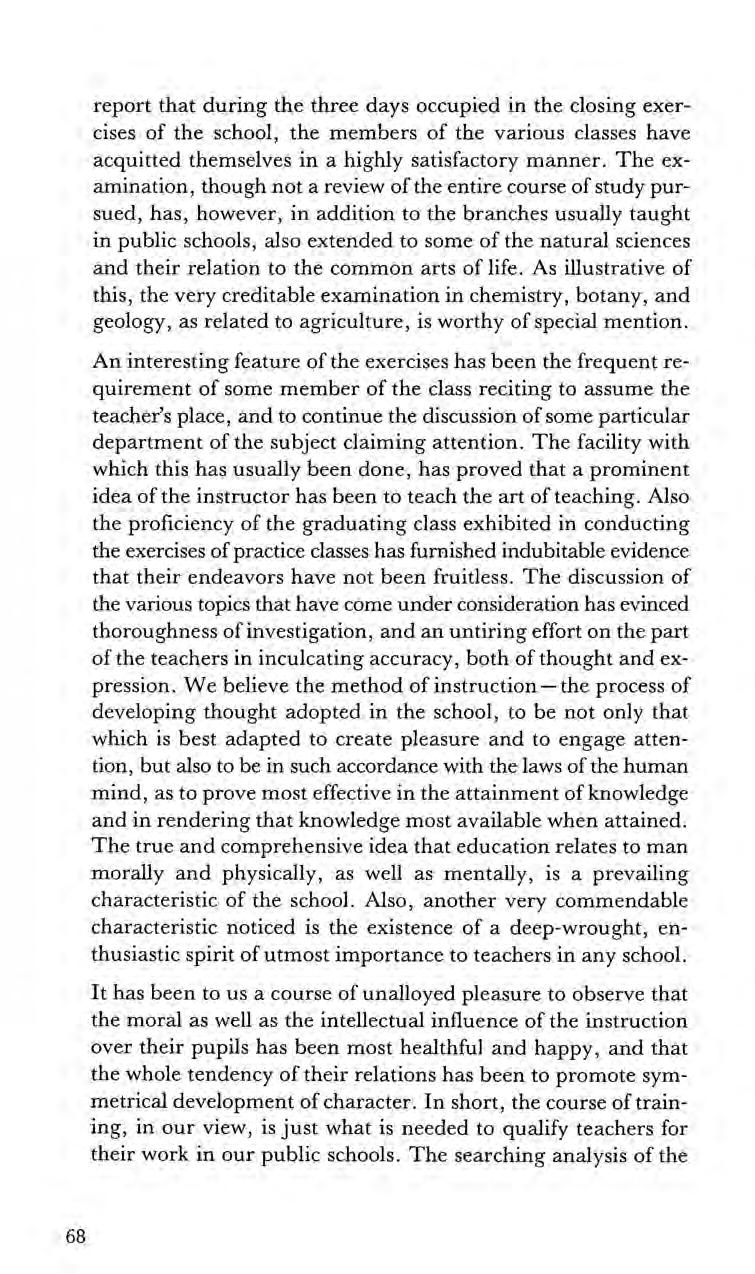
report that during the three days occupied in the closing exercises of the school, the members of the various classes have acquitted themselves in a highly satisfactory manner. The examination, though not a review of the entire course of study pursued, has, however, in addition to the branches usuallytaught in public schools, also extended to some of the natural sciences and their relation to the common arts of life. As illustrative of this, the very creditable examination in chemistry, botany, and geology, as related to agriculture, is worthy of special mention.
An interesting feature of the exercises has been the frequent requirement of some member of the class reciting to assume the teacher’s place, and to continue thediscussion of some particular department of the subject claiming attention. The facility with which this has usually been done, has proved that a prominent idea of the instructor has been to teach the art of teaching. Also the proficiency of the graduating class exhibited in conducting the exercises ofpractice classes has furnished indubitable evidence that their endeavors have not been fruitless. The discussion of the various topics that have come under consideration has evinced thoroughness of investigation, and an untiring effort on the part of the teachers in inculcating accuracy, both of thought and expression. We believe the method of instruction —the process of developing thought adopted in the school, to be not only that which is best adapted to create pleasure and to engage attention, but also to be in such accordance with the laws of the human mind, as to prove most effective in the attainment of knowledge and in rendering that knowledge most available when attained. The true and comprehensive idea that education relates to man morally and physically, as well as mentally, is a prevailing characteristic of the school. Also, another very commendable characteristic noticed is the existence of a deep-wrought, enthusiastic spirit of utmost importance to teachers in any school.
It has been to us a course of unalloyed pleasure to observe that the moral as well as the intellectual influence of the instruction over their pupils has been most healthful and happy, and that the whole tendency of their relations has been to promote symmetrical development of character. In short, the course of training, in our view, is just what is needed to qualify teachers for their work in our public schools. The searching analysis of the
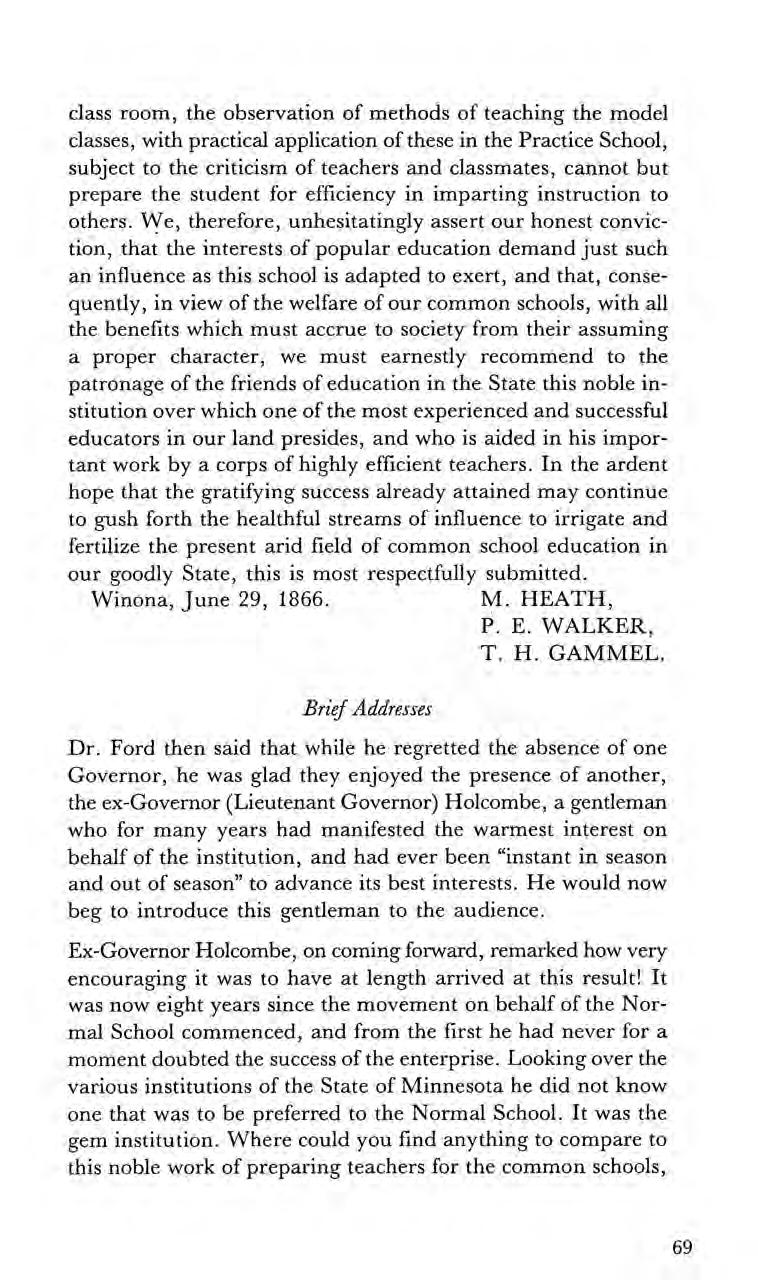
class room, the observation of methods of teaching the model classes, with practicalapplication of these in the Practice School, subject to the criticism of teachers and classmates, cannot but prepare the student for efficiency in imparting instruction to others. We, therefore, unhesitatingly assert our honest conviction, that the interests of popular education demand just such an influence as this school is adapted to exert, and that, consequently, in view of the welfare of our common schools, with all the benefits which must accrue to society from their assuming a proper character, we must earnestly recommend to the patronage of the friends of education in the State this noble institution over which one of the most experienced and successful educators in our land presides, and who is aided in his important work by a corps of highly efficient teachers. In the ardent hope that the gratifying success already attained may continue to gush forth the healthful streams of influence to irrigate and fertilize the present arid field of common school education in our goodly State, this is most respectfully submitted. Winona, June 29, 1866.
M. HEATH, P. E. WALKER, T.H. GAMMEL.
Dr. Ford then said that while he regretted the absence of one Governor, he was glad they enjoyed the presence of another, the ex-Governor (Lieutenant Governor) Holcombe, a gentleman who for many years had manifested the warmest interest on behalf of the institution, and had ever been “instant in season and out of season” to advanceits best interests. He would now beg to introduce this gentleman to the audience.
Ex-Governor Holcombe, on coming forward, remarkedhow very encouraging it was to have at length arrived at this result! It was now eight years since the movement on behalf of the Normal School commenced, and from the first he had never for a moment doubted the success of the enterprise. Looking over the various institutions of the State of Minnesota he did not know one that was to be preferred to the Normal School. It was the gem institution. Where could you find anything to compare to this noble work of preparing teachers for the common schools,

in the prosperity ofwhich was involved the very life of the country? He had long felt an interest in public education. He could hardly pass a school door in any part of the State without a strong desire to look in and see what was doing. He had attended the public examination of the Normal School, and he thought there could be no blessing to compare to that of having the same high character of teaching in all our schools throughout the whole state. If those who make thelaws could only be madeto come here and see the splendid results, they would look on with genuine feelings of admiration. Instead of a mere pittance doled out, and that grudgingly, a hundred thousand dollars he considered would not be too much to render the institution commensurate with the grandeur of our future prospects. Such a wise liberality would advertise the state to the world, and bring to us a large return for our munificence in contributing towards so high and worthy an object. He was talking the other day with some gentlemen upon this matter, and he remarked that he would propose a new plank in our political platform, and that was to provide by law that every member of the State Legislature should be compelled to visit the Normal School at least once a year. The speaker then alluded to the cheering prospects before us our grant for Common Schools being double that of any State east of the Rocky Mountains, or one-eighth [eighteenth] of the _whole property of the state. Encouraged by this and other cir-
cumstances, the natural advantages and beauty of our country, together with the climate communicating vigor to the mind and health and energy to the limbs, ought we not to press forward, and use every means within our power ofproviding for the present and prospective moral and intellectual advancement of our citizens?
The Rev. H.T. Parker, of Austin, was the next speaker. On being introduced by Dr. Ford, he said he had no speech to make. He had learned, from more than twenty years experience, that it was more profitable to work than to talk.He might say, however, that he was highly gratified with the results of the examination, which. had been indeed in all respects a decided success. They were now about to render back to the State something in return for the help they hadreceived from it. After the excellent appearance made by the different members of the graduating class, he had been authorized to pay them the highest
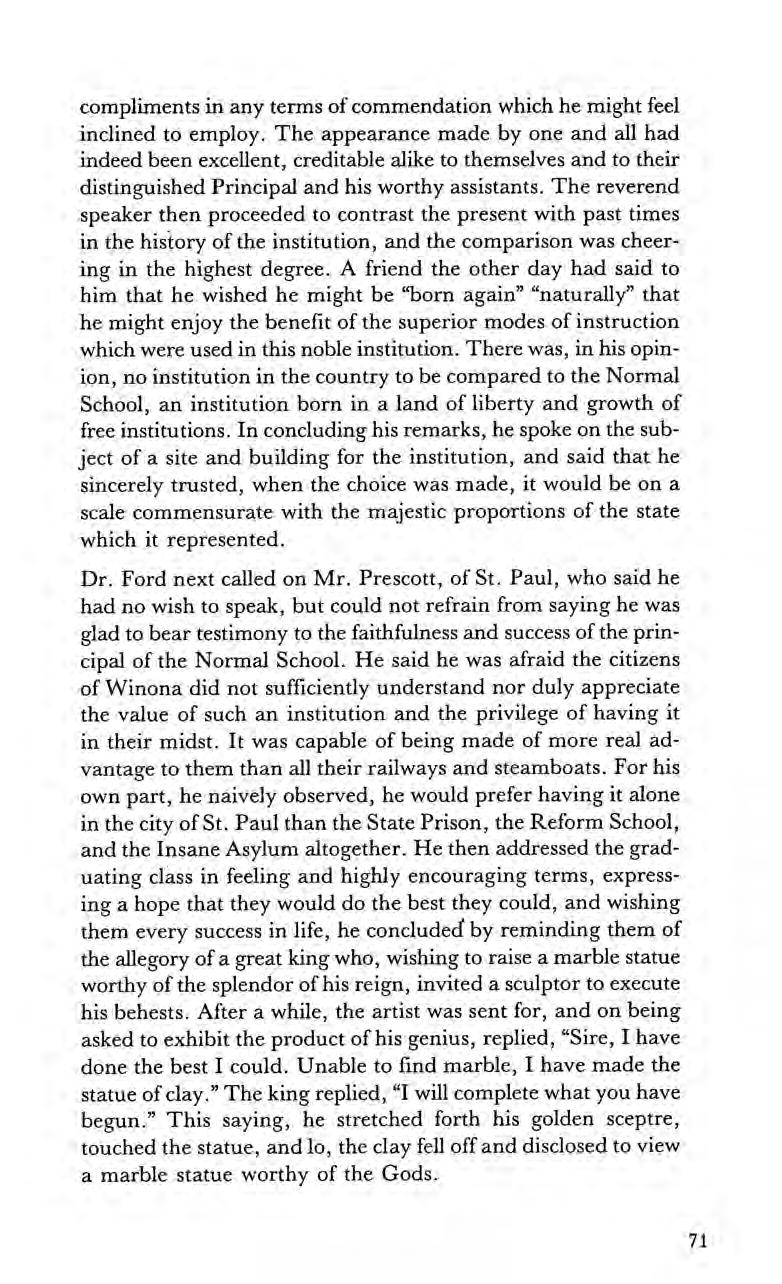
compliments in any terms of commendation which he might feel inclined to employ. The appearance made by one and all had indeed been excellent, creditable alike to themselves and to their distinguished Principal and his worthy assistants. ‘The reverend speaker then proceeded to contrast the present with past times in the history of the institution, and the comparison was cheering in the highest degree. A friend the other day had said to him that he wished he might be “born again” “naturally” that he might enjoy the benefit of the superior modes of instruction which were used in this noble institution. There was, in his opinion, no institution in the country to be compared to the Normal School, an institution born in a land of liberty and growth of free institutions. In concluding his remarks, he spoke on the subject of a site and building for the institution, and said that he sincerely trusted, when the choice was made, it would be on a scale commensurate with the majestic proportions of the state which it represented.
Dr. Ford next called on Mr. Prescott, of St. Paul, who said he had no wish to speak, but could not refrain from saying he was glad to bear testimony to the faithfulness and success of the principal of the Normal School. He said he was afraid the citizens of Winona did not sufficiently understand nor duly appreciate the value of such an institution and the privilege of having it in their midst. It was capable of being made of more real advantage to them than all their railways and steamboats. For his own part, he naively observed, he would prefer having it alone in the city of St. Paul than the State Prison, the Reform School, and the Insane Asylum altogether. He then addressed the graduating class in feeling and highly encouraging terms, expressing a hope that they would do the best they could, and wishing them every success in life, he concluded by reminding them of the allegory of a great king who, wishing to raise a marble statue worthy of the splendor of his reign, invited a sculptor to execute his behests. After a while, the artist was sent for, and on being asked to exhibit the product of his genius, replied, “Sire, I have done the best I could. Unable to find marble, I have made the statue of clay.” The king replied, “I will complete what you have begun.” This saying, he stretched forth his golden sceptre, touched the statue, and lo, the clay fell off and disclosed to view a marble statue worthy of the Gods.
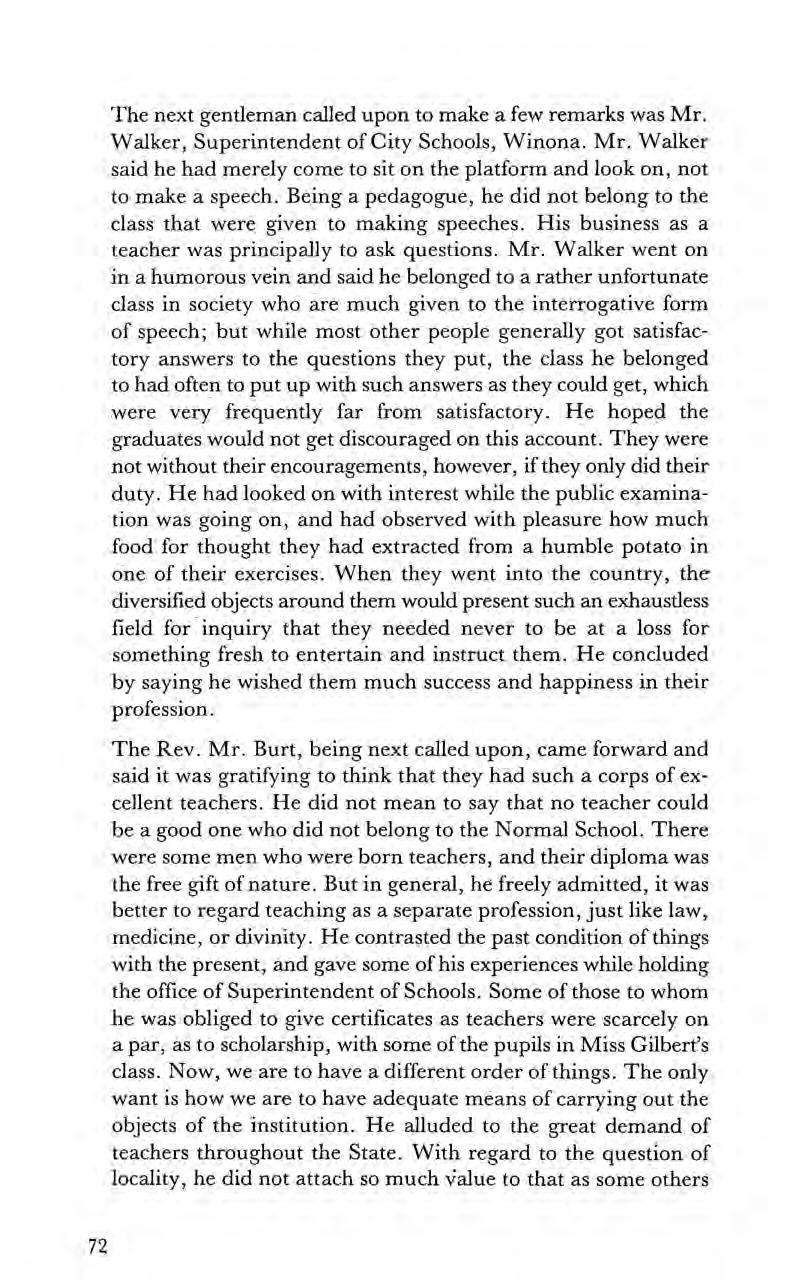
The next gentleman called upon to make a few remarks was Mr. Walker, Superintendent of City Schools, Winona. Mr. Walker said he had merely come to sit on the platform and look on, not to make a speech. Being a pedagogue, he did not belong to the class that were given to making speeches. His business as a teacher was principally to ask questions. Mr. Walker went on in a humorous vein and said he belonged to a rather unfortunate class in society who are much given to the interrogative form of speech; but while most other people generally got satisfactory answers to the questions they put, the class he belonged to had often to put up with such answers as they could get, which were very frequently far from satisfactory. He hoped the graduates would not get discouraged on this account. They were not without their encouragements, however, ifthey only did their duty. He had looked on with interest while the public examination was going on, and had observed with pleasure howmuch food for thought they had extracted from a humble potato in one of their exercises. When they went into the country, the diversified objects around them would present such an exhaustless field for inquiry that they needed never to be at a loss for something fresh to entertain and instruct them. He concluded by saying he wished them much success and happiness in their profession.
The Rev. Mr. Burt, being next called upon, came forward and said it was gratifying to think that they had such a corps of excellent teachers. He did not mean to say that no teacher could be a good one who did not belong to the Normal School. There were some men who were born teachers, and their diploma was the free gift of nature. But in general, he freely admitted, it was better to regard teaching as a separate profession, just like law, medicine, or divinity. He contrasted the past condition of things with the present, and gave some of his experiences while holding the office of Superintendent of Schools. Some of those to whom he was obliged to give certificates as teachers were scarcely on a par, as to scholarship, with some of the pupils in Miss Gilbert’s class. Now, we are to have a different order ofthings. The only want is how we are to have adequate means of carrying out the objects of the institution. He alluded to the great demand of teachers throughout the State. With regard to the question of locality, he did not attach so much value to that as some others
seemed to do. The grandeur and imposing appearance of the building mattered but little, and he hoped that there would be no. feeling excited about secondary matters like these. What was wanted was to have the institution properly furnished with all necessary appliances, and then, he said, the citizens will find it though it be hidden in the lowest valley in the State.
After some lively airs sung by the pupils of the School, Prof. Phelps came forward and gavea history of the institution from its first inception, which need not here be repeated. Now, he said, after two years of unremitting toil, we are here today to offer you the first fruits of our labor. He felt too much exhausted by the labors of the lastfew days to do full justice to the occasion. He said that those who were now to graduate numbered fourteen in all; but, small as this number was, it was a beginning, and would prove a powerful increment for good. The class had gone over no wide field, but what they had learned had been inculcated with vigor and would not soon be forgotten.
Prof. Phelps here read the law of the state relating to the granting of Normal School diplomas, as follows:
Office of the Secretary of State, St. Paul, June 13, 1866.
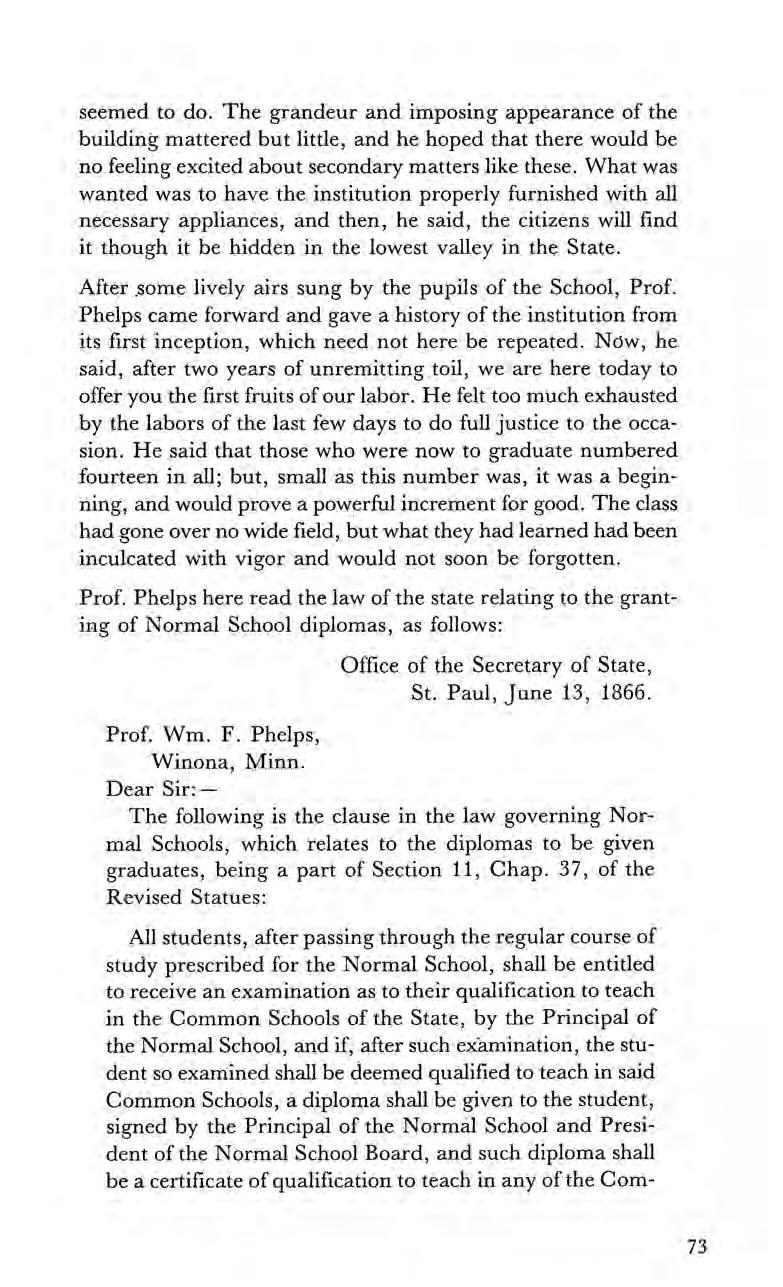
Prof. Wm. F. Phelps, Winona, Minn.
Dear Sir:
The following is the clause in the law governing Normal Schools, which relates to the diplomas to be given graduates, being a part of Section 11, Chap. 37, of the Revised Statues:
All students, after passing through the regular course of study prescribed for the Normal School, shall be entitled to receive an examination as to their qualification to teach in the Common Schools of the State, by the Principal of the Normal School, and if, after such examination, the student so examined shall be deemed qualified to teach in said Common Schools, a diploma shall be given to the student, signed by the Principal of the Normal School and President of the Normal School Board, and such diploma shall be a certificate of qualification to teach in any of the Com-

mon Schools of this State for the period of five years from its date, unless sooner cancelled by said Board for cause. The said certificate may be renewed from time to time in the discretion of the said Board.
Respectfully yours, P.
PUSEY."
Prof. Phelps then, turning to the graduates, said it now became his agreeable duty to award to those before him the highest honors of the institution —honors which they had well earned by the union of intelligence and industry. ‘They had rendered themselves worthy of receiving their diplomas as teachers, and they would not soon forget the hard tasking of their powers through which they had successfully passed before becoming entitled to those testimonials. The standard was purposely high that none but those well qualified might be able to reach it; and the public would esteem them all the more highly on that account. In parting with them, he wished them one and all every success in life. In their career as teachers, they would doubtless find much to discourage, but let them not be disheartened. They must aim chiefly, not at the applause of the world, but at having the testimony of a good conscience, and the approbation of Heaven, and if their reward is withheld here, it will be reserved for them hereafter. Their motives should be pure, and their aims and aspirations lofty, for they belonged to a noble profession profession which, when true to itself, was second to none in the extent and permanency of its influence upon the welfare and happiness of mankind. In fine, he would conclude by using the words of the poet and say:
Thou must be true thyself, If thou the truth wouldst teach; Thy soul must overflow, if thou
Another’s soul would reach— It needs the overflow of heart
To give the lips full speech.
Think truly, and thy thoughts
Shall the world’s famine feed; Speak truly, and each word of thine
Shall be a fruitful seed; Live truly, and thy life shall be A great and noble creed.
The diplomas were then presented to the graduates, and ex-Gov. Holcombe immediately thereafter handed to each of them a bouquet of flowers as a gift from some of the ladies of Winona.
Dr. Ford here announced that a reunion would be held in the Methodist church the same evening at eight o’clock, when the graduates would have an opportunity of meeting with the members of the Examining Committee, the State, City, and County Superintendents of Education, and others of our citizens connected with or interested in the cause of public education in the State. The first commencement was history.
The graduates had been subjected to rigorous written examinations. The results were indicated by figures, opposite each name, on the scale of 100. The names and values are as follows:

S. Hamilton, Winona, Winona
Susie A. Leach, Winona, Winona .:.....:Decne
Fayette L. Cooke, Rochester Falls, Olmstead
Clara P. Sheldon, Excelsior, Hennepin Laas
Annie Sanderson, Cherry Grove, Fillmore
Soon after the reopening of the school in 1864, the question of a permanent location for the institution had again become prominent. Block 17 of Sanborn’s addition, which back in 1859 had been estab-

lished as the building site, soon fell out of favor, and as early as April of 1861, it had been decided at a meeting of the Normal Board in St. Paul on the motion of James W. Taylor “that the president is authorized and directed to receive propositions for exchange of the present site ofthe school for any other more eligible location and report the same for the action of the Board.”
In accordance with this resolution, the president of the Board, Dr. Ford, had advertised in the Winona Republican:
“TO
At the last meeting of the State Normal Board of Education the undersigned was directed to receive, either from individuals or the City Council, propositions in writing for a change oflocation of the selected site for the normal school building. In accordance with the above any propositions made within thirty’ days ofthis date will be submitted to said Board for action thereof. It is contemplated to erect buildings for the school on the present site unless a more eligible location can be made available to the Board.”!*
In an editorial two days later the Republican made the following comment:
We would direct the attention of our city readers to the advertisement in another column of Dr. Ford in behalf of the State Normal Board, inviting proposals for a change oflocation of the selected site for the normal school. At the time when the present site was selected, very general dissatisfaction was manifested by the citizens ofWinona in consequence of its remoteness from the river front, and a strong desire has repeatedly been expressed that a site in some better locality nearer the river should be obtained instead. As the Board have in contemplation the erection of a building on the grounds at an early day, they have deemed it best to give our citizens an opportunity for making the proposed change, and hence the invitation of the President above alluded to.
In common with many others, it would give us pleasure to see the Normal School buildings erected on some more sightly and commanding spot than the one already chosen, the chief recommendation of which is that it is as much hidden from view as it well could be, unless a site were to be selected immediately on the classic shores of Lake Winona. Lots in this city are not

so scarce, nor are they, many of them so extremely valuable, that our public institutions and buildings should be on this account crowded off into the mud-holes and sloughs, as ifthey were something to be ashamed of.
If the citizens of Winona really desire to secure a more eligible situation for the Normal School they will have to move in the matter immediately, else the Board will proceed to occupy that already in their possession.‘%
On June 24, Mr. Henry D. Huff made the following proposal to the Normal Board:
Dear Sir:
I see there is a chance for relocating the Normal School and the opportunity for one or more to show their liberality. This is a chance I have long sought. Hence I make the following proposition to the Normal School Board, to-wit: I will donate block fourteen (14), sixteen (16), and twenty-two (22), about ten acres of land, in the Evans addition, subject, however, to theEvans Estate, as shown by the Record, and provided that the Normal School buildings are located on one or more of the said blocks. One of these blocks hes high, and is a very desirable location. Now if there is any one who will pay the encumbrances, and take two of these blocks, there is a chance, as one is all the school needs. The blocks are of large size, containing, I think, over three acres each. This would be a good bargain for anyone. In case this proposition does not suit, I will donate, free and clear from all encumbrance, a block in Hamilton’s addition, which shall be on the most desirable spot on said addition somewhere between the house of John I. Hubbard and the old Hamilton house, west of John A. Mathews’ residence.'®
All of this hadtaken place in 1861. The matter was not settled until after the reopening of the school in 1864. On June 30,1865, on motion of Mr. Parker, the Normal Board instructed the “Prudential Committee to purchase block four (4) in Sanborn’s Division of Winona for the location of the State Normal School at a sum not exceeding two thousanddollars ($2,000).”!”
The Treasurer’s report shows that $2,018.10 was paid on August 1, 1865, for a “building site”. This was probably block four. The City
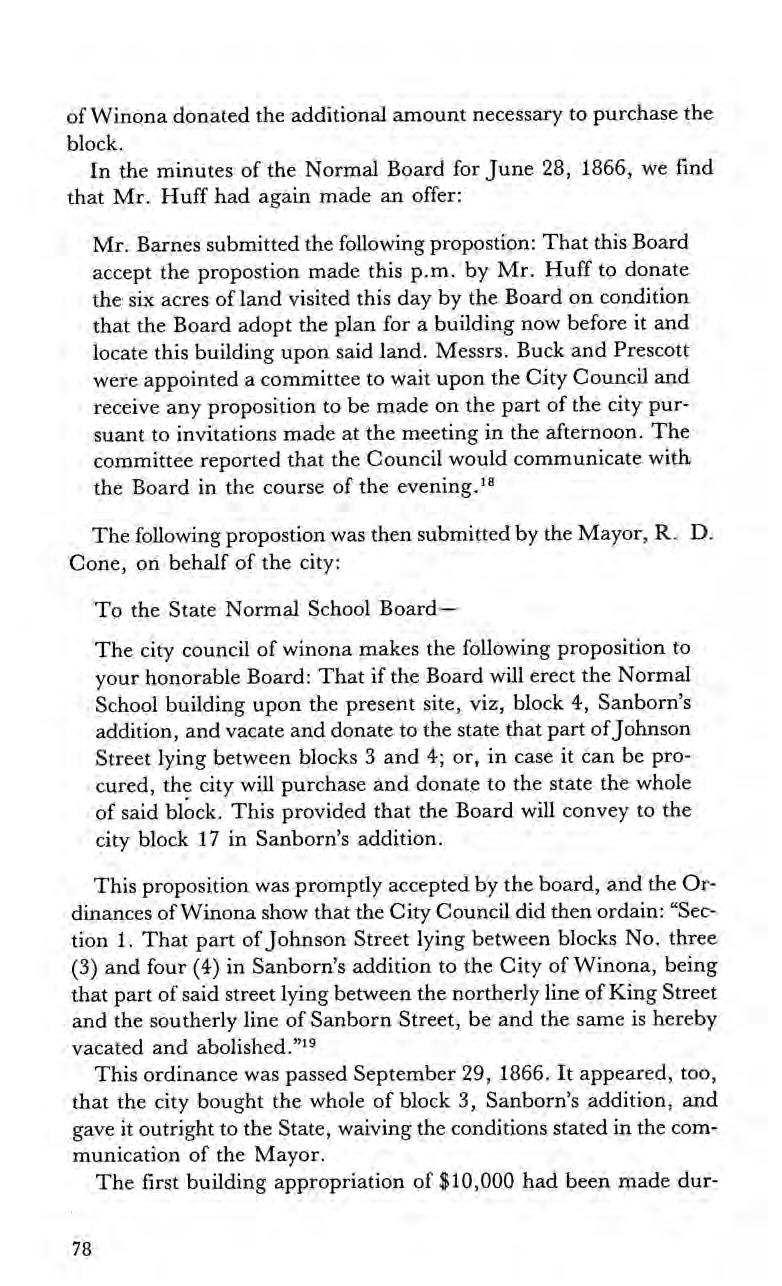
of Winona donated the additional amount necessary to purchase the block.
In the minutes of the Normal Board for June 28, 1866, we find that Mr. Huff had again made an offer:
Mr. Barnes submitted the following propostion: That this Board accept the propostion made this p.m. by Mr. Huff to donate the six acres of land visited this day by the Board on condition that the Board adopt the plan for a building now before it and locate this building upon said land. Messrs. Buck and Prescott were appointed a committee to wait upon the City Council and receive any proposition to be made on the part of the city pursuant to invitations made at the meeting in the afternoon. The committee reported that the Council would communicate with the Board in the course of the evening."®
The following propostion was then submitted by the Mayor, R. D. Cone, on behalf of the city:
The city council of winona makes the following proposition to your honorable Board: That if the Board will erect the Normal School building upon the present site, viz, block 4, Sanborn’s addition, and vacate and donate to the state that part ofJohnson Street lying between blocks 3 and 4; or, in case it can be procured, the city will purchase and donate to the state the whole of said block. This provided that the Board will convey to the city block 17 in Sanborn’s addition.
This proposition was promptly accepted by the board, and the Ordinances ofWinona show that the City Council did then ordain: “Section 1. That part ofJohnson Street lying between blocks No. three (3) and four (4) in Sanborn’s addition to the City of Winona, being that part of said street lying betweenthe northerly line of King Street and the southerly line of Sanborn Street, be and the same is hereby vacated and abolished.”!®
This ordinance was passed September 29, 1866. It appeared, too, that the city bought the whole of block 3, Sanborn’s addition, and gave it outright to the State, waiving the conditions stated in the communication of the Mayor.
The first building appropriation of $10,000 had been made dur-
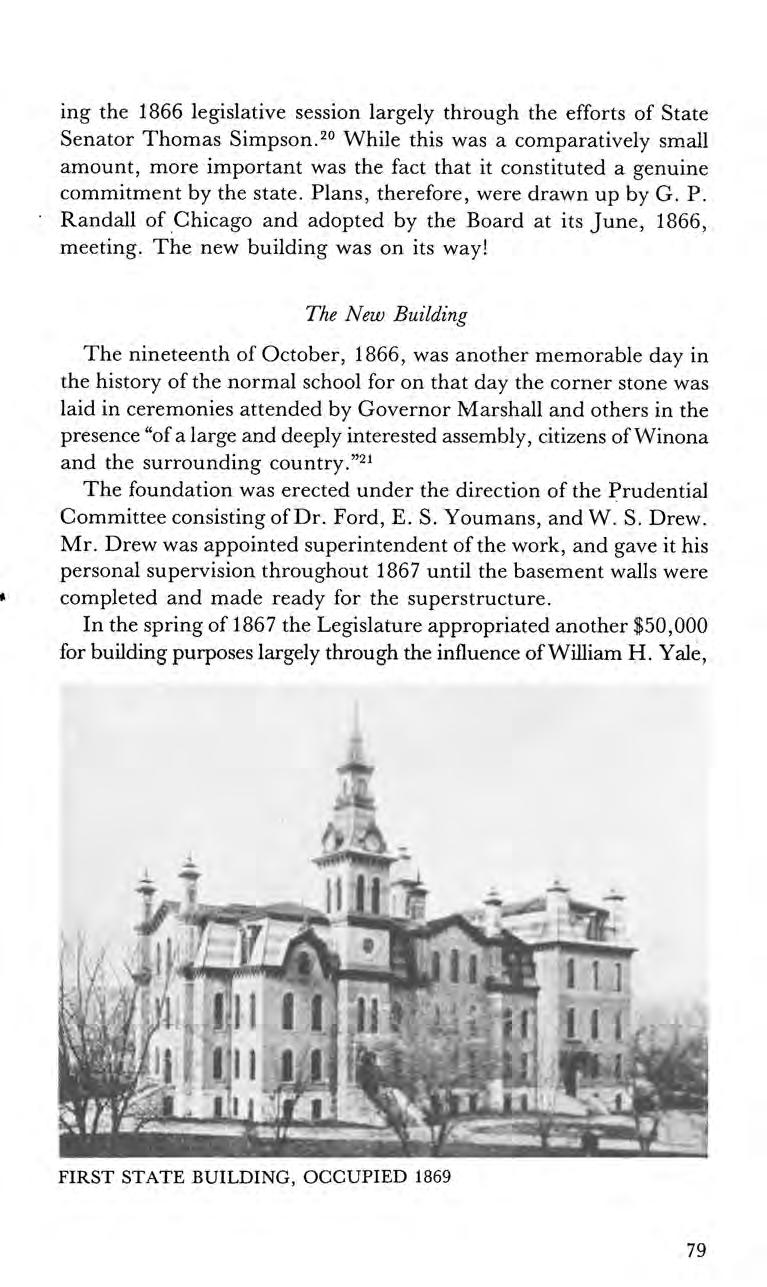
ing the 1866 legislative session largely through the efforts of State Senator Thomas Simpson.?° While this was a comparatively small amount, more important was the fact that it constituted a genuine commitment by the state. Plans, therefore, were drawn up by G. P. Randall of Chicago and adopted by the Board at its June, 1866, meeting. The new building was on its way!
The nineteenth of October, 1866, was another memorable day in the history of the normal school for on that day the corner stone was laid in ceremonies attended by Governor Marshall and others in the presence “of a large and deeply interested assembly, citizens ofWinona and the surrounding country.”?!
The foundation was erected under the direction of the Prudential Committee consisting of Dr. Ford, E.S. Youmans, and W. S. Drew. Mr. Drew was appointedsuperintendent of the work, and gave it his personal supervision throughout 1867 until the basement walls were completed and made ready for the superstructure.
In the spring of 1867 the Legislature appropriated another $50,000 for building purposes largely through the influence ofWilliam H. Yale,
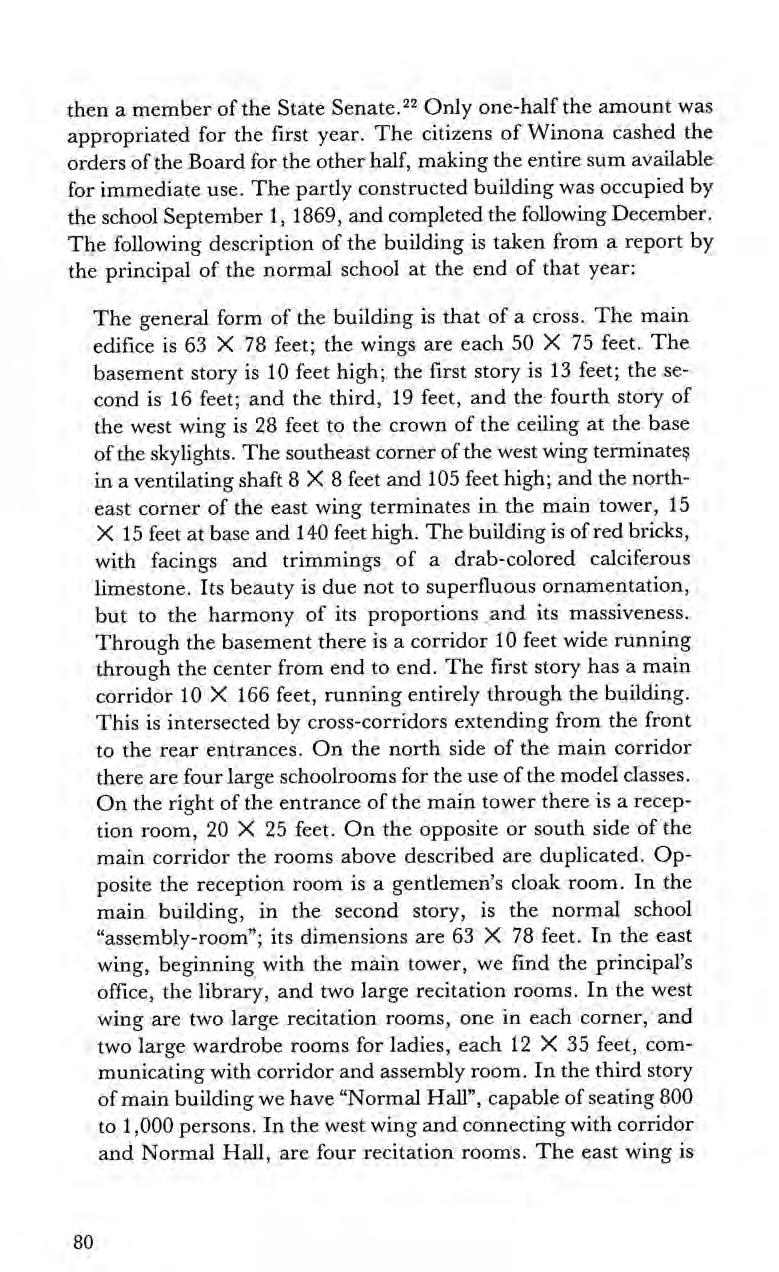
then a member of the State Senate.?? Only one-half the amount was appropriated for the first year. The citizens of Winona cashed the orders of the Board for the other half, making the entire sum available for immediate use. The partly constructed building was occupied by the school September 1, 1869, and completed the following December. The following description of the building is taken from a report by the principal of the normal school at the end of that year:
The general form of the building is that of a cross. The main edifice is 63 X 78 feet; the wings are each 50 X 75 feet. The basement story is 10 feet high; the first story is 13 feet; the second is 16 feet; and the third, 19 feet, and the fourth story of the west wing is 28 feet to the crown of the ceiling at the base ofthe skylights. The southeast corner of the west wing terminates in a ventilating shaft 8 X 8 feet and 105 feet high; and the northeast corner of the east wing terminates in the main tower, 15 X 15 feet at base and 140 feet high. The building is of red bricks, with facings and trimmings of a drab-colored calciferous limestone. Its beauty is due not to superfluous ornamentation, but to the harmony of its proportions and its massiveness. Through the basement there is a corridor 10 feet wide running through the center from end to end. The first story has a main corridor 10 X 166 feet, running entirely through the building. This is intersected by cross-corridors extending from the front to the rear entrances. On the north side of the main corridor there are four large schoolrooms for the use of the model classes. On the right of the entrance of the main tower there is a reception room, 20 X 25 feet. On the opposite or south side of the main corridor the rooms above described are duplicated. Opposite the reception room is a gentlemen’s cloak room. In the main building, in the second story, is the normal school “assembly-room”; its dimensions are 63 X 78 feet. In the east wing, beginning with the main tower, we find the principal’s office, the library, and two large recitation rooms. In the west wing are two large recitation rooms, one in each corner, and two large wardrobe rooms for ladies, each 12 X 35 feet, communicating with corridor and assembly room. In the third story of main building we have “Normal Hall”, capable of seating 800 to 1,000 persons. In the west wing and connecting with corridor and Normal Hall, are four recitation rooms. The east wing is

FIGURE
occupied by a suite of rooms connected by open arches designed to be used for a museum.
In the fourth story of the west wing there are two rooms, 32 X 35 feet each, separated by a corridor and witha ceiling extending to the crown of the roof, 23 feet in height. These rooms are lighted by skylights, and are intended for a gallery of art. The steps at each of the five entrances of the building are of massive solid masonry, and are of easy ascent. The corridors at each extremity are entered by spacious vestibules. The stairs leading to the several stories are easy of ascent, the risers being seven inches each, and the treads, which are very wide, being made of solid two-inch oak plank, finished in oil. The heating and ventilation of the building are upon the plan known as the Ruttan system. There are seven furnaces. The cold air from without is introduced through ducts having an area of section equal to from eight to ten square feet each.?3
The plans for this building were subsequently adopted, with little change for the State Normal Schools at Buffalo, New York, Carbondale, Hlinois, and at Emporia, Kansas.
The following is a summary ofthe contributions made by the citizens of Winona to the school and building:
Original subscriptions of $7,000 to secure site, with appreciation in values $10,000 Subscriptions for purchase of block 4, Sanborn’s
5,000

The cost of the buildings and furnishings, together with the grounds, eventually reached about $445,000.00.
In accordance with a plan proposed by Principal Phelps, the Legislature in 1871 passed an act establishing in Winona the State

Soldiers’ Orphans Home, and providing that the education of the children would take place at the normal school.?# Much of the success in establishing this home was apparently due to the work of Mrs. Margaret Simpson, mother of Minnesota’s Attorney General George Simpson, who occupied that office from 1909 to 1912. She and her husband contributed greatly both in money and time to make a go of it, and the plan proved to be a wise and economical one for the state, as well as valuable to the state’s children. More than one hundred orphans of soldiers killed in the Civil War received training for several years in the model and normal departments. A large number completed the entire course and later filled important positions in the schools of the state.
At length the time arrived in the development of its plans when the school could employ its own graduates in its own teaching force, when the principles and methods it had taught became, as it were, self-perpetuating. The founders of the school hadhad in its early stages ideas about education that went well beyond accepted practice. They had visions of manual training, for example, and of learning by doing although those ideas had hardly yet dawned upon the popular mind. They had plans for discipline and character-building that were well ahead of their contemporaries. As a result, instructors began to provide for the training of both hand and eye, and for actual experimentation and manipulation in laboratory and shop. They watched and studied their students to discover their aptitudes and tastes. This process eventually led to theselection of three young men for special preparation at the Massachusetts Institute of Technology;John D. Lord, Clarence M. Boutelle, and Charles M. Morey (later a principal of the normal school). Lord was to attend the art school at MIT. The other two, Boutelle and Morey, were to study for two years, Mr. Boutelle in mathematics, theoretical and applied; Mr. Morey in physics and chemistry and in laboratory and shop work. As an inducement for this advanced study, each was added to the faculty at a salary of $800 per year, a small amount even in those days of low wages. But this proposition they apparently accepted with enthusiasm. They studied the allotted time and eventually became successful teachers, experimenters, and workers in their respective spheres. This was the beginning of manual training, laboratory and shop work in
the Winona school, years before those ideas had gained a foothold in the general academic community.
In 1870, a new two-year course of study was established for students who had finished the common school. As with the previous course, it too was prepared by Principal Phelps and his associates who simplified the earlier course by the omission of a number of so-called higher subjects. Psychology was retained under the term philosophy of education. Penmanship and the science of accounts were added; and special provision was made for instruction in “the art of teaching as such.” But, fundamentally, the course was planned to afford a thorough mastery of elementary subjects in their relations to each other, and was designed to fit teachers for the lower grades only. “Its limitations have been the result of causes inherent in the condition of educational affairs incident to a comparatively new community,” the record states, referring somewhat apologetically to the brevity and simplicity of the offerings.
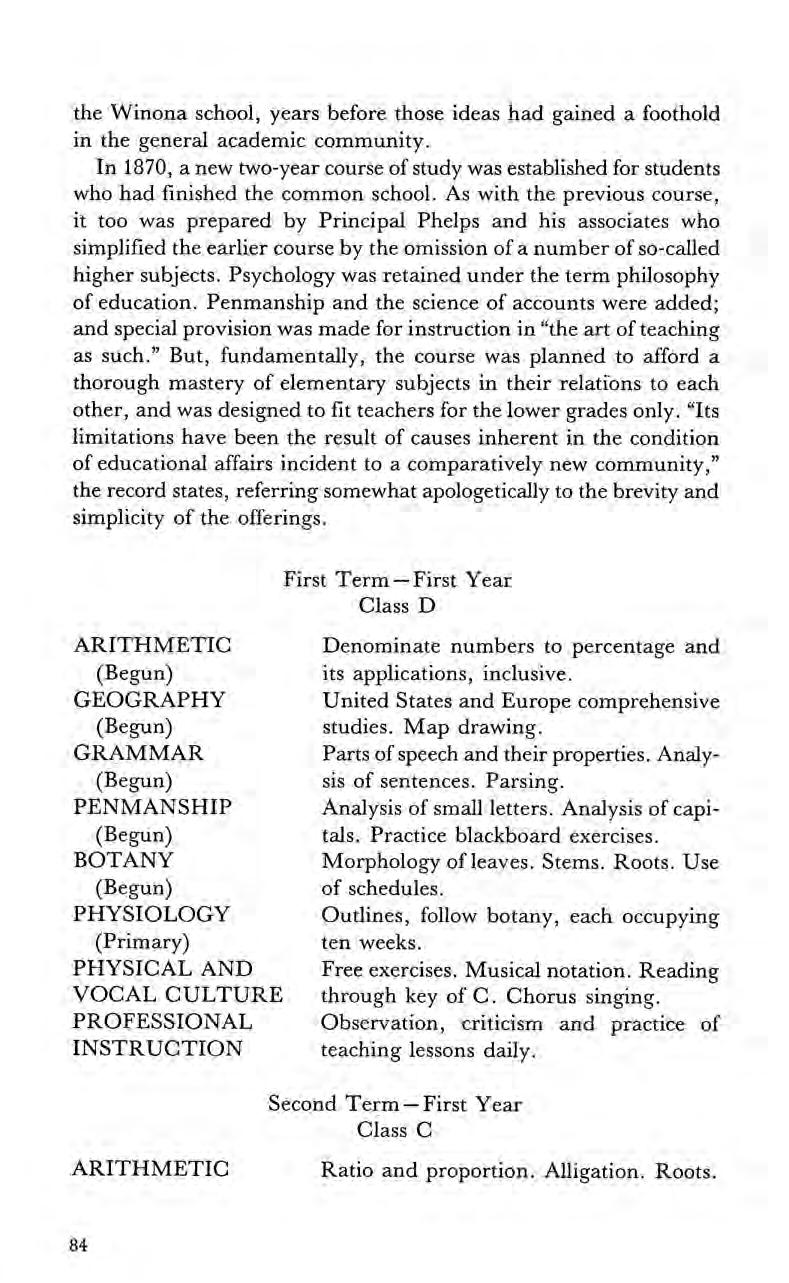
ARITHMETIC
Denominate numbers to percentage and (Begun) its applications, inclusive.
GEOGRAPHY
United States and Europe comprehensive (Begun) studies. Map drawing.
GRAMMAR
Parts of speech and their properties. Analy(Begun) sis of sentences. Parsing.
PENMANSHIP
Analysis of small letters. Analysis of capi(Begun) tals. Practice blackboard exercises.
BOTANY Morphology of leaves. Stems, Roots. Use (Begun) of schedules.
PHYSIOLOGY
Outlines, follow botany, each occupying (Primary) ten weeks.
PHYSICAL AND Free exercises. Musical notation. Reading
VOCAL CULTUREUJ through key of C. Chorus singing.
PROFESSIONAL Observation, criticism and practice of INSTRUCTION teaching lessons daily.
ARITHMETIC - Ratio and proportion. Alligation. Roots.
(Continued)
GEOGRAPHY (Continued)
GRAMMAR (Completed)
GEOMETRY
PHYSICAL AND VOCAL CULTURE
ALGEBRA (Begun)
PROFESSIONAL INSTRUCTION
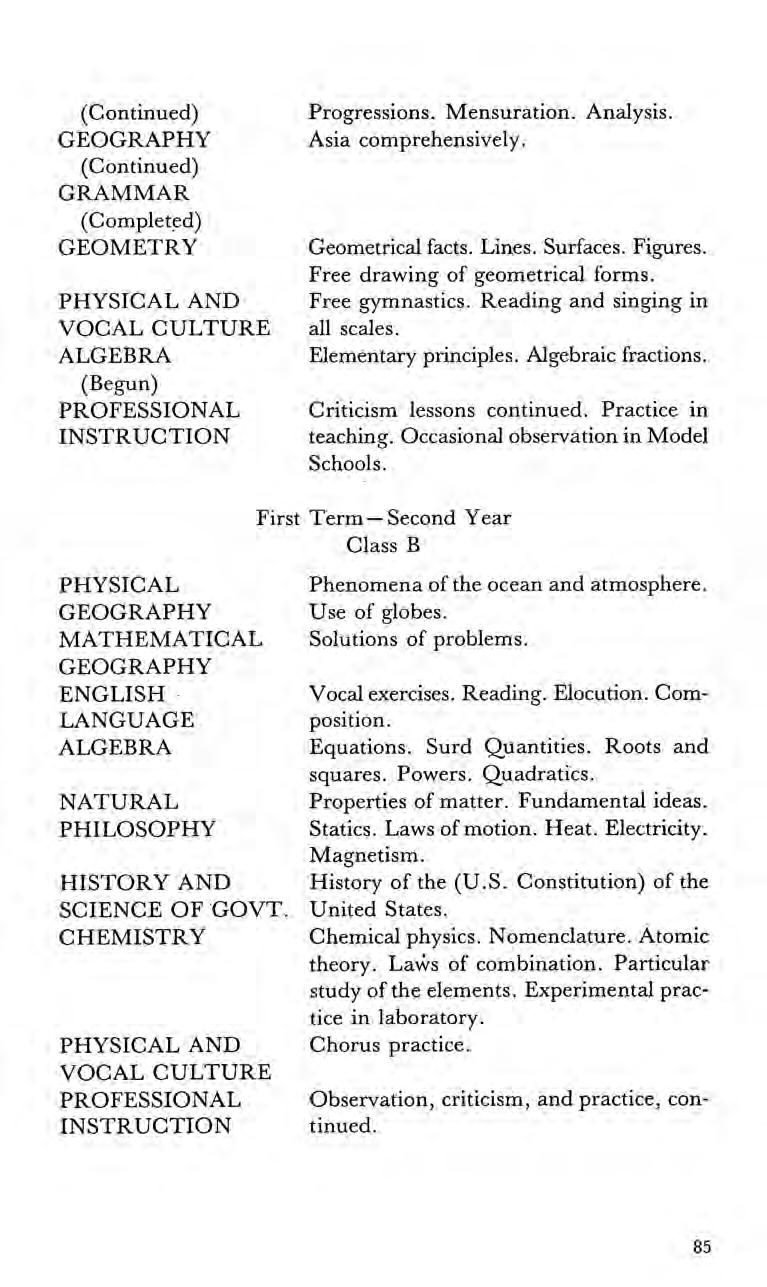
First
PHYSICAL GEOGRAPHY MATHEMATICAL GEOGRAPHY
ENGLISH LANGUAGE
ALGEBRA
NATURAL PHILOSOPHY
HISTORY AND SCIENCE OF GOVT. CHEMISTRY
Progressions. Mensuration. Analysis. Asia comprehensively.
PHYSICAL AND VOCAL CULTURE
PROFESSIONAL INSTRUCTION
Geometrical facts. Lines. Surfaces. Figures. Free drawing of geometrical forms. Free gymnastics. Reading and singing in all scales.
Elementary principles. Algebraic fractions.
Criticism lessons continued. Practice in teaching. Occasional observation in Model Schools.
Term Second Year Class B
Phenomena of the ocean and atmosphere. Use of globes. Solutions of problems.
Vocal exercises. Reading. Elocution. Composition.
Equations. Surd Quantities. Roots and squares. Powers. Quadratics. Properties of matter. Fundamental ideas. Statics. Laws of motion. Heat. Electricity. Magnetism.
History of the (U.S. Constitution) of the United States.
Chemical physics. Nomenclature. Atomic theory. Laws of combination. Particular study of the elements. Experimental practice in laboratory. Chorus practice.
Observation, criticism, and practice, continued.
CHEMISTRY

Second Term—Second Year Class A
Particular study of elements and com(Continued) pounds. Experiments. Laboratory practice. GEOLOGY Definitions and principles. Order of terrestrial strata. Paleontology. Field work. Collection and arrangement of specimens. GEOMETRY Four books.
PHILOSOPHY OF Nervous mechanism. The senses. SensaEDUCATION tion. Observation. Memory. Imagination. Reasoning. Methods of instruction.
ANATOMY AND PHYSIOLOGY
OBSERVATION Criticism and practice of teaching.
IN MODEL
SCHOOL
The principal’s report of 1870 states: “This course was also reported substantially as it appears herewith, to the convention of the American Normal School’s Association at its session in Cleveland in August.”
The report was earnestly and thoroughly discussed for nearly two days and was at length adopted with some modifications. These changes were, however, in the direction of its limitations rather than its extension.
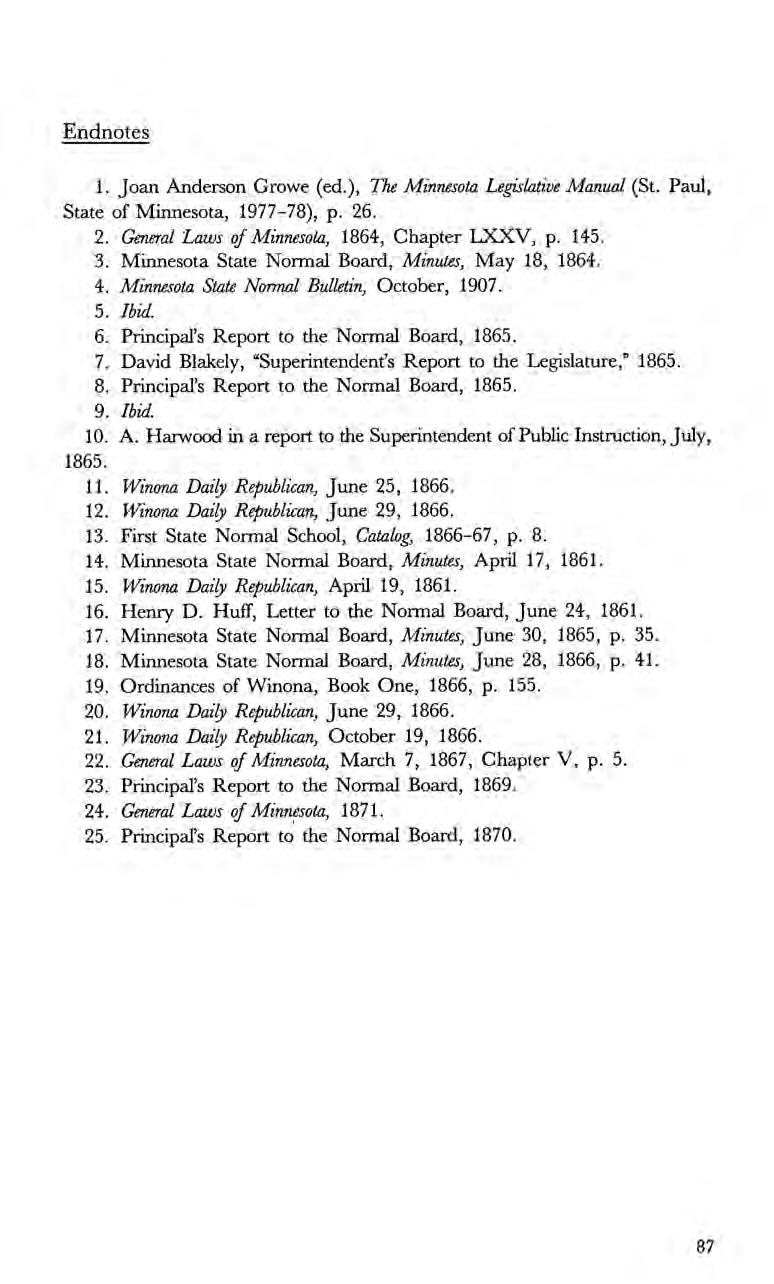
1. State © 1865.
Joan Anderson Growe (ed.), The Minnesota Legislative Manual (St. Paul, of Minnesota, 1977-78), p. 26.
General Laws ofMinnesota, 1864, Chapter LXXV, p. 145.
Minnesota State Normal Board, Minutes, May 18, 1864.
Minnesota State Normal Bulletin, October, 1907. Ibid.
Principal’s Report to the Normal Board, 1865.
David Blakely, “Superintendent’s Report to the Legislature,” 1865. Principal’s Report to the Normal Board, 1865. Lbid.
A. Harwood in a report to the Superintendent of Public Instruction, July,
Winona Daily Republican, June 25, 1866.
Winona Daily Republican, June 29, 1866.
First State Normal School, Catalog, 1866-67, p. 8.
Minnesota State Normal Board, Minutes, April 17, 1861.
Winona Daily Republican, April 19, 1861.
Henry D. Huff, Letter to the Normal Board, June 24, 1861.
Minnesota State Normal Board, Minutes, June 30, 1865, p. 35.
Minnesota State Normal Board, Minutes, June 28, 1866, p. 41. Ordinances of Winona, Book One, 1866, p. 155.
Winona Daily Republican, June 29, 1866.
Winona Daily Republican, October 19, 1866.
General Laws of Minnesota, March 7, 1867, Chapter V, p. 5.
Principal's Report to the Normal Board, 1869.
General Laws ofMinnesota, 1871.
Principal’s Report to the Normal Board, 1870.
CHAPTER III
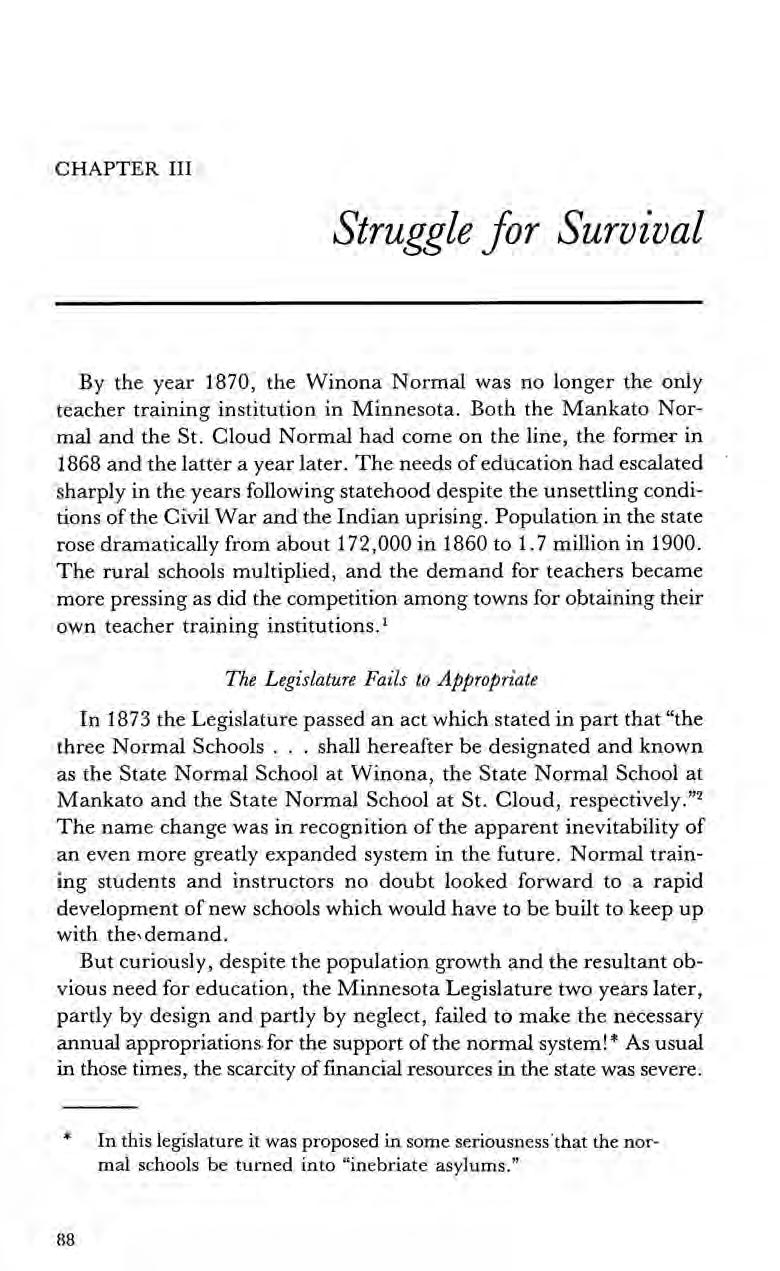
By the year 1870, the Winona Normal was no longer the only teacher training institution in Minnesota. Both the Mankato Normal and the St. Cloud Normal had come on the line, the former in 1868 and the latter a year later. The needs of education had escalated sharply in the years following statehood despite the unsettling conditions of the Civil War and the Indian uprising. Population in the state rose dramatically from about 172,000 in 1860 to 1.7 million in 1900. The rural schools multiplied, and the demand for teachers became more pressing as did the competition among towns for obtaining their own teacher training institutions.!
In 1873 the Legislature passed an act which stated in part that “the three Normal Schools shall hereafter be designated and known as the State Normal School at Winona, the State Normal School at Mankato and the State Normal School at St. Cloud, respectively.” The name change was in recognition of the apparent inevitability of an even more greatly expanded system in the future. Normal training students and instructors no doubt looked forward to a rapid development of new schools which would have to be built to keep up with the:demand.
But curiously, despite the population growth and the resultant obvious need for education, the Minnesota Legislature two years later, partly by design and partly by neglect, failed to make the necessary annual appropriations for the support of the normal system!* As usual in those times, the scarcity of financial resources in the state was severe.
* In this legislature it was proposed in someseriousness that the normal schools be turned into “inebriate asylums.”

As G. T. Mitau pointed out in his history of the State System, Minnesota’s was an agrarian economy which produced little cash during the hard money 19th century, and taxes were resisted as a matter of political faith in the rural, populist areas of the state. Also, tuition was free for those students who pledged to teach two years in the state so that minimal fees provided little campus based income. Clearly something had to be done if the normal training functions were to continue.?
The Normal Board was called into extra session. Several propositions to close the schools at once were voted down by bare majority with the opposition led by Thomas Simpson, the resident director from Winona.What he had to say to the Normal Board that day was made a permanent part of their record.
Gentlemen:
The unexpected failure of the Legislature to provide for maintaining the State Normal Schools invests with the gravest responsibility any action which you or your official representatives may take in relation thereto.
The character and condition ofthe school at Winona will perhaps fully represent the embarrassments of all these institutions of the state affected by the legislature referred to. For reasons not now necessary to state, the Normal School at Winona has been rapidly filling up with students during the current school year, so that the capacity of its large building has been nearly reached in the Normal department, and of this large attendance not less than 93% is from all portions of the state beyond the immediate locality of the institution. The school has been compelled to adopt the policy of excluding from its advantages those who wished to pay tuition and who did not desire to take the required obligation to teach.
This large attendance of students in the Normal department is therefore composed of those who are earnestly, faithfully, and conscientiously preparing themselves to teach in the common schools of the state, and more than 95% of whom are the sons and daughters of the laboring classes, which classes are not burdened with a surplus ofmeans, but who will, with their training in the Normal Schools, be preeminently fitted for instructing the children of the masses under our common school system
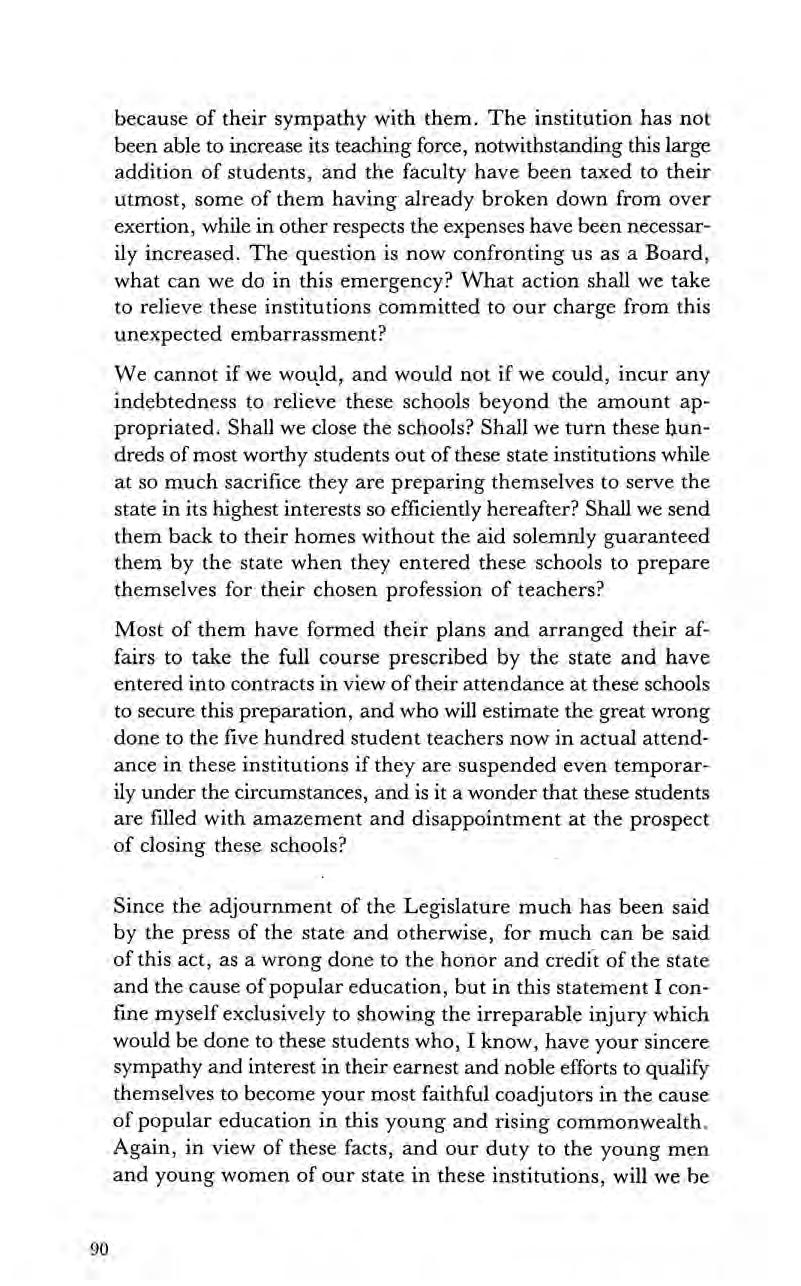
because of their sympathy with them. The institution has not been able to increase its teaching force, notwithstanding this large addition of students, and the faculty have been taxed to their utmost, some of them having already broken down from over exertion, while in other respects the expenses have been necessarily increased. The question is now confronting us as a Board, what can we do in this emergency? What action shall we take to relieve these institutions committed to our charge from this unexpected embarrassment?
We cannot if we would, and would not if we could, incur any indebtedness to relieve these schools beyond the amount appropriated. Shall we close the schools? Shall we turn these hundreds of most worthy students out of these state institutions while at so much sacrifice they are preparing themselves to serve the state in its highest interests so efficiently hereafter? Shall we send them back to their homes without the aid solemnly guaranteed them by the state when they entered these schools to prepare themselves for their chosen profession of teachers?
Most of them have formed their plans and arranged their affairs to take the full course prescribed by the state and have entered into contracts in view of their attendance at these schools to secure this preparation, and who will estimate the great wrong done to the five hundred student teachers now in actual attendance in these institutions if they are suspended even temporarily under the circumstances, and is it a wonder that these students are filled with amazement and disappointment at the prospect of closing these schools?
Since the adjournment of the Legislature much has been said by the press of the state and otherwise, for much can be said of this act, as a wrong done to the honor and credit of the state and the cause of popular education, but in this statement I confine myself exclusively to showing the irreparable injury which would be done to these students who, I know, have your sincere sympathy and interest in their earnest and noble efforts to qualify themselves to become your most faithful coadjutors in the cause of popular education in this young and rising commonwealth. Again, in view of these facts, and our duty to the young men and young women of our state in these institutions, will we be
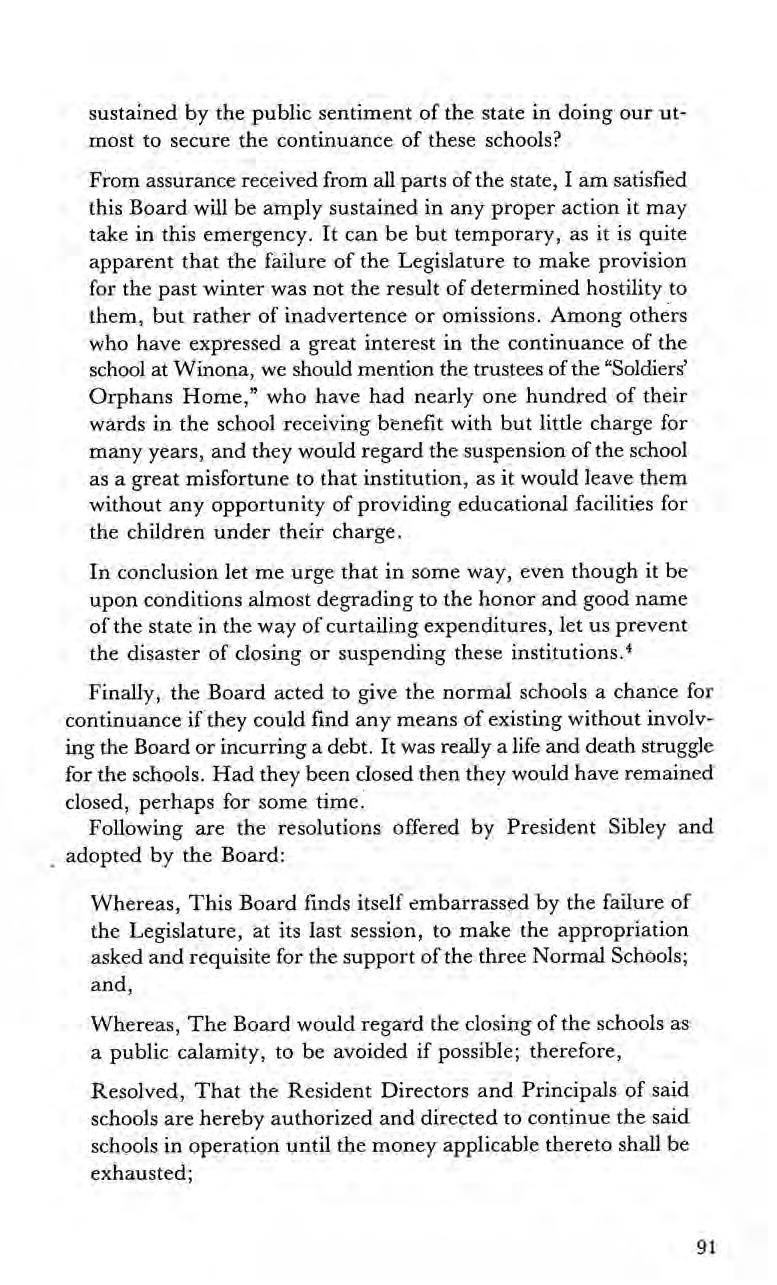
sustained by the public sentiment of the state in doing our utmost to secure the continuance of these schools?
From assurance received from all parts of the state, I am satisfied this Board will be amply sustained in any proper action it may take in this emergency. It can be but temporary, as it is quite apparent that the failure of the Legislature to make provision for the past winter was not the result of determined hostility to them, but rather of inadvertence or omissions. Among others who have expressed a great interest in the continuance of the school at Winona, we should mention the trustees of the “Soldiers’ Orphans Home,” who have had nearly one hundred of their wards in the school receiving benefit with but little charge for many years, and they would regard the suspension of the school as a great misfortune to that institution, as it would leave them without any opportunity of providing educational facilities for the children under their charge.
In conclusion let me urge that in some way, even though it be upon conditions almost degrading to the honor and good name of the state in the way of curtailing expenditures, let us prevent the disaster of closing or suspending these institutions.*
Finally, the Board acted to give the normal schools a chance for continuance ifthey could find any means of existing without involving the Board or incurring a debt. It was reallya life and death struggle for the schools. Had they been closed then they would have remained closed, perhaps for some time.
Following are the resolutionsoffered by President Sibley and adopted by the Board:
Whereas, This Board finds itself embarrassed by the failure of the Legislature, at its last session, to make the appropriation asked and requisite for the support of the three Normal Schools; and,
Whereas, The Board would regard the closing of the schools as a public calamity, to be avoided if possible; therefore,
Resolved, That the Resident Directors and Principals of said schools are hereby authorized and directed to continue the said schools in operation until the money applicable thereto shall be exhausted;

Provided, ‘That each school or either of them may be temporarily closed and thereafter opened at the direction of the Resident Director and Principal of said school, if required bya lack of funds to do so.
Provided further, That no authority is intended to be bestowed by this Board upon any party or parties to create any obligation on the part of the Board, or of the State, beyond the appropriation already made and applicable to the support of the Normal Schools.®
Liberal-hearted citizens of Winona offered to advance money to carry on the school, but this could not be accepted under the action of the Board. When General Sibley the frustrated president of the State Normal Board finally resigned, Thomas Simpson was chosen president. He was determined that the schools should not go down. He made a temporary reduction of the teaching force at Winona and St. Cloud, some reductions of salaries, and some extra charges for tuition. In Winona he appealed to members of the Board of the Soldiers’ Orphans Home, Mr. O. B. Gould and Mrs. Thomas Simpson, who generously responded by paying tuition for pupils under their care. By these means, (supplemented, it was said, by cash contributions from Simpson’s own pocket) the Winona school was kept in vigorous operation until the following year.
His own account of the matter in his report for December 5, 1876, is here given:
Under this action of the Board, the schools havebeen kept in operation, and will continue until the legislature shall adopt some definite policy in regard to their maintenancé. By temporary reductions of teaching force, by abatements of teachers’ salaries, by certain extra charges for tuition in the model and preparatory departments, and by other expedients which cannot be continued or repeated, the Normal Schools at Winona and St. Cloud will be able to continue in successful operation until January Ist, 1877, without incurring any indebtedness or liability. The school at Mankato will also be kept in operation to the close of the year, but at an expense or obligation, mainly due the teachers of that school, who, although fully aware that no obligation or liability could be created in their favor, yet appreciating as they did the great loss to the state and the school if it should be suspended,
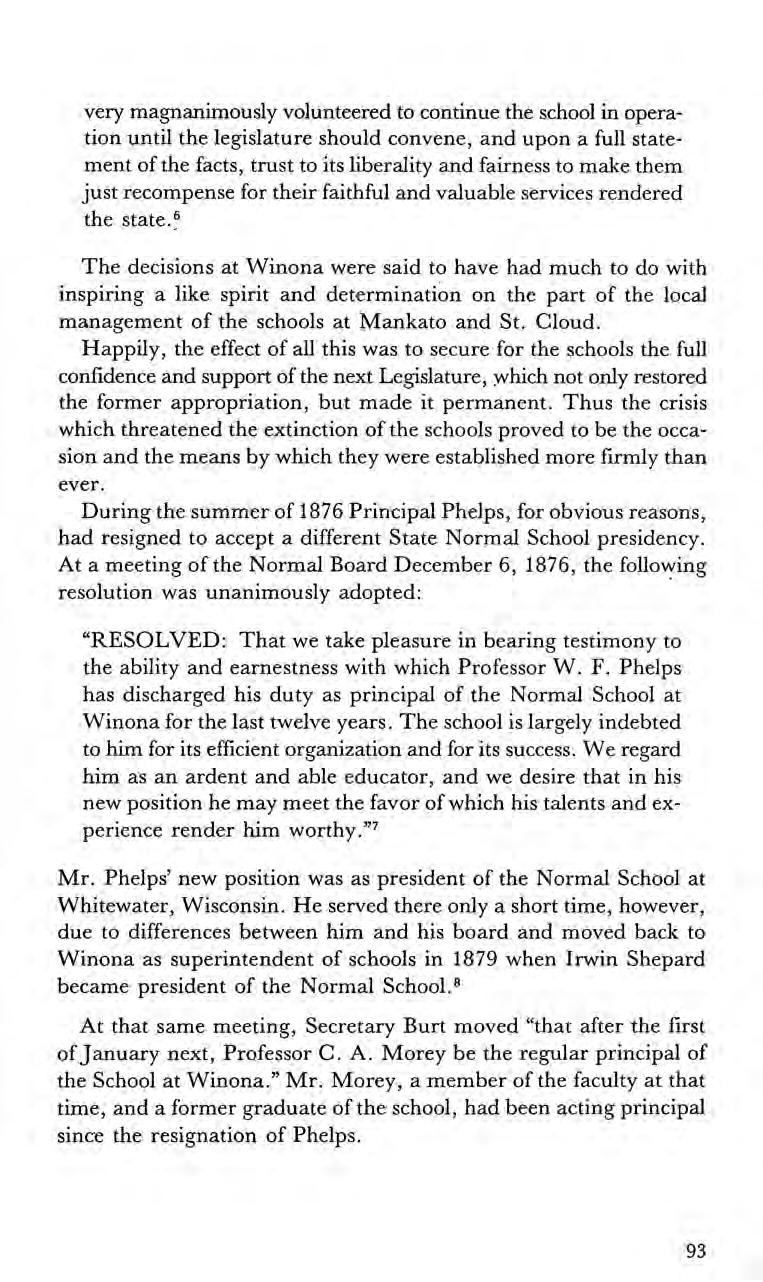
very magnanimously volunteered to continue the school in operation until the legislature should convene, and upona full statement of the facts, trust to its liberality and fairness to make them just recompense for their faithful and valuable services rendered the state.®
The decisions at Winona were said to have had much to do with inspiring a like spirit and determination on the part of the local management of the schools at Mankato and St. Cloud.
Happily, the effect of all this was to secure for the schools the full confidence and support of the next Legislature, which not only restored the former appropriation, but made it permanent. Thus the crisis which threatened the extinction of the schools proved to be the occasion and the means by which they were established more firmly than ever.
During the summer of 1876 Principal Phelps, for obvious reasons, had resigned to accept a different State Normal School presidency. At a meeting of the Normal Board December 6, 1876, the following resolution was unanimously adopted:
“RESOLVED: That we take pleasure in bearing testimony to the ability and earnestness with which Professor W. F. Phelps has discharged his duty as principal of the Normal School at Winona for the last twelve years. The school is largely indebted to him for its efficient organization and for its success. We regard him as an ardent and able educator, and we desire that in his new position he may meet the favor of which his talents and experience render him worthy.”’
Mr. Phelps’ new position was as president of the Normal School at Whitewater, Wisconsin. He served there only a short time, however, due to differences between him and his board and moved back to Winona as superintendent of schools in 1879 when Irwin Shepard became president of the Normal School.®
At that same meeting, Secretary Burt moved “that after the first ofJanuary next, Professor C. A. Morey be the regular principal of the School at Winona.” Mr. Morey, a member of the faculty at that time, and a former graduate of the school, had been acting principal since the resignation of Phelps.

Morey is described as having been a man of versatile tastes and many-sided abilities who applied himselfwith gusto to the performance of various tasks and duties, both private and public. As a critic he was direct and fearless, at times even caustic. But his criticism was said to have been so essentially sincere, so bluntly honest, that it lost its sting in the convincing force of its candor. “He was bold himself so he expected no one to quail under his incisive comments. He encouraged frankness, bravery and an open manner. He taught those whom he must criticize the habit oflooking for the truth in a criticism and not for the fragments that were false. He sought only to build up and strengthen; to clarify and refine; he was far above the petty motive of criticizing simply to dominate.”
For some time before Morey became principal, a new element had been entering into the normal school situation. Up to the time of his administration, the school had confined itself largely to the educating and training of teachers for the rural schools, because there were few high school teachers needed in the early days of the institution. In fact, students completing the normal school course would often teach a year or two and then go back to high school. The original requirements for admission, it will be recalled, were quite simply that the candidate be sixteen years of age and in sound health, plus having enough knowledge to pass minimum requirements in elementary grammar, arithmetic, reading, spelling and geography as determined by the principal of the school. Candidates, therefore, were a motley lot, some having less than an eighth grade education, few having much more.
By the time Mr. Morey became principal, however, the Normal was being asked for high school teachers. Furthermore, the high schools themselves were sending out their graduates as teachers without normal training. The time had come when it was quite evident that the normal school should provide courses of study for high school graduates, and the steps taken to provide these courses marked a turning point in the history of the institution. An advanced program, designed to prepare teachers for the upper grammar grades and high school grades had been strongly urged in the fall of 1873. The record of 1874 contains a report by the principals of Winona, Mankato and St. Cloud, recommending a “uniform course of study for the three several normal schools.” This was entitled Elementary Course, was two years in length and not unlike the course of 1870, except that

CHARLES A. MOREY Principal, 1876-1879
it required six subjects per semester and marked the increasing demands for more advanced work by adding four “advanced studies to be pursued when practicable.” The course was adopted in 1874 as shown below:
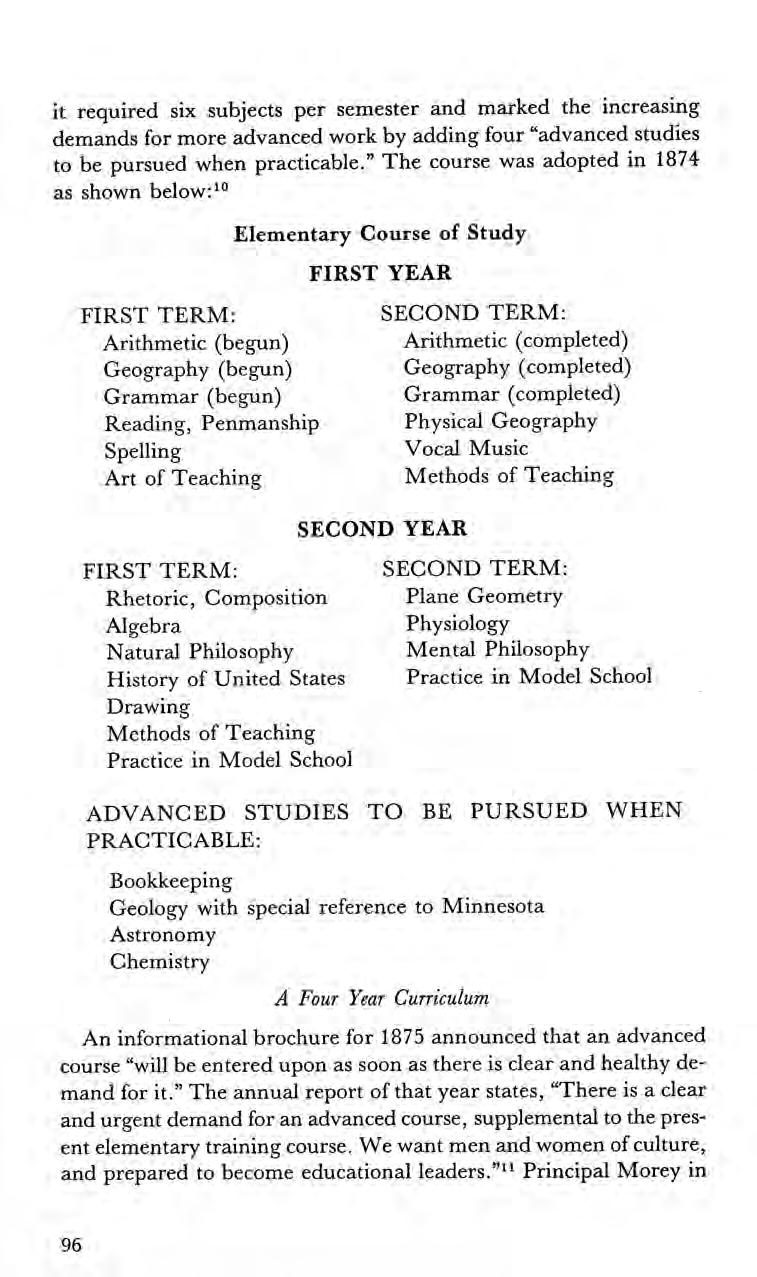
FIRST TERM:
Arithmetic (begun)
Geography (begun)
Grammar (begun)
Reading, Penmanship
Spelling
Art of Teaching
SECOND TERM:
Arithmetic (completed)
Geography (completed)
Grammar (completed)
Physical Geography
Vocal Music
Methods of Teaching
FIRST TERM: SECOND TERM:
Rhetoric, Composition
Algebra
Natural Philosophy
Plane Geometry
Physiology
Mental Philosophy
History of United States Practice in Model School
Drawing
Methods of Teaching
Practice in Model School
ADVANCED STUDIES TO BE PURSUED WHEN PRACTICABLE:
Bookkeeping
Geology with special reference to Minnesota
Astronomy
Chemistry
An informational brochure for 1875 announced that an advanced course “will be entered upon as soon as there is clear and healthy demand for it.” The annual report of that year states, “There is a clear and urgent demand for an advanced course, supplemental to the present elementary training course. We want men and women of culture, and prepared to become educational leaders.”!! Principal Morey in

reporting the opening of the school in the fall of 1876 stated: “The grade of the pupils entering the school this year is much higher than that of any class received previously. The advantage resulting in the attainments of candidates for admission is obvious. The requirements for admission can be correspondingly increased and thewhole work of the school raised to a higher level.”!? His report for the following year stated that, as it had been intimated in the previous report, the time had now come when the course of study should be advanced and the work of the school placed ona higher level, and that this had accordingly been done. The entrance examination had been made more rigorous, and several branches of professional study had been added to the course.
In December of 1877, therefore, as a result of several years’ agitation, an elementary course of three years and an advanced course offour years were authorized, the latter including “the Latin Language and the higher and professional branches.” It was intended that its graduates should be thoroughly prepared for work as principals of high schools and graded schools, or as county superintendents.
The effect of the advanced course upon the school was immediately “very marked”. The course from 1864 to 1877 remained practically unchanged as has been noted, and required at the most only two years for completion. Indeed, the report shows that in 1868 a majority had completed their course in less than the prescribed time. But in November of 1877 it was noted that several graduates of the best high schools in the state had entered the teacher preparation program. The catalog ofthat year announced that graduates of high schools and others who were fully prepared in the academic studies should take only the professional work and graduate in one year thus earning the advanced diploma with those non-high school graduates who pursued the four-year program. Years later the record stated that, although recently established, the professional course had become the most important feature of the school.
This change, of course, meant a decrease in the total attendance of the school, and this had been anticipated in Morey’s first report. In his second report he stated, “The radical changes in the operation of the school will undoubtedly further reduce the number of pupils in attendance. This result is inevitable if the new regulations are honestly enforced. But thestudents will be such as belong there; such as will do credit both to themselves and the institution.”
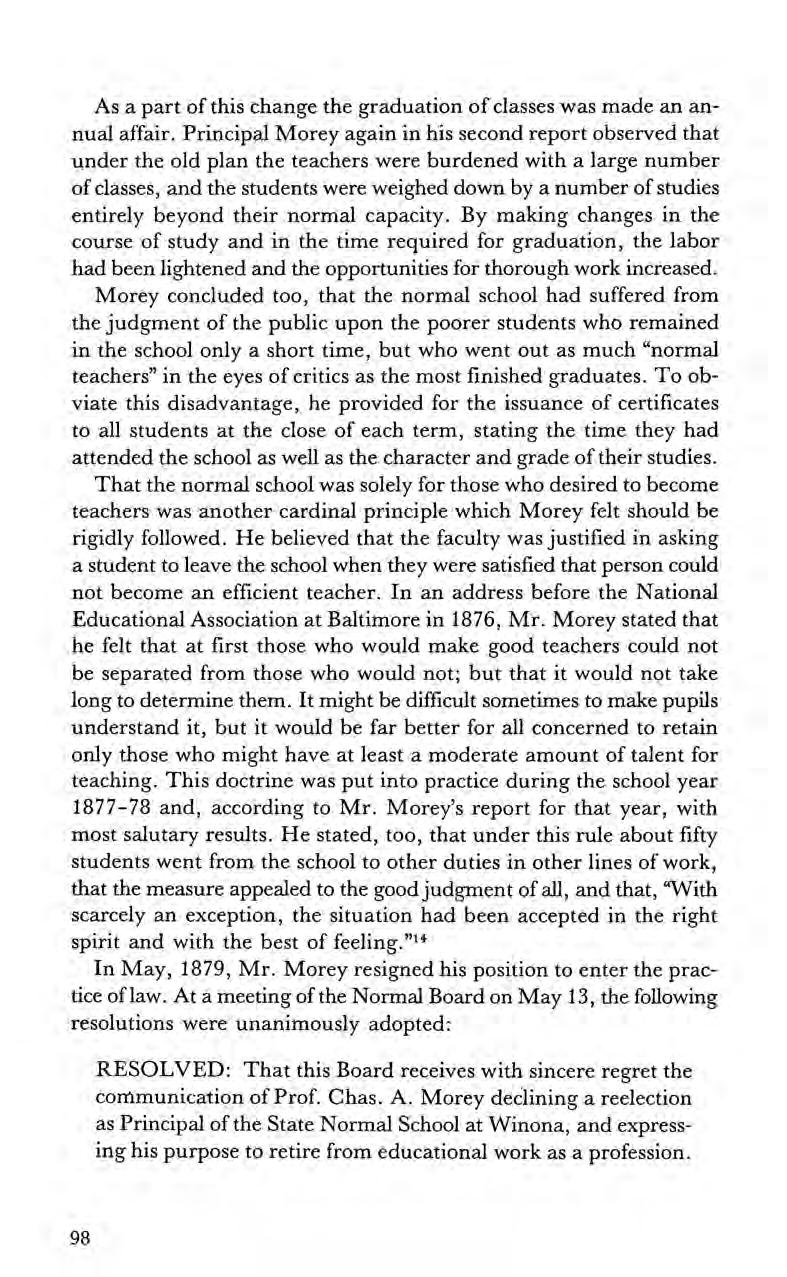
As a part of this change the graduation of classes was made an annual affair. Principal Morey again in his second report observed that under the old plan the teachers were burdened with a large number of classes, and the students were weighed down by a number of studies entirely beyond their normal capacity. By making changes in the course of study and in the time required for graduation, the labor had been lightened and the opportunities for thorough work increased. Morey concluded too, that the normal school hadsuffered from the judgment of the public upon the poorer students who remained in the school only a short time, but who went out as much “normal teachers” in the eyes of critics as the most finished graduates. To obviate this disadvantage, he provided for the issuance of certificates to all students at the close of each term, stating the time they had attended the school as well as the character and grade oftheir studies. That the normal school was solely for those who desired to become teachers was another cardinal principle which Morey felt should be rigidly followed. He believed that the faculty was justified in asking a student to leave the school when they were satisfied that person could not become an efficient teacher. In an address before the National Educational Association at Baltimore in 1876, Mr. Morey stated that he felt that at first those who would make good teachers could not be separated from those who would not; but that it would not take long to determine them. It might be difficult sometimes to make pupils understand it, but it would be far better for all concerned to retain only those who might have at least a moderate amount of talent for teaching. This doctrine was put into practice during the school year 1877-78 and, according to Mr. Morey’s report for that year, with most salutary results. He stated, too, that under this rule about fifty students went from the school to other duties in other lines of work, that the measure appealed to the goodjudgment of all, and that, “With scarcely an exception, the situation had been accepted in the right spirit and with the best of feeling.”!*
In May, 1879, Mr. Morey resigned his position to enter the practice oflaw. At a meeting ofthe Normal Board on May 13, the following resolutions were unanimously adopted:
RESOLVED: That this Board receives with sincere regret the communication of Prof. Chas. A. Morey declininga reelection as Principal of the State Normal School at Winona, and expressing his purpose to retire from educational work as a profession.
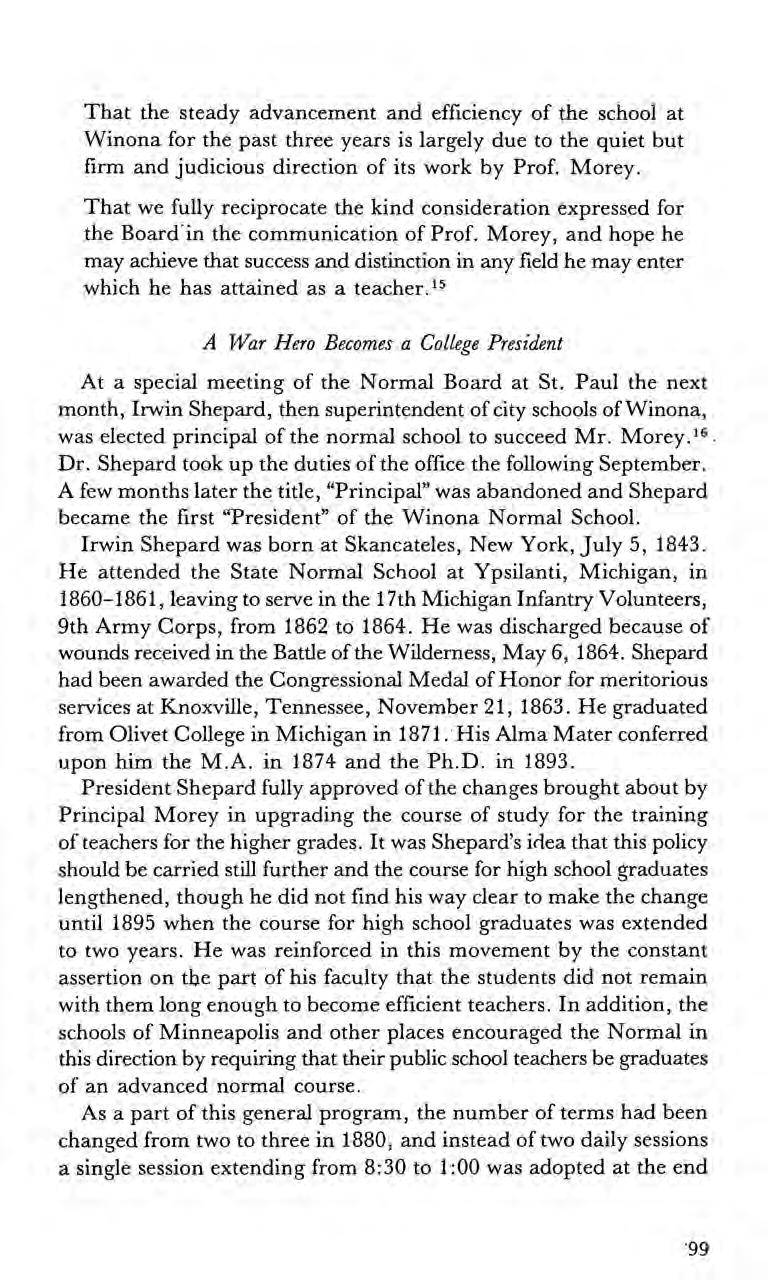
That the steady advancement and efficiency of the school at Winona for the past three years is largely due to the quiet but firm and judicious direction of its work by Prof. Morey.
That we fully reciprocate the kind consideration expressed for the Board in the communication of Prof. Morey, and hope he may achieve that success and distinction in any field he may enter which he has attained as a teacher.'5
At a special meeting of the Normal Board at St. Paul the next month, Irwin Shepard, then superintendent of city schools ofWinona, was elected principal of the normal school to succeed Mr. Morey.'®. Dr. Shepard took up the duties of the office the following September. A few months later the title, “Principal” was abandoned and Shepard became the first “President” of the Winona Normal School.
Irwin Shepard was born at Skancateles, New York, July 5, 1843. He attended the State Normal School at Ypsilanti, Michigan, in 1860-1861, leaving to serve in the 17th Michigan Infantry Volunteers, 9th Army Corps, from 1862 to 1864. He was discharged because of wounds received in the Battle ofthe Wilderness, May 6, 1864. Shepard had been awarded the Congressional Medal of Honor for meritorious services at Knoxville, Tennessee, November 21, 1863. He graduated from Olivet College in Michigan in 1871. His Alma Mater conferred upon him the M.A. in 1874 and the Ph.D. in 1893.
President Shepard fully approved of the changes brought about by Principal Morey in upgrading the course of study for the training of teachers for the higher grades. It was Shepard’s idea that this policy should be carriedstill further and the course for high school graduates lengthened, though he did not find his way clear to makethe change until 1895 when the course for high school graduates was extended to two years. He was reinforced in this movement by the constant assertion on the part of his faculty that the students did not remain with them long enough to become efficient teachers. In addition, the schools of Minneapolis and other places encouraged the Normal in this direction by requiring that their public school teachers be graduates of an advanced normal course.
As a part of this general program, the number of terms had been changed from two to three in 1880, and instead of two daily séssions a single session extending from 8:30 to 1:00 was adopted at the end
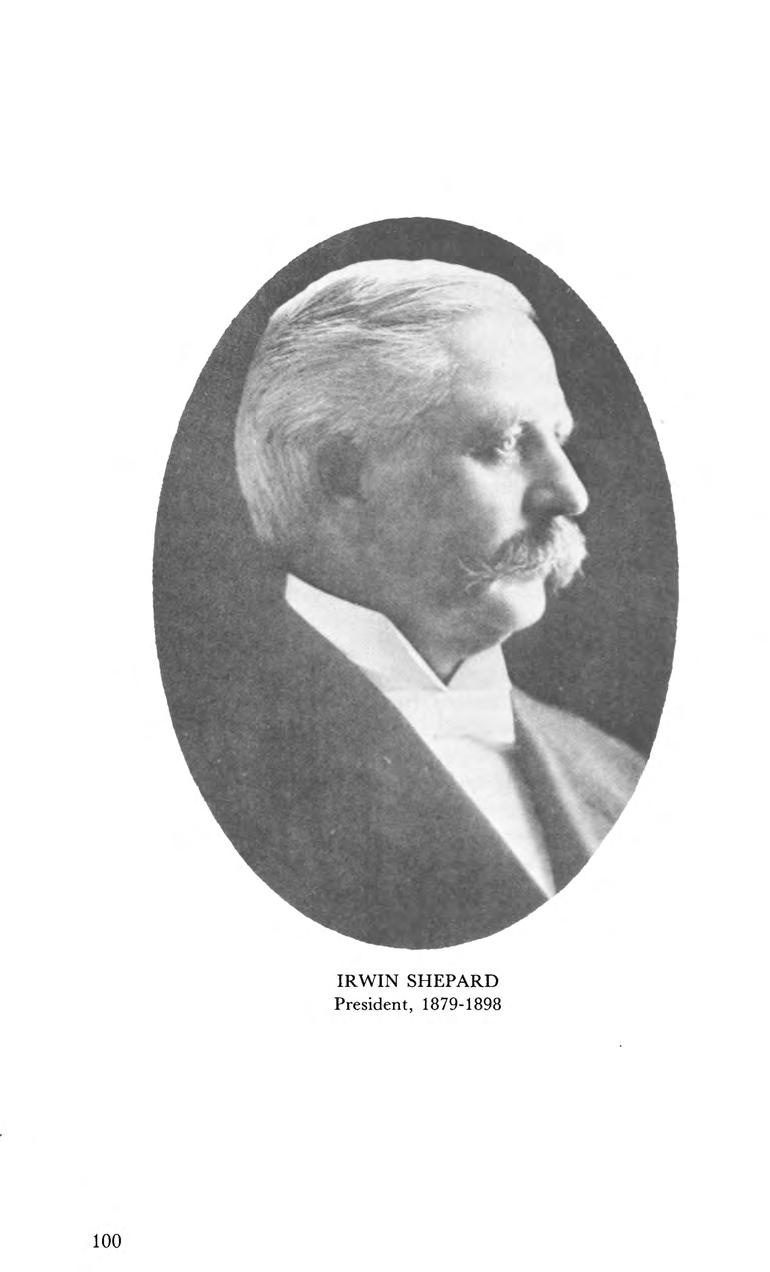
SHEPARD President, 1879-1898
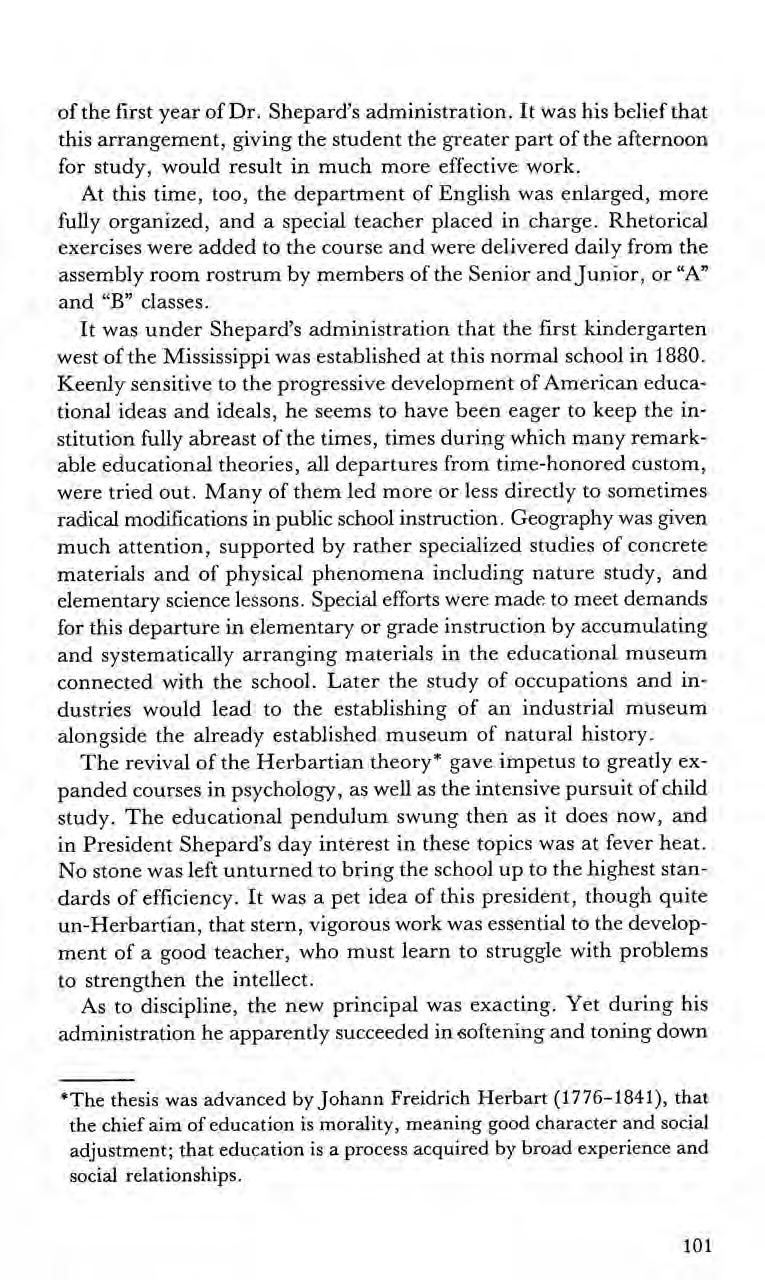
of the first year of Dr. Shepard’s administration. It was his belief that this arrangement, giving the student the greater part of the afternoon for study, would result in much more effective work.
At this time, too, the department of English was enlarged, more fully organized, and a special teacher placed in charge. Rhetorical exercises were added to the course and were delivered daily from the assembly room rostrum by members of the Senior andJunior, or “A” and “B” classes.
It was under Shepard’s administration that the first kindergarten west of the Mississippi was established at this normal school in 1880. Keenly sensitive to the progressive development of American educational ideas and ideals, he seems to havebeen eager to keep the institution fully abreast of the times, times during which many remarkable educational theories, all departures from time-honored custom, were tried out. Many of them led more or less directly to sometimes radical modifications in public school instruction. Geography was given much attention, supported by rather specialized studies of concrete materials and of physical phenomena including nature study, and elementary science lessons. Special efforts were made to meet demands for this departure in elementary or grade instruction by accumulating and systematically arranging materials in the educational museum connected with the school. Later the study of occupations and industries would lead to the establishing of an industrial museum alongside the already established museum of natural history.
The revival of the Herbartian theory* gave impetus to greatly expanded courses in psychology, as well as the intensive pursuit of child study. The educational pendulum swung then as it does now, and in President Shepard’s day interest in these topics was at fever heat. No stone was left unturned to bring the school up to the highest standards of efficiency. It was a pet idea of this president, thoughquite un-Herbartian, that stern, vigorous work was essential to the development of a good teacher, who must learn to struggle with problems to strengthen the intellect.
As to discipline, the new principal was exacting. Yet during his administration he apparently succeeded in softening and toning down
*The thesis was advanced byJohann Freidrich Herbart (1776-1841), that the chief aim of education is morality, meaning good character and social adjustment; that education is a process acquiredby broad experience and social relationships.
TERMS ELEMENTARY COURSE ADVANCED COURSE PROFESSIONAL CLASS
(For those who pass examination on the
“C” Class “B” Class Junior and “A” Senior Class academic work of Class** either, course.)
FALL TERM Arithmetic Algebra Geometry Solid Geometry and Philosophy of Education
Grammar Physiology Zoology Mechanical Drawing School Economy
Aug. 23 - Nov. 11 |Geography
Penmanship and Drawing
12 Weeks
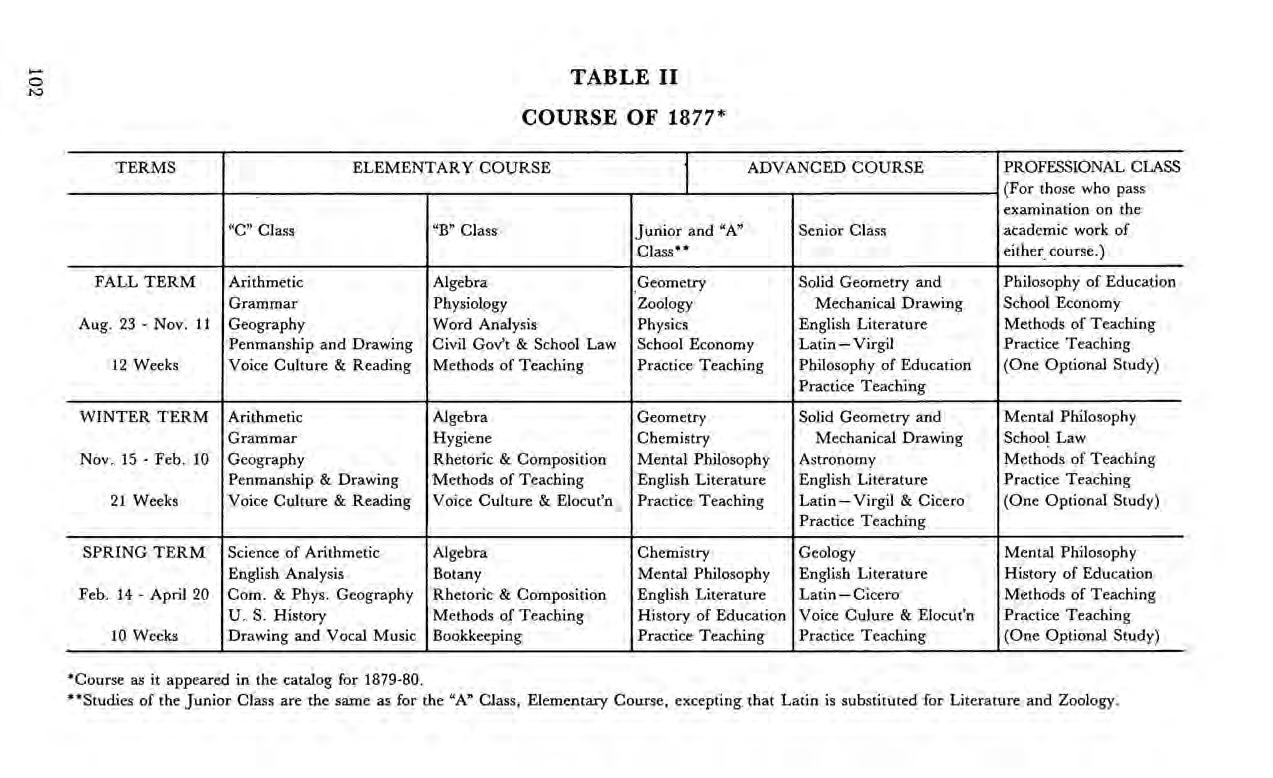
WINTER TERM
Nov. 15 - Feb. 10
21 Weeks
SPRING TERM
Feb. 14 - April 20
10 Weeks
Voice Culture & Reading
Arithmetic
Grammar
Geography
Penmanship & Drawing
Word Analysis Physics English Literature Methods of Teaching
Civil Gov’t & School Law Methods of Teaching School Economy Practice Teaching Latin Virgil Philosophy of Education Practice Teaching Practice Teaching (One Optional Study)
Voice Culture & Reading Algebra ‘Hygiene
Rhetoric & Composition
Methods of ‘Teaching
Voice Culture & Elocut’n Geometry Chemistry
Mental Philosophy English Literature Practice Teaching Solid Geometry and Mechanical Drawing Astronomy
English Literature
Latin— Virgil & Cicero Practice Teaching
Mental Philosophy
School Law
Methods of Teaching Practice Teaching (One Optional Study)
Science of Arithmetic
English Analysis
Com. & Phys. Geography
U. 8S. History
Drawing and Vocal Music Algebra
*Course as it appeared in the catalog for 1879-80.
Botany
Rhetoric & Composition
Methods of Teaching Bookkeeping Chemistry
Mental Philosophy English Literature History of Education Practice Teaching Geology English Literature Latin Cicero
Voice Culure & Elocut’n Practice Teaching
Mental Philosophy History of Education
Methods of ‘Teaching Practice Teaching (One Optional Study)
**Studies of the Junior Class are the same as for the “A” Class, Elementary Course, excepting that Latin is substituted for Literature and Zoology.

the harsh discipline he found established by his predecessor. In fact, it is evident that the school kept pace with the general tendency away from traditional schoolmastering and toward a more democratic classroom approach influenced by reason rather than by rules alone.
In his report for the year ending November 30, 1880, Shepard was moved to declare that the last sign of doubt concerning the success and usefulness of the normal schools lay in the fact that the normal school diplomas were not sufficient as certificates to teach in the common schools of the state.
The act establishing the normal school system originally said nothing about the value of the diplomas as certificates, but in 1866 a law had been passed which made the diplomaa valid certificate for five years, “unless,” said the act, “sooner canceled for cause.” The law also had provided “that said certificate may be renewed from time to time.”!”
For whatever reason, this law was repealed in 1872, and for the next several years normal school diplomas carried little weight, even for rural school teaching.'®
Shepard considered it an injustice to the institutions and the persons attending them not to have the diploma as a valid certificate. “I know of no other state normal school,” he said, “whose diplomas are not, either for a limited or an unlimited period, certificates of qualification. If the normal schools of Minnesota do not thoroughly qualify their graduates to teach in the common schools of the state; further, if they do not do this work better than it can possibly be done in any other schools in which preparation for teaching is not made the chief aim, then the normal schools have no excuse whatever for their existence.” Shepard also felt that the standards set for teachers’ certificates were entirely too low and that such standards discouraged attendance. Ina later report for 1887-88 he maintained that the chief hindrance which the normal schools met in their efforts to extend the scope and character of professional training was the low standard of qualification required to obtain the highest grade of teaching certificates, and the further fact that but slight importance was attached by the authorized examiners to professional knowledge or training.
Finally, in 1891, the Legislature again passed an act which made the diploma from either the elementary or advanced course of normal schools a valid teachers’ certificate of the first grade, this time for a period of two years, a period covering the time of the students’

pledge of service.'® At the expiration of two years of teaching, the diploma might be endorsed by the president of the normal school from which it was issued, and by the state superintendent, upon recommendation of school authorities under whom it was rendered. Such endorsement made the elementary diploma good for five years, and the advanced diplomaa life certificate. In the interests of maintaining uniformity with regard to these new certification standards, the presidents of the normal schools agreed upon the following:
1. While it is hoped that all graduates earn the right to have their diplomas endorsed, great care will be taken in this matter, and the diploma will not be so extended in any case in which the holder fails to render acceptable service during the test-period, or in any way fails to show himselfworthy of the marked professional recognition so bestowed.
2. After the completion of two years of service, application for endorsement may be made to the respective normal schools. The applicant should see that complete reports of service have been made in accordance with the student teacher’s pledge, and that such reports bear the names and addresses of the supervising authorities to whom blank forms for certificates of successful service may be sent. In order to maintain a uniform standard of requirements of endorsement, it has been agreed by the normal school presidents that they will endorse no diploma until each case has been approved by all of the presidents acting as a Board of Review.
By 1882 the three normal schools had adopted a uniform standard for admission to normal classes, using the same sets of questions in arithmetic, grammar, and geography.
The beginning years of President Shepard’s administration showed a marked increase in advanced students. In his report for 1881 he stated that the examinations for entering the “C” class were fully equal to the usual county superintendent’s examination for second grade certificates, and that one-half of the class of 1881 were graduates of high schools or colleges. In his report for 1886 Dr. Shepard was able to say that “of the 298 students enrolled in normal classes, 121, or forty percent had taught one term or more before entering. Eight of these held first grade teachers’ certificates; 95, second grade certificates; and 18, third grade.” The report showed, too, an enrollment of 29

high school graduates and, in addition to this number, 9 graduates of colleges, academies and other schools, all of whom were members of the professional or advanced course.?°
From 1879 to 1882 attendance increased 40 percent; from 1879 to 1884, 100 percent; from 1879 to 1886, 150 percent. In his report for the latter year, President Shepard stated, “We have had at'some times during the year, in the normal department, twenty-five or thirty more students than could be provided with seats. Therecitation rooms, which were designed to accommodate classes of forty students, have frequently been crowded by classes numbering sixty or more while in the case of one class the number has been, during most of the year, between eighty and ninety.”
In order to meet this situation, the president in the same report proposed two remedies:
It has been decided that the Board authorize the discontinuance of the preparatory department at Winona. We are led to this decision both by the pressing need for the room heretofore occupied by that class, and by the conviction that the growing efficiency of the state high schools, which may now be found in nearly every county and in which tuition is free, renders it unnecessary that we should longer continue that department. Further we desire authority to restrict the total enrollment in normal classes to three hundred students. With the relief afforded by the two measures above recommended we may hopefully address ourselves to the work of successfully meeting the rapidly growing demands for more and better strictly professional instruction, to those who are fully prepared to give their entire attention to studies in the theory and practice oftheir chosen profession.?!
In accordance with this program the preparatory department was discontinued and the entrance examinations were made more rigorous. The next year, according to Shepard’s report, “one-third of all candidates for admission were rejected, and at the close of the first quarter all members of the “C” class who failed to pass examination on the work of the quarter were dismissed. Notwithstanding this rigid policy of exclusion, the average attendance throughout the year remained considerably in excess of the seating capacity.”??
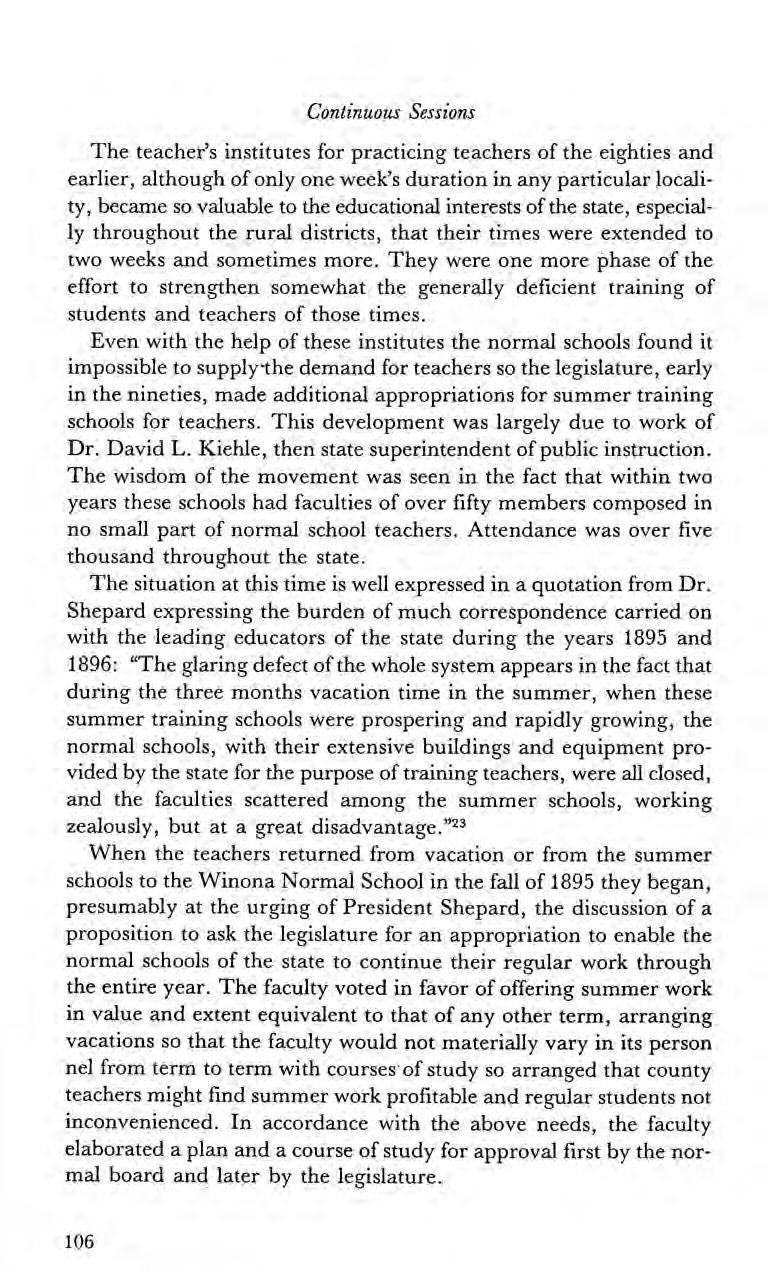
The teacher’s institutes for practicing teachers of the eighties and earlier, although of only one week’s duration in any particular locality, became so valuable to the educational interests ofthe state, especially throughout the rural districts, that their times were extended to two weeks and sometimes more. They were one more phase of the effort to strengthen somewhat the generally deficient training of students and teachers of those times.
Even with the help of these institutes the normal schools found it impossible to supply-‘the demand for teachers so the legislature, early in the nineties, made additional appropriations for summer training schools for teachers. This development was largely due to work of Dr. David L. Kiehle, then state superintendent of public instruction. The wisdom of the movement was seen in the fact that within two years these schools had faculties of over fifty members composed in no small part of normal school teachers. Attendance was over five thousand throughout the state.
The situation at this time is well expressed in a quotation from Dr. Shepard expressing the burden of much correspondence carried on with the leading educators of the state during the years 1895 and 1896: “The glaring defect of the whole system appears in the fact that during the three months vacation time in the summer, when these summer training schools were prospering and rapidly growing, the normal schools, with their extensive buildings and equipment provided by the state for the purpose of training teachers, were all closed, and the faculties scattered among the summer schools, working zealously, but at a great disadvantage.”
When the teachers returned from vacation or from the summer schools to the Winona Normal School in the fall of 1895 they began, presumably at the urging of President Shepard, thediscussion of a proposition to ask the legislature for an appropriation to enable the normal schools of the state to continue their regular work through the entire year. The faculty voted in favor of offering summer work in value and extent equivalent to that of any other term, arranging vacations so that the faculty would not materially vary in its person nel from term to term with courses of study so arranged that county teachers might find summer work profitable and regular students not inconvenienced. In accordance with the above needs, the faculty elaborated a plan and a course of study for approval first by the normal board and later by the legislature.
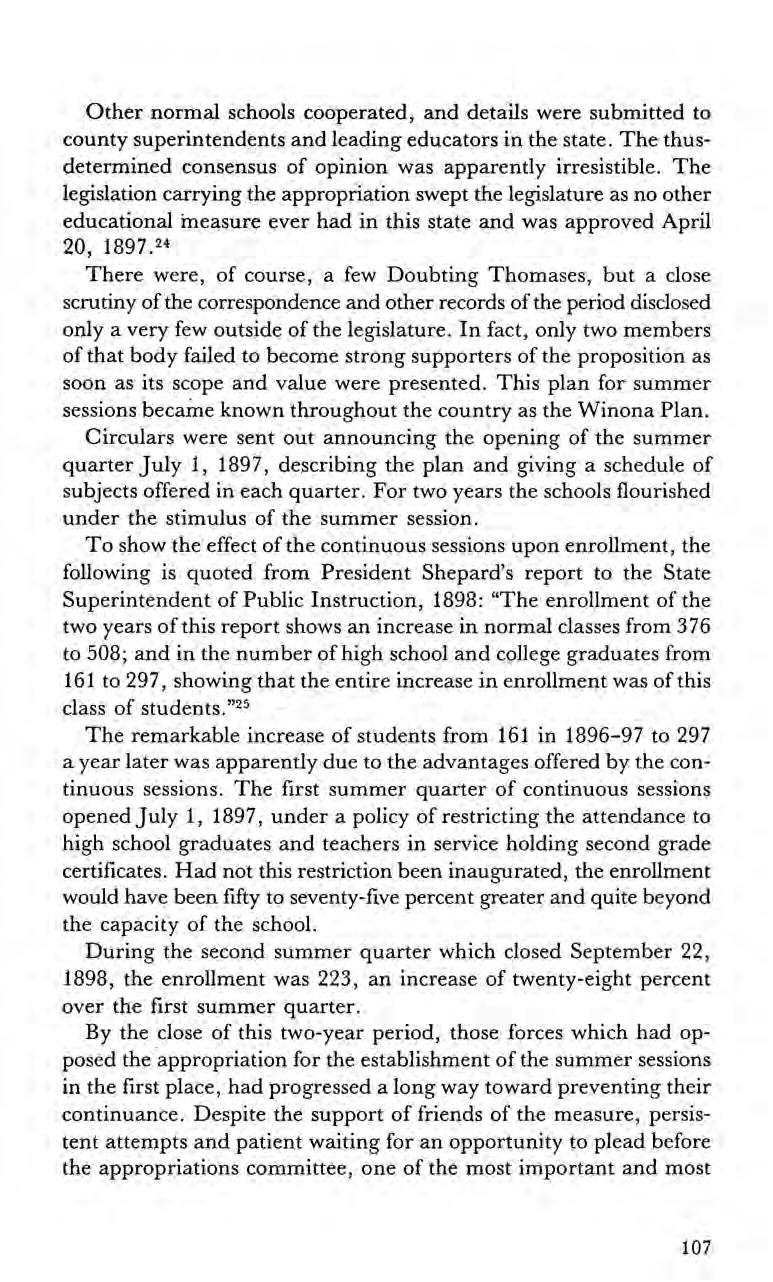
Other normal schools cooperated, and details were submitted to county superintendents and leading educators in the state. The thusdetermined consensus of opinion was apparently irresistible. The legislation carrying the appropriation swept the legislature as no other educational measure ever had in this state and was approved April 20, 1897.24
There were, of course, a few Doubting Thomases, but a close scrutiny ofthe correspondence and other records of the period disclosed only a very few outside of the legislature. In fact, only two members of that body failed to become strong supporters of the proposition as soon as its scope and value were presented. This plan for summer sessions became known throughout the country as the Winona Plan.
Circulars were sent out announcing the opening of the summer quarter July 1, 1897, describing the plan and giving a schedule of subjects offered in each quarter. For two years the schools flourished under the stimulus of the summer session.
To showthe effect of the continuous sessions upon enrollment, the following is quoted from President Shepard’s report to the State Superintendent of Public Instruction, 1898: “The enrollment of the two years of this report shows an increase in normal classes from 376 to 508; and in the number of high school and college graduates from 161 to 297, showing that the entire increase in enrollment was of this class of students.”?5
The remarkable increase of students from 161 in 1896-97 to 297 a year later was apparently due to the advantages offered by the continuous sessions. The first summer quarter of continuous sessions opened July 1, 1897, undera policy of restricting the attendance to high school graduates and teachers in service holding second grade certificates. Had not this restriction been inaugurated, the enrollment would have been fifty to seventy-five percent greater and quite beyond the capacity of the school.
During the second summer quarter which closed September 22, 1898, the enrollment was 223, an increase of twenty-eight percent over the first summer quarter.
By the close of this two-year period, thoseforces which had opposed the appropriation for the establishment of the summer sessions in the first place, had progressed a long way toward preventing their continuance. Despite the support of friends of the measure, persistent attempts and patient waiting for an opportunity to plead before the appropriations committee, one of the most important and most
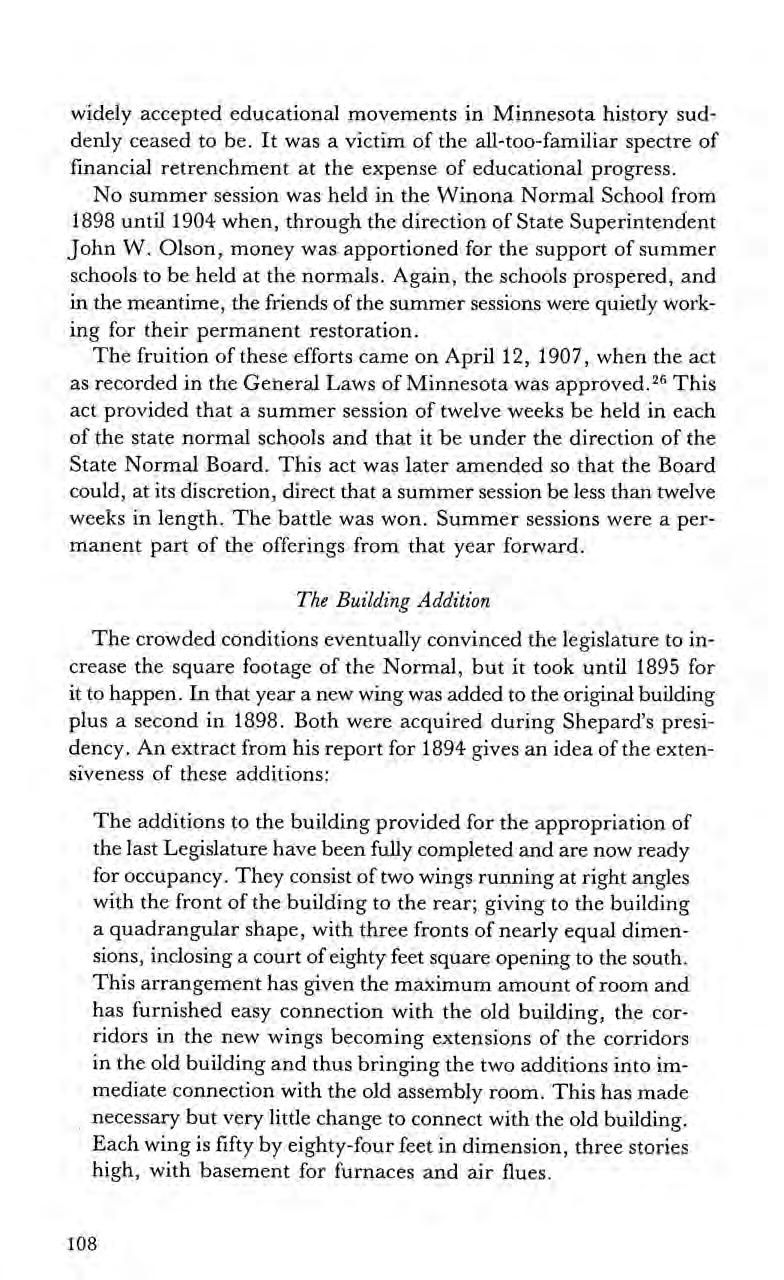
widely accepted educational movements in Minnesota history suddenly ceased to be. It was a victim of the all-too-familiar spectre of financial retrenchment at the expense of educational progress.
No summer session was held in the Winona Normal School from 1898 until 1904 when, through the direction of State Superintendent John W. Olson, money was apportioned for the support of summer schools to be held at the normals. Again, the schools prospered, and in the meantime, the friends of the summer sessions were quietly working for their permanent restoration.
The fruition of these efforts came on April 12, 1907, when the act as recorded in the General Laws of Minnesota was approved.”® This act provided that a summer session of twelve weeks be held in each of the state normal schools and that it be under the direction of the State Normal Board. This act was later amended so that the Board could, at its discretion, direct that a summer session be less than twelve weeks in length. The battle was won. Summer sessions were a permanent part of the offerings from that year forward.
The crowded conditions eventually convinced the legislature to increase the square footage of the Normal, but it took until 1895 for it to happen. In that year a new wing was added to the original building plus a second in 1898. Both were acquired during Shepard’s presidency. An extract from his report for 1894 gives an idea of the extensiveness of these additions:
The additions to the building provided for the appropriation of the last Legislature have been fully completed and are now ready for occupancy. They consist of two wings running at right angles with the front of the building to the rear; giving to the building a quadrangular shape, with three fronts of nearly equal dimensions, inclosing a court of eighty feet square opening to thesouth. This arrangement has given the maximum amount of room and has furnished easy connection with the old building, the corridors in the new wings becoming extensions of the corridors in the old building and thus bringing the two additions into immediate connection with the old assembly room. This has made necessary but very little change to connect with the old building. Each wing is fifty by eighty-four feet in dimension, three stories high, with basement for furnaces and air flues.

The first floor forms the extension of the model school department of the old building, and more than doubles the capacity of this overcrowded department. With this addition, the model school now has twenty rooms available for use in student teaching, thus furnishing a much needed relief. On the second floor, seven commodious recitation rooms have been added to the normal department and all are equally accessible from the assembly room. On the third floor both wings of the new additions are given up to science laboratories, the west wing affording a large chemical laboratory, which has been completely fitted for individual work by thirty-six students, each student being provided with water, gas, a slate top table, and a full equipment of chemicals. In addition to this a large physical laboratory has been fully equipped. These two rooms occupy the entire third floor of the west wing, and are continuous with the chemical recitation room in the old building. A circular tower was constructed in the southwest angle of the west wing on a basis for a revolving dome to receive a telescope. This dome has been completed and fitted with machinery especially designed by Professor Freeman, the teacher of physical sciences. In the basement of the west wing a commodious gymnasium has been fitted up, thirty by fifty feet in size. This has already proved an efficient addition to the department of physical culture, and during the past winter was under the charge of Professor John M. Holzinger. The third floor of the east wing has been fitted up as a biological laboratory, with an adjoining workshop, recitation room and addition to the museum. These additions now give the natural history department, with its laboratories and museums, a continuous space of 160 feet by 50 feet. The additions to the building have made possible certain modifications in the old building which have been long needed, though the changes are comparatively slight. A new library has been added, which will furnish facilities for library work which have not hitherto been enjoyed.?’
After nineteen years at the helm President Shepard severed his connection with the Normal School late in 1898. He had been an effective leader during a period of great growth and development, and
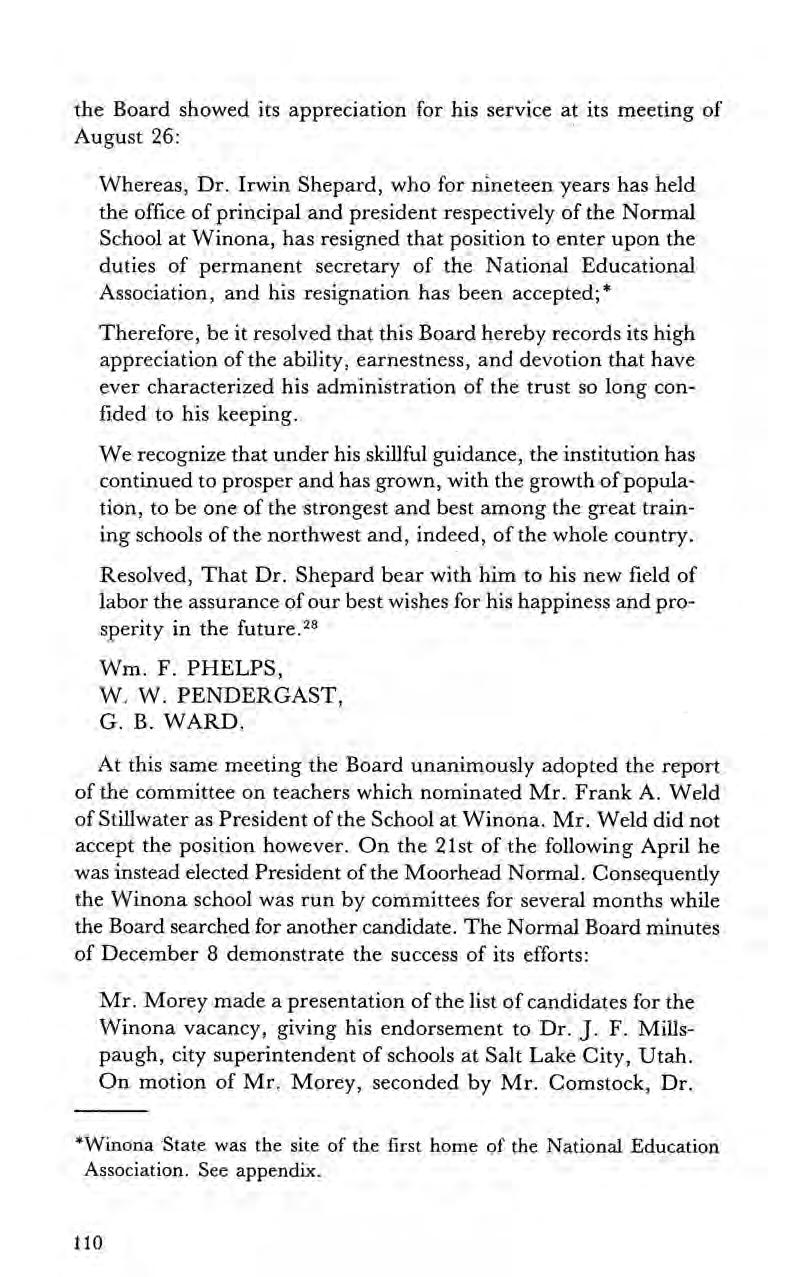
the Board showed its appreciation for his service at its meeting of August 26:
Whereas, Dr. Irwin Shepard, who for nineteen years has held the office of principal and president respectively of the Normal School at Winona, has resigned that position to enter upon the duties of permanent secretary of the National Educational Association, and his resignation has been accepted;*
Therefore, be it resolved that this Board hereby records its high appreciation of the ability, earnestness, and devotion that have ever characterized his administration of the trust so long confided to his keeping.
We recognize that under his skillful guidance, the institution has continued to prosper and has grown, with the growth of population, to be one of the strongest and best among the great training schools of the northwest and, indeed, of the whole country.
Resolved, That Dr. Shepard bear with him to his new field of labor the assurance of our best wishes for his happiness and prosperity in the future.?®
At this same meeting the Board unanimously adopted the report of the committee on teachers which nominated Mr. Frank A. Weld of Stillwater as President of the School at Winona. Mr. Weld did not accept the position however. On the 21st of the following April he was instead elected President of the Moorhead Normal. Consequently the Winona school was run by committees for several months while the Board searched for another candidate. The Normal Board minutes of December 8 demonstrate the success of its efforts:
Mr. Morey madea presentation of the list of candidates for the Winona vacancy, giving his endorsement to Dr. J. F. Millspaugh, city superintendent of schools at Salt Lake City, Utah. On motion of Mr. Morey, seconded by Mr. Comstock, Dr.
*Winona State was the site of the first home of the National Education Association. See appendix.
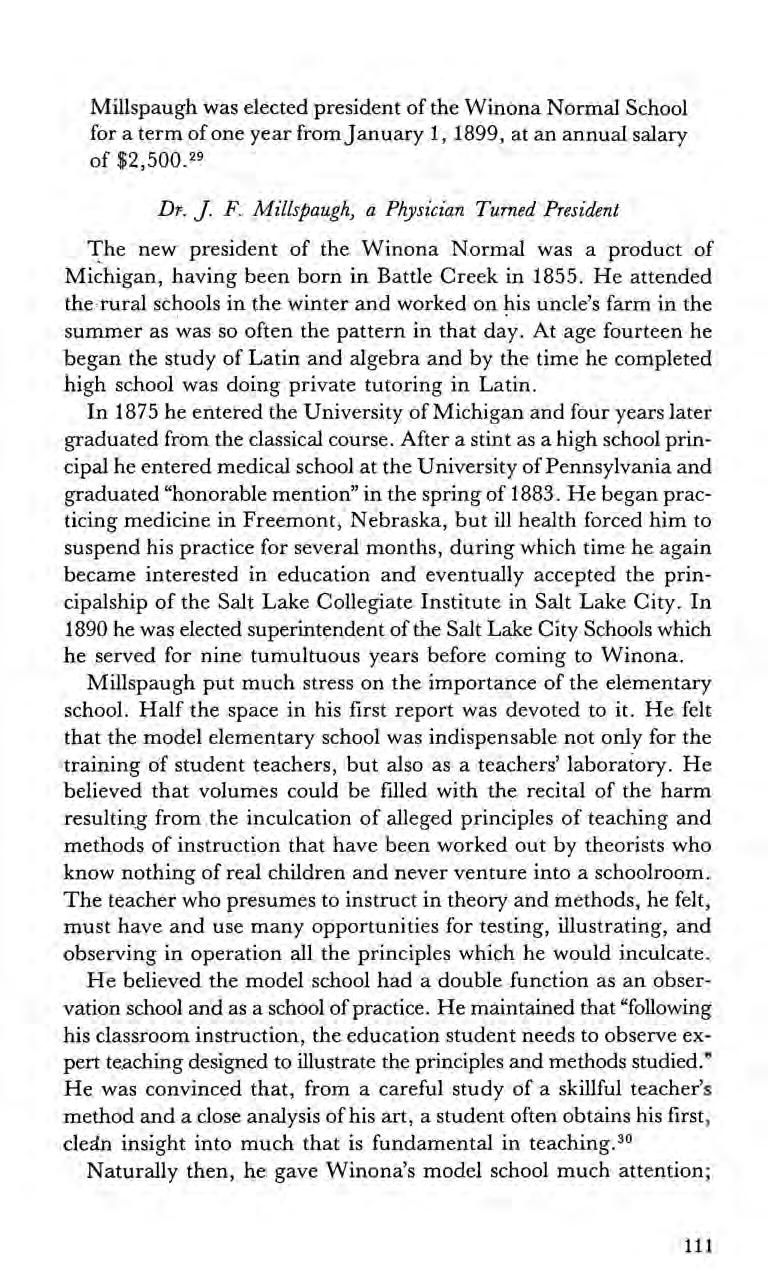
Millspaugh was elected president of the Winona Normal School for a term of one year fromJanuary 1, 1899, at an annual salary of $2,500.79
The new president of the Winona Normal was a product of Michigan, having been born in Battle Creek in 1855. He attended the-rural schools in the winter and worked on his uncle’s farm in the summer as was so often the pattern in that day. At age fourteen he began the study of Latin and algebra and by the time he completed high school was doing private tutoring in Latin.
In 1875 he entered the University of Michigan and four years later graduated from the classical course. After a stint as a high school principal he entered medical school at the University of Pennsylvania and graduated “honorable mention” in the spring of 1883. He began practicing medicine in Freemont, Nebraska, but ill health forced him to suspend his practice for several months, during which time he again became interested in education and eventually accepted the principalship of the Salt Lake Collegiate Institute in Salt Lake City. In 1890 he was elected superintendent of theSalt Lake City Schools which he served for nine tumultuous years before coming to Winona.
Millspaugh put much stress on the importance of the elementary school. Half the space in his first report was devoted to it. He felt that the model elementary school was indispensable not only for the training of student teachers, but also as a teachers’ laboratory. He believed that volumescould be filled with the recital of the harm resulting from the inculcation of alleged principles of teaching and methods of instruction that have been worked out by theorists who know nothing of real children and never venture into a schoolroom. The teacher who presumes to instruct in theory and methods, he felt, must have and use many opportunities for testing, illustrating, and observing in operation all the principles which he would inculcate.
He believed the model school had a double function as an observation school and as a school ofpractice. He maintained that “following his classroom instruction, the education student needs to observe expert teaching designed to illustrate the principles andmethods studied.” He was convinced that, from a careful study of a skillful teacher’s method anda close analysis ofhis art, a student often obtains his first, cledn insight into much that is fundamental in teaching.*°
Naturally then, he gave Winona’s model school much attention;

JESSE F. MILLSPAUGH President, 1898-1904
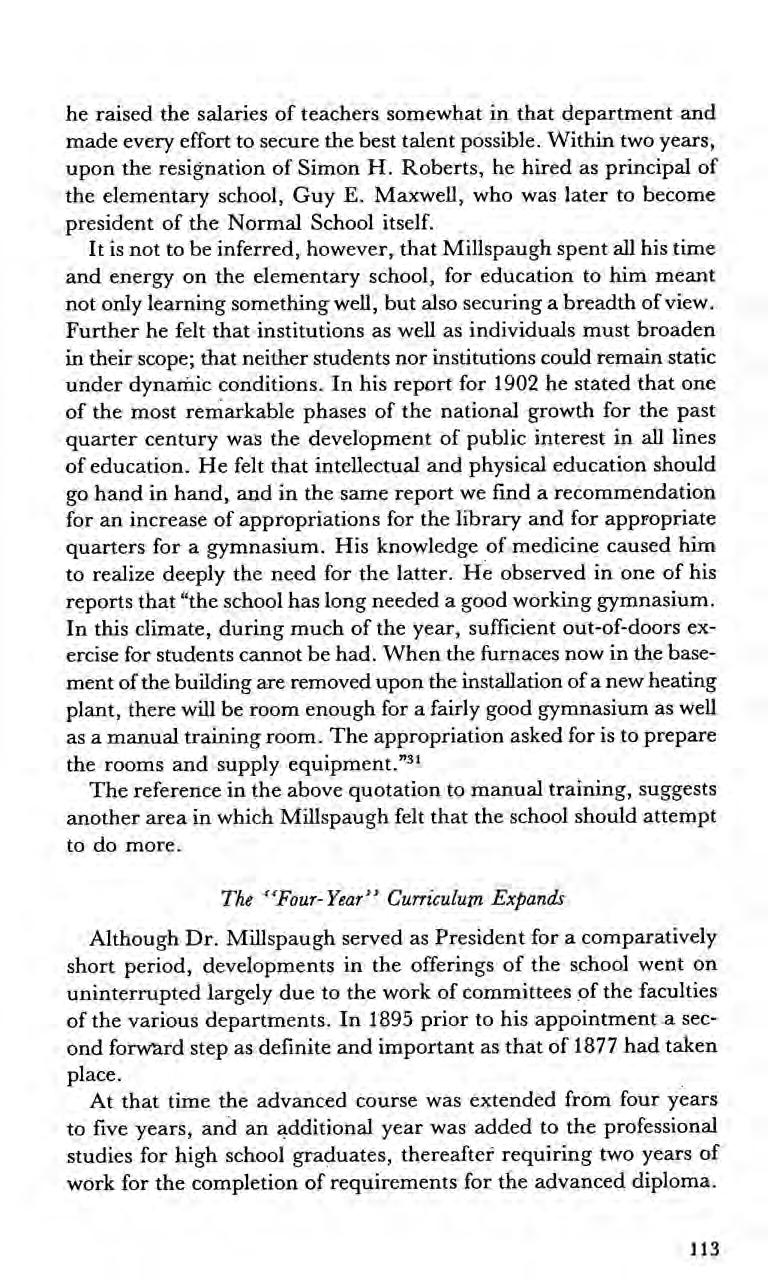
he raised the salaries of teachers somewhat in that department and made every effort to secure the best talent possible. Within two years, upon the resignation of Simon H. Roberts, he hired as principal of the elementary school, Guy E. Maxwell, who was later to become president of the Normal School itself.
It is not to be inferred, however, that Millspaugh spent all his time and energy on the elementary school, for education to him meant not only learning something well, but also securing a breadth ofview. Further he felt that institutions as well as individuals must broaden in their scope; that neither students nor institutions could remain static under dynamic conditions. In his report for 1902 he stated that one of the most remarkable phases of the national growth for the past quarter century was the development of public interest in all lines of education. He felt that intellectual and physical education should go hand in hand, and in the same report we find a recommendation for an increase of appropriations for the library and for appropriate quarters for a gymnasium. His knowledge of medicine caused him to realize deeply the need for the latter. He observed in one of his reports that “the school has long needed a good working gymnasium. In this climate, during much of the year, sufficient out-of-doors exercise for students cannot be had. When the furnaces now in the basement ofthe building are removed upon the installation of a new heating plant, there will be room enough fora fairly good gymnasium as well as a manual training room. The appropriation asked for is to prepare the rooms and supply equipment.”!
The reference in the above quotation to manual training, suggests another area in which Millspaugh felt that the school should attempt to do more.
Although Dr. Millspaugh served as President for a comparatively short period, developments in the offerings of the school went on uninterrupted largely due to the work of committees of the faculties of the various departments. In 1895 prior to his appointmenta second forward step as definite and important as that of 1877 had taken place.
At thattime the advanced course was extended from four years to five years, and an additional year was added to the professional studies for high school graduates, thereafter requiring two years of work for the completion of requirements for the advanced diploma.
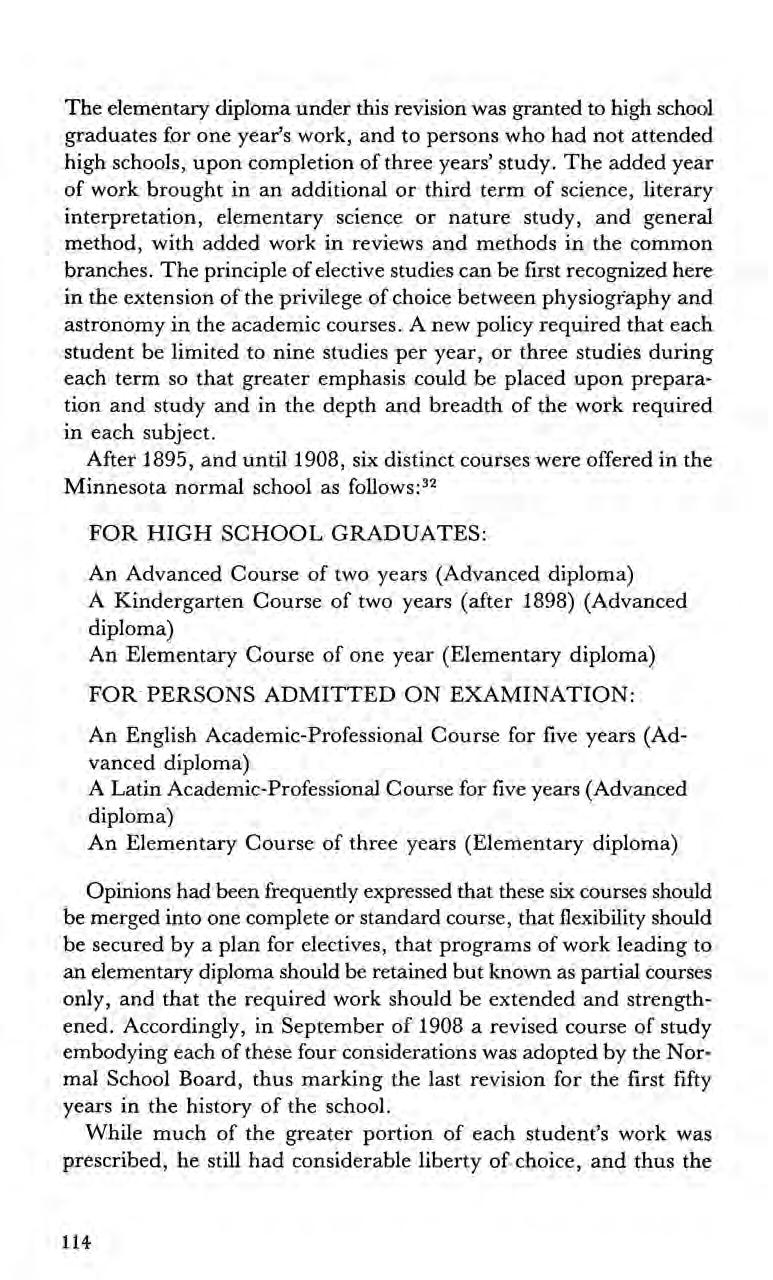
The elementary diploma under this revision was granted to high school graduates for one year’s work, and to persons who had not attended high schools, upon completion of three years’ study. The added year of work brought in an additional or third term of science, literary interpretation, elementary science or nature study, and general method, with added work in reviews and methods in the common branches. The principle of elective studies can be first recognized here in the extension of the privilege of choice between physiography and astronomy in theacademic courses. A new policyrequired that each student be limited to nine studies per year, or three studies during each term so that greater emphasis could be placed upon preparation and study and in the depth and breadth of the work required in each subject.
After 1895, and until 1908, six distinct courses were offered in the Minnesota normal school as follows:3?
An Advanced Course of two years (Advanced diploma)
A Kindergarten Course of two years (after 1898) (Advanced diploma)
An Elementary Course of one year (Elementary diploma)
An English Academic-Professional Course for five years (Advanced diploma)
A Latin Academic-Professional Course for five years (Advanced diploma)
An Elementary Course of three years (Elementary diploma)
Opinions had been frequently expressed that these six courses should be merged into one complete or standard course, that flexibility should be secured bya plan for electives, that programs of work leading to an elementary diploma should be retained but known as partial courses only, and that the required work should be extended and strengthened. Accordingly, in September of 1908 a revised course of study embodying each of these four considerations was adopted by the Normal School Board, thus marking the last revision for the first fifty years in the history of the school.
While much of the greater portion of each student’s work was prescribed, he still had considerable liberty of choice, and thus the
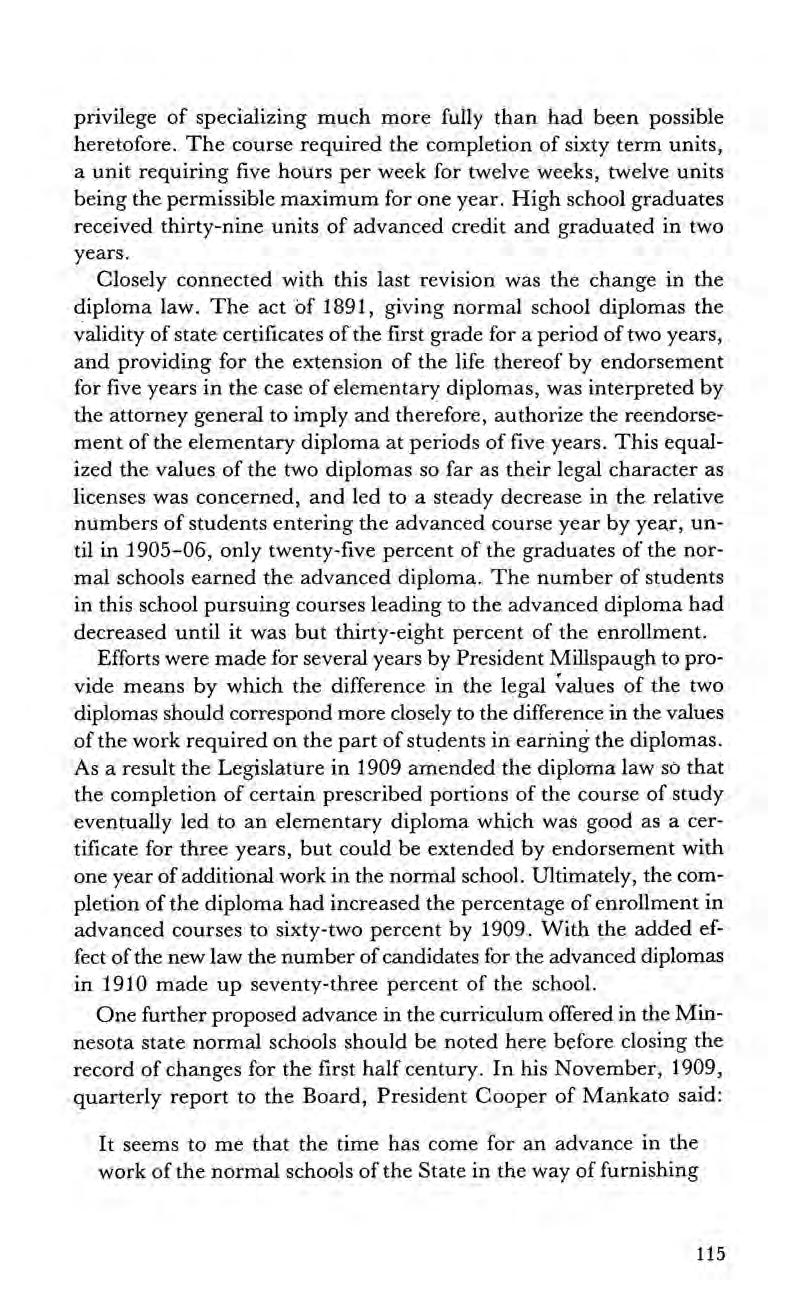
privilege of specializing much more fully than had been possible heretofore. The course required the completion of sixty term units, a unit requiring five hours per week for twelve weeks, twelve units being the permissible maximumfor one year. High school graduates received thirty-nine units of advanced credit and graduated in two years.
Closely connected with this last revision was the change in the diploma law. The act of 1891, giving normal school diplomas the validity of state certificates of the first grade for a period of two years, and providing for the extension of the life thereof by endorsement for five years in the case of elementary diplomas, was interpreted by the attorney general to imply and therefore, authorize the reendorsement of the elementary diploma at periods of five years. This equalized the values of the two diplomas so far as their legal character as licenses was concerned, and led to a steady decrease in the relative numbers of students entering the advanced course year by year, until in 1905-06, only twenty-five percent of the graduates of the normal schools earned the advanced diploma. ‘The number of students in this school pursuing courses leading to the advanced diploma had decreased until it was but thirty-eight percent of the enrollment.
Efforts were made for several years by President Millspaugh to provide means by which the difference in the legal values of the two diplomas should correspond more closely to the difference in the values of the work required on the part of students in earning the diplomas. As a result the Legislature in 1909 amended the diploma law so that the completion of certain prescribed portions of the course of study eventually led to an elementary diploma which was good as a certificate for three years, but could be extended by endorsement with one year of additional work in the normal school. Ultimately, the completion of the diploma had increased the percentage of enrollment in advanced courses to sixty-two percent by 1909. With the added effect ofthe new law the number ofcandidates for the advanced diplomas in 1910 made up seventy-three percent of the school.
One further proposed advance in the curriculum offered in the Minnesota state normal schools should be noted here before closing the record of changes for the first half century. In his November, 1909, quarterly report to the Board, President Cooper of Mankato said:
It seems to me that the time has come for an advance in the work of the normal schools of the State in the way of furnishing

special courses to train special teachers in the subjects that are being introduced into our schools. I refer to manual training, music, drawing, home economics, agriculture and the like. Some of the normal schools have taken one step in this direction, the kindergarten training course, but for more than eleven years we have stood still in this matter while the public schools have been making continually louder calls on us for teachers who can do the new things that are finding a place in the schools.
It is not my thought that each school can train special teachers in all of these subjects, but with a comparatively small addition to our support funds each of the schools could train in two or three of them, dividing the field, as is done in some other states.*?
An informal discussion by the Board was followed by the adoption of the following resolution offered by Mr. Schultz:
That the presidents are requested to investigate the question of establishing new courses in the normal schools for the training of special teachers in the new lines ofwork that are being generally undertaken in the public schools, and make report to the Board at its next annual meeting.
Accordingly the first action ofthe Board ofPresidents, in February, is recorded in the following motion:
After general discussion, concerning the proposition to establish special courses of study in the normal schools, the following motion was adopted: That it is the sense of this Board that it may be practicable and advisable to establish special courses of study in household arts, drawing, music, and manual training, etc., in the normal schools, but that additional information concerning the operation of such courses of study in other state normal schools should be secured.
The general discussion concerning the proposition to establish special courses of study in the normal schools led to the suggestion that it would be well to recommend an extension of the course of study so that the normal schools might offer college work. 34
The original “simple and unpretentious” course of two years was more than doubled in length and scope during those years, and

students entering the normal school from high schools in 1910, pursued three times as much work as their fellows of fifty years before. The steps in this forward movement were steady and definite. While avoiding alluring by-paths, those who developed the curriculum clearly understood the enlarging conception of the place of common schools in the life and progress of a democracy, and steadily demanded higher standards of technical knowledge, expertise in execution, and general culture.
With the close of the period there were signs that the Minnesota normal schools were about to give serious consideration to plans for enlarging the scope of their professional training for teachers, and in so doing would perhaps become teachers’ colleges one day, a pattern others around the country were already following.
Jesse E. Millspaugh served the WinonaNormal for something over five years during which he left his mark on the school’s development. He left to assume a like position in Los Angeles, for reasons clearly stated in his letter of resignation.®® -
Winona, Minnesota, April 7, 1904
To the State Normal Board of Minnesota, Hon. C. A. Morey, President
Gentlemen:
Since I have been elected president ofthe California State Normal School at Los Angeles and it seems best to accept the position tendered me, I desire respectfully to present my resignation from the presidency of the Winona school, to takeeffect at the end of the present fiscal year.
In thus seeking to sever the relations which, for the past five and a half years, I have sustained with your honorable body and the school, may I be permitted to say that I am impelled to this course solely by desire to secure for my family and for myself more favorable climatic conditions? Each year of my residence here has served to attach me more strongly to the state, its people, and particularly to the beloved institution with which I have been most closely connected. No experience of my educational career has been so rich and valuable to myself as that which I
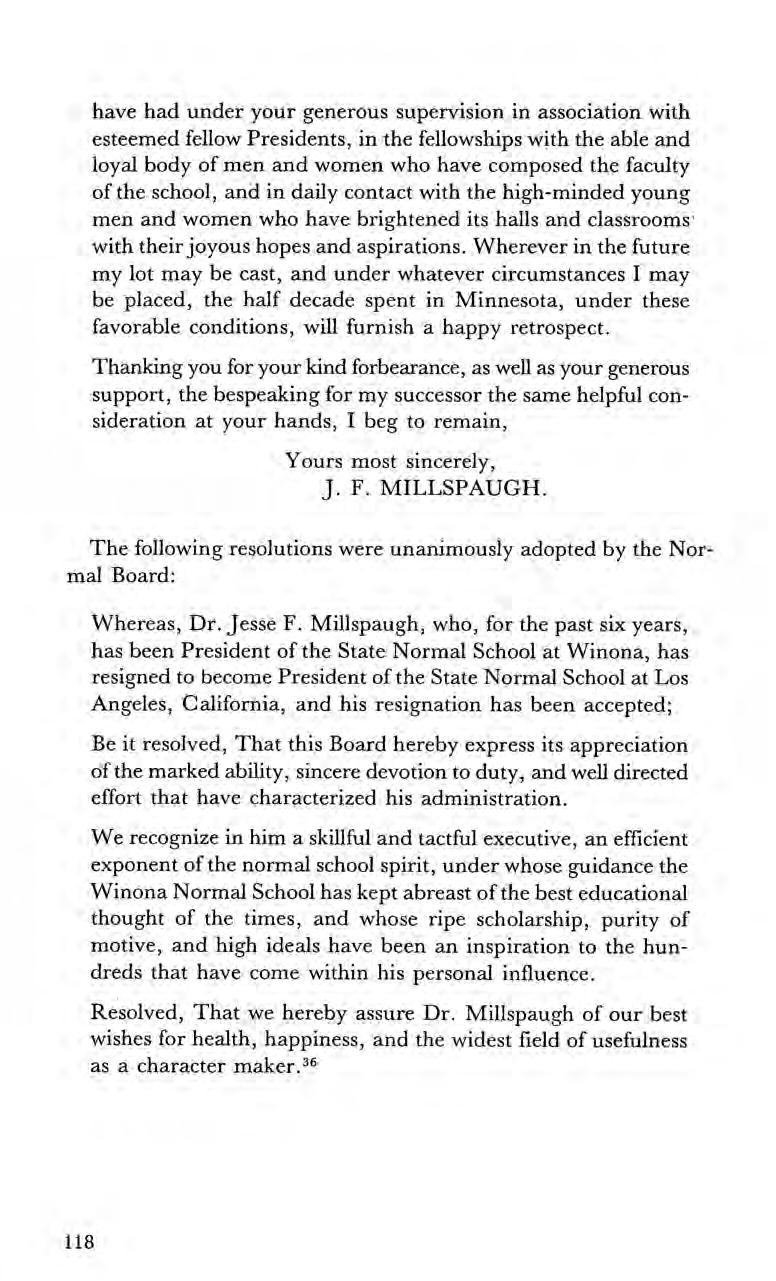
have had under your generous supervision in association with esteemed fellow Presidents, in the fellowships with the able and loyal body of men and women who have composed the faculty of the school, and in daily contact with the high-minded young men and women who have brightened its halls and classrooms: with theirjoyous hopes and aspirations. Wherever in the future my lot may be cast, and under whatever circumstances I may be placed, the half decade spent in Minnesota, under these favorable conditions, will furnish a happy retrospect.
Thanking you for your kind forbearance, as well as your generous support, the bespeaking for my successor the same helpful consideration at your hands, I beg to remain,
Yours most sincerely,
J. F. MILLSPAUGH.
The following resolutions were unanimously adopted by the Normal Board:
Whereas, Dr. Jesse F. Millspaugh, who, for the past six years, has been President of the State Normal School at Winona, has resigned to become President of the State Normal School at Los Angeles, California, and his resignation has been accepted;
Be it resolved, That this Board hereby express its appreciation of the marked ability, sincere devotion to duty, and well directed effort that have characterized his administration.
We recognize in hima skillful and tactful executive, an efficient exponent of the normal school spirit, under whose guidance the WinonaNormal School has kept abreast of the best educational thought of the times, and whose ripe scholarship, purity of motive, and high ideals have been an inspiration to the hundreds that have come within his personal influence.
Resolved, That we hereby assure Dr. Millspaugh of our best wishes for health, happiness, and the widest field of usefulness as a character maker.*®
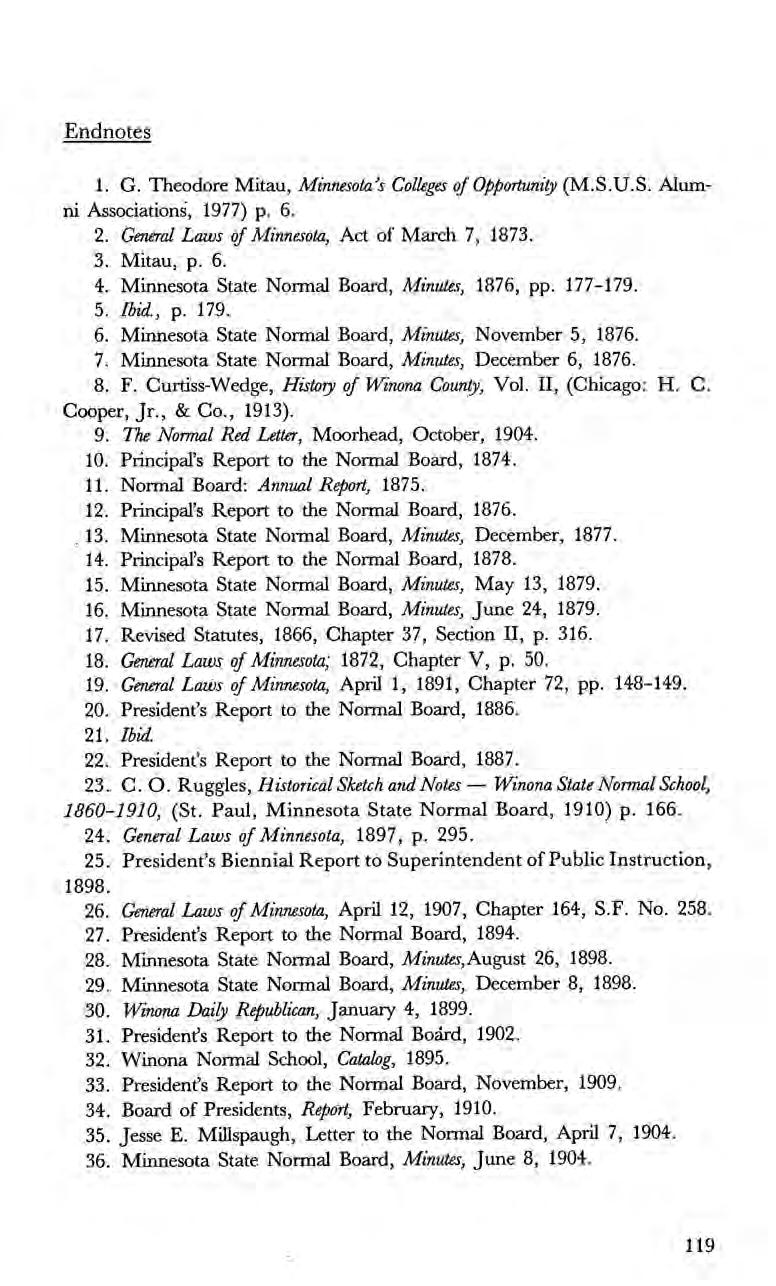
1. G. Theodore Mitau, Minnesota’s Colleges ofOpportunity (M.S.U.S. Alumni Associations, 1977) p. 6.
General Laws ofMinnesota, Act of March 7, 1873. Mitau, p. 6.
Minnesota State Normal Board, Minutes, 1876, pp. 177-179. Ibid., p. 179.
Minnesota State Normal Board, Minutes, November 5, 1876.
Minnesota State Normal Board, Minutes, December 6, 1876.
F. Curtiss-Wedge, History of Winona County, Vol. II, (Chicago: H. C. Cooper, Jr., & Co., 1913).
The Normal Red Letter, Moorhead, October, 1904.
Principal’s Report to the Normal Board, 1874.
Normal Board: Annual Report, 1875.
Principal’s Report to the Normal Board, 1876.
Minnesota State Normal Board, Minutes, December, 1877.
Principals Report to the Normal Board, 1878.
Minnesota State Normal Board, Minutes, May 13, 1879.
Minnesota State Normal Board, Minutes, June 24, 1879.
Revised Statutes, 1866, Chapter 37, Section II, p. 316.
General Laws ofMinnesota; 1872, Chapter V, p. 50.
General Laws ofMinnesota, April 1, 1891, Chapter 72, pp. 148-149.
President’s Report to the Normal Board, 1886. Thid.
President’s Report to the Normal Board, 1887.
C. O. Ruggles, Historical Sketch and Notes Winona State Normal School, 1910, (St. Paul, Minnesota State Normal Board, 1910) p. 166.
General Laws ofMinnesota, 1897, p. 295.
President’s Biennial Report to Superintendent of Public Instruction,
General Laws ofMinnesota, April 12, 1907, Chapter 164, S.F. No. 258.
President’s Report to the Normal Board, 1894.
Minnesota State Normal Board, Minutes, August 26, 1898.
Minnesota State Normal Board, Minutes, December 8, 1898.
Winona Daily Republican, January 4, 1899.
President’s Report to the Normal Board, 1902. Winona Normal School, Catalog, 1895.
President's Report to the Normal Board, November, 1909. Board of Presidents, Report, February, 1910.
Jesse E. Millspaugh, Letter to the Normal Board, April 7, 1904. Minnesota State Normal Board, Minutes, June 8, 1904.
CHAPTER IV

When the normal school was closed down for the “duration” in 1861 it consisted of little more than a few instructors, a few students and a place for them tomeet. Societies and departments had not yet had time to emerge:
With the cessation of hostilities, however, and the reopening of the school in 1864, it was not long before the inevitable growth of clubs, leagues, societies and other organizations began to take place.
Registration and Enrollment—1860-1910
From its beginning, the Normal, as it was usually called, saw a steady if not spectacular growth. There were, of course, the usual fluctuations due to varying circumstances and changes in curriculum, but overall the school continued to grow as it went forward from one stage to the next.
Table III shows growth statistics from 1860 to 1910, a period of time during which the Normal went through its metamorphoses from an institution preparing teachers for the country schools to one which fifty years later was readying itself for full, four-year college status.
Certainly it had humble enough beginnings, for originally it was nothing more thana training school which accepted graduates of the eighth grade and gave them enough additional education so they could go out and pass on their knowledge, such as it was, to the upcoming generations of rural Minnesota. It was at first well below high school level; in fact its graduates often went back tohigh school later to get their diplomas after having taught for a while.
But as new curricular demands began to be felt, so did the need for a more extended period of training for these minimally prepared
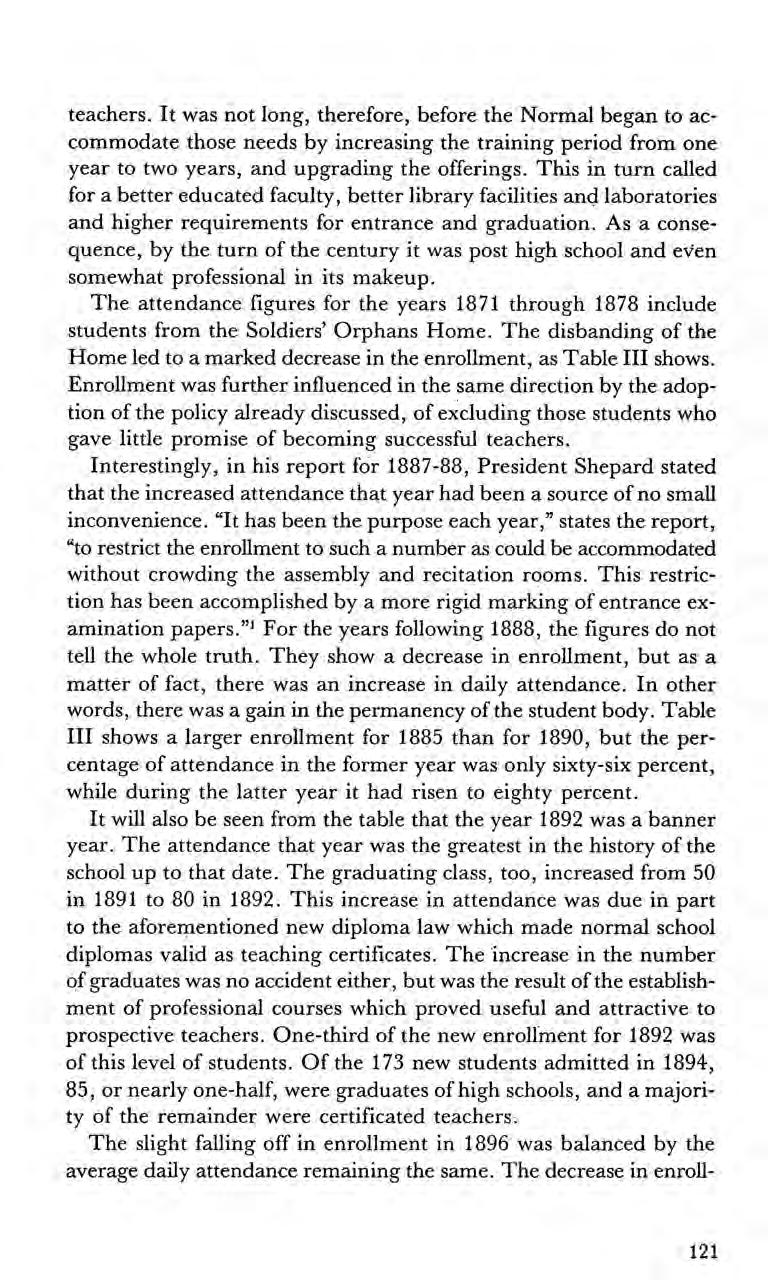
teachers. It was not long, therefore, before the Normal began to accommodate those needs by increasing the training period from one year to two years, and upgrading the offerings. This in turn called for a better educated faculty, better library facilities and laboratories and higher requirements for entrance and graduation. As a consequence, by the turn of the century it was post high school and even somewhat professional in its makeup.
The attendance figures for the years 1871 through 1878 include students from the Soldiers’ Orphans Home. The disbanding of the Home led to a marked decrease in the enrollment, as Table III shows. Enrollment was further influenced in the same direction by the adoption of the policy already discussed, of excluding those students who gave little promise of becoming successful teachers.
Interestingly, in his report for 1887-88, President Shepard stated that the increased attendance that year had been a source of no small inconvenience. “It has been the purpose each year,” states the report, “to restrict the enrollment to such a number as could be accommodated without crowding the assembly and recitation rooms. This restriction has been accomplished by a more rigid marking of entrance examination papers.”! For the years following 1888, the figures do not tell the whole truth. They show a decrease in enrollment, but as a matter of fact, there was an increase in daily attendance. In other words, there was a gain in the permanency of the student body. Table III shows a larger enrollment for 1885 than for 1890, but the percentage of attendance in the former year was only sixty-six percent, while during the latter year it had risen to eighty percent.
It will also be seen from the table that the year 1892 was a banner year. The attendance that year was the greatest in the history of the school up to that date. The graduating class, too, increased from 50 in 1891 to 80 in 1892. This increase in attendance was due in part to the aforementioned new diploma law which made normal school diplomas valid as teaching certificates. The increase in the number ofgraduates was no accident either, but was the result ofthe establishment of professional courses which proved useful and attractive to prospective teachers. One-third of the new enrollment for 1892 was of this level of students. Of the 173 new students admitted in 1894, 85, or nearly one-half, were graduates of high schools, and a majority of the remainder were certificated teachers.
The slight falling off in enrollment in 1896 was balanced by the average daily attendance remaining the same. ‘The decrease in enroll-
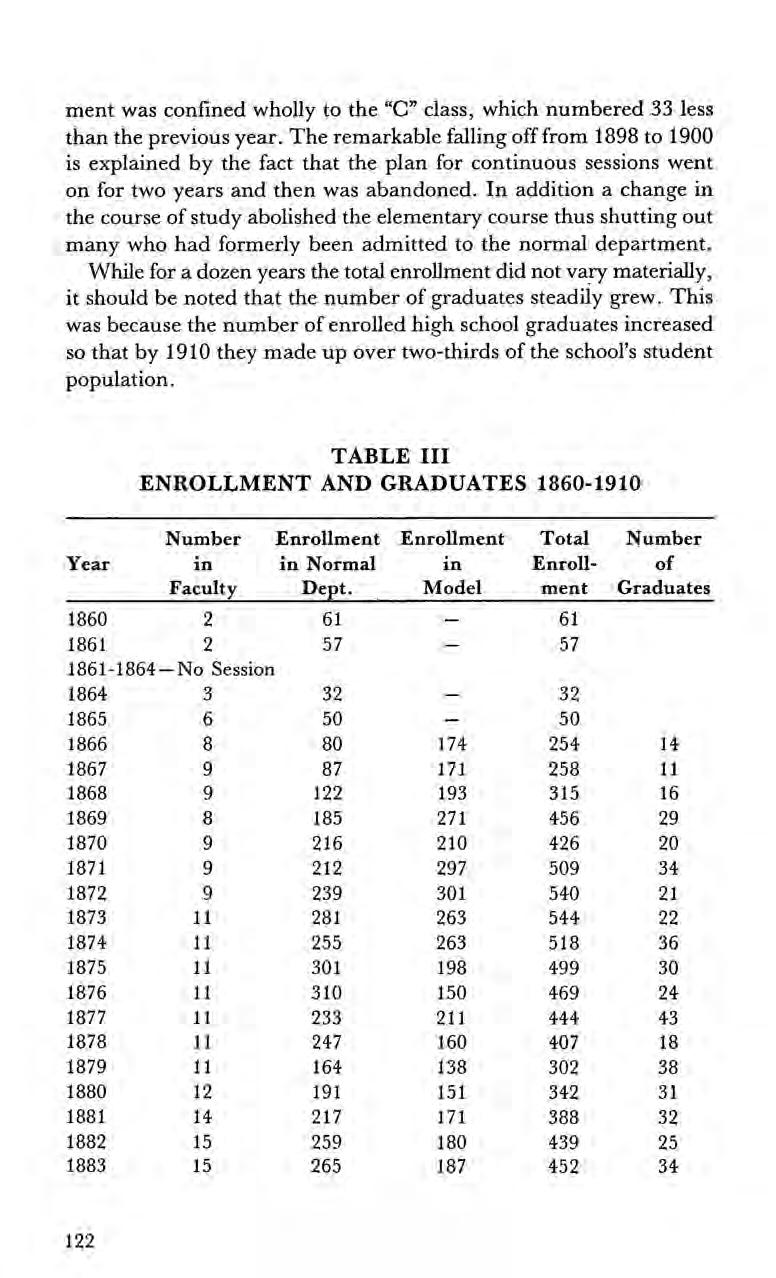
ment was confined wholly to the “C” class, which numbered 33 less than the previous year. The remarkable falling off from 1898 to 1900 is explained by the fact that the plan for continuous sessions went on for two years and then was abandoned. In addition a change in the course of study abolished the elementary course thus shutting out many who had formerly been admitted to the normal department. While for a dozen years the total enrollment did not vary materially, it should be noted that the number of graduates steadily grew. This was because the number of enrolled high school graduates increased so that by 1910 they made up over two-thirds of the school’s student population.

*After 1908 all figures include the numbers for summer terms also.
The beginnings of the library seem to have been coincident with the beginnings of the normal school itself, for we find in the 1860 report of the committee on the organization of the school that the library texts and reference books already numbered fifteen hundred volumes. Moreover, a library room had been provided in the building erected by the city for the purpose of accommodating the school. In the same report we also find that donations of books of a suitable

‘character in any department of literature were “thankfully received and appropriately acknowledged.” No appropriations were made for the specific use of the library until 1877 when the sum of $500 was appropriated by the Legislature “for library, laboratory, and museum.”? This made it possible to open a reading room for the use of the students. In the planning of the new building which was erected in 1869, a large room on the second floor was devoted to library purposes and continued to be. the library and reading room until 1895. By that time the holdings which numbered 3,000 volumes necessitated larger quarters and an extra room was added.
For over twenty years the library was under the direction of the teachers. Then, in 1883, Anna Fockens (class of 83) was appointed librarian and assistant in the English department. She was followed in 1885 by Mrs. I. M. Mead (class of ’84) who also assisted in the English work. In the following year, 1886, Fannie Elmer was elected teacher of Latin and librarian of textbook and general libraries. As early as 1878 a separation of the textbooks and general library books had been made with a nucleus of about five hundred volumes for the general library. By 1887 this number had increased to 1,000 and by 1898, the end of Miss Elmer’s administration, there were 4,000 books in the general library all classified by the Dewey system.
The library by then had grown to such proportions that it was deemed necessary to havea librarian whoshould give her entire time to this department of the school. Ida Aikins from the Library School at Armour Institute was accordingly placed in that position.
In the winter of 1900 Mary Grant entered the library for a course in library work under Miss Aikins and in the fall of that year was made assistant librarian. She became head librarian a year later when Aikins left.
During the following ten years, the library more than doubled under the guidance of Miss Grant.
The early history of the museum prior to 1882 is gathered from the published statements of William Phelps and Dr. Irwin Shepard. As early as 1865 Principal Phelps and his associates, on “excursions to quarries and railway cuts and other excavations, and along the bluffs of the Mississippi River” collected the first fossils and minerals which were destined to become the beginnings ofthe Winona Normal School Museum of Natural History. Phelps described those trips as extend-

ing along the Winona and St. Peter railroad all the way from this city to the end of the track on the Missouri River. Excursions were also made to Duluth. With hammer and sack, little by little the specimens were gathered in, and finally began to be displayed on a small table in the school room in the upper story under the roof of the old building on the corner of Lafayette and Fourth Streets.
Prior to 1871 citizens of Winona had placed private collections of minerals and specimens in the normal school building: Notable among these contributors was Phelps himself and Mr. Thomas Simpson, later a resident director, who contributed his large private cabinet of minerals. Many minerals and fossils were brought back from an expedition to Fort Berthold, Montana, in 1873. Mr. Phelps obtained an Indian bullhide boat which became a conspicuous part of the collection. At Duluth he purchased the cluster oflarge amethyst crystals, said to be the largest quartz crystals known at the time.
Phelps also secured the series ofphysiographical and paleontological paintings of Ernest Sandoz, a nephew of Professor Arnold Guyot, which decorated the high wall spaces of the old museum.
Next, in 1875 the citizens of Winona, at the advice and solicitation of Mr. Phelps, contributed about $3,500 for the purchase of the Woodman Collection of minerals, fossils, casts, corals, sponges, and shells. ‘This collection also included the partial remains of a mastodon skeleton which was displayed in a glass case in the center of the museum.
In order to understand the relation of this museum to the Winona Normal School, it is necessary to go back a few years. In 1871, a number of Winona citizens, led by Principal Phelps, had adopted articles of association for the Winona Society ofArts, Sciences, and Letters. The charter members were, besides Phelps himself, ‘Thomas Simpson, Abner Lewis, Mary V. Lee, C. C. Curtiss, O. B. Gould, Sarah L. Wheeler, and C. H. Berry. The purpose of this society, as set forth in the articles, was “the fitting of rooms in the First State Normal School building for a musem of natural history and physical science, and for a department of drawing and the arts of design; the collection, classification, and arrangement of specimens in natural history and archaeology, and of models in physics and the fine arts; the collection of facts and objects pertaining to local or general history; the establishment and support, on the grounds of the normal school, of a botanical garden; the arrangement and ornamentation of the grounds; the gathering of a library of standard works in all depart-

ments of science, literature, and-art, and the collection and preservation of all collections, and by lectures and other appropriate means, the elevation of the public taste.”
Unfortunately, no record can be found giving the names of the donors of the large sum that secured the Woodman collection for the school. But the inference seems justified that some of them were members of the Society of Arts, Sciences, and Letters. It is, however, a matter of record that the Society assumed authoritative ownership of both the Woodman collection and of all the materials previously collected, otherwise contributed, or simply deposited. In the 1878 annual report of the Superintendent of Public Instruction we find recorded the following contract between the Society and the State Normal Board:
1. The society agrees that its collection, apparatus, pictures, etc., shall remain in the rooms now occupied by them so long as the building shall be used for the purpose of a state normal school.
2. That said collections, etc., shall be forever free to the use of the normal school in said building, its teachers and pupils and that said collections shall not be removed, either in whole or in part, for any purpose whatever.
3. That, to prevent interference with the operations of the school, the times of opening said rooms to the public shall be as the principal and resident director of the school shall from time to time direct, and not otherwise.
4, That the society shall bear all expense of classifying, arranging, and putting in position all specimens and objects, and ofpreserving the order and condition of the same. Provided, that the State Normal Board agrees: (1) To furnish to the society, rent free, the room now occupied by its collections; to heat, light, and keep the same in repair as long as the building shall be used for the purposes of a normal school. (2) To give to the society the use of such cases, platforms, and fixtures as are already placed in said rooms, and to build others as the acquisitions of the society may demand. (3) To furnish janitor’s services for said rooms, as their use may demand.°

It appears, from the practice at the annual meetings called in the 80s, that the president of the normal school was also ex-officio president of the society. President Shepard regularly called and presided at the annual meetings to hear the reports of progress made in arranging and adding to the museum materials by exchange and by collection.
In 1882 the normal school authorities engaged as teacher of botany and zoology Mr. John M. Holzinger,* who was given the responsibility of acting as custodian or curator of the collections of the museum. Before taking up his work he was commissioned to study museum methods by visiting the principal museums in the east, including the Smithsonian Institution and National Museum in Washington, D.C. as well as museums in New York, Albany, Rochester, Chicago, and at Yale and Harvard. Under his direction all the collections were rearranged and brought under a uniform system.
In the field work connected with school instructiona persistent effort was made to study the mollusca, birds, and flowering plants of the territory surrounding Winona; and in those lines annual additions were made to the collections. All the mollusca ofthe local fauna, numbering 104 species, were thus secured. The nucleus of the collection of local birds was the Mary Couse collection.** By annual acquisitions, exchanges, and occasional purchases the museum gradually acquired a collection of upwards of 220 species of birds. These were used in instruction more than any other series of animals in the museum.
A most extensive contribution to the museum was the large private collection oflower Silurian fossils donated by Winona attorney William A. Finkelnburg. Another addition was the World’s Fair Columbian Exposition herbarium of 3,000 mounted plants acquired in 1893. Other additions to the museum, together with the progress in classifica-
*Holzinger Lodge was named after Professor Holzinger. It was constructed on city property by the National Youth Administration with materials paid for by alumni, student, and friends of the college and given to the state for the college’s use. It was returned to the city by the state in 1961. **Miss Couse, before becoming a teacher at the WinonaNormal School, was associated with David Starr Jordan, then at Bloomingham, Indiana, and received from him her inspiration in the study of birds. She became subsequently the wife of the late Judge O. B. Gould. A son, Ozro B., represented the U. 8. as Assistant Consul at Seoul, Korea:

tion, were reported in the annual catalogs of the school from 1878 to 1906.
After 1907 the head of the department of geography had official charge of the collections of minerals and fossils of the museum. During the administration of President Millspaugh, the question of the development of an industrial museum to be used in normal school instruction also received considerable attention. The curator was requested to study plans for this departure. To this end he visited the Field Columbia Museum in 1903, studying the Industrial Collection for a month.
Except for occasional sums of money for purposes ofjanitor work in dusting shelves and specimens, and for the occasional purchase of birds, to be prepared by the curator, the school incurred little expense in bringing together those collections.
This museum was destroyed in the fire of December 3, 1922. It was probably the greatest casualty of that tragic accident.
The fine arts apparently always occupied a prominent place in the life and work of the Winona Normal School, and the first half century seems to have demonstrated the effort made by people of the time to understand and appreciate the arts as an uplifting influence. The center of early musical life in the community was old Normal Hall. Many artists ofhigh rank, in both vocal and instrumental music, appeared in this hall during the pioneer days ofthe town. Again, what was true of music was true ina literary sense also. Distinguished speakers and readers contributed regularly to the intellectual life of Winona from the platform of Normal Hall. There was an absence of scenery and stage setting; empty walls and plain wooden chairs greeted famed artists. Yet the music and the words fell upon the ears of appreciative and enthusiastic audiences, audiences which did not seem to be bothered by the hard chairs and three flights of stairs. In those days it was art for art’s sake only. Remenyia Camilla Urso, Julia Rive-King, Anna Louise Cary, Emma Thursby, Adelaide Phillips, The Mendelssohn Quintette, Mrs. Scott Siddons, Carl Schurz, and Henry Ward Beecher, were among the famous names of the times who contributed to the lives of both the school and. the community. Public spirited citizens were very instrumental in bringing these wellknown artists and speakers to the school.
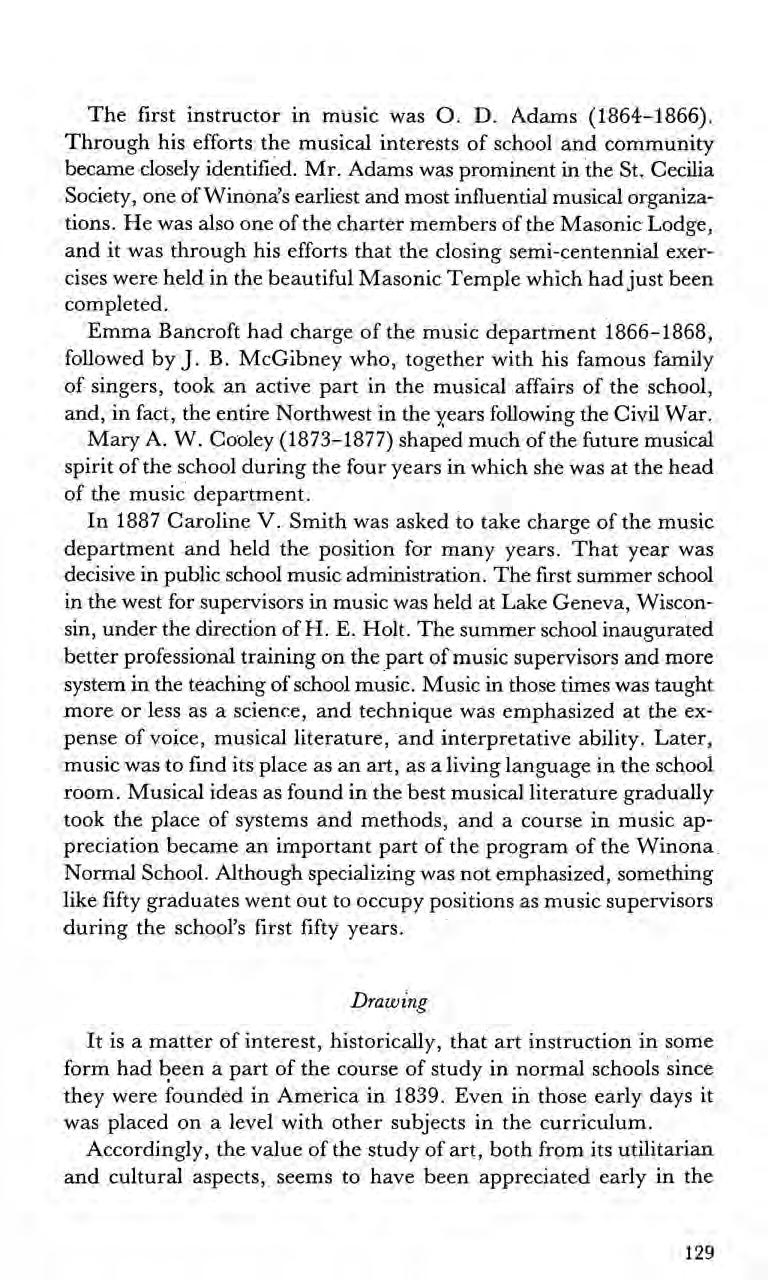
The first instructor in music was O. D. Adams (1864-1866). Through his efforts the musical interests of school and community became closely identified. Mr. Adams was prominent in the St. Cecilia Society, one ofWinona’s earliest and most influential musical organizations. He was also one of the charter members of the Masonic Lodge, and it was through his efforts that the closing semi-centennial exercises were heldin the beautiful Masonic Temple which had just been completed.
Emma Bancroft had charge of the music department 1866-1868, followed by J. B. McGibney who, together with his famous family of singers, took an active part in the musical affairs of the school; and, in fact, the entire Northwest in the years following the Civil War.
Mary A. W. Cooley (1873-1877) shaped much of the future musical spirit of the school during the four years in which she was at the head of the music department.
In 1887 Caroline V. Smith was asked to take charge of the music department and held the position for many years. That year was decisive in public school music administration. The first summer school in the west for supervisors in music was held at Lake Geneva, Wisconsin, under the direction of H. E. Holt. The summer school inaugurated better professional training on the part of music supervisors and more system in the teaching of school music. Music in those times was taught more or less as a science, and technique was emphasized at the expense of voice, musical literature, and interpretative ability. Later, music was to find its place as an art, as a living language in the school room. Musical ideas as found in the best musical literature gradually took the place of systems and methods, and a course in music appreciation became an important part of the program of the Winona. Normal School. Although specializing was not emphasized, something like fifty graduates wentout to occupy positions as music supervisors during the school’s first fifty years.
It is a matter of interest, historically, that art instruction in someform had beena part of the course of study in normal schools since they were founded in America in 1839. Even in those early days it was placed on a level with other subjects in the curriculum. Accordingly, the value of the study of art, both from its utilitarian and cultural aspects, seems to have been appreciated early in the
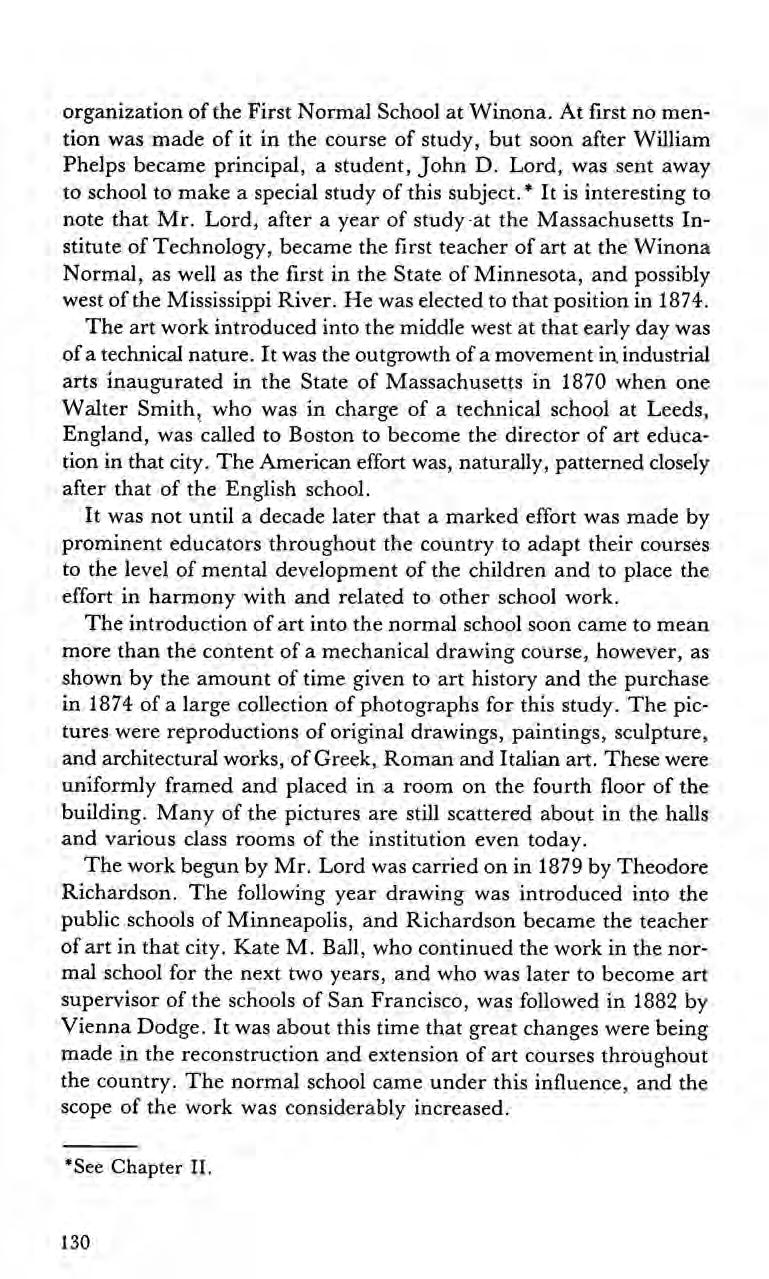
organization of the First Normal School at Winona. At first no mention was made of it in the course of study, but soon after William Phelps became principal, a student, John D. Lord, was sent away to school to make a special study of this subject.* It is interesting to note that Mr. Lord, after a year of study-at the Massachusetts Institute of Technology, became the first teacher of art at the Winona Normal, as well as the first in the State of Minnesota, and possibly west of the Mississippi River. He was elected to that position in 1874.
The art work introduced into the middle west at that early day was of a technical nature. It was the outgrowth of a movement in industrial arts inaugurated in the State of Massachusetts in 1870 when one Walter Smith, who was in charge of a technical school at Leeds, England, was called to Boston to become the director of art education in that city. The American effort was, naturally, patterned closely after that of the English school.
It was not until a decade later that a marked effort was made by prominent educators throughout the country to adapt their courses to the level of mental development of the children and to place the effort in harmony with and related to other school work.
The introduction of art into the normal school soon came to mean more than the content of a mechanical drawing course, however, as shown by the amount of time given to art history and the purchase in 1874 of a large collection of photographs for this study. The pictures were reproductions of original drawings, paintings, sculpture, and architectural works, of Greek, Roman and Italian art. These were uniformly framed and placed in a room on the fourthfloor of the building. Many of the pictures are still scattered about in the halls and various class rooms of the institution even today.
The work begun by Mr. Lord was carried on in 1879 by Theodore Richardson. The following year drawing was introduced into the public schools of Minneapolis, and Richardson became the teacher of art in that city. Kate M. Ball, who continued the work in the normal school for the next two years, and who was later to become art supervisor of the schools of San Francisco, was followed in 1882 by Vienna Dodge. It was aboutthis time that great changes were being made in the reconstruction and extension of art courses throughout the country. The normal school came under this influence, and the scope of the work was considerably increased.
*See Chapter II.
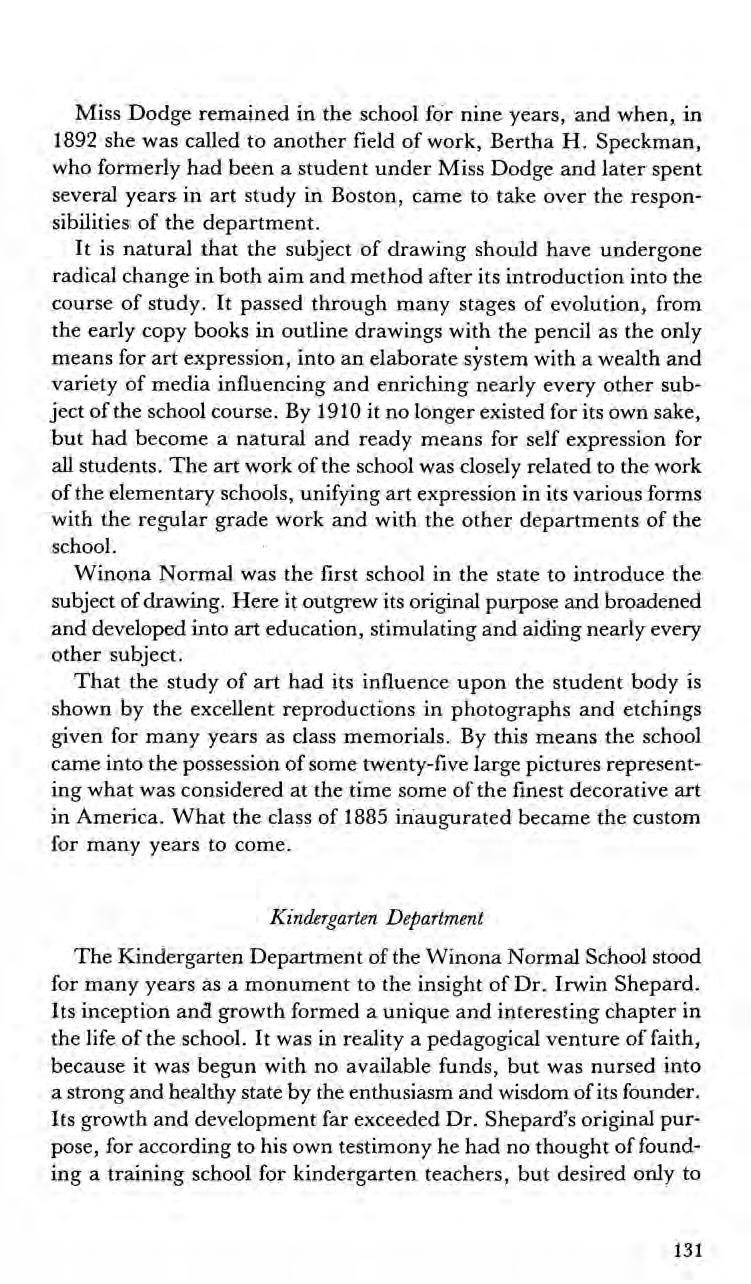
Miss Dodge remained in the school for nine years, and when, in 1892 she was called to another field of work, Bertha H. Speckman, who formerly had been a student underMiss Dodge and later spent several years in art study in Boston, came to take over the responsibilities of the department.
It is natural that the subject of drawing should have undergone radical change in both aim and methodafter its introduction into the course of study. It passed through many stages of evolution, from the early copy books in outline drawings with the pencil as the only means for art expression, into an elaborate system with a wealth and variety of media influencing and enriching nearly every other subject of the school course. By 1910 it no longer existed for its own sake, but had become a natural and ready means for self expression for all students. The art work of the school was closely related to the work of the elementary schools, unifying art expression in its various forms with the regular grade work and with the other departments of the school.
Winona Normal was the first school in the state to introduce the subject of drawing. Here it outgrew its original purpose and broadened and developed into art education, stimulating and aiding nearly every other subject.
That the study of art had its influence upon the student body is shown by the excellent reproductions in photographs and etchings given for many years as class memorials. By this means the school came into the possession of some twenty-five large pictures representing what was considered at the time some of the finest decorative art in America. What the class of 1885 inaugurated became the custom for many years to come.
The Kindergarten Department of the Winona Normal School stood for many years as a monument to the insight of Dr. Irwin Shepard. Its inception and growth formed a unique and interesting chapter in the life of the school. It was in reality a pedagogical venture of faith, because it was begun with no available funds, but was nursed into a strong and healthy state by the enthusiasm and wisdom ofits founder. Its growth and development far exceeded Dr. Shepard’s original purpose, for according to his own testimony he had no thought of founding a training school for kindergarten teachers, but desired only to

establish a kindergarten in the hope that the “kindergarten spirit” would, in time, permeate the whole elementary school. “The beautiful and suggestive truths of Froebel’s philosophy” would be expounded in this kindergarten; and his hope was that not only the student body, but also his teaching force as well would thus be brought to a clearer understanding of child nature and methods of dealing with small
children.
In 1875 Dr. Shepard had the good fortune to hear Dr. William T. Harris speak about the kindergarten movement in St. Louis. The following year at the Centennial Exposition in Philadelphia he witnessed for the first time a kindergarten in operation. If he was impressed by Dr. Harris’ speech, he was even more impressed by his experience with this Exposition Kindergarten. From that point on he made it his business to acquaint himself with Froebelian literature and later visited the Oshkosh Normal School to investigate its welldeveloped kindergarten. As a result of all this, Shepard came home with the conviction that the Winona Normal would not be properly equipped until a kindergarten was established. Despite having no funds available for the purpose, he believed that if he could once establish the idea it would become its own best argument for being, and necessary funds would be forthcoming.
In the fall of 1880, President Shepard secured the services of Sarah C. Eccleston, a graduate of Miss Burrit’s Kindergarten Training School of Philadelphia. The kindergarten was then established as part of the model school of the Normal. A tuition of eighteen dollars per year was charged, which went to meet the expenses of the fledgling program.
At a meeting of the Normal Board the following December, after a thorough discussion of the subject, the Board voted to assume responsibility for the kindergarten and connect it with the model department as a school of observation and practice in which students of the Normal should have the opportunity to acquaint themselves with Froebel’s philosophy.® This was the first kindergarten to be established in connection with the public school system of Minnesota. Besides conducting the kindergarten, Mrs. Eccleston delivered a course oflectures to the graduating class of the Normal in which were set forth the educational principles of Froebel, his methods of childtraining, and some suggestion of the hand-work he devised. These lectures brought about a demand for specific kindergarten training, and in 1882 the Kindergarten Training Department of the Normal

School was given authority to grant diplomas to the graduates. There were two conditions: first, that the standard. for graduation should be equal in value to that required for graduation from other departments; second, that no appropriation from the state should be asked for its support.
In 1883 Mrs. Eccleston resigned and was replaced by Eudora Hailmann, who came from La Porte, Indiana. Mrs. Hailmann brought with her the enthusiasm of a reformer, She hadread Froebel in the original, and was thoroughly saturated with Froebelian philosophy. Her enthusiasm was contagious and her lectures did much to spread the doctrines of Froebel and kindle enthusiasm in the -students. A more definite course of study was now given to the training class, and “Die Mutter und Kose Lieder” was studied from the German text. Much time was given to elaborate Froebelian sewing, weaving, paper-twining and the like by the members of the class. Mrs. Hailmann’s husband, Mr. W. N. Hailmann, who was also a devoted disciple of Froebel, gave the training class lectures in the history of education. Under Mrs. Hailmann the first kindergarten training class was graduated from the Winona Normal School.
In the fall of 1884, Harriet Donovan (later Mrs. H. Choate of Winona), a graduate of the Normal School under Mrs. Hailmann, took charge. Under herleadership special emphasis was placed upon the relation of kindergarten ideas and work in the primary grades.
In June, 1885, the Normal Boardpassed.the following resolutions:
Resolved: That the State Normal Board at Winona be authorized to issue suitable diplomas to graduates from the Kindergarten Training Course as established at that school, provided:
That the training course shall, in its scope and thoroughness, be fully equal to the Kindergarten Training Courses in the eastern schools;
That no pupil be admitted to this course who has not completed the academic work of the elementary course;
That the same authority be granted to normal schools at Mankato and St. Cloud whenever they shall establish similar kindergarten training courses.’

The kindergarten training course was now offered to a limited number of students at $50 per year.
To the pioneer work of these three women supported by the President of the school goes much credit. With finite resources, limited quarters, and inadequate equipment, they enthusiastically gave themselves to the work of establishing the department. The President became the recipient of many letters from superintendents testifying to the value of the new venture.
In the fall of 1889 Kate Ernst of Winona, a graduate of the St. Louis School, became director of the department. Miss Ernst set about organizing the training school on a more systematic basis. The work of the department was reorganized, and a course of study defined and published for the first time in the catalog of 1892.° The curriculum was gradually extended and aspiring kindergarten teachers were required to take certain subjects such as drawing, vocal music, and psychology with beginning teachers of the normal department in addition to the regular kindergarten work taken with the director. During that year, the department having grown to large proportions and the demands both for equipment and salaries having increased, President Shepard gave the following report to the Normal Board:
While we have no desire to claim the entire credit for the recent rapid growth of the kindergarten idea in our state, we are certain that much of it is due to the work at Winona. Ours has been for ten years the leading, and until two years ago, the onrily kindergarten training course in the Northwest. The first kindergarten in Dakota was opened by one of our graduates. The first kindergarten among the Indian children was established at the Santee Agency by another graduate. A kindergarten in. the state school for feeble-minded children at Faribault was organized and has been conducted with success for several years by a graduate from this course. One graduate is in charge of the kindergarten system of the public schools of San Diego, California; another holds a similar place in Colorado Springs. The kindergarten system of the Argentine was organized and is now in charge of our first directress, assisted for several years by one of our graduates. We have sent out twenty-eight graduates from the training course, and five hundred graduates from the normal department who have enjoyed the advantages of observation and a limited course of instruction in kindergarten

methods and philosophy. This has led to the introduction of kindergarten methods and occupations in the primary schools of the state. In view of present and prospective demands for trained kindergarten teachers for the public schools of the state, we beg to submit that the time has come when the state should come to our aid, and grant us a special appropriation of $2,000 annually, with which fully to equip and maintain the department, without the necessity of charging the present prohibitory tuition of $50 per year. The state should not expect the school at Winona to bear this burden unaided longer, carried for twelve years as a labor of love in behalf of the kindergarten cause.?®
The appropriation was granted. For the first time in its history the department was on a secure financial footing.
In 1896a training class of sixteen young ladies was graduated, and a special program was given by the class during commencement week, including essays, kindergarten games, and gesture songs. These special exercises became a regular feature of the commencement program for several years thereafter.
Twice in its early history the department had the experience of moving into new quarters. In 1894 a spacious room in the west wing of the normal building was prepared for the use of the kindergarten, and in the fall of 1909 it was given a fine suite of rooms in the new building, consisting of two connecting kindergarten rooms, supply -closets, wardrobes, and an office for the director.
The story of this department would not be complete if mention were not made of its widespread influence upon the work of the schools of the state. It is not too much to say that the kindergartens which are standard features of most Minnesota schools today, are a direct outgrowth of this program.
The department of physical education was organized in September, 1909. Prior to this, while opportunity for exercise had been offered in connection with the school program, the work had never had departmental status nor been in the hands of a special instructor.
As far back as 1869, President Phelps had reported the introduction of physical culture and noted what he felt was a resultant improvement in the general health of the students. For the next few years
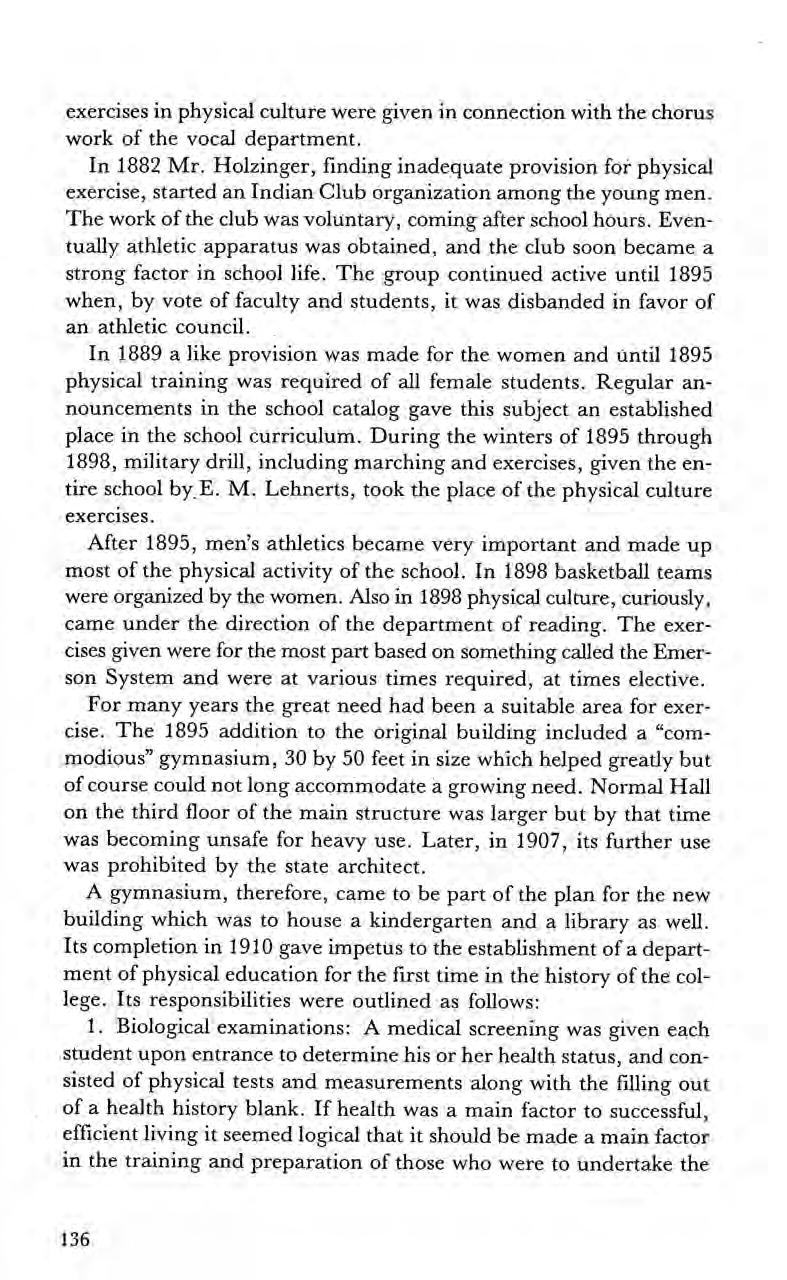
exercises in physical culture were given in connection with the chorus work of the vocal department.
In 1882 Mr. Holzinger, finding inadequate provision for physical exercise, started an Indian Club organization among the young men. The work of the club was voluntary, coming after school hours. Eventually athletic apparatus was obtained, and the club soon became a strong factor in school life. The group continued active until 1895 when, by vote of faculty and students, it was disbanded in favor of an athletic council.
In 1889 a like provision was made for the women and until 1895 physical training was required of all female students. Regular announcements in the school catalog gave this subject an established place in the school curriculum. During the winters of 1895 through 1898, military drill, including marching and exercises, given the entire school by E. M. Lehnerts, took the place of the physical culture exercises.
After 1895, men’s athletics became very important and made up most of the physical activity of the school. In 1898 basketball teams were organized by the women. Also in 1898 physical culture, curiously, came under the direction of the department of reading. The exercises given were for the most part based on something called the Emerson System and were at various times required, at times elective.
For many years the great need had beena suitable area for exercise. The 1895 addition to the original building included a “commodious” gymnasium, 30 by 50 feet in size which helped greatly but of course could not long accommodate a growing need. Normal Hall on the third floor of the main structure was larger but by that time was becoming unsafe for heavy use. Later, in 1907, its further use was prohibited by the state architect.
A gymnasium, therefore, came to be part of the plan for the new building which was to house a kindergarten anda library as well. Its completion in 1910 gave impetus to the establishment of a department of physical education for the first time in the history of the college. Its responsibilities were outlined as follows:
1. Biological examinations: A medical screening was given each ‘student upon entrance to determine his or her health status, and consisted of physical tests and measurements along with the filling out of a health history blank. If health was a main factor to successful, efficient living it seemed logical that it should be made a main factor in the training and preparation of those who were to undertake the
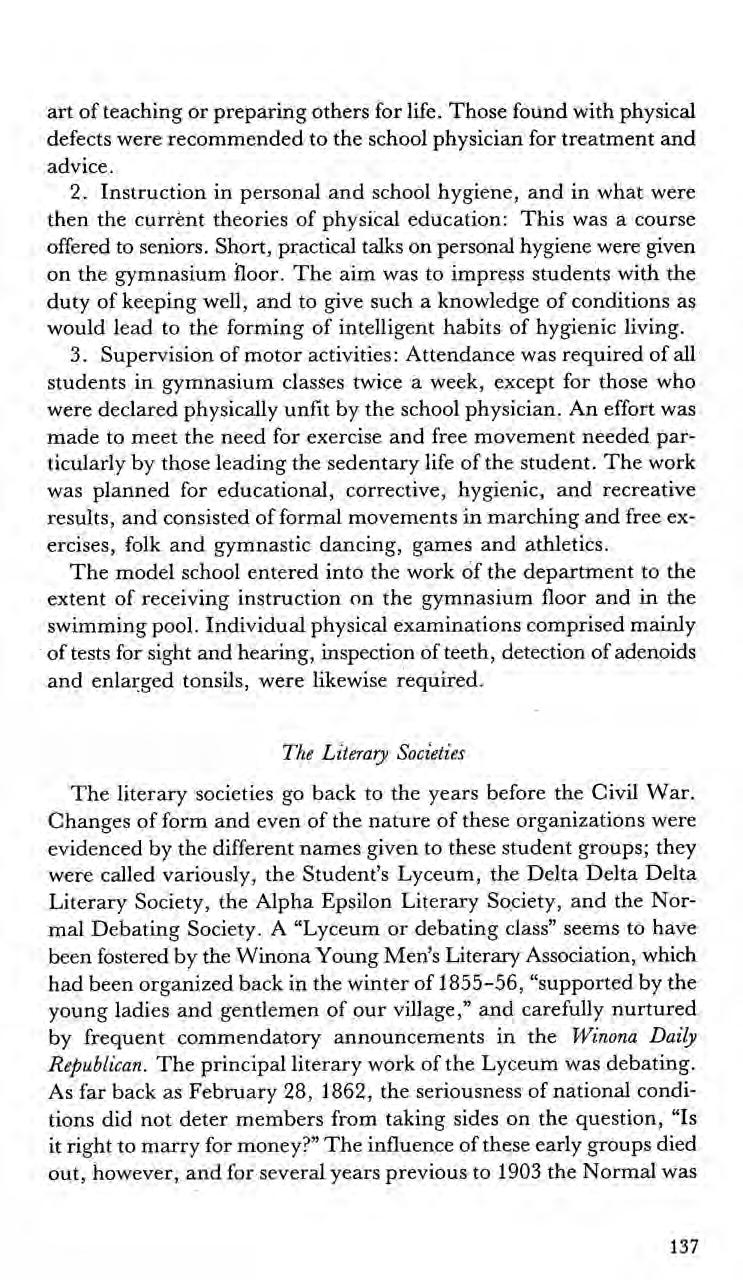
art of teaching or preparing others for life. Those found with physical defects were recommended to the school physician for treatment and advice.
2. Instruction in personal and school hygiene, and in what were then the current theories of physical education: This was a course offered to seniors. Short, practical talks on personal hygiene were given on the gymnasium floor. The aim was to impress students with the duty of keeping well, and to give such a knowledge of conditions as would lead to the forming of intelligent habits of hygienic living.
3. Supervision of motor activities: Attendance was required of all. students in gymnasium classes twice a week, except for those who were declared physically unfit by the school physician. An effort was made to meet the need for exercise and free movement needed particularly by those leading the sedentary life of the student. The work was planned for educational, corrective, hygienic, and recreative results, and consisted of formal movements in marching and free exercises, folk and gymnasticdancing, games and athletics.
The model school entered into the work of the department to the extent of receiving instruction on the gymnasium floor and in the swimming pool. Individual physical examinations comprised mainly of tests for sight and hearing, inspection of teeth, detection of adenoids and enlarged tonsils, were likewise required.
The literary societies go back to the years before the Civil War. Changes of form and even of the nature of these organizations were evidenced by the different names given to these student groups; they were called variously, the Student’s Lyceum, the Delta Delta Delta Literary Society, the Alpha Epsilon Literary Society, and the Normal Debating Society. A “Lyceum or debating class” seems to have been fostered by the Winona Young Men’s Literary Association, which had been organized back in the winter of 1855-56, “supported by the young ladies and gentlemen of our village,” and carefully nurtured by frequent commendatory announcements in the Winona Daily Republican. The principal literary work of the Lyceum was debating. As far back as February 28, 1862, the seriousness of national conditions did not deter members from taking sides on the question, “Is it right to marry for money?” The influence of these early groups died out, however, and for several years previous to 1903 the Normal was

without any literary societies. The consequent lack of training “in initiative and self-direction” among the students became apparent. Although for many years a certain amount of rhetorical work had been required of each student consisting of readings, essays, and orations given before the entire school, and often large numbers of outsiders, it was felt that it lacked the values obtainable from spontaneous participation. Therefore, in the fall of 1903 there was an attempt to combine the rhetorical work and the student organizations. The members of the junior and senior classes were divided by lot into two equal groups and organized into the Delta Delta Delta and the Alpha Epsilon Literary Societies. Membership was compulsory, dues were levied and meetings were to be bi-weekly with two open joint meetings per year. Later, in 1906, because of the time required, a change recommended by the faculty was adopted by the societies, limiting compulsory membership to seniors and the meetings to one in three weeks.
But the societies never really flourished. Representatives of the groups attributed the lack of enthusiasm to the fact that they were assigned to membership without any choice and that both membership and attendance were compulsory.
The plan of 1906 was followed until 1910, when it was reported that the literary societies were defunct! All that remained was the Normal Debating Society which had been organized in 1904 by some of the young men of the school in which membership had always been voluntary and the work self-directed. In spite of the fact that the preparation for such work required much time, plus the added fact that, except for a short period, no credit was given for the work, that society maintained a continuous existence for many years while those which were required soon lost support.
In the fall of 1909 a challenge for a debate was received from the Normal School at Platteville, Wisconsin. The President immediately took the matter up with the students and Mr. Raymond A. Kent, the debate coach. After a short conference the challenge was accepted and the first interstate debate in the history of the institution took place at Winona on March4 on the question: Resolved: “That labor unions as conducted during the past twenty-five years have shown a tendency detrimental to the best interests of the United States.”
The Wisconsin team consisted of Earl Huntington and Frank Livingston of Platteville, Wisconsin, and Theodore Torgerson of-Ontario, Wisconsin. Alice Evans ofAlma, Wisconsin, Eleanor Hitchcock of Sparta, Wisconsin, and Charles Edward Bell of Andrew, Iowa,

made up the Winona team. The result was a victory for Winona! Interest in debating apparently continued, eventually finding an official role in the form of intercollegiate debate which became very popular among the Minnesota and Wisconsin colleges in the nineteen twenties.
The recognition of the value of manual training, so far as the Winona State Normal School is concerned, dates back to the administration of Principal Phelps. In an address before the State Normal Board in 1865, he said:
The lowest claim any intelligent man now prefers in its (education’s) behalf is that its domain extends over the threefold nature of man; over his body, training it by systematic and intelligent observance of those benign laws which secure health, impart strength and prolong life; over his intellect, invigorating the mind, replenishing it with knowledge and cultivating all those tastes which are allied to virtue; and over his moral and religious susceptibilities, dethroning selfishness and enthroning conscience, leading the affections outwardly in the good will towards man and upward in gratitude to God.”!°
The Honorable H. C. Rogers, state superintendent of public instruction, in his annual report for the year 1867also urged consideration of providing instruction in agriculture and the industrial arts as follows:
Intimately connected with the development of our normal school system is the question of industrial education. The students of. the normal school are composed entirely of persons from the industrial classes. They are exclusively the sons and daughters of mechanics, farmers, and others who live by labor. ‘They enter the normal schools that they may acquire a knowledge of the subjects most useful to those whom it will soon be their duty to teach, and also to learn the best methods of imparting that knowledge to others. If the ends of the system of industrial education are ever to be realized, if the masses of people in our country are ever to learn appreciation of natural laws, to the “pursuits and professions of life,” it can only be done. in and through the common school system which stretches its skillful, scholarly and able

teachers we have only to make them proficient in the principles of applied science, as well as proficient in the most effectivemethods of imparting instruction, and then send them forth among the people on their important missions to secure the ends desired. If the practical education of the industrial classes, therefore, be really the end of any proposed scheme, these are certainly the means whereby alone it is possible to realize them. If the few, only, are to be reached, however, then a college, or any other merely isolated institution, will effectually do it. To educate a few is not the policy, it is not the interest of the state or government like ours. It is for the benefit of the many that we should plan and execute."!
In 1862 Congress made a grant of land to the several states, “to promote the liberal and practical education of the industrial class in the sciences related to agriculture and the mechanic arts.”* It wisely left the details of the plans to the better judgment of the legislatures of the respective states “which might claim and take the benefit of the proposed grant.”!? This land grant was accepted by the Legislature January 27, 1863.
The normal schools were about to realize some advantages from this grant when the combined efforts of the University and the Agricultural College at Glencoe succeeded in havinga law passed by the: Legislature on March 6, 1868, limiting the grant to the University of Minnesota, thus leaving the normal schools without such special funding.'%
No further effort to establish any kind of systematic handwork seems to havebeen made by the normal schools until the fall of 1898, when Resident Director Morey appointed a committee of the faculty to consider the whole problem of manual training in its relation to normal school work, and to make recommendations to the faculty. The first manual training teacher at the Winona Normal was Theda Gildemeister, who was asked by President Millspaugh to teach such forms of manual training as sewing, weaving, and basketry, in connection with her other work.
In the kindergarten and primary grades sewing, weaving, paper folding and cutting, clay modeling, cardboard work, basketry, and simple wood work, had always been taught incidentally, but in the
*This was the famous Morrill Act which in effect established the “Land Grant” Colleges.
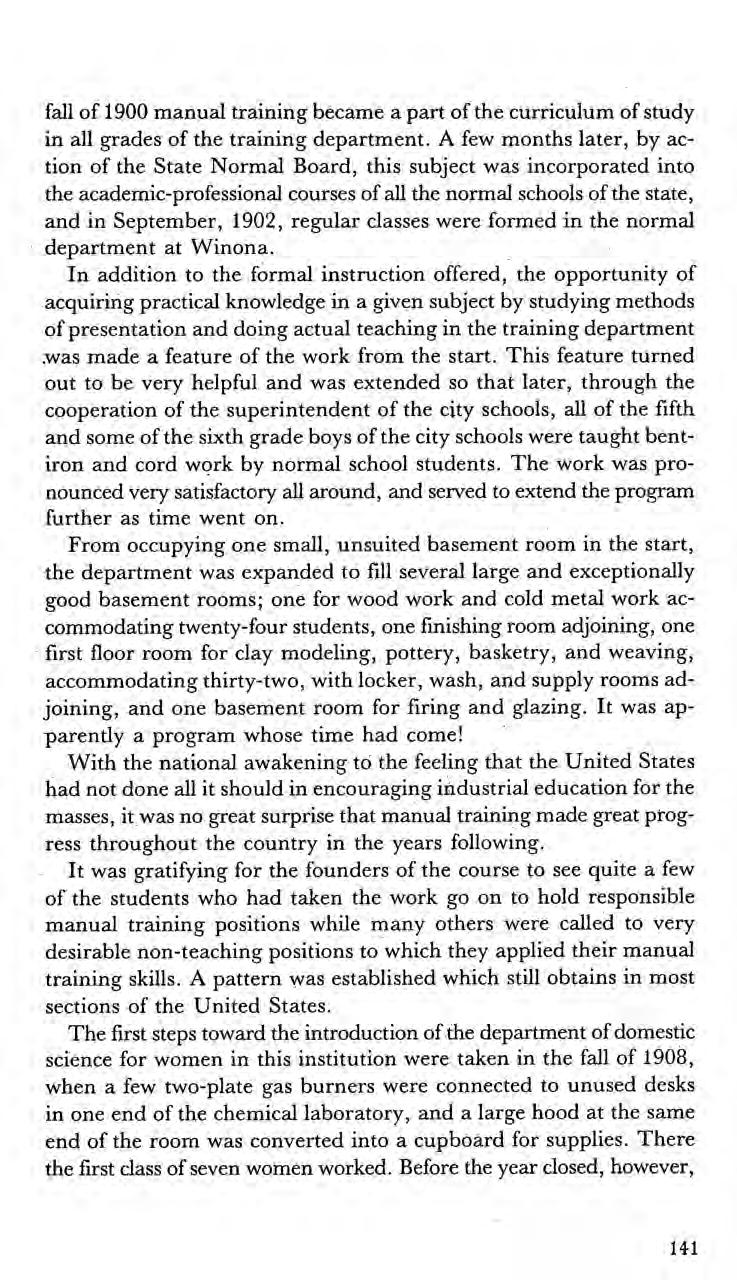
fall of 1900 manual training becamea partofthe curriculum of study in all grades of the training department. A few months later, by action of the State Normal Board, this subject was incorporated into the academic-professional courses of all the normal schools ofthe state, and in September, 1902, regular classes were formed in the normal - department at Winona.
In addition to the formal instruction offered, the opportunity of acquiring practical knowledge in a given subject by studying methods of presentation and doing actual teaching in the training department was madea feature of the workfrom the start. This feature turned out to be very helpful and was extended so that later, through the cooperation of the superintendent of the city schools, all of the fifth and some of the sixth grade boys ofthe city schools were taught bentiron and cord work by normal school students. The work was pronounced very satisfactory all around, and served to extend the program further as time went on.
From occupying one small, unsuited basement room in the start, the department was expanded to fill several large and exceptionally good basement rooms; one for wood work andcold metal work accommodating twenty-four students, one finishing room adjoining, one ‘first floor room for clay modeling, pottery, basketry, and weaving, accommodating thirty-two, with locker, wash, and supply rooms adjoining, and one basement room for firing and glazing. It was apparently a program whose time hadcome!
With the national awakening to the feeling that the United States had not done all it should in encouraging industrial education for the masses, it was no great surprise that manual training made great progress throughout the country in the years following.
It was gratifying for the founders of the course to see quite a few of the students who hadtaken the work go on to hold responsible manual training positions while many others were called to very desirable non-teaching positions to which theyapplied their manual training skills. A pattern was established which still obtains in most sections of the United States.
The first steps toward the introduction ofthe department ofdomestic science for women in this institution were taken in the fall of 1908, when a few two-plate gas burners were connected to unused desks in one end of the chemical laboratory, and a large hood at the same end of the room was converted into a cupboard for supplies. There the first class of seven women worked. Before the year closed, however,

thesection of the building in which the first class found its home was remodeled to provide expanded quarters. A laboratory was developed accommodating a class of eighteen in domestic science, and a spacious, sunny room opening out of it in which the work in domestic art was carried on. During the summer much needed furnishings and equipment were added so that the fifty-three normal students and the fortyfive girls in the elementary school who were by then pursuing work in the department found very pleasant rooms and fairly complete equipment at their service.
The aim in sewing was to give the normal students experience in planning and making articles whichwould be suitable for teaching courses in sewing in the elementary schools. Models of the different stitches were made, patterns drafted, and garments made accordingly. The course was planned so that a student could substitute onehalf term of manual training for the more advanced half of the work in sewing.
The course in cooking included a study of foods, their nutritive value, and the principles involved in cooking. A brief period was devoted to the study of dietetics, with each student planning and serving a meal at the end of the term of daily work in the kitchen. High school records in chemistry and physiology were required of applicants for this course.
In the spring of 1894 a student’s loan fund was established to assist students who, because of lack of funds, were finding it difficult or in many cases even impossible to continue in school.
By the fall of that year, with the addition of a few dollars from other sources, the fund reached the grand sum of $99.28. InJanuary, 1895, the first loan was made.
The administration of this fund was entrusted to a committee composed of the President and two members of the faculty, under the following rules:
1. No loans were to be made except to students who had been in attendance as much as half the time required to complete the course from the time of entering the school.
2. Not more than one hundred and fifty dollars would be loaned to one student.

3. Money loaned to: students would bear no interest until date of leaving school, after which the rate of interest would be 4 percent.
4. Money loaned would be repaid within two years after leaving schoolunless special circumstances such as sickness made it impossible.
5. In special emergencies, such as serious illness, fundscould at the discretion of the committee, be given without prospect of repayment.
6. Money would be paid out of the fund only upon orders signed by two members of the committee.
By the year 1910 the fund had grown to $1,215.33 and had served many deserving students well. Many such monetary aids to students were to be forthcoming in future years.
The Winona Normal Bulletin was founded in 1904 and dedicated to the interests ofelementary education in Minnesota." It had its origin in the desire of the faculty to widen the influence of the school and to do what it could to promulgate sound educational doctrines. Some of the things which theBulletin did in fulfillment of the purpose for which it was founded were, reporting from time to time items of educational interest, especially such as would keep the alumni and friends of the school informed both in regard to the current work of the school and as to what the graduates were doing in their various fields; presenting some of the new statements of the aims and methods of education and of teaching. In doing this it sought to separate what is permanent and worthwhile from what was transient and showy. It published studies made by members of the faculty, which had a close relation to school problems. It printed the course of study for the elementary school, giving the theory of the different schoolsubjects as well as describing the methods of teaching employed in these subjects.
The Bulletin was edited by Mr. E. M. Lehnerts from 1904 to 1906, by Dr. G. O. Virtue from 1906 to 1909, and later by Mr. J. S. Gaylord.
It was a matter of interest and pride to the Normal School at Winona that fifteen of the sixty-one North American teachers who went to
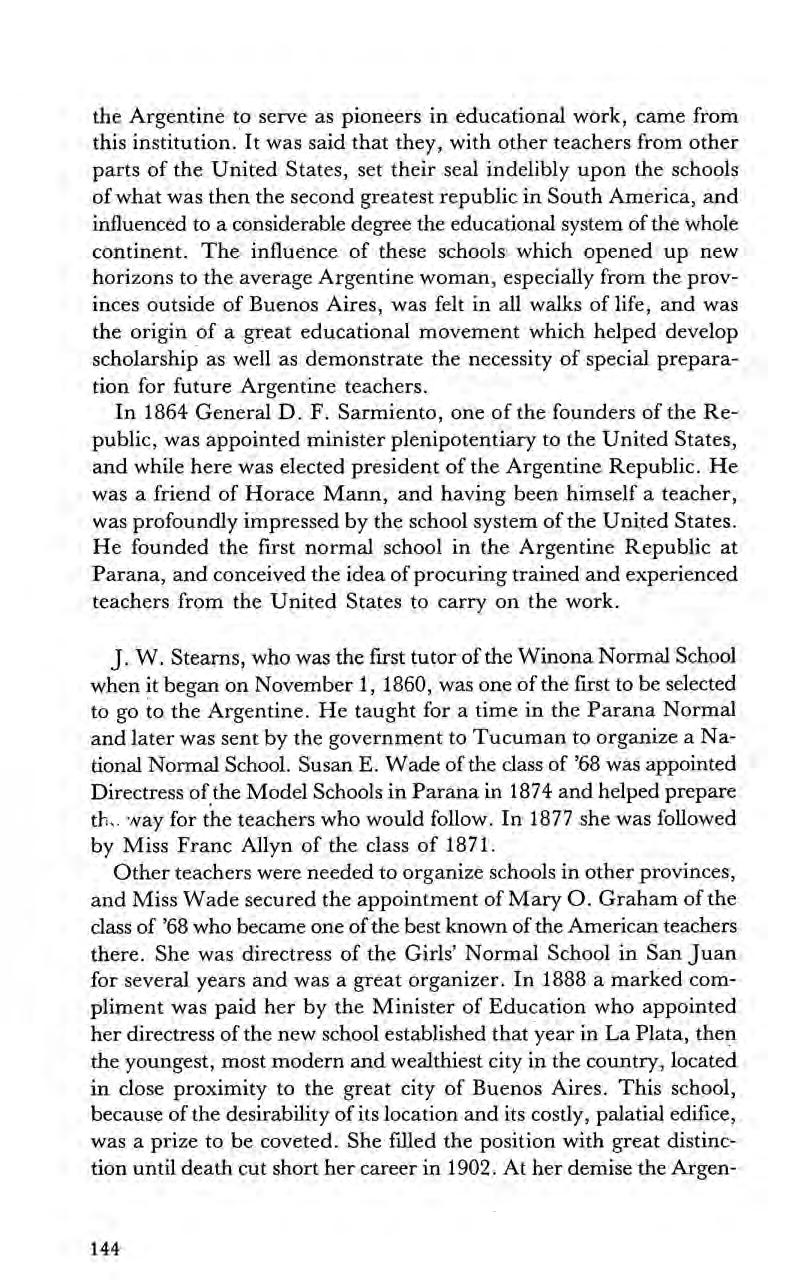
the Argentine to serve as pioneers in educational work, came from this institution. It was said that they, with other teachers from other parts of the United States, set their seal indelibly upon the schools of what was then the second greatest republic in South America, and influenced to a considerable degree the educational system of the whole continent. The influence of these schools which opened up new horizons to the average Argentine woman, especially from the provinces outside of Buenos Aires, was felt in all walks of life, and was the origin of a great educational movement which helped develop scholarship as well as demonstrate the necessity of special preparation for future Argentine teachers.
In 1864 General D. F. Sarmiento, one of the founders of the Republic, was appointed minister plenipotentiary to the United States, and while here was elected president of the Argentine Republic. He was a friend of Horace Mann, and having been himself a teacher, was profoundly impressed by the school system of the United States. He founded the first normal school in the Argentine Republic at Parana, and conceived the idea of procuring trained and experienced teachers from the United States to carry on the work.
J. W. Stearns, who was the first tutor of the Winona Normal School when it began on November 1, 1860, was one of the first to be selected to go to the Argentine. He taught for a time in the Parana Normal and later was sent by the government to Tucuman to organize a National Normal School. Susan E. Wade of the class of ’68 was appointed Directress ofthe Model Schools in Parana in 1874 and helped prepare th. way for the teachers who would follow. In 1877 she was followed by Miss Franc Allyn of the class of 1871.
Other teachers were needed to organize schools in other provinces, and Miss Wade secured the appointment of Mary O. Graham of the class of 68 who became one ofthe best known of the American teachers there. She was directress of the Girls’ Normal School in San Juan for several years and was a great organizer. In 1888 a marked compliment was paid her by the Minister of Education who appointed her directress of the new school established that year in La Plata, then the youngest, most modern and wealthiest city in the country, located in close proximity to the great city of Buenos Aires. This school, because of the desirability of its location and its costly, palatial edifice, was a prize to be coveted. She filled the position with great distinction until death cut short her career in 1902. At her demise the Argen-
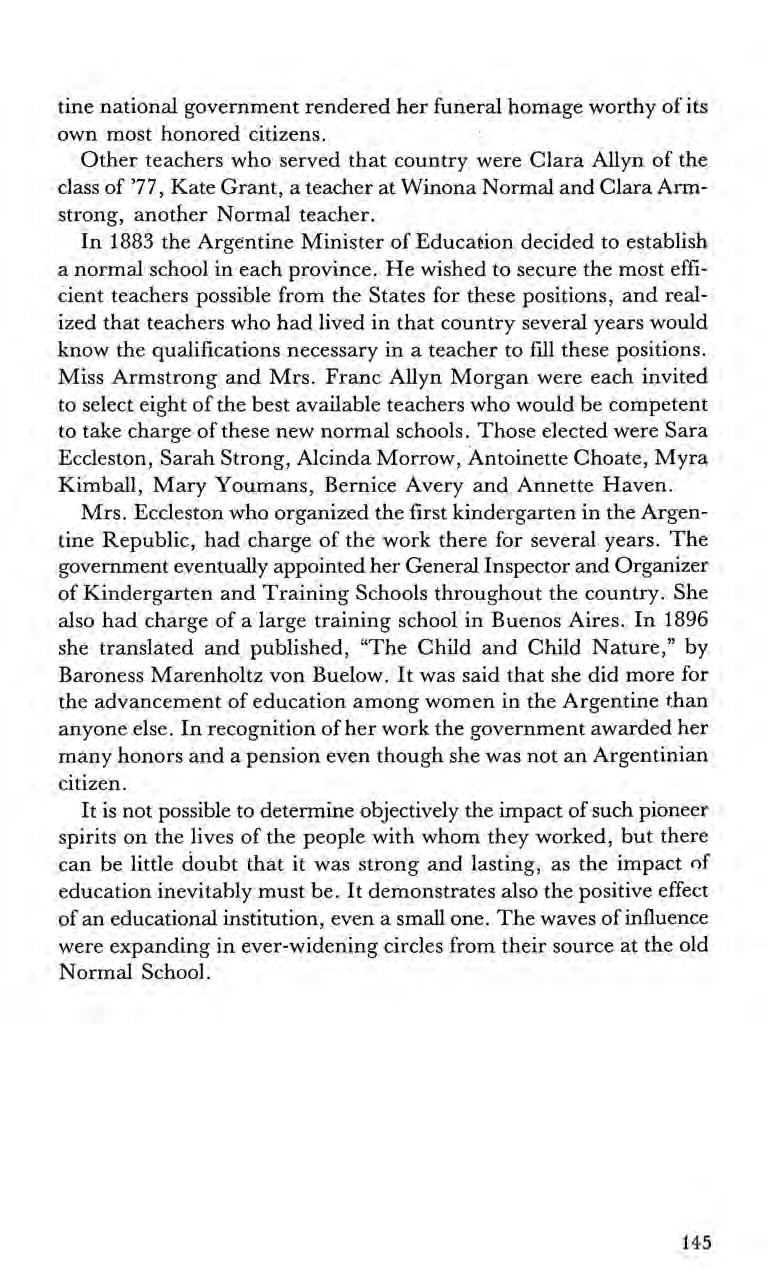
tinenational government rendered her funeral homage worthy of its own most honored citizens.
Other teachers who served that country were Clara Allyn of the class of ’77, Kate Grant, a teacher at Winona Normal and Clara Armstrong, another Normal teacher.
In 1883 the Argentine Minister of Education decided to establish a normal school in each province. He wished to secure the most efficient teachers possible from the States for these positions, and realized that teachers who had lived in that country several years would know the qualifications necessary in a teacher to fill these positions. Miss Armstrong and Mrs. Franc Allyn Morgan were each invited to select eight of the best available teachers who would be competent to take charge of these new normal schools. Those elected were Sara Eccleston, Sarah Strong, Alcinda Morrow, Antoinette Choate, Myra Kimball, Mary Youmans, Bernice Avery and Annette Haven.
Mrs. Eccleston who organized the first kindergarten in the Argentine Republic, had charge of the work there for several. years. The government eventually appointed her General Inspector and Organizer of Kindergarten and Training Schools throughout the country. She also had charge of a large training school in Buenos Aires. In 1896 she translated and published, “The Child and Child Nature,” by Baroness Marenholtz von Buelow. It was said that she did more for the advancement of education among women in the Argentine than anyone else. In recognition ofher work the government awarded her many honors and a pension even though she was not an Argentinian citizen.
It is not possible to determine objectively the impact of such pioneer spirits on the lives of the people with whom they worked, but there can be little doubt that it was strong and lasting, as the impact of education inevitably must be. It demonstrates also the positive effect of an educational institution, even a small one. The waves of influence were expanding in ever-widening circles from their source at the old Normal School.
OP ON & President’s Report to the Normal Board, October, 1888.
General Laws ofMinnesota, Ch. 164, 1877. Wiliam F. Phelps, Correspondence, 1877.
Winona Society ofArts, Sciences and Letters, Minutes, June 12, 1871.
Annual Report of Superintendent of Public Instruction, No. 19, August 31, 1878.
6. 7. 8. 9. 10. 11. 12.

Minnesota State Normal Board, Minutes, December 7, 1880.
Minnesota State Normal Board, Minutes, June, 1885.
Winona State Normal School, Catalog, 1892.
President’s Report to the Normal Board, 1892.
Minnesota State Normal Board, Minutes, June 28, 1865.
Annual Report of Superintendent of Public Instruction, 1867. David L. Kiehle, Education in Minnesota, (Minneapolis: H. W. Wilson Company, 1903) pp. 66-67.
13. 14.
General Laws ofMinnesota, March 6, 1868. Winona Normal Bulletin, First Issue, 1904.

V

At the same meeting of the Normal Board which saw the acceptance of the resignation of President Millspaugh, the subject of the election of a new president immediately came up for consideration. There were a dozen or more applicants by this time, from almost as many states. The Winona Daily Republican stated, “There are as yet no certain indications as to the election of any particular person. Prof. Guy E. Maxwell, superintendent of the training department of the Winona Normal School, while not a candidate, has been under serious consideration for promotion to the presidency.”!
The next day Mr. Morey, former Normal president and now president of the Normal Board, addressed the directors at some length. He spoke of the trips he had made and the investigation of applicants for the position of president. He read the list of applicants and said something concerning nearly every candidate.. Finally he stated that he had but one recommendation to make; that he did not desire to press the election of a president upon the Board at that time, but if there was to be an election that night, he wanted it to be that of Guy Maxwell. Morey pointed out the ‘fact that Maxwell stood high in educational circles where he was known, had done excellent workin the Winona School, and was well thought of by the members of the faculty as well as by graduates who had gone out from under hisinstruction. He was of high character, he said, and exhibited excellent scholarly attainments havingjust a short time before been awarded an important fellowship by Columbia University. Morey then expressed to the Board that it was his judgment that Maxwell was a man in whose hands the interests of the State Normal School at Winona would be-safe. After discussing the situation at some length the Board unanimously elected Maxwell president, his duties to begin August 1, 1904.?

GUY E. MAXWELL, President, 1904-1939
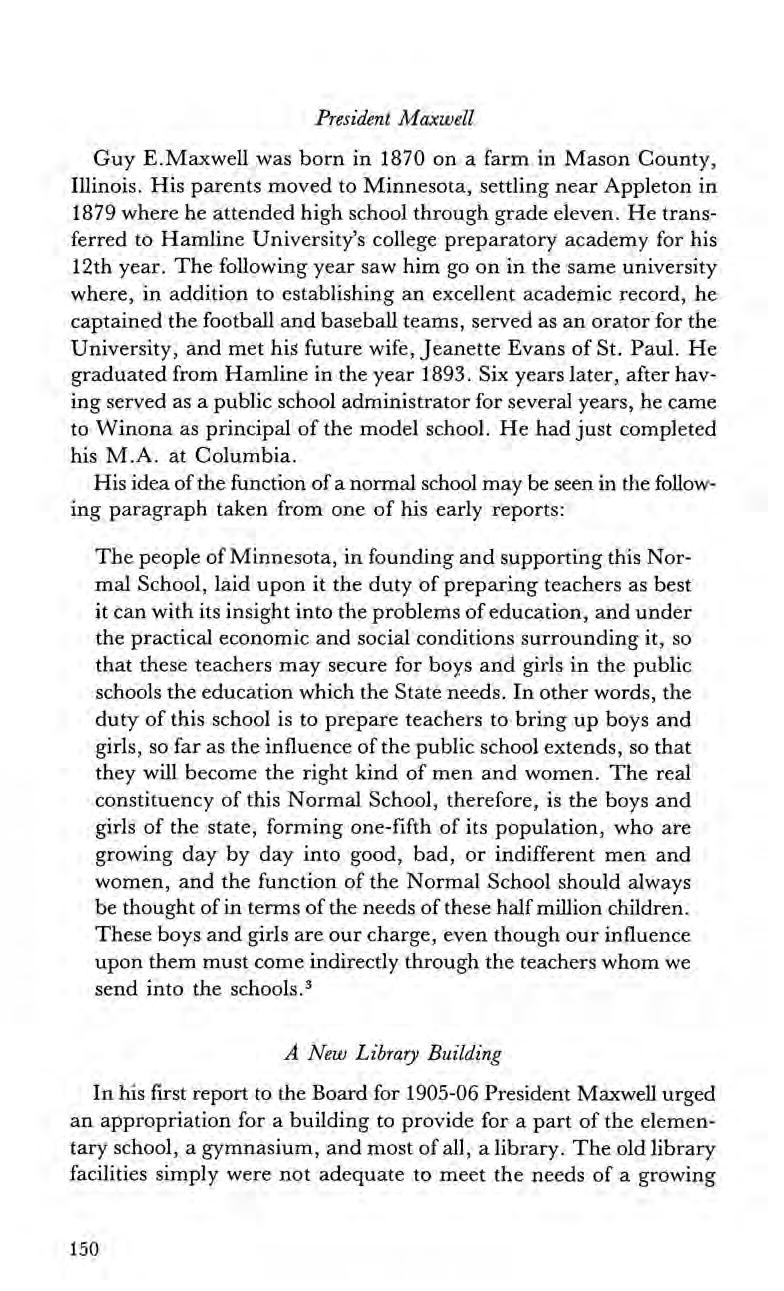
President Maxwell
Guy E.Maxwell was born in 1870 on a farm in Mason County, Illinois. His parents moved to Minnesota, settling near Appleton in 1879 where he attended high school through grade eleven. He transferred to Hamline University’s college preparatory academy for his 12th year. The following year saw him go on in the same university where, in addition to establishing an excellent academic record, he captained the football and baseball teams, served as an orator for the University, and met his future wife, Jeanette Evans of St. Paul. He graduated from Hamline in the year 1893. Six years later, after having served as a public school administrator for several years, he came to Winona as principal of the model school. He had just completed his M.A. at Columbia.
His idea ofthe function of a normal school may be seen in the following paragraph taken from one of his early reports:
The people of Minnesota, in founding and supporting this Normal School, laid upon it the duty of preparing teachers as best it can with its insight into the problems of education, and under the practical economic and social conditions surrounding it, so that these teachers may secure for boys and girls in the public schools the education which the State needs. In other words, the duty of this school is to prepare teachers to bring up boys and girls, so far as the influence of the public school extends, so that they will become the right kind of men and women. The real constituency of this Normal School, therefore, is the boys and girls of the state, forming one-fifth of its population, who are growing day by day into good, bad, or indifferent men and women, and the function of the Normal School should always be thought of in terms of the needs of these half million children. These boys and girls are our charge, even though our influence upon them must come indirectly through the teachers whom we send into the schools.?
In his first report to the Board for 1905-06 President Maxwell urged an appropriation for a building to provide for a part of the elementary school, a gymnasium, and most of all, a library. The old library facilities simply were not adequate to meet the needs of a growing

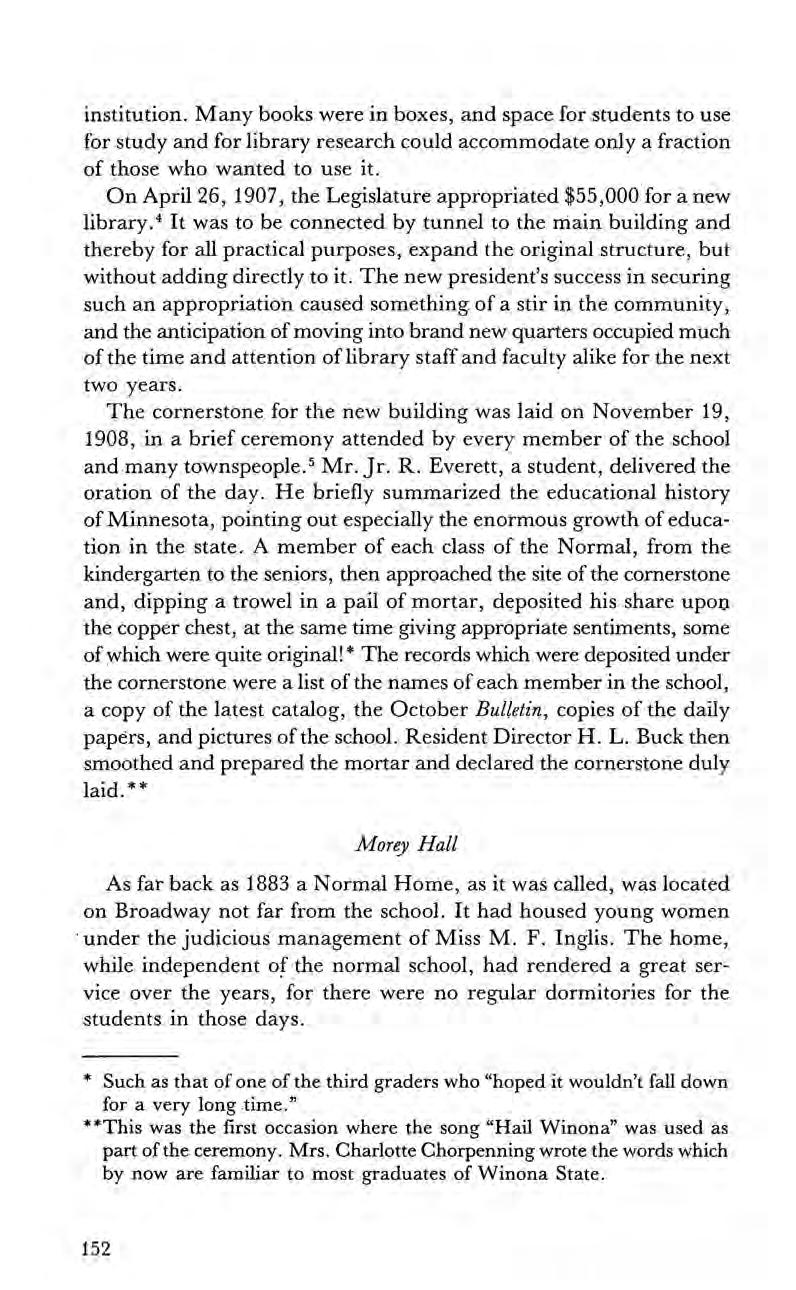
institution. Many books were in boxes, and space for students to use for study and for library research could accommodate only a fraction of those who wanted to use it.
On April 26, 1907, the Legislature appropriated $55,000 for a new library.* It was to be connected by tunnel to the main building and thereby for all practical purposes, expand the original structure, but without adding directly to it. The new president’s success 1n securing such an appropriation caused something ofa stir in the community, and the anticipation of moving into brand new quarters occupied much of the time and attention oflibrary staff and faculty alike for the next two years.
The cornerstone for the new building was laid on November 19, 1908, in a brief ceremony attended by every member of the school and many townspeople.® Mr. Jr. R. Everett, a student, delivered the oration of the day. He briefly summarized the educational history - of Minnesota, pointing out especially the enormous growth of education in the state. A member of each class of the Normal, from the kindergarten to the seniors, then approached the site of the cornerstone and, dipping a trowel in a pail of mortar, deposited his share upon the copper chest, at the same time giving appropriate sentiments, some ofwhich were quite original!* ‘The records which were deposited under the cornerstone were a list of the names of each member in the school, a copy of the latest catalog, the October Bulletin, copies of the daily papers, and pictures of the school. Resident Director H. L. Buck then smoothed and prepared the mortar and declared the cornerstone duly laid.**
As far back as 1883 a Normal Home, as it was called, was located on Broadway not far from the school. It had housed young women ‘under the judicious management of Miss M. F. Inglis. The home, while independent of the normal school, had rendereda great service over the years, for there were no regular dormitories for the students in those days.
Such as that of one of the third graders who “hoped it wouldn’t fall down for a very long time.”
**This was the first occasion where the song “Hail Winona” was used as part of the ceremony. Mrs. Charlotte Chorpenning wrote the words which by now are familiar to most graduates of Winona State.
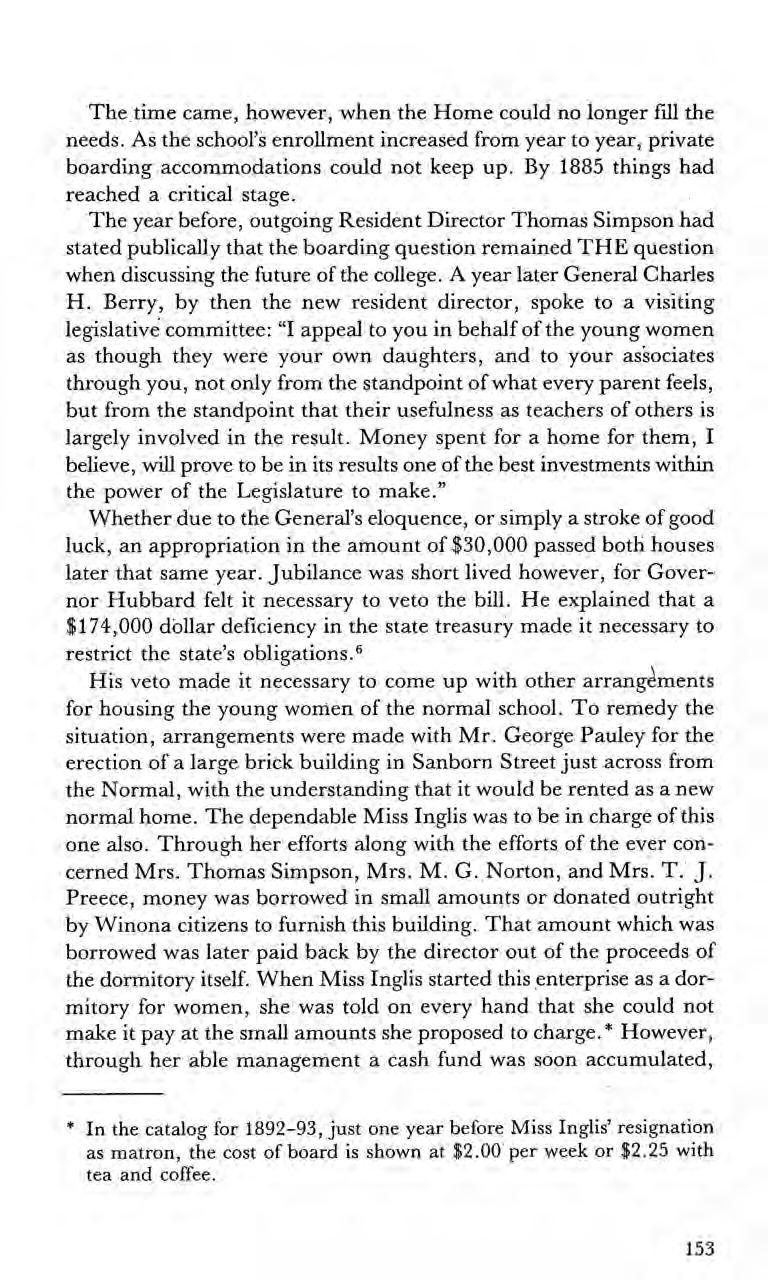
The time came, however, when the Home could no longer fill the needs. As the school’s enrollment increased from year toyear, private boarding accommodations could not keep up. By 1885 things had reacheda critical stage.
The year before, outgoing Resident Director ‘Thomas Simpson had stated publically that the boarding question remained ‘THE question when discussing the future of the college. A year later General Charles H. Berry, by then the new resident director, spoke to a visiting legislative committee: “I appeal to you in behalf of the young women as though they were your own daughters, and to your associates through you, not only from the standpoint ofwhat every parent feels, but from the standpoint that their usefulness as teachers of others is largely involved in the result. Money spent for a home for them, I believe, will prove to be in its results one of the best investments within _the power of the Legislature to make.”
Whether due to the General’s eloquence, or simplya stroke of good luck, an appropriation in the amount of $30,000 passed both houses. later that same year. Jubilance was short lived however, for Governor Hubbard felt it necessary to veto the bill. He explained that a $174,000 dollar deficiency in the state treasury made it necessary to restrict the state’s obligations.®
His veto made it necessary to come up with other arrangements for housing the young wonien of the normal school. To remedy the situation, arrangements were made with Mr. George. Pauley for the erection of a large brick building in Sanborn Street just across from the Normal, with the understanding that it would be rented as a new normal home. The dependable Miss Inglis was to be in charge of this one also. Through her efforts along with the efforts of the ever concerned Mrs. Thomas Simpson, Mrs. M. G. Norton, and Mrs. T. J. Preece, money was borrowed in small amounts or donated outright by Winona citizens to furnish this building. That amount which was borrowed was later paid back by the director out of the proceeds of the dormitory itself. When Miss Inglis started this enterprise as a dormitory for women, she was told on every hand that she could not make it pay at the small amounts she proposed to charge.* However, through her able management a cash fund was soon accumulated,
In the catalog for 1892-93, just one year before Miss Inglis’ resignation as matron, the cost of board is shown at $2.00 per week or $2.25 with tea and coffee.
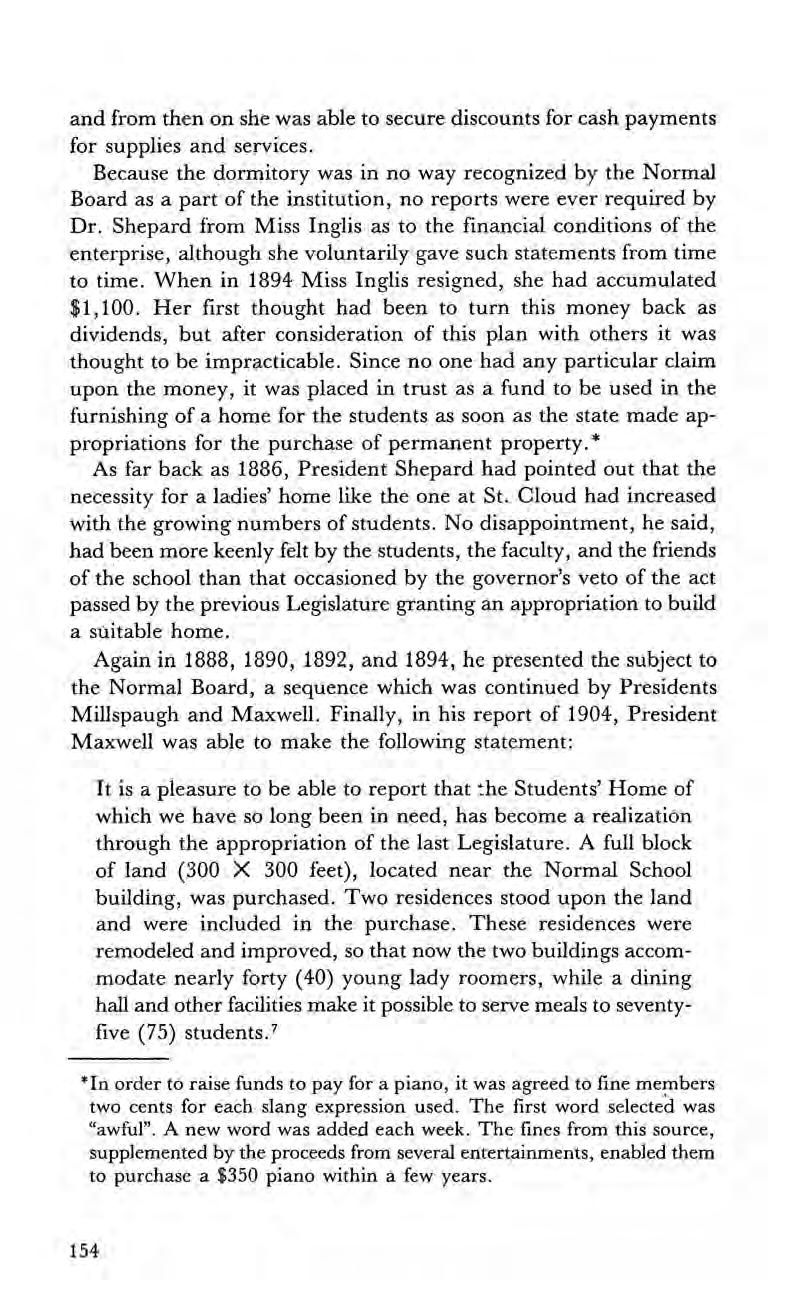
and from then on she was able to secure discounts for cash payments for supplies and services.
Because the dormitory was in no way recognized by the Normal Board as a part of the institution, no reports were ever required by Dr. Shepard from Miss Inglis as to the financial conditions of the enterprise, although she voluntarily gave such statements from time to time. When in 1894 Miss Inglis resigned, she had accumulated $1,100. Her first thought had been to turn this money back as dividends, but after consideration of this plan with others it was thought to be impracticable. Since no one had any particular claim upon the money, it was placed in trust as a fund to be used in the furnishing of a home for the students as soon as the state made appropriations for the purchase of permanent property.*
As far back as 1886, President Shepard had pointed out that the necessity for a ladies’ home like the one at St. Cloud had increased with the growing numbers of students. No disappointment, he said, had been more keenly felt by the students, the faculty, and the friends of the school than that occasioned by the governor’s veto of the act passed by the previous Legislature granting an appropriation to build a suitable home.
Again in 1888, 1890, 1892, and 1894, he presented the subject to the Normal Board, a sequence which was continued by Presidents Millspaugh and Maxwell. Finally, in his report of 1904, President Maxwell was able to make the following statement:
It is a pleasure to be able to report that the Students’ Home of which we have so long been in need, has becomea realization through the appropriation of the last Legislature. A full block of land (300 X 300 feet), located near the Normal School building, was purchased. Two residences stood upon the land and were included in the purchase. These residences were remodeled and improved, so that now the two buildings accommodate nearly forty (40) young lady roomers, while a dining hall and other facilities make it possible to serve meals to seventyfive (75) students.’
*In order to raise funds to pay for a piano, it was agreed to fine members two cents for each slang expression used. The first word selected was “awful”. A new word was added each week. The fines from this source, supplemented by the proceeds from several entertainments, enabled them to purchase a $350 piano within a few years.

The expense. necessary to keep these buildings in proper condition however, proved to be considerable. By 1907 President Maxwell had concluded that it would cost to much to maintain the buildings in good condition, and even then they would not accommodate sufficientnumbers of students to pay for the expense of keeping them warm. He felt that they should be replaced by a modern dormitory which would accommodate at least one hundred young women.
On April 22, 1909, the Legislature appropriated $75,000 for this purpose.® On April 25, 1910, the sod was broken for the new dormitory which would become Morey Hall. The cornerstone was laid during the semi-centennial celebration of that same year. It was named after former President Morey, who had died six years earlier.
In 1904 the Normal-School was still a comparatively small, lowprofile operation. It was housed in one building and had but 23 members on the faculty serving 368 students.Nevertheless the school had come a long way from the time when it offered only one course and took almost anyone as a student who was willing to sign the “pledge”. There were, as we have seen, six courses offered by 1904, three of them for high school graduates! But back in 1878 “Normal” graduates still often completed their high school educations following their graduation from the normal school, so elementary were its offerings at that time.
By 1904 there were five normal schools, Moorhead having been added in 1888, and Duluth in 1902.9 Organizationally the schools were as they are even today, subject to the general control of the state legislature. The particular agency set up for definite legal direction was still the Normal Board, which consisted of one director appointed by the Governor from each of the sixcounties in which the colleges were located, and two others appointed at large.* In addition the State Commissioner of Education, ex officio, served as secretary of the board. The term of each appointee was four years. Regular meetings
*The original normal board had been included as part of the Act which established the normal schools of Minnesota. It was first appointed by the Governor, with the Legislature intending to make future appointments to it. While this was modified later on, the legislature carried on that function for some time, finally giving it over to the Governor’s office altogether.

of the board were held quarterly, on the second Tuesday of September, December, and March, with the annual meeting held on the first ‘Tuesdayin June.!°
By the time Guy Maxwell assumed office the Normal was being operated on the four-quarter basis, there being a fall, a winter, a spring, and a summer quarter, of twelve weeks each. The summer quarter, established by a special act of the legislature, was organized -in the summer of 1908. The legislature stipulated that this summer work should “be a part of and in all respects be the same as the sessions now provided by law.” ‘This four-quarter arrangement continued until 1912, after which time the summer session went to six weeks only.
The school was almost entirely a campus institution. Although correspondence courses were offered at one time and extension courses were announced regularly in the catalog, the response was negligible. Part of the explanation may be that, when offered, a‘course of either of these kinds would ordinarily be attended by full-time teachers, and most teachers in the field wereunwilling to undertake such courses because of the extra demand on their time.
The daily schedule of classes began at eight o’clock and included four 50-minute periods in the forenoon and three. in the afternoon. Almost from its inception, the daily schedule of the Normal began with a chapel exercise from 8:30 to 9:00 preceding the first class period, which was scheduled for 9:10.
all classes met four times each week. Each instructor ordinarily taught four classes or sections, making sixteen hours per week the usual teaching load. On the day whena class did not meet, the teacher was expected to be available for conferences with individual members or with the class as a whole. If he was not there he was told about it!
High school graduation was required for admission after September, 1918. No student who applied for admission was excluded because of low scholastic standing in high school, but thosewhose records placed them in the lowest quarter of their graduating class were advised not to enroll.
The general policy of the Board was to maintain uniformity in such matters as curriculum, standards for admission, andstandards for graduation. Usually whatever any one.of the Minnesota schools was authorized to do the others could do also. This was an obvious accommodation to a certain degree of friendly rivalry among the normal schools, and perhaps to the potential conflict among the various regions served by the colleges.
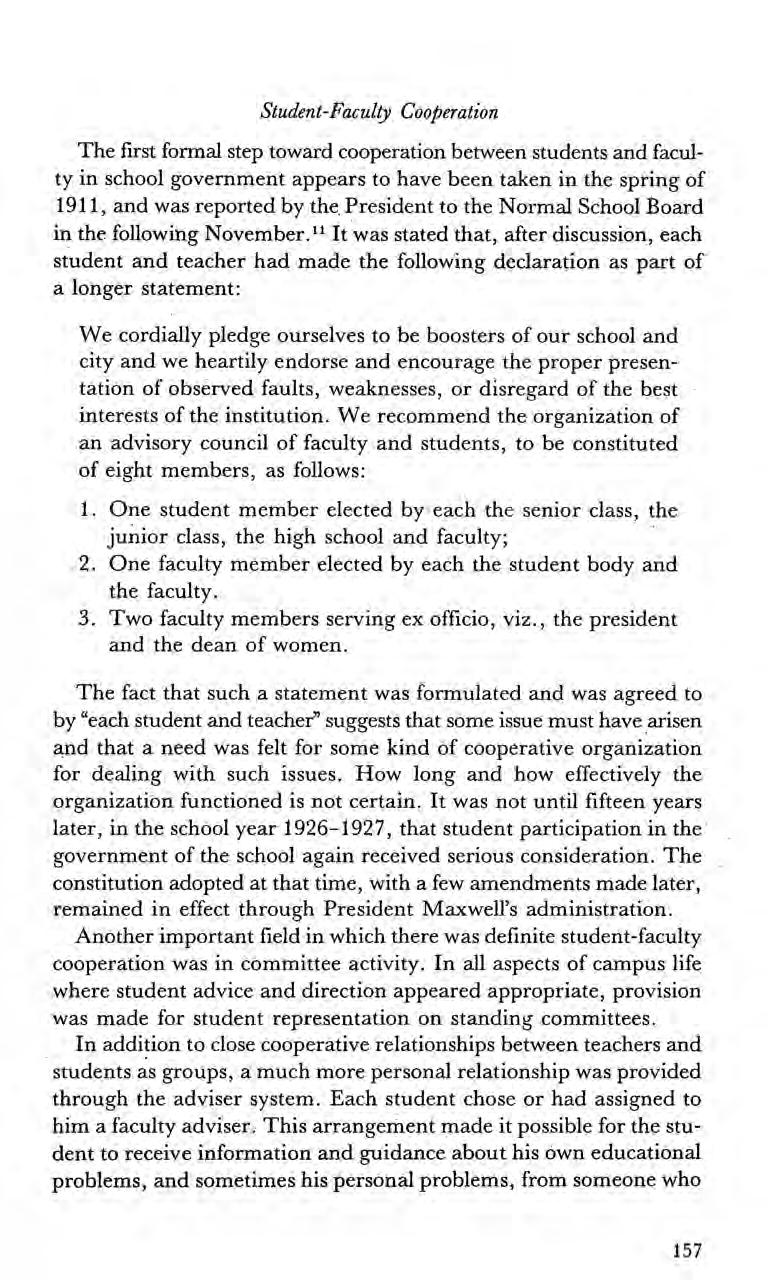
The first formal step toward cooperation between students and faculty in school government appears to have been taken in the spring of 1911, and was reported by the President to the Normal School Board in the following November." Itwas stated that, after discussion, each student and teacher had made the following declaration as part of a longer statement:
We cordially pledge ourselves to be boosters of our school and city and we heartily endorse and encourage the proper presentation of observed faults, weaknesses, or disregard of the best interests of the institution. We recommend the organization of an advisory council of faculty and students, to be constituted of eight members, as follows:
1. One student member elected by each the senior class, the junior class, the high school and faculty;
2. One faculty member elected by each the student body andthe faculty.
3. Two faculty members serving ex officio, viz., the president and the dean of women.
The fact that such a statement was formulated and was agreed to by “each studentand teacher” suggests that some issue must have arisen and that a need was felt for some kind of cooperative organization for dealing with such issues. How long and how effectively the organization functioned is not certain. It was not until fifteen years later, in the school year 1926-1927, that student participation in the’ government of the school again received serious consideration. The constitution adopted at that time, with a few amendments made later, remained in effect through President Maxwell’s administration.
Another important field in which there was definite student-faculty cooperation was in committee activity. In all aspects of campus life where student advice and direction appeared appropriate, provision was made for student representation on standing committees.
In addition to close cooperative relationships between teachers and “students as groups, a much more personal relationship was provided through the adviser system. Each student chose or had assigned to hima faculty adviser. This arrangement made it possible for the student to receive information and guidance about his own educational problems, and sometimes his personal problems, from someone who

was older and certainly more experienced in matters involving the student and the institution. Having one official adviser did not mean that a student could not seek advice from others, nor did the fact that a teacher’s list of “advisees” contained only certain students relieve him of any obligation to be of help to other students. The system did insure that each student knew of a definite, simple procedure by which he could get advice and help if he needed it.
Cooperation of faculty and students was also found in the “term ticket” arrangement administered by the joint committee on finance. At the beginning of each term members of the school purchased a ticket which admitted them to all entertainments, parties, athletic games, and debates, gave them a subscription to The Winonan, the school paper, and entitled them to certain nursing and medical services.
World War I touched the Winona Normal School as it did every other institution in the state, although its effects were not as momentous as they would be some 24 years later when World War IT became a reality.
Nonetheless, there were profound changes in the daily lives ofmany students as fathers or brothers went off to war. The great surge of patriotism which was so mucha part of things during WWI was. enough in itself to charge the atmosphere, and when the nation asked for war service the school responded predictably. The portrait of President Wilson marked the 1917 annual, The Wenonah, and the editorial of that issue began: “As this goes to press, we know that our country has actively engaged in war.” A full page, in red, white and blue, urged young men to enlist, and concluded with the question “Are you patriotic?” Under a wind-swept flag the names of those who had already enlisted were printed: Dr. Oliver M. Dickerson, teacher of history and social science, and eight students: Paul Baumgartner, Henry Muench, Arthur Gallien, Morton Wheeler, Leo Ryan, Walter Nissen, Sidney Page, and Richard Going.'?
A memorial service was held on the campus at the front entrance of the main building on July 4, 1917. Senator George H. Sullivan made the main address on the theme, “Eternal Vigilance is the Price of Liberty.”
On February 22, 1918, at chapel exercises, President Maxwell dedicated a service flag bearing forty-eight stars made by students
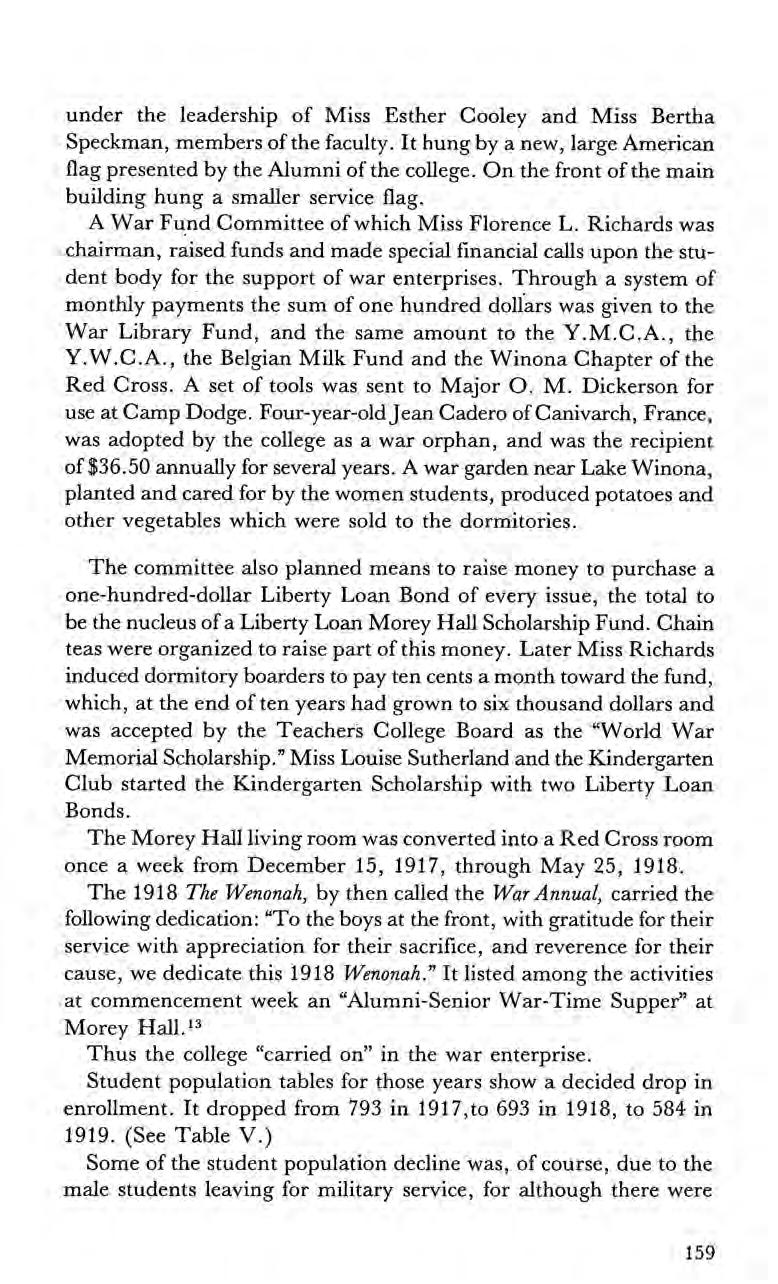
under the leadership of Miss Esther Cooley and Miss Bertha Speckman, members of the faculty. It hung by a new, large American flag presented by the Alumni of the college. On the front of the main building hung a smaller service flag.
A War Fund Committee of which Miss Florence L. Richards was chairman, raised funds and made special financial calls upon the student body for the support of war enterprises. Through a system of monthly payments the sum of one hundred dollars was given to the War Library Fund, and the same amount to the Y.M.C.A., the Y.W.C.A., the Belgian Milk Fund and the Winona Chapter of the Red Cross. A set of tools was sent to Major O. M. Dickerson for use at Camp Dodge. Four-year-oldJean Cadero of Canivarch, France, was adopted by the college as a war orphan, and was the recipient of $36.50 annually for several years. A war garden near Lake Winona, planted and cared for by the women students, produced potatoes and other vegetables which were sold to the dormitories.
The committee also planned means to raise money to purchase a one-hundred-dollar Liberty Loan Bond of every issue, the total to be the nucleus of a Liberty Loan Morey Hall Scholarship Fund. Chain teas were organized to raise part of this money. Later Miss Richards induced dormitory boarders to pay ten cents a month toward the fund, which, at the end of ten years had grown to six thousand dollars and was accepted by the Teachers College Board as the “World War Memorial Scholarship.” Miss Louise Sutherland and the Kindergarten Club started the Kindergarten Scholarship with two Liberty Loan Bonds.
The Morey Hall living room was converted into a Red Cross room once a week from December 15, 1917, through May 25, 1918.
The 1918 The Wenonah, by then called the War Annual, carried the following dedication: “To the boys at the front, with gratitude for their service with appreciation fortheir sacrifice, and reverence fortheir cause, we dedicate this 1918 Wenonah.” It listed among the activities at commencement week an “Alumni-Senior War-Time Supper” at Morey Hall.13
Thus the college “carried on” in the war enterprise.
Student population tables for those years show a decided drop in enrollment. It dropped from 793 in 1917,to 693 in 1918, to 584 in 1919. (See Table V.)
Some of the student population decline was, of course, due to the male students leaving for military service, for although there were

only about 60 men enrolled during the 1916-1917 school year (about 7.7 percent of the total enrollment, Table VI) more than half of them were gonea year later. But the loss of over 150 women to the war industry and other war related activities constituted an even more significant change in total enrollment. And as always this impacted upon the school’s budget, for the head count, then as now, hada great deal to do with how much the President had to work with.
The faculty, curiously, was not particularly affected, probably because it was predominently female with the minority of males somewhat beyond draft age. A modest downward change from 46 in 1917 to 40 in 1919, however, shows that at least a few were apparently affected by a combination of the war effort and enrollment declines.
But all in all things remained relatively stable as compared to colleges with heavy malestudent populations, and the year 1920 even shows a resurgence of students and the beginnings of an impending change in the number and percentage of men who would enroll in the years immediately ahead. In fact the WWI years can be said to ‘mark the end ofthe old normal school as such, for many ofthe changes which had begun as far back as 1910, some subtle and some not so subtle, seemed suddenly to come into focus after the Armistice. War has a way of disturbing the status quo, of forcing changes in attitudes and ways of doing things, many of which would come about slowly, if at all, during ordinary times. Perhaps that was why the Winona Normal School suddenly grew up, changed its outlook, its curriculum, the make-up of its student body, and even to some extent-its reason for being.
Ruggles, in tracing the developments of the first fifty years of the Normal’s existence, closed that section of his history with these prophetic words:
The Minnesota Normal Schools seem about to give serious consideration to plans for enlarging the scope of their professional training for teachers so that these schools shall become normal colleges, or preferably teachers colleges, a movement which seems now to be the clearest prophecy of what the curriculum shall become in the next fifty years.'*
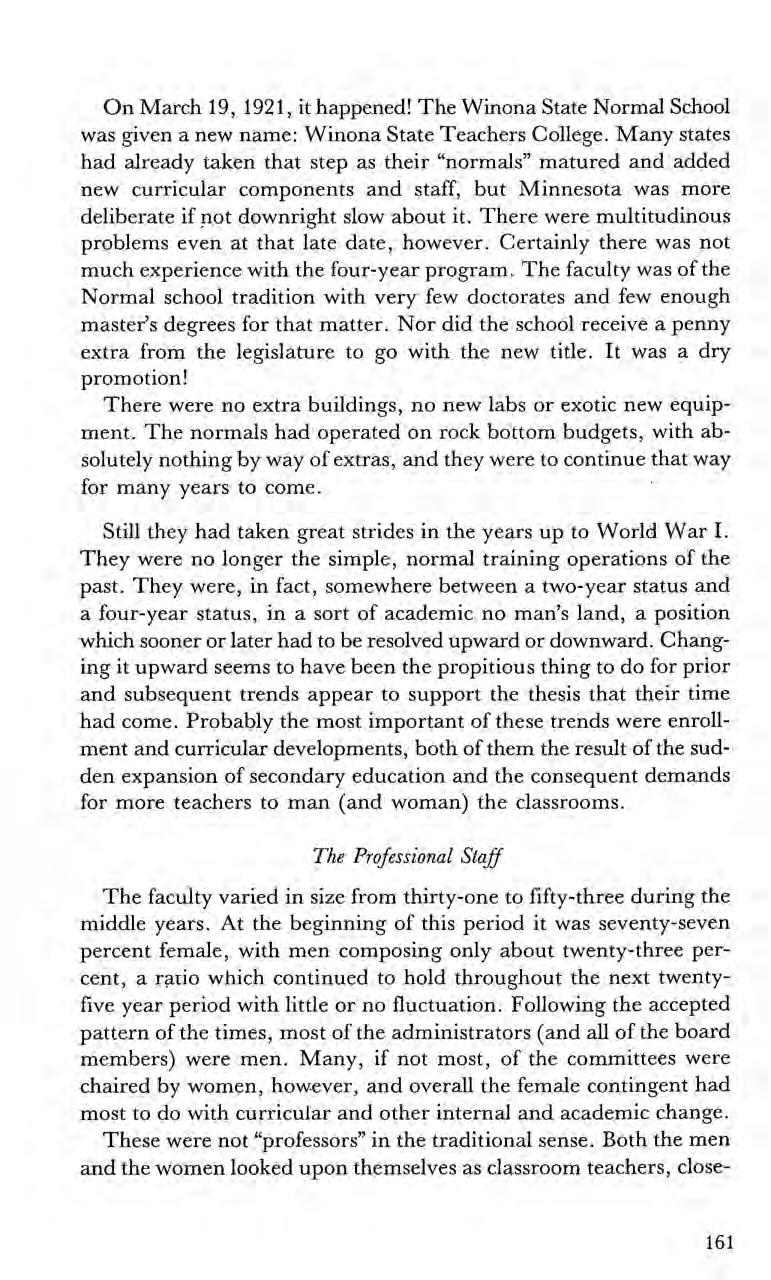
On March 19, 1921, it happened! The Winona State Normal School was given a new name: Winona State Teachers College. Many states had already taken that step as their “normals” matured and added new curricular components and staff, but Minnesota was more deliberate if not downright slow about it. There were multitudinous problems even at that late date, however. Certainly there was not much experience with the four-year program. The faculty was of the Normal school tradition with very few doctorates and few enough master’s degrees for that matter. Nor did the school receive a penny extra from the legislature to go with. the new title. It was a dry promotion!
There were no extra buildings, no new labs or exotic new equipment. The normals had operated on rock bottom budgets, with absolutely nothing by way of extras, and they were to continue that.way for many years to come.
Still they had taken great strides in the years up to World War I. They were no longer the simple, normal training operations of the past. They were, in fact, somewhere between a two-year status and a four-year status, in a sort of academic no man’s land, a position which sooner or later had to be resolved upward or downward. Changing it upward seems to have been the propitious thing to do for prior and subsequent trends appear to support the thesis that their time had come. Probably the most important of these trends were enrollment and curricular developments, both of them the result of the sudden expansion of secondary education and the consequent demands for more teachers to man (and woman) the classrooms.
The faculty varied in size from thirty-one to fifty-three during the middle years. At the beginning of this period it was seventy-seven percent female, with men composing only about twenty-three percent, a ratio which continued to hold throughout the next twentyfive year period with little or no fluctuation. Following the accepted pattern of the times, most of the administrators (and all of the board members) were men. Many, if not most, of the committees were chaired by women, however, and overall the female contingent had most to do with curricular and other internal and academic change. These were not “professors” in the traditional sense. Both the men and the women looked upon themselves as classroom teachers, close-
ly allied with teachers in the field. Most of them had come out of a public school teachingbackground. In fact, from its beginning the Normal had boasted a 100 percent membership in the National Education Association.
In 1910, the faculty roster could show but one doctorate, four master’s degrees, seven bachelor’s degrees and seventeen teachers who did not. hold a degree. For the times this was not a particularly bad showing, but the pattern would need to change if the institution were to becomea full-fledged teachers college. And change it did, steadily if not spectacularly, so that by the end ofthe middle years period there were only eight instructors left who were teaching without any degree, twenty-four who held the bachelor’s, ten with the master’s, and five holding the doctorate.*
Although teachers were hired on a year-to-year basis, an inspection of the record indicates that tenure was relatively long. Fully half of the faculty of 1934-35 had been in their positions for nine years. The longest service of any one member was thirty-five years.

Figures showing the number of students enrolled andthe number graduated each year beginning with 1910 are presented in Table V. The table reveals a remarkable uniformity throughout the period, remarkable especially in light of such factors as official changes in certification requirements, the addition or elimination of a particular field, the erection of a new teachers college nearby ina sister state, social pressures toward longer periods of training, and the economic
*President Maxwell was awarded an honorary Doctor ofPedagogy by Miami University in 1920 and another by Hamline University in 1929.

depressions of the ’20s and ’30s. All of these had effects upon student enrollment. Interestingly, despite the fact that enrollment nearly doubled between 1911 and 1923, the number of faculty members remained practically constant, and continued constant as the enrollment declined from the peak to less than one thousand a few years later.
As would be expected, women constituted a very large proportion of the enrollment. Table VI shows that the percentage of men of the total student enrollment never exceeded twenty percent until 1931.
The school was not entirely complacent about the great disparity in numbers betweenthe sexes. In the president’s report to the Normal School Board on September 17, 1914, reference was made to the fact that there had been an all-school meeting to discuss the question, “How to Interest More Boys.”* Beginning a men’s interscholastic athletic program undera trained coach in 1920-21 was valued partly because of the fact that it was expected to increase the number and the proportion of men students. Also, arguments in support of a junior college curriculum included the point that it would tend to create a better social condition in that it would decrease the disparity between the sexes. Later, in a catalog statement supporting the four-year program, it was asserted that “the higher standards call men to public school service. The lack of men teachers is a grave social weakness. With the longer basic training, men are called to attractive and permanent places in the field of teaching.”!*
The location of the Winona school, almost at the very corner of the state, cut down its natural drawing area very sharply as compared to that of some of the other Minnesota teacher training institutions. The fact that its enrollment maintaineda relatively high level with a minimum use of promotional methods was looked upon as a notable evidence of its high standing. The few bulletins that were distributed and such public announcements as were made were of the informational sort. Well-edited, attractive pamphlets as well as the annual catalog telling of the opportunities for training to be found at Winona were also available to those making inquiry. Members of the professional staff on invitation served as judges in school contests and as speakers at commencements and other events; musical organizations
*Just one graduating class in the early history of the school contained more men than women. This was the class of 1872, of which Charles A. Morey was a member. It included nine women and twelve men.
and other groups presented programs away from the college and went out on occasional short “tours”. Indirectly these activities probably had a favorable effect upon enrollment.

Summer not included. Through 12th Grade. Through 9th Grade.

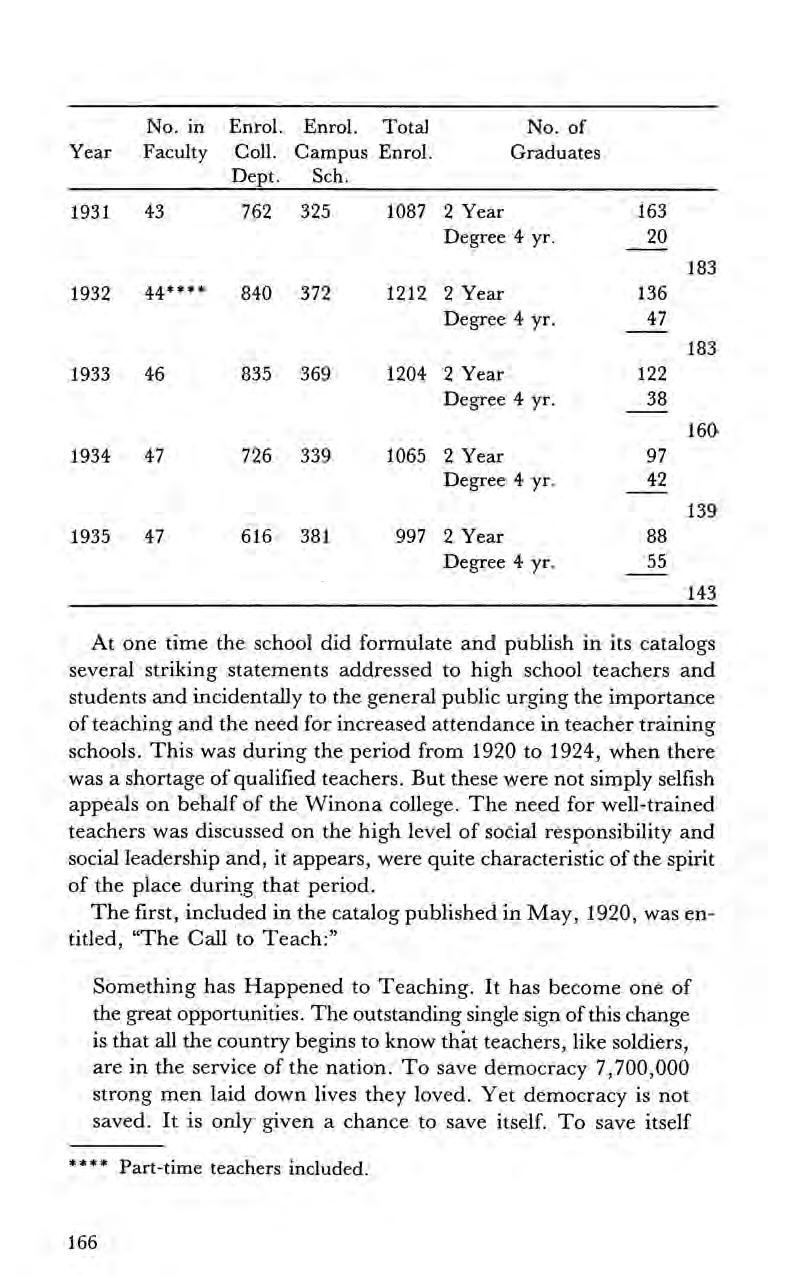
At one time the school did formulate and publish in its catalogs several striking statements addressed to high school teachers and students and incidentally to the general public urging the importance of teaching and the need for increased attendance in teacher training schools. This was during the period from 1920 to 1924, when there was a shortage of qualified teachers. But these were not simply selfish appeals on behalf of the Winona college. The need for well-trained teachers was discussed on the high level of social responsibility and social leadership and, it appears, were quite characteristic of the spirit of the place during that period.
The first, included in the catalog published in May, 1920, was entitled, “The Call to Teach:”
has
to
It has become one of the great opportunities. The outstanding single sign ofthis change is that all the country begins to know that teachers, like soldiers, are in the service of the nation. To save democracy 7,700,000 strong men laid down lives they loved. Yet democracy is not saved. It is only given a chance to save itself. To save itself
**** Part-time teachers included.
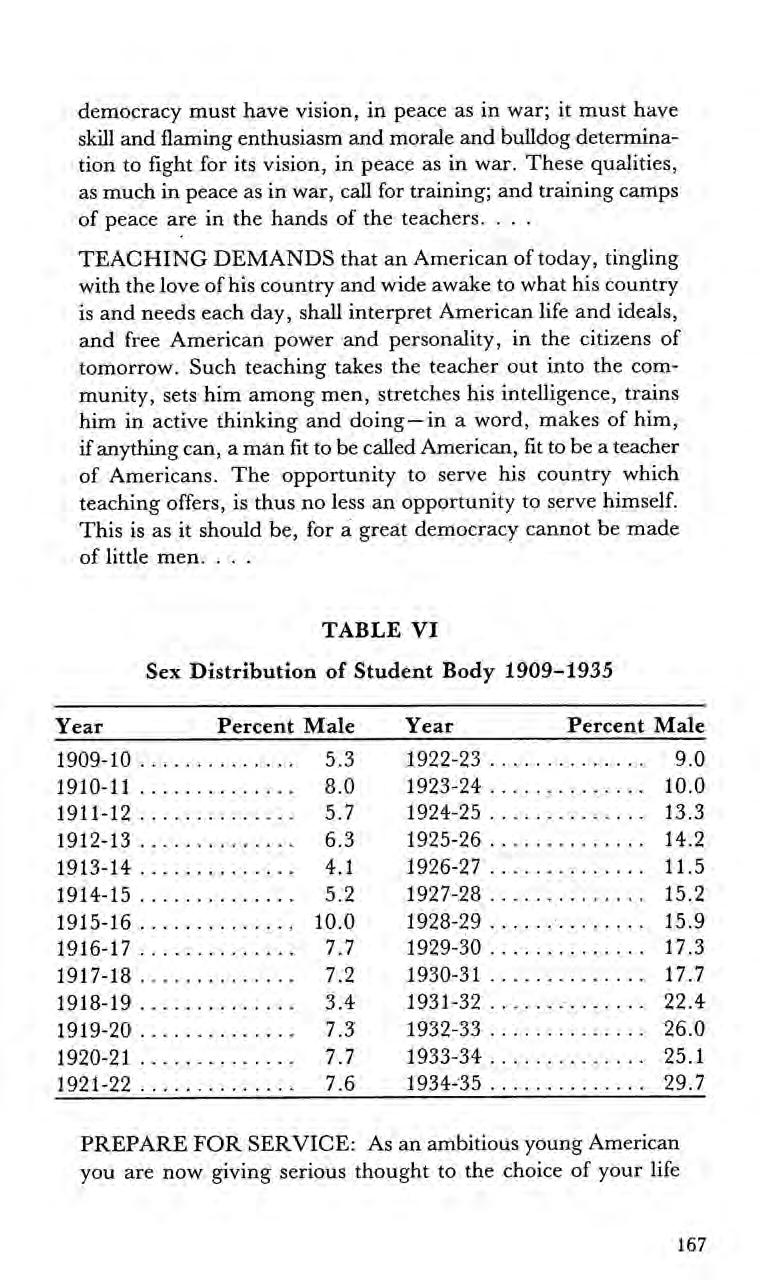
democracy must have vision, in peace as in war; it must have skill and flaming enthusiasm and morale and bulldog determination to fight for its vision, in peace as in war. These qualities, as much in peace as in war, call for training; and training camps of peace are in the hands of the teachers...
TEACHING DEMANDS that an American of today, tingling with the love of his country and wide awake to what his country is and needs each day, shall interpret American life and ideals, and free American power and personality, in the citizens of tomorrow. Such teaching takes the teacher out into the community, sets him among men, stretches his intelligence, trains him in active thinking and doing—in a word, makes of him, ifanything can, a man fit to be called American, fit to be a teacher of Americans. The opportunity to serve his country which teaching offers, is thus no less an opportunity to serve himself. This is as it should be, for a great democracy cannot be made of little men.
work, and to the special training which must follow your choice, inasmuch as there is everywhere now the most pressing demand for thorough preparation. “I will study and get ready and maybe my chance will come,” said Abraham Lincoln as a boy. But his “chance” to serve his country was not a chance after all, just the natural and certain outcome of foresight and study.
SPECIAL TRAINING FOR TEACHING is valuable from more than the professional standpoint. Such training decides for a young person that his life will be broad and serviceable.
MINNESOTA NEEDS 3,500 NEW TEACHERS NOW; she needs trained men and women in other fields; she needs you.'®

FIRST DEGREE CLASS, 1926
Clarence Wedge
Dorothy Rohweder
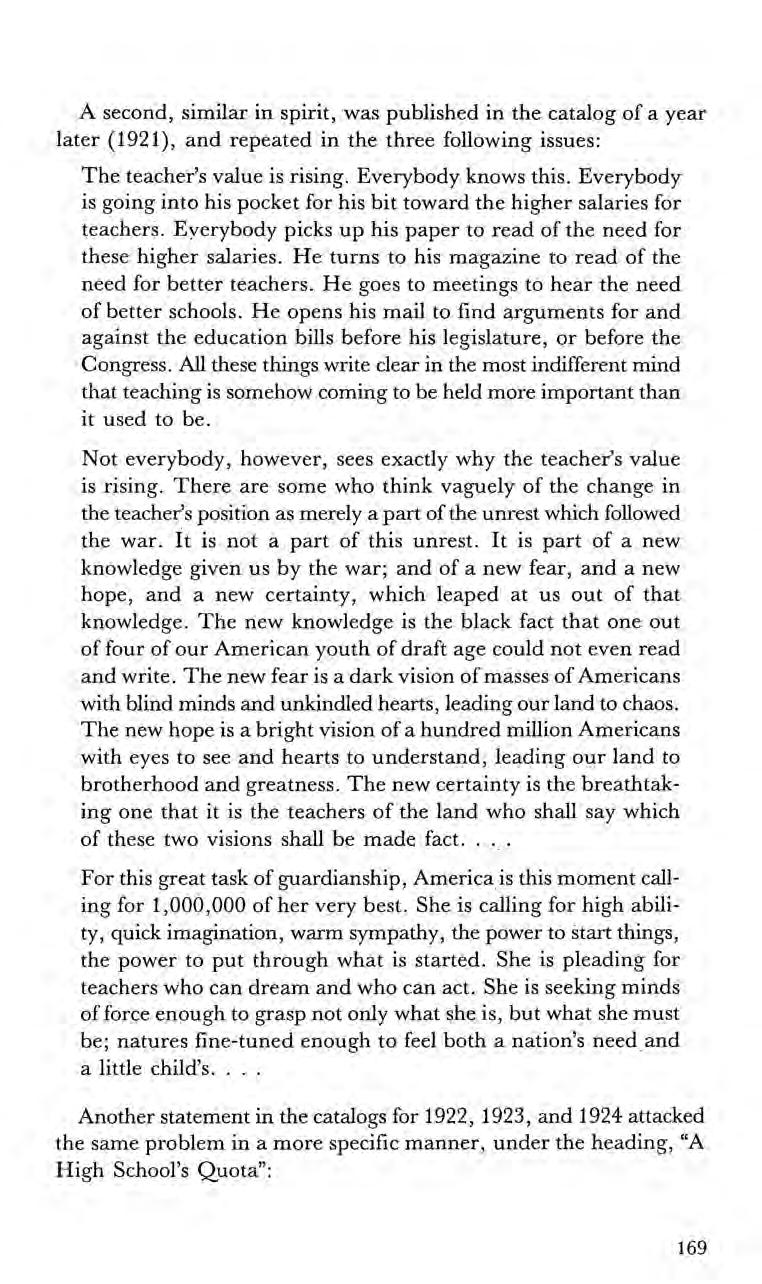
A second, similar in spirit, was published in the catalog of a year later (1921), and repeated in the three following issues:
The teacher’s value is rising. Everybody knowsthis. Everybody is going into his pocket for his bit toward the higher salaries for teachers. Everybody picks up his paper to read of the need for these higher salaries. He turns to his magazine to read of the need for better teachers. He goes to meetings to hear the need of better schools. He opens his mail to find arguments for and against the education bills before his legislature, or before the Congress. All these things write clear in the most indifferent mind that teaching is somehow coming to be held more important than it used to be.
Not everybody, however, sees exactly why the teacher’s value is rising. There are some who think vaguely of the change in the teacher’s position as merely a part ofthe unrest which followed the war. It is not a part of this unrest. It is part of a new knowledgegiven us by the war; and of a new fear, and a new hope, and a new certainty, which leaped at us out of that knowledge. The new knowledge is the black fact that one out of four of our American youth of draft age could not even read and write. The new fear is a dark vision of masses of Americans with blind minds and unkindled hearts, leading our land to chaos. The new hope is a bright vision of a hundred million Americans with eyes to see and hearts to understand, leading our land to brotherhood and greatness. The new certainty is the breathtaking one that it is the teachers of the land who shall say which of these two visions shall be made fact...
For this great task of guardianship, America is this moment calling for 1,000,000 of her very best. She is calling for high ability, quick imagination, warm sympathy, the power to start things, the power to put through what is started. She is pleading for teachers who can dream and who can act. She is seeking minds of force enough to grasp not only what she is, but what she must be; natures fine-tuned enough to feel both a nation’s need and a little child’s.
Another statement in the catalogs for 1922, 1923, and 1924 attacked the same problem in a more specific manner, under the heading, “A High School’s Quota”:
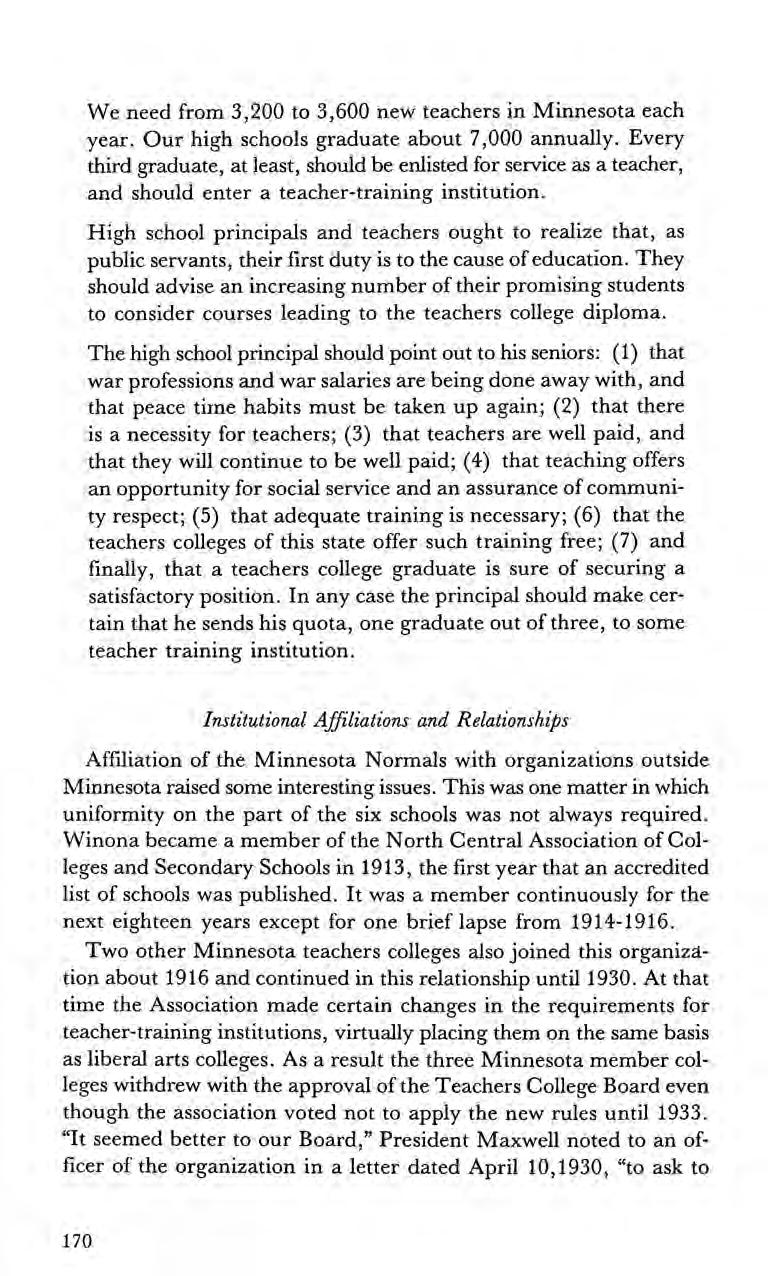
We need from 3,200 to 3,600 new teachers in Minnesota each year. Our high schools graduate about 7,000 annually. Every third graduate, at least, should be enlisted for service as a teacher, and should enter a teacher-training institution.
High school principals and teachers ought to realize that, as public servants, their first duty is to the cause ofeducation. ‘They should advise an increasing number of their promising students to consider courses leading to the teachers college diploma.
The high school principal should point out to his seniors: (1) that war professions and war salaries are being done away with, and that peace time habits must be taken up again; (2) that there is a necessity for teachers; (3) that teachers are well paid, and that they will continue to be well paid; (4) that teaching offers an opportunity for social service and an assurance of community respect; (5) that adequate training is necessary; (6) that the teachers colleges of this state offer such training free; (7) and finally, that a teachers college graduate is sure of securing a satisfactory position. In any case the principal should make certain that he sends his quota, one graduate out of three, to some teacher training institution.
Affiliation of the Minnesota Normals with organizations outside Minnesota raised some interesting issues. This was one matter in which uniformity on the part of the six schools was not always required. Winona became a member of the North Central Association of Colleges and Secondary Schools in 1913, the first year that an accredited list of schools was published. It was a member continuously for the next eighteen years except for one brief lapse from 1914-1916. Two other Minnesota teachers colleges also joined this organization about 1916 and continued in this relationship until 1930. At that time the Association made certain changes in the requirements for teacher-training institutions, virtually placing them on the same basis as liberal arts colleges. As a result the three Minnesota member colleges withdrew with the approval of the Teachers College Board even though the association voted not to apply the new rules until 1933. “It seemed better to our Board,” President Maxwell noted to an officer of the organization in a letter dated April 10,1930, “to ask to

be withdrawn from the teacher-training list of the North Central Association primarily because of local conditions within our legislature. Last winter when we sought a rating in teacher certification equivalent to that of the University and the arts colleges of the state, we made it very clear to the legislature that we were not ambitious to become arts colleges. We believe that to re-enter or even to continue in the N.C.A. might be interpreted at the next session and tend to limit the amount of the appropriations which we shall need to carry out our enlarged program of professional training.”
Mr. J. M. McConnell, State Commissioner of Education and an ex-officio member of the Teachers College Board, protested vigorously against a relationship which would place an outside, private accrediting agency in a position to dictate to a state in the setting up of standards.
From 1930 on, the question of a renewal of the affiliation received occasional attention, but no formal steps were taken either by the colleges or by the Association for a number of years.
Another important and long-continued contact was with the American Association of Teachers Colleges and organizations of its kind preceding it. The first of these had been an association of administrative officers rather than of institutions. It was regional, as shown by its name: The North Central Council of State Normal Presidentsand Principals. In 1923, this group became part of the American Association of Teachers Colleges and gave up its separate identity.
The Winona Normal kept in close contact with these various organizations and kept abreast of their standards. A prominent part was taken in each of them by President Maxwell, who held the office ofpresident in the North Central Council in 1909 and again in 1923. He was acting president in 1924 and president in 1925 of the newly combined group, the American Association of Teachers Colleges. This organization became an acting accrediting agency in the teacher-training field. It regularly accorded a Class A rating to the Winona college.
As far as physical facilities were concerned at the time of the change, they would have to be described as marginal. College Hall was over fifty years old and had withstood many years of external pounding from the harsh Minnesota climate as well as the internal poundings
from the 20,000 or more students who had passed through its doors by 1921. But it was adequate, and was looked upon as suitable for many years to come.
The Library, on the other hand, had fared quite well over the years. By 1905, it contained some 15,000 volumes and government documents, and by 1909, it had moved into its brand new building.
Thirteen years later, on December 3, 1922, it was badly damaged, when College Hall which was adjacent to it caught fire and burned to the ground.

FIRE (December 3, 1922)
If the newly designated teachers college had seemeda bit short on faculty, money, physical facilities and other desirable accoutrements of the academic world, it was now even worse off, without a library or a main classroom building!
The old classroom building built in 1868, was not of fireproof construction, and the fire quickly spread through it once it was under way. It occurred early on a Sunday morning between the fall and winter terms when practically all of the students were at their homes.
The cause of the fire was never determined.The loss to the state was estimated to be about $500,000. In addition there were numerous losses upon which it was impossible to place a value: personal and professional belongings of faculty members; collections of birds, minerals and botanical specimens in the museum; pictures and other memorials left by graduating classes. Fortunately the permanent

records, affecting thousands of students and graduates, were in a fireproof vault and were unharmed.
College activities were under way in an unbelievably short time after the fire. An all-school assembly was heldin the First Congregational Church at 9:00 on Monday, December 4, and the college administrative offices were established in the Main Street Methodist Church. Classes were in session the following‘Tuesday in variousother churches and public buildings, and space for daily assembly as well as for several classrooms was found in the Masonic Temple. The elementary school building was heated for a time by a steam traction engine. Salvaging of wet books in the library proceeded in freezing temperatures.
The Teachers College Board met on Tuesday and voted to include an item for a new building, to cost from $500,000 to $750,000, in the budget to be submitted to the legislature at its session beginning a month later.”
At the general assembly on-Tuesday, December 5, resolutions expressing appreciation ofthe sympathy and support extended by various individuals and organizations were adopted, and renewed loyalty was pledged. Resolutions, prepared by a committee of the faculty, were as follows:
Since the main building of the Winona State Teachers College and the entire contents were destroyed by fire on Sunday morning; and
Since the people of Winona and many others elsewhere have shown their loyalty to the college and to the traditions for which it stands, namely, by offers of help, offers of buildings for use as office, recitation rooms, gymnasiums or auditorium; offers to lend material of many kinds or order it at once; the bravery and skill of the men fighting the fire; the thoughtfulness of women of the neighborhood and the girls of the Hall in bringing food for the men at work; the readiness of the Boy Scouts and their leaders in helping to set things in order so school work might not be delayed; the efforts of the men who worked day and night to clearthe way for reconstruction; the many expressions of sympathy for those who lost valuable personal property; the full and appreciable accounts in the newspaper; the offers of assistance by our sister colleges in different parts of the state, and all others who helped make it possible to resume the college work without delay;

Therefore, be it resolved by the members of this faculty and the student members of the college, that we express to all, both here and in all other parts of the state, our thanks and very deep appreciation; that we resolve to take a new pledge of loyalty to this college and its traditions; and that by earnest work and clear thought we endeavor to do our full part to carry on the spirit of service and the ideals for which the college has stood for so many years.!®
In due time the legislature appropriated $632,000 for a new building and equipment. The cornerstone was laid March 28, 1924, with Chief Justice Samuel B Wilson of the Minnesota Supreme Court delivering an appropriate address. The new building was occupied on September 2, 1924.
In the meantime, however, it was necessary to do something about the library. Some 3,600 volumes were ruined and missing from the collection, and the remaining books, many of them badly injured and water-soaked, had to be repaired and made useable again along with the library catalog and other records. All of this fell to the lot of Mary Grant, the chief librarian of many years standing. By the time she retired in 1924, restoration was wellunder way.
The library gradually recovered, balancing once more its collection, and attaining the standards set by the American Association of Teachers Colleges and the North Central Association. Ten years later it again contained almost 20,000 volumes.
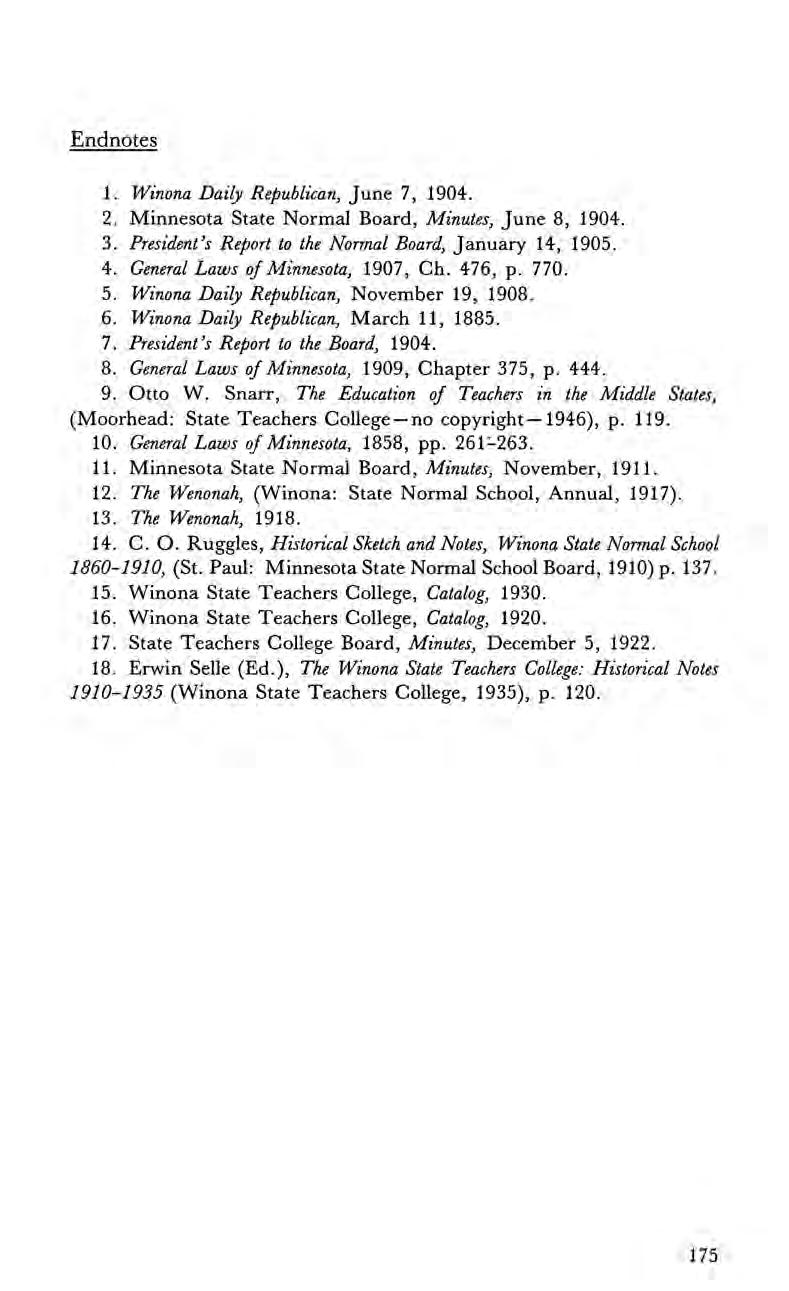
Winona Daily Republican, June 7, 1904.
Minnesota State Normal Board, Minutes, June 8, 1904.
President’s Report to the Normal Board, January 14, 1905.
General Laws ofMinnesota, 1907, Ch. 476, p. 770.
Winona Daily Republican, November 19, 1908.
Winona Daily Republican, March 11, 1885.
President’s Report to the Board, 1904.
General Laws ofMinnesota, 1909, Chapter 375, p. 444. Otto W. Snarr, The Education of Teachers in the. Middle States, (Moorhead: State Teachers College—no copyright 1946), p. 119. 10. 11. 12.
13. 14. General Laws of Minnesota, 1858, pp. 261-263.
Minnesota State Normal Board, Minutes, November, 1911. The Wenonah, (Winona: State Normal School, Annual, 1917). The Wenonah, 1918.
C. O. Ruggles, Historical Sketch and Notes, Winona State Normal School 1860-1910, (St. Paul: Minnesota State Normal School Board, 1910) p. 137.
15.
16.
17. 18. Winona State Teachers College, Catalog, 1930.
Winona State Teachers College, Catalog, 1920.
State Teachers College Board, Minutes, December 5, 1922.
Erwin Selle (Ed.), The Winona State Teachers College: Historical Notes 1910-1935 (Winona State Teachers College, 1935), p. 120.
CHAPTER VI
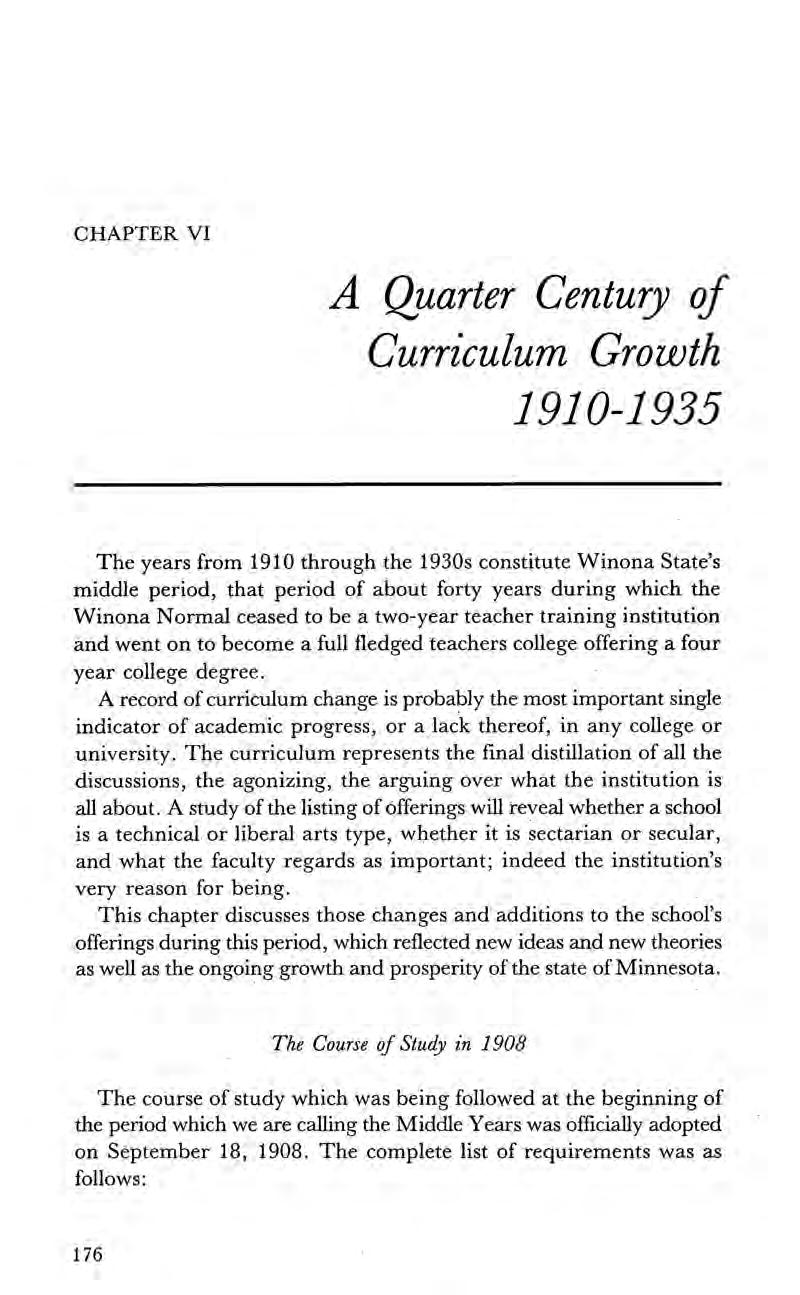
The years from 1910 through the 1930s constitute Winona State’s middle period, that period of about forty years during which the Winona Normal ceased to be a two-year teacher training institution and went on to becomea full fledged teachers college offering a four year college degree.
A record of curriculum change is probably the most important single indicator of academic progress, or a lack thereof, in any college or university. The curriculum represents the final distillation of all the discussions, the agonizing, the arguing over what the institution is all about. A study of the listing of offerings will reveal whether a school is a technical or liberal arts type, whether it is sectarian or secular, and what the faculty regards as important; indeed the institution’s very reason for being.
This chapter discusses those changes and additions to the school’s offerings during this period, which reflected new ideas and new theories as well as the ongoing growth and prosperity of the state of Minnesota.
The course of study which was being followed at the beginning of the period which we are calling the Middle Years was officially adopted on September 18, 1908. The complete list of requirements was as follows:
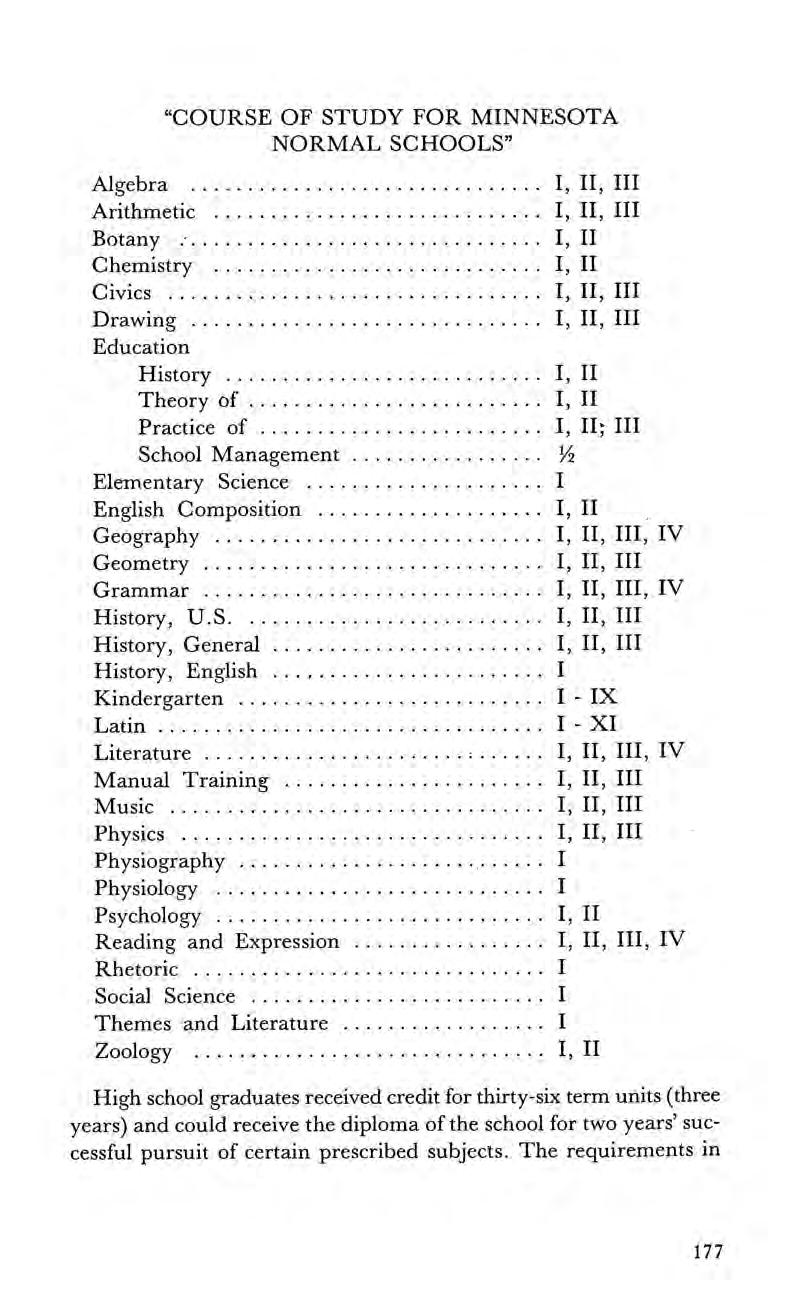
“COURSE
Algebra 2... I, I, Il
Arithmetic 0.0... eee I, Il, Hl
Botany so... eee eee eee I, I
Chemistry eee I, I
CIVICS 2. ee eee nee I, Il, Il
Drawing cee I, ll, ii
Education
History 22... 0. cece eee I, ul
Theory of 0.0.0... eee ee I, Il
Practice Of 2.0... 0... cece I, If; Ul
School Management %
Elementary Science 000000 ee I
English Composition 0065 I, i
Geography 0.0.0 ccc eee I, I, WI, IV
Geometry 0... eee I, W, Ul
Grammar 0.00 I, I, Il, IV
History, U.S. eee I, II, Ill
History, General 0.0.0 e ee I, II, Il
History, English 0.000000 0 I
Kindergarten eee I- IX
Latin 2.0... ec eeeene I - XI
Literature 2.0... ce ee teens I, II, II, IV
‘Manual Training ............0.00 000 eee I, Il, I
Music 2.1... cece enetees I, Wf, Ul
Physics cee eens I, Il, Il
Physiography 00.00 ee, nee I
Physiology 0... eens I
Psychology I, Il
Reading and Expression ...............4. I, II, II, IV
Rhetoric 2... 0... ee I
Social Science 0.00. eeeeee eee I
Themes and Literature I
ZOOLOGY eee eee I,
High school graduates received credit for thirty-six term units (three years) and could receive the diploma of the school for two years’ successful pursuit of certain prescribed subjects. The requirements in

the two-year kindergarten course were somewhat different from those in the regular two-year elementary course.
Broader opportunities for study were provided bya rather liberal offering of electives. “As the facilities of the school permit,” runs the catalog announcement, “one or more of the following electives will be offered and may be chosen by the student, after consultation with the president, in lieu of certain subjects in the course of study: agriculture, two terms; advanced physics, one term; astronomy, one; children’s literature, one; drawing supervision, two; economics, one; English, two; home economics, three; Latin, two; library science, one; manual training, two; modern European history, two; music supervision, two; physical culture, one; primary methods, one; public speaking, one; special methods, one; writirig and spelling, one-half.”!
As early as May, 1911, we find that specialization in the curriculum was being realized. In addition to the special kindergarten course which had been established as early as 1880, special courses in the household arts, manual training and drawing, and elementary supervision, were announced. “A new course will be offered beginning in September,” reads the catalog statement concerning household arts, “for the preparation of special teachers and supervisors of cooking and sewing in the grades and high school. The work will prove especially attractive to graduates of the regular course who have taught temporarily as regular grade teachers and who seek the opportunity to prepare for more responsible positions in the schools. The course will require three years ofwork beyond the high school or one year of work beyond the advanced diploma course. .”
A similar statement as to length of the course and its relation to high school graduation and the advanced diploma as well as the opportunity for entrance into more responsible positions was made regarding a course in manual training and drawing.
The special course for elementary supervision was announced tentatively although it had not yet been formally approved by the Normal School Board. The demand for such a course requiring a third year of preparation was pointed out along with the need for special preparation for positions in elementary education such as general supervision, departmental work in the grades, and teacherships in the normal training departments of high schools. The need for welltrained teachers in the last-named field, high school normal training, was emphasized.
In the catalog for the following year, it was reported that the course
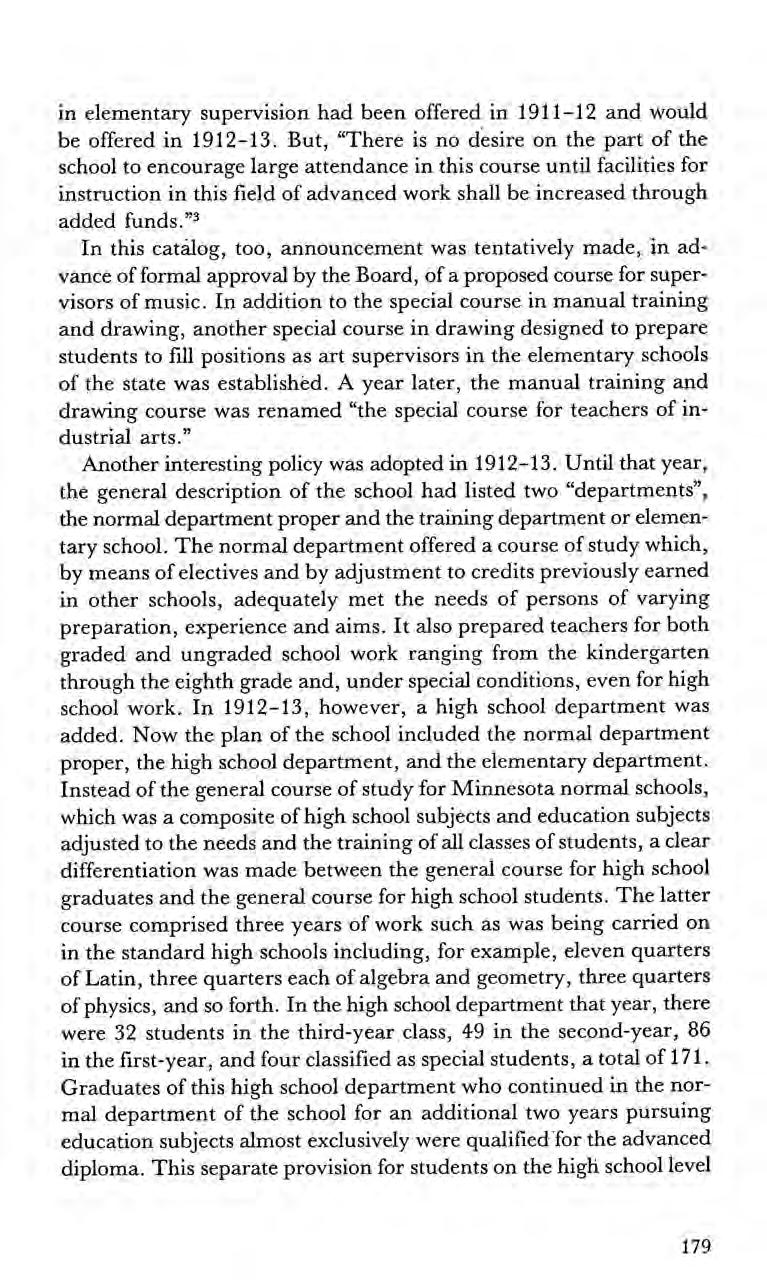
in elementary supervision had been offered in 1911-12 and would be offered in 1912-13. But, “There is no desire on the part of the school to encourage large attendance in this course until facilities for instruction in this field of advanced work shall be increased through added funds.”
In this catalog, too, announcement was tentatively made, in advance of formal approval by the Board, of a proposed course for supervisors of music. In addition to the special course in manual training and drawing, another special course in drawing designed to prepare students to fill positions as art supervisors in the elementary schools of the state was established. A year later, the manual training and drawing course was renamed “the special course for teachers of industrial arts.”
Another interesting policy was adopted in 1912-13. Until that year, the general description of the school had listed two “departments”, the normal department proper and the training department or elementary school. The normal department offered a course of study which, by means of electives and by adjustment to credits previously earned in other schools, adequately met the needs of persons of varying preparation, experience and aims. It also prepared teachers for both graded and ungraded school work ranging from the kindergarten through the eighth grade and, under special conditions, even for high school work. In 1912-13, however, a high school department was added. Now the plan of the school included the normal department proper, the high school department, and the elementary department. Instead of the general course of study for Minnesota normal schools, which was a composite of high school subjects and education subjects adjusted to the needs and the training of all classes of students, a clear differentiation was made between the general course for high school graduates and the general course for high school students. The latter course comprised three years of work such as was being carried on in the standard high schools including, for example, eleven quarters of Latin, three quarters each of algebra and geometry, three quarters of physics, and so forth. In the high school department that year, there were 32 students in the third-year class, 49 in the second-year, 86 in the first-year, and four classified as special students, a total of 171.
Graduates of this high school department who continued in the normal department of the school for an additional two years pursuing education subjects almost exclusively were qualified for the advanced diploma. This separate provision for students on the high school level

was continued on this basis until 1914-15 at whichtime two years of work was offered in the high school or “academic department,” as it came to be called. Finally, in 1918-20 graduation from a high school academy, college or school of equal rank was required for admission to any department of the normal school and there was no need to provide any courses on the high school level.
Our main interest here is in noting the great variety of courses offered at this period which provideda partial or a full program of high school subjects as well as two years of professional training and offerings in several special fields.
In the catalog for 1916-17 the college announced a two-year special curriculum in rural education.* It was designed to meet the needs of rural school teachers, heads of training departments, and supervisors, admission to the work being based upon high school graduation. At this time, too, the special course for elementary supervision became the special curriculum in supervision and departmental teaching. It appears that the need of more than two years of training for the “regular” teacher in the elementary grades was here officially recognized for the first time, for the third year of study was planned to supplement the regular two years of work heretofore required. It was pointed out that the third year graduates would be in demand for general supervisory positions for work in high school training departments and for departmental work in the grades. In the next catalog and thereafter reference was made to the third year of the general curriculum. Encouragement to take this three-year course was provided by offering a special diploma in elementary education.
In the announcements for 1919-20 special mention was made of college subjects. “While practically all normal school subjects are of college grade,” it was pointed out, “certain ones are more generally accepted for advanced credit in universities, including the subjects offered for departmental and junior high school teachers.”> Then followeda list of subjects from which the student might elect, with the aim of later transferring his credits to a university or professional school.
In the catalog for 1920-21 the junior college course was included with the manual training offerings and rural education. The subjects were supposed to be “academic” as distinct from the professional education subjects. In the next year’s announcements, special mention was made of the advantages of engaging in junior college study at a school such as Winona instead of going to a larger school:
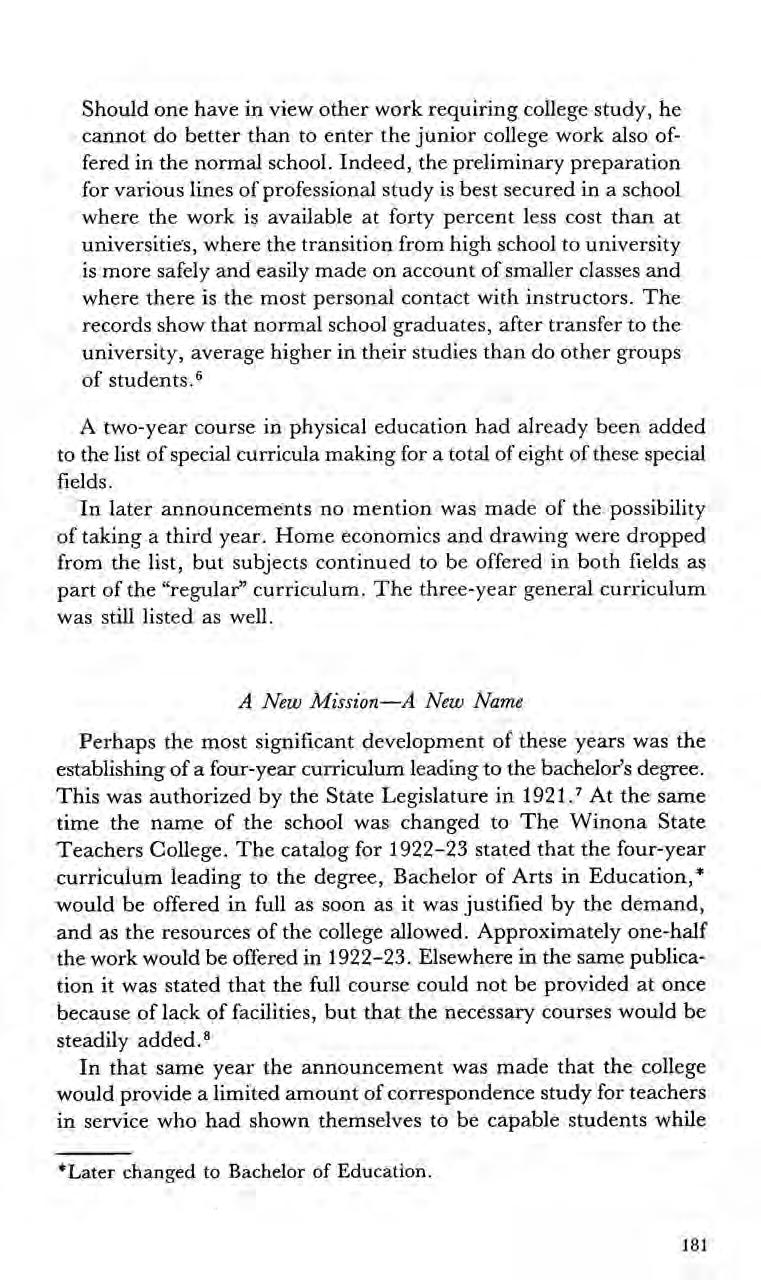
Should one have in view other work requiring college study, he cannot do better than to enter the junior college work also offered in the normal school. Indeed, the preliminary preparation for various lines of professional study is best secured in a school where the work is available at forty percent less cost than at universities, where the transitionfrom high school to university is more safely and easily made on account of smaller classes and where there is the most personal contact with instructors.The records show that normal school graduates, after transfer to the university, average higher in their studies than do other groups of students.®
A two-year course in physical education had already been added to the list of special curricula making fora total of eight of these special fields.
In later announcements no mention was made of the possibility of taking a third year. Home economics and drawing were dropped from the list, but subjects continued to be offered in both fields as part of the “regular” curriculum. The three-year general curriculum was still listed as well.
Perhaps the most significant development of these years was the establishing of a four-year curriculum leading to the bachelor’s degree. This was authorized by the State Legislature in 1921.” At the same time the name of the school was changed to The Winona State Teachers College. The catalog for 1922-23 stated that the four-year curriculum leading to the degree, Bachelor of Arts in Education, * would be offered in full as soon as it was justified by the demand, and as the resources of the college allowed. Approximately one-half the work would be offered in 1922-23. Elsewhere in the same publication it was stated that the full course could not be provided at once because of lack of facilities, but that the necessary courses would be steadily added.?®
In that same year the announcement was made that the college would provide a limited amount of correspondence study for teachers in service who had shown themselves to be capable students while
*Later changed to Bachelor of Education.
in residence. The aim evidently was to encourage these graduates to proceed with the degree program. This offer was withdrawn three years later.
From 1925 to 1928 courses and field work in visiting-teacher education were offered. These courses, under the general designation, Social Guidance of the Child, were given by a specially trained teacher and social worker under a grant from the Commonwealth Fund as part of a nationwide experiment in visiting-teacher work.
(As Announced for 1935-36)
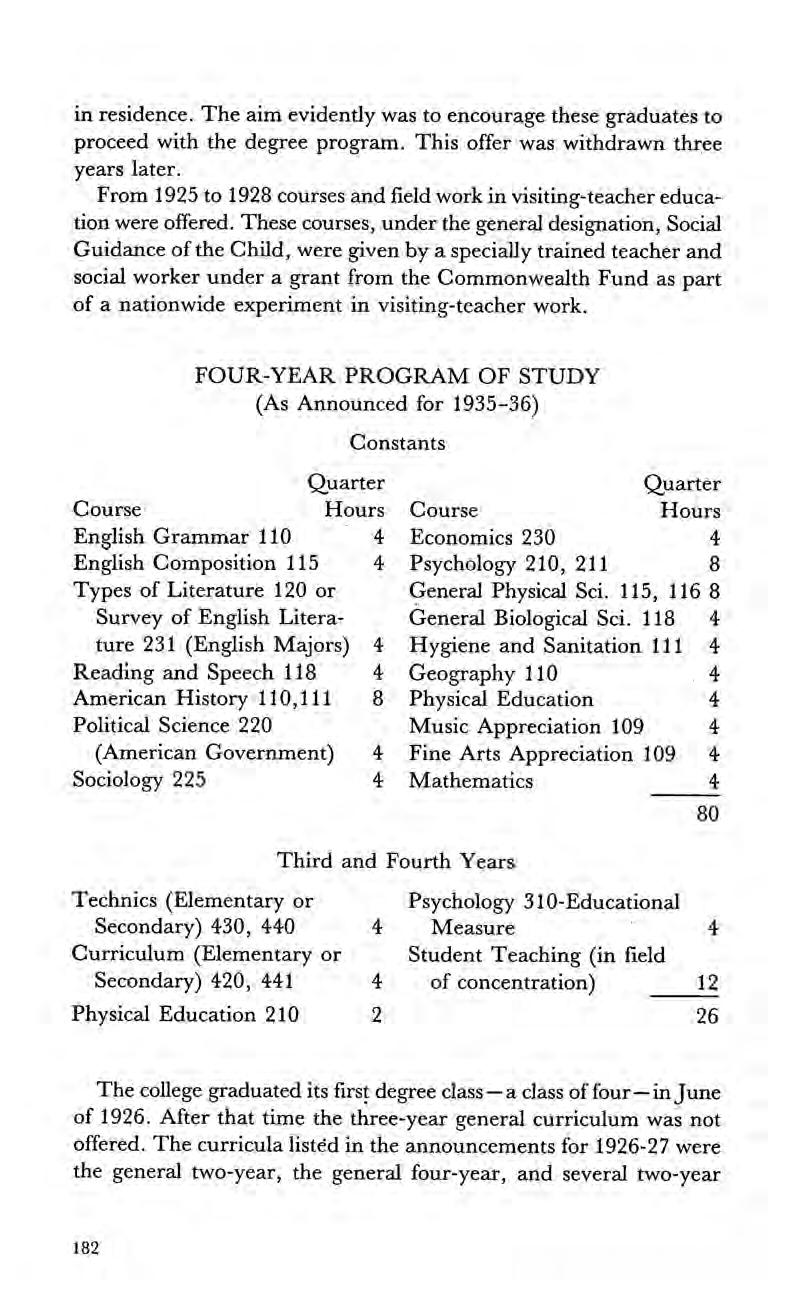
The college graduated its first degree class—a class of four—inJune of 1926. After that time the three-year general curriculum was not offered. The curricula listéd in the announcements for 1926-27 were the general two-year, the general four-year, and several two-year

special offerings; kindergarten-primary, manual training, music, physical education, rural education, and junior college. This was the last mention of a specialjunior college course. Since 1919 it had been recognized as offering a special opportunity to students not wishing to become teachers, and it had been listed among the “special curriculum” since 1920. Graduates from this course had received the title Associate in Arts and had been accepted as juniors in the College of Science, Literature, and the Arts of the University of Minnesota. But the plan eventually was opposed by certain members of the Teachers College Board and by at least one teachers college president in Minnesota. Theacademic junior college course was discontinued.
For the eight years during which junior college courses were specifically offered, the number enrolled ranged from thirteen to thirtythree, the average being twenty-one.
In addition to the regular two-year and four-year curricula and the two-year special curricula in industrial education, public school music, kindergarten-primary, physical education, and rural educationlisted for 1929-30, the college cited the increasing demand for teachers of broader preparation and announced advanced work requiring four. years of preparation in the special fields of industrial arts, music and physical education. A year later fine arts was added to this list. The kindergarten-primary continued on the two-year basis, and rural education on both a one-year and a two-year basis.
In December, 1929, the Teachers College Board authorized the college to extend its program so as to prepare teachers to teach academic as well as special subjects in senior high schools. It took this action in the beliefthat the term “common schools” for which it had been authorized by law to train teachers, “meant and means the public schools; for the College Board thus to add the high school to the field of its responsibility is simply to fulfill the original purpose for which the institution was founded.”® However, the college announced that its primary aim was unchanged and that it wholeheartedly recognized that to meet the needs of the elementary schools was its basic purpose and mission.
The period from 1926, when the first four-year degree class was graduated, to 1929-30, is quite obviously one of transition and of vaguely defined standards. The degree classes found a few new courses added for their benefit, but to a considerable extent they met the somewhat tentative requirements for graduation by taking additional courses from among those already offered as electives. In May, 1929,
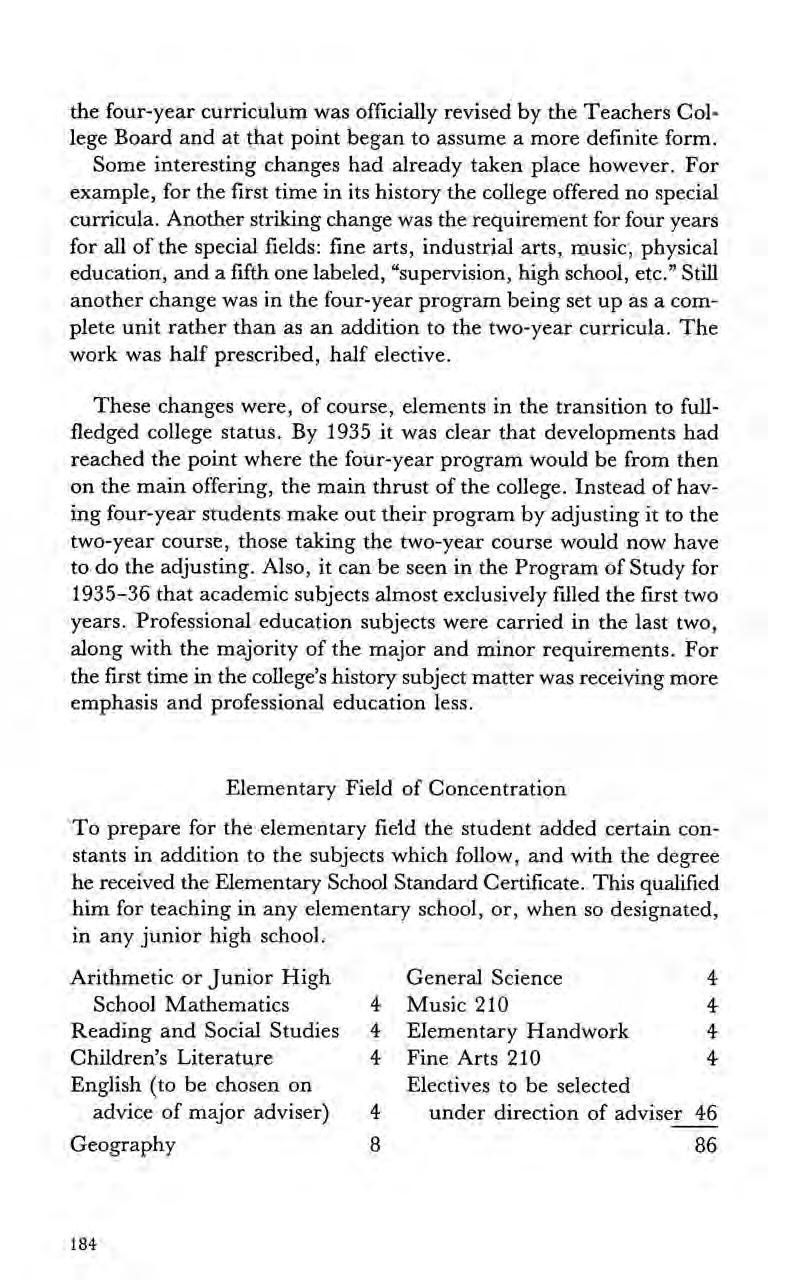
the four-year curriculum was officially revised by the Teachers College Board and at that point began to assume a more definite form. Some interesting changes had already taken place however. For example, for the first time in its history the college offered no special curricula. Another striking change was the requirement for four years for all of the special fields: fine arts, industrial arts, music, physical education, anda fifth one labeled, “supervision, high school, etc.” Still another change was in the four-year program being set up as a complete unit rather than as an addition to the two-year curricula. The work was half prescribed, half elective.
These changes were, of course, elements in the transition to fullfledged college status. By 1935 it was clear that developments had reached the point where the four-year program would be from then on the main offering, the main thrust of the college. Instead of having four-year students make out their program by adjusting it to the two-year course, those taking the two-year course would now have to.do the adjusting. Also, it can be seen in the Program of Study for 1935-36 that academic subjects almost exclusively filled the first two years. Professional education subjects were carried in the last two, along with the majority of the major and minor requirements. For the first time in the college’s history subject matter was receiving more emphasis and professional education less.
To prepare for the elementary field the student added certain constants in addition to the subjects which follow, and with the degree he received the Elementary School Standard Certificate. This qualified him for teaching in any elementary school, or, when so. designated, in any junior high school.
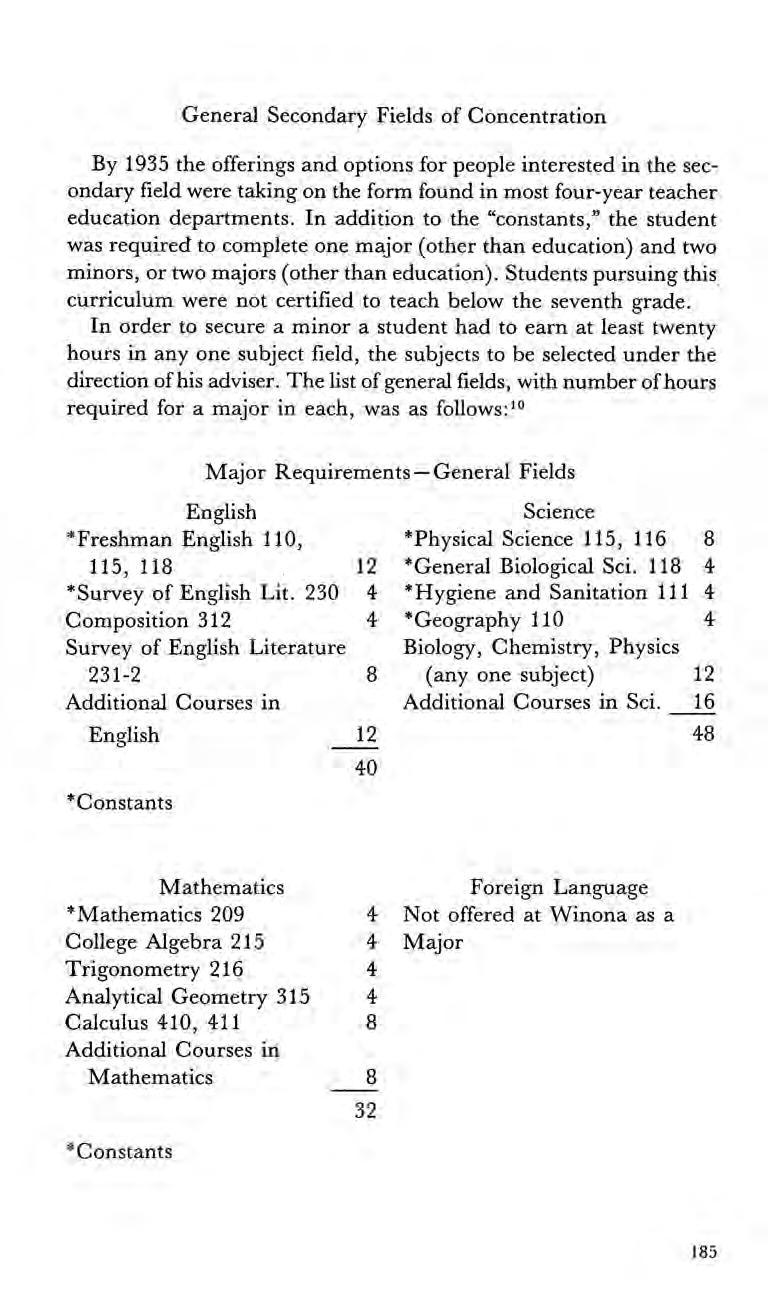
By 1935 the offerings and options for people interested in the secondary field were taking on the form found in most four-year teacher education departments. In addition to the “constants,” the student was required to complete one major (other than education) and two minors, or two majors (other than education). Students pursuing this curriculum were not certified to teach below the seventh grade. In order to secure a minora student had to earn at least twenty hours in any one subject field, the subjects to be selected under the direction ofhis adviser. ‘The list of general fields, with number ofhours required for a major in each, was as follows:'°
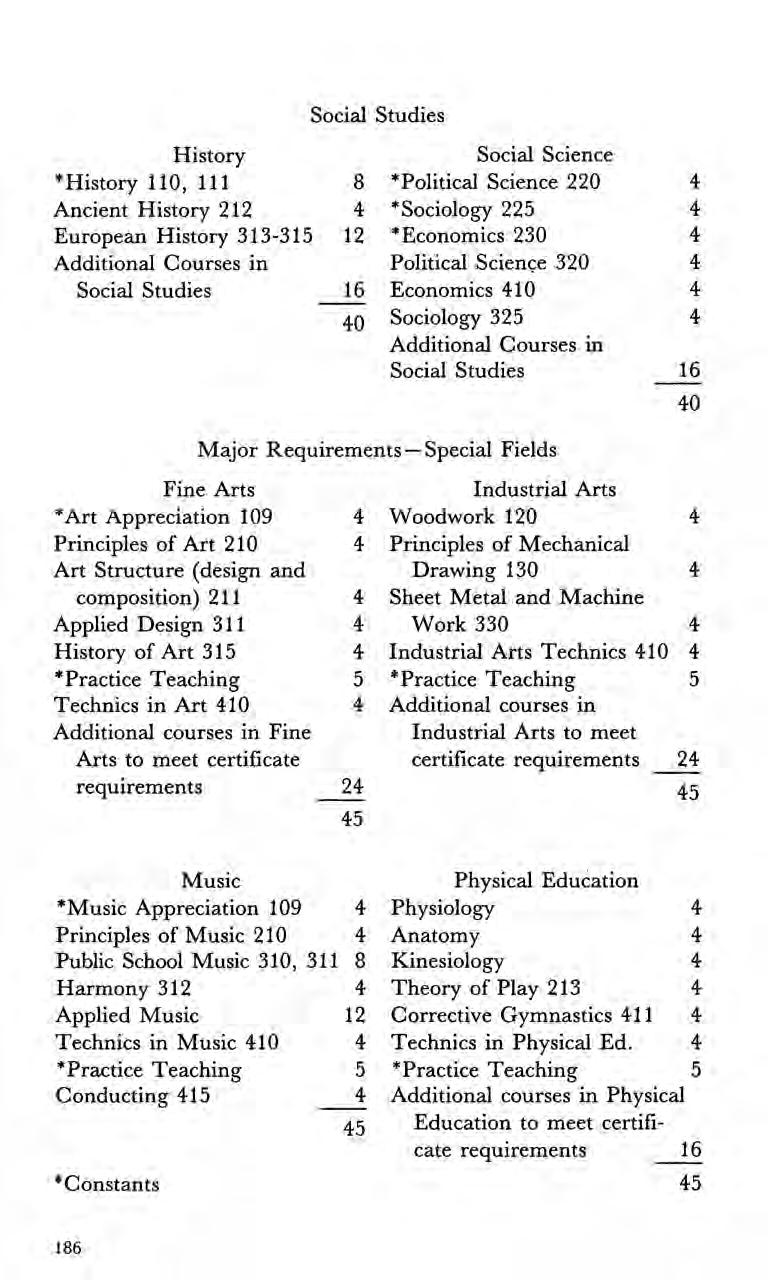

The student who completed the full program pursued four times as much work as did his counterpart of sixty or seventy years before.
Following is a review of the development of the various courses and subjects beginning about 1911 as the college set out upon what would be nearly two decades of transition from a two-year normal school to a four-year teachers college.
With a greatly increased enrollment ofkindergarten children as well as of students specializing in this field, the addition of a third person to the staff became necessary in 1911. Beautiful, spacious, wellequipped quarters were by then provided in the new library building. The rather prohibitive extra fee of thirty dollars a year formerly collected from kindergarten students was discontinued, and the work offered in the department was recognized as being of the same rank as the other work of the school.
A very significant change was made in 1916. Instead of one kindergarten, two well-equipped kindergartens were provided, one for four-year olds and one for five-year olds. In thus separating the children and providing special material and equipment for the younger children, the WinonaNormal broke ground for the earliest of the prekindergarten or nursery schools in Minnesota. A special curriculum for the four-year old child was developed along with materials and equipment carefully devised to meet the needs ofthe very young child. Thus, the kindergarten was placed upon a two-year basis with a graded system paralleling the development of the child for the two years preceding entrance to the first grade.
The kindergarten-primary department later worked toward the establishment of a nursery-kindergarten-primary department which would include not only the adult classes involved but would result in the addition of a third year to the children’s courses to provide for the admission and care of three-year old children as well as four- and five-year olds.
Courses in industrial arts continued and expanded. At the begin-

ning of this period several high-grade woodworking machines were provided, raising questions in some quarters as to their proper place and function in education.
The types of activity increased in number from time to time as determined by the interests of studentsand by the demands from public schools. One or more courses were now offered in each of several fields: woodwork, pottery, cement work, drafting, bookbinding, printing, sheet metal and pattern drafting, and eleetricity. The work was carried on in spacious quarters on the ground floor of college hall, with ample equipmentprovided for all of the variousactivities. The courses were not narrowly vocational. According to a 1926-27 bulletin, they were considered to be both cultural and professional.!?
In 1910 the Winona State Normal School offered two courses in music: an elementary course anda teachers’ course. The first included theory, sight-reading, and voice training. The teachers’ course was for high school graduates who were preparing to teach. The course included theory, sight-reading, methods, the art of conducting, history of music, comparative methods, andvoice training. In the 1913-14 catalog a course for supervisors of music was outlined.!? A special bulletin devoted to music, was printed and sent to interested prospective students. The courses offered were music methods I and I, musical theory, harmonyI and II, history of music and musical forms, song programs and library reading and themes. This program continued almost unchanged until the fall of 1924. In that year vocal school music was graded into music I, II and III. Music IV was offered as a special methods course. One course in harmony and one in history and appreciation were offered. Class piano instruction was added in 1927-28. Courses in instruments and in directing were added in 1930. Instrument courses were listed as brass, woodwind, and string. Voice class work was added in 1931. Credit was also given for private study of piano in 1934-35, such study being with a member of the faculty.
Though physical education activity had been carried on for some time in the WinonaNormal School, it was not until 1909-10 that a full-time teacher of physical education was employed. There seems to have been only one general course, and this for women only, of-

fered in several sections during the day. The required course included Swedish folk dancing, hygiene, principles and theories of physical education. The conducting of games and folk dance classes was also included. Swimming and advanced athletics were offered as optional courses.
In the catalog of 1916-17 an elective course, schoolroom gymnastics and playground exercises, was added.!3 Formative and corrective exercises for posture, grace and ease of movement were also taught. The course included a survey of the theories of play, as well as practical exercises and administrative organization. The physical education work for men seems to have been entirely limited to athletics.
In 1918-19 a special two-year curriculum in physical education was provided. This was designed to prepare students not only to teach the regular school subjects but also to meet the demand for teachers capable of conducting schoolroom gymnastics, playground activities, and athletics. The special subjects were bacteriology, child feeding and emergencies, physical education methods and coaching, physical education theory and organization, physiology, play and gymnastics, practice teaching and coaching.
In 1919-20 the work was organized under the department of hygiene at the invitation of the United States Interdepartmental Social Hygiene Board which gave some financial aid and set up certain requirements. A resident physician was employed and the course in sanitation and hygiene, formerly included under the general heading of science, was added to the courses previously included in the department of physical education. Later the work of the department was reorganized under the name Hygiene and Physical Education.
The state law requiring physical and health education in all public schools produced interest in the special two-year curriculum. The essential content of courses previously given was continued and expanded under slightly different names. Coaching methods for men was listed as a separate course, including the study of theory and practice in the major sports, football, basketball, and track. A new course called Human Growth and Development was added. A course in home nursing, covering bedside and sick-room care, hygiene of maternity and infancy, contagious and infectious disease, and emergencies and bandaging, was offered for the first time. In 1926-27 another course in descriptive and applied anatomy was expanded into two courses, one in elementary anatomy and the other in elementaryphysiology. New courses in 1927-28 included the following: technique of sports

for women — dealing with the organization and methods of coaching field hockey, soccer, basketball, and baseball; individual gymnastics dealing with common faults of posture, their causes and symptoms, and exercises and methods for their correction or improvement; school health supervision — dealing with common defects of school children and classification of pupils according to endurance and coordination; and personal hygiene—a course emphasizing personal attitudes and habits in relation to health.
The physical education practice required of all men and women was entirely reorganized at this time on a sport and seasonal basis and emphasized progressive games and skill tests leading to the major seasonal sports. This form of organization continued without change for many years.
At the beginning of the middle years period, three art courses were required, two in drawing and form study and the other relating to methods of teaching the subject in the common schools. In the field of household arts there was one course in design.
With the setting up of a special three-year offering in drawing in 1912-13 to prepare teachers and supervisors of art in the public schools the offerings were greatly expanded to include perspective drawing, color, mechanical drawing, design and composition, history of art, outdoor sketching, pictorial illustration and life drawing, and organization of the course of study. Within a year or two the courses were further expanded both in the number of subjects offered and in the amount of time devoted to some of them. For example there were two courses in history of art, two in design and composition, and a new course in applied design. In 1915-16 ten courses in drawing were required for the special diplomas in drawing. The name drawing was changed to art the following year. In 1919-20 the number of courses for the special diploma was reduced to six, and two years later the special art curriculum was discontinued although certain courses of value to regular grade teachers were still offered. In 1923 drawing was not required in the general two-year curriculum for the first time. Students were instead permitted to choose between drawing and music. In 1930-31 fine art was made one of the four-year special fields, three of which had been established by the Teachers College Board the preceding year. At that time, the following courses were offered:

the teaching of drawing, primary handwork, design, history of art (two courses), representation, arid rural drawing. Later, courses in applied design and advanced representation were added, and two courses called survey of art, and art appreciation were substituted for history of art. A course in interior decoration was added later.
Special training for teaching in rural methods and management using an ungraded room for observation, was substantially the extent of the offerings in this field until rural education was made one of the special two-year offerings in 1916-17. Graduates were awarded a special rural education diploma. The required subjects included methods and management, rural sociology, rural home economics, rural teaching and observation, and elementary agriculture. In 1920 courses in industrial arts and in nature study as adapted to rural schools were added. After 1926 a field course in rural techniques was provided. This required the student to spend two or three afternoons each week during a term, teaching specific phases of the rural school course of study. After 1932 each student was required to take a two-year course in physical education adapted to the rural school.
The one-year rural course continued to be offered until 1933 when it was eliminated by action of the Minnesota State Teachers College Board.!*
In 1910 six types ofwork were listed under education. These were: pedagogy, one unit; history ofeducation, two units; theory of education, two units; teaching and observation, three units; methods for primary, intermediate, and grammar grades, one unit each; and school management, one-half unit. In 1914 school administration was added for principals and supervisors. Library science was also listed under education.
A fourth unit in “teaching” appeared in 1916 with the statement that it might be carried in any special field or in the rural school. In 1919 special training for the kindergarten fields appeared with other courses in education.
In 1923 the name of the course in the theory of education was changed to principles of education. Educational survey (later called contemporary education) was added in 1927-28. In 1928-29 intro-
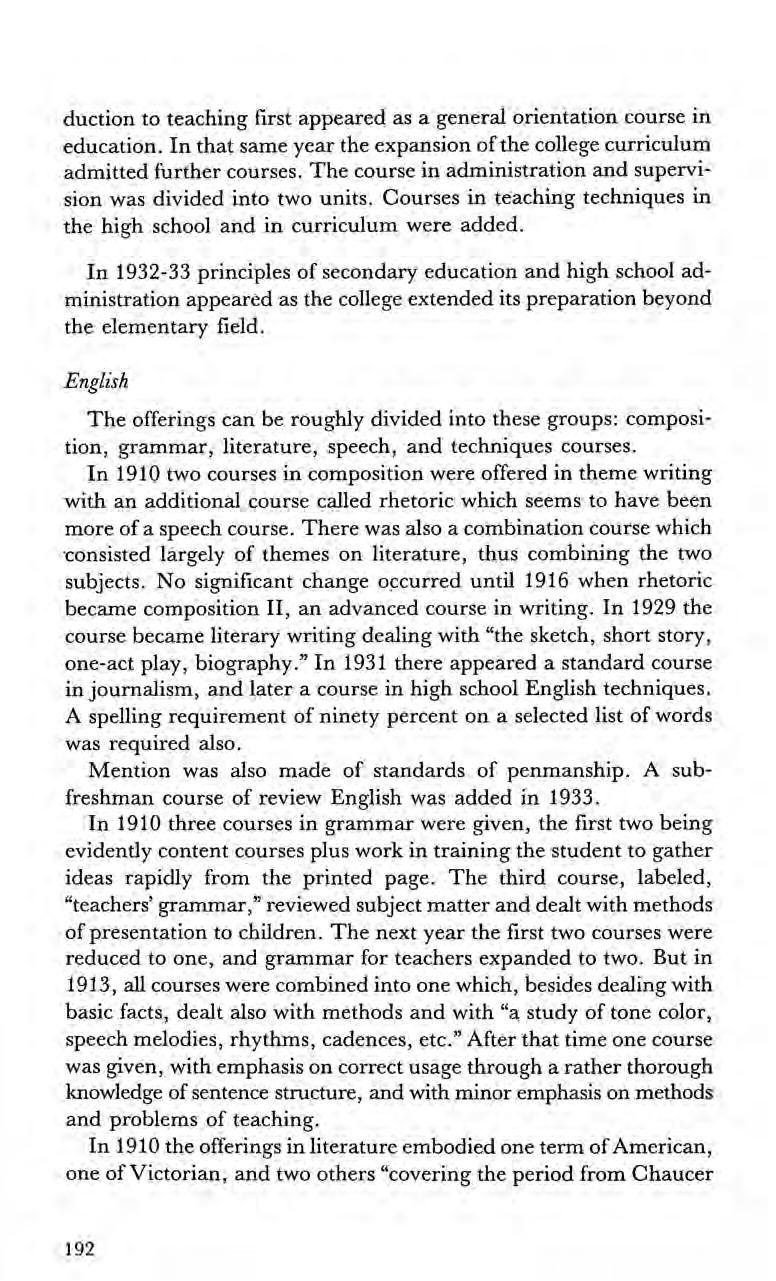
duction to teaching first appeared as a general orientation course in education. In that same year the expansion ofthe college curriculum admitted further courses. The course in administration and supervision was divided into two units. Courses in teaching techniques in the high school and in curriculum were added.
In 1932-33 principles of secondary education and high school administration appeared as the college extended its preparation beyond the elementary field.
The offerings can be roughly divided into these groups: composition, grammar, literature, speech, and techniques courses.
In 1910 two courses in composition were offered in theme writing with an additional course called rhetoric which seems to have been more of a speech course. There was also a combination course which consisted largely of themes on literature, thus combining the two subjects. No significant change occurred until 1916 when rhetoric became composition II, an advanced course in writing. In 1929 the course became literary writing dealing with “the sketch, short story, one-act play, biography.” In 1931 there appeared a standard course in journalism, and later a course in high school English techniques. A spelling requirement of ninety percent ona selected list of words was required also.
Mention was also made of standards of penmanship. A subfreshman course of review English was added in 1933.
In 1910 three courses in grammar were given, the first two being evidently content courses plus work in training the student to gather ideas rapidly from the printed page. The third course, labeled, “teachers’ grammar,” reviewed subject matter anddealt with methods of presentation to children. The next year the first two courses were reduced to one, and grammar for teachers expanded to two. But in 1913, all courses were combined into one which, besides dealing with basic facts, dealt also with methods and with “a study of tone color, speech melodies, rhythms, cadences, etc.” After that time one course was given, with emphasis on correct usage through a rather thorough knowledge of sentence structure, and withminor emphasis on methods and problems of teaching.
In 1910 the offerings in literature embodied one term ofAmerican, one of Victorian, and two others “covering the period from Chaucer

to Wordsworth” besides the combination course ofthemes on literature, mentioned above. This general offering persisted until 1916, at which time children’s literature (one term) was added. In 1919 prose fiction made its appearance and children’s literature was divided into three for the lower, middle, and upper grades. The Victorian literature contracted itself into Browning and Tennyson, occasionally in later years appeared as Browning only, though in 1924 the grouping was, temporarily, Tennyson and Wordsworth. In that year American literature was dropped only to reappear occasionally in later times as a course called Literary Types. In the same year one term of Shakespeare made its advent, and prose fiction became the Nineteenth Century Novel. Little change took place after that for a number of years.
Foreign Languages had a very insecure place in the cirriculum. For the first two years of the middle period four years of Latin, equivalent to the regular four-year high school course, were offered. From 1912 to 1919 there was no foreign language of any kind in the normal department, but eleven quarters of Latin were offered in the high school or “academic” department. Then for a period ofthree years, 1919-1922, elementary French anda year of intermediate French were offered. These courses were omitted in 1922-23, given again in 1923-24, then discontinued from 1924 to 1929. From 1929 to 1932 courses in second and third-year French were offered, then all foreign language was omitted until 1934-35 when a course in beginning French was given once again.
All of this reflects the tentative nature of foreign language offerings in a teachers college whose main concern was with elementary education. It was, in fact, many years before languages gained anything like a secure place in the curriculum, and even then not on a large scale.
For a number of years there had been several courses in geography, one in physiography and one in astronomy. In 1912 physiography was dropped, but after another two-year interval was reinstated and general geography was reduced to one term called teachers geography. A course in commercial geography was added in 1914, but in 1916 the geography of North America was substituted for it and the
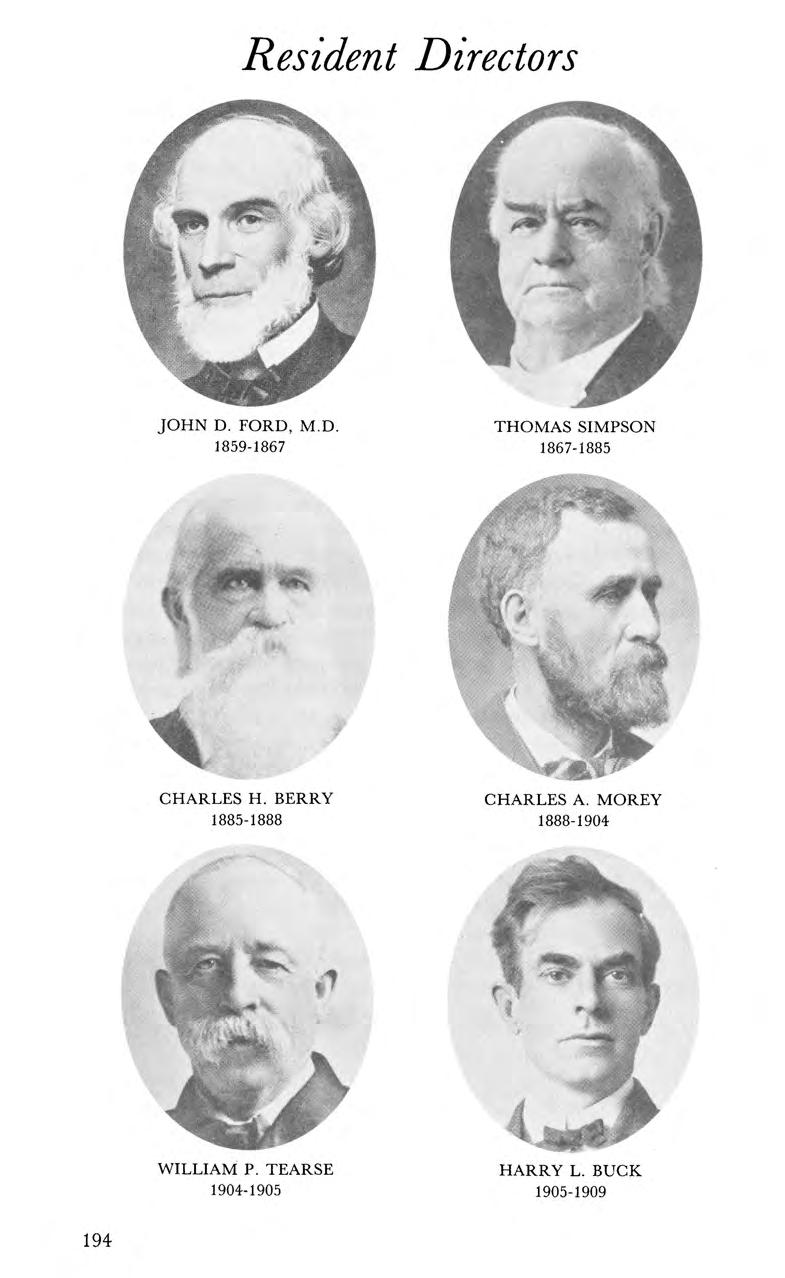
1885-1888 1888-1904
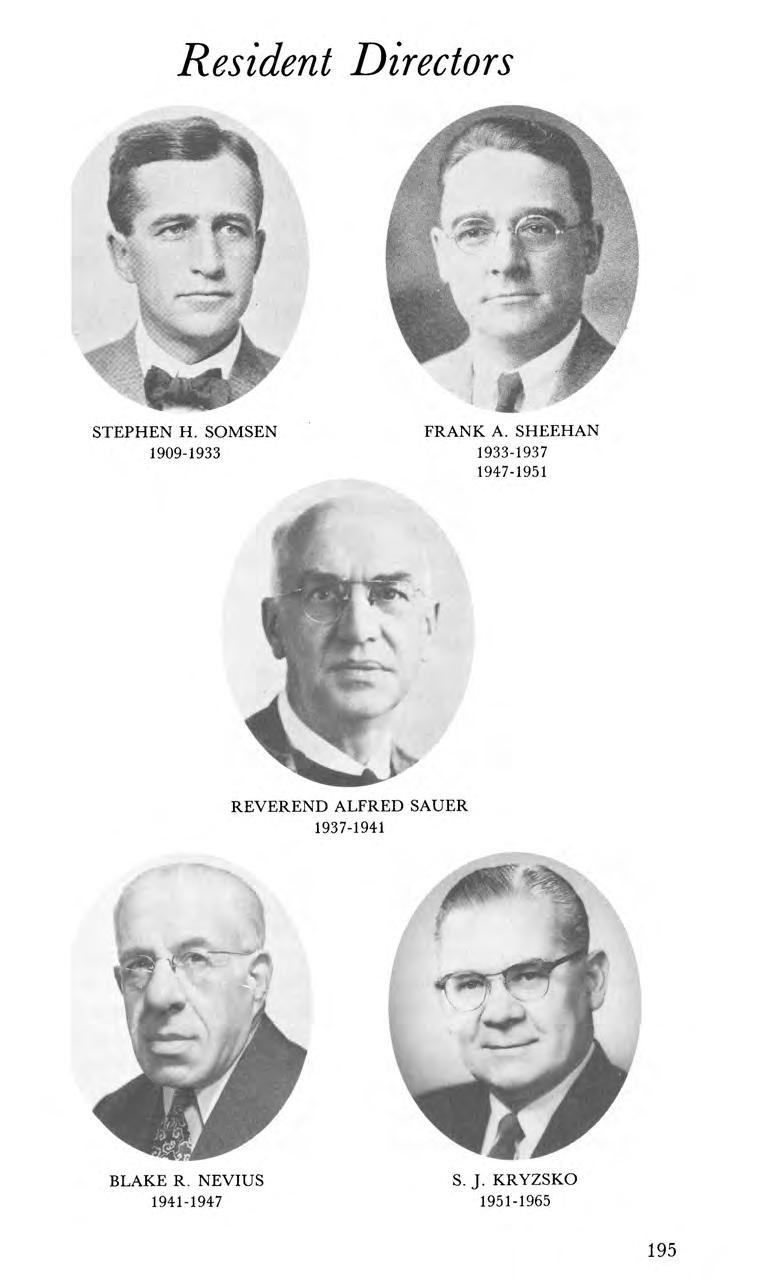
1909-1933 1933-1937 1947-1951
REVEREND ALFRED SAUER 1937-1941
1941-1947 1951-1965
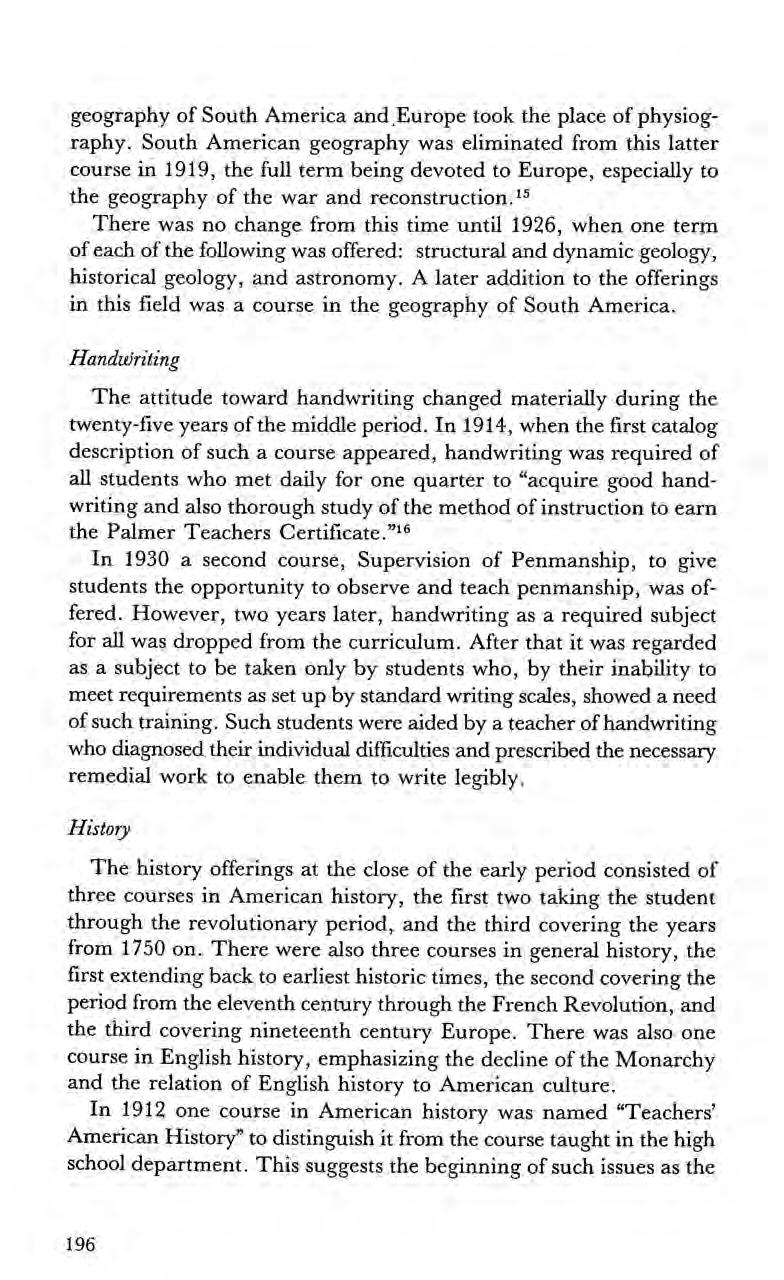
geography of South America and Europe took the place of physiography. South American geography was eliminated from this latter course in 1919, the full term being devoted to Europe, especially to the geography of the war and reconstruction.'®
There was no change from this time until 1926, when one term of each of the following was offered: structural and dynamic geology, historical geology, and astronomy. A later addition to the offerings in this field was a course in the geography of South America.
The attitude toward handwriting changed materially during the twenty-five years of the middle period. In 1914, when the first catalog description of such a course appeared, handwriting was required of all students who met daily for one quarter to “acquire good handwriting and also thorough study of the method of instruction to earn the Palmer Teachers Certificate.”!®
In 1930 a second course, Supervision of Penmanship, to give students the opportunity to observe and teach penmanship, was offered. However, two years later, handwriting as a required subject for all was dropped from the curriculum. After that it was regarded as a subject to be taken onlyby students who, by their inability to meet requirements as set up by standard writing scales, showed a need of such training. Such students were aided bya teacher ofhandwriting who diagnosed their individual difficulties and prescribed the necessary remedial work to enable them to write legibly.
The history offerings at the close of the early period consisted of three courses in American history, the first two taking the student through the revolutionary period, and the third covering the years from 1750 on. There were also three courses in general history, the first extending back to earliest historic times, the second covering the period from the eleventh century through the French Revolution, and the third covering nineteenth century Europe. There was also one course in English history, emphasizing the decline of the Monarchy and the relation of English history to American culture.
In 1912 one course in American history was named “Teachers’ American History” to distinguish it from the course taught in the high school department. This suggests the beginning of such issues as the
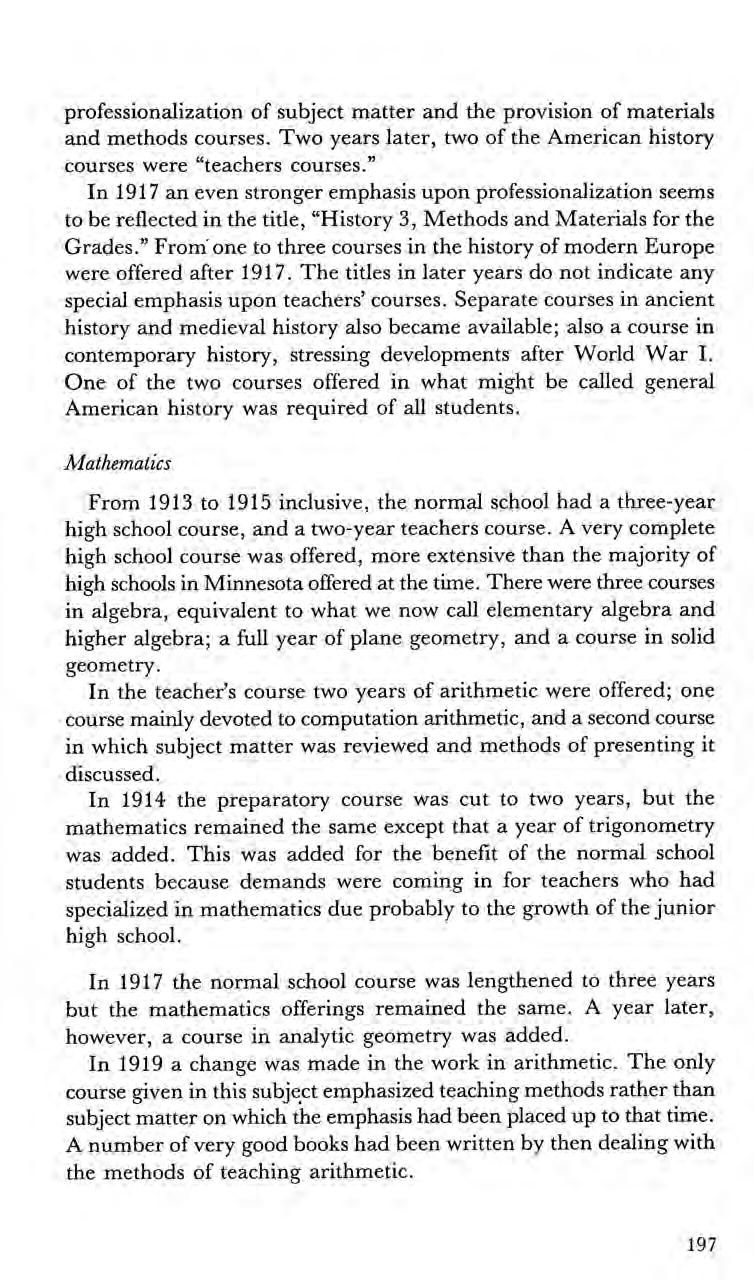
professionalization of subject matter and the provision of materials and methods courses. Two years later, two of the American history courses were “teachers courses.”
In 1917 an even stronger emphasis upon professionalization seems to be reflected in the title, “History 3, Methods and Materials for the Grades.” From one to three courses in the history of modern Europe were offered after 1917. The titles in later years do not indicate any special emphasis upon teachers’ courses. Separate courses in ancient history and medieval history also became available; also a course in contemporary history, stressing developments after World War I. One of the two courses offered in what might be called general American history was required of all students.
From 1913 to 1915 inclusive, the normal school had a three-year high school course, and a two-year teachers course. A very complete high school course was offered, more extensive than the majority of high schools in Minnesota offered at the time. There were three courses in algebra, equivalent to what we now call elementary algebra and higher algebra; a full year of plane geometry, and a course in solid geometry.
In the teacher’s course two years of arithmetic were offered; one course mainly devoted to computation arithmetic, and a second course in which subject matter was reviewed and methods of presenting it discussed.
In 1914 the preparatory course was cut to two years, but the mathematics remained the same except that a year of trigonometry was added. This was added for the benefit of the normal school students because demands were coming in for teachers who had specialized in mathematics due probably to the growth of the junior high school.
In 1917 the normal school course was lengthened to three years but the mathematics offerings remained the same. A year later, however, a course in analytic geometry was added.
In 1919 a change was made in the work in arithmetic. The only course given in this subject emphasized teaching methods rather than subject matter on which the emphasis had been placed up to that time. A number of very good books had been written by then dealing with the methods of teaching arithmetic.

During the first ten years of the middle years there were just two courses in psychology. These were said to be “introspective” in their point of view and in their objectives.
With a change of instructors in 1920, the shift from introspective to behavioristic psychology was evident although the new emphasis was not extreme. The second ofthe two courses in psychology became a course in learning with emphasis upon individual differences, measurement, and correlation. Educational measurement was offered as a separate course in the summer of 1921 and continued to be offered from then on. Courses in psychology of the common branches, in-mental hygiene, in social psychology, and in fields of psychology were added to the offerings after 1926.
In 1920 the science offerings of the Winona State Normal School included a course in physiology, two courses in chemistry, two in botany, three in physics, one in elementary science and one elective course in advanced physics. A year later two elective courses in agriculture were listed and two units of work in zoology. A few years later two additional courses in organic and food chemistry were given as well as a course in bacteriology as required in the special home economics curriculum.
The field designated by the term physiology underwent rather frequent changes of name, accompanied by changes in emphasis and content. At one time this single course was labeled physiology, hygiene and anatomy; later the name physiology and sanitation was used; then hygiene and sanitation.
The offerings were sharply reduced in 1917 after the elimination of the high school department. Both physics and botany were discontinued. The courses in food chemistry and bacteriology were discontinued also with the elimination of the special curriculum in home economics.
In 1923 the old course in elementary science became a course in nature study without any significant change in content.
For some time after the fire in 1922, funds were not available for equipping the laboratories, so the offerings were limited for a few years. Physics, chemistry and zoology all disappeared from the list of offerings for a time. Two units ofbiology were announced in 1926; hygiene
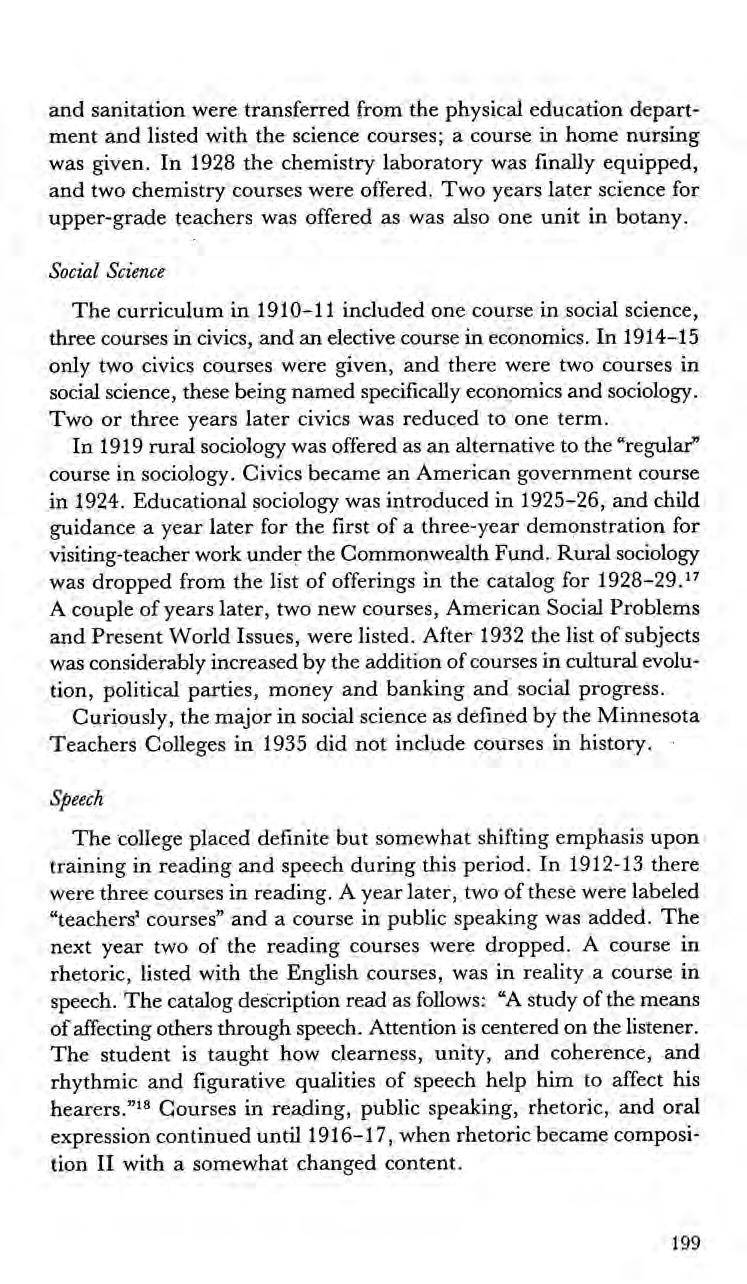
and sanitation were transferred from the physical education department and listed with the science courses; a course in home nursing was given. In 1928 the chemistry laboratory was finally equipped, and two chemistry courses were offered. Two years later science for upper-grade teachers was offered as was also one unit in botany.
The curriculum in 1910-11 included one course in social science, three courses in civics, and an elective course in economics. In 1914-15 only two civics courses were given, and there were two courses in social science, these being named specifically economics and sociology. Two or three years later civics was reduced to one term.
In 1919 rural sociology was offered as an alternative to the “regular” course in sociology. Civics became an American government course in 1924. Educational sociology was introduced in 1925-26, and child guidancea year later for the first of a three-year demonstration for visiting-teacher work under the Commonwealth Fund. Rural sociology was dropped from the list of offerings in the catalog for 1928-29.'7 A couple of years later, two new courses, American Social Problems andPresent World Issues, were listed. After 1932 the list of subjects was considerably increased by the addition of courses in cultural evolution, political parties, money and banking and social progress.
Curiously, the major in social science as defined by the Minnesota Teachers Colleges in 1935 did not include courses in history.
The college placed definite but somewhat shifting emphasis upon training in reading and speech during this period. In 1912-13 there were three courses in reading. A year later, two of these were labeled “teachers’ courses” and a course in public speaking was added. The next year two of the reading courses were dropped. A course in rhetoric, listed with the English courses, was in reality a course in speech. The catalog description read as follows: “A study of the means of affecting others through speech. Attention is centered on the listener. The student is taught how clearness, unity, and coherence, and rhythmic and figurative qualities of speech help him to affect his hearers.”!8 Courses in reading, public speaking, rhetoric, and oral expression continued until 1916-17, when rhetoric became composition II with a somewhat changed content.

In 1918 dramatics or dramatic activity was included, although not on a course and credit basis until 1927. The commencement play was to be produced under the direction of theteacher of reading, and selected plays given under the direction of students during the year.
The basic course in the speech field was first labeled reading and speech in 1919-20. The recurring paragraph on “expression” was first omitted from the 1920-21 catalog. Argumentation and debate first received recognition in 1924. From 1924-26 a “speech and voice clinic” was provided. This was on a non-credit, individual basis, and was designed to remove speech defects and to develop normal, pleasing voices.
In later years, courses in the speech field were listed under the heading, English Language and Literature.
The well-known organizational instincts ofAmericans seem to have manifested themselves with a vengeance during the middle years, because records indicate that there must have been a club for almost every area of study and activity to be found in the institution.
There were the Kindergarten Club, the Primary Club, the Intermediate Grade Club, and the Junior High School Club, which met regularly presumably for “professional discussions” and study. Still other student organizations were the Mendelssohn Club, the Apollo club, the senior band, the orchestra, debate, the Wenonah, the Winonan, the Wenonah players and nearly two dozen more. They are described briefly in the following paragraphs.*
For thirty-five years the Mendelssohn Club, an organization of women students, had as its purpose the stimulation of the musical life of the school and the community by promoting “high moral standards.” Founded by Caroline V. Smith in 1900, it served the college longer than any other organization. It sang regularly at various musical functions both in the college and community.
* Some of these received a small amount of academic credit in recognition of their more-or-less academic character.

The Apollo Club was a choral club including from sixteen to twenty young men. It carried on a serious study of music each year, giving a public recital in the spring. It became customary for it to take a goodwill tour for a week in April, singing in numerous Minnesota high schools.
This club was organized in 1920 by the women who were taking the public school music course. The organization during its first years was primarily social. However, at its regular monthly meetings such topics were discussed as The Symphony Orchestra and Methods of Conducting. It became customary for the members of the club to present an operetta during the winter quarter.
In line with its aim of developing appreciation of the best music and a wider knowledge of musical artists and composers, the club presented programs at each of its meetings, most of the “talent” being members. The organization had a membership of twenty-five.
The college band dates from 1927 when it had nine members and was led by the college music director.Its appearances were limited to pep fests, football games and the homecoming parade. It continued on this basis for some three years when the director of the Winona Municipal Band, Mr. O. E. Reese, was engaged to take charge of the organization giving attention to the beginners’ or junior band as well as to the senior band. The number of members in the combined organizations was thirty-five.
President Maxwell, while apparently satisfied with the band as a teaching organization, wanted something which could double as part of a recruiting and public relations effort. An enterprising student, Harold Edstrom, who played in the pep band under student directors A. G. Gullickson and Don Karow, suggested the possibility of such an organization to the President one day in 1932. At the same time he apparently let him know that his talented brother, Everett (later a National Trumpet Solo Contest winner at the 1933 World’s Fair in Chicago) would be willing to join him in the effort. Dr. Maxwell took them up on the proposition, and on February 10, 1933, at an assembly program, the band made its first appearance in its strik-

THE COLLEGE BAND, 1934
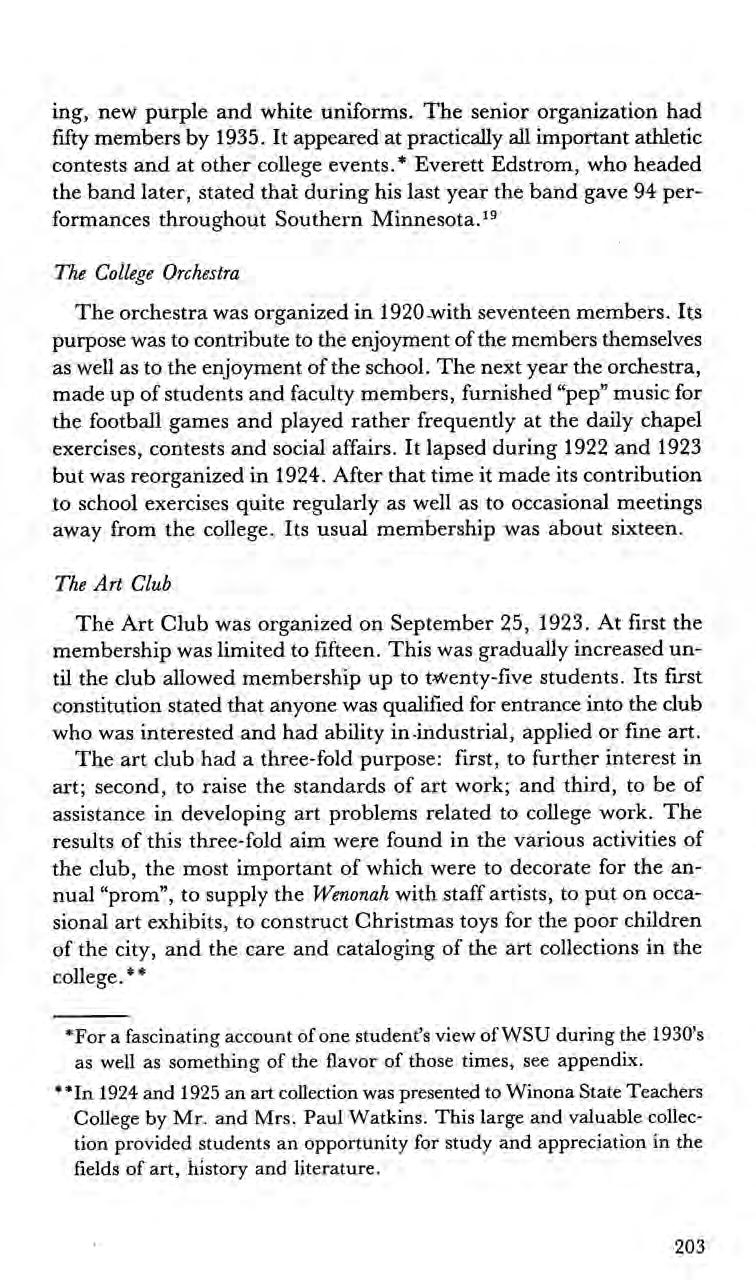
ing, new purple and white uniforms. The senior organization had fifty members by 1935. It appeared at practically all important athletic contests and at other college events.* Everett Edstrom, who headed the band later, stated that during his last year the band gave 94 performances throughout Southern Minnesota.?!9
The orchestra was organized in 1920with seventeen members. I[ts purpose was to contribute to the enjoyment ofthe members themselves as well as to the enjoyment ofthe school. The next year the orchestra, made up of students and faculty members, furnished “pep” music for the football games and played rather frequently at the daily chapel exercises, contests and social affairs. It lapsed during 1922 and 1923 but was reorganized in 1924. After that time it made its contribution to school exercises quite regularly as well as to occasional meetings away from the college. Its usual membership was about sixteen.
The Art Club was organized on September 25, 1923. At first the membership was limited to fifteen. This was gradually increased until the club allowed membership up to twenty-five students. Its first constitution stated that anyone was qualified for entrance into the club who was interested and had ability in-industrial, applied or fine art.
The art club had a three-fold purpose: first, to further interest in art; second, to raise the standards of art work; and third, to be of assistance in developing art problems related to college work. The results of this three-fold aim were found in the various activities of the club, the most important of which were to decorate for the annual “prom”, to supply the Wenonah with staff artists, to put on occasional art exhibits, to construct Christmas toys for the poor children of the city, and the care and cataloging of the art collections in the college.**
*For a fascinating account of one student’s view ofWSU during the 1930's as well as something of the flavor of those times, see appendix.
**In 1924 and 1925 an art collection was presented to Winona State Teachers College by Mr. and Mrs. Paul Watkins. This large and valuable collection provided students an opportunity for study and appreciation in the fields of art, history and literature.
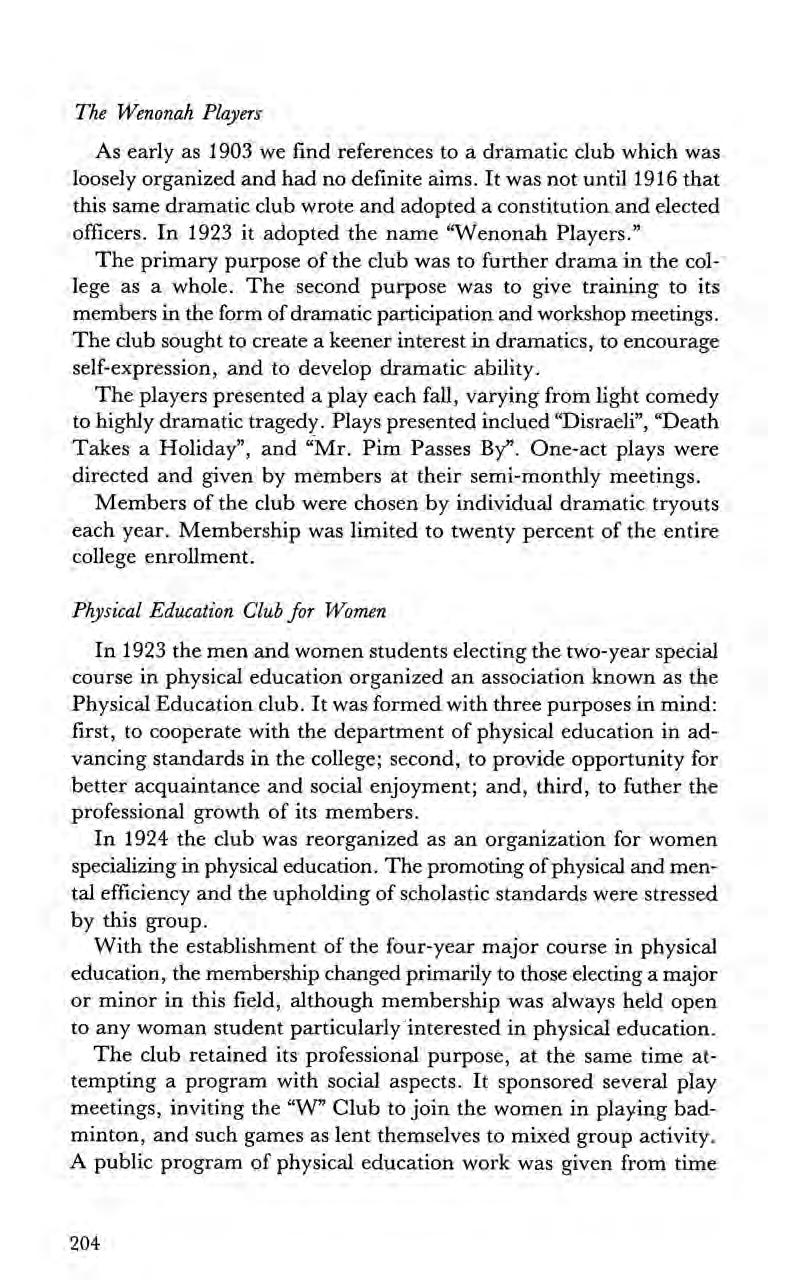
As early as 1903 we find references to a dramatic club which was loosely organized and had no definite aims. It was not until 1916 that this same dramatic club wrote and adopteda constitution and elected officers. In 1923 it adopted the name “Wenonah Players.”
The primary purpose of the club was to further drama in the col-' lege as a whole. The second purpose was to give training to its members in the form ofdramatic participation and workshop meetings. The club sought to create a keener interest in dramatics, to encourage self-expression, and to develop dramatic ability.
The players presented a play each fall, varying from light comedy to highly dramatic tragedy. Plays presented inclued “Disraeli”, “Death Takes a Holiday”, and “Mr. Pim Passes By”. One-act plays were directed and given by members at their semi-monthly meetings.
Members of the club were chosen by individual dramatic tryouts each year. Membership was limited to twenty percent of the entire college enrollment.
In 1923 the men and women students electing the two-year special course in physical education organized an association known as the Physical Education club. It was formed with three purposes in mind: first, to cooperate with the department of physical education in advancing standards in the college; second, to provide opportunity for better acquaintance and social enjoyment; and, third, to futher the professional growth of its members.
In 1924 the club was reorganized as an organization for women specializing in physical education. The promoting ofphysical and mental efficiency and the upholding of scholastic standards were stressed by this group.
With the establishment of the four-year major course in physical education, the membership changed primarily to those electing a major or minorin this field, although membership was always held open to any woman student particularly interested in physical education.
The club retained its professional purpose, at the same time attempting a program with social aspects. It sponsored several play meetings, inviting the “W” Club to join the women in playing bad-: minton, and such games as lent themselves to mixed group activity. A public program of physical education work was given from time

to time as a demonstration by the men and women of the department. A spring outing or house party was an annual event.
According to the Wenonah of 1915 the Women’s Athletic Association was first organized on February 17 ofthat year. Athletic activities had long beena part of the life of the women of the school but it was only then that the organization was formally instituted reflecting “the need of an organized movement to promote school spirit.” Its constitution was adopted on February 22 of the same year. A board of directors of theassociation was composed of the physical director for women, the president and secretary of the association, and representatives from the junior and senior classes and from each of the physical activities sponsored by the school. The statement of purpose appears in the write-up of the organization to theeffect that it was the earnest endeavor of theassociation to promote every form of physical activity in school and to take care of interscholastic as well as interclass contests.
In 1916 interscholastic athletics for men appeared and gave rise to a desire for an organization of some sort to sponsor such activities. A general athletic association composed of all members of the school was formed called the WinonaNormal School Athletics Association: Fees of fifty cents per quarter or one dollar per year admitted members to all contests held under the auspices of the association. Offices were alternated. yearly between men and women and final authority was vested in a board of control composed of an equal number of men and women and three members of the faculty.
The women’s branch of the athletic association continued under the old constitution previously set up for thewomen’s organization because of.the fact that women’s athletics was of a different nature and was interclass rather than interscholastic.
In 1917 a point system of awards for women was introduced and so arranged as to require two or more forms of activity to win an award. One hundred points were required to earn a monogram of the school. The organization continued without appreciable change until 1919 when thewomen’s branch was somewhat reorganized. Dues were no longer required, but in their place one had to earn at least fifty points to become eligible for full membership.
First teams in basketball, baseball, soccer, volleyball and field hockey
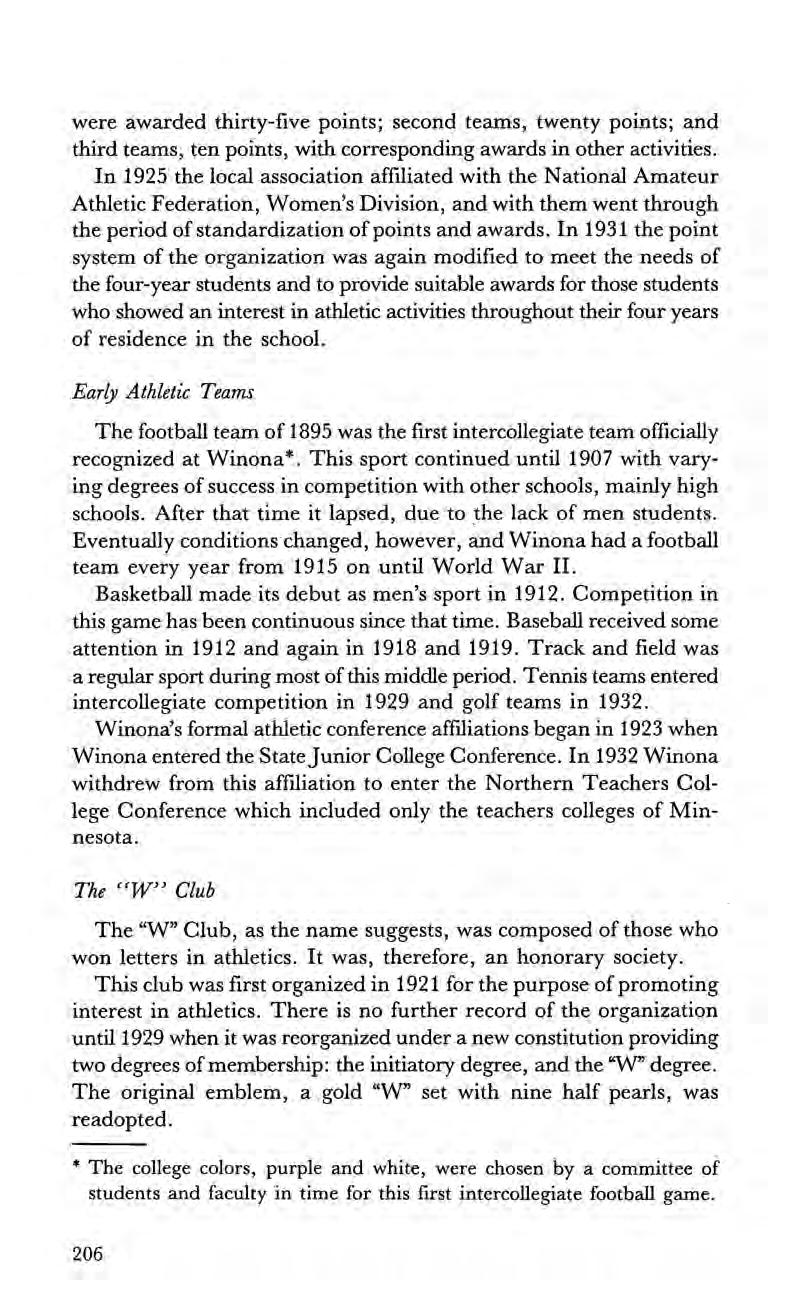
were awarded thirty-five points; second teams, twenty points; and third teams, ten points, with corresponding awards in other activities. In 1925 the local association affiliated with the National Amateur Athletic Federation, Women’s Division, and with them went through the period of standardization ofpoints andawards. In 1931 the point system of the organization was again modified to meet the needs of the four-year students and to provide suitable awards for those students who showed an interest in athletic activities throughout their four years of residence in the school.
The football team of 1895 was the first intercollegiate team officially recognized at Winona*. This sport continued until 1907 with varying degrees of success in competition with other schools, mainly high schools. After thattime it lapsed, due to the lack of men students. Eventually conditions changed, however, and Winona hada football team every year from 1915 on until World War II.
Basketball made its debut as men’s sport in 1912. Competition in this game has been continuous since that time. Baseball received some attention in 1912 and again in 1918 and 1919. Track and field was a regular sport during most ofthis middle period. ‘Tennis teams entered intercollegiate competition in 1929 and golf teams in 1932. Winona’s formal athletic conference affiliations began in 1923 when Winona entered the StateJunior College Conference. In 1932 Winona withdrew from this affiliation to enter the Northern Teachers College Conference which included only the teachers colleges of Minnesota.
The “W” Club, as the name suggests, was composed of those who won letters in athletics. It was, therefore, an honorary society. This club was first organized in 1921 for the purpose of promoting interest in athletics. There is no further record of the organization until 1929 when it was reorganized under a new constitution providing two degrees of membership: the initiatory degree, and the “W” degree. The original emblem, a gold “W” set with nine half pearls, was readopted.
* The college colors, purple and white, were chosen by a committee of students and faculty in time for this first intercollegiate football game.
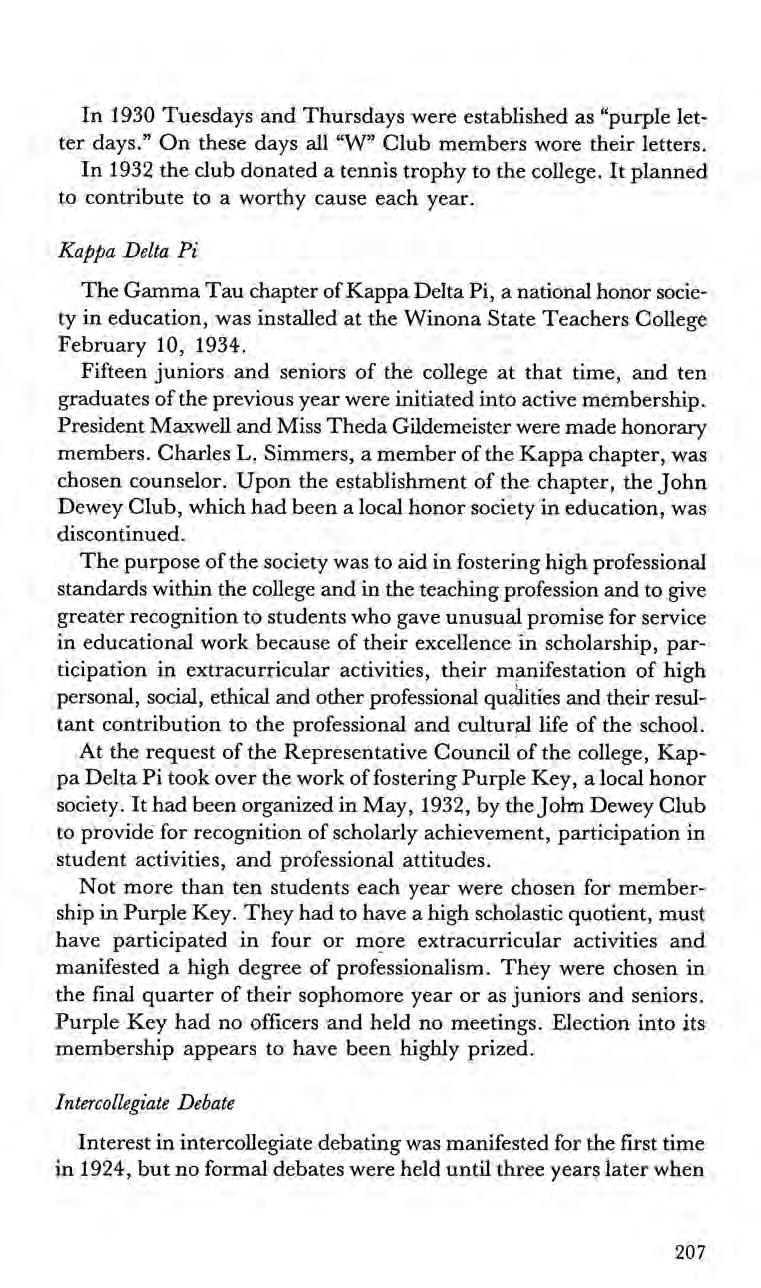
In 1930 ‘Tuesdays and Thursdays were established as “purple letter days.” On these days all “W” Club members wore their letters.
In 1932 the club donateda tennis trophy to the college. It planned to contribute to a worthy cause each year.
TheGamma Tau chapter ofKappa Delta Pi, a national honor society in education, was installed at the Winona State Teachers College February 10, 1934.
Fifteen juniors and seniors of the college at that time, and ten graduates ofthe previous year were initiated into active membership. President Maxwell and Miss Theda Gildemeister were made honorary members. Charles L. Simmers, a member of the Kappa chapter, was chosen counselor. Upon the establishment of the chapter, the John Dewey Club, which had beena local honor society in education, was discontinued.
The purpose ofthe society was to aid in fostering high professional standards within the college and in the teaching profession and to give greater recognition to students who gave unusual promise for service in educational work because of their excellence in scholarship, participation in extracurricular activities, their manifestation of high personal, social, ethical and other professional qualities and their resultant contribution to the professional and cultural life of the school.
At the request of the Representative Council of the college, Kappa Delta Pi took over the work of fostering Purple Key, a local honor society. It had been organized in May, 1932, by theJohm Dewey Club to provide for recognition of scholarly achievement, participation in student activities, and professional attitudes.
Not more than ten students each year were chosen for membership in Purple Key. They had to have a high scholastic quotient, must have participated in four or more extracurricular activities and manifested a high degree of professionalism. They were chosen in the final quarter of their sophomore year or as juniors and seniors. Purple Key had no officers and held no meetings. Election into its membership appears to have been highly prized.
Interest in intercollegiate debating was manifested for the first time in 1924, but no formal debates were held until three years later when

one-decision contests were arranged against the Kau Claire and La Crosse Teachers Colleges. The following year the schedule again included these two schools, with St. Mary’s, St. Thomas, and Macalester in addition. From then on, three to five opponents were met each year,. usually in dual meets, but sometimes on the triangular basis. In 1934 Winona State Teachers College tied with the River Falls Teachers College for first place in a debate tournament at St. Cloud State.
The high point of interest in debating was reached when a Winona team met a Cambridge University team in a non-decision contest in the college auditorium on November 24, 1933.
This activity was sometimes carried on as part of a course in argumentation and debate on an extracurricular basis.
In 1933 a group of students interested in international affairs organized an International Relations Club, operating under the general plan established by the Carnegie Endowment for International Peace. The various members made and discussed reports of significant political and social developments throughout the world. One important aim of the organization was to develop an interest in international matters on the part of the student body. The Carnegie Endowment made several donations ofbooks and pamphlets for the use of the club.
The League of Women Voters, a branch of the national league, was then as now a non-partisan organization which attempted to promote interest in political questions among women voters, and sought to create in them the desire to participate in civic affairs through the study of current political problems. Interest in this type of club was evidenced by the number of members who became active in thecollege league after its reorganization by the field secretary in 1930.
The Winonan
In the year 1919-20 the school had its first student publication, a weekly periodical known as The Pow-Wow. Its avowed aim was the development of school spirit. In addition to being printed for student circulation, it was also published each Thursday as a separate sheet

of the Winona Leader, a Winona city paper with circulation in southern Minnesota and in Wisconsin and Iowa. A humorous supplement of The Pow-Wow was known as The Pee- Wee.
In 1922 the title was changed to The Winonan, and the paper was published bi-weekly. It was given quarters in the main building, and functioned as an official school organ and a student newspaper. After 1930 it stressed literary material somewhat more than formerly. It was financed by appropriations out of the student activity fund and by income from a small quantity of advertising.
The Winonan received a number of awards for excellence from the Columbia Scholastic Press Association.
The functions of this publication were said to be: (1) to express student opinion; (2) to provide information; (3) to promote school enterprises; (4) to keep a permanent record of school activities; (5) to foster school spirit; (6) to perpetuate traditions.
The members of the staff were chosen during the first month of each spring quarter, the outgoing editors selecting the new staff after try-outs.
The Wenonah
Beginning in 1911 the graduating classes published an “annual” called The Wenonah. This was similar to publications of other schools during this period and varied in size from 72 to 180 pages. It was an attractive, pictorial record of persons, organizations and important events year by year. It won several awards for excellence in competition with annuals produced by other schools in the same classification.
The Booster Club was organized in January, 1926, as an agency for assuming the responsibility ofboosting school activities. This club informally made its debut into college society by sponsoring the football banquet in the fall of 1926. Any student was eligible to belong to this organization.
After a time the program of the club did not seem adequate. Through the efforts of a few “boosters,” both students and faculty members, The Die-No-Mo was organized. The purpose of the club was to give active support to, and create interest in, all school activities. It was to be something alive and dynamic, hence the name

Die-No-Mo. The membership of the club was limited to ten percent ofthe student body and the faculty. Five faculty members were elected to the position of “insulators.” The charter officers of this organization were: High Voltage (President) Ralfe Calkins; Voltage (Vice. President) Bernice Jensen; Brush (Secretary-Treasurer) Elizabeth Burns; and Spark (Pep Chairman) Julian Neville.
The club carried on an extensive program, including a yearly DieNo-Mo “show” for the purpose of supporting student enterprise and raising funds for securing and maintaining “good will” contacts with high schools. There were also sports events such as the football banquet, pep fests, homecoming activities, and student recruiting tours from the club itself.
A new men’s organization was introduced into the school during the winter term of 1921-22, adopting the name “Mu Epsilon Nu.”
Its aims were: (1) to promote good fellowship and sucial activity among the men of the school; (2) to further the interests of the school as a whole.
A football banquet given in honor of the St. Cloud team was the first important social function of the club. This was followed by similar social affairs for other schools. A later outstanding activity was the spring carnival which was held jointly with several other school organizations. This carnival was held for the benefit of the Memorial Organ Fund and marked the beginning of the cooperation between the various clubs of the school.
Due to the efforts ofthisclub all the objectionable accompaniments of freshman intitiation were removed, and a program of wholesome amusement and harmless sport was substituted. Boxing was introduced into the college through the efforts of this club.
The club each year elected an intramural board to take charge of the extensive intramural athletic program which the club sponsored for the benefit of the men students.
The Country Life Club was organized in 1916, its purpose being to promote an interest in rural school teaching and in rural life. Its activities were both social and professional. It sponsored an annual
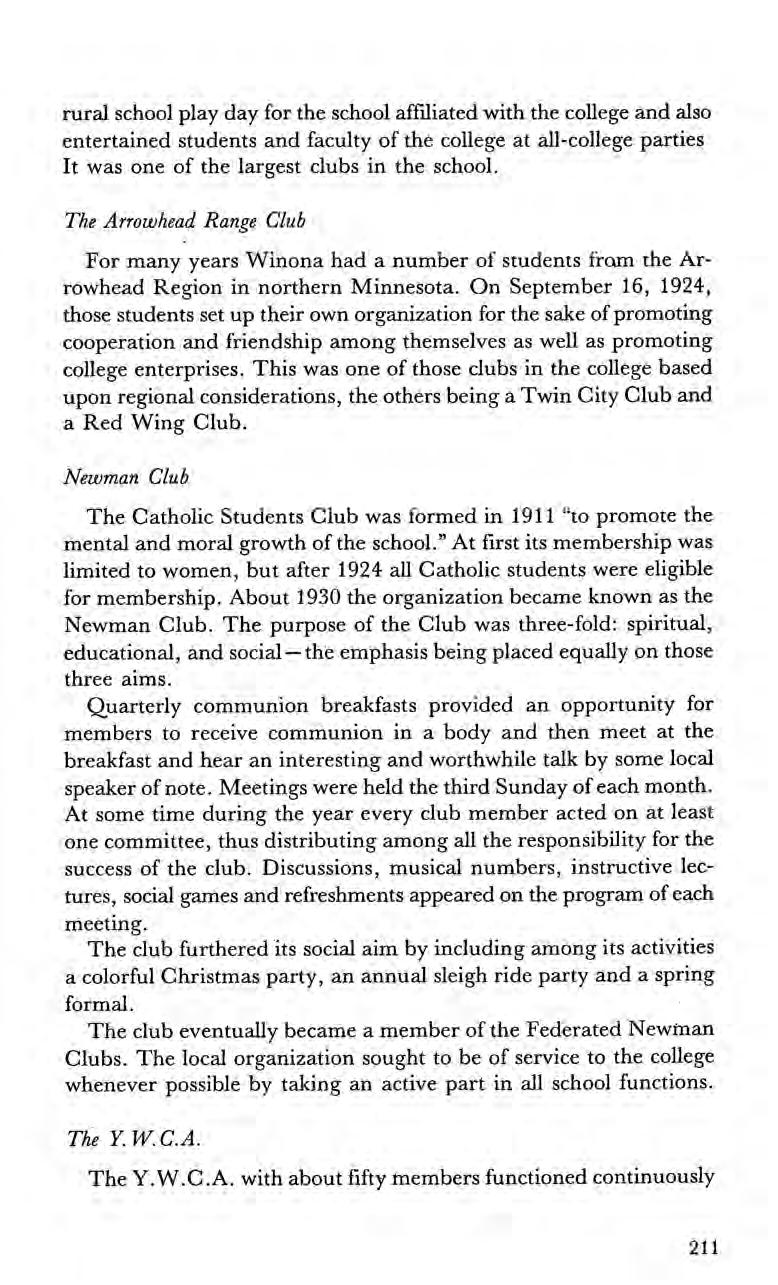
rural school play day for the school affiliated with the college and also entertained students and faculty of the college at all-college parties It was one of the largest clubs in the school.
For many years Winona had a number of students fram the Arrowhead Region in northern Minnesota. On September 16, 1924, those students set up their own organization for the sake of promoting cooperation and friendship among themselves as well as promoting college enterprises. This was one of those clubs in the college based upon regional considerations, the others being a Twin City Club and a Red Wing Club.
The Catholic Students Club was formed in 1911 “to promote the mental and moral growth of the school.” At first its membership was limited to women, but after 1924 all Catholic students were eligible for membership. About 1930 the organization became known as the Newman Club. The purpose of the Club was three-fold: spiritual, educational, and social —the emphasis being placed equally on those three aims.
Quarterly communion breakfasts provided an opportunity for members to receive communion in a body and then meet at the breakfast and hear an interesting and worthwhile talk by some local speaker of note. Meetings were held the third Sunday of each month. At some time during the year every club member acted on at least one committee, thus distributing among all the responsibility for the success of the club. Discussions, musical numbers, instructive lectures, social games and refreshments appeared on the program of each meeting.
The club furthered its social aim by including among its activities a colorful Christmas party, an annual sleigh ride party and a spring formal.
The club eventually became a member of the Federated Newman Clubs. The local organization sought to be of service to the college whenever possible by taking an active part in all school functions.
The Y.W.C.A.
The Y.W.C.A. with about fifty members functioned continuously
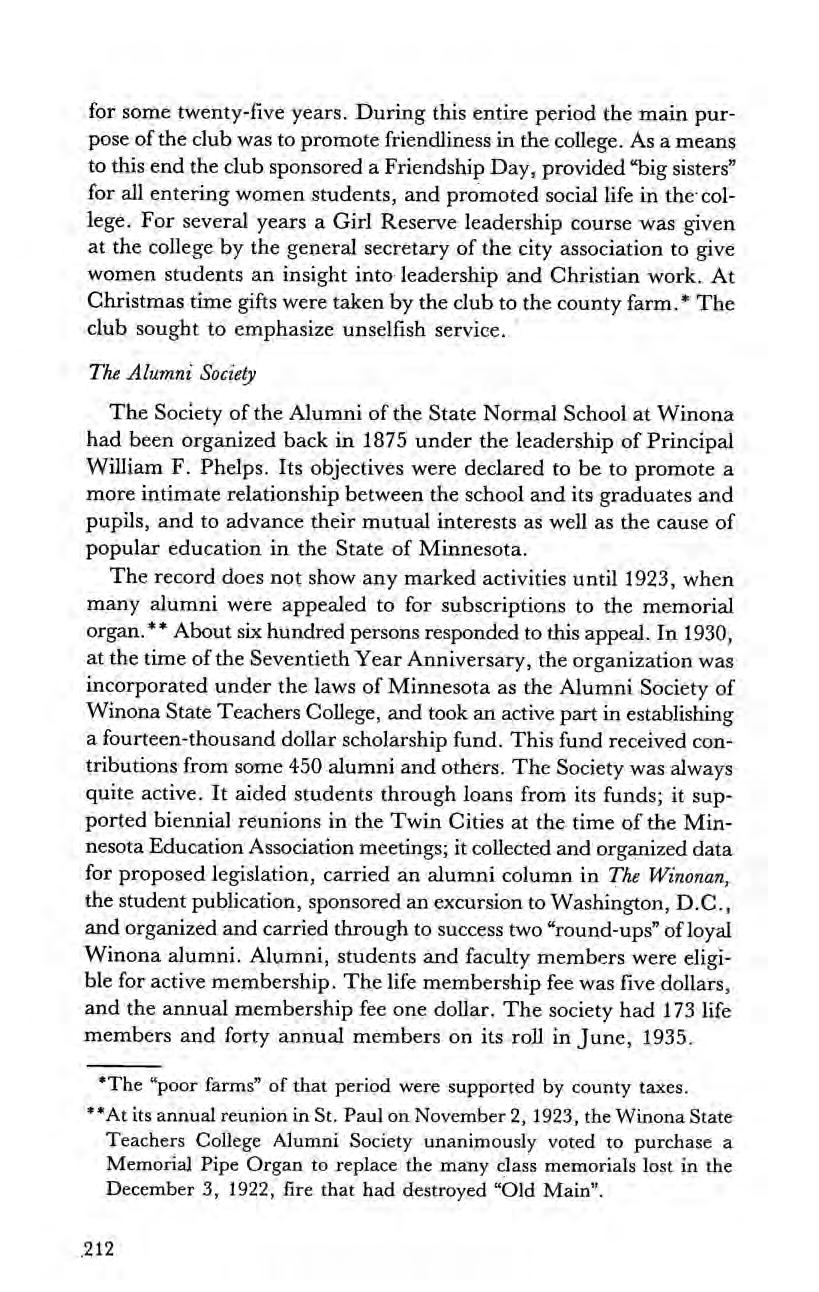
for some twenty-five years. During this entire period the main purpose ofthe club was to promote friendliness in the college. As a means to this end the club sponsored a Friendship Day, provided “big sisters” for all entering women students, and promoted social life in the college. For several years a Girl Reserve leadership course was given at the college by the general secretary of the city association to give women students an insight into leadership and Christian work. At Christmas time gifts were taken by the club to the county farm.* The club sought to emphasize unselfish service.
The Society of the Alumni of the State Normal School at Winona had been organized back in 1875 under the leadership of Principal William F. Phelps. Its objectives were declared to be to promote a more intimate relationship between the school and its graduates and pupils, and to advance their mutual interests as well as the cause of popular education in the State of Minnesota.
The record does not show any marked activities until 1923, when many alumni were appealed to for subscriptions to the memorial organ.** About six hundred persons responded to this appeal. In 1930, at the time of the Seventieth Year Anniversary, the organization was incorporated under the laws of Minnesota as the Alumni Society of Winona State Teachers College, and took an active part in establishing a fourteen-thousand dollar scholarship fund. This fund received contributions from some 450 alumni and others. The Society was always quite active. It aided students through loans from its funds; it supported biennial reunions in the Twin Cities at the time of the Minnesota Education Association meetings; it collected and organized data for proposed legislation, carried an alumni column in The Winonan, the student publication, sponsored an excursion to Washington, D.C., and organized and carried through to success two “round-ups” ofloyal Winona alumni. Alumni, students and faculty members were eligible for active membership. The life membership fee was five dollars, and the annual membership fee one dollar. The society had 173 life members and forty annual members on its roll in June, 1935.
*The “poor farms” of that period were supported by county taxes.
**At its annual reunion in St. Paul on November 2, 1923, the Winona State Teachers College Alumni Society unanimously voted to purchase a Memorial Pipe Organ to replace the many class memorials lost in the December 3, 1922, fire that had destroyed “Old Main”.
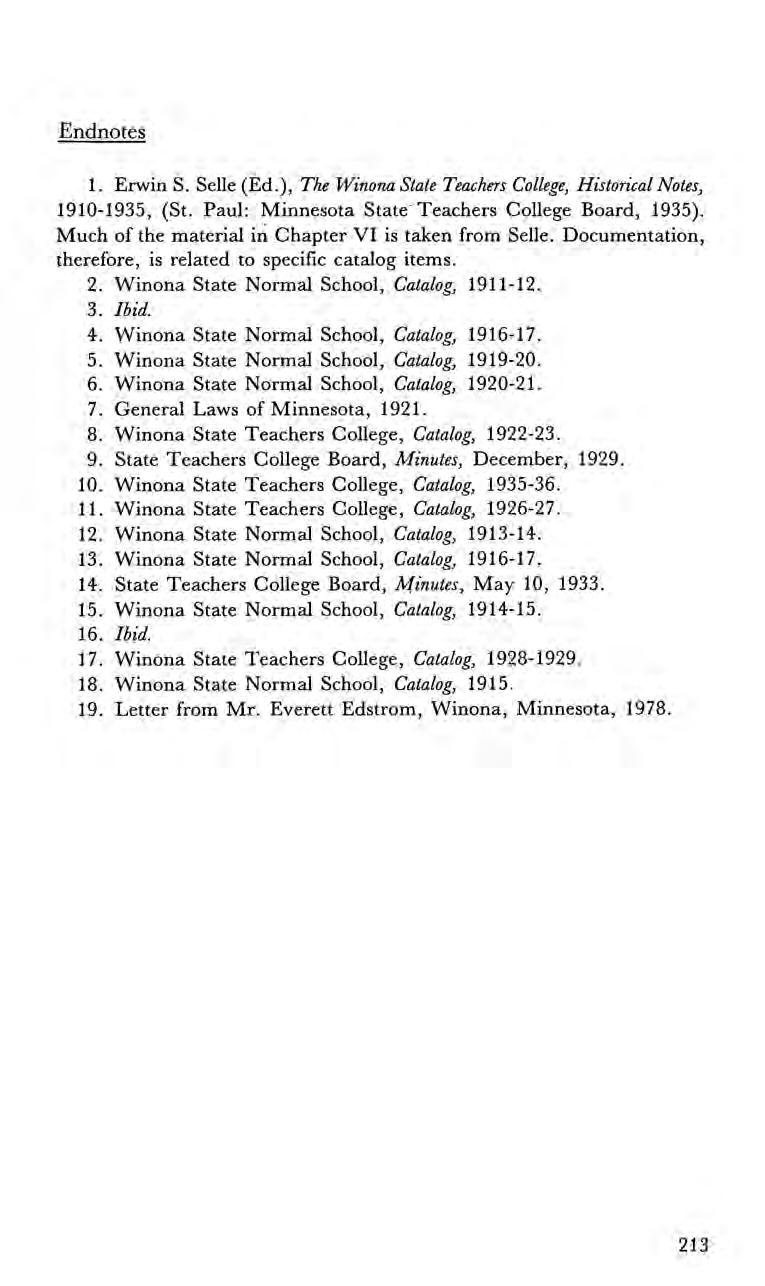
1. Erwin S. Selle (Ed.), The Winona State Teachers College, Historical Notes, 1910-1935, (St. Paul: Minnesota State’ Teachers College Board, 1935). Much of the material in Chapter VI is taken from Selle. Documentation, therefore, is related to specific catalog items.
2. Winona State Normal School, Catalog, 1911-12.
3. Ibid.
4. Winona State Normal School, Catalog, 1916-17.
5. Winona State Normal School, Catalog, 1919-20.
6. Winona State Normal School, Catalog, 1920-21.
7. General Laws of Minnesota, 1921.
8. Winona State Teachers College, Catalog, 1922-23.
9. State Teachers College Board, Minutes, December, 1929.
10. Winona State Teachers College, Catalog, 1935-36.
11. Winona State Teachers College, Catalog, 1926-27.
12. Winona State Normal School, Catalog, 1913-14.
13. Winona State Normal School, Catalog, 1916-17.
14. State Teachers College Board, Minutes, May 10, 1933.
15. Winona State Normal School, Catalog, 1914-15.
16. Ibid.
17. Winona State Teachers College, Catalog, 1928-1929.
18. Winona State Normal School, Catalog, 1915.
19. Letter from Mr. Everett Edstrom, Winona, Minnesota, 1978.
CHAPTER VII
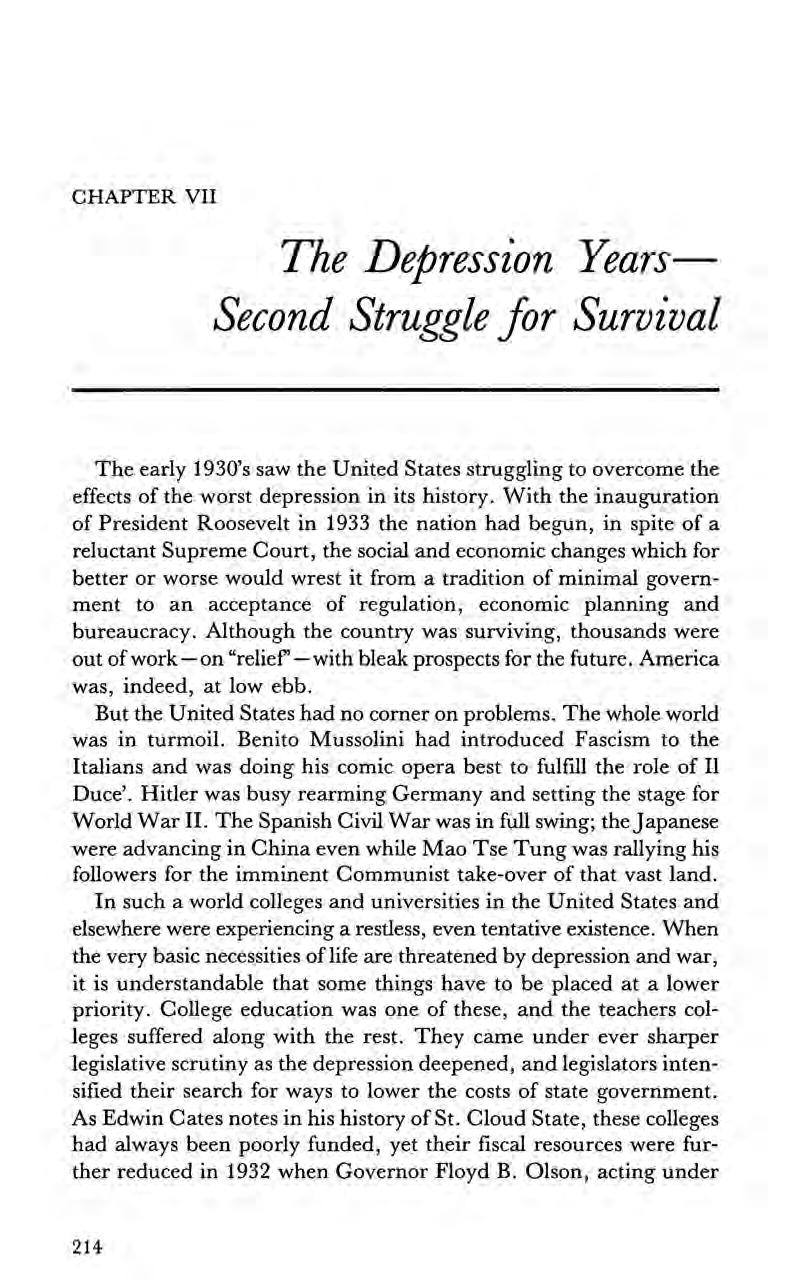
The early 1930’s saw the United States struggling to overcome the effects of the worst depression in its history. With the inauguration of President Roosevelt in 1933 the nation had begun, in spite of a reluctant Supreme Court, the social and economic changes which for better or worse would wrest it from a tradition of minimal government to an acceptance of regulation, economic planning and bureaucracy. Although the country was surviving, thousands were out ofwork on “relief” with bleak prospects for the future.America was, indeed, at low ebb.
But the United States had no corner on problems. The whole world was in turmoil. Benito Mussolini had introduced Fascism to the Italians and was doing his comic opera best to fulfill the role of Il Duce’. Hitler was busy rearming Germany and setting the stage for World War II. The Spanish Civil War was in full swing; theJapanese were advancing in China even while Mao Tse Tung was rallying his followers for the imminent Communist take-over of that vast land.
In such a world colleges and universities in the United States and elsewhere were experiencing a restless, even tentative existence. When the very basic necessities of life are threatened by depression and war, it is understandable that some things have to be placed at a lower priority. College education was one of these, and the teachers colleges suffered along with the rest. They came under ever sharper legislative scrutiny as the depression deepened, and legislators intensified their search for ways to lower the costs of state government. As Edwin Cates notes in his history of St. Cloud State, these colleges had always been poorly funded, yet their fiscal resources were further reduced in 1932 when Governor Floyd B. Olson, acting under

legislative pressure, directed the State Teachers College Board to have all its employees return fifty percent of their salaries for the month ofJune.! A further overall reduction of twenty percent was required by the legislature in 1933, although that one was restored by the 1935 session to about one-half of theloss.”
The insecurity and confusion of faculty and students were made even worse by the efforts of some of the most influential members of the legislature to close some of the campuses. Just how unpleasant the legislative mood turned toward the state teachers colleges during the height of the depression emerges from the hearings conducted by Senator Charles Orr, influential chairman of the senate rules committee and member of the senate finance committee. Orr proposed a legislative investigation to determine whether, in view of teachers being sufficiently providedby the University of Minnesota and the private colleges, it might not be wise to close at least three of the teachers colleges and turn their buildings over to the state to be used as “insane asylums, reform schools or prisons.”?
Chairman A. J. Rockne, also of the senate finance committee, shared that view and urged that the legislature “eliminate by closing” at least three of the campuses. At a committee hearing presidents of three of the state’s private colleges testified to theeffect that:
privately endowed colleges and the university are amply equipped to prepare teachers for high schools, a function that the teachers colleges had usurped;
private colleges cannot compete with teachers colleges with the low tuition rates;
teachers colleges should limit their training to teachers in the elementary grades;
lt would save the taxpayers much money if teachers colleges were turned back to normal schools;
ideals in education must be safeguarded there is too much tendency to develop colleges, even barber colleges.*
Fortunately for the teachers colleges, there were individuals in the legislature who saw things differently and who understood that some ideas and institutions have a value not measurable in dollars, even in times of economic distress. These legislators also realized that, from a practical point of view, there needed to be public institutions for

the retraining of citizens who would need new skills and knowledge when the nation would begin to emerge from the depression. Even though teachers might be in relatively good supply, to suddenly stop their training would impact on the years ahead as older teachers would retire and leave the classroom. The wiser heads prevailed.
Governor Olson,a liberal in his day, was also a believer in higher education and understood its place in the scheme of things. An instance of his thinking can be seen in an innovation that he personally brought about, one which was looked upon as radical in that day although nowadays it would be taken for granted. It was the concept of state supported financial aids.
There was little financial aid for students in the ’30s otherthan the endowed scholarship. A resolution made by the Board at the time ofthe death ofGovernor Olson in 1936 noted that, among other things, he had been the first governor in the United States to obtain specific aid for college and university students from relief funds. The resolution stated in part as follows: “This action of Governor Olson’s was so worthy that it became incorporated in the national relief plan and is now a part of the National Youth Administration, permitting 125,000 students of college age to attend school, 2,600 of whom are attending schools in Minnesota. .”° There appears to be no record of direct help by either the state or the federal government prior to that time.
Whether due to Governor Olson’s efforts or to an optimism generated by Roosevelt’s efforts at the national level, enrollment at Winona State never went lower than the 1935 figure of 388 until after World War II got under way. Interestingly, during this time the proportion of males to females increased in spite of downward enrollment trends. There was a rather dramatic change from a male enrollment figure of about fifteen percent in 1927-28, a figure which had remained constant for many years, to one of nearly thirty percent eight years later. All of the reasons for this change are not entirely clear, but it seems possible to point to two with some confidence. The first quite obviously had to do with the newly established four-year curriculum for secondary teachers. As discussed earlier, men who wanted to teach were far more likely to choose the secondary field rather than the elementary, and up to this time they had only the options of attending a private college or the state university. Now,
with the four-year curriculum in place, the teachers colleges offered a third option.
Another possible reason was simply the lack of employment opportunities. As one writer speculated, under better economic conditions many of these men would have been employed, but since they were unable to find employment they chose to further their education.®
Whatever the reason, this continued to be the trend and eventually reached the stage where males actually began to outnumber females in some disciplines and eventually in total numbers.
Prior to 1933 the college had never charged tuition, not even for out-of-state students. The only requirement was for the student to sign a declaration of intent to teach in the public schools of Minnesota for a period of two years. If a student signed such a declaration and then changed his mind he was obligated to pay back the state at the rate of $20.00 quarterly within two years following graduation.’
In 1933, however, procedures were changed. The two-year teaching pledge option was dropped and in its place was established an acrossthe-board charge of $14.00 per quarter, with an additional five dollars added on for non-residents:®
TABLE VII
Cost Per Quarter, 1933

Strangely enough, faculty membership continued remarkably stable during the depression years in spite of a shortage ofmoney and varia-

tions in enrollment. There was no appreciable change in faculty numbers during the ten years prior to 1935. This, perhaps, was largely due to faculty salaries having been sharply reduced across the board, saving enough money to make it possible to retain people who otherwise would have been forced to leave. Fortunately, also, the downward trend began to reverse itself by 1936. Had it continued to decline there almost certainly would have been layoffs somewhere down the line. Most faculty members during those times ofuncertainty were grateful Just to have jobs.
Qualifications ofthe faculty of the early ’30s were still not particularly high by today’s standards.As late as 1930 there were but five doctorates, although the percentage of master’s degrees had increased. rather satisfactorily from the time of World War I. Improvement, if slow, was at least consistent. The 1938 Board report shows fifteen doctorates, seventy-one master’s degrees, and fourteen bachelor’s degrees on the faculty. That represented a significant improvement over ten years earlier when eight people were teaching with no degree at all.° It was no accident, of course, that this improvement began immediately following Board approval of the four-year degree for high school teachers, because upgrading was an absolute necessity if the degree were to mean anything at all. The faculty did not continue to improve materially after the initial thrust, however. Faculty lists oflater years consistently indicate a relatively low percent ofdoctorates, even up into the ’60s.
Nevertheless, “old timers” will defend those faculties as having shown great loyalty to the institution through the years; people who carried on through the depression, through the War in spite of minimum enrollments and appropriations, through the post-war rebuilding era when there were too many students for the number of faculty and facilities in place to serve them. And who can argue with that view? Dedication must often have been the difference between the failure or success of the struggling, underfinanced, understaffed college. One cannot but wonder how many faculties of the present day would do as well in spite of their many degrees and specialized expertise, important as those may be.
No physical expansion had taken place at theTeachers College since the erection of “College Hall” —laterSomsen Hall—in 1924, replac-
II

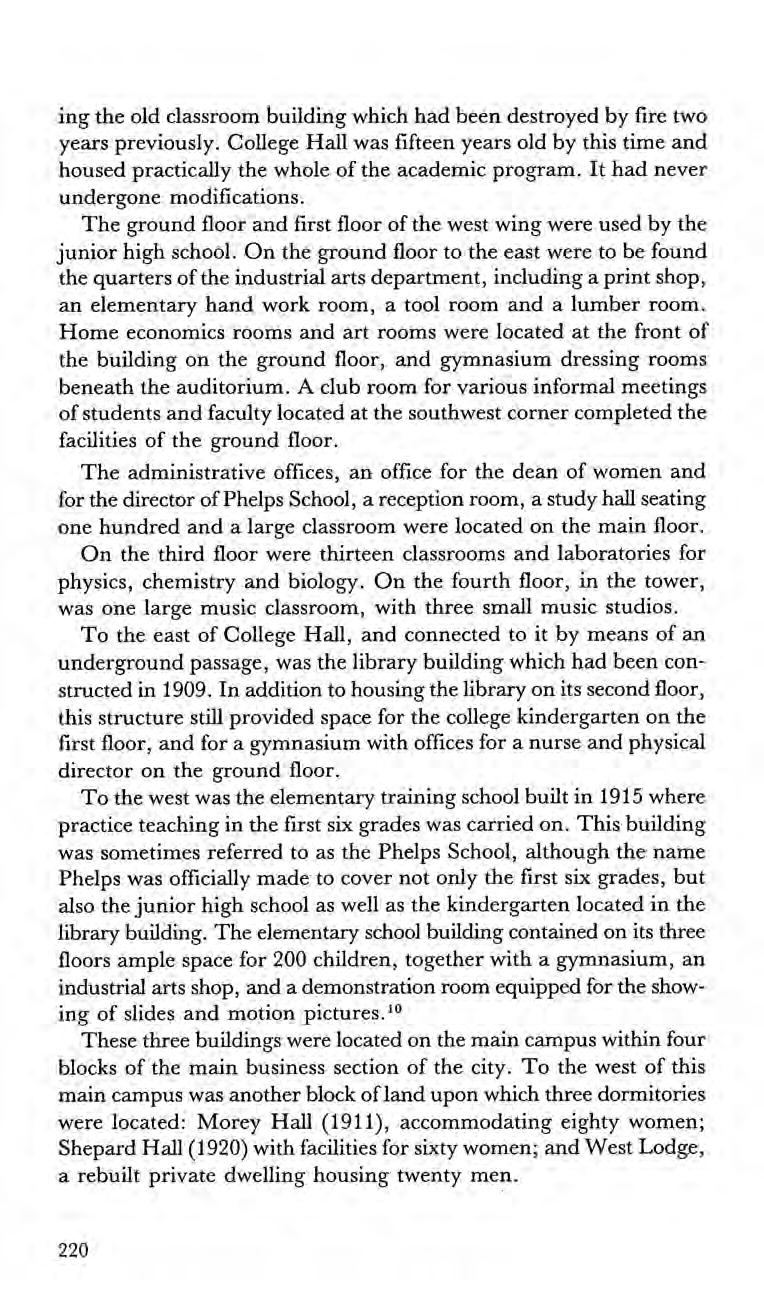
ing the old classroom building which had been destroyed by fire two years previously. College Hall was fifteen years old by this time and housed practically the whole of the academic program. It had never undergone modifications.
The ground floor and first floor of the west wing were used by the junior high school. On the ground floor to the east were to be found the quarters of the industrial arts department, including a print shop, an elementary hand work room, a tool room and a lumber room. Home economics rooms and art rooms were located at the front of the building on the ground floor, and gymnasium dressing rooms beneath the auditorium. A club room for various informal meetings of students and faculty located at the southwest corner completed the facilities of the ground floor.
The administrative offices, an office for the dean of women and for the director ofPhelps School, a reception room, a study hall seating one hundred anda large classroom were located on the main floor.
On the third floor were thirteen classrooms and laboratories for physics, chemistry and biology. On the fourth floor, in the tower, was one large music classroom, with three small music studios.
To the east of College Hall, and connected to it by means of an underground passage, was the library building which had been constructed in 1909. In addition to housing the library on its second floor, this structure still provided space for the college kindergarten on the first floor, and for a gymnasium with offices for a nurse and physical director on the ground floor.
To the west was the elementary training school built in 1915 where practice teaching in the first six grades was carried on. This building was sometimes referred to as the Phelps School, although the name Phelps was officially made to cover not only the first six grades, but also the junior high school as well as the kindergarten located in the library building. The elementary school building contained on its three floors ample space for 200 children, together with a gymnasium, an industrial arts shop, and a demonstration room equipped for the showing of slides and motion pictures.'®
These three buildings were located on the main campus within four blocks of the main business section of the city. To the west of this main campus was another block ofland upon which three dormitories were located: Morey Hall (1911), accommodating eighty women; Shepard Hall (1920) with facilities for sixty women; and West Lodge, a rebuilt private dwelling housing twenty men.
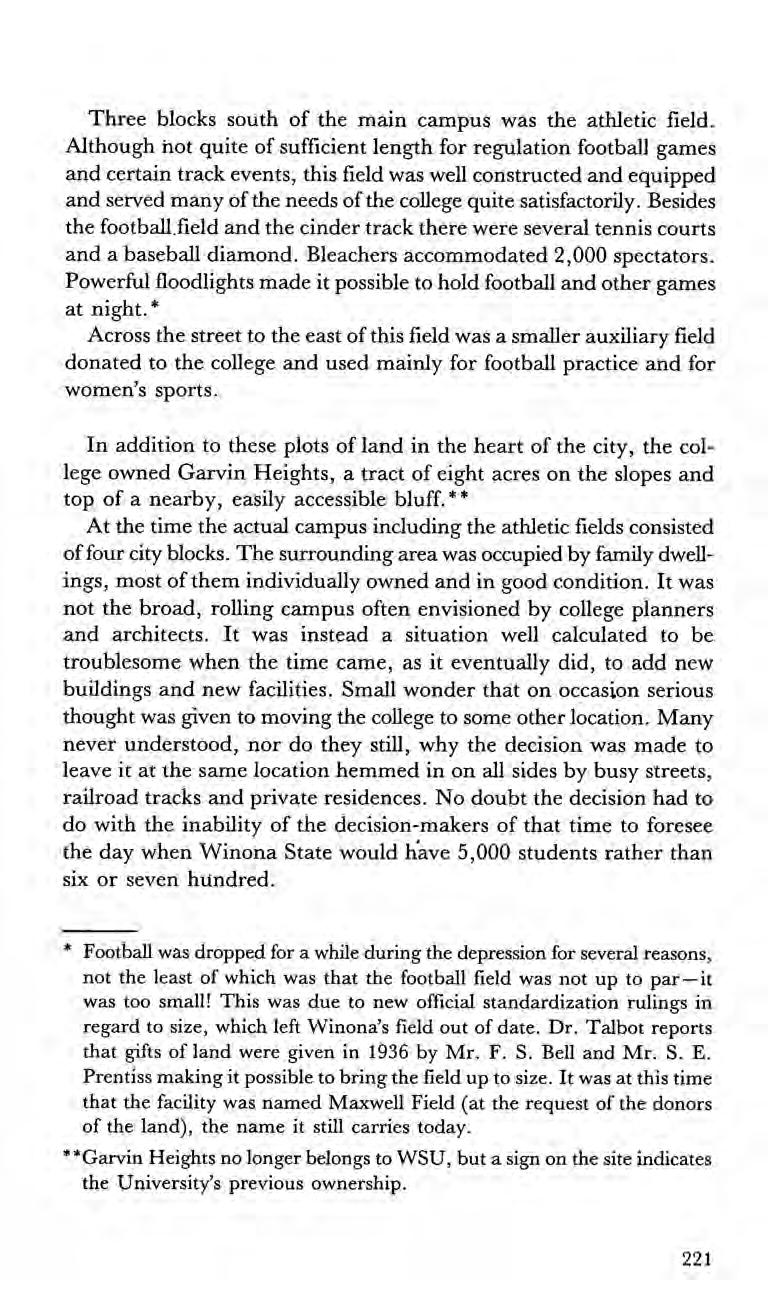
Three blocks south of the main campus was the athletic field. Although not quite of sufficient length for regulation football games and certain track events, this field was well constructed and equipped and served many ofthe needs ofthe-college quite satisfactorily. Besides the football field and the cinder track there were several tennis courts and a baseball diamond. Bleachers accommodated 2,000 spectators. Powerful floodlights made it possible to hold football and other games at night.*
Across the street to the east of this field was a smaller auxiliary field donated to the college and used mainly for football practice and for women’s sports.
In addition to these plots of land in the heart of the city, thecollege owned Garvin Heights, a tract of eight acres on the slopes and top of a nearby, easily accessible bluff.**
At the time theactual campus including the athletic fields consisted offour city blocks. ‘The surrounding area was occupied by family dwellings, most of them individually owned and in good condition. It was not the broad, rolling campus oftenenvisioned by college planners and architects. It was instead a situation well calculated to be troublesome when the time came, as it eventually did, to add new buildings and new facilities. Small wonder that on occasion serious thought was given to moving the college to some other location. Many never understood, nor do they still, why the decision was made to leave it at the same location hemmed in on all sides by busy streets, railroad tracks and private residences. No doubt the decision had to do with the inability of the decision-makers of that time to foresee the day when Winona State would have 5,000 students rather than six or seven hundred.
Football was dropped for a while during the depression for several reasons, not the least of which was that the football field was not up to par—it was too small! This was due to new official standardization rulings in regard to size, which left Winona’s field out of date. Dr. Talbot reports that gifts of land were given in 1936 by Mr. F. S. Bell and Mr. S. E. Prentiss making it possible to bring the field up to size. It was at this time that the facility was named Maxwell Field (at the request of the donors of the land), the name it still carries today.
**Garvin Heights no longer belongs to WSU, but a sign on the site indicates the University’s previous ownership.

It is understandable that little could be done by way of expanding physical facilities during the depression years. Reduced enrollments, low appropriations and a general lack of forward motion practically precluded even considering such a thing. It comes as something of a surprise, therefore, to find the State Teachers College Board in its biennial report to the Governor in November of 1938 reporting as follows with reference to Winona State:
“., the college is about to be provided with a new library, secured through the U.S. Emergency Administration of Public Works, which approveda preliminary grant of $41,130 to match the amount of $50,270 which came to the college as a combined gift of twenty-eight donors.”!! The Executive Council of the State also allocated $12,000 toward the project so that as a result of the three sources, the State purchased an adjacent off-campus site extending 120 X 140 feet upon which to locate a new building.
But the new library was not all. A second building and ground addition to the college plant came in the form of a gift by Miss Ruth Lucas to the State ofher home located some five blocks from the main campus, the property to be used as a much needed dormitory. The Board recommended the acceptance of the gift and named the house “Lucas Lodge” in honor of John W. Lucas.*
The report went on to recognize President Maxwell’s work in obtaining these facilities:
President Maxwell of the Winona College along with the generous donors who made it possible are to be sincerely thanked for the two extremely valuable gifts which came to the State and the college this year. The Board believes that by reason of the President’s activity and the high esteem in which he is held, a splendid library and a most useful dormitory have been donated to the State. These gifts further evidence the fact that the College is held in high esteem by the citizens of Minnesota, which is, in itself, grounds for felicitation.!”
The cornerstone laying took place on September 20, 1938, and the building was completed in May of the following year. At the dedica-
* Lucas Lodge today is the Winona County Red Cross building.

tion in June it was named, at the request of the faculty, Maxwell Library.
Anda splendid building it was! It boasted self-supporting stacks and the first air conditioning in the Teachers College System, one which directed air through a network of cold water pipes which drew off the heat and fedthe cool air into a system of ducts.*
Maxwell Library was and still is the. one such example of private donations going to finance an academic building in the State Teachers College System. There had been gifts to the various colleges of buildings built and used for other purposes, as was Lucas Lodge, but a development in which one-half the cost of an academic building would come from the pockets of several private donors was unique. It did, as the Board recognized, exemplify President Maxwell’s ability and the esteem in which he was held, as well as to underline the continuing support of the Winona community for its Teachers College. The fact that there were two private colleges located in Winona which, in common with all private schools, received most of their income from the private sector, made the accomplishment that much more spectacular. ‘The next major building was not to be undertaken until 1952.
The teachers colleges, not only of Minnesota, but in most states, were anything but high prestige institutions. Their humble beginnings as one-year training schools with lower requirements even than high schools ofthe day kept them in a category all their own. Even after they finally began to offer the four-year degree and to educate people for teaching at the secondary level, they continued to be viewed as poor relation by many in the academic world. There were, to be sure, genuine differences in the philosophy and practice of private schools and universities as compared with the teachers colleges, but whether those differences were as profound as some made them out to be continues to be a question. Much has always been made of the alleged emphasis on methodology in the teachers colleges, usually comparing it with the emphasis on the liberal arts in the private schools. But,
*It worked effectively up until a modern unit was installed with the new addition in 1968, one which still was not working properly twelve years later!
especially on the secondary level, the argument seems to have been overdrawn, and even on the elementary level thedifferences were often more apparent than real.
Nevertheless there can be little doubt that in the early years of the four-year degree program there was much to-be desired academically among the teachers colleges. When one recalls that Winona, for example, had for seventy years offered only one or two-year teacher training programs designed for and restricted to the elementary field, the changes which had to come about in moving to the four-year curriculum can readily be appreciated. It called not only for a different faculty and facilities, but for a rather complete revision of attitudes and philosophy among those already present.
It can be assumed that many of the “old timers” never quite made the transition and, given the state of the economy, it took a while before a new faculty with new ideas could be brought in. The Teachers College Board certainly had no illusions, as can be seen in the fact that in 1932 it decided against allowing the Teachers Colleges even to apply for accreditation, for fear of rejection, which almost certainly would have been the case.*"?
The year 1935 marked the 75th Anniversary of the College. Winona Teachers College had a right to be proud of its history. In this young country, 75 years represented a span of time and service matched by few other institutions of any kind in Minnesota. By 1935 it had trained hundreds of teachers, most of whom had served in the rural and city elementary schools of the state. It had established itselfwithin the system as a good, stable, well-administered campus. It was only fitting that a celebration should be held. To that end, the 1935 Commencement was also a 75th year celebration, and appears to have been a highly successful event.

*This actually was the case nine years later when St. Cloud was turned down for membership in the North Central Association.
by
Harold and. Everett Edstrom, Directors
Hall of Fame, Grand March
Light Cavalry, Overture
Peer Gynt Suite
1. The Morning
2. Ase’s Death
3. Anitra’s Dance
4. In the Hall of the Mountain King
Sounds from the Hudson
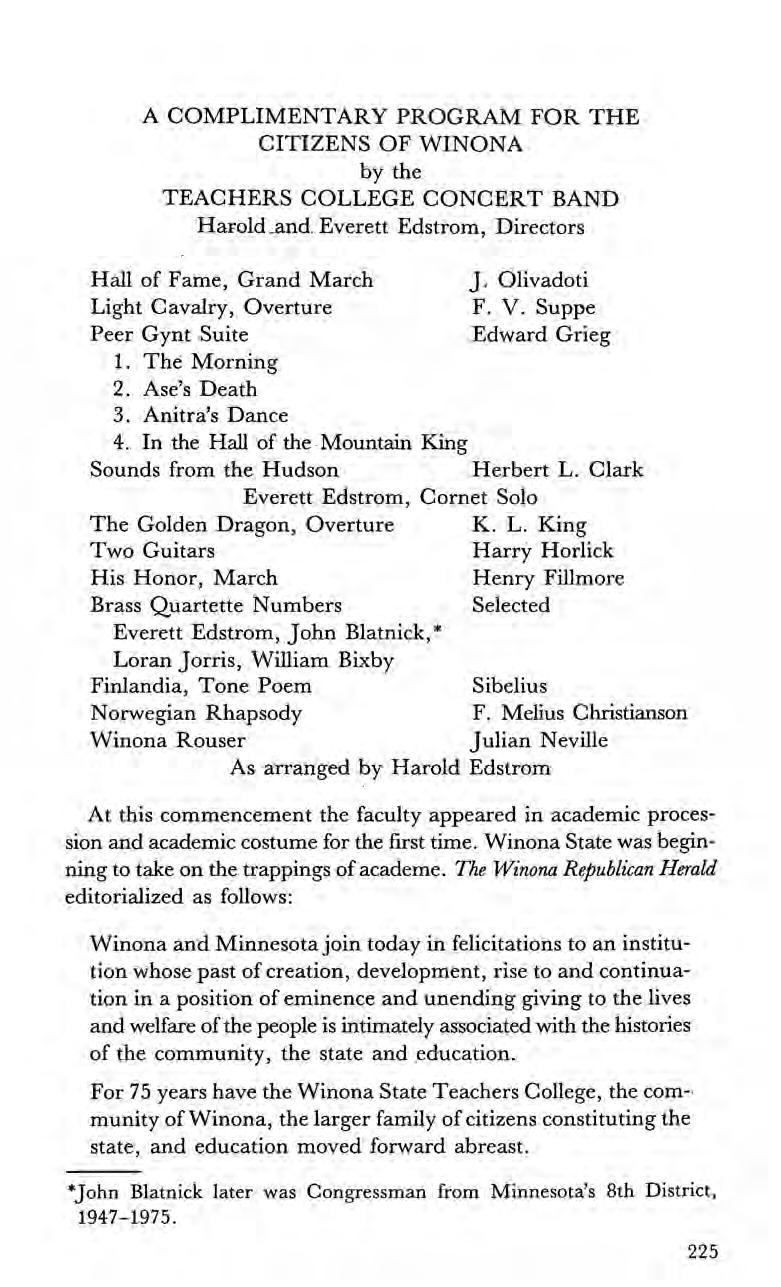
J. Olivadoti
F. V. Suppe
Edward Grieg
Herbert L. Clark
Everett Edstrom, Cornet Solo
The Golden Dragon, Overture
Two Guitars
His Honor, March
Brass Quartette Numbers
Everett Edstrom, John Blatnick,*
Loran Jorris, William Bixby
Finlandia, Tone Poem
Norwegian Rhapsody
Winona Rouser
K. L. King
Harry Horlick
Henry Fillmore
Selected
Sibelius
F. Melius Christianson
Julian Neville
As arranged by Harold Edstrom
At this commencement the faculty appeared in academic procession and academic costume for the first time. Winona State was beginning to take on the trappings of academe. The Winona Republican Herald editorialized as follows:
Winona and Minnesota join today in felicitations to an institution whose past of creation, development, rise to and continuation in a position of eminence and unending giving to the lives and welfare ofthe people is intimately associated with the histories of the community, the state and education.
For 75 years have the Winona State Teachers College, the community of Winona, the larger family of citizens constituting the state, and education moved forward abreast.
*John Blatnick later was Congressman from Minnesota’s 8th District, 1947-1975.
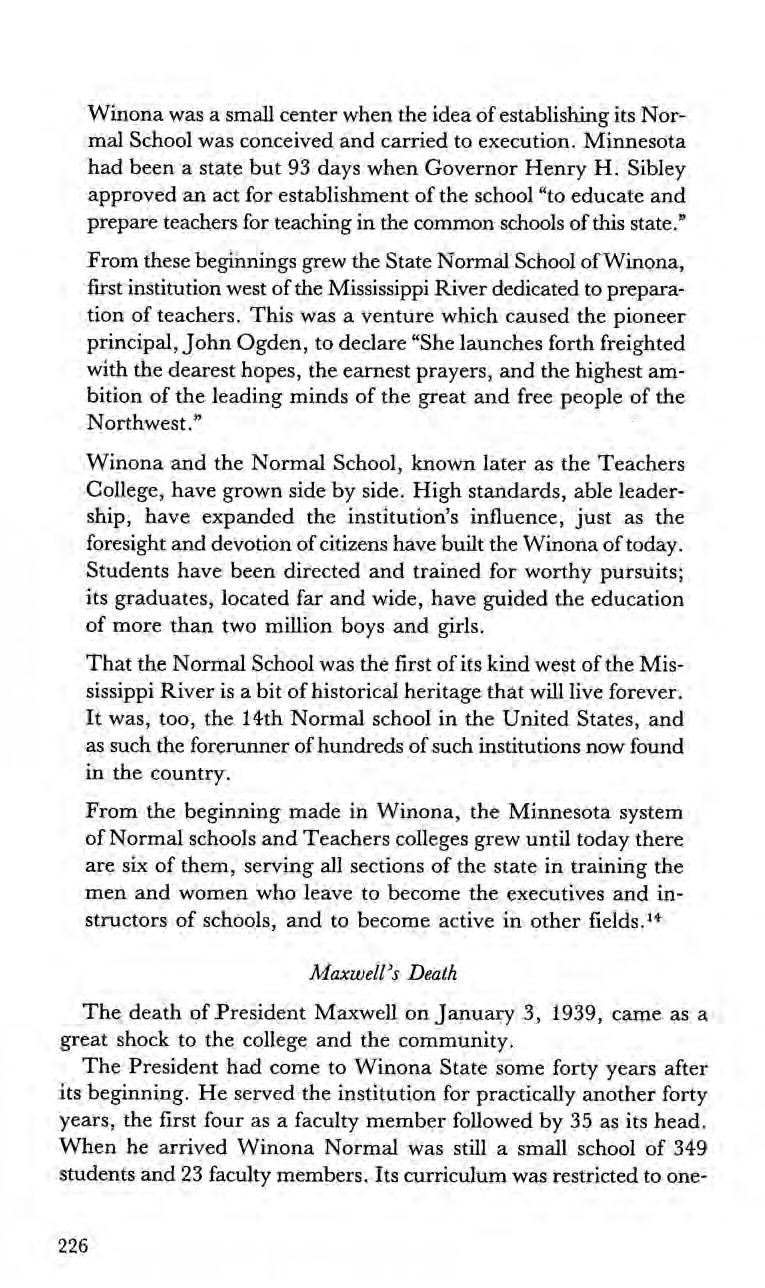
Winona was a small center when the idea of establishing its Normal School was conceived and carried to execution. Minnesota had beena state but 93 days when Governor Henry H. Sibley approved an act for establishment of the school “to educate and prepare teachers for teaching in the common schools ofthis state.”
From these beginnings grew the State Normal School ofWinona, first institution west ofthe Mississippi River dedicated to preparation of teachers. This was a venture which caused the pioneer principal, John Ogden, to declare “She launches forth freighted with the dearest hopes, the earnest prayers, and the highest ambition of the leading minds of the great and free people of the Northwest.”
Winona and the Normal School, known later as the Teachers College, have grown side by side. High standards, able leadership, have expanded the institution’s influence, just as the foresight and devotion of citizens have built the Winona oftoday. Students have been directed and trained for worthy pursuits; its graduates, located far and wide, have guided the education of more than two million boys and girls.
That the Normal School was the first of its kind west of the Mississippi River is a bit of historical heritage that will live forever. It was, too, the 14th Normal school in the United States, and as such the forerunner of hundreds of such institutions now found in the country.
From the beginning made in Winona, the Minnesota system of Normal schools and Teachers colleges grew until today there are six of them, serving all sections of the state in training the men and women who leave to become the executives and instructors of schools, and to become active in other fields. !+
The death of President Maxwell on January 3, 1939, came as a great shock to the college and the community.
The President had come to Winona State some forty years after its beginning. He served the institution for practically another forty years, the first four as a faculty member followed by 35 as its head. When he arrived Winona Normal was still a small school of 349 students and 23 faculty members. Its curriculum was restricted to one-
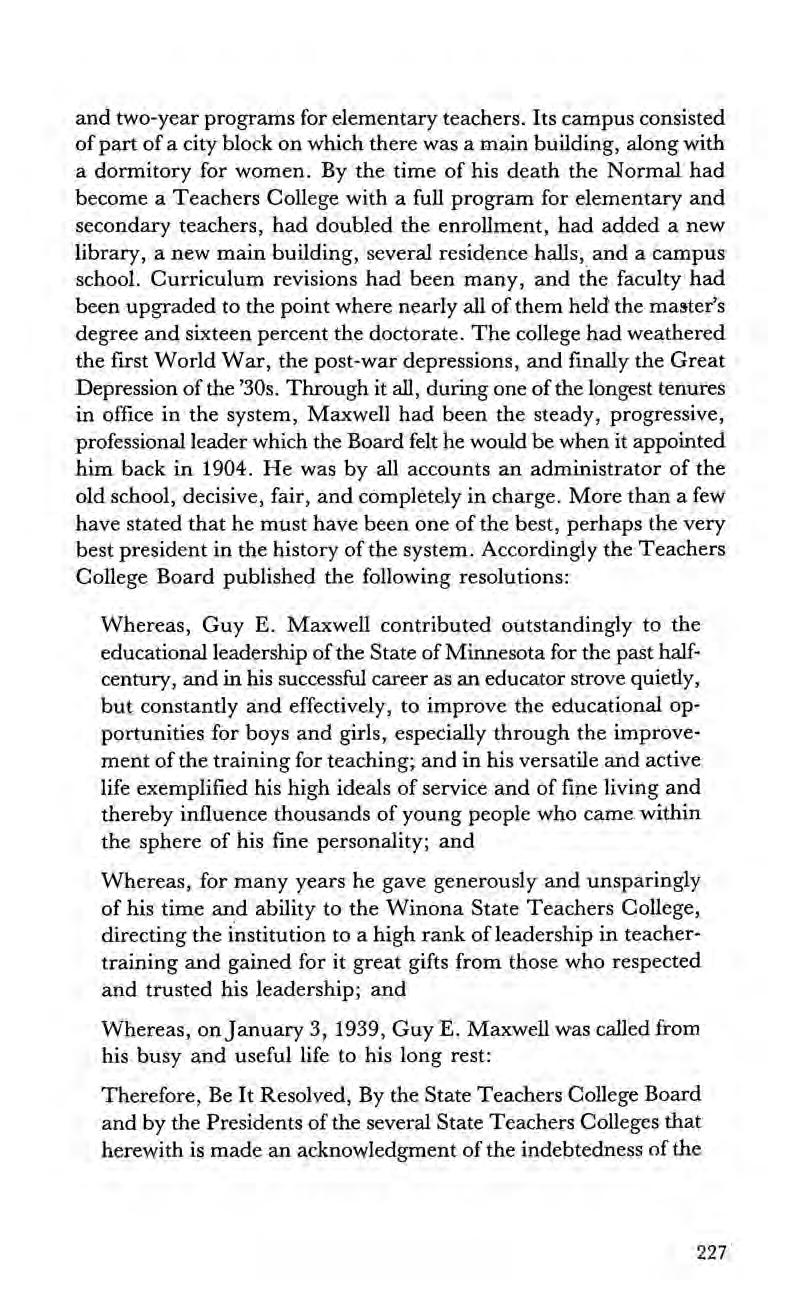
and two-year programs for elementary teachers. Its campus consisted of part of a city block on which there was a main building, along with a dormitory for women. By the time of his death the Normal had become a Teachers College with a full program for elementary and secondary teachers, had doubled the enrollment, had added a new library, a new main building, several residence halls, and a campus school. Curriculum revisions had been many, and the faculty had been upgraded to the point where nearly all of them held the master’s degree and sixteen percent the doctorate. The college had weathered the first World War, the post-war depressions, and finally the Great Depression of the 30s. Through it all, during one of the longest tenures in office in the system, Maxwell had been the steady, progressive, professional leader which the Board felt he would be when it appointed him back in 1904. He was by all accounts an administrator of the old school, decisive, fair, and completely in charge. More than a few have stated that he must have been one of the best, perhaps the very best president in the history of the system. Accordingly the Teachers College Board published the following resolutions:
Whereas, Guy E. Maxwell contributed outstandingly to the educational leadership ofthe State of Minnesota for the past halfcentury, and in his successful career as an educator strove quietly, but constantly and effectively, to improve the educational opportunities for boys and girls, especially through the improvement of the training for teaching; and in his versatile and active life exemplified his high ideals of service and of fine living and thereby influence thousands of young people who came within the sphere of his fine personality; and Whereas, for many years he gave generously and unsparingly of his time and ability to the Winona State Teachers College, directing the institution to a high rank of leadership in teachertraining and gained for it great gifts from those who respected and trusted his leadership; and
Whereas, on January 3, 1939, Guy E. Maxwell was called from his busy and useful life to his long rest:
Therefore, Be It Resolved, By the State Teachers College Board and by thePresidents of the several State Teachers Colleges that herewith is made an acknowledgment of the indebtedness of the

State of Minnesota to Guy E. Maxwell, a faithful public servant, who served his state and nation so wisely and well; and
Be It Further Resolved, That a copy of this resolution be made part of the minutes of the Board and that copies of the same be sent to his faithful and loving helpmate, Mrs. Maxwell, and to each of his three sons.'5
That same day the Board appointed Professor A. T. French acting president. Mr. French had been for years, vice-president of the college and a member of the faculty. He was well respected and a person in whom the faculty had a great deal of confidence.
At the same time a committee was set up by the Board for the purpose of reviewing applications for the position. Mr. French was an applicant, and Director Sauer spoke strongly on his behalf on the day the final appointment was to be made. The members of the Board, however, concluded that Mr. French was too close to retirement to give hima full-time appointment, and aftermuch discussion, elected the search committee’s top choice, Dr. O.Myking Mehus, to be the seventh president ofWinona State Teachers College.'!® He was to take office at the Spring Commencement of June, 1939.
Mehus was a graduate ofAugustana College in St. Paul and a Ph.D. from the University ofNorth Dakota. He was a member ofthe Social Studies faculty of Northwest Missouri State College, Maryville, when he became a candidate for the Winona position. He was a believer in liberal causes, an activist, well ahead of his time in his thinking on social and political issues. One observer notes that the college community had long been accustomed to making adjustments as the college gradually changed over the years, but that under President Maxwell’s experienced leadership, the changes had been so well anticipated and gradual that they were scarcely felt.17 Now a new kind of adjustment was required of both students and faculty members as they became acquainted with President Mehus, a man new to the state teachers college system and unfamiliar with its history. It is clear that Mehus shookthe place up a bit, perhaps to the point of making things uncomfortable for a lot of people. He soon reorganized the faculty into seven academic divisions each headed by a person with a terminal degree in his academic field. While that organizational pattern was nothing new among colleges, it seemed a radical change to
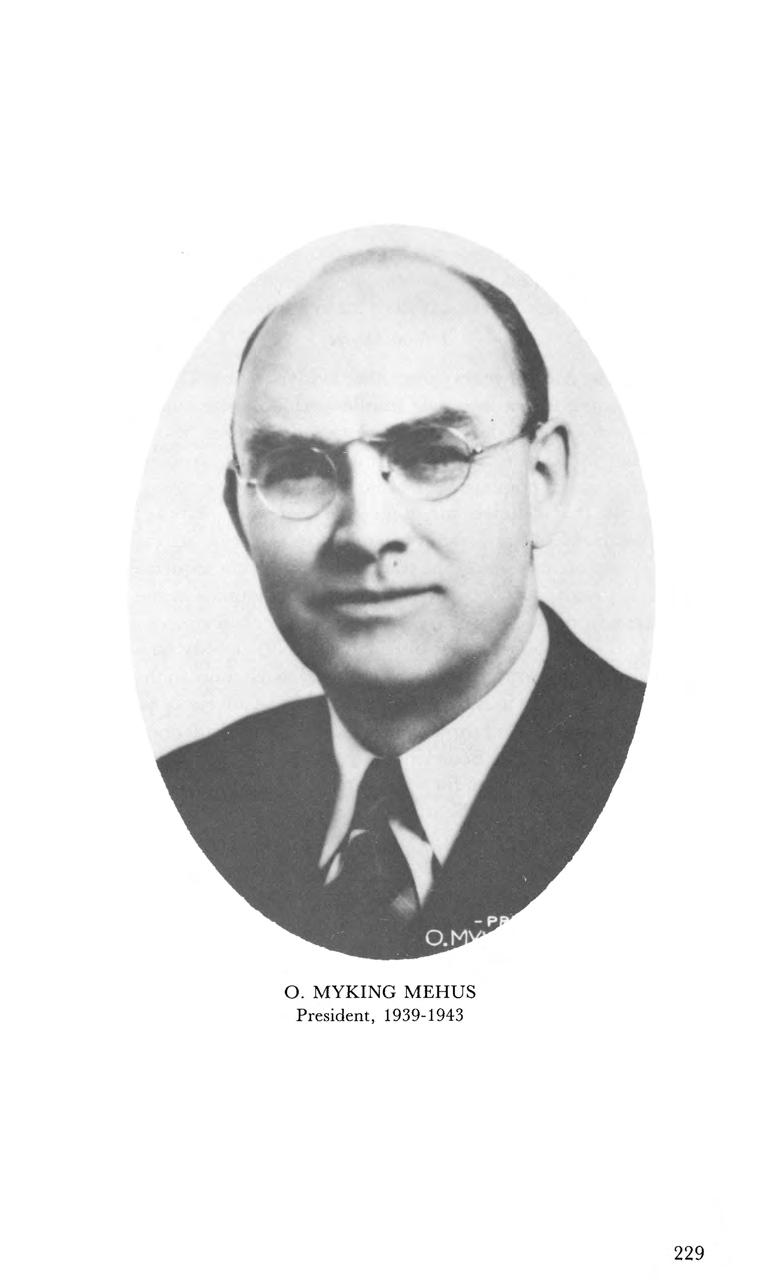
President, 1939-1943
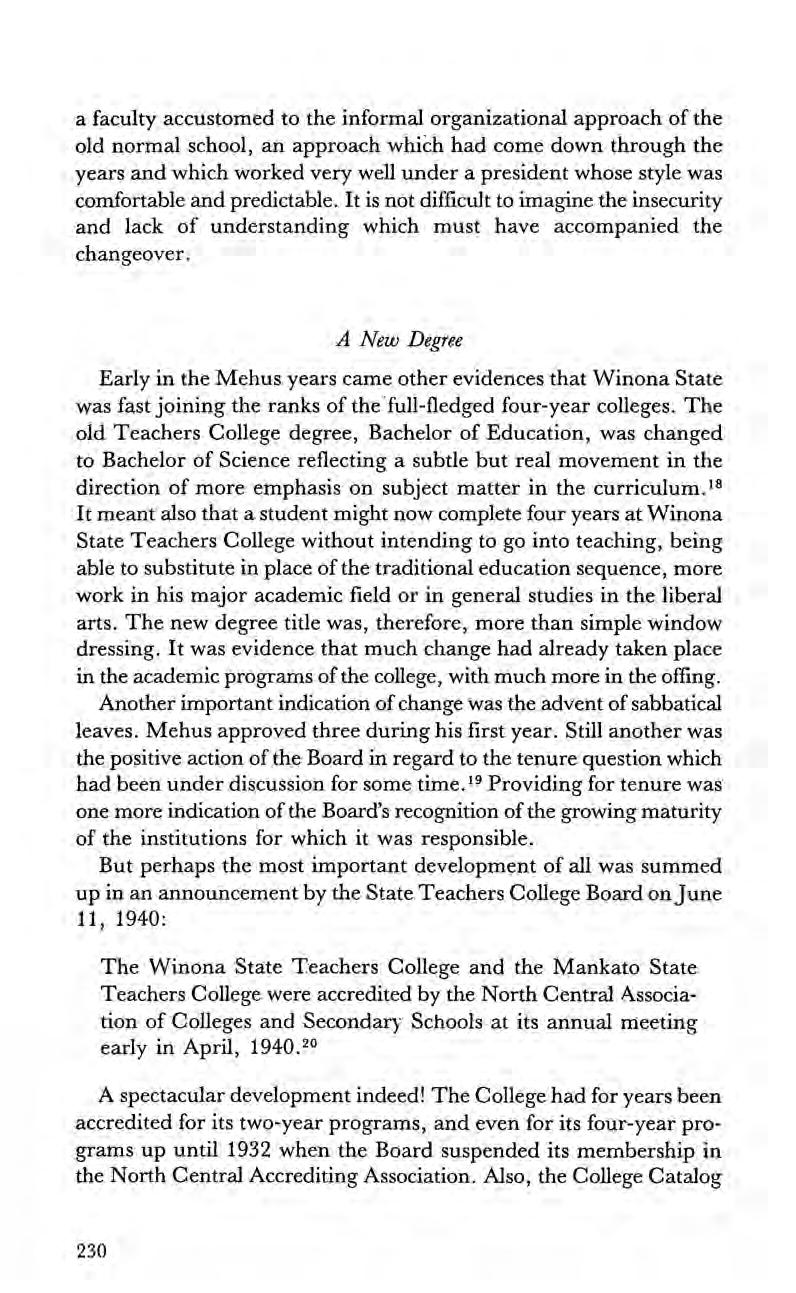
a faculty accustomed to the informal organizational approach of the old normal school, an approach which had come down through the years and which worked very well under a president whose style was comfortable and predictable. It is not difficult to imagine the insecurity and lack of understanding which must have accompanied the changeover.
Early in the Mehus years came other evidences that Winona State was fast joining the ranks of the full-fledged four-year colleges. The old Teachers College degree, Bachelor of Education, was changed to Bachelor of Science reflecting a subtle but real movement in the direction of more emphasis on subject matter in the curriculum.'® It meant also that a student might now complete four years at Winona State Teachers College without intending to go into teaching, being able to substitute in place of the traditional education sequence, more work in his major academic field or in general studies in the liberal arts. The new degree title was, therefore, more than simple window dressing. It was evidence that much change had already taken place in the academic programs ofthe college, with much more in the offing. Another important indication of change was the advent of sabbatical leaves. Mehus approved three during his first year. Still another was the positive action of the Board in regard to the tenure question which had been under discussion for some time.!® Providing for tenure was one more indication of theBoard’s recognition of the growing maturity of the institutions for which it was responsible.
But perhaps the most important development of all was summed up in an announcement by the State Teachers College Board on June 11, 1940:
The Winona State Teachers College and the Mankato State Teachers College were accredited by the North Central Associa~ tion of Colleges and Secondary Schools at its annual meeting early in April, 1940.?°
A spectacular development indeed! The College had for years been accredited for its two-year programs, and even for its four-year programs up until 1932 when the Board suspended its membership in the North Central Accrediting Association. Also, the College Catalog
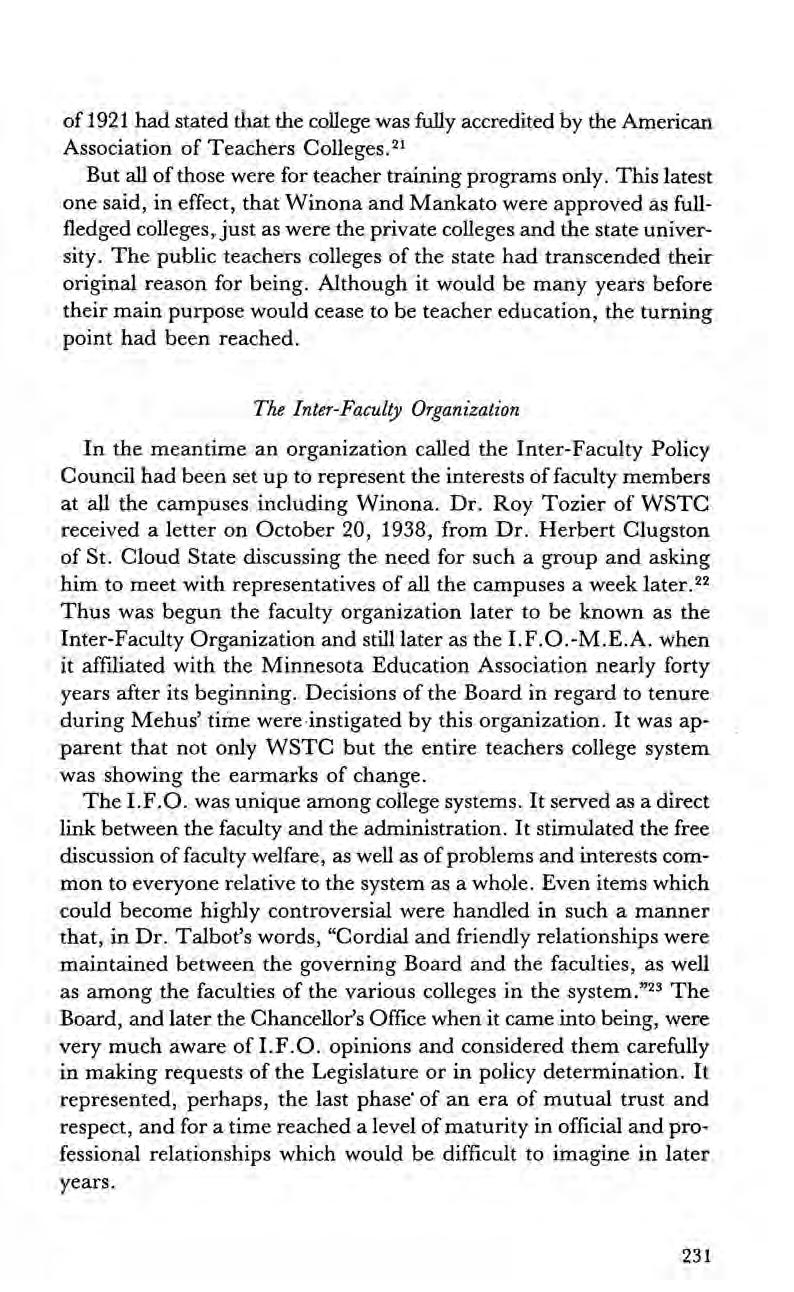
of 1921 had stated that the college was fully accredited by the American Association of Teachers Colleges.?!
But all of those were for teacher training programs only. This latest one said, in effect, that Winona and Mankato were approved as fullfledged colleges,just as were the private colleges and the state university. The public teachers colleges of the state had transcended their original reason for being. Although it would be many years before their main purpose would cease to be teacher education, the turning point had been reached.
In the meantime an organization called the Inter-Faculty Policy Council had been set up to represent the interests of faculty members at all the campuses including Winona. Dr. Roy Tozier of WSTC received a letter on October 20, 1938, from Dr. Herbert Clugston of St. Cloud State discussing the need for such a group and asking him to meet with representatives of all the campuses a week later.?? Thus was begun the faculty organization later to be known as the Inter-Faculty Organization and stilllater as the 1.F.O.-M.E.A. when it affiliated with the Minnesota Education Association nearly forty years after its beginning. Decisions of the Board in regard to tenure during Mehus’ time were instigated by this organization. It was apparent that not only WSTC but the entire teachers college system was showing the earmarks of change.
The I.F.O. was unique among college systems. It served as a direct link between the faculty and the administration. It stimulated the free discussion of faculty welfare, as well as of problems and interests common to everyone relative to the system as a whole. Even items which could become highly controversial were handled in such a manner that, in Dr. Talbot’s words, “Cordial and friendly relationships were maintained between the governing Board and the faculties, as well as among the faculties of the various colleges in the system.”*? The Board, and later the Chancellor’s Office when it came into being, were very much aware of I.F.O. opinions and considered them carefully in making requests of the Legislature or in policy determination. It represented, perhaps, thelast phase’ of anera of mutual trust and respect, and for a time reacheda level of maturity in official and professional relationships which would be difficult to imagine in later years.

Meanwhile President Mehus had run into difficulties with his Board, difficulties which eventuated in his resignation after four years in office. Events which surrounded his leaving remain somewhat obscure, but conjecture by the college community was generally to the effect that he was the victim of errors of his own as well as of the fact that there were individuals who did not agree with his “radical” views, and wanted him out of office. Whatever the reason, he left in the spring of 1943 to accept a position as chief of the Vocational Rehabilitation and Education Division of the Veterans Administration in Kansas City.
The United States, emerging from the severest depression in its history, had little desire to become embroiled in the war which by 1940 was raging in Europe. America’s isolationists strongly influenced the nation’s foreignpolicy, and even the adroit leadership of Franklin Roosevelt, by then an unprecedented third-term President, could barely swing critical economic and military aid to Britain, which was hanging on until, as Curchill put it, “. . in God’s good time the New World, with all its power and might, will step forth to the rescue and liberation of theold.”?*
Japan solved the problem on December 7, 1941, when she bombed Pearl Harbor killing 2,335 American servicemen and 68 civilians. Congress voted to declare. war the next day.
By the time Mehus left office the U.S. was so deeply involved in the war that hardly anything else seemed to count. The commitment and overall impact on the country was much greater than that ofWorld War I. There were few institutions of any kind which could continue business as usual.
If the college maintained its normal enrollment level during 1917 and 1918, the situation was reversed in the 1940s. The country’s resources, both material and human, were practically all concentrated on the war effort, and the effect ofthis on the college’s finances, equipment, buildings, and particularly enrollment were devastating. Some 300,000 men were going into the armed forces from Minnesota alone, and both men and women were increasingly being employed in industry and other war-related endeavors. In'1939 Winona State’s enrollment was over five hundred. Five years later it numbered less than two hundred. Small wonder that the 1943 legislature again considered
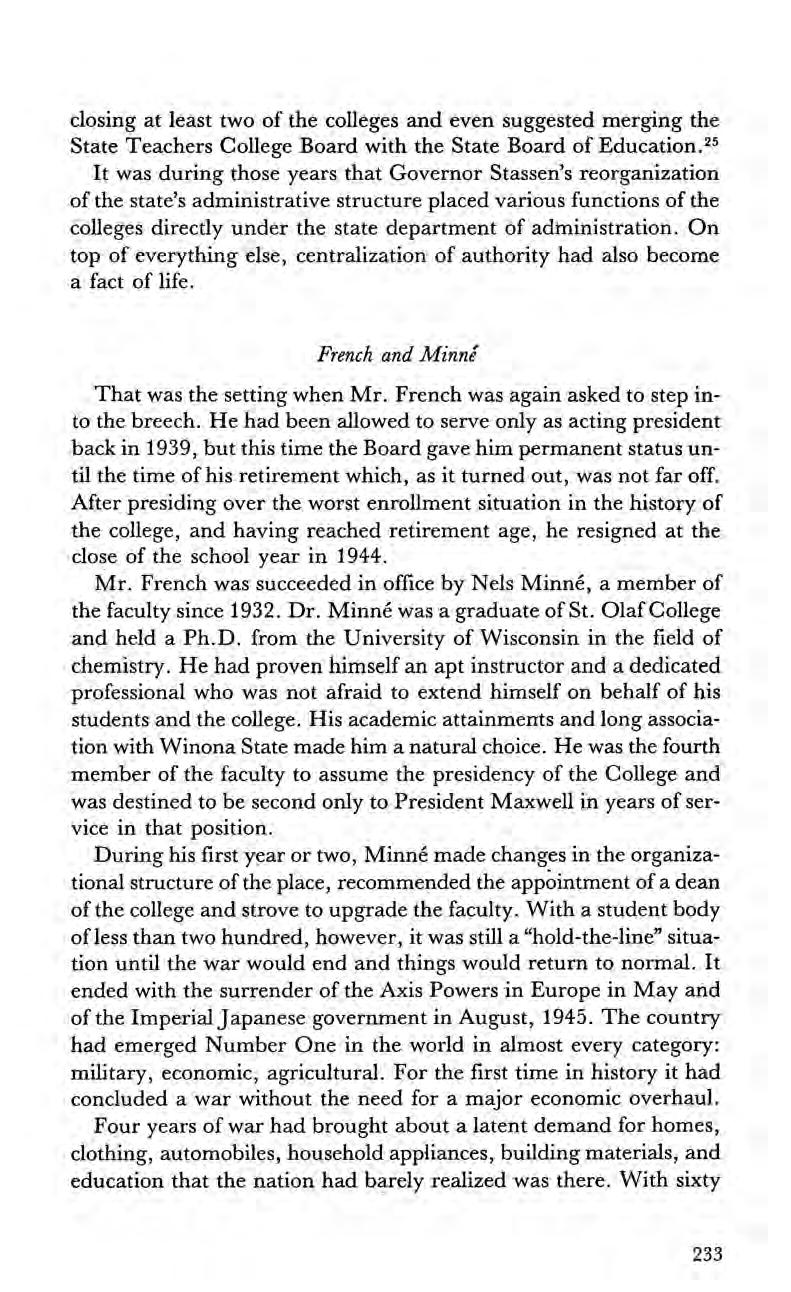
closing at least two of the colleges and even suggested merging the State Teachers College Board with the State Board of Education.*®
It was during those years that Governor Stassen’s reorganization of the state’s administrative structure placed various functions of the colleges directly under the state department of administration. On top of everything else, centralization of authority had also become a fact of life.
That was the setting when Mr. French was again asked to step into thebreech. He had been allowed to serve only as acting president back in 1939, but this time the Board gave him permanent status until the time of his retirement which, as it turned out, was not far off. After presiding over the worst enrollment situation in the history of the college, and having reached retirement age, he resigned at the close of the school year in 1944.
Mr. French was succeeded in office by Nels Minné, a member of the faculty since 1932. Dr. Minné was a graduate of St. Olaf College and held a Ph.D. from the University of Wisconsin in the field of chemistry. He had proven himself an apt instructor and a dedicated professional who was not afraid to extend himself on behalf of his students and the college. His academic attainments and long association with Winona State made him a natural choice. He was the fourth member of the faculty to assume the presidency of the College and was destined to be second only to President Maxwell in years of service in that position.
During his first year or two, Minné made changes in the organizational structure of the place, recommended the appointment of a dean of the college and strove to upgrade the faculty. With a student body ofless than two hundred, however, it was still a “hold-the-line” situation until the war would end and things would return to normal. It ended with the surrender of the Axis Powers in Europe in May and of the ImperialJapanese government in August, 1945. The country had emerged Number One in the world in almost every category: military, economic, agricultural. For the first time in history it had concluded a war without the need for a major economic overhaul. Four years of war had brought about a latent demand for homes, clothing, automobiles, household appliances, building materials, and education that the nation had barely realized was there. With sixty

A. T. FRENCH President, 1943-1944
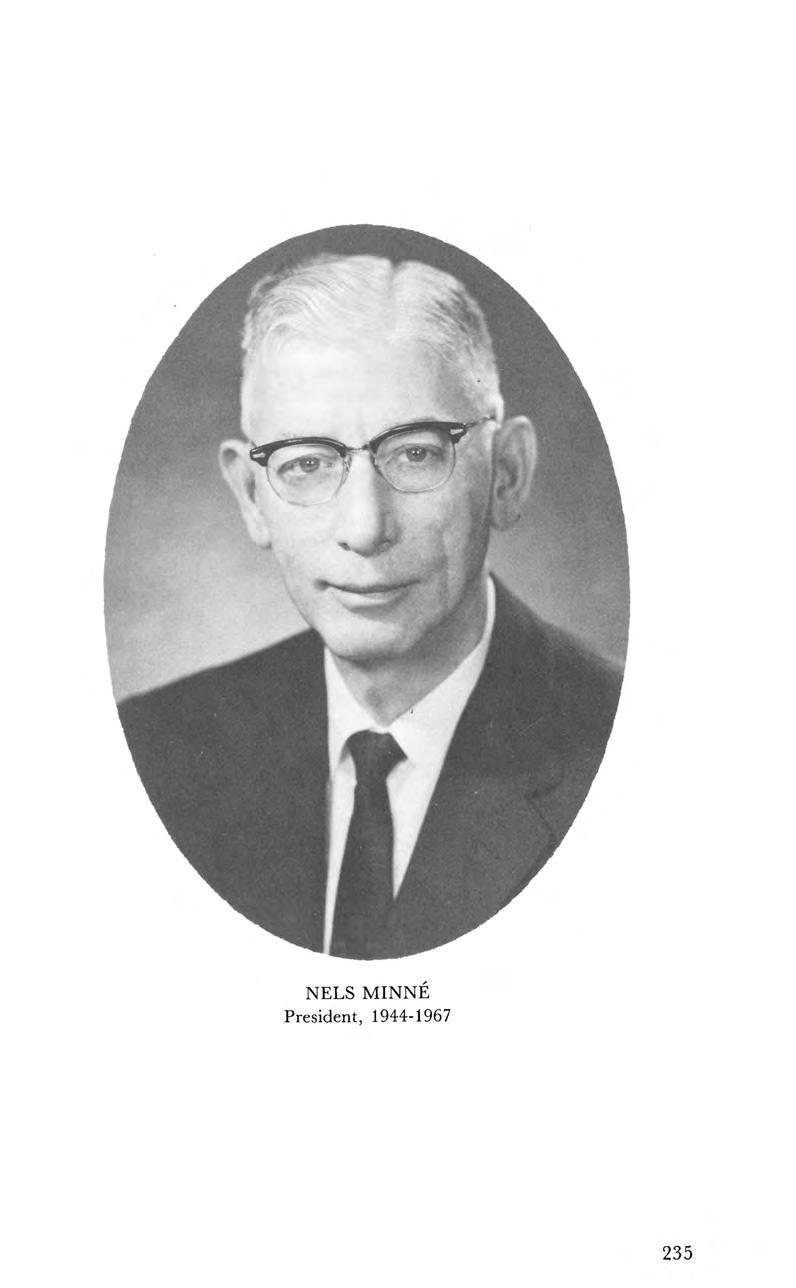
President, 1944-1967

million jobs available there was little need for long-term economic adjustments. Millions of servicemen and women were quietly reabsorbed into the economic and social life of the country. There were waiting lists for everything people wanted: automobiles, apartments, and college admissions.

1. Edwin Cates, A Centennial History ofSt. CloudState College (Minneapolis: Dillon Press, 1968) p. 141.
2. Erwin Selle (Ed.), The Winona State Teachers College: Historical Notes, 1910-1935 (Winona State Teachers College Board, 1935) p. 120.
3. Cates, p. 191.
4. G. Theodore Mitau, Minnesota’s Colleges ofOpportunity (St. Paul: Minnesota State University System, Alumni Associations, 1977) p. 28.
5. State Teachers College Board, Minutes. September 14, 1936, p. 1404.
6. Susan Korda, “Winona State Teachers College from 1927-1936 — Historical Evidence and Analysis.” (Term Paper, Hamline University, November 18, 1974).
7. Winona State Teachers College, Catalog, May, 1928, p. 18.
8. Ibid., p. 4.
9. Biennial Report of The State Teachers College Board to the Governor (State of Minnesota, November 29, 1938).
10. Selle, pp. 195-200.
11. Biennial Report ofthe State Teachers College Board, November 1938, p. 20.
12. Ibid.
13. State Teachers College Board, Minutes. January 10, 1939.
14. Winona Republican Herald. June 5, 1935.
15. State Teachers College Board, Minutes, January 6, 1939.
16. Ibid.
17. Jean Talbot, First State Normal School 1860, Winona State College 1960 (Winona: Winona State College, 1959).
18. State Teachers College Board, Minutes. September 23, 1939.
19. State Teachers College Board, Minutes. December 12, 1939.
20. State Teachers College Board, Minutes. June 11, 1940.
21. Winona State Teachers College, Catalog, 1921-22.
22. Cates, p. 197.
23. Talbot, p. 38.
24. Richard Hofstadter, W. Miller and D. Aaron, The United States, (Englewood Cliffs: Prentice Hall, Inc., 1972) p. 742.
25. Mitau, p. 32.

Part Three

CHAPTER VIII
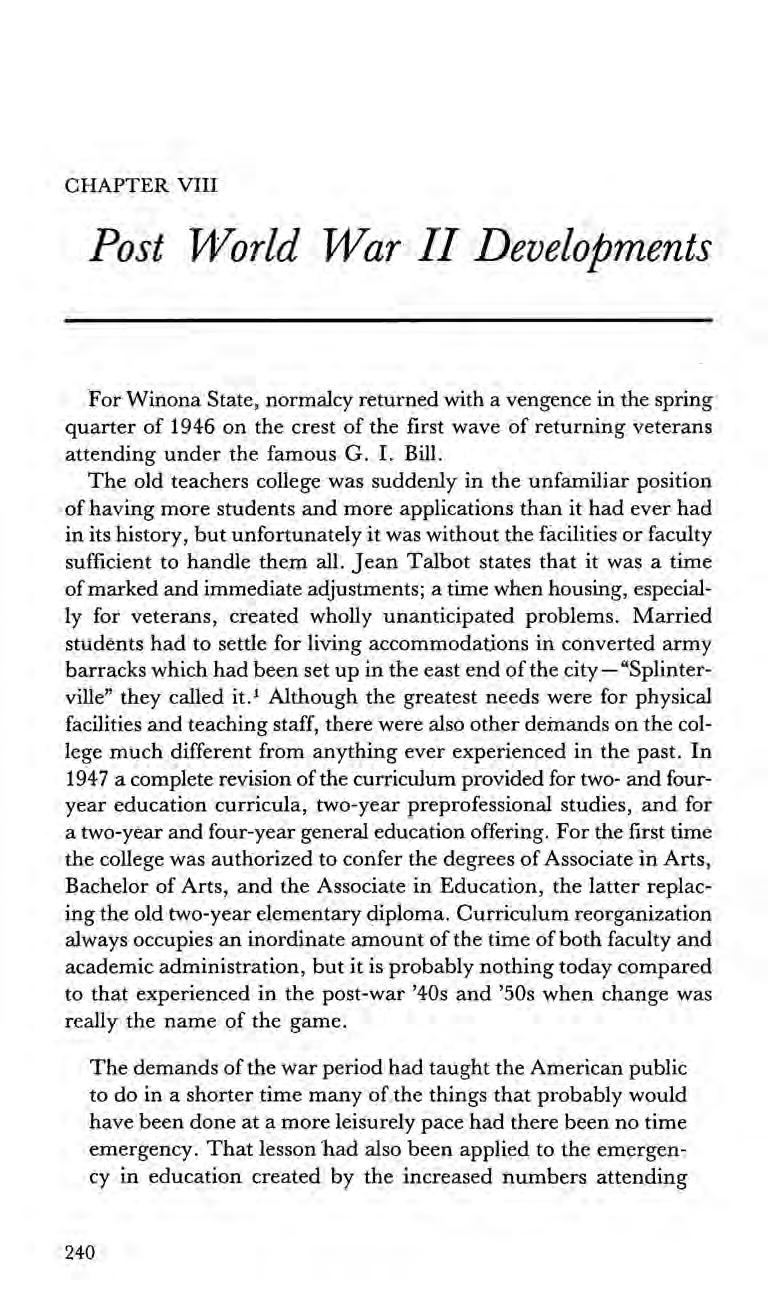
For Winona State, normalcy returned with a vengence in the spring quarter of 1946 on the crest of the first wave of returning veterans attending under the famous G. I. Bill.
The old teachers college was suddenly in the unfamiliar position of having more students and more applications than it had ever had in its history, but unfortunately it was without the facilities or faculty sufficient to handle them all. Jean Talbot states that it was a time ofmarked and immediate adjustments; a time when housing, especially for veterans, created wholly unanticipated problems. Married students had to settle for living accommodations in converted army barracks which had been set up in the east end of the city “Splinterville” they called it.1 Although the greatest needs were for physical facilities and teaching staff, there were also other demands on thecollege much different from anything ever experienced in the past. In 1947 a complete revision ofthe curriculum provided for two- and fouryear education curricula, two-year preprofessional studies, and for a two-year and four-year general education offering. For the first time the college was authorized to confer the degrees of Associate in Arts, Bachelor of Arts, and theAssociate in Education, the latter replacing the oldtwo-year elementary diploma. Curriculum reorganization always occupies an inordinate amount of the time of both faculty and academic administration, but it is probably nothing today compared to that experienced in the post-war ’40s and ’50s when change was really the name of the game.
The demands of the war period had taught the American public to do in a shorter time many of.the things that probably would have been done at a more leisurely pace had there been no time emergency. That lesson had also been applied to the emergency in education created by the increased numbers attending
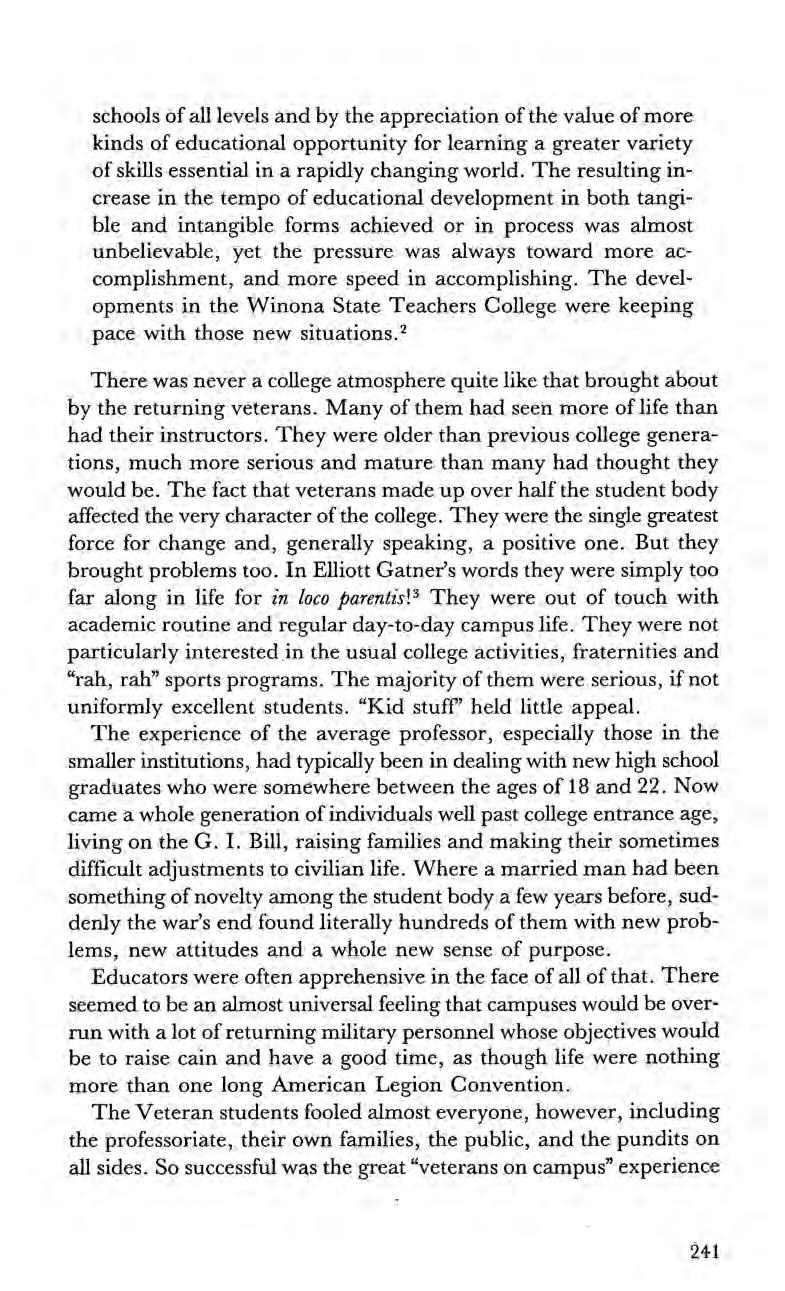
schools of all levels and by the appreciation of the value of more kinds of educational opportunity for learning a greater variety of skills essential in a rapidly changing world. The resulting increase in the tempo of educational development in both tangible and intangible forms achieved or in process was almost unbelievable, yet the pressure was always toward more accomplishment, and more speed in accomplishing. The developments in the Winona State Teachers College were keeping pace with those new situations.’
There was never a college atmosphere quite like that brought about by the returning veterans. Many of them had seen more of life than had their instructors. They were older than previous college generations, much more serious and mature than many had thought they would be. The fact that veterans made up over half the student body affected the very character of the college. They were the single greatest force for change and, generally speaking, a positive one. But they brought problems too. In Elliott Gatner’s words they were simply too far along in life for in loco parentis!? They were out of touch with academic routine and regular day-to-day campus life. They were not particularly interested in the usual college activities, fraternities and “rah, rah” sports programs. The majority of them were serious, if not uniformly excellent students. “Kid stuff’ held little appeal.
The experience of the average professor, especially those in the smaller institutions, had typically been in dealing with new high school graduates who were somewhere between the ages of 18 and 22. Now came a whole generation of individuals well past college entrance age, living on the G. I. Bill, raising families‘ and making their sometimes difficult adjustments to civilian life. Where a married man had been something of novelty among the student body.a few years before, suddenly the war’s end found literally hundreds of them with new problems, new attitudes and a whole new sense of purpose.
Educators were often apprehensive in the face of all of that. There seemed to be an almost universal feeling that campuses would be overrun witha lot of returning military personnel whose objectives would be to raise cain and have a good time, as though life were nothing more than one long American Legion Convention.
The Veteran students fooled almost everyone, however, including the professoriate, their own families, the public, and the pundits on all sides. So successful was the great “veterans on campus” experience
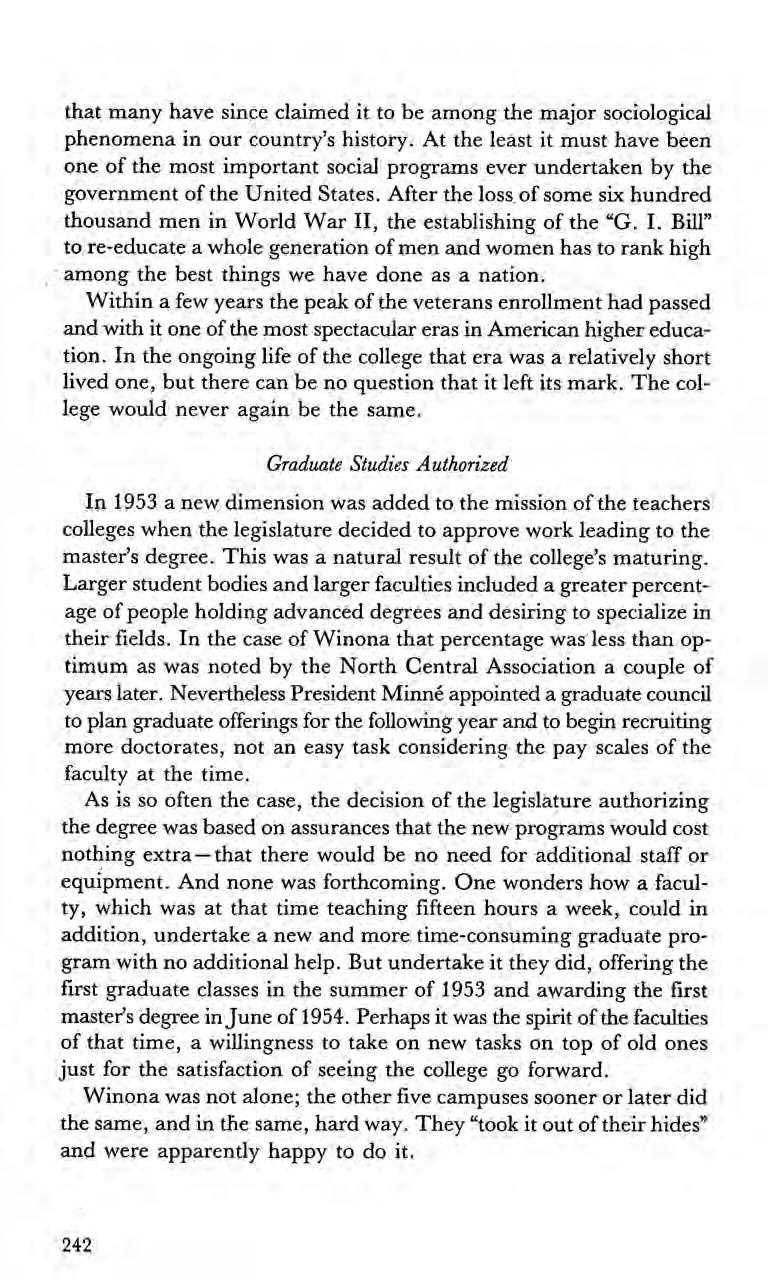
that many have since claimed it to be among the major sociological phenomena in our country’s history. At the least it must have been one of the most important social programs ever undertaken by the government of the United States. After the loss of some six hundred thousand men in World War II, the establishing of the “G. I. Bill” to re-educate a whole generation of men and women has to rank high ‘among the best things we have done as a nation.
Within a few years the peak of the veterans enrollment had passed and with it one of the most spectacular eras in American higher education. In the ongoing life of the college that era was a relatively short lived one, but there can be no question that it left its mark. The college would never again be the same.
In 1953 a new dimension was added to the mission of the teachers colleges when the legislature decided to approve work leading to the master’s degree. This was a natural result of the college’s maturing. Larger student bodies and larger faculties included a greaterpercentage of people holding advanced degrees and desiring to specialize in their fields. In the case of Winona that percentage was less than optimum as was noted by the North Central Association a couple of years later. Nevertheless President Minné appointed a graduate council to plan graduate offerings for the following year and to begin recruiting more doctorates, not an easy task considering the pay scales of the faculty at the time.
As is so often the case, the decision of the legislature authorizing the degree was based on assurances that the new programs would cost nothing extra—that there would be no need for additional staff or equipment. And none was forthcoming. One wonders howa faculty, which was at that time teaching fifteen hours a week, could in addition, undertake a new and more time-consuming graduate program with no additional help. But undertake it they did, offering the first graduate classes in the summer of 1953 and awarding the first master’s degree inJune of 1954. Perhaps it was the spirit ofthe faculties of that time, a willingness to take on new tasks on top of old ones just for the satisfaction of seeing the college go forward.
Winona was not alone; the other five campuses sooner or later did the same, and in the same, hard way. They “took it out of their hides” and were apparentlyhappy to do it.

In 1955 Winona State Teachers College faced a crucial examination, crucial in the sense that such an examination could encourage or discourage the direction which the school was taking just seven years after the end of the great war.
The student body numbered six hundred by then, still had a heavy component of veterans and still was predominently teacher education oriented. The graduate program hadjust been begun, and there was talk of a possible new name which would take it out from under the strictures imposed by the old “Teachers College” designation, opening up new avenues of service to the region and to the state. The examination was to be conducted by the North Central Association which had not visited the campus for many years.
The report turned out to be an objective appraisal of WSTC at that point in time, and it is reviewed extensively in the following pages to allow the reader to see how far the institution had come since its difficult days during the war, as well as to serve as a point of departure from which to measure progress from that point forward.*
Faculty. The examiners gave careful consideration to the training, experience, organization and conditions of service of the faculty. They concluded that, with the exception ofthe advanced graduate preparation of the faculty, Winona State Teachers College was well staffed for an institution of its type. The courses taken by the fifth-year students were largely taught by persons with terminal degrees although the overall percentage of faculty members with the doctorate (29.3 percent) was low (14th percentile) in comparison with similar colleges offering the master’s degree.
In other respects however, the faculty was well prepared. Almost all ofthe teaching staffhad completed graduate majors in their teaching fields. The size ofthe faculty in relation to the size ofthe student body, and the average clock-hour teaching loads were satisfactory. Many of the faculty members had public school teaching experience.
Both the median and the highest instructional salaries for regular academic duties ranked high among institutions of similar type.* The conditions with respect to tenure, recruitment and appointment, and leaves of absence were likewisefavorable.
Curriculum. The committee found no surprises in the curricular of-
*The median was $5,400; the highest was $6,528.
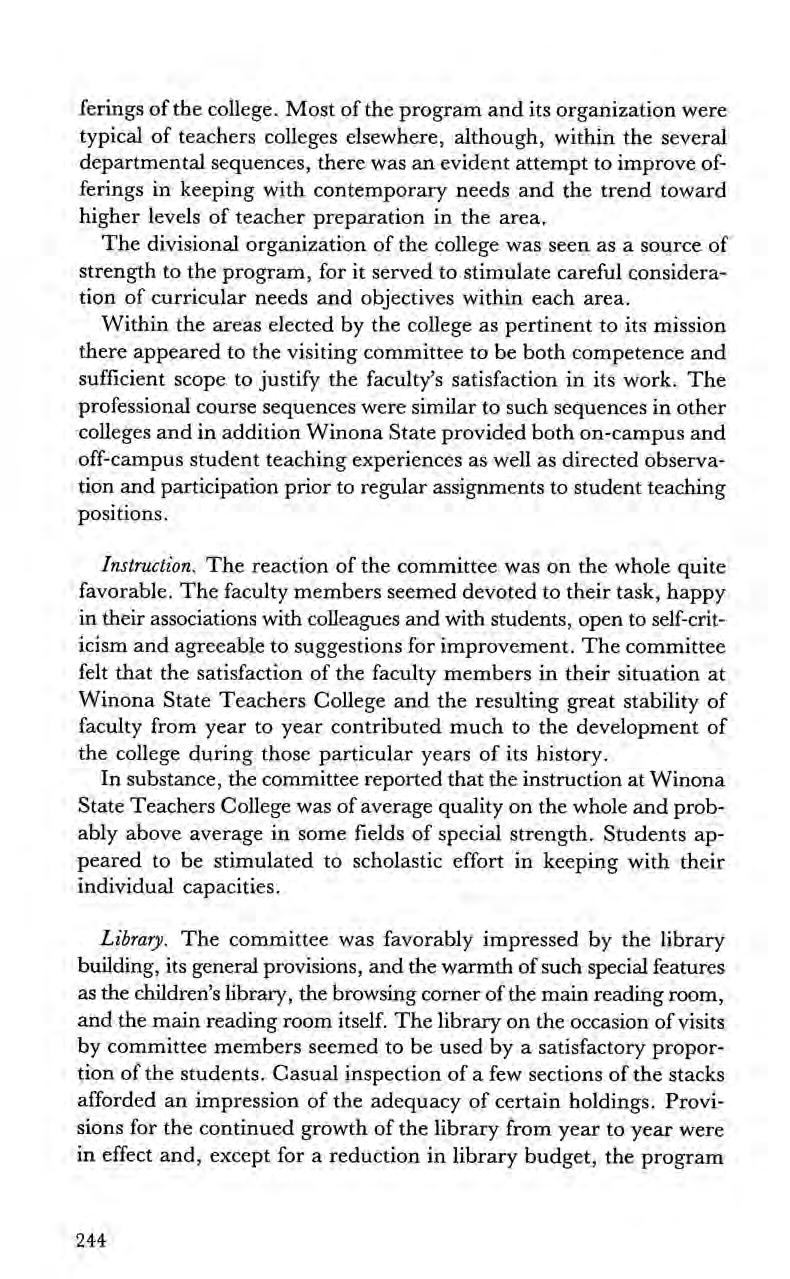
ferings of the college. Most of the program andits organization were typical of teachers colleges elsewhere, although, within the several departmental sequences, there was an evident attempt to improve offerings in keeping with contemporary needs and the trend toward higher levels of teacher preparation in the area,
The divisional organization of the college was seen as a source of strength to the program, for it served to stimulate careful consideration of curricular needs and objectives within each area.
Within the areas elected by the college as pertinent to its mission there appeared to the visiting committee to be both competence and sufficient scope to justify the faculty’s satisfaction in its work. The professional course sequences were similar to such sequences in other colleges and in addition Winona State provided both on-campus and off-campus student teaching experiences as well as directed observation and participation prior to regular assignments to student teaching positions.
Instruction. The reaction of the committee was on the whole quite favorable. The faculty members seemed devoted to their task, happy in their associations with colleagues and with students, open to self-criticism and agreeable to suggestions for improvement. The committee felt that the satisfaction of the faculty members in their situation at Winona State Teachers College and the resulting great stability of faculty from year to year contributed much to the development of the college during those particular years of its history.
In substance, the committee reported that the instruction at Winona State Teachers College was of average quality on the whole and probably above average in some fields of special strength. Students appeared to be stimulated to scholastic effort in keeping with their individual capacities.
Library. The committee was favorably impressed by the library building, its general provisions, and the warmth of such special features as the children’s library, the browsing corner ofthe main reading room, and the main reading room itself. The library on the occasion of visits by committee members seemed to be used bya satisfactory proportion of the students. Casual inspection of a few sections of the stacks afforded an impression of the adequacy of certain holdings. Provisions for the continued growth of the library from year to year were in effect and, except for a reduction in library budget, the program
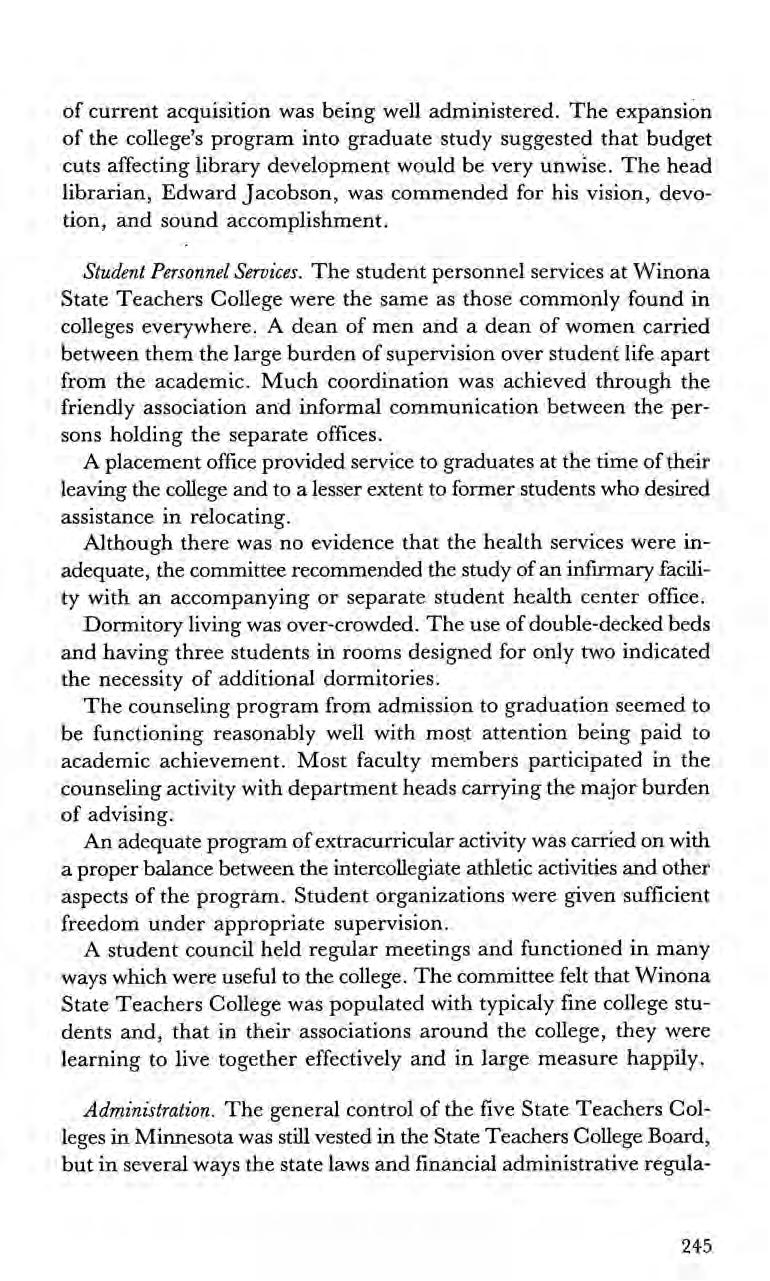
of current acquisition was being well administered. The expansion of the college’s program into graduate study suggested that budget cuts affecting library development would be very unwise. The head librarian, Edward Jacobson, was commended for his vision, devotion, and sound accomplishment.
Student Personnel Services. ‘The student personnel services at Winona State Teachers College were the same as those commonly found in colleges everywhere. A dean of men and a dean of women carried between them the large burden of supervision over student life apart from the academic. Much coordination was achieved through the friendly association and informal communication between the persons holding the separate offices.
A placement office provided service to graduates at the time of their leaving the college and to a lesser extent to former students who desired assistance in relocating.
Although there was no evidence that the health services were inadequate, the committee recommended the study of an infirmary facility with an accompanying or separate student health center office.
Dormitory living was over-crowded. The use of double-decked beds and having three students in rooms designed for only two indicated the necessity of additional dormitories.
The counseling program from admission to graduation seemed to be functioning reasonably well with most attention beingpaid to academic achievement. Most faculty members participated in the counseling activity with department heads carrying the major burden of advising.
An adequate program ofextracurricular activity was carried on with a proper balance between the intercollegiate athletic activities and other aspects of the program. Student organizations were given sufficient freedom under appropriate supervision.
A student council held regular meetings and functioned in many ways which were useful to the college. The committee felt that Winona State Teachers College was populated with typicaly fine college students and, that in their associations around the college, they were learning to live together effectively and in large measure happily.
Administration. The general control of the five State Teachers Colleges in Minnesota was still vested in the State Teachers College Board, but in several ways the state laws and financial administrative regula-
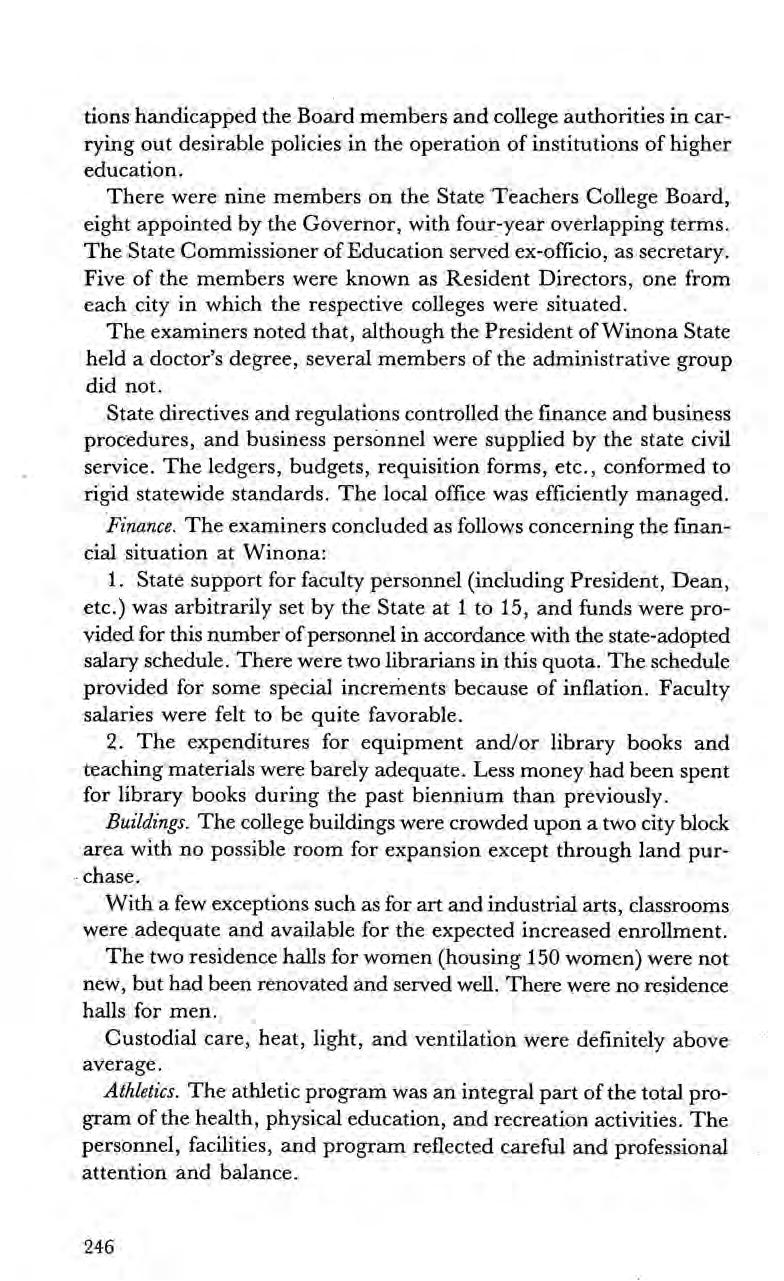
tions handicapped the Board members and college authorities in carrying out desirable policies in the operation of institutions of higher education.
There were nine members on the State Teachers College Board, eight appointed by the Governor, with four-year overlapping terms. The State Commissioner of Education served ex-officio, as secretary. Five of the members were known as Resident Directors, one from each city in which the respective colleges were situated.
The examinersnoted that, although the President ofWinona State held a doctor’s degree, several members of the administrative group did not.
State directives and regulations controlled the finance and business procedures, and business personnel were supplied by the state civil service. The ledgers, budgets, requisition forms, etc., conformed to rigid statewide standards. The localoffice was efficiently managed.
Finance. The examiners concluded as follows concerning the financial situation at Winona:
1. State support for faculty personnel (including President, Dean, etc.) was arbitrarily set by the State at 1 to 15, and funds were provided for this number of personnel in accordance with the state-adopted salary schedule. ‘There were two librarians in this quota. The schedule provided for some special increments because of inflation. Faculty salaries were felt to be quite favorable.
2. The expenditures for equipment and/or library books and teaching materials were barely adequate. Less money had been spent for library books during the past biennium than previously.
Buildings. The college buildings were crowded upona two city block area with no possible room for expansion except through land pur- chase.
With a few exceptions such as for art and industrial arts, classrooms - were adequate and available for the expected increased enrollment.
The two residence halls for women (housing 150 women) were not new, but had been renovated and served well. There were no residence halls for men.
Custodial care, heat, light, and ventilation were definitely above average.
Athletics. The athletic program was an integral part of the total program of the health, physical education, and recreation activities. The personnel, facilities, and program reflected careful and professional attention and balance.
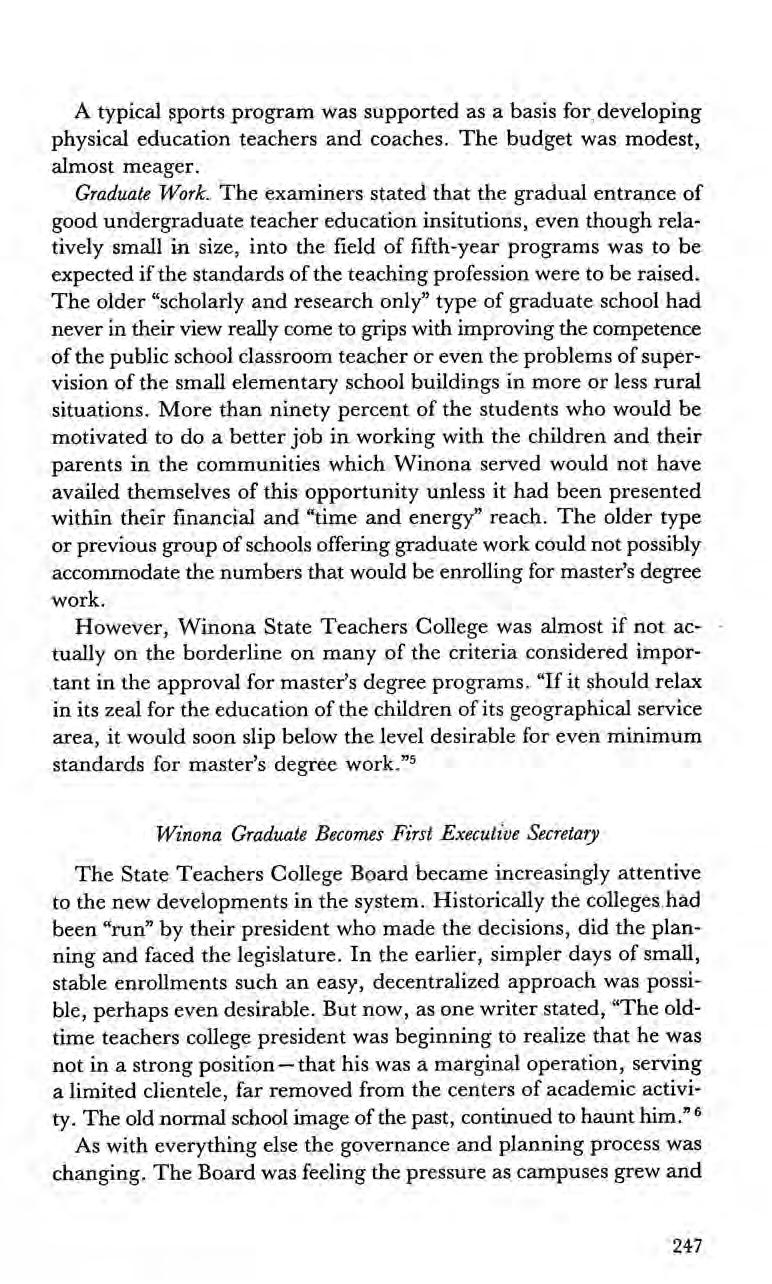
A typical sports program was supported as a basis for.developing physical education teachers and coaches. The budget was modest, almost meager.
Graduate Work. The examiners stated that the gradual entrance of good undergraduate teacher education insitutions, even though relatively small in size, into the field of fifth-year programs was to be expected if the standards of the teaching profession were to be raised. The older “scholarly and research only” type of graduate school had never in their view really come to grips with improving the competence of the public school classroom teacher or even the problems of supervision of the small elementary school buildings in more or less rural situations. More than ninety percent of the students who would be motivated to do a better job in working with the children and their parents in the communities which Winona served would not have availed themselves of this opportunity unless it had been presented within their financial and “time and energy” reach. The older type or previous group of schools offering graduate work could not possibly accommodate the numbers that would be enrolling for master’s degree work.
However, Winona State Teachers College was almost if not actually on the borderline on many of the criteria considered important in the approval for master’s degree programs. “If it should relax in its zeal for the education of the children of its geographical service area, it would soon slip below the level desirable for even minimum standards for master’s degree work.”
The State Teachers College Board became increasingly attentive to the new developments in the system. Historically the colleges. had been “run” by their president who made the decisions, did the planning and faced the legislature. In the earlier, simpler days of small, stable enrollments such an easy, decentralized approach was possible, perhaps even desirable. But now, as one writer stated, “The oldtime teachers college president was beginning to realize that he was not in a strong position that his was a marginal operation, serving a limited clientele, far removed from the centers of academic activity. The old normal school image of the past, continued to haunt him.” ®
As with everything else the governance and planning process was changing. The Board was feeling the pressure as campuses grew and

became more sophisticated. As far back as 1937 the Board had made a proposal to employ an executive secretary and establish a central office “to coordinate and to promote the efficient administration of the several state teachers colleges.”’ They failed to win legislative approval at that time, and it was almost ten years later before they tried it again. In the meantime, on top of everything else, the Board had come up with a new revenue bond program which would come to be extensively used in building residence halls throughout the system. * The prospect of such expenditures, the need for better fiscal controls, and the transfer of the responsibility for revenue income from the Department of Administration to the Board finally convinced the legislative committees, and in 1955, authorization was given to employ a coordinator. Dr. Roy C. Prentiss, a graduate of W.S.C., became the Board’s first Executive Secretary.®
The Physical Plant
Physical expansion proceeded as never before! The last buiding completed prior to the war had been Maxwell Library which, it will be recalled, had been financed not by the State of Minnesota, but by a combination of private donations and W.P.A. (Works Progress Administration) grants from the federal government. ‘The state soon got back into the act, however, as enrollments began to mount. Beginning with the completion of the stadium in Maxwell Field in 1950 the decade witnessedthe doubling of the size. of the campus and physical plant. Construction was going on everywhere. A student starting as a freshman would see one version of the campus when he or she arrived, and another version upon graduation. Some ofthem must have thought that there was no such thing as the status quo, because things were changing almost weekly—homes being carted away from newly acquired properties, new excavations being dug, the sounds of tractors and jack hammers as old construction made way for the new.
The Board even hired a Twin Cities architectural firm to act in a consulting capacity in an endeavor to keep the rapid expansion of the campuses coordinated and under control. Winona State was one of the most difficult challenges because of its location directly in the
*WinonaDirector S. J. Kryzsko was the driving force in the initiation of the revenue bond building program.
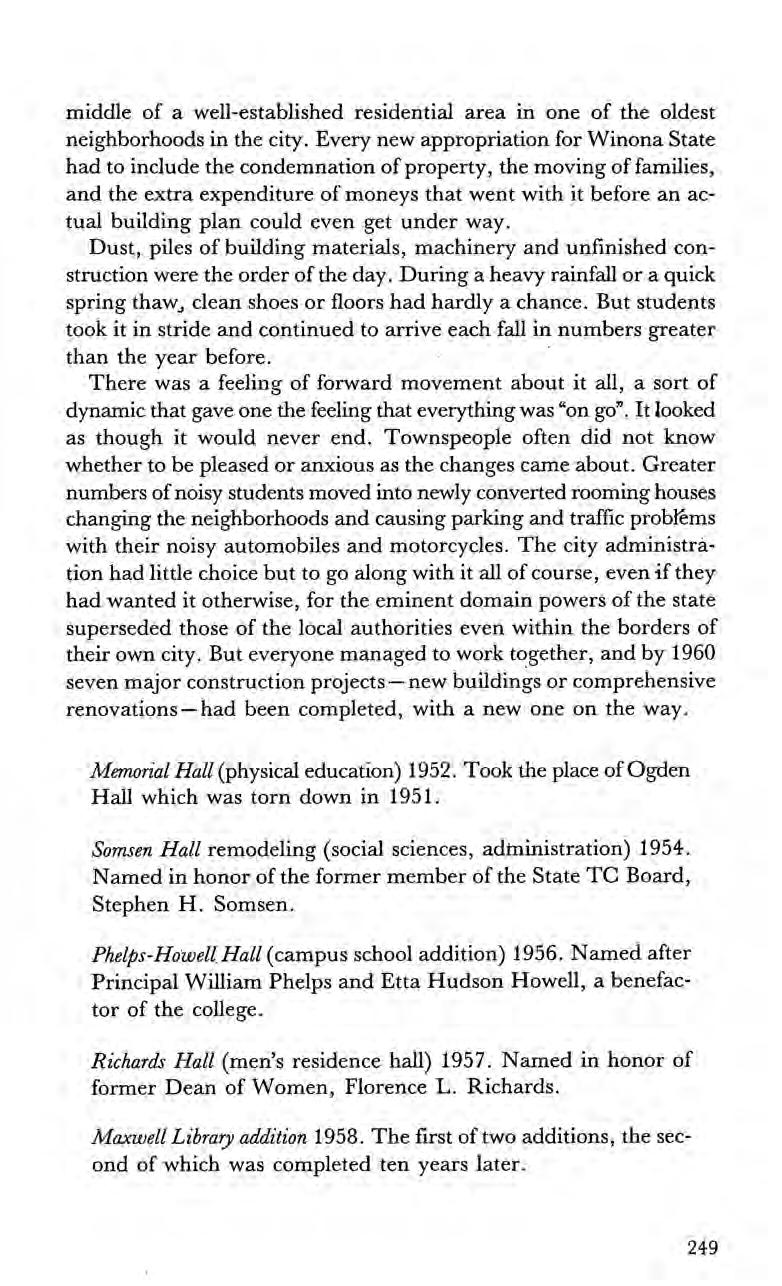
middle of a well-established residential area in one of the oldest neighborhoods in the city. Every new appropriation for Winona State had to include the condemnation of property, the moving of families, and the extra expenditure of moneys that went with it before an actual building plan could even get under way.
Dust, piles of building materials, machinery and unfinished construction were the order of the day. During a heavy rainfall or a quick spring thaw, clean shoes or floors had hardly a chance. But students took it in stride and continued to arrive each fall in numbers greater than the year before.
There was a feeling of forward movement about it all, a sort of dynamic that gave one the feeling that everything was “on go”. It looked as though it would never end. Townspeople often did not know whether to be pleased or anxious as the changes came about. Greater numbers ofnoisy students moved into newly converted rooming houses changing the neighborhoods and causing parking and traffic problems with their noisy automobiles and motorcycles. The city administration had little choice but to go along with it all of course, even if they had wanted it otherwise, for the eminent domain powers of the state superseded those of the local authorities even within the borders of their own city. But everyone managed to work together, and by 1960 seven major construction projects new buildings or comprehensive renovations—had been completed, with a new one on the way.
Memorial Hall (physical education) 1952. ‘Tookthe place of Ogden Hall which was torn down in 1951.
Somsen Hall remodeling (social sciences, administration) 1954. Named in honor of the former member of the State TC Board, Stephen H. Somsen.
Phelps-Howell Hall (campus school addition) 1956. Named after Principal William Phelps and Etta Hudson Howell, a benefactor of the college.
Richards Hall (men’s residence hall) 1957. Named in honor of former Dean of Women, Florence L. Richards.
Maxwell Library addition 1958. The first of two additions, the second of which was completed ten years later.

Conway Hall (residence hall for women) 1959. Named in honor of Miss Helen Conway, a WSC graduate and member of the State College Board.
Pasteur Hall (science building) 1960. Actual completion was not until 1962.
In 1957, the Legislature renamed the state supported colleges, and the old Winona T. C. became Winona State College.®
The Legislature had renamed the college four times, each time with good reason as its programs moved from stage to stage. But never before had a new name suggested a change in the actual mission of the place its very reason for being. This one did. Winona State College was to becomea liberal arts institution along with its function of preparing teachers. Students could now go to Winona State and receive a diploma which would indicate that they had graduated from a curriculum not oriented to a particular vocational pursuit, but that they had been educated for education’s sake. It was indeed a dramatic recognition of the changing role of the college, and a dangerous one too, because now the gates of academia, previously barely accessible to the “T.C.”, were flung wide open. Now almost anything could happen, and probably would, well beyond the imaginations of most of the legislators who had voted for it.
It is worth a brief pause at this point to draw a few contrasts with earlier years. In terms ofphysical change there were now almost twice as many buildings, and the actual campus area had doubled. There was twice the number of students of any previous enrollment peak before the war. Males now predominated in what had once been a largely female stronghold. ‘The curriculum had moved froma purely vocational one through the semi-vocational teachers college stage to what was fast becoming a predominently liberal arts offering. It was not exactly Ivy League, but it was not just old “T. C.” anymore either, although the name stuck with it for a long time, just as “The Normal” had stuck with the teachers college many years earlier.
Ways of doing things had changed also. The manditory daily convocations of yesteryear, with prayer and inspirational messages by the President, or whomever he could occasionally corner to take his place, gave way to one-day-a-week programs, which in turn were abolished altogether.
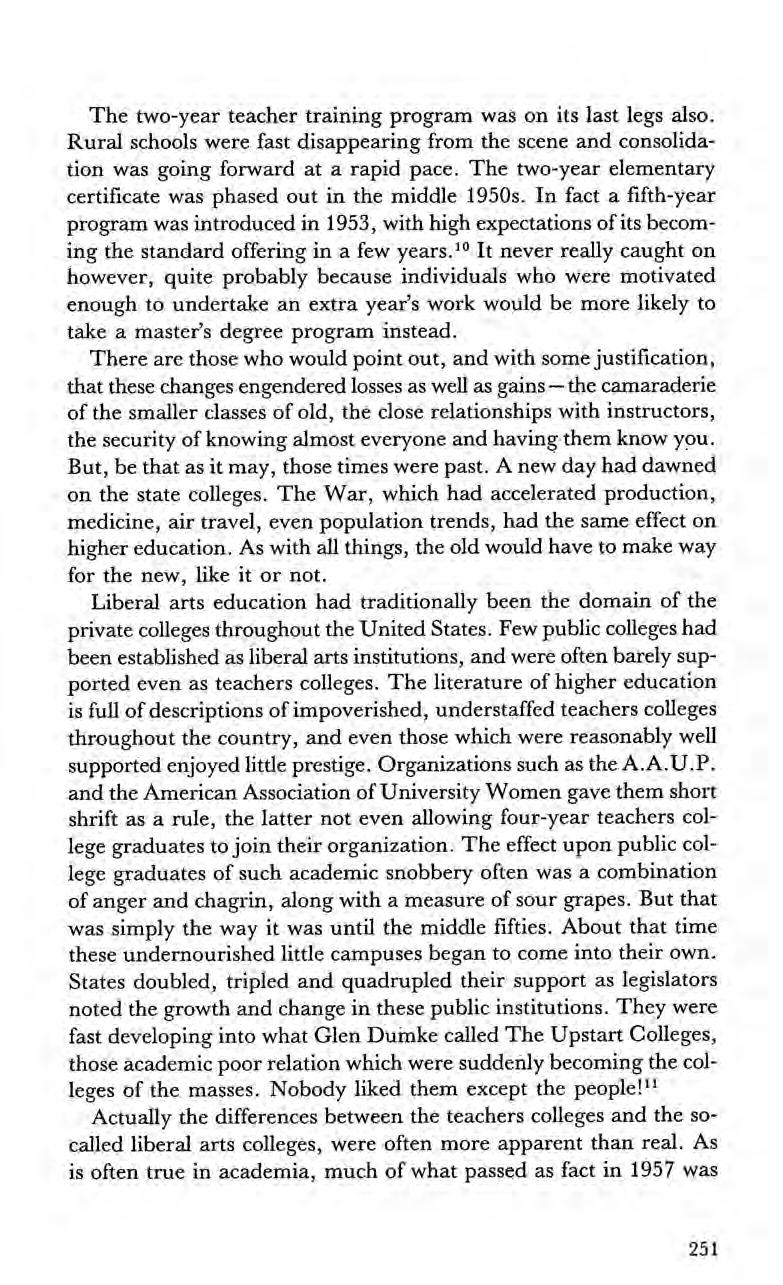
The two-year teacher training program was on its last legs also. Rural schools were fast disappearing from the scene and consolidation was going forward at a rapid pace. The two-year elementary certificate was phased out in the middle 1950s. In fact a fifth-year program was introduced in 1953, with high expectations ofits becoming the standard offering in a few years.'° It never really caught on however, quite probably because individuals who were motivated enough to undertake an extra year’s work would be more likely to take a master’s degree program instead.
There are those who would point out, and with some justification, that these changes engendered losses as well as gains the camaraderie of the smaller classes of old, the close relationships with instructors, the security of knowing almost everyone and having them know you. But, be that as it may, those times were past. A new day had dawned on the state colleges. The War, which had accelerated production, medicine, air travel, even population trends, had the same effect on higher education. As with all things, the old would have to make way for the new, like it or not.
Liberal arts education had traditionally been the domain of the private colleges throughout the United States. Few public colleges had been established as liberal arts institutions, and were often barely supported even as teachers colleges. The literature of higher education is full of descriptions of impoverished, understaffed teachers colleges throughout the country, and even those which were reasonably well supported enjoyed little prestige. Organizations such as the A.A.U.P. and the American Association of University Women gave them short shrift as a rule, the latter not even allowing four-year teachers college graduates to join their organization. The effect upon public college graduates of such academic snobbery often was a combination of anger and chagrin, along with a measure of sour grapes. But that was simply the way it was until the middle fifties. About thattime these undernourished little campuses began to come into their own. States doubled, tripled and quadrupled their support as legislators noted the growth and change in these public institutions. ‘They were fast developing into what Glen Dumke called The Upstart Colleges, those academic poor relation which were suddenly becoming the colleges of the masses. Nobody liked them except the people!"
Actually the differences between the teachers colleges and the socalled liberal arts colleges, were often more apparent than real. As is often true in academia, much of what passed as fact in 1957 was

not necessarily so. The “liberal arts” colleges often depended on public elementary and secondary education to offer employment opportunities for large numbers of their graduates. Almost uniformly they had education departments, methods courses, student teaching arrangements and the rest of what was generally demanded byemploying school districts and required by the state department of education. Although at times they resisted “vocationalism” as foreign to the liberal arts philosophy, seldom did they resist so strongly as to not be able to educate a large group of teachers each year. Many of them during certain years were, in fact, teachers colleges! And little wonder. American students, no matter what sort of institution they attend, almost unanimously expect to get employment after graduation. In the years following the war teaching was one of the best job prospects for hundreds of them.
So the distance between the state teachers colleges and many of the liberal arts institutions was not as great by 1957 as the mythology of academia would have it. It was one of the reasons why the “upstart colleges” caught up so fast and went so far in just a few years.
Winona State was one of this distinguished company. It was growing, expanding, improving, changing its orientation just as were the others. It was now obvious that the time would soon come when the state colleges would be graduating men and women from a curriculum in which teacher education, while still prominent, would be only one of many areas of study, some of them larger even than the original teacher training programs had been.
Winona, although growing less rapidly than a couple of its sister institutions (Mankato and St. Cloud), was nevertheless making steady strides. The enrollment had reached 600 by 1950 and, except for a brief fall-off during the Korean Conflict, continued upward until it had doubled by 1959.
The question everyone had asked thirty-six years earlier when the Normal became a four-year college now had to be asked again: Was Winona State ready for its new status? The answer seemed to be in the affirmative. Certainly it was better prepared than had been the case when it was given the teachers college title back in 1921, for this time much ofwhat it would be expected to do was already being done. In most ways, because of the rapid changes after the war, the school had become a multi-purpose college already. Many students had alreadygraduated in non-teaching Bachelor of Arts programs, and even more were enrolled. Faculty members, especially the younger
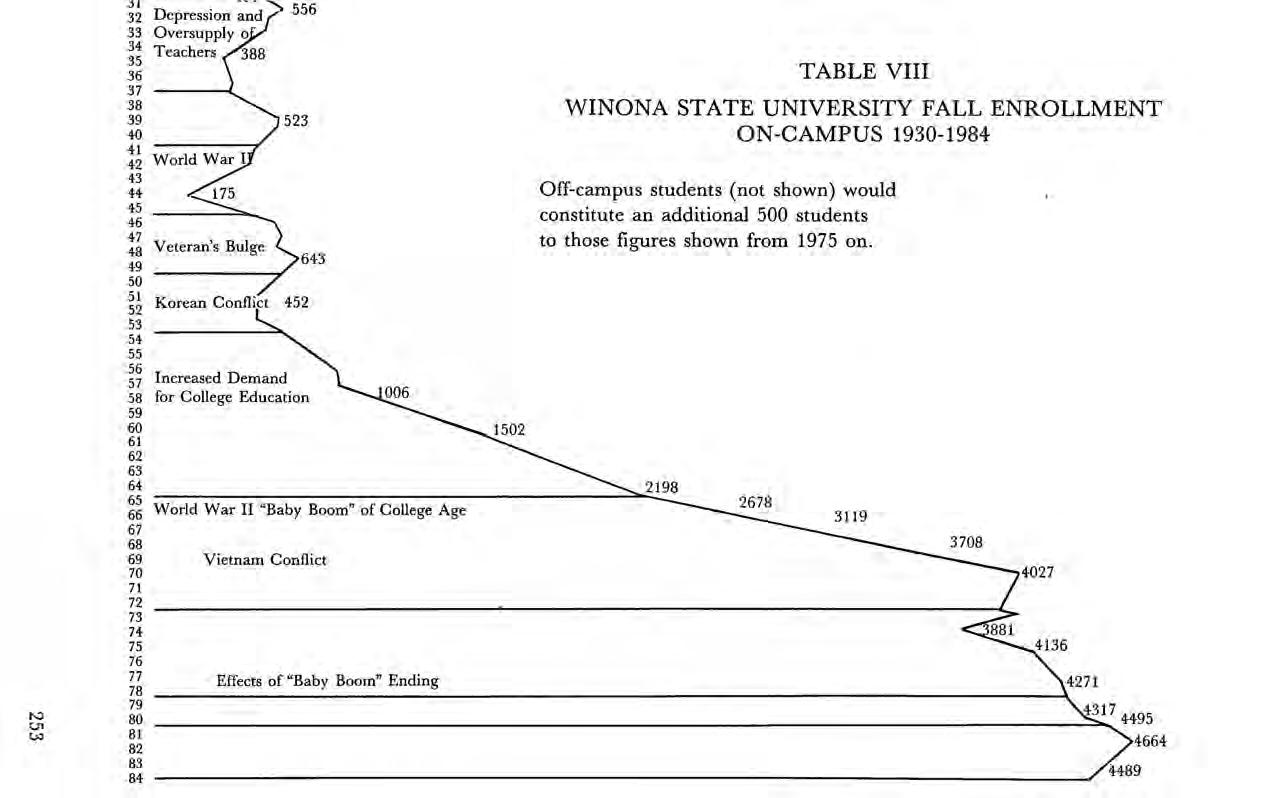
ON-CAMPUS 1930-1984
Off-campus students (not shown) would constitute an additional 500 students to those figures shown from 1975 on.
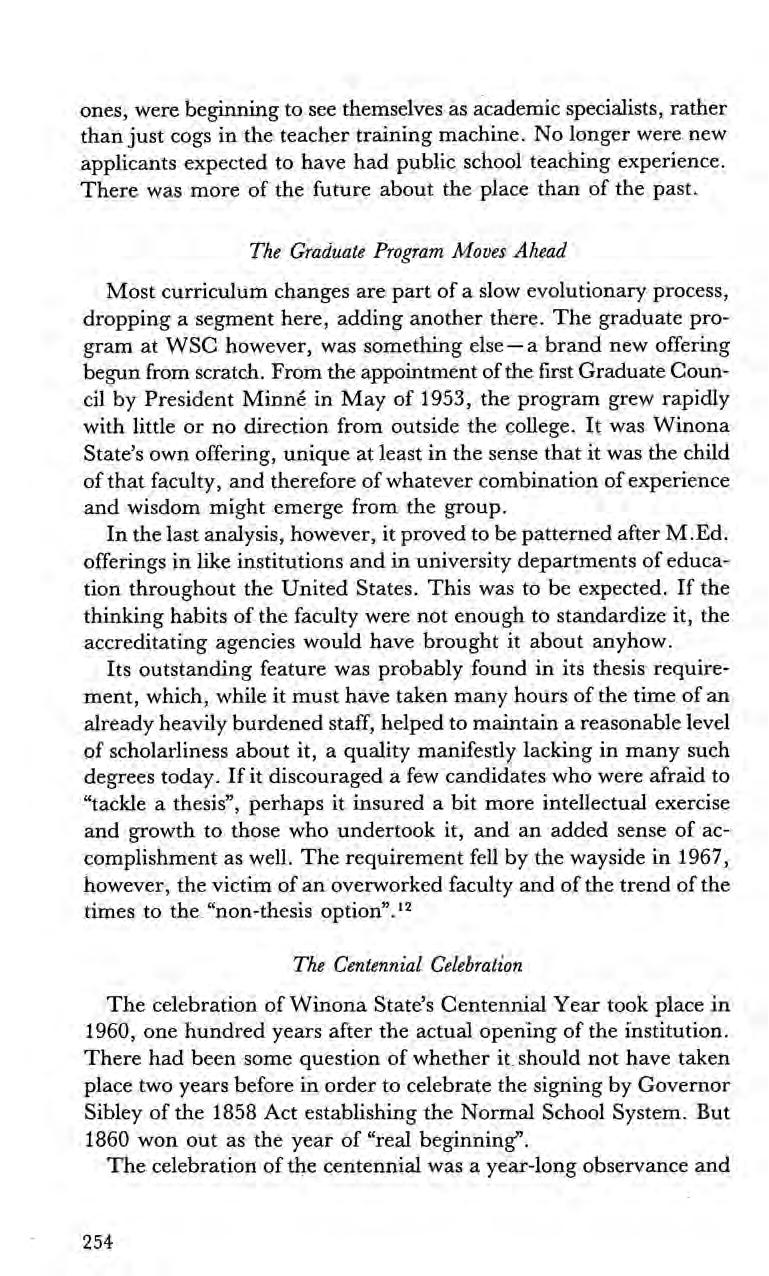
ones, were beginning to see themselves as academic specialists, rather than just cogs in the teacher training machine. No longer were new applicants expected to have had public school teaching experience. There was more of the future about the place than of the past.
Most curriculum changes are part of a slow evolutionary process, dropping a segment here, adding another there. ‘The graduate program at WSC however, was something else—a brand new offering begun from scratch. From the appointment ofthe first Graduate Council by President Minné in May of 1953, the program grew rapidly with little or no direction from outside the college. It was Winona State’s own offering, unique at least in the sense that it was the child of that faculty, and therefore of whatever combination of experience and wisdom might emerge from the group.
In the last analysis, however, it proved to be patterned after M.Ed. offerings in like institutions and in university departments of education throughout the United States. This was to be expected. If the thinking habits of the faculty were not enough to standardize it, the accreditating agencies would have brought it about anyhow.
Its outstanding feature was probably found in its thesis requirement, which, while it must have taken many hours of the time of an already heavily burdened staff, helped to maintain a reasonable level of scholarliness about it, a quality manifestly lacking in many such degrees today. If it discouraged a few candidates who were afraid to “tackle a thesis”, perhaps it insured a bit more intellectual exercise and growth to those who undertook it, and an added sense of accomplishment as well. The requirement fell by the wayside in 1967, however, the victim of an overworked faculty and of the trend of the times to the “non-thesis option”.!?
The celebration of Winona State’s Centennial Year took place in 1960, one hundred years after the actual opening of the institution. There had been some question of whether it should not have taken place two years before in order to celebrate the signing by Governor Sibley of the 1858 Act establishing the Normal School System. But 1860 won out as the year of “real beginning”.
The celebration of the centennial was a year-long observance and
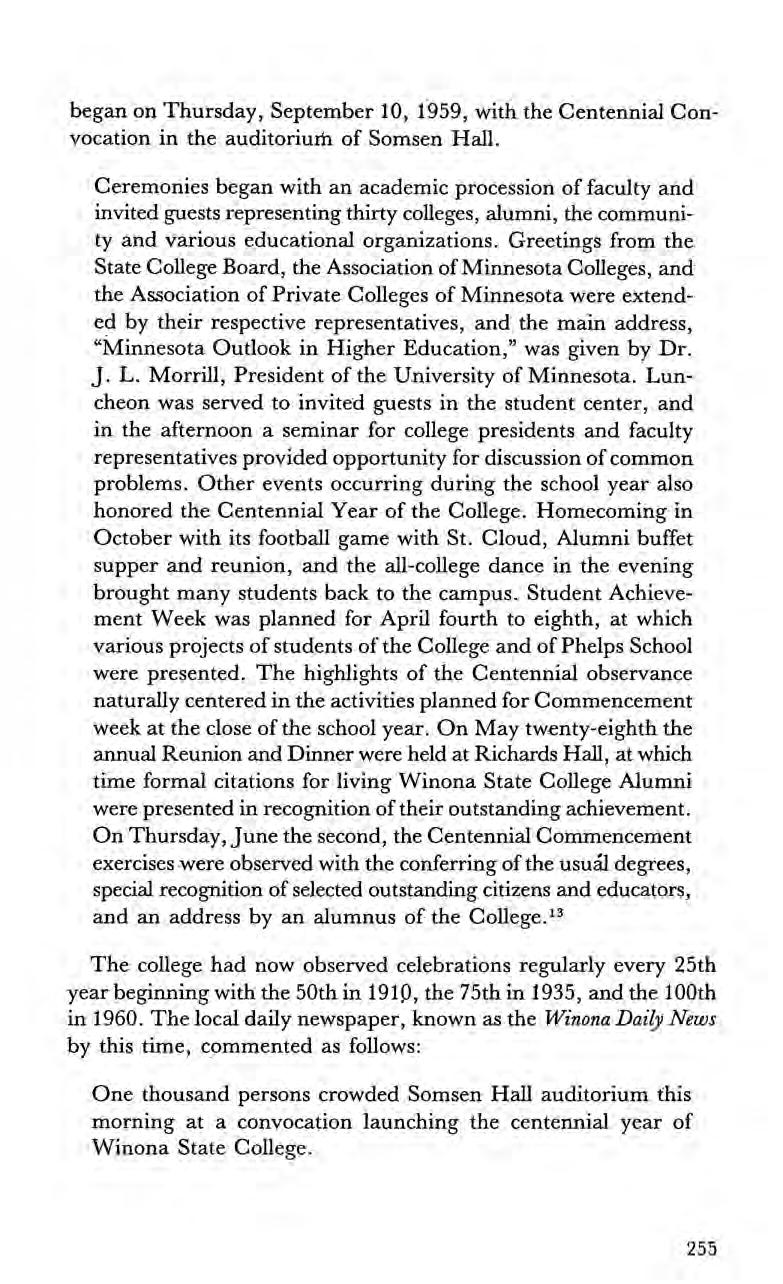
began on Thursday, September 10, 1959, with the Centennial Convocation in the auditoriurn of Somsen Hall.
Ceremonies began with an academic procession of faculty and invited guests representing thirty colleges, alumni, the community and various educational organizations. Greetings from the State College Board, the Association of Minnesota Colleges, and: the Association of Private Colleges of Minnesota were extended by their respective representatives, and the main address, “Minnesota Outlook in Higher Education,” was given by Dr. J. L. Morrill, President of the University of Minnesota. Luncheon was served to invited guests in the student center, and in the afternoon a seminar for college presidents and faculty representatives provided opportunity for discussion of common problems. Other events occurring during the school year also honored the Centennial Year of the College. Homecoming in October with its football game with St. Cloud, Alumni buffet supper and reunion, and the all-college dance in the evening brought many students back to the campus. StudentAchievement Week was planned for April fourth to eighth, at which various projects of students of the College and of Phelps School were presented. The highlights of the Centennial observance naturally centered in the activities planned for Commencement week at the close of the school year. On May twenty-eighth the annual Reunion and Dinner were held at Richards Hall, at which time formal citations for living Winona State College Alumni were presented in recognition oftheir outstanding achievement. On Thursday,June the second, the Centennial Commencement exercises were observed with the conferring of the usual degrees, special recognition of selected outstanding citizens and educators, and an address by an alumnus of the College.'?
The college had now observed celebrations regularly every 25th year beginning with the 50th in 1910, the 75th in 1935, and the 100th in 1960. The local daily newspaper, known as the Winona Daily News by this time, commented as follows:
One thousand persons crowded Somsen Hall auditorium this morning at a convocation launching the centennial year of Winona State College.
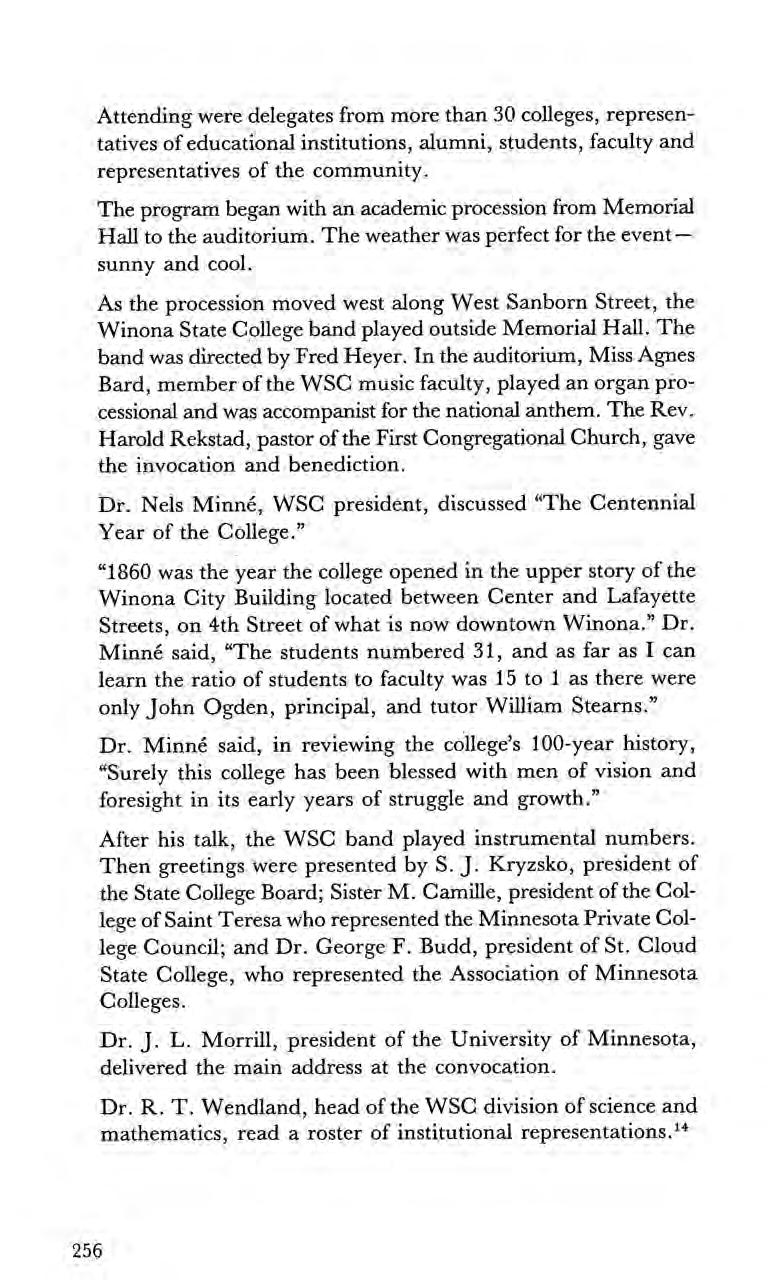
Attending were delegates from more than 30 colleges, representatives of educational institutions, alumni, students, faculty and representatives of the community.
The program began with an academic procession from Memorial Hall to the auditorium. The weather was perfect for the event — sunny and cool.
As the procession moved west along West Sanborn Street, the Winona State College band played outside Memorial Hall. The band was directed by Fred Heyer. In the auditorium, Miss Agnes Bard, member of the WSC music faculty, played an organ processional and was accompanist for the national anthem. The Rev. Harold Rekstad, pastor of the First Congregational Church, gave the invocation and benediction.
Dr. Nels Minné, WSC president, discussed “he Centennial Year of the College.”
“1860 was the year the college opened in the upper story of the Winona City Building located between Center and Lafayette Streets, on 4th Street of what is now downtown Winona.” Dr. Minné said, “The students numbered 31, and as far as I can learn the ratio of students to faculty was 15 to 1 as there were only John Ogden, principal, and tutor William Stearns.”
Dr. Minné said, in reviewing the college’s 100-year history, “Surely this college has been blessed with men of vision and foresight in its early years of struggle and growth.”
After his talk, the WSC band played instrumental numbers. Then greetings were presented by S. J. Kryzsko, president of the State College Board; Sister M. Camille, president of the College of Saint Teresa who represented the Minnesota Private College Council; and Dr. George F. Budd, president of St. Cloud State College, who represented the Association of Minnesota Colleges.
Dr. J. L. Morrill, president of the University of Minnesota, delivered the main address at the convocation.
Dr. R. T. Wendland, head of the WSC division of science and mathematics, read a roster of institutional representations.'*
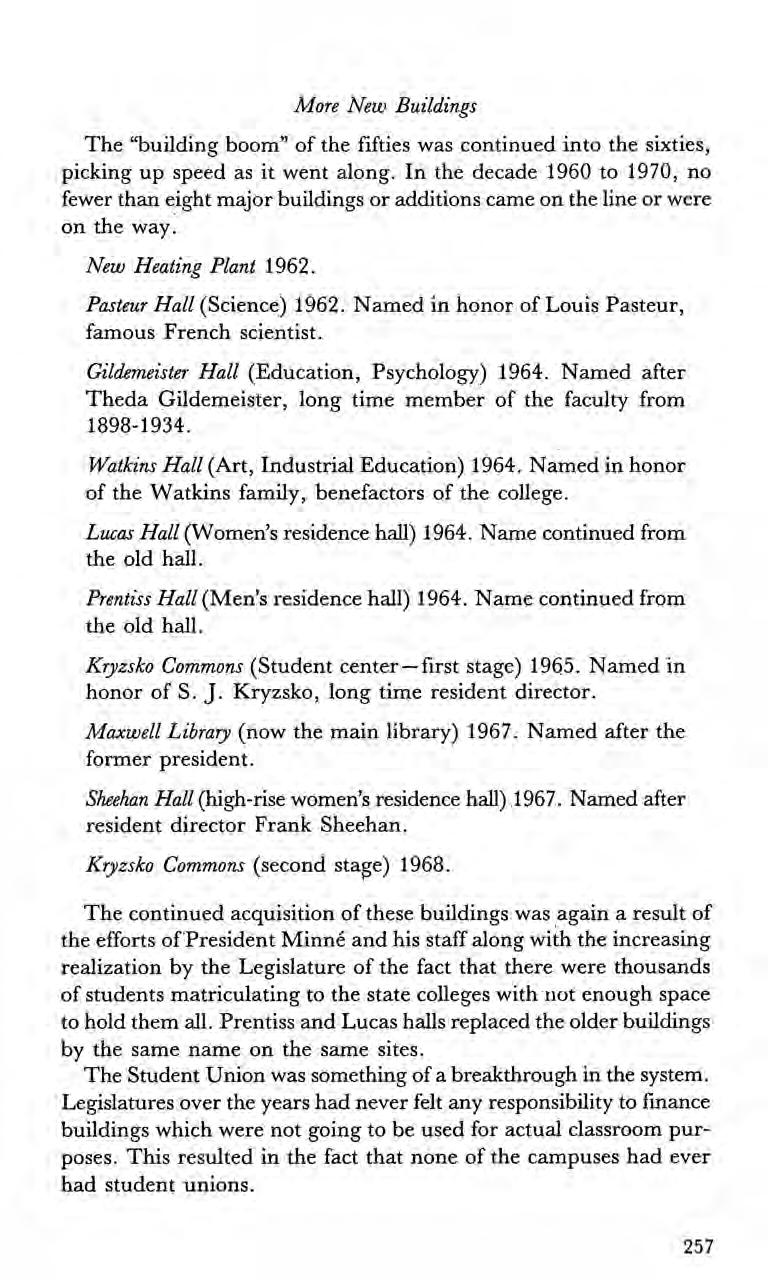
The “building boom” of the fifties was continued into the sixties, picking up speed as it went along. In the decade 1960 to 1970, no fewer than eight major buildings or additions came on the line or were on the way.
New Heating Plant 1962.
Pasteur Hall (Science) 1962. Named in honor of Louis Pasteur, famous French scientist.
Gildemeister Hall (Education, Psychology) 1964. Named after Theda Gildemeister, long time member of the faculty from 1898-1934.
Watkins Hall (Art, Industrial Education) 1964. Named in honor of the Watkins family, benefactors of the college.
Lucas Hall (Women’s residence hall) 1964. Name continued from the old hall.
Prentiss Hall (Men’s residence hall) 1964. Name continued from the old hall.
Kryzsko Commons (Student center — first stage) 1965. Named in honor of S. J. Kryzsko,long time resident director.
Maxwell Library (now the main library) 1967. Named after the former president.
Sheehan Hall (high-rise women’s residence hall) 1967. Named after resident director Frank Sheehan.
Kryzsko Commons (second stage) 1968.
The continued acquisition of these buildings was again a result of the efforts ofPresident Minné and his staff along with the increasing realization by the Legislature of the fact that there were thousands of students matriculating to the state colleges with not enough space to hold them all. PrentissandLucas halls replaced the older buildings by the same name on the same sites.
The Student Union was something of a breakthrough in the system. ‘Legislatures over the years had never felt any responsibility to finance buildings which were not going to be used for actual classroom purposes. This resulted in the fact that none of the campuses had ever had student unions.

WINONA STATE COLLEGE CAMPUS, 1967
Kryzsko Commons
Prentiss Hall
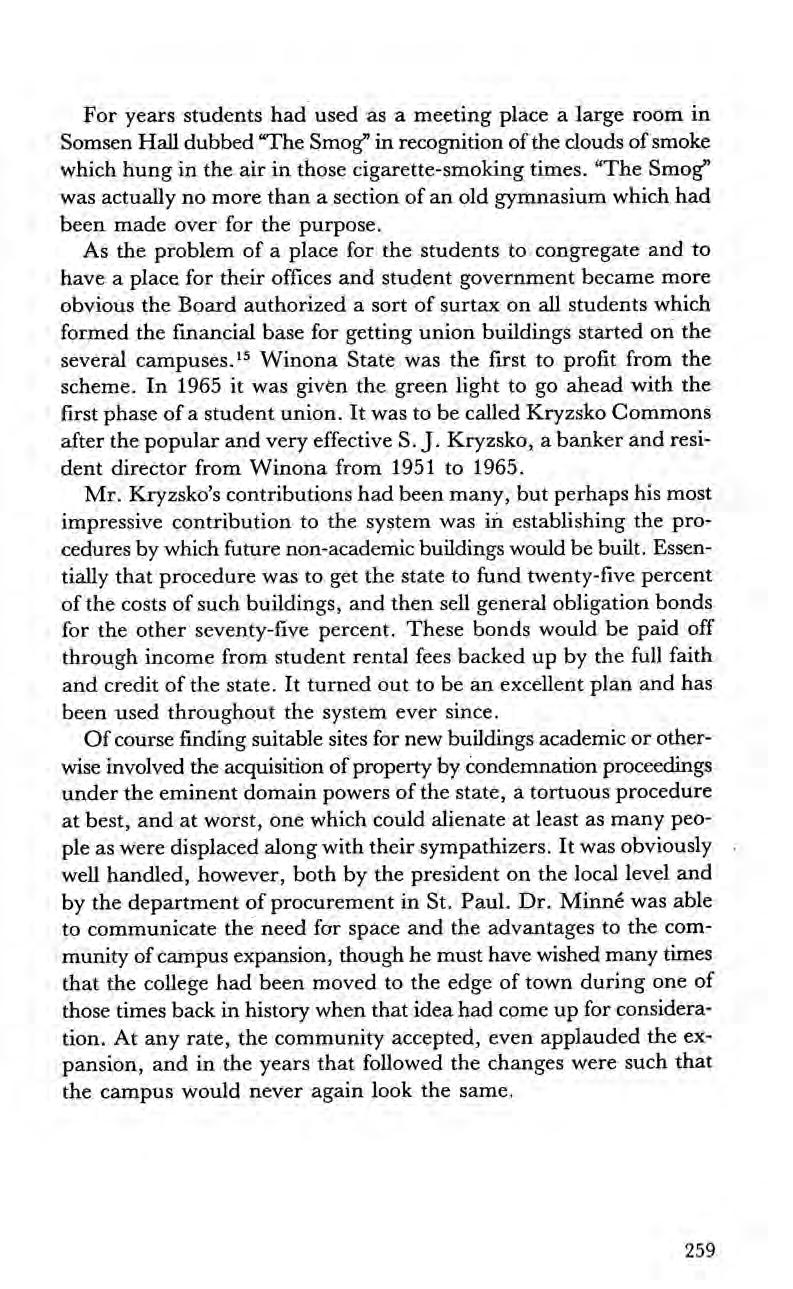
For years students had used as a meeting place a large room in Somsen Hall dubbed “The Smog” in recognition ofthe clouds of smoke which hung in the air in those cigarette-smoking times. “The Smog” was actually no more thana section of an old gymnasium which had been made over for the purpose.
As the problem of a place for the students to congregate and to have a place for their offices and student government became more obvious the Board authorizeda sort of surtax on all students which formed the financial base for getting union buildings started on the several campuses.'® Winona State was the first to profit from the scheme. In 1965 it was given the green light to go ahead with the first phase of a student union. It was to be called Kryzsko Commons after the popular and very effective S. J. Kryzsko, a banker and resident director fromWinona from 1951 to 1965.
Mr. Kryzsko’s contributions had been many, but perhaps his most impressive contribution to the system was in establishing the procedures by which future non-academic buildings would be built. Essentially that procedure was to get the state to fund twenty-five percent of the costs of such buildings, and then sell general obligation bonds for the other seventy-five percent. These bonds would be paid off through income from student rental fees backed up by the full faith and credit of the state. It turned out to be an excellent plan and has been used throughout the system ever since.
Of course finding suitable sites for new buildings academic or otherwise involved the acquisition ofproperty by condemnation proceedings under the eminent domain powers of the state, a tortuous procedure at best, and at worst, one which could alienate at least as many people as were displaced along with their sympathizers. It was obviously well handled, however, both by the president on the local level and by the department of procurement in St. Paul. Dr. Minné was able to communicate the need for space and the advantages to the community of campus expansion, though he must have wished many times that the college had been moved to the edge of town during one of those times back in history when that idea had come up for consideration. At any rate, the community accepted, even applauded the expansion, and in the years that followed the changes were such that the campus would never again look the same.
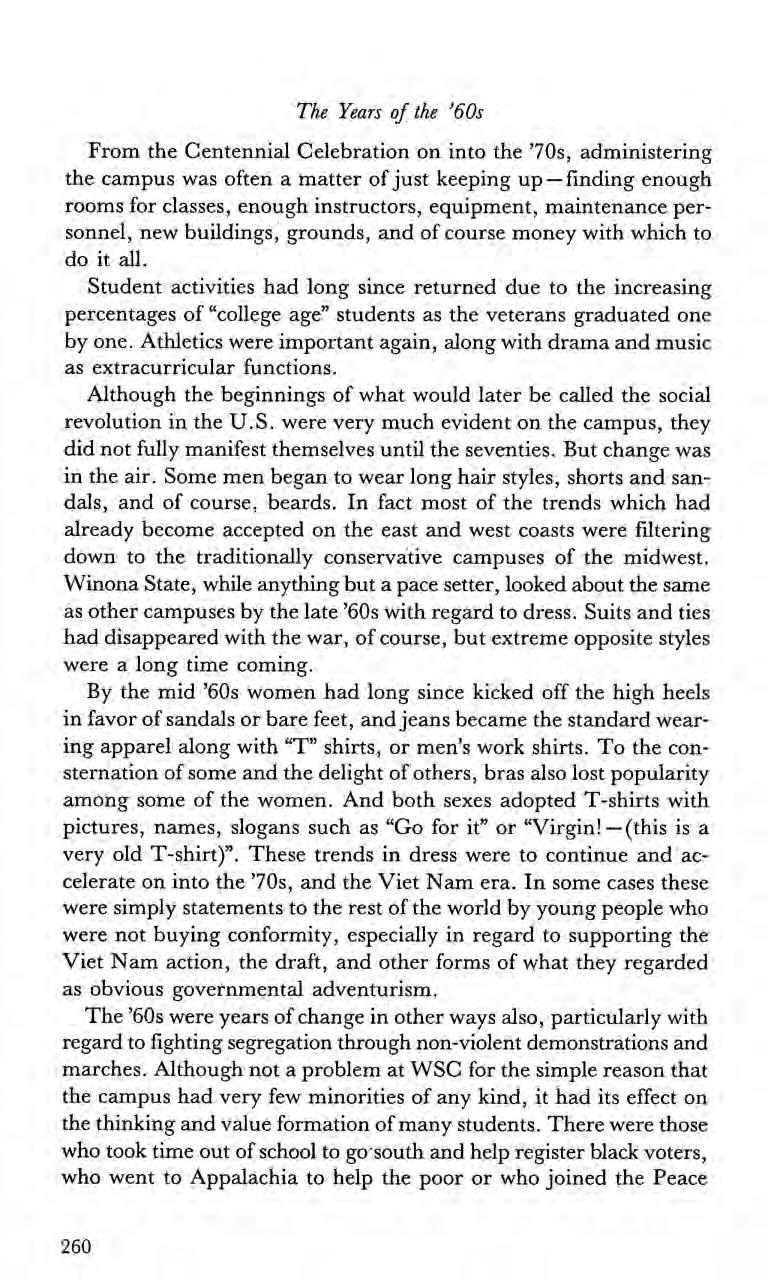
From the Centennial Celebration on into the ’70s, administering the campus was often a matter ofjust keeping up—finding enough rooms for classes, enough instructors, equipment, maintenance personnel, new buildings, grounds, and of course money with which to do it all.
Student activities had long since returned due to the increasing percentages of “college age” students as the veterans graduated one by one. Athletics were important again, along with drama and music as extracurricular functions.
Although the beginnings of what would later be called the social revolution in the U.S. were very much evident on the campus, they did not fully manifest themselves until the seventies. But change was in the air. Some men began to wear long hair styles, shorts and sandals, and of course, beards. In fact most of the trends which had already become accepted on the east and west coasts were filtering down to the traditionally conservative campuses of the midwest. Winona State, while anything but a pace setter, lookedabout the same as other campuses by the late 60s with regard to dress. Suits and ties had disappeared with the war, of course, but extreme opposite styles were a long time coming.
By the mid ’60s women had long since kicked off the high heels in favor of sandals or bare feet, and jeans became the standard wearing apparel along with “T” shirts, or men’s work shirts. To the consternation of some and the delight of others, bras also lost popularity among some of the women. And both sexes adopted T-shirts with pictures, names, slogans such as “Go for it” or “Virgin! —(this is a very old T-shirt)”. These trends in dress were to continue and accelerate on into the ’70s, and the Viet Nam era. In some cases these were simply statements to the rest of the world by young people who were not buying conformity, especially in regard to supporting the Viet Nam action, the draft, and other forms of what they regarded as obvious governmental adventurism.
The 60s were years of change in other ways also, particularly with regard to fighting segregation through non-violent demonstrations and marches. Although not a problem at WSC for the simple reason that the campus had very few minorities of any kind, it had its effect on the thinking and value formation of many students. There were those who took time out of school to go’south and help register black voters, who went to Appalachia to help the poor or who joined the Peace

Corps. Big business was “getting the business” from many collegians during those times and languished as an academic major for a few years until it became popular again in the ’70s— more popular than ever in fact.
President Minné and company appear to have met those changes forthrightly, making adaptations where appropriate, maintaining firm control when students threatened to go overboard on one or another topic.
The students were not the only ones to change during that decade however; the faculty was changing too. Contrasted with the old days when the President and his administrative officers made the decisions with almost no one challenging them, the new faculty was asking questions, insisting on reasons, and being downright obstinate at times. Certain people wanted to be members of the A.A.U.P., and a chapter was formed. The MEA-NEA which had traditionally expected 100 percent membership from the college, began to lose, especially among the non-education faculties. The words “faculty rights” were much heard, and from certain ofthe women faculty came cries of discrimination especially in regard to salary. Unhappy faculty members took to writing members ofthe State College Board. A few board members, apparently having more interest in the accusations than faith in the administration, encouraged such activity by unilateral responses. Once such an exchange began, the inevitable supply of misinformation, halftruths, biased reports, distrust, accusation and counter accusation became the order of the day.*
At one point Mr. Kelton Gage, an attorney and a member of the Board, journeyed to Winona at the Board’s request to investigate the situation first hand. He spent two days asking questions and talking with members ofboth the faculty and the administration. He apparently concluded that, although there were a few problems, none was of the magnitude to require further attention. In fact, after reporting the results of his investigation at the December, 1964 Board meeting, he moved that they adopt the following resolution: 1. That charges ofmalfeasence against the administration were not substantiated; and the parties involved were so informed.
*The writer has seen andread some of the materials in one board member’s file, which was a good two inches thick with such letters.
2.
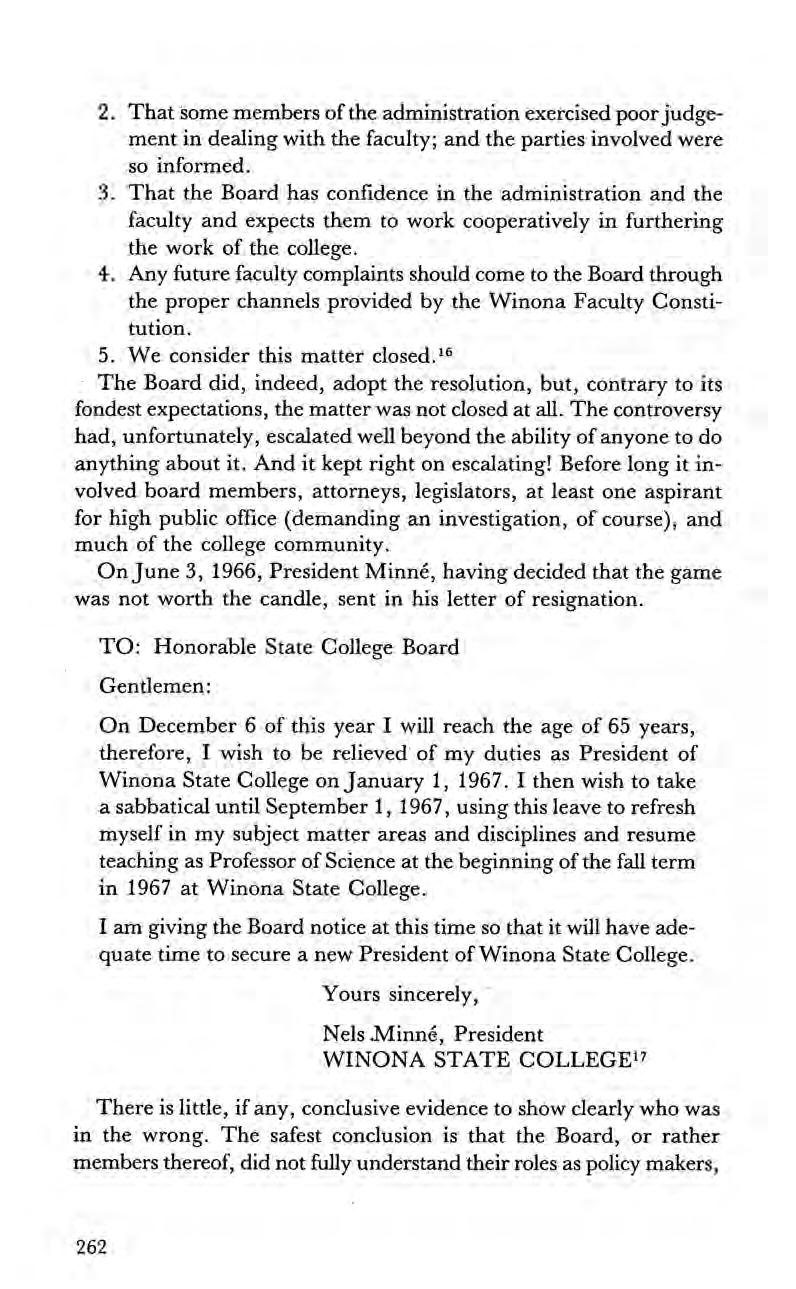
That the Board has confidence in the administration and the faculty and expects them to work cooperatively in furthering the work of the college.
Any future faculty complaints should come to the Board through the proper channels provided by the Winona Faculty Constitution.
5. That some members ofthe administration exercised poorjudgement in dealing with the faculty; and the parties involved were so informed.
We consider this matter closed.16
The Board did, indeed, adopt the resolution, but, contrary to its fondest expectations, the matter was not closed at all. The controversy had, unfortunately, escalated well beyond the ability of anyone to do anything about it. And it kept right on escalating! Before long it involved board members, attorneys, legislators, at least one aspirant for high public office (demanding an investigation, of course), and much of the college community.
On June 3, 1966, President Minné, having decided that the game was not worth the candle, sent in his letter of resignation.
TO: Honorable State College Board
Gentlemen:
On December6 of this year I will reach the age of 65 years, therefore, I wish to be relieved of my duties as President of Winona State College on January 1, 1967. I then wish to take a sabbatical until September 1, 1967, using this leave to refresh myself in my subject matter areas and disciplines and resume teaching as Professor of Science at the beginning of the fall term in 1967 at Winona State College.
I am giving the Board notice at this time so that it will have adequate time to secure a new President of Winona State College.
Yours sincerely,
Nels .Minné, President WINONA STATE COLLEGE?’
There is little, if any, conclusive evidence to show clearly who was in the wrong. The safest conclusion is that the Board, or rather members thereof, did not fully understand their roles as policy makers,
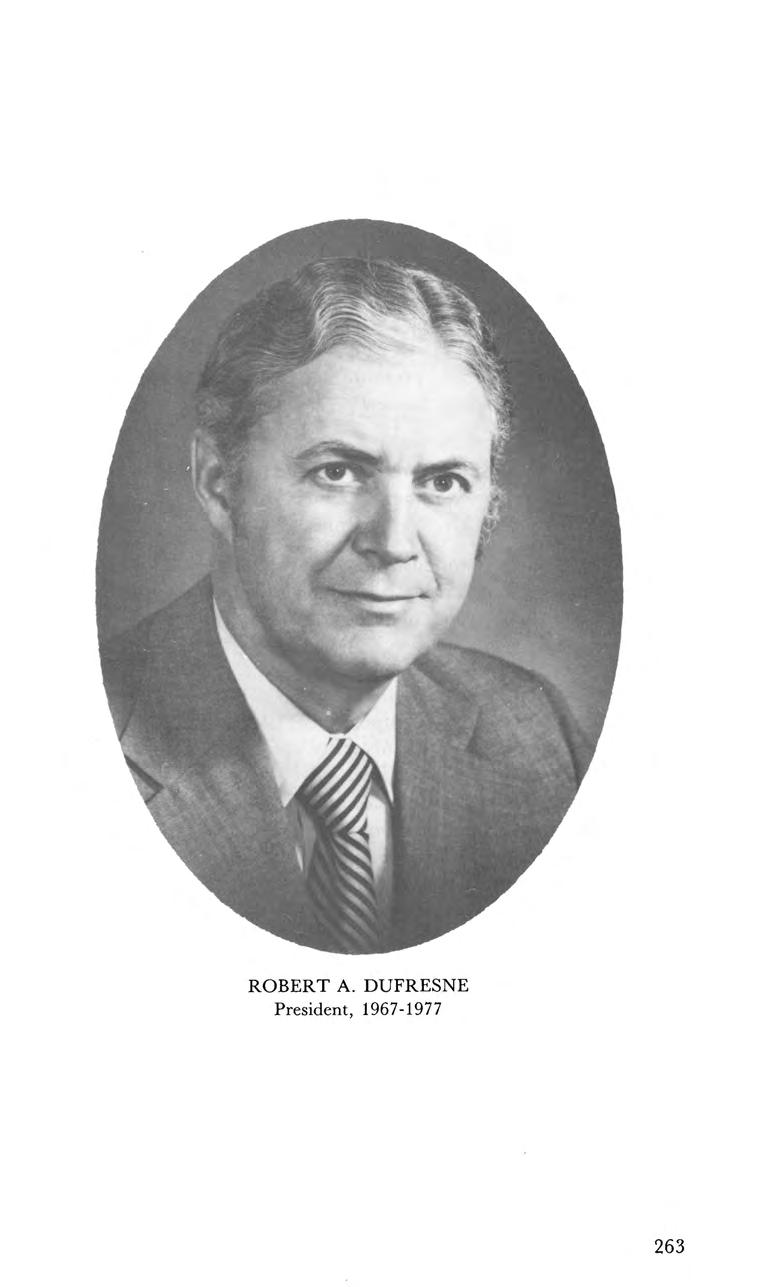
A. DUFRESNE President, 1967-1977
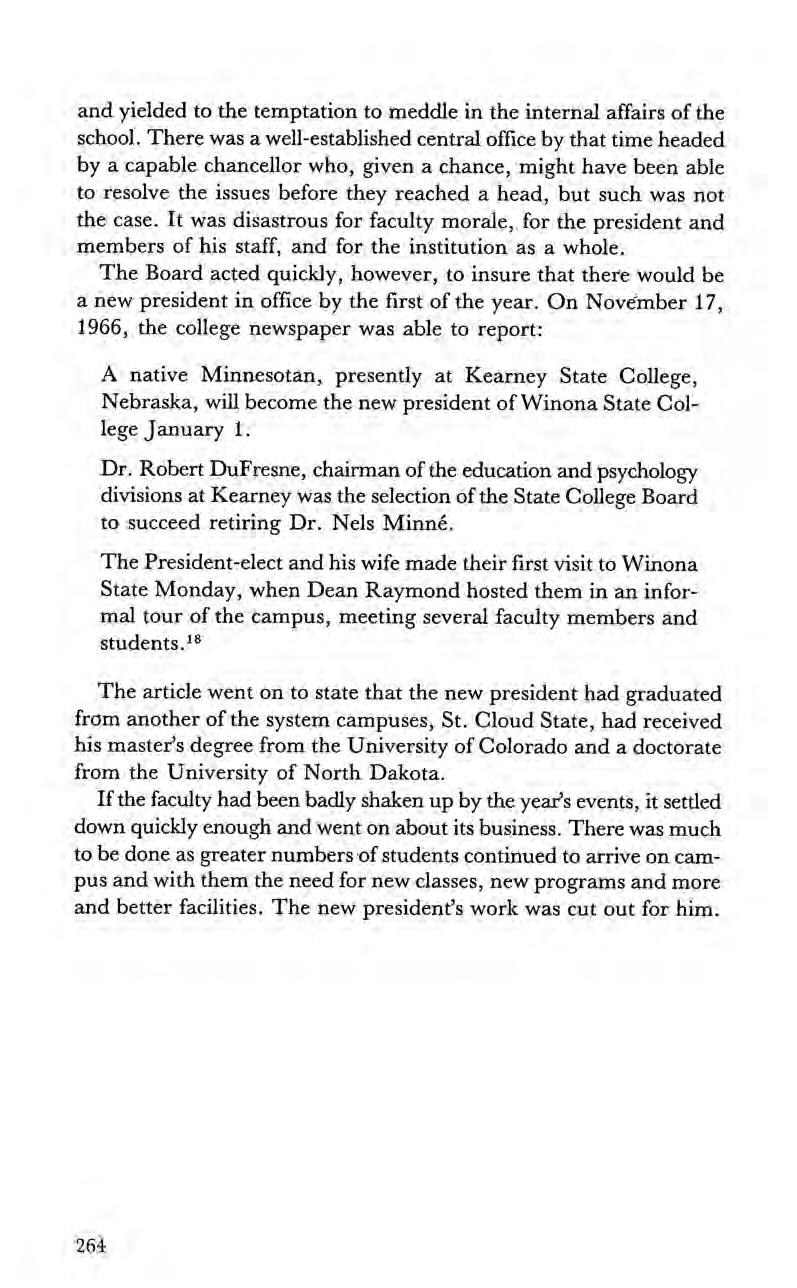
and yielded to the temptation to meddle in the internal affairs of the school. There was a well-established central office by that time headed by a capable chancellor who, given a chance, might have been able to resolve the issues before they reached a head, but such was not the case. It was disastrous for faculty morale, for the president and members of his staff, and for the institution as a whole.
The Board acted quickly, however, to insure that there would be a new president in office by the first of the year. On November 17, 1966, the college newspaper was able to report:
A native Minnesotan, presently at Kearney State College, Nebraska, will become the new president of Winona State College January 1.
Dr. Robert DuFresne, chairman of the education and psychology divisions at Kearney was the selection of the State College Board to succeed retiring Dr. Nels Minné.
The President-elect and his wife made their first visit to Winona State Monday, when Dean Raymond hosted them in an informal tour of the campus, meeting several faculty members and students.'®
The article went on to state that the new president had graduated from another of the system campuses, St. Cloud State, had received his master’s degree from the University of Colorado and a doctorate from the University of North Dakota.
If the faculty had been badly shaken up by the year’s events, it settled down quickly enough and went on about its business. There was much to be done as greater numbers of students continued to arrive oncampus and with them the need for new classes, new programs and more and better facilities. The new president’s work was cut out for him.
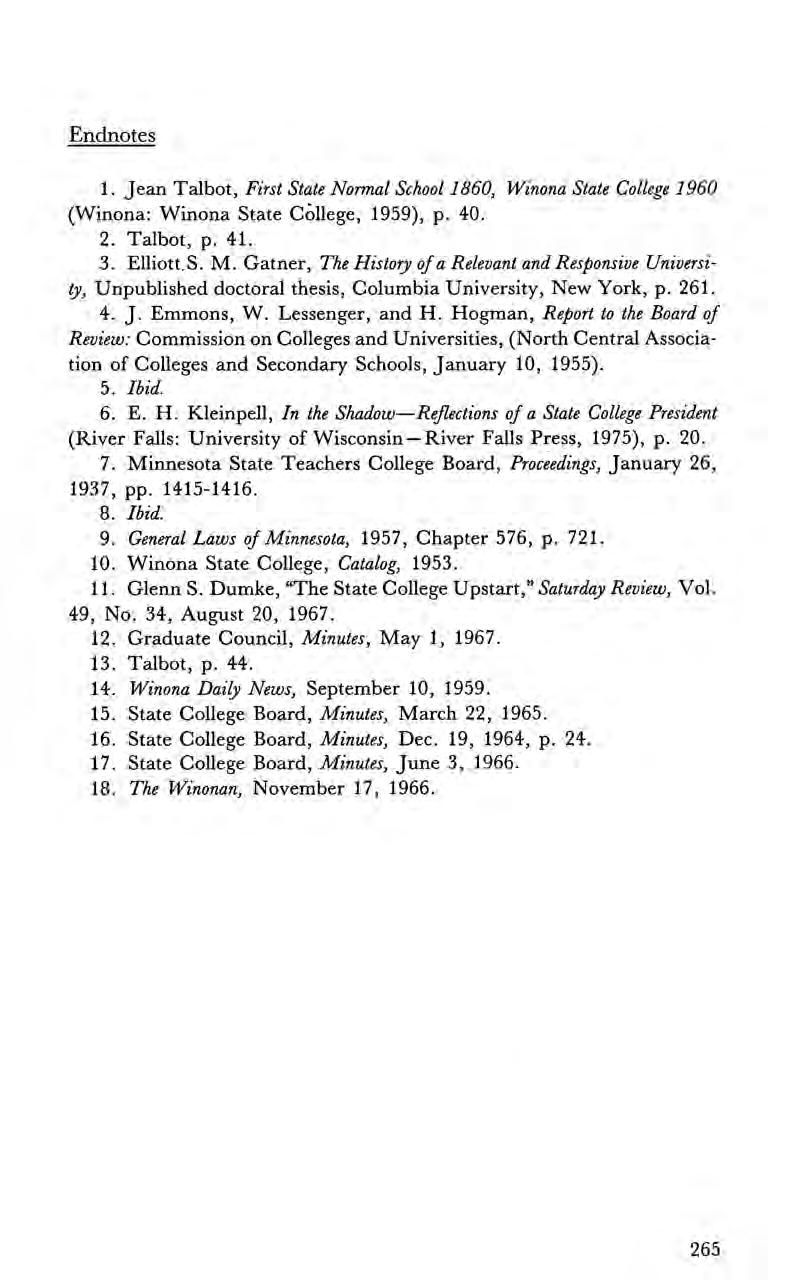
1. Jean Talbot, First State Normal School 1860, Winona State College 1960 (Winona: Winona State College, 1959), p. 40.
2. Talbot, p. 41.
3. Elliott.S. M. Gatner, The History of a Relevant and Responsive Universtty, Unpublished doctoral thesis, Columbia University, New York, p. 261.
4. J. Emmons, W. Lessenger, and H. Hogman, Report to the Board of Review: Commission on Colleges and Universities, (North Central Association of Colleges and Secondary Schools, January 10, 1955).
5. Ibid.
6. E. H. Kleinpell, In the Shadow—Reflections of a State College President (River Falls: University of Wisconsin— River Falls Press, 1975), p. 20.
7. Minnesota State Teachers College Board, Proceedings, January 26, 1937, pp. 1415-1416.
8. Ibid.
9. General Laws ofMinnesota, 1957, Chapter 576, p. 721.
10. Winona State College, Catalog, 1953.
11. Glenn S. Dumke, “The State College Upstart,” Saturday Review, Vol. 49, No. 34, August 20, 1967.
12. Graduate Council, Minutes, May 1, 1967.
13. Talbot, p. 44.
14. Winona Daily News, September 10, 1959.
15. State College Board, Minutes, March 22, 1965.
16. State College Board, Minutes, Dec. 19, 1964, p. 24.
17. State College Board, Minutes, June 3, 1966.
18. The Winonan, November 17, 1966.
CHAPTER IX

The eighteen years between 1967 and 1985, the year of this publication, was a remarkable period in the life ofWSU. It falls into roughly five phases: (1) the expansion phase during which the campus and the curriculum reached its current level of development; (2) the Viet Nam phase which affected this campus as it did campuses across the country; (3) the enrollment fall off of the mid ’70s which shook the system and threatened WSU; (4) the University phase during which the institution changed froma state college to a regional university; and (5) the collective bargaining phase which came about as a result of the Public Employees Labor Relations Act (PELRA).!
It was a remarkable period in other ways also. During these years the campus proper nearly doubled in size as seven new buildings and two major rebuilding projects were completed. The student body increased by some eighteen hundred students, and the faculty by over one hundred. The annual budget increased to over ten million dollars, and, as the educational thrust of the institution changed, so did the curricular offerings.
In 1967 Winona State College was still largely involved in producing elementary and secondary public school teachers. Some seventyfive percent of its graduates were being prepared in one or another of these programs, plus a few in special fields such as kindergarten education or counseling. ‘The remaining twenty-five percent were in non-teaching programs in business or taking degrees in academic fields such as biology or history. Such majors were taken as liberal arts degrees, sometimes leading to further studies, sometimes not. Although this constituted a sizable group, with 76 graduating with the Bachelor ofArts in the spring of 1968, they were still outnumbered two to one by teacher education graduates.
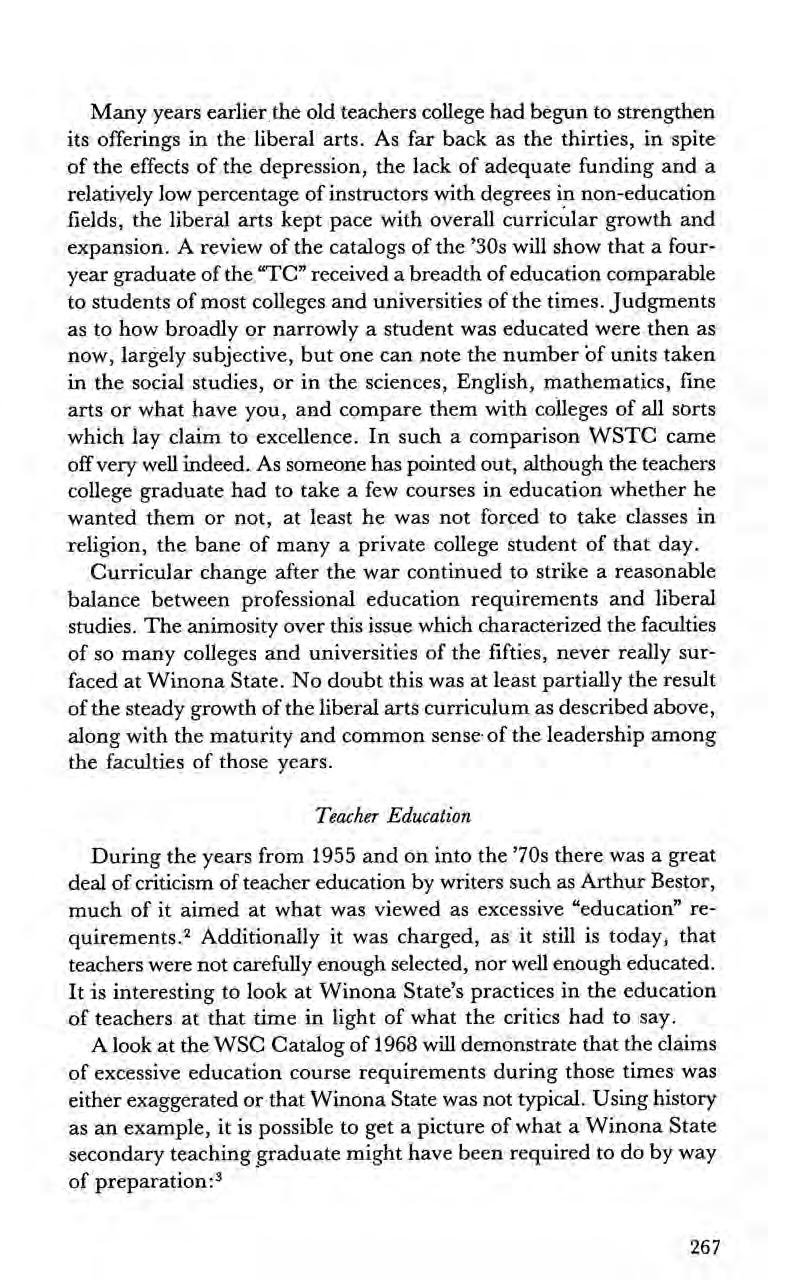
Many years earlier the old teachers college had begun to strengthen its offerings in the liberal arts. As far back as the thirties, in spite of the effects of the depression, the lack of adequate funding and a relatively low percentage of instructors with degrees in non-education fields, the liberal arts kept pace with overall curricular growth and expansion. A review of the catalogs of the ’30s will show that a fouryear graduate of the “TC” received a breadth of education comparable to students of most colleges and universities of the times. Judgments as to how broadly or narrowly a student was educated were then as now, largely subjective, but onecan note the number of units taken in the social studies, or in the sciences, English, mathematics, fine arts or what have you, and compare them with colleges of all sorts which lay claim to excellence. In such a comparison WSTC came offvery well indeed. As someone has pointed out, although the teachers college graduate had to take a few courses in education whether he wanted them or not, at least he was not forced to take classes in religion, the bane of manya private college student of that day. Curricular change after the war continued to strike a reasonable balance between professional education requirements and liberal studies. The animosity over this issue which characterizedthe faculties of so many colleges and universities of the fifties, never really surfaced at Winona State. No doubt this was at least partially the result of the steady growth of the liberal arts curriculum as described above, along with the maturity and common sense of the leadership among the faculties of those years.
During the years from 1955 and on into the ’70s there was a great deal of criticism of teacher education by writers such as Arthur Bestor, much of it aimed at what was viewed as excessive “education” requirements.? Additionally it was charged, as it still is today, that teachers were not carefully enough selected, nor well enough educated. It is interesting to look at Winona State’s practices in the education of teachers at that time in light of what the critics had to say. A look at the WSC Catalog of 1968 will demonstrate that the claims of excessive education course requirements during those times was either exaggerated or-that Winona State was not typical. Usinghistory as an example, it is possible to get a picture of what a Winona State secondary teachinggraduate might have been required to do by way of preparation:®

1. A major in history (The requirements were practically the same for either the B.A. or B.S. degree. The B.S. was designated as the degree for those going into teaching.)
2. A minor in a second academic field.
3. About twenty hours of professional courses:
Educational Psychology
Human Growth and Development
Psychology of Learning Evaluation
Classroom Observation and Participation
Instructional Media
Exceptional Children
Curriculum and Philosophy
4. Student Teaching
Secondary teacher candidates did not major in education. They normally carried a major and minor in subject matter fields and in addition took the eight courses shown above plus one quarter of student teaching.
On the elementary level the story was different of course. The student actually majored in education if he or she expected to teach kindergarten or grades one through six. A few of the arch-critics of the time claimed to believe that teachers of elementary children should have majors in math or philosophy or some other academic field and that a knowledge and understanding of children was not necessary that the teacher really did not even need to like children in order to be effective. It is not difficult to see that there would be little reconciling of viewsbetween such people and the educationists who felt that an elementary teacher should knowa great deal about children and how to work with them, along with the subject matter of the elementary school. Winona State’s philosophy was the latter one, as might be expected. The elementary teaching curriculum included the standard methods courses and psychology courses required for elementary teaching by practically all colleges in the United States, private or public. As a matter of fact the Minnesota State Department of Education would not have allowed it to be any other way.*

The debate over how teachers should be trained had beguna long time before the 1960s, of course. The briefhistory ofthe normal school movement in the United States given at the beginning of this book, demonstrates that back then there were those who felt that teachers needed to know only enough to keep thema bit ahead of their students and that strong discipline would take care of the rest. Some begrudged even having to pay people to teach in the first place! As late as 1898 William McAndrews, a well-known educator of the times stated, “The occupation of teaching and the act of drawing pay have always been mutually repulsive and must always be the idea of money in connection with teaching is distasteful to everyone imbued with the purest zeal for giving instruction. A teacher whose name becomes associated with agitations for higher wages is liable to a loss of the bloom from his best teaching spirit.”
This lofty attitude was heartily applauded by the general public, for in addition to the fine ideals it portrayed it was also an effective means of keeping school levies at a minimum. “And if perchance,” as Willard Elsbree wrote, “low salaries caused teachers to display some anxiety about their material welfare, the community of business people, themselves strenuously engaged in pursuing the golden dollar, were revolted by the crass self interest of a supposedly spirituallyminded profession.”®
If the taxpaying public, whether of that day or of the 1960s and ’70s, settled for minimum training, minimum salaries and minimum facilities for teachers, the resultant quality of the end product must always be in question. It seems clear, however, from various reports of the North Central Association and the National Council for Accreditation of Teacher Education, that the Winona program was as good as most and considerably better than many. And it appears to have continued strong during the ’70s and into the 80s. The Commission on Institutions of Higher Education of the North Central Association indicated, following its visit to the campus in 1981, that “The Institution appears after evaluation by the Commission to be accomplishing its purpose substantially. Winona State is a regional state university with an excellent general reputation . .”’
There are at least two approaches to admitting prospective students to colleges and universities in this country: one is to be selective and
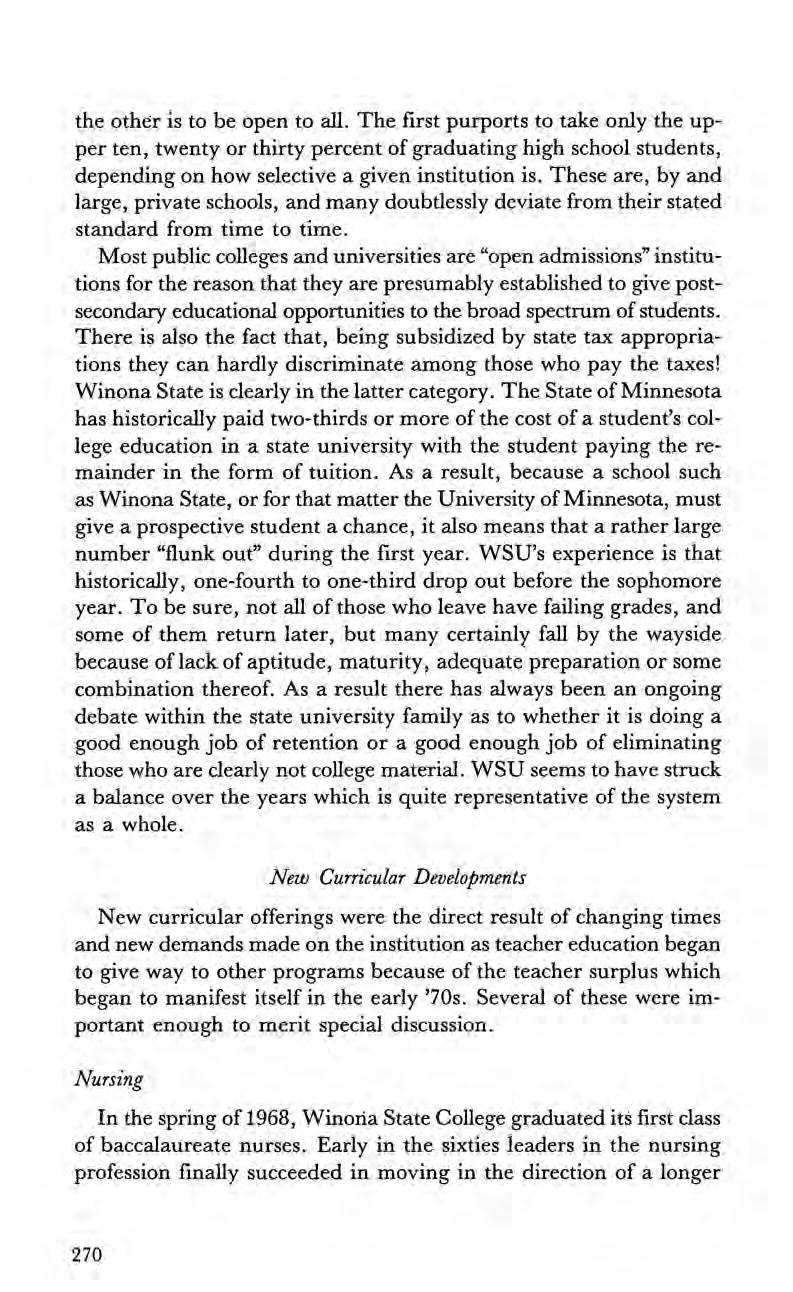
the other is to be open to all. The first purports to take only the upper ten, twenty or thirty percent of graduating high school students, depending on how selective a given institution is. These are, by and large, private schools, and many doubtlessly deviate from their stated standard from time to time.
Most public colleges and universities are “open admissions” institutions for the reason that they are presumably established to give postsecondary educational opportunities to the broad spectrum of students. There is also thefact that, being subsidized by state tax appropriations they can hardly discriminate among those who pay the taxes! Winona State is clearly in the latter category. The State of Minnesota has historically paid two-thirds or more of the cost of a student’s college education in a state university with the student paying the remainder in the form of tuition. As a result, because a school such as Winona State, or for that matter the University of Minnesota, must give a prospective student a chance, it also means that a rather large number “flunk out” during the first year. WSU’s experience is that historically, one-fourth to one-third drop out before the sophomore year. To be sure, not all of those who leave have failing grades, and some of them return later, but many certainly fall by the wayside because of lack of aptitude, maturity, adequate preparation or some combination thereof. As a result there has always been an ongoing debate within the state university family as to whether it is doing a good enough job of retention or a good enough job of eliminating those who are clearly not college material. WSU seems to have struck a balance over the years which is quite representative of the system as a whole.
New curricular offerings were the direct result of changing times and new demands made on the institution as teacher education began to give way to other programs because of the teacher surplus which began to manifest itself in the early ’70s. Several of these were important enough to merit special discussion.
In the spring of 1968, Winona State College graduated its first class of baccalaureate nurses. Early in the sixties leaders in the nursing profession finally succeeded in moving in the direction of a longer
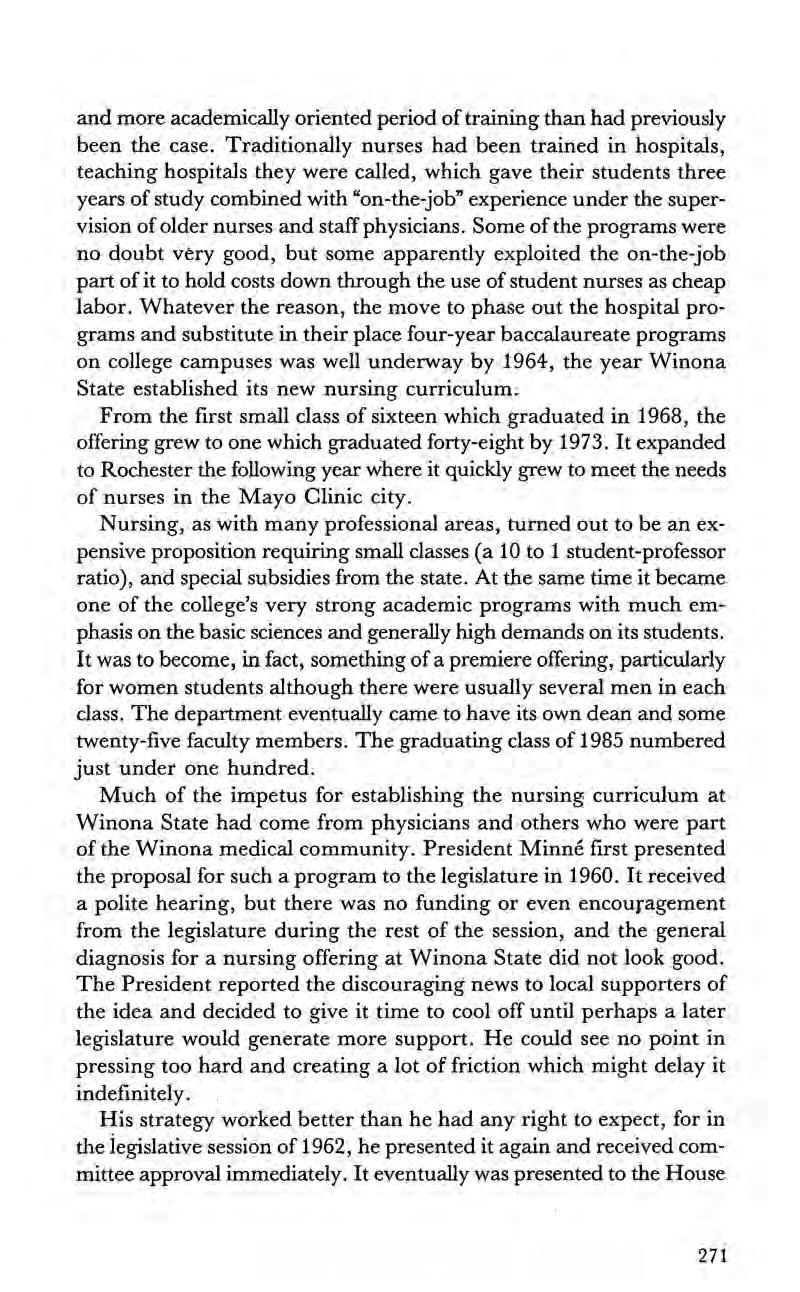
and more academically oriented period oftraining than had previously been the case. Traditionally nurses had been trained in hospitals, teaching hospitals they were called, which gave their students three years of study combined with “on-the-job” experience under the supervision of older nurses and staffphysicians. Some ofthe programs were no doubt very good, but some apparently exploited the on-the-job part ofit to hold costs down through the use of student nurses as cheap labor. Whatever the reason, the move to phase out the hospital programs and substitute in their place four-year baccalaureate programs on college campuses was well underway by 1964, the year Winona State established its new nursing curriculum.
From the first small class of sixteen which graduated in 1968, the offering grew to one which graduated forty-eight by 1973. It expanded to Rochester the following year where it quickly grew to meet the needs of nurses in the Mayo Clinic city.
Nursing, as with many professional areas, turned out to be an expensive proposition requiring small classes (a 10 to 1 student-professor ratio), and special subsidies from the state. At the same time it became one of the college’s very strong academic programs with much emphasis on thebasic sciences and generally high demands on its students. It was to become, in fact, something of a premiere offering, particularly for women students although there were usually several men in each class. The department eventually came to have its own dean and some twenty-five faculty members. The graduating class of 1985 numbered just under one hundred.
Much of the impetus for establishing the nursing curriculum at Winona State had come from physicians and others who were part of the Winona medical community. President Minné first presented the proposal for such a program to the legislature in 1960. It received a polite hearing, but there was no funding or even encouragement from the legislature during the rest of the session, and the general diagnosis for a nursing offering at Winona State did not look good. The President reported the discouraging news to local supporters of the idea and decided to give it time to cool off until perhaps a later legislature would generate more support. He could see no point in pressing too hard and creatinga lot of friction which might delay it indefinitely.
His strategy worked better than he had any right to expect, for in the legislative session of 1962, he presented it again and received committee approval immediately. It eventually was presented to the House

and Senate for a vote and passed. Apparently those who opposed it in 1960 (including, curiously, several local people) had either changed their minds or lost their clout. Mysterious are the ways of the legislature.
The 1960s saw the rise of the “specialist programs.” These began as interim level programs designed primarily for public school administrators who needed further training beyond the master’s level but not as far as the doctorate. Eventually the specialist category also came to include studies in certain teaching fields for individuals planning to teach at the community college level. Some of these offerings came to be referred to as “specialist degrees”, the culmination of one year of study beyond the master’s level, or a total of six years of study. Winona State launched its specialist degree offering in 1969 ina report to the North Central Association.* The proposal was strengthened by a new state requirement that school administrators be trained at that level.? Winona State had already granted 142 master’s degrees in administration by then, so going on to the specialist level was a natural progression. Actual approval by the N.C.A. came in 1971. By the time university designation came about the degree was very much part of the graduate curriculum. It did not expand beyond the administration focus, however, but limited itself to the needs ofelementary and secondary administrators.
The 1977 catalog states as follows:
The Specialist Degree in Educational Administration is designed for persons who wish to achieve, by a planned program of graduate studies, proficiency beyond the master’s degree level in elementary, secondary, or general school administration. The program is available to persons with or without the master’s degree.
Completion of the program will enable the qualified student to meet the requirements of the Minnesota State Department of Education for the Professional Certificate in Educational Administration. The Professional Certificate, however, will not be granted to recipients of the degree until they have provided evidence of three years of successful teaching experience; for elementary principals, experience must be at the elementary
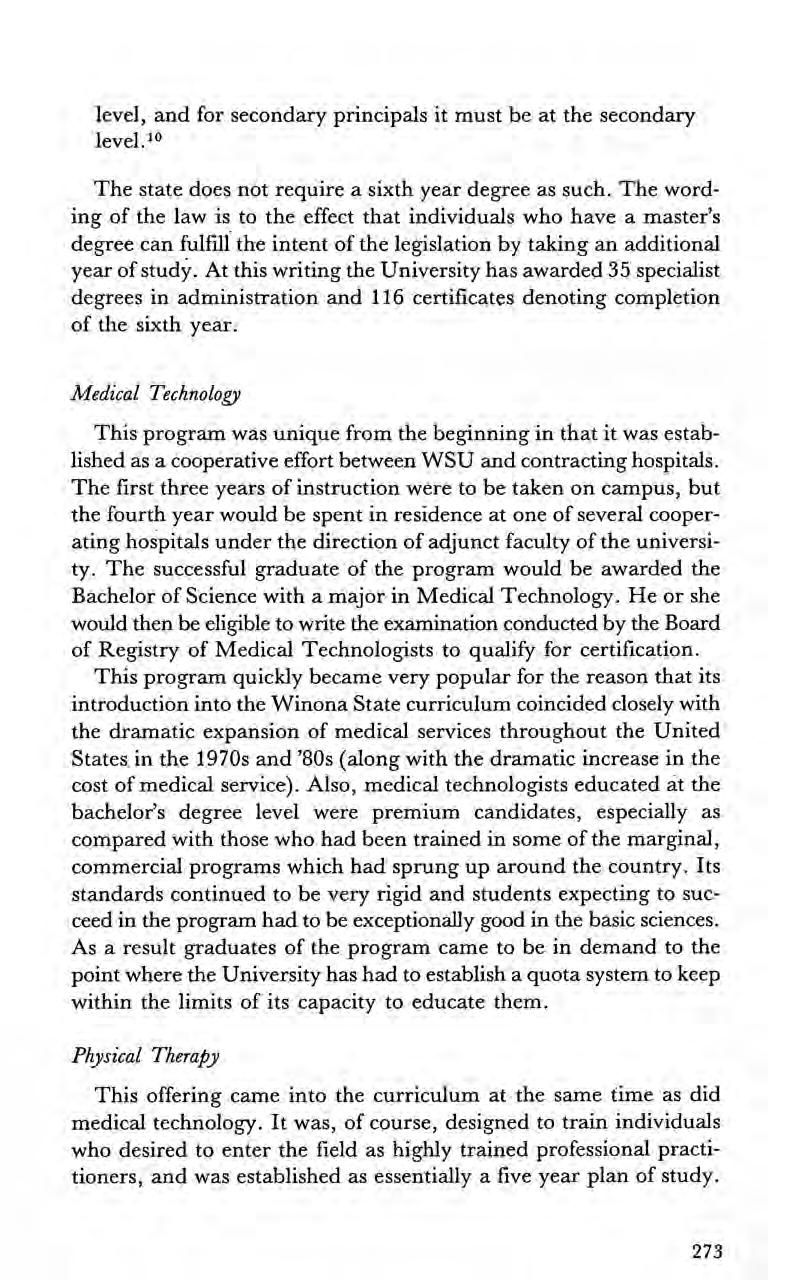
level, and for secondary principals it must be at the secondary level.'°
The state does not require a sixth year degree as such. The wording of the law is to the effect thatindividuals who have a master’s degree can fulfill the intent of the legislationby taking an additional year of study. At this writing the University has awarded 35 specialist degrees in administration and 116 certificates denoting completion of the sixth year.
This program was unique from the beginning in that it was established as a cooperative effort between WSU and contracting hospitals. The first three years of instruction were to be taken on campus, but the fourth year would be spent in residence at one of several cooperating hospitals under the direction of adjunct faculty of the university. The successful graduate of the program would be awarded the Bachelor of Science with a major in Medical Technology. He or she would then be eligible to write the examination conducted by the Board of Registry of Medical Technologists to qualify for certification. This program quickly became very popular for the reason that its introduction into the Winona State curriculum coincided closely with the dramatic expansion of medical services throughout the United States in the 1970s and ’80s (along with the dramatic increase in the cost of medical service). Also, medical technologists educated at the bachelor’s degree level were premium candidates, especially as compared with those who had been trained in some of the marginal, commercial programs which had sprungup around the country. Its standards continued to be very rigid and students expecting to succeed in the program had to be exceptionally good in the basic sciences. As a result graduates of the program came to be in demand to the point where the University has had to establish a quota system to keep within the limits of its capacity to educate them.
This offering came into the curriculum at the same time as did medical technology. It was, of course, designed to train individuals who desired to enter the field as highly trained professional practitioners, and was established as essentially a five year plan of study.

The first three years were designed to insure competency in biology, chemistry, physics and mathematics. Also during this first half, the student studied the humanities and social sciences as prescribed by the general education requirement.
The second part of the offering was to be taken witha clinical school, literally the “hands on” phase of the program. In this respect it was like the medical technology program with the student attending hospital or other clinical programs during the last two years after which he or she received the Bachelor of Science in Medical Technology and was eligible for the Registry of Physical Therapist qualifying examination. Ofthose who have attempted the qualifying examination, none have failed, a fact which attests to the high academic standards maintained by the department, as well as to the character and ability of the students who enter the field.
In the early ’70s, there were but a very few paralegal training programs in the country. Members of Winona State’s departments of history, political science and sociology had held discussions from time to time of the possibilities for such an offering at WSU, and in 1973, a prospectus was submitted to the president for his review and approval. It stated that those departments felt that they already had many of the course offerings as well as the ability to work together in order to offer such a program. Several new courses directly related to the work of para-professionals in the legal field would have to be added. Members of the legal profession in Winona had already volunteered to teach these courses so no new permanent faculty would be required. The president and the curriculum committee responded immediately and enthusiastically as did the state university board, and the program was on its way.
These programs were, at least to some extent, the outgrowth of the burgeoning legal services in the United States during the period ofthe ’70s when it seemed at times that everyone was filing suit against everyone else! The job of the paralegal staff person in a law office includes doing much of the legal research pertaining to whatever facet of the law the firm or the individual lawyer deals in, so the paralegal student actually studied in four phases: general education, interdisciplinary foundations, professional specialization, and foundations of the law, with lawyers doing much of the teaching as adjunct faculty.
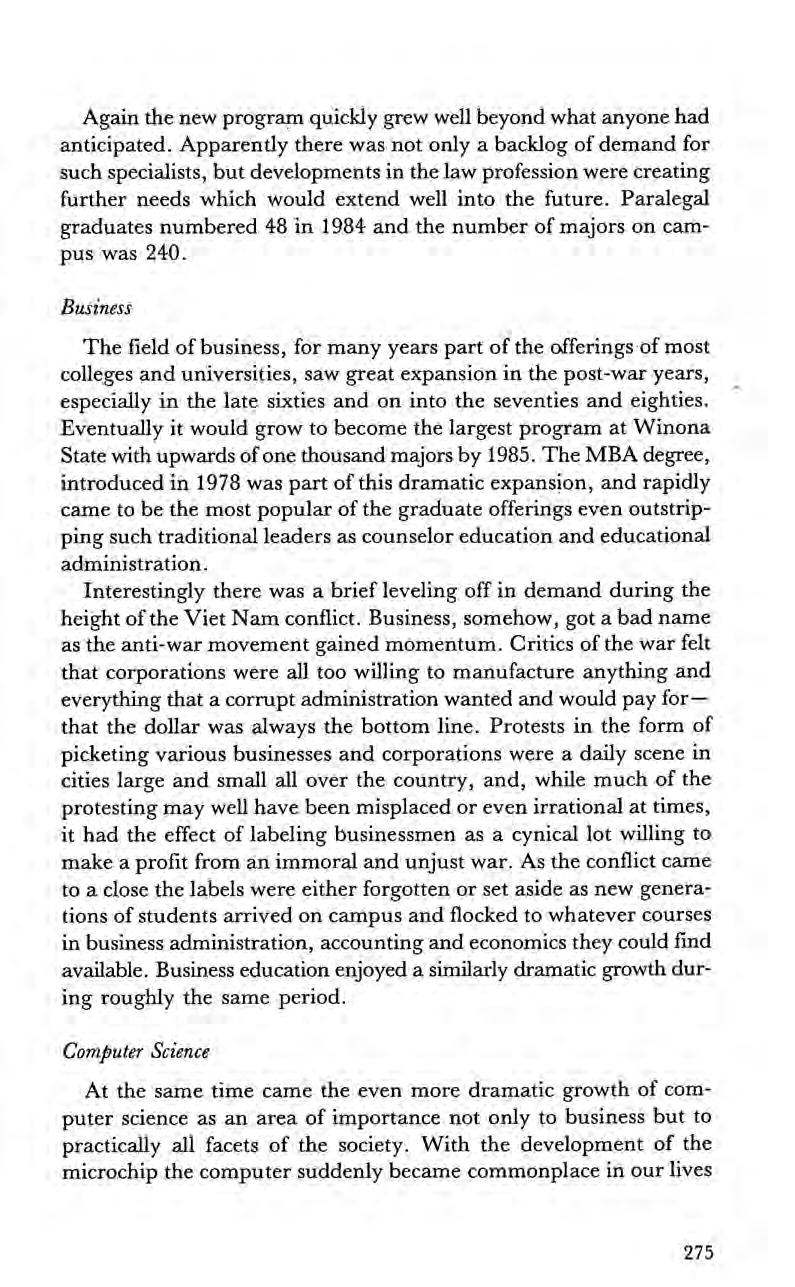
Again the new program quickly grew well beyond what anyone had anticipated. Apparently there was not only a backlog of demand for such specialists, but developments in the law profession were creating further needs which would extend well into the future. Paralegal graduates numbered 48 in 1984 and the number of majors on campus was 240.
The field of business, for many years part of the offerings-of most colleges and universities, saw great expansion in the post-war years, especially in the late sixties and on into the seventies and eighties. Eventually it would grow to becomethe largest program at Winona State with upwards of one thousand majors by 1985. ‘The MBA degree, introduced in 1978 was part of this dramatic expansion, and rapidly came to be the most popular of the graduate offerings even outstripping such traditional leaders as counselor education and educational administration.
Interestingly there was a brief leveling off in demand during the height of the Viet Nam conflict. Business, somehow, got a bad name as the anti-war movement gained momentum. Critics of the war felt that corporations were all too willing to manufacture anything and everything that a corrupt administration wanted and would pay for— that the dollar was always the bottom line. Protests in the form of picketing various businesses and corporations were a daily scene in cities large and small all over the country, and, while much of the protesting may well have been misplaced or even irrational at times, it had the effect of labeling businessmen as a cynical lot willing to make a profit from an immoral and unjust war. As the conflict came to a close the labels were either forgotten or set aside as new generations of students arrived on campus and flocked to whatever courses in business administration, accounting and economics they could find available. Business education enjoyed a similarly dramatic growth during roughly the same period.
At the same time came the even more dramatic growth of computer science as an area of importance not only to business but to practically all facets of the society. With the development of the microchip the computer suddenly became commonplace in our lives
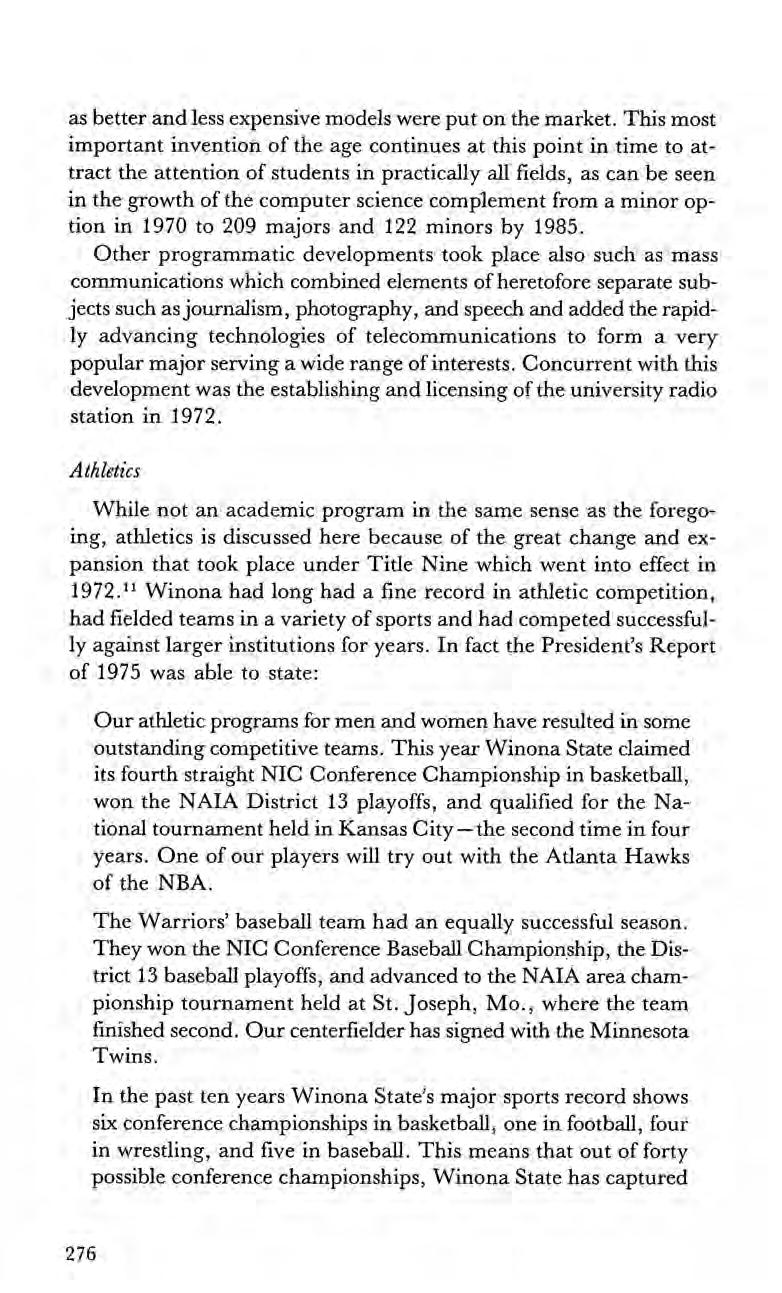
as better and less expensive models were put on the market. This most important invention of the age continues at this point in time to attract the attention of students in practically all fields, as can be seen in the growth of the computer science complement from a minor option in 1970 to 209 majors and 122 minors by 1985.
Other programmatic developments took place also such as mass communications which combined elements of heretofore separate subjects such as journalism, photography, and speech and addedthe rapidly advancing technologies of telecommunications to form a very popular major serving a wide range of interests. Concurrent with this development was the establishing and licensing of the university radio station in 1972.
While not an academic program in the same sense as the foregoing, athletics is discussed here because of the great change and expansion that took place under Title Nine which went into effect in 1972.'! Winona had long hada fine record in athletic competition, had fielded teams in a variety of sports and had competed successfully against larger institutionsfor years. In fact the President’s Report of 1975 was able to state:
Our athletic programs for men and women have resulted in some outstanding competitive teams. This year Winona State claimed its fourth straight NIC Conference Championship in basketball, won the NAIA District 13 playoffs, and qualified for the National tournament held in Kansas City the second time infour years. One of our players will try out with the Atlanta Hawks of the NBA.
The Warriors’ baseball team had an equally successful season. They won the NIC Conference Baseball Championship, the District 13 baseball playoffs, and advanced to the NAIA area championship tournament held at St. Joseph, Mo., where the team finished second. Our centerfielder has signed with the Minnesota Twins.
In the past ten years Winona State’s major sports record shows six conference championships in basketball, one in football, four in wrestling, and five in baseball. This means that out of forty possible conference championships, Winona State has captured
Among the students enrolled
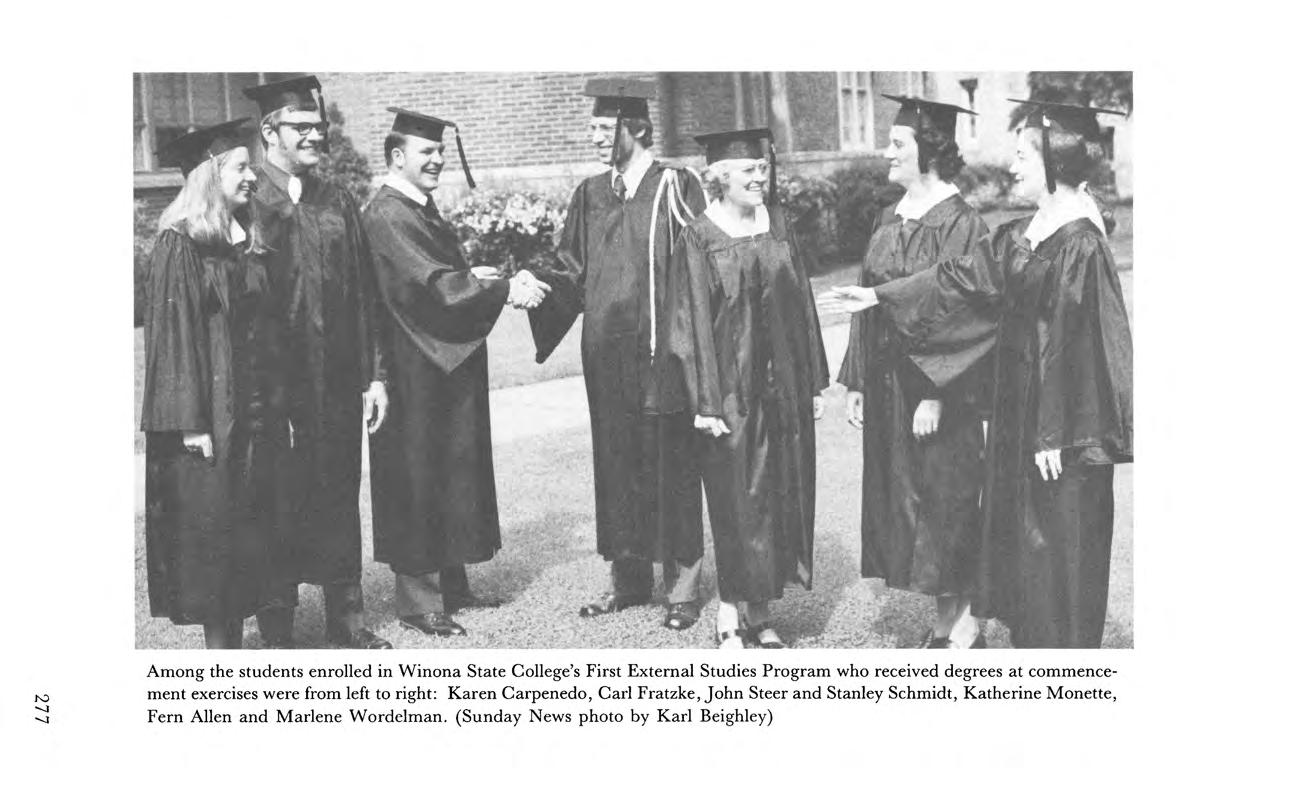
who received

sixteen. This has to be the best record in the Northern Intercollegiate Conference for this span of years.
Winona State’s Women’s Athletic Program sponsored teams in volleyball, basketball, tennis, softball, swimming, and gymnastics. For the past two years, interest in competitive athletics and the skill level of participants have been increasing steadily. The basketball team finished with a 7-1 record and the gymnastics team with a 4-3 record in state competition. !?
The difference between this report and previous such reports is seen in the last paragraph. Women were now competing as the men had been doing for years, and were to continue to do so in ever greater numbers. A few years later women’s gymnastics reacheda level of excellence such that the headlines proclaimed in the fall of 1984, “WSU Gymnasts Take 2nd in Nationals.”!3
But the transition was not easy. The athletic budget had been barely adequate for the men over the years. Never had they stayed in plush hotels nor traveled the long distances of the Midwest by chartered airplanes, except for an occasional gift of a trip by the Watkins Company back in the days when it maintained a corporate aircraft. Nevertheless Title Nine required that the same expenditures should be made on women’s athletics as on men’s. The institution had no extra money nor did the student activity fund. The answer was to cut the men’s budget practically by one-half and finance the women’s program with the other half!
And that was what was done. Remarkably, it worked itself out, not without difficulty to be sure. The football team especially felt the effects, and later wrestling, a popular and successful sport at WSU, was actually discontinued. Generally speaking the men accepted it as something which had to be although certainly a few of them expressed reservations privately. Most, however, recognized the injustice of the previous practice which gave males practically the sole privilege of representing the institution and benefiting from the competition and enjoyment of intercollegiate sports. It was more than simply unfair; it was absurd, that the men should have the fun and the women should lead the cheers. It was a throw-back to the days when nice girls were not supposed to sweat. We know now that their locker rooms smell no better than those of the men!
The rise of women’s athletics is typical of developments of the ’60s and ’70s. In some ways more social change took place during those
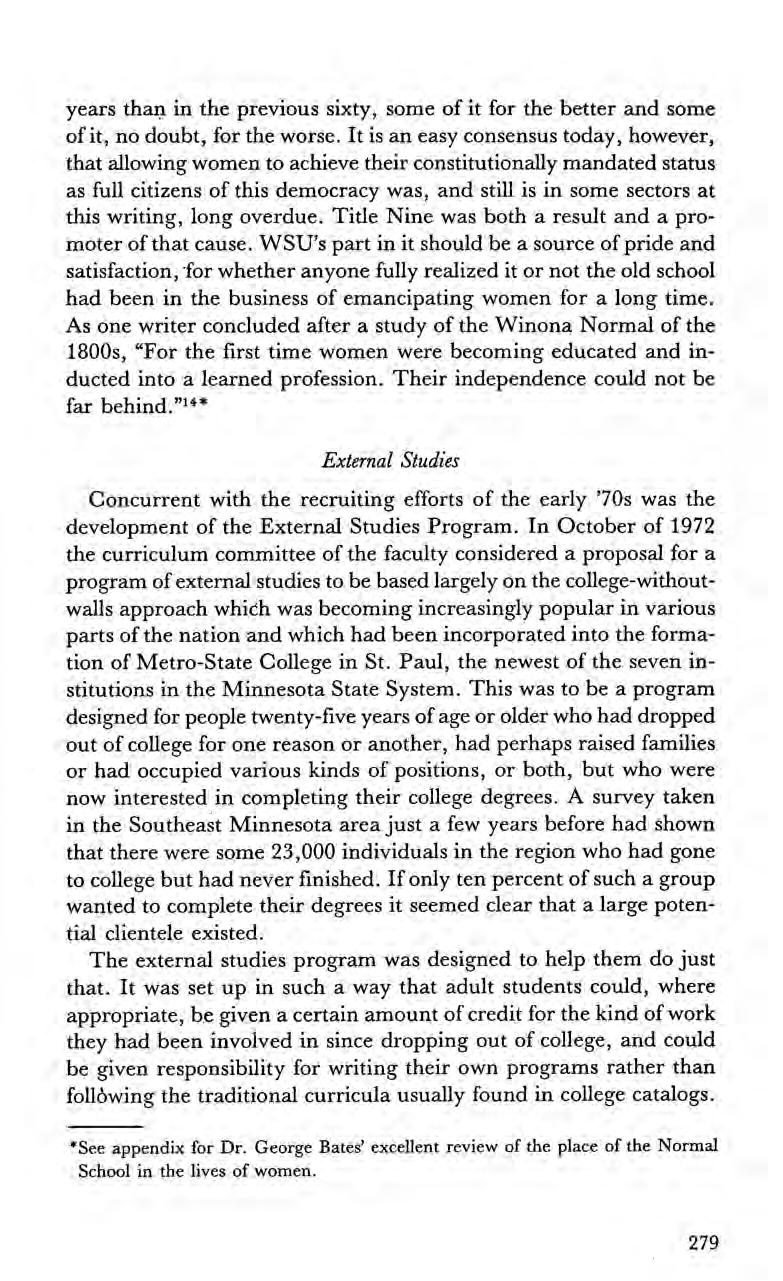
years than in the previous sixty, some of it for the better and some of it, no doubt, for the worse. It is an easy consensus today, however, that allowing women to achieve their constitutionally mandated status as full citizens of this democracy was, and still is in some sectors at this writing, long overdue. Title Nine was both a result and a promoter of that cause. WSU’s part in it should be a source of pride and satisfaction, for whether anyone fully realized it or not the old school had been in the business of emancipating women for a long time. As one writer concluded after a study of the Winona Normal of the 1800s, “For the first time women were becoming educatedand inducted into a learned profession. Their independence could not be far behind.”!**
Concurrent with the recruiting efforts of the early ’70s was the development of the External Studies Program. In October of 1972 the curriculum committee of the faculty considered a proposal for a program of external studies to be based largely on the college-withoutwalls approach which was becoming increasingly popular in various parts of the nation and which had been incorporated into the formation of Metro-State College in St. Paul, the newest of the seven institutions in the Minnesota State System. This was to be a program designed for people twenty-five years of age or older who had dropped out of college for one reason or another, had perhaps raised families or had occupied various kinds of positions, or both, but who were. now interested in completing their college degrees. A survey taken in the Southeast Minnesota area just a few years beforehad shown that there were some 23,000 individuals in the region who had gone to college but had never finished. If only ten percent of such a group wanted to complete their degrees it seemed clear that a large potential clientele existed.
The external studies program was designed to help them do just that. It was set up in such a way that adult students could, where appropriate, be given a certain amount of credit for the kind of work they had been involved in since dropping out of college, and could be given responsibility for writing their own programs rather than following the traditional curricula usually found in college catalogs.
*See appendix for Dr. George Bates’ excellent review of the place of the Normal School in the lives of women.
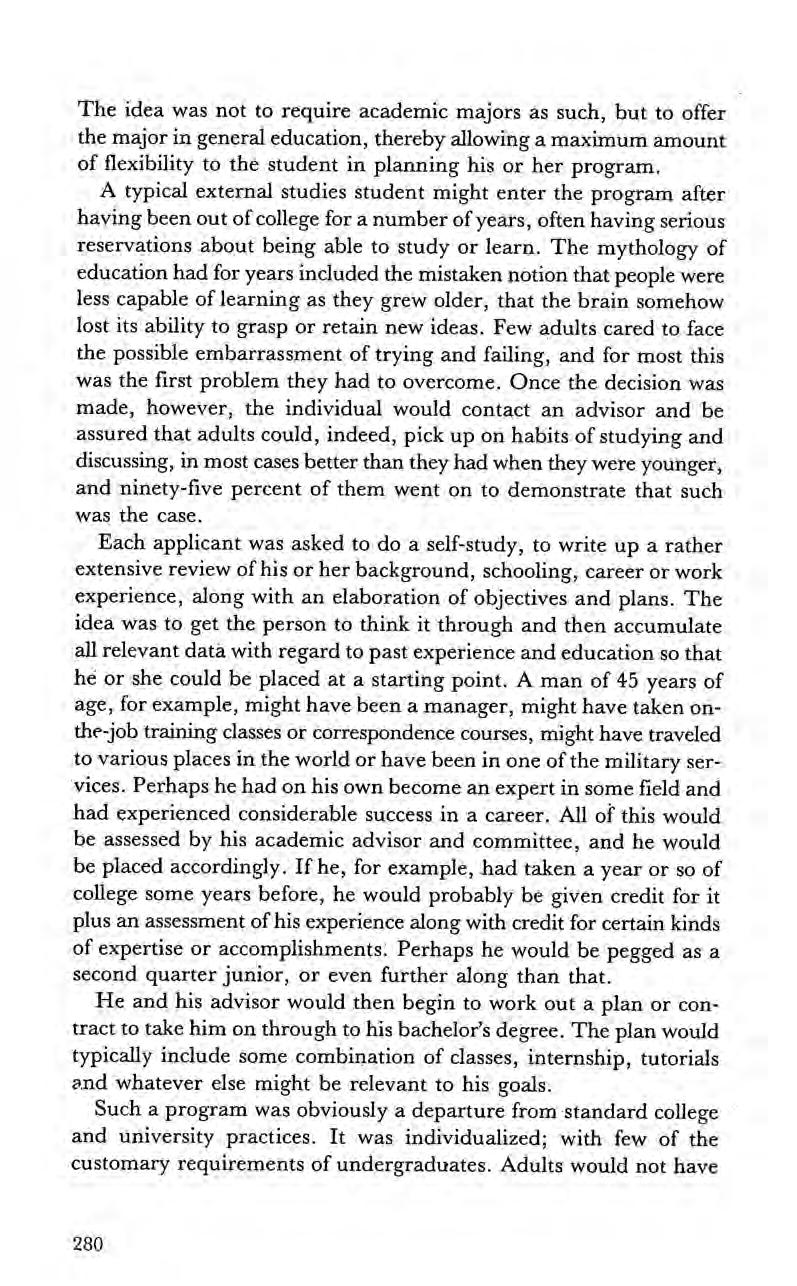
The idea was not to require academic majors as such, but to offer the major in general education, thereby allowing a maximum amount of flexibility to the student in planning his or her program.
A typical external studies student might enter the program after having been out of college for a number ofyears, often having serious reservations about being able to study or learn. The mythology of education had for years included the mistaken notion that people were less capable of learning as they grew older, that the brain somehow lost its ability to grasp or retain new ideas. Few adults cared to face the possible embarrassment of trying and failing, and for most this was the first problem they had to overcome. Once the decision was made, however, the individual would contact an advisor and be assured that adults could, indeed, pick up on habits of studying and discussing, in most cases better than they had when they were younger, and ninety-five percent of them went on to demonstrate that such was the case.
Each applicant was asked to doa self-study, to write up a rather extensive review ofhis or her background, schooling, career or work experience, along with an elaboration of objectives and plans. The idea was to get the person to think it through and then accumulate all relevant data with regard to past experience and education so that he or she could be placed at a starting point. A man of 45 years of age, for example, might have been a manager, might have taken onthe-job training classes or correspondence courses, might have traveled to various places in the world or have been in one of the military services. Perhaps he had on his own become an expert in some field and had experienced considerable success in a career. All of this would be assessed by his academic advisor and committee, and he would be placed accordingly. If he, for example, had taken a year or so of college some years before, he would probably be given credit for it plus an assessment of his experience along with credit for certain kinds of expertise or accomplishments: Perhaps he would be pegged as a second quarter junior, or even further along than that.
He and his advisor would then begin to work out a plan or contract to take him on through to his bachelor’s degree. The plan would typically include some combination of classes, internship, tutorials and whatever else might be relevant to his goals.
Such a program was obviously a departure from standard college and university practices. It was individualized; with few of the customary requirements of undergraduates. Adults would not have
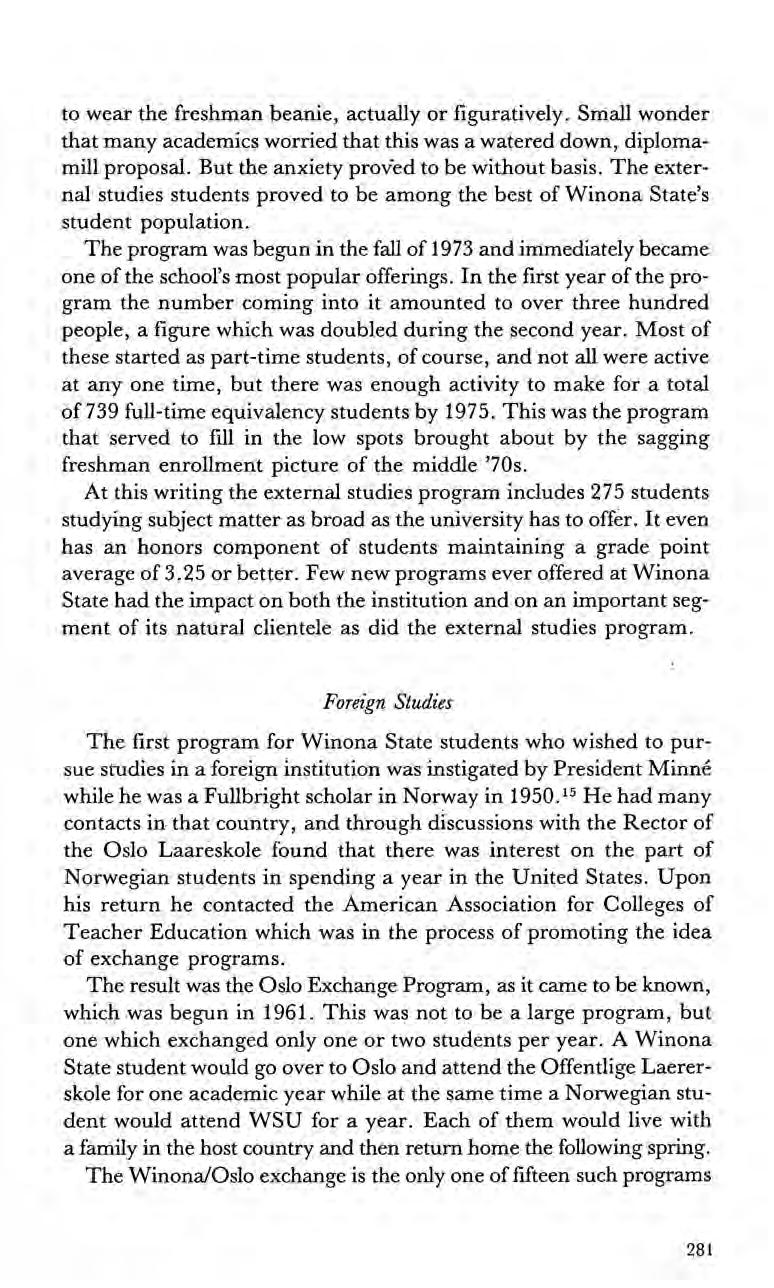
to wear the freshman beanie, actually or figuratively. Small wonder that many academics worried that this was a watered down, diplomamill proposal. But the anxiety proved to be without basis. ‘The external studies students proved to be among the best of Winona State’s student population.
The program was begun in the fall of 1973 and immediately became one of the school’s most popular offerings. In the first year of the program the number coming into it amounted to over three hundred people, a figure which was doubled during the second year. Most of these started as part-time students, of course, and not all were active at any one time, but there was enough activity to make for a total. of 739 full-time equivalency students by 1975. This was the program that served to fill in the low spots brought about by the sagging freshman enrollment picture of the middle ’70s.
At this writing the external studies program includes 275 students studying subject matter as broad as the university has to offer. It even has an honors component of students maintaining a grade point average of 3.25 or better. Few new programs ever offered at Winona State had the impact on both the institution and on an important segment of its natural clientele as did the external studies program.
The first program for Winona State students who wished to pursue studies in a foreign institution was instigated by President Minné while he was a Fullbright scholar in Norway in 1950.1° He had many contacts in that country, and through discussions with the Rector of the Oslo Laareskole found that there was interest on the part of Norwegian students in spending a year in the United States. Upon his return he contacted the American Association for Colleges of Teacher Education which was in the process of promoting the idea of exchange programs.
The result was the Oslo Exchange Program, as it came to be known, which was begun in 1961. This was not to be a large program, but one which exchanged only one or two students per year. A Winona State student would go over to Oslo and attend the Offentlige Laererskole for one academic year while at the same time a Norwegian student would attend WSU for a year. Each of them would live with a family in thehost country and then return home the following spring.
The Winona/Oslo exchange is the only one of fifteen such programs

to continue without interruption since that time. By now upwards of sixty students from both institutions have participated, and there have been marriages and families and all the rest which might be expected from such an arrangement.
In 1985, however, studying abroad is an accepted idea and is expanding rapidly in almost all higher education institutions. It is part of the world’s increasing internationalization, and involves hundreds more people than in years past.
Today WSU has, in addition to the Oslo program, at least two other opportunities for its students to study abroad. One has been in cooperation with St. Cloud State and has had the participation of over two hundred students over the past five years, going to England, Denmark, France, Germany and Spain. In addition WSU now has a studies-abroad arrangement with the Brighton Polytechnic in Brighton, England.
Beginning about 1981 there appeared on the W.S.U. campus students in the uniform of the U. S. Army. These were members of the newly established R.O.T.C. unit. The subject of R.O.T.C. had come up from time to time during the previous ten years, but college administrators were understandably less than enthusiastic about starting such programs during the Viet Nam Era. As with all such programs its purpose is to train the potential leadership of the army of the future. As contrasted with such units in the past, however, there are now many women included. R.O.T.C. studentsreceive government stipends, attend regular classes, and must fulfill requirements specifically related to their military training. The program has grown significantly, commissioning but two officers in 1983, but expecting to commission seventeen or more in 1985,
The Foundation was begun in 1960 as an adjunct organization with the purpose of encouraging expansion of opportunities beyond the strictures of tax financed programs.’® Allocation of state moneys, for example, have seldom included financing for such educationally sound but often expensive ventures as faculty research projects or endowed chairs. A foundation could raise and expend funds separate from state budgeting procedures and could, therefore, promote more or less esoteric interests and projects not commonly allowed within state budgeting restraints.
Just three years earlier the T.C. had been renamed Winona State College in recognition of its changing character and program. The Foundation was a natural development.
Today the Foundation has an increasingly important role as the University goes forward to meet its ever greater responsibilities to its region and constituency.
The Alumni Society has existed ever since its founding by Mr. Phelps. It had maintained a steady if not spectacular enrollment of loyal graduates ofvarious programs ofthe college and had performed important functions especially as related to scholarships and otherkinds of assistance back in the days before state and national loan programs became common.
By 1970 it was clear that the organization should be expanded to include as many alumni as possible. The President’s office took the initiative in locating the various graduates and others who had been associated with the institution over the years, a task which was more complicated and time consuming than anyone had expected. But with the help of the newly acquired computer systems the job was completed. Today there are 23,000 alumni in the rolls.
The same year a quarterly publication called the Alum was begun. It was of a magazine format and contained news about the institution and about its graduates. The publication was terminated in 1980 in favor of a newsletter-type of publication.
Today the organization is part of the Office of the Vice President for Development, a far cry from the little group which first organized back in 1875.
The catalog of 1975, the year that Winona State attained university status, listed 1,324 course offerings in 92 different academic programs.?’
Graduate
Specialist Degree
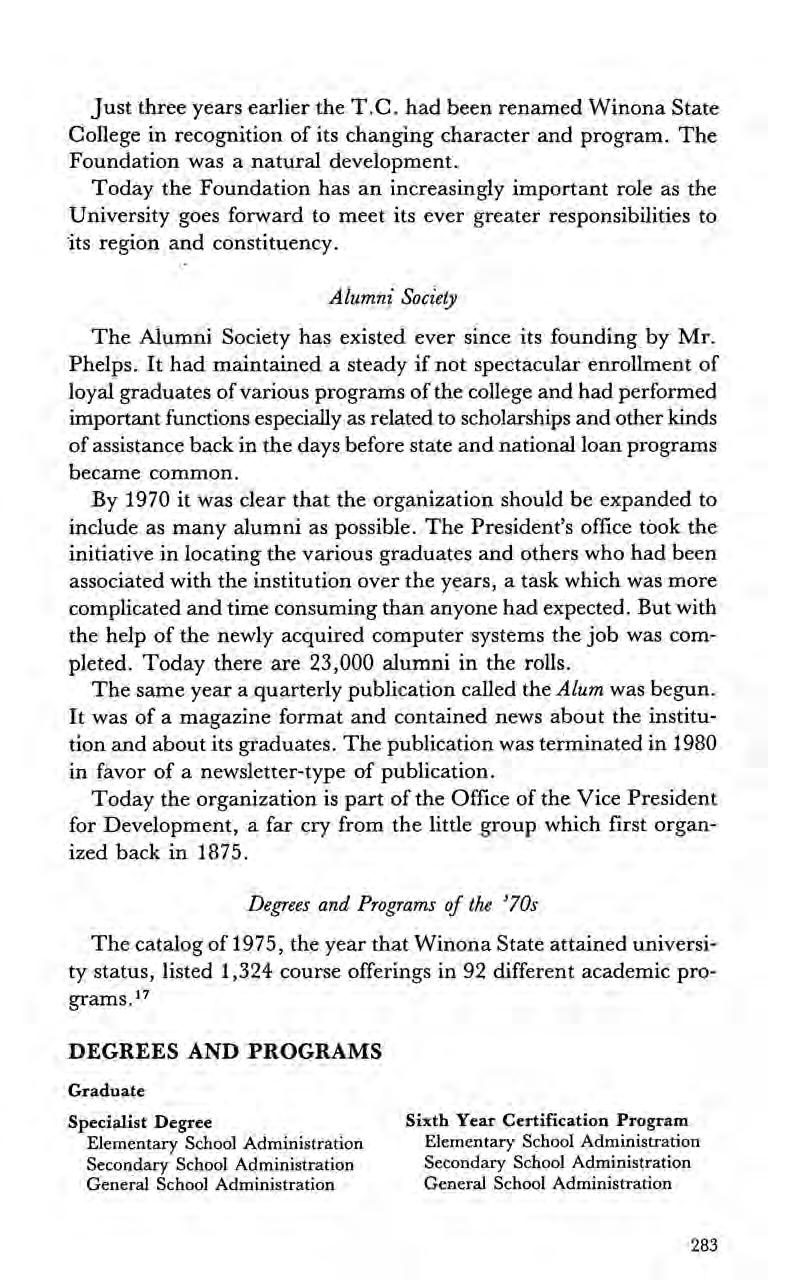
Sixth Year Certification Program
Fifth Year Program (No diploma)
Master of Arts in English
Master of Science Degree
Elementary School Administration
Secondary School Administration
School Business Officer
Teaching in the Elementary School
Teaching in the Secondary School
Art
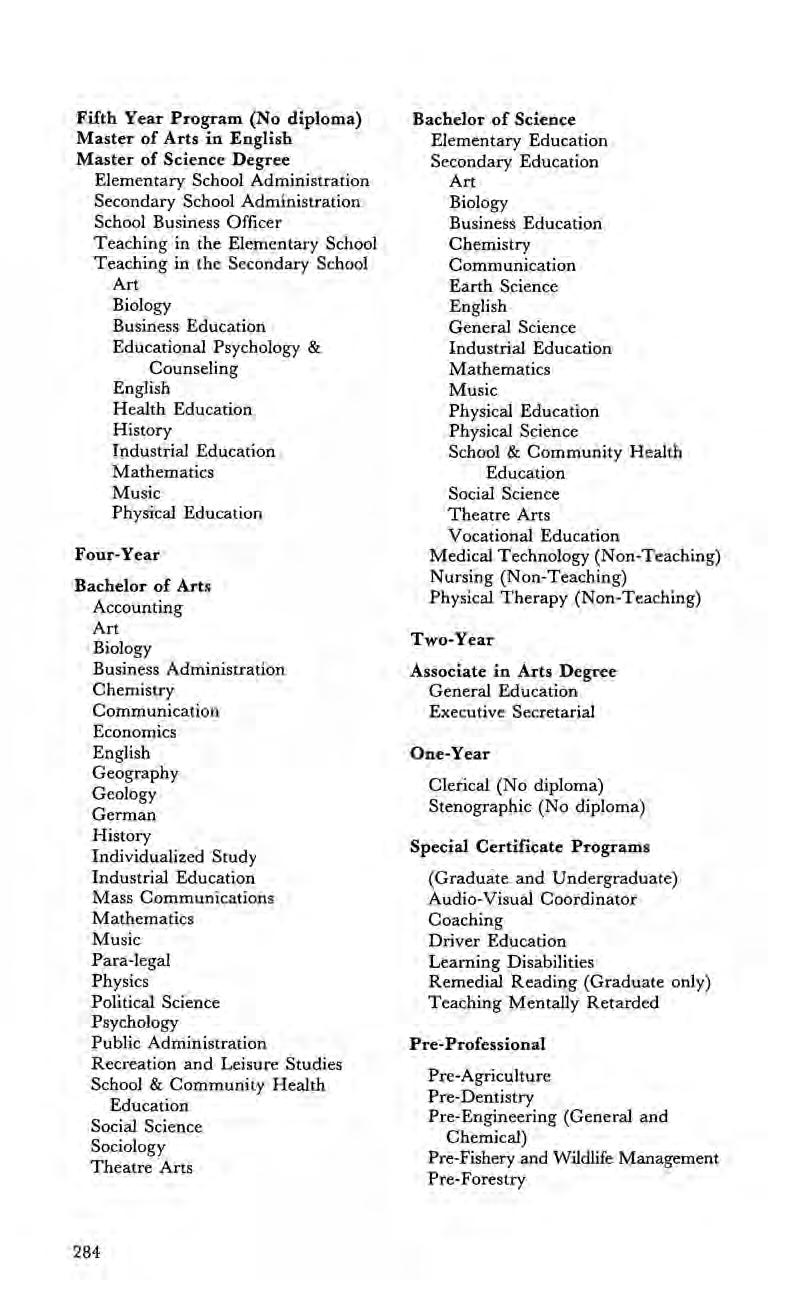
Bachelor of Science
Elementary Education
Secondary Education
Art
Biology
Business Education
Chemistry
Communication
Earth Science
Biology English
Business Education
Educational Psychology & Counseling
English
Health Education
History
Industrial Education
Mathematics
Music
Physical Education
Four-Year
Bachelor of Arts
Accounting
Art
Biology
Business Administration
Chemistry
Communication
Economics
English
Geography
Geology
German
History
Individualized Study
Industrial Education
Mass Communications
Mathematics
Music
Para-legal
Physics
Political Science
Psychology
Public Administration
Recreation and Leisure Studies
School & Community Health
Education
Social Science
Sociology
Theatre Arts
General Science
Industrial Education
Mathematics
Music
Physical Education
Physical Science
School & Community Health
Education
Social Science
Theatre Arts
Vocational Education
Medical Technology (Non-Teaching)
Nursing (Non-Teaching)
Physical Therapy (Non-Teaching)
Two-Year
Associate in Arts Degree
General Education
Executive Secretarial
One-Year
Clerical (No diploma)
Stenographic (No diploma)
Special Certificate Programs (Graduate and Undergraduate)
Audio-Visual Coordinator
Coaching
Driver Education
Learning Disabilities
Remedial
Reading (Graduateonly)
Teaching Mentally Retarded
Pre-Professional
Pre-Agriculture
Pre-Dentistry
Pre-Engineering (General and Chemical)
Pre-Fishery and Wildlife Management
Pre-Forestry
Pre-Law
Pre-Medicine
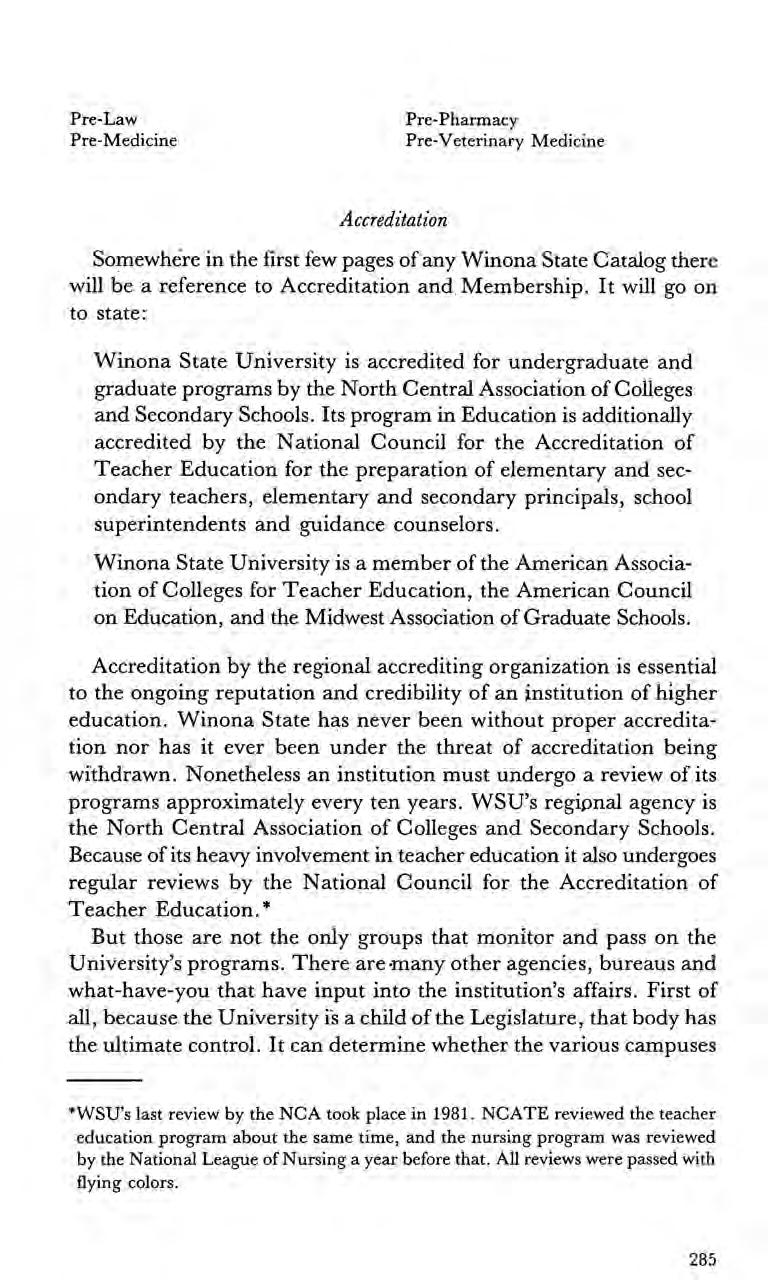
Pre-Pharmacy
Pre-Veterinary Medicine
Somewhere in the first few pages of any Winona State Catalog there will be a reference to Accreditation and. Membership. It will go on to state:
Winona State University is accredited for undergraduate and graduate programs by the North Central Association of Colleges and Secondary Schools. Its program in Education is additionally accredited by the National Council for the Accreditation of Teacher Education for the preparation of elementary and secondary teachers, elementary and secondary principals, school superintendents and guidance counselors.
Winona State University is a member of the American Association of Colleges for Teacher Education, the American Council on Education, and the Midwest Association of Graduate Schools.
Accreditation by the regionalaccrediting organization is essential to the ongoing reputation and credibility of an institution of higher education. Winona State has never been without proper accreditation nor has it ever been under the threat of accreditation being withdrawn. Nonetheless an institution must undergoa review of its programs approximately every ten years. WSU’s regional agency is the North Central Association of Colleges and Secondary Schools. Because of its heavy involvement in teacher education it also undergoes regular reviews by the National Council for the Accreditation of Teacher Education.*
But those are not the only groups that monitor and pass on the University’s programs. There are many other agencies, bureaus and what-have-you that have input into the institution’s affairs. First of all, because the University is a child of the Legislature, that body has the ultimate control. It can determine whether the various campuses
*WSU’s last review by the NCA took place in 1981. NCATE reviewed the teacher education program about the same time, andthe nursing program was reviewed by the National League of Nursing a year before that. All reviews were passed with flying colors.
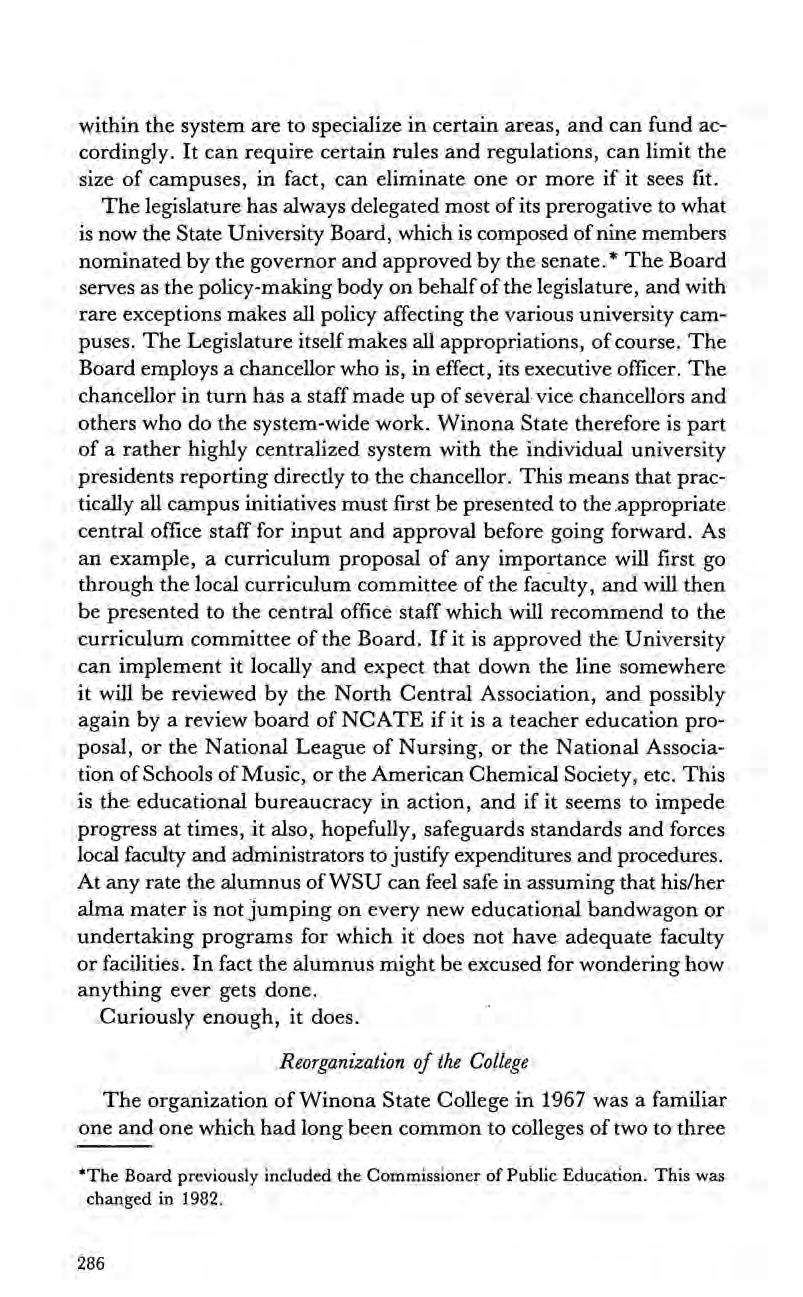
within the system are to specialize in certain areas, and can fund accordingly. It can require certain rules and regulations, can limit the size of campuses, in fact, can eliminate one or more if it sees fit. The legislature has always delegated most of its prerogative to what is now the State University Board, which is composed ofnine members nominated by the governor and approved by the senate.* The Board serves as the policy-making body on behalf ofthe legislature, and with rare exceptions makes all policy affecting the various university campuses. The Legislature itself makes all appropriations, of course. The Board employs a chancellorwho is, in effect, its executive officer. The chancellor in turn has a staff made up of several. vice chancellors and others who do the system-wide work. Winona State therefore is part of a rather highly centralized system with the individual university presidents reportingdirectly to the chancellor. This means that practically all campus initiatives must first be presented to the appropriate central office staff for input and approval before going forward. As an example, a curriculum proposal of any importance will first go through the local curriculum committee of the faculty, and will then be presented to the central office staff which will recommend to the curriculum committee of the Board. If it is approved the University can implement it locally and expect that down the line somewhere it will be reviewed by the North Central Association, and possibly again by a review board ofNCATE if it is a teacher education proposal, or the National League of Nursing, or the National Association of Schools of Music, or the American Chemical Society, etc. This is the educational bureaucracy in action, and if it seems to impede progress at times, it also, hopefully, safeguards standards and forces local faculty and administrators to justify expenditures and procedures. At any rate the alumnus ofWSU can feel safe in assuming thathis/her alma mater is not jumping on every new educational bandwagon or undertaking programs for which itdoes not have adequate faculty or facilities. In fact the alumnus might be excused for wondering how anything ever gets done.
Curiously enough, it does.
The organization of Winona State College in 1967 was a familiar one and one which had long been common to colleges of two to three
*The Board previously included the Commissioner of Public Education. This was changed in 1982.

thousand students. It consisted of six academic divisions: social studies, science, education, English and literature, business, and physical education. The divisions were each administered bya division head who reported to the academic vice president. Within the divisions were departments, some of them rather large and having a degree of autonomy, while others did not. This organization tended to lend itself to fairly informal cross-departmental relationships, and had the advantage of not having to deal with hard lines of authority, internal budgeting problems, and the like. It meant too that the number of administrative officers at the dean’s level was held to a minimum, and that authority was distributed over a rather large number of people with none of them except the dean himself having very much.
The dean (who was also vice president) reported directly to the president, but was also able to be quite close to the departmental operations since division chairmen and many department members had almost daily contact with him.
The disadvantages of such an organizational pattern began to show up with the larger student enrollment and the increasing complexity of the campus. This was true not only of Winona State in 1967 but of most of the other campuses in the system as well. As a result, in 1968 the State College Board required all of the colleges in the system to establish a more-or-less uniform administrative pattern with presidents, vice presidents, and deans as the administrative officers.
Winona State was among the last of the institutions to revise its administrative organization. It came to consist of a dean of education, a dean of arts and sciences, and a dean of graduate studies. All of the old divisions were dissolved. Some twenty-five rather clearly defined departments were then established with a chairman for each department of three or more faculty members reporting to the appropriate dean. The deans reported to the vice president for academic affairs who in turn reported to the president.
At the same time additional vice presidencies were established. One was for general administration which included budgeting on all levels as well as the supervision ofbuildirigs and grounds and classified civil service personnel.* ‘The other was a vice president for student affairs,
*Classified personnel refers to those employees who take the standard civil service examinations prior to appointment. Faculty positions, on the other hand, are referred to as unclassified, and are as a rule regulated by the institution rather than by state civil service codes.

who was responsible for housing, health service, the student union, and non-academic student activity in general. This pattern was established and put into effect during the 1968-69 academic year. The newly developed administrative staff took over at the beginning of the fall quarter in 1969 and began making the changes that marked the difference between the old Winona State and the new institution whichwould eventually become Winona State University. In the area of academics there was almost a complete revision of general education to include blocks of academic offerings from which students could choose their general education courses. But this was only the beginning of a series of dramatic changes which followed as the institution moved toward University status. Six years later the old school, which had its start as a little normal training program would become a regional university with most of its students pursuing studies requiring new programs, new facilities, and expanded faculties.
In the area of student affairs the changes were almost as extensive. By the fall of 1969 Sheehan Hall, a fourteen story high-rise residence hall accommodating 400 women had been completed. A year or two later there was a complete renovation of the Morey-Shepard Halls which were so extensive that for all practical purposes they were brand new buildings. These along with new additions constituted accommodations for 250 men. At the same time the first new major addition to the student union was completed with a second major addition beginning almost immediately thereafter. All of this was designed to accommodate an increasing number of students as well as to catch up somewhat withthe large influx of students whohad enrolled in the three or four previous years. Residence hall occupancy at Winona State roughly doubled during the years 1968 through 1975. During those years came the change from what had traditionally been the parental role of the college to the new freedom of the ’70s. The first late “visiting hours” policies were established in 1969. Shortly after this at least one residence hall voted to have no hours limitations at all! Those decisions were made with the input of students who lived in the halls as well as with the help of the residence hall councils. Gradually the policy spread so that soon few of the residence hallshad restrictions on hours. People were allowed to come and go as they pleased as though they lived in apartments. The policy was
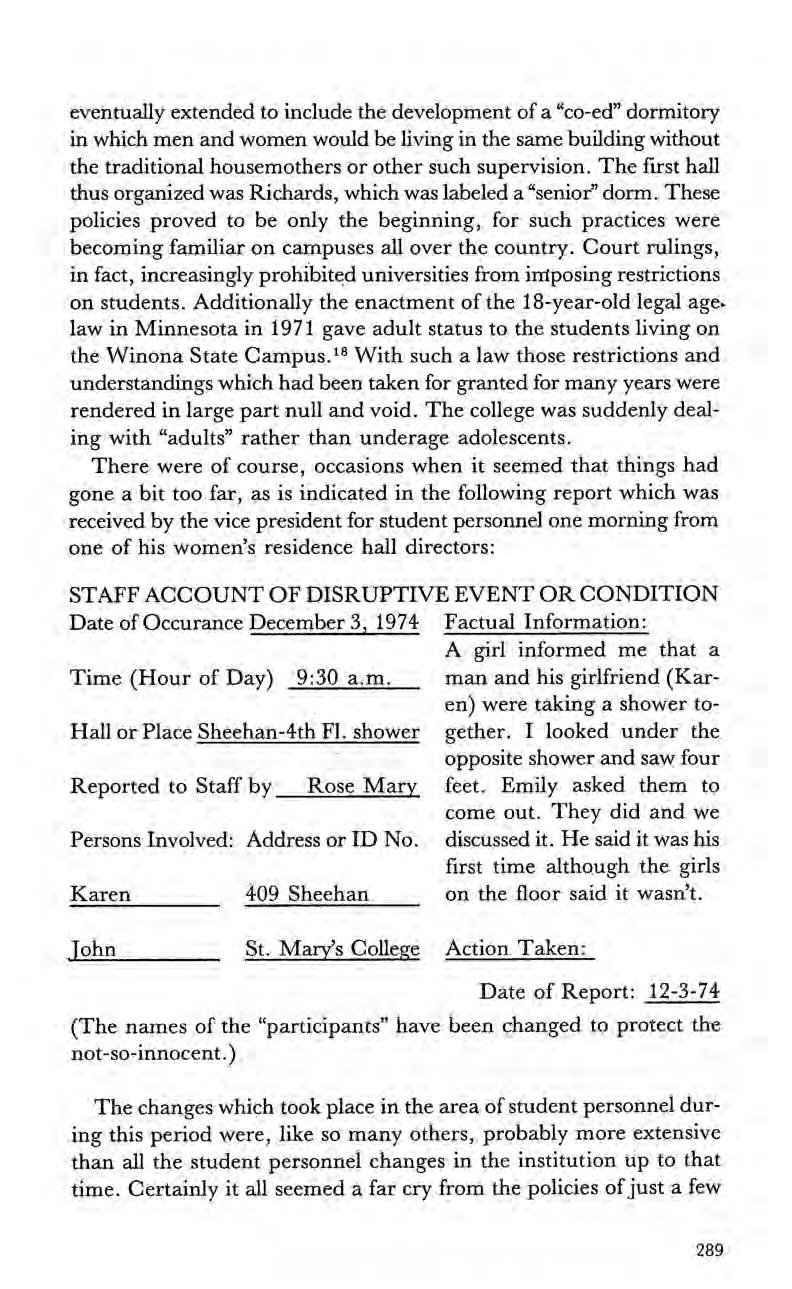
eventually extended to include the development of a “co-ed” dormitory in which men and women would be living in the same building without the traditional housemothers or other such supervision. The first hall thus organized was Richards, which was labeled a “senior” dorm. These policies proved to be only the beginning, for such practices were becoming familiar on campuses all over the country. Court rulings, in fact, increasingly prohibited universities from iniposing restrictions on students. Additionally the enactment of the 18-year-old legal agelaw in Minnesota in 1971 gave adult status to the students living on the Winona State Campus.'* With such a law those restrictions and understandings which had been taken for granted for many years were rendered in large part null and void. The college was suddenly dealing with “adults” rather than underage adolescents.
There were of course, occasions when it seemed that things had gone a bit too.far, as is indicated in the following report which was received by the vice president for student personnel one morning from one of his women’s residence hall directors:
Date of Occurance December 3, 1974
Factual Information:
A girl informed me that a Time (Hour of Day) _9:30 a.m. man and his girlfriend (Karen) were taking a shower toHall or Place Sheehan-4th Fl. shower gether. I looked under the opposite shower and saw four Reported to Staff by___Rose Mary feet. Emily asked them to come out. They did and we
Persons Involved: Address or ID No. discussed it. He said it was his first time although the girls Karen 409 Sheehan on the floor said it wasn't.
John St. Mary’s College Action Taken:
Date of Report: 12-3-74
(The names of the “participants” have been changed to protect the not-so-innocent.)
The changes which took place in the area of student personnel during this period were, like so many others, probably more extensive than all the student personnel changes in the institution up to that time. Certainly it all seemed a far cry from the policies ofjust a few
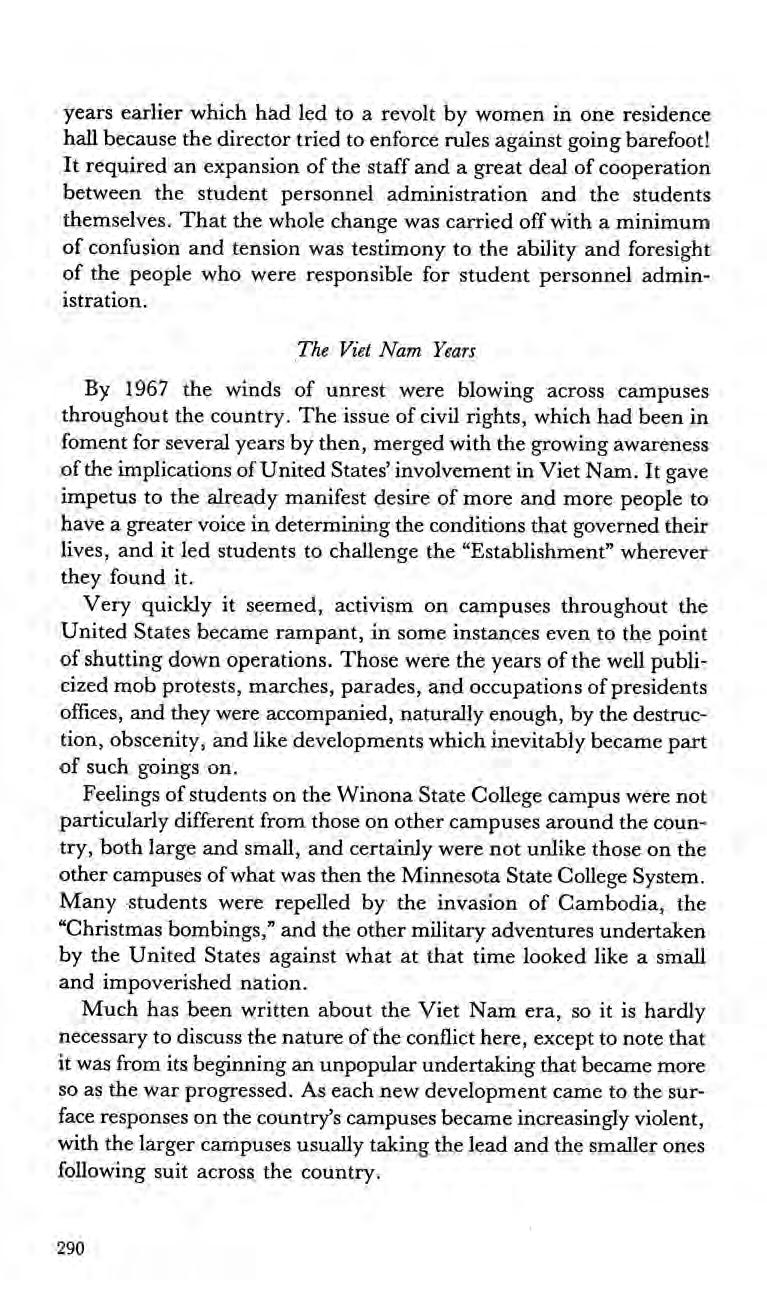
years earlier which had led to a revolt by women in one residence hall because the director tried to enforce rules against going barefoot! It required an expansion of the staff and a great deal of cooperation between the student personnel administration and the students themselves. That the whole change was carried off with a minimum of confusion and tension was testimony to the ability and foresight of the people who were responsible for student personnel administration.
By 1967 the winds of unrest were blowing across campuses throughout the country. The issue of civil rights, which had been in foment for several years by then, merged with the growing awareness ofthe implications ofUnited States’ involvement in Viet Nam. It gave impetus to the already manifest desire of more and more people to have a greater voice in determining the conditions that governed their lives, and it led students to challenge the “Establishment” wherever they found it.
Very quickly it seemed, activism on campuses throughout the United States became rampant, in some instances even to the point of shutting down operations. Those were the years of the well publicized mob protests, marches, parades, and occupations of presidents offices, and they were accompanied, naturally enough, by the destruction, obscenity, and like developments which inevitably became part of such goings on.
Feelings of students on the Winona State College campus were not particularly differentfrom those on other campuses around the country, both large and small, and certainly were not unlike those on the other campuses ofwhat was then the Minnesota State College System. Many students were repelled by the invasion of Cambodia, the “Christmas bombings,” and the other military adventures undertaken by the United States against what at that time looked like a small and impoverished nation.
Much has been written about the Viet Nam era, so it is hardly necessary to discuss the nature of the conflict here, except to note that it was from its beginning an unpopular undertaking that became more so as the war progressed. As each new development came to the surface responses on the country’s campuses became increasingly violent, with the larger campuses usually taking the lead and the smaller ones following suit across the country.
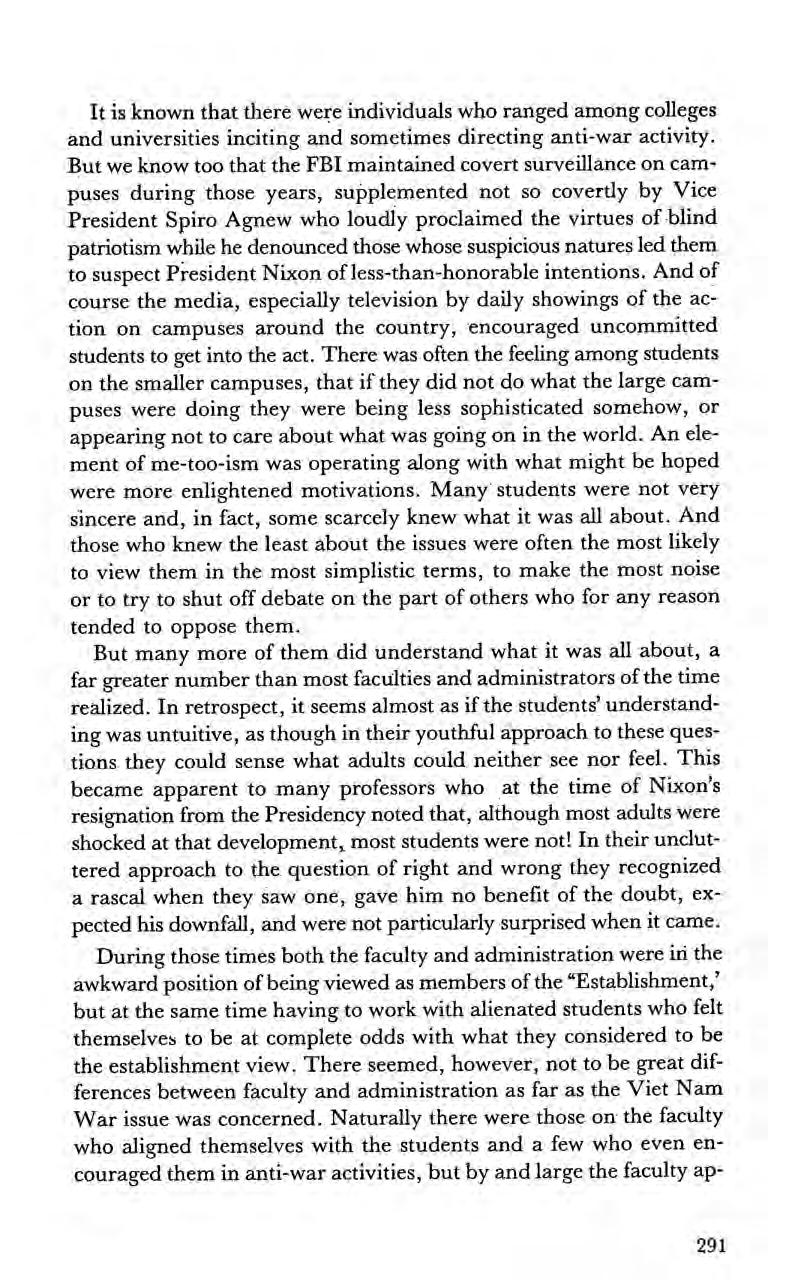
It is known that there were individuals who ranged among colleges and universities inciting and sometimes directing anti-war activity. But we know too that the FBI maintained covert surveillance on campuses during those years, supplemented not so covertly by Vice President Spiro Agnew who loudly proclaimed the virtues of blind patriotism while he denounced those whose suspicious natures led them to suspect President Nixon ofless-than-honorable intentions. And of course the media, especially television by daily showings of the action on campuses around the country, encouraged uncommitted students to get into the act. There was often the feeling among students on the smaller campuses, that if they did not do what the large campuses were doing they were being less sophisticated somehow, or appearing not to care about what was going on in the world. An element of me-too-ism was operating along with what might be hoped were more enlightened motivations. Many students were not very sincere and, in fact, some scarcely knew what it was all about. And those who knew the least about the issues were often the most likely to view them in the most simplistic terms, to make the most noise or to try to shut off debate on the part of others who for any reason tended to oppose them.
But many more of them did understand what it was all about, a far greater number than most faculties and administrators of the time realized. In retrospect, it seems almost as if the students’ understanding was untuitive, as though in their youthful approach to these questions they could sense what adults could neither see ‘nor feel. ‘This became apparent to many professors who at the time of Nixon’s resignation from the Presidency noted that, although most adults were shocked at that development, most students were not! In their uncluttered approach to the. question of right and wrong they recognized a rascal when they saw one, gave him no benefit of the doubt, expected his downfall, and were not particularlysurprised when it came. During those times both the faculty and administration were in the awkward position ofbeing viewed as members ofthe “Establishment,’ but at the same time having to work with alienated students who felt themselves to be at complete odds with what they considered to be the establishment view. There seemed, however; not to be great differences between faculty and administration as far as the Viet Nam War issue was concerned. Naturally there were those on the faculty who aligned themselves with the students and a few who even encouraged them in anti-war activities, but by and large the faculty ap-

peared to take an interested, but somewhat hands-off attitude. The actual day-to-day problems brought about by students who were opposed to the war and to the Nixon policies seem to have been considered primarily an administrative responsibility more or less divided among the offices of the president, the vice president of student personnel and the various academic deans. The administration, in turn, saw itself as having the responsibility of preventing the identification of the college with any particular position in the growing controversy while at the same time encouraging expression of the many diverse viewpoints.
This position was not always appreciated in the community. An exchange of letters in May of 1970 is illustrative. In this instance the student senate had asked the president to make a public statement of the college’s position with regard to the Cambodian episode. This was done by addressinga letter to the White House and having a copy published in the local paper.19
May 6, 1970
The President
The White House
Washington, D.C.
Mr. President:
This is written at the request of the Student Senate to inform you ofthe anxieties within the student body here at Winona State College due to the expansion of the conflict into Cambodia.
At a meeting last evening the young people discussed the problem with, we believe, a fair measure of mature understanding. We feel that they realize something of the magnitude of the problem as well as the frustrations you must feel in endeavoring to arrive at the right decision.
But there is considerable concern over the matter of this move and the apparent influence of your military advisors in bringing this about.
This is a quiet campus and we do not feel that you are without support here, but for all of that there is deep concern, a quiet
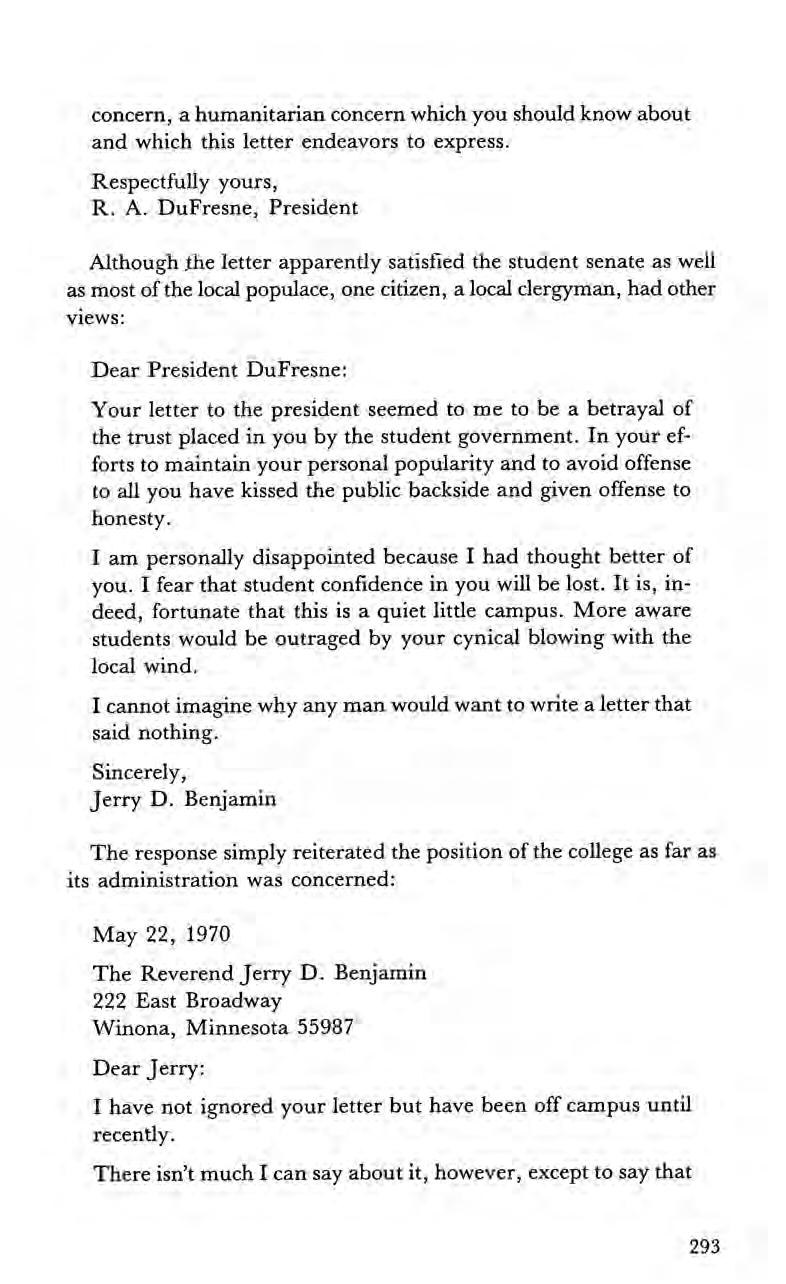
concern, a humanitarian concern which you should know about and which this letter endeavors to express.
Respectfully yours,
R. A. DuFresne, President
Although the letter apparently satisfied the student senate as well as most of the local populace, one citizen, a local clergyman, had other views:
Dear President DuFresne:
Your letter to the president seemed to me to be a betrayal of the trust placed in you by the student government. In your efforts to maintain your personal popularity and to avoid offense to all you have kissed the public backside and given offense to honesty.
I am personally disappointed because I had thought better of you. I fear that student confidence in you will be lost. It is, indeed, fortunate that this is a quiet little campus. More aware students would be outraged by your cynical blowing with the local wind.
I cannot imagine why any man would want to writea letter that said nothing.
Sincerely, Jerry D. Benjamin
The response simply reiterated the position of the college as far as its administration was concerned:
May 22, 1970
The Reverend Jerry D. Benjamin 222 East Broadway Winona, Minnesota 55987
Dear Jerry:
I have not ignored your letter but have been off campus until recently.
There isn’t much I can say about it, however, except to say that
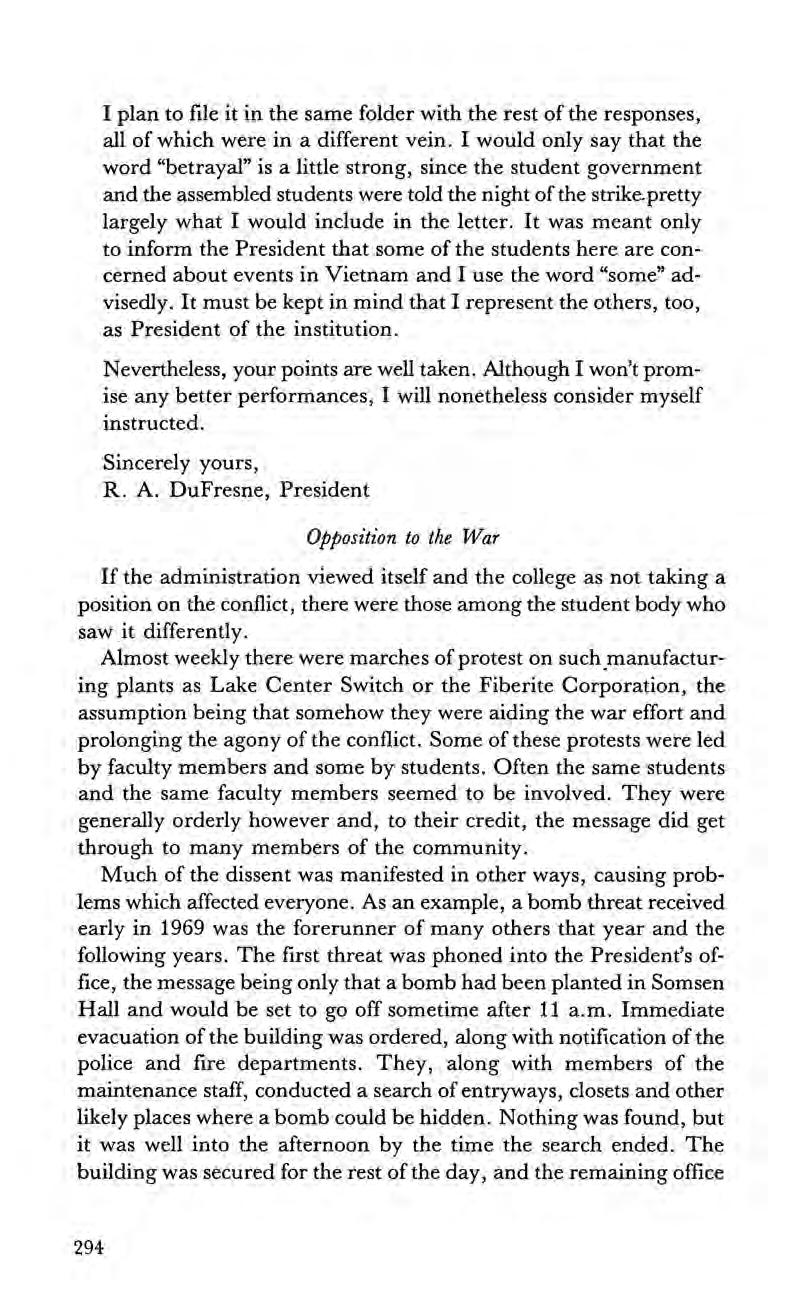
I plan to file it in the same folder with the rest of the responses, all of which were in a different vein. I would only say that the word “betrayal” is a little strong, since the student government and the assembled students were told the night ofthe strike.pretty largely what I would include in the letter. It was meant only to inform the President that some of the students here are concerned about events in Vietnam and I use the word “some” advisedly. It must be kept inmind that I represent the others, too, as President of the institution.
Nevertheless, your points are well taken. Although I won’t promise any better performances, I will nonetheless consider myself instructed.
Sincerely yours,
R. A. DuFresne, President
If the administration viewed itself and the college as not taking a position on the conflict, there were those among the student body who saw it differently.
Almost weekly there were marches of protest on such manufacturing plants as Lake Center Switch or the Fiberite Corporation, the assumption being that somehow they were aiding the war effort and prolonging the agony of the conflict. Some of these protests were led by faculty members and some by students. Often the same students and the same faculty members seemed to be involved. They were generally orderly however and, to their credit, the message did get through to many members of the community.
Much of the dissent was manifested in other ways, causing problems which affected everyone. As an example, a bomb threat received early in 1969 was the forerunner of many others that year and the following years. The first threat was phoned into the President’s office, the message being only that a bomb had been planted in Somsen Hall and would be set to go off sometime after 11 a.m. Immediate evacuation of the building was ordered, along with notification of the police and fire departments. They, along with members of the maintenance staff, conducted a search of entryways, closets and other likely places where a bomb could be hidden. Nothing was found, but it was well into the afternoon by the time the search ended. The building was secured for the rest of the day, and the remaining office
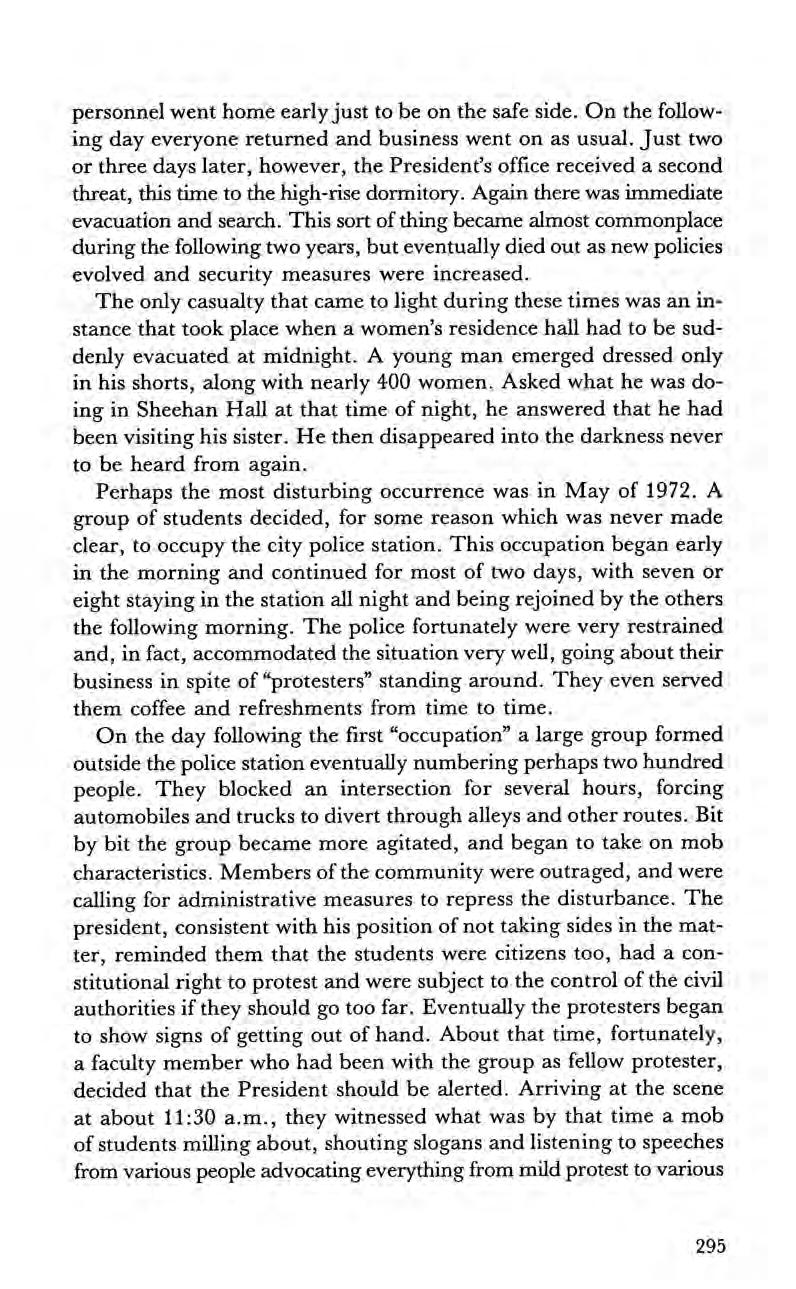
personnel went home earlyjust to be on the safe side. On the following day everyone returned and business went on as usual. Just two or three days later, however, the President’s office received a second threat, this time to the high-rise dormitory.Again there was immediate evacuation and search. This sort of thing became almost commonplace during the following two years, but eventually died out as new policies evolved and security measures were increased.
The only casualty that came to light during these times was an instance that took place when a women’s residence hall had to be suddenly evacuated at midnight. A young man emerged dressed only in his shorts, along with nearly 400 women. Asked what he was doing in Sheehan Hall at that time of night, he answered that he had been visiting his sister. He then disappeared into the darkness never to be heard from again.
Perhaps the most disturbing occurrence was in May of 1972. A group of students decided, for some reason which was never made clear, to occupy the city police station. This occupation began early in the morning and continued for most of two days, with seven or eight staying in the station all night and being rejoined by theothers the following morning. The police fortunately were very restrained and, in fact, accommodated the situation very well, going about their business in spite of “protesters” standing around. They even served them coffee and refreshments from time to time.
On the day following the first “occupation” a large group formed outside the police station eventually numbering perhaps two hundred people. They blocked an intersection for several hours, forcing automobiles and trucks to divert through alleys and other routes. Bit by bit the group became more agitated, and began to take on mob characteristics. Members of the community were outraged, and were calling for administrative measures to repress the disturbance. The president, consistent with his position of not taking sides in the matter, reminded them that the students were citizens too, had a constitutional right to protest and were subject to the control of the civil authorities if they should go too far. Eventually the protesters began to show signs of getting out of hand. About that time, fortunately, a faculty member who had been with the group as fellow protester, decided that the President should be alerted. Arriving at the scene at about 11:30 a.m., they witnessed what was by that time a mob of students milling about, shouting slogans and listening to speeches from various people advocating everything from mild protest to various

kinds of mayhem. It was apparent that some of those in the group who were doing the most to stir things up were not students ofWinona State, nor, as far as anyone could determine, were they students of either of the other two colleges in the city. These few apparently were outside agitators who had come in to help fan the fires ofprotest. There were a few tense moments, but when it became apparent that the President was largely in sympathy with the protest, but was concerned about continued polarizing of the community, common sense prevailed. The group agreed to return to the campus with the understanding that the following day would be used as a day of protest against the war. The march back to the campus proceeded without incident.
The next day a rather loosely organized meeting was held on campus attended by perhaps 800 to 1,000 people. Several individuals gave short speeches, onlookers listened, got tired of it all and, one by one, drifted away. A couple of days later the President wrote a letter to the Central Office:
May 16, 1972
Dr. G. Theodore Mitau
Minnesota State College System
550 Cedar Street
St. Paul, Minnesota 55101
DearTed:
The enclosed clippings pretty well describe events of last week so I'll not elaborate. To sum up:
Tuesday evening: Abbie Hoffman spoke to a packed hall (but about half left before he finished).
Wednesday morning: Classes interrupted by kids going into classrooms shouting, “Join the march,” etc. Bomb threats at 12:00 dnd 1:00. Some obstructing of entrances, but no actual scuffling.
1:30: Marchers occupied City Hall. I went over at that time and talked with them. They finally agreed to return to campus.
8:00: Large evening meeting.
Thursday: Bomb threat at 9:00. Mass meeting at 10:00 followed by orderly march to Winona Industries and back.
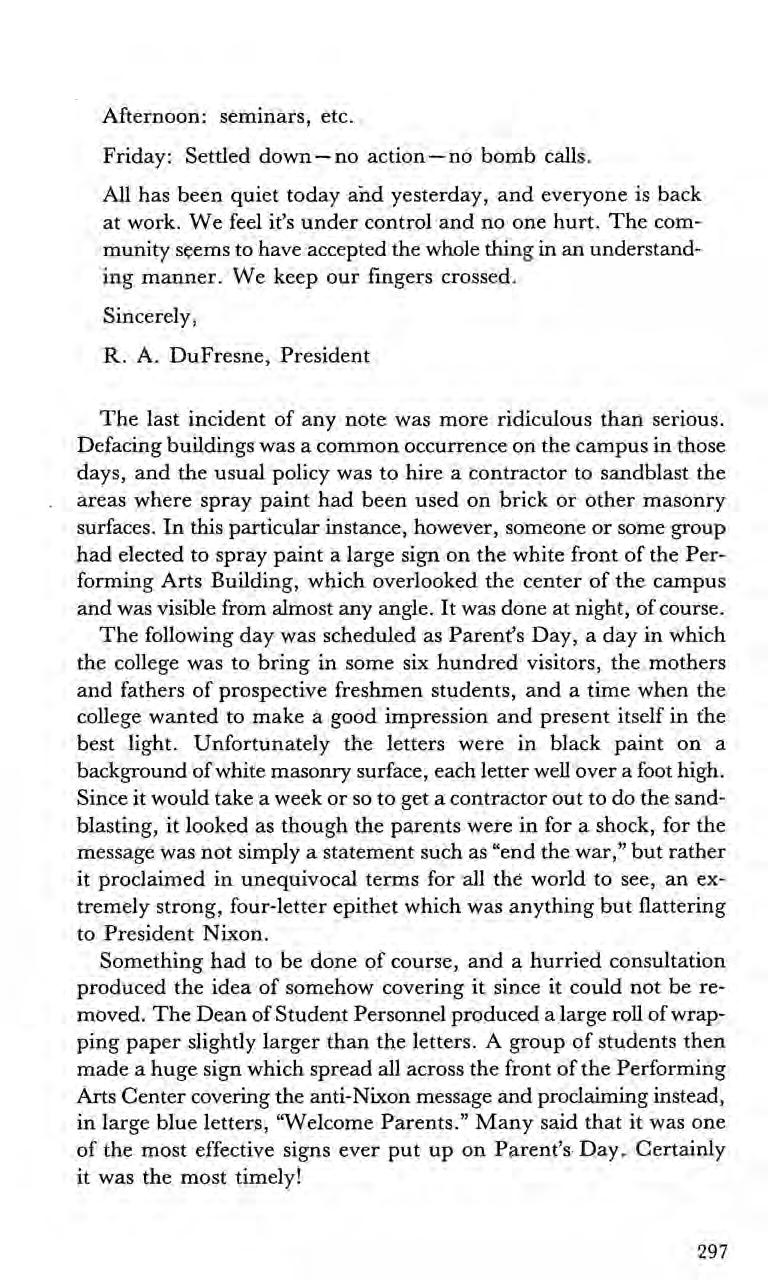
Afternoon: seminars, etc.
Friday: Settled down—no action—no bomb calls.
All has been quiet today and yesterday, and everyone is back at work. We feel it’s under control and no-one hurt. The community seems to have accepted the whole thing in an understanding manner. We keep our fingers crossed.
Sincerely,
R. A. DuFresne, President
The last incident of any note was more ridiculous than serious. Defacing buildings was a common occurrenceon the campus in those days, and the usual policy was to hire a contractor to sandblast the areas where spray paint had been used on brick or other masonry surfaces. In this particular instance, however, someone or some group had elected to spray paint a large sign on the white front of the Performing Arts Building, which overlooked the center of the campus and was visible from almost any angle. It was done at night, of course.
The following day was scheduled as Parent’s Day, a day in which the college was to bring in some six hundred visitors, the mothers and fathers of prospective freshmen students, and a time when the college wanted to make a good impression and present itself in the best light.Unfortunately the letters were in black paint on a background of white masonry surface, each letter well over a foot high. Since it would take a week or so to get a contractorout to do the sandblasting, it looked as though the parents were in for a shock, for the message was not simply a statement such as “end the war,” but rather it proclaimed in unequivocal terms for all the world to see, an extremely strong, four-letter epithet which was anything but flattering to President Nixon.
Something had to be done of course, and a hurried consultation produced theidea of somehow covering it since it could not be removed. The Dean of Student Personnel produceda large roll ofwrapping paper slightlylarger than the letters. A group of students then made a huge sign which spread all across the front of the Performing Arts Center covering the anti-Nixon message and proclaiming instead, in large blue letters, “Welcome Parents.” Many said that it was one of the most effective signs ever put up on Parent’s. Day. Certainly it was the most timely!
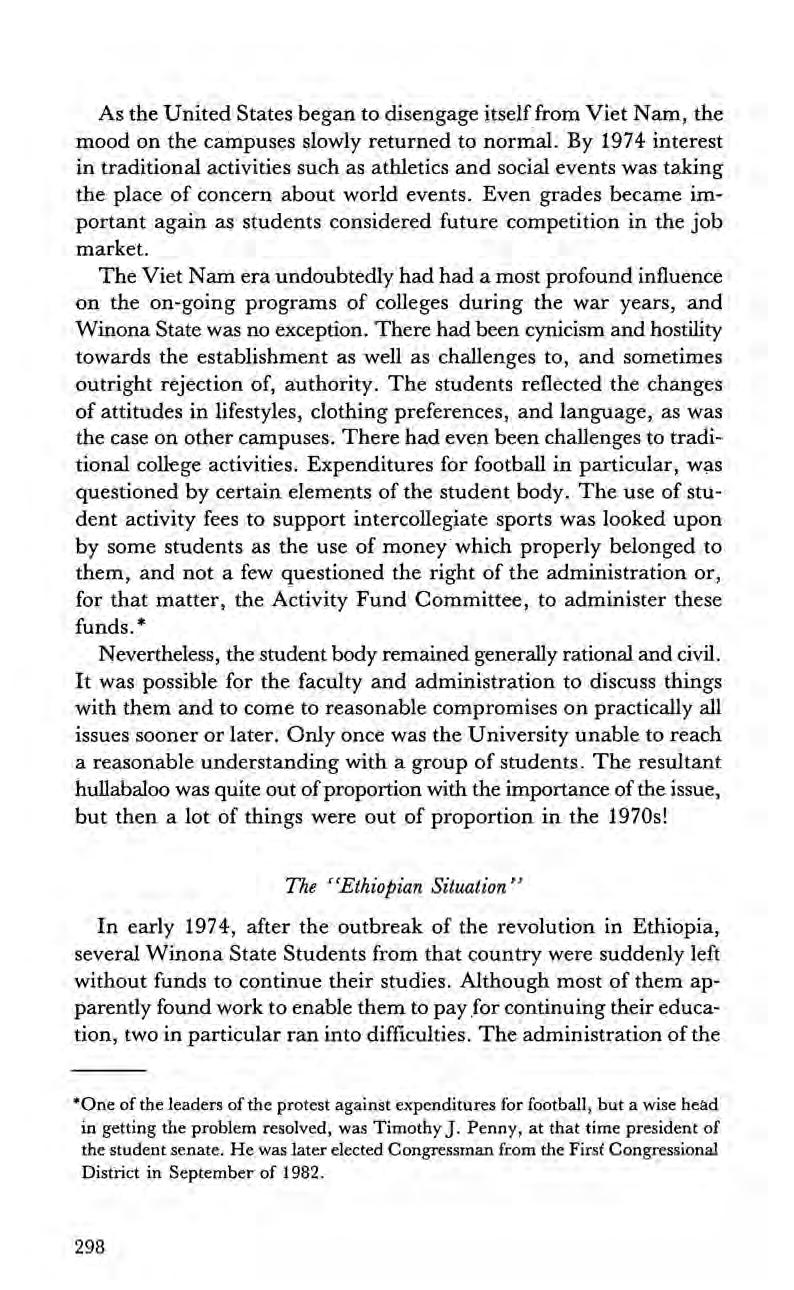
As the United States began to disengage itselffrom Viet Nam, the mood on the campuses slowly returned to normal. By 1974 interest in traditional activities such as athletics and social events was taking the place of concern about world events. Even grades became important again as students considered future competition in the job market.
The Viet Nam era undoubtedly hadhad a most profound influence on the on-going programs of colleges during the war years, and Winona State was no exception. There had been cynicism and hostility towards the establishment as well as challenges to, and sometimes outright rejection of, authority. The students reflectedthe changes of attitudes in lifestyles, clothing preferences, and language, as was the case on other campuses. ‘There had even been challenges to traditional college activities. Expenditures for football in particular, was questioned by certain elements of the student body. The use of student activity fees to support intercollegiate sports was looked upon by some students as the use of money which properly belonged to them, and not a few questioned the right of the administration or, for that matter, the Activity Fund Committee, to administer these funds.*
Nevertheless, the student body remained generally rational and civil. It was possible for the faculty and administration to discuss things with them and to come to reasonable compromises on practically all issues sooner or later. Only once was the University unable to reach -a reasonable understanding with a group of students. The resultant hullabaloo was quite out ofproportion with the importance ofthe issue, but then a lot of things were out of proportion in the 1970s!
In early 1974, after the outbreakof the revolution in Ethiopia, several Winona State Students from that country were suddenly left without funds to continue their studies. Although most of them apparently found work to enable them to payfor continuing their education, two in particular ran into difficulties. The administration of the
*One of the leaders of the protest against expenditures for football, but a wise head in getting the problem resolved, was Timothy J. Penny, at thattime president of the student senate. He was later elected Congressman from the First Congressional District in September of 1982.

college, understanding something of their predicament, at first attempted to help by finding campus jobs for them, establishing an Emergency Fund, getting families to host them without costs, and carrying them, contrary to state rules, to over $1,000 in unpaid tuition costs.
The two, however, refused to cooperate, insisting on special treatment at the expense of their fellows. They refused to carry out their work agreements, and eventually were even turned out from the homes ofthe hosts who had taken them in, due to their behavior. After several months of controversy the University was forced to notify them that they could not enroll for further study until they paid their tuition bill.
The two immediately contacted a local attorney and, along with one more student who had become involved by that time, took their case to the Human Rights Department of the State of Minnesota. There followed months which turned into years of hearings, interviews, accusation and counter-accusation by all parties concerned, including by then the State Attorney General’s office. At one point in 1979 the then Director of the Human Rights Commission actually made an offer to “settle” for $45,000 to be paid by the University to be split up among the three students. The University refused to pay preferring that the case go to court if necessary. But it never did go to court. After four more years of delay and confusion a new Human Rights Director determined that the evidence failed to credit the allegations made in the charges:
Based on the information stated below, this case has been dismissed pursuant to the authority vested in the Commissioner by Minnesota Statutes 363.06 Subd. 4(1). The evidence does not substantiate the allegation that Respondent’s (the University’s) actions in the matters complained of were motivated by a discriminatory consideration of Charging Party’s race or national origin. Contrary to the contentions of Charging Party, the investigation record established that in each instance of allegedly disparate treatment, Respondent’s (the University’s) actions were either consistent with policies and practices affecting all students, without regard to race or national origin, or were taken in an effort to accommodate Charging Party because of his unique circumstances.
It is noteworthy that all eight charges made by the students and their attorney were patently false, but that it nonetheless cost the State

of Minnesota upwards of $100,000 in legal fees and administrative staff time before the case was finally dismissed. The case was characterized by one attorney as a classic example of the swing of the pendulum to the extreme emphasis on individual rights which peaked in the 1970s. By 1985 the pendulum could be seen to be on its way back to something more akin to normalcy.
As the Viet Nam era came to a.close many anticipated a return to the status quo or at least to some sort of orderly, on-going programmatic progression. Such was not to be the case however. By the time the war began to wind down colleges and universities around the country had already begun to see the first indications of the enrollment declines which had been predicted for some years. The higher education establishment all across the United States was beginning to feel the effects of smaller incoming freshmen classes. Amazingly, many, if not most colleges were taken by surprise even though statistics had long been available showing the decreasing populations ofelementary andjunior high school classes and, inevitably, of senior high school classes as well. College buildings continued to be built and faculties expanded.
At about the same time the impending teacher surplus became apparent, also a result of declining class sizes in the public schools along with the high rate of teacher production in institutions ofhigher education. By 1974 and 1975 the public school teacher surplus was such that, not only were new people finding it difficult to locate employment, but teachers in school systems all over the country were being laid off, sometimes one hundred or two hundred at a time. The effect on college faculties was immediate and devastating. As freshmen classes grew smaller and enrollments declined it became necessary to reduce programs and let surplus faculty members go. The consequences were, of course, a lowering of morale and increased tensions on all campuses, even those where the decline did not have an immediate effect. Faculty members looked around at neighboring institutions and concluded logically that what was happening there would eventually happen at home, which, in fact, it often did.
The situation at Winona State was not particularly different from that of other campuses around the country. The Minnesota State College System enrollment began to level off and decline so that by 1973
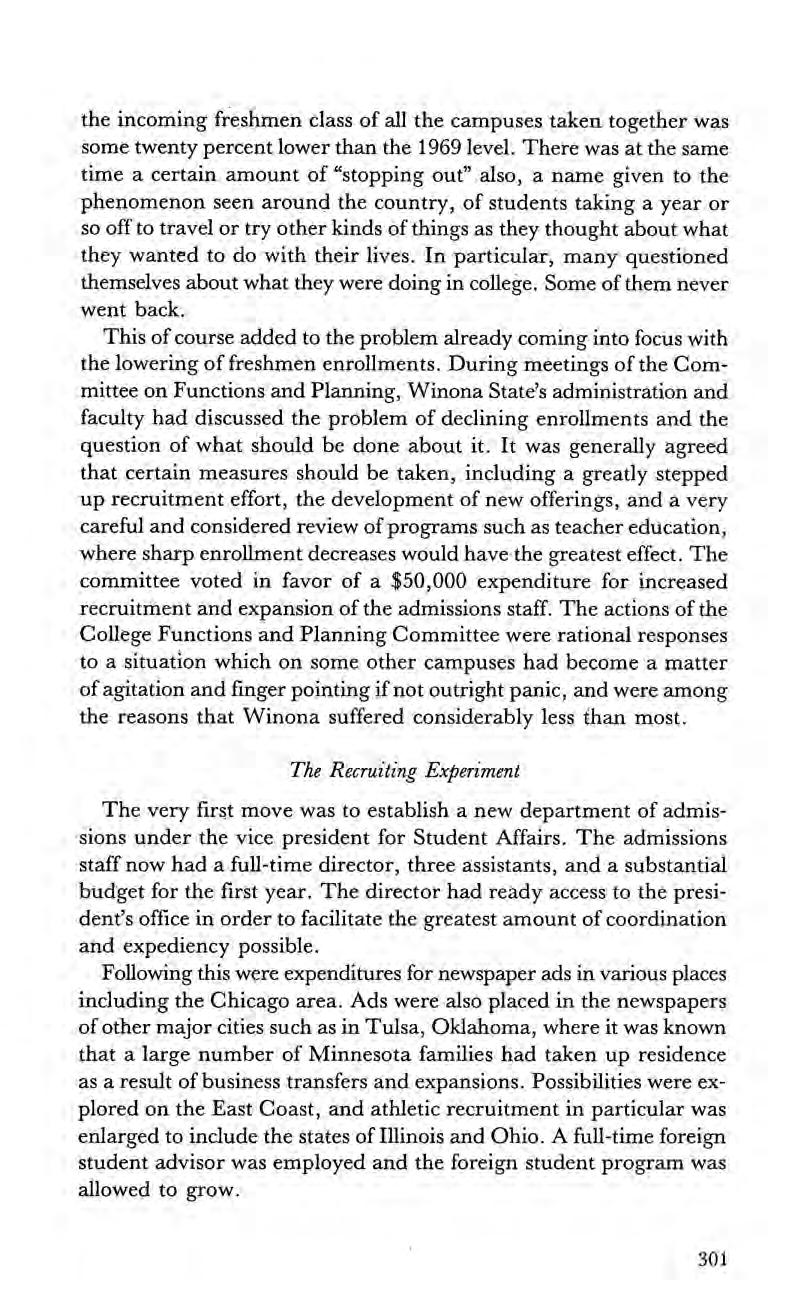
the incoming freshmen class of all the campuses taken together was some twenty percent lower than the 1969 level. There was at the same time a certain amount of “stopping out” also, a name given to the phenomenon seen around the country, of students taking a year or so off to travel or try other kinds of things as they thought about what they wanted to do with their lives. In particular, many questioned themselves about what they were doing in college. Some of them never went back.
This of course added to the problem already coming into focus with the lowering of freshmen enrollments. During meetings of the Committee on Functions and Planning, Winona State’s administration and faculty had discussed the problem of declining enrollments and the question of what should be done about it. It was generally agreed that certain measures should be taken, including a greatly stepped up recruitment effort, the development of new offerings, and a very careful and considered review of programs such as teacher education, where sharp enrollment decreases would have the greatest effect. The committee voted in favor of a $50,000 expenditure for increased recruitment and expansion of the admissions staff. The actions of the College Functions and Planning Committee were rational responses to a situation which on some other campuses had become a matter of agitation and finger pointing if not outright panic, and were among the reasons that Winona suffered considerably less than most.
The very first move was to establish a new department of admissions under the vice president for Student Affairs. The admissions staff now hada full-time director, three assistants, and a substantial budget for the first year. The director had ready access to the president’s office in order to facilitate the greatest amount of coordination and expediency possible.
Following this were expenditures for newspaper ads in various places including the Chicago area. Ads were also placed in the newspapers of other major cities such as in Tulsa, Oklahoma, where it was known that a large number of Minnesota families had taken up residence as a result of business transfers and expansions. Possibilities were explored on the East Coast, and athletic recruitment in particular was enlarged to include the states ofIllinois and Ohio. A full-time foreign student advisor was employed and the foreign student program was allowed to grow.
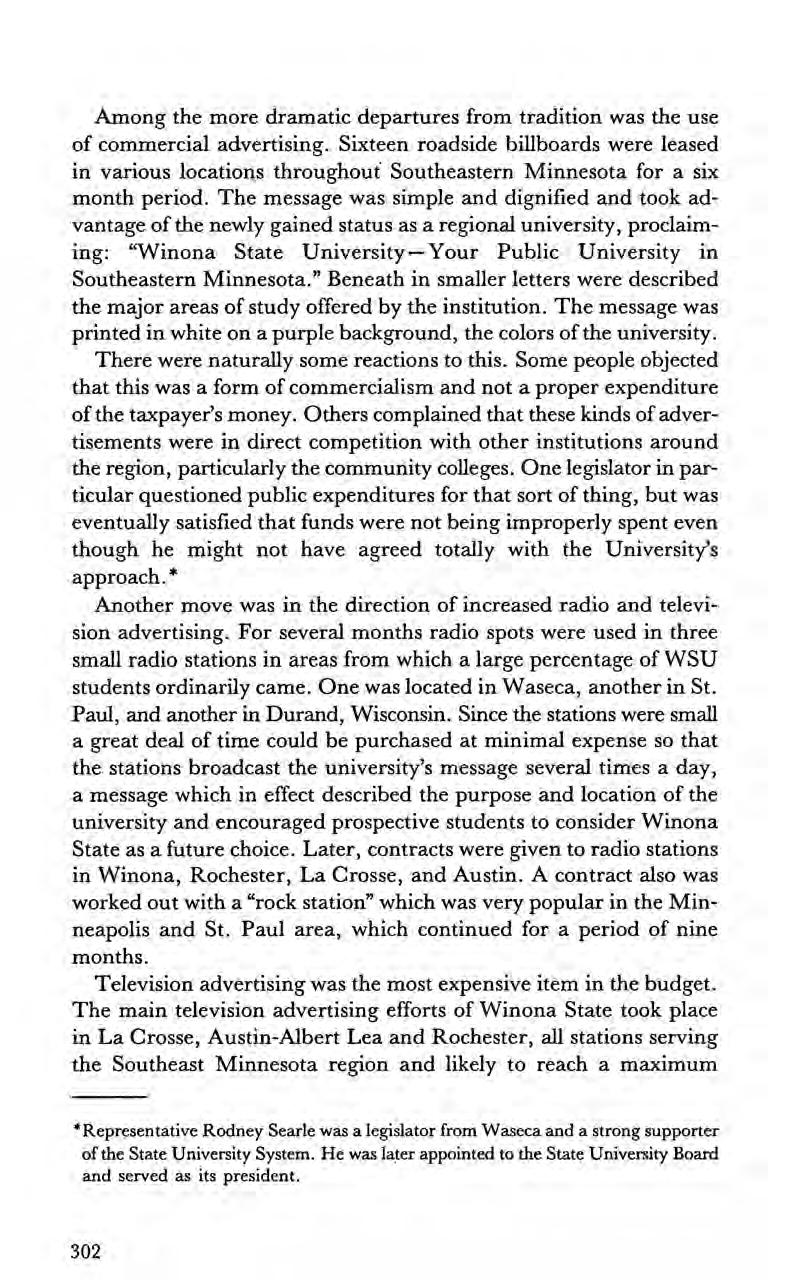
Among the more dramatic departures from tradition was the use of commercial advertising. Sixteenroadside billboards were leased in various locations throughout Southeastern Minnesota fora six month period. The message was simple and dignified and took advantage of the newly gained status as a regional university, proclaiming: “Winona State University—Your Public University in Southeastern Minnesota.” Beneath in smaller letters were described the major areas of study offered by the institution. The message was printed in white on a purple background, the colors ofthe university. There were naturally some reactions to this. Some people objected that this was a form of commercialism and not a proper expenditure ofthe taxpayer’s money. Others complained that these kinds of advertisements were in direct competition with other institutions around the region, particularly the community colleges. One legislator in particular questioned public expenditures for that sort of thing, but was eventually satisfied that funds were not being improperly spent even though he might not have agreed totally with the University’s approach. *
Another move was in the direction of increased radio and television advertising. For several months radio spots were used in three small radio stations in areas from which a large percentage of WSU students ordinarily came. One was located in Waseca, another in St. Paul, and another in Durand, Wisconsin. Since the stations were small a great deal of time could be purchased at minimal expense so that the stations broadcast the university’s message several times a day, a message which in effectdescribedthe purpose and location of the university and encouraged prospective students to consider Winona State as a future choice. Later, contracts were given to radio stations in Winona, Rochester, La Crosse, and Austin. A contract also was worked out with a “rock station” which was very popular in the Minneapolis and St. Paul area, which continued for a period of nine months.
Television advertising was the most expensive item in the budget. The main television advertising efforts of Winona State took place in La Crosse, Austin-Albert Lea and Rochester, all stations serving the Southeast Minnesota region and likely to reach a maximum
*Representative Rodney Searle was a legislator from Waseca and a strong supporter ofthe State University System. He was later appointed to the State University Board and served as its president.

number of students. Five 20 to 30 second spots daily blanketed the area within a 100-mile radius of the University, with professional television announcers discussing the campus and its programs. The State high school basketball tournament week was the focal point of much advertising on the Rochester station in particular, bringing the University’s message to people in Southeast Minnesota several times each game.
Other rather extensive efforts included the expansion of Parent’s Days. These events were designed to bring parents to the campus, fill them in on various aspects of the program, and give them some idea of what their sons and daughters could expect as students at Winona State. Attendance was usually about six hundred. Beginning in 1973 the Office of Admissions in conjunction with the President’s office also set up a series of parents’ nights which were modified versions of the day programs. These were conducted in the outlying areas of the region, including Minneapolis and St. Paul. Some ten to fifteen were held each year with the president attending and addressing the groups, after which there were opportunities for discussing various offerings and answering questions. Many ofthe faculty voluntarily attended along with most ofthe admissions staff. These proved to be quite effective, with from forty to over two hundred attending the various meetings. They brought the University to the people and gave them an opportunity forinformal person-to-person discussions rather than the usual form letter or brochure.
At first such expenditures appeared large, although private colleges might easily spend considerably more in any given year. Yet, if the program stabilized enrollments, it must have been worth the cost. An article in American School and University reviewed the economics of the effort as follows:
In a public institution such as Winona State, funding is in direct proportion to enrollment. The university receives one-fourth of its operating funds from tuition and the rest from the state. If, then, tuition is worth $10 per quarter hour and the state subsidy is $30 per quarter hour, a student’s fifteen quarter-hour load would equal $600 per quarter or $1,800 per year, exclusive of the $120 activity fees.
Thus a billboard project costing $5,500 would have to attract only three or four students to pay for itself, and a TV series costing $20,000 would have to attract only 11 students. Assum-
ing that no great expansion is needed in personnel or capital equipment and none was needed at Winona State —the risk of the campaign would not be great in comparison with potential student increase.
During the year following the campaign, enrollment increased despite a general decline in the state system as a whole. Both the freshman class and the external studies program shared a sharp increase in students, the latterfrom 30 to more than 600. It would be impossible to determine the exact contribution of the advertising to increased enrollment, but there seems little doubt that it was a positive factor.?°
TABLE IX
Fall Quarter Enrollment 1965-1975*
AAA On-Campus FTEs
Total On- and Off-Campus FTEs [_] on-Campus individuals
10021 on- and off-campus individuate
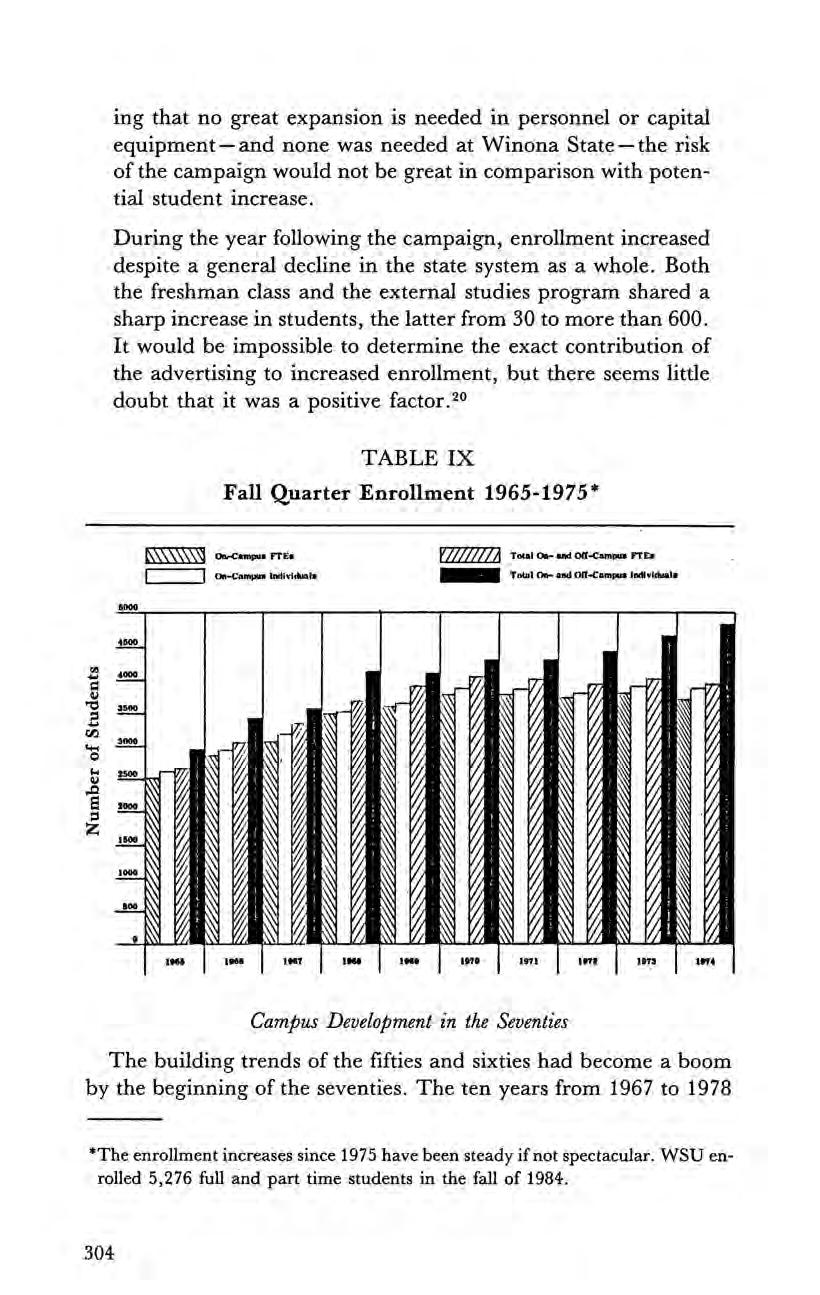
The building trends of the fifties and sixties had become a boom by the beginning of the seventies. The ten years from 1967 to 1978
*The enrollment increases since 1975 have been steady if not spectacular. WSU enrolled 5,276 full and part time students in the fall of 1984.

saw the completion of seven new buildings and the complete renovation of two dormitories. It was during that period that the campus was completed for all practical purposes.
A look at campus development as seen in Figure 4 shows the pattern to be one of a comparatively large open area surrounded by academic buildings on the east and north sides, residence halls to the west and the heating plant and athletic fields to the south. The stu dent center (Kryzsko Commons) is centered in the residence hall area, but at the same time faces the remainder of the campus making it very accessible.
The fourteen story high rise residence hall was built in the days when everyone was building them. Upon its completion there was much gossip to the effect that it was leaning slightly; also that it was cracked down one side. Those rumors, which eventually reached the Chancellor’s office, were aired in the Minneapolis papers as well as on television early in 1968.
One day Chancellor Mitau, who had called a press conference in St. Paul relative to some important matter, suddenly found himself being confronted by metropolitan newspaper reporters asking him what he planned to do about the leaning high rise in Winona.
Immediately following the press conference the President at Winona picked up the telephone for a call from St. Paul to hear Mitau in his characteristic manner ask, “Say, just what the hell zs the story on that high rise?” The President, mistakingly seeing some humor in the question, laughed loudly which made an already complicated situation even worse.
Fortunately the rumor like most rumors was without substance and the issue died as quickly as it had arisen, but it was exciting while it lasted!
One other building which perhaps merits special comment was the classroom building completed in 1973 and named after President Nels Minné in 1974. Minné Hall was conceived as the ultimate in flexible building theory. It was designed fundamentally as a three story rectangle with almost no interior supporting walls and no permanent fixed areas except for the lavatories and entrances. All electrical wiring, air conditioning duct work, heating and the like was incorporated into the ceilings, with none in the walls except for light switches which could be modified in various ways as walls were moved. The walls were of the movable type—large panels made to fit into “tracks” or fittings in ceilings and floors. The obvious advantage of such design

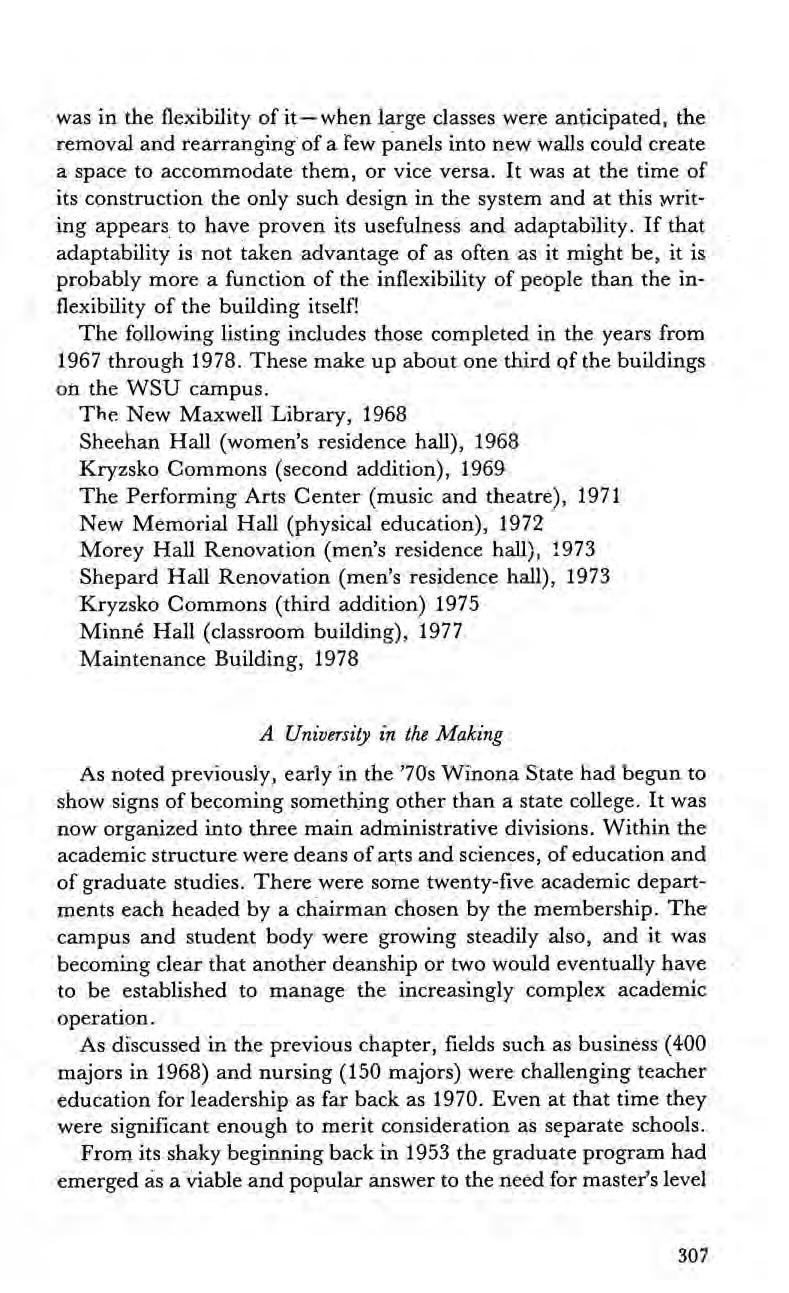
was in the flexibility of it—when large classes were anticipated, the removal and rearranging of a few panels into new walls could create a space to accommodate them, or vice versa. It was at the time of its construction the only such design in the system and at this writing appears to have proven its usefulness and adaptability. If that adaptability is not taken advantage of as often as it might be, it is probably more a function of the inflexibility of people than the inflexibility of the building itself!
The following listing includes those completed in the years from 1967 through 1978. These make up about one third of the buildings on the WSU campus.
The New Maxwell Library, 1968
Sheehan Hall (women’s residence hall), 1968
Kryzsko Commons (second addition), 1969
The Performing Arts Center (music and theatre), 1971
New Memorial Hall (physical education), 1972
Morey Hall Renovation (men’s residence hall}, 1973
Shepard Hall Renovation (men’s residence hall), 1973
Kryzsko Commons (third addition) 1975
Minné Hall (classroom building), 1977
Maintenance Building, 1978
As noted previously, early in the ’70s Winona State had begun to show signs of becoming something other thana state college. It was now organized into three main administrative divisions. Within the academic structure were deans of arts and sciences, of education and of graduate studies. There were some twenty-five academic departments each headed by a chairman chosen by the membership. The campus and student body were growing steadily also, and it was becoming clear that another deanship or two would eventually have to be established to manage the increasingly complex academic operation.
As discussed in the previous chapter, fields such as business (400 majors in 1968) and nursing (150 majors) were challenging teacher education for leadership as far back as 1970. Even at that time they were significant enough to merit consideration as separate schools. From its shaky beginning back in 1953 the graduate program had emerged as a viable and popular answer to the need for master’s level
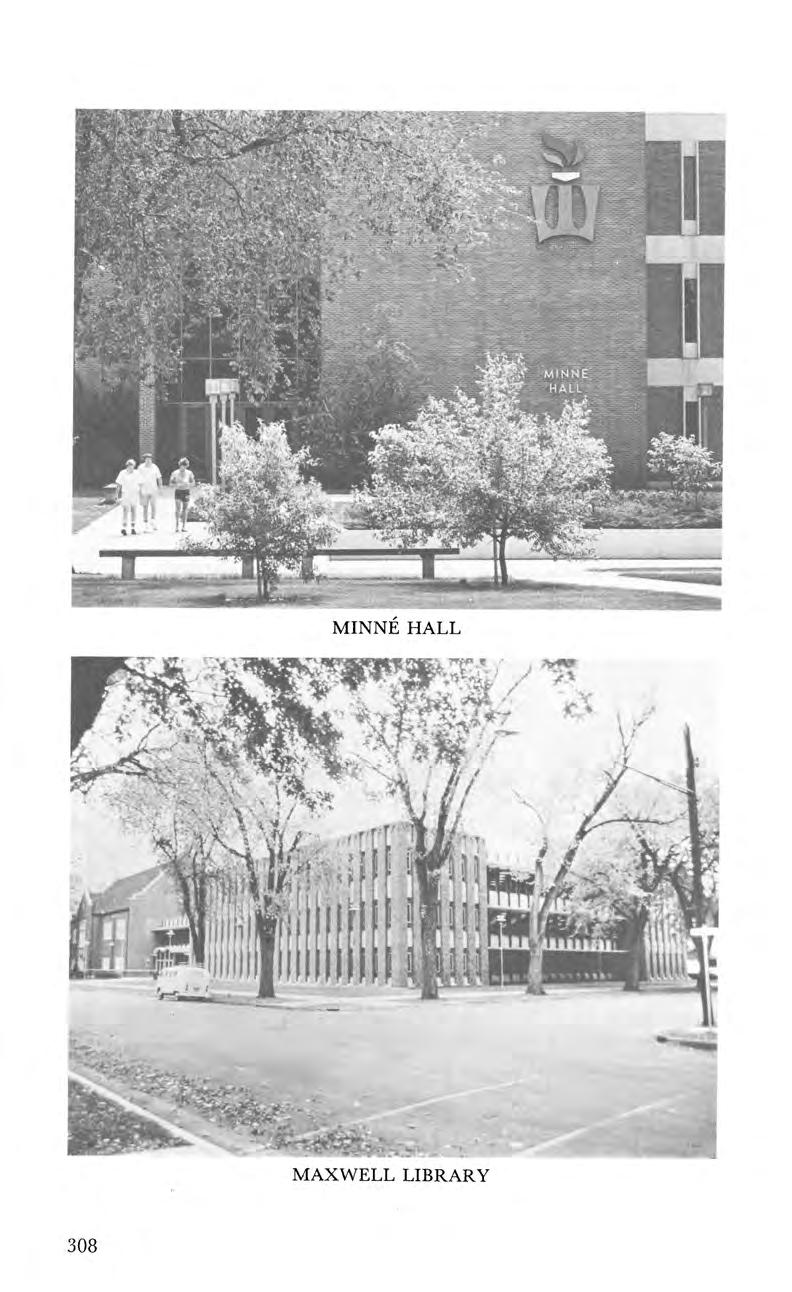
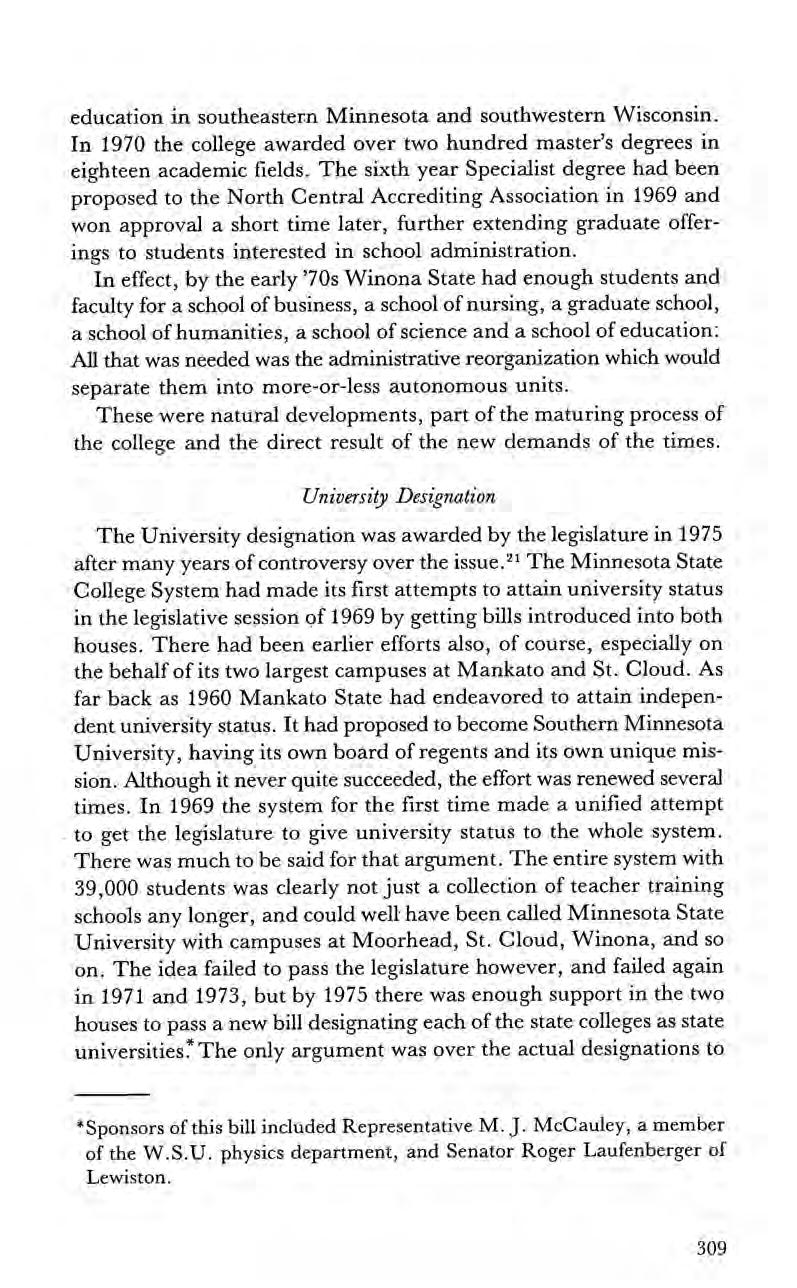
education in southeastern Minnesota and southwestern Wisconsin. In 1970 the college awarded over two hundred master’s degrees in eighteen academic fields. The sixth year Specialist degree had been proposed to the North Central Accrediting Association in 1969 and won approval a short time later, further extending graduate offerings to students interested in school administration.
In effect, by the early ’70s Winona State had enough students and faculty for a school of business, a school of nursing, a graduate school, a school of humanities, a school of science and a school of education: All that was needed was the administrative reorganization which would separate them into more-or-less autonomous units.
These were natural developments, part of the maturing process of the college and the direct result of the new demands of the times.
The University designation was awarded by the legislature in 1975 after many years of controversy over the issue.”! The Minnesota State College System had made its first attempts to attain university status in the legislative session of 1969 by getting bills introduced into both houses. There had been earlier efforts also, of course, especially on the behalf of its two largest campuses at Mankato and St. Cloud. As far back as 1960 Mankato State had endeavored to attain independent university status. It had proposed to become Southern Minnesota University, having its own board of regents andits own unique mission. Although it never quite succeeded, the effort was renewed several times. In 1969 the system for the first time made a unified attempt to get the legislature to give university status to the whole system. There was much to be said for that argument. The entire system with 39,000 students was clearly not just a collection of teacher training schools any longer, and could well have been called Minnesota State University with campuses at Moorhead, St. Cloud, Winona, and so on. The idea failed to pass the legislature however, and failed again in 1971 and 1973, but by 1975 there was enough support in the two houses to pass a new bill designating each of the state colleges as state universities: The only argument was over the actual designations to
*Sponsors of this bill included Representative M. J. McCauley, a member of the W.S.U. physics department, and Senator Roger Laufenberger of Lewiston.

be given the various campuses, the question being whether the title should be preceded by a systems designation, (i.e., Minnesota State University at Winona) or whether the titles should be strictly regional. The latter argument won the day, and the various campuses came to be called Winona State University, Mankato State University, and so on. This apparently satisfied those members ofthe legislature who were worried about the system being confused with the University of Minnesota. The U. of M. had always been a completely separate system, and had never been particularly enthusiastic about university status for the state college system, although it apparently gave nominal support in 1975.
One of the arguments that apparently convinced the legislators of the need for designating the state colleges as universities was that other states with similar systems had long since begun to use the university title, while the Minnesota campuses were still designated as colleges. The main example given was that of La Crosse State jess than thirty miles down river from Winona, and by that time part of the University ofWisconsin System. It had already had the title, La Crosse State University, for a number of years. The fall-off of enrollment in the Minnesota colleges, it was argued, was partly due to this competition (although in actuality La Crosse had lost more students than Winona). Students, it was said, preferred campuses where they could graduate with the University designation on their diplomas
Curiously enough, Winona State seemed not to be very interested in university status. In. fact in 1969 the student body had resolved through the student senate not to pursue the university title. Yet it was the Winona situation vis-a-vis La Crosse State which appeared to be one of the clinching arguments in the final decision to grant university status to all campuses.
One of the stipulations laid down by the legislature specified that the change to university status could not require additional legislative funding. It went so far as to declare that even the old stationery as well as signs, etc., were to be left as they were until such time as replacement was actually physically necessary. This mandate was carried out quite conscientiously. In fact it was not until late 1977 that the sign on Highway No. 61 finally read “Winona State University.”
The regional university concept was basic to the ongoing development of these campuses. In the case ofWinona State the region made up most of the First Congressional District which included Rochester, a dynamic community and one which had great needs for higher

education. How the new Winona State University would meet its regional responsibilities, especially in Rochester, would come to be the question of the hour a few years later when Rochester citizens were calling for a greater WSU presence there and local Winona citizens were coming out adamently against it for fear that somehow ‘it would lead to the demise of WSUin Winona.
One of the opening paragraphs of the President’s Report of1975, written just after University designation, summed up the combina-. tion of optimism, understanding and expectation that the new title brought with it:
As the college begins somewhat self-consciously to take on university status, new and more important demands can be expected to follow. Although Winona State will continue to be a regional service institution, a teaching rather than a research university, at the same time we know that new expectations befitting university status will be in order. Ever increasing qualifications of faculty, quality of teaching in the classroom, evidence of serious scholarship and research at a level heretofore not deemed necessary, should eventually become a very real part of the scene.??
The pursuit of those expectations met with varying degrees of success, but.in the overall turned out to be quite satisfactory. The qualifications of the faculty, for example, reached a level of some sixtyfive percent holding terminal degrees in their fields by 1977, with the remainder having many hours of study beyond the master’s level. No one taught out of his/her field of study and most taught at their optimum level of expertise. The teaching load was established at twelve hours although a few were assigned an occasional overload for which they received extra compensation. Most faculty found that there was adequate time for study, writing and time with the students. For those who were interested there was also time for research, and many pursued important research projects. Independent study and incentive grants were distributed each year. Sabbatical leaves came to be com_pensated at three-quarter salary and awarded in ever greater numbers. All of this benefited the quality of teaching to the point where one survey of the student‘ body resulted in a practically unanimous endorsement by students of the faculty’s expertise in the classroom. Serious scholarship on the part of both faculty and students became an ever more important characteristic of WSU.

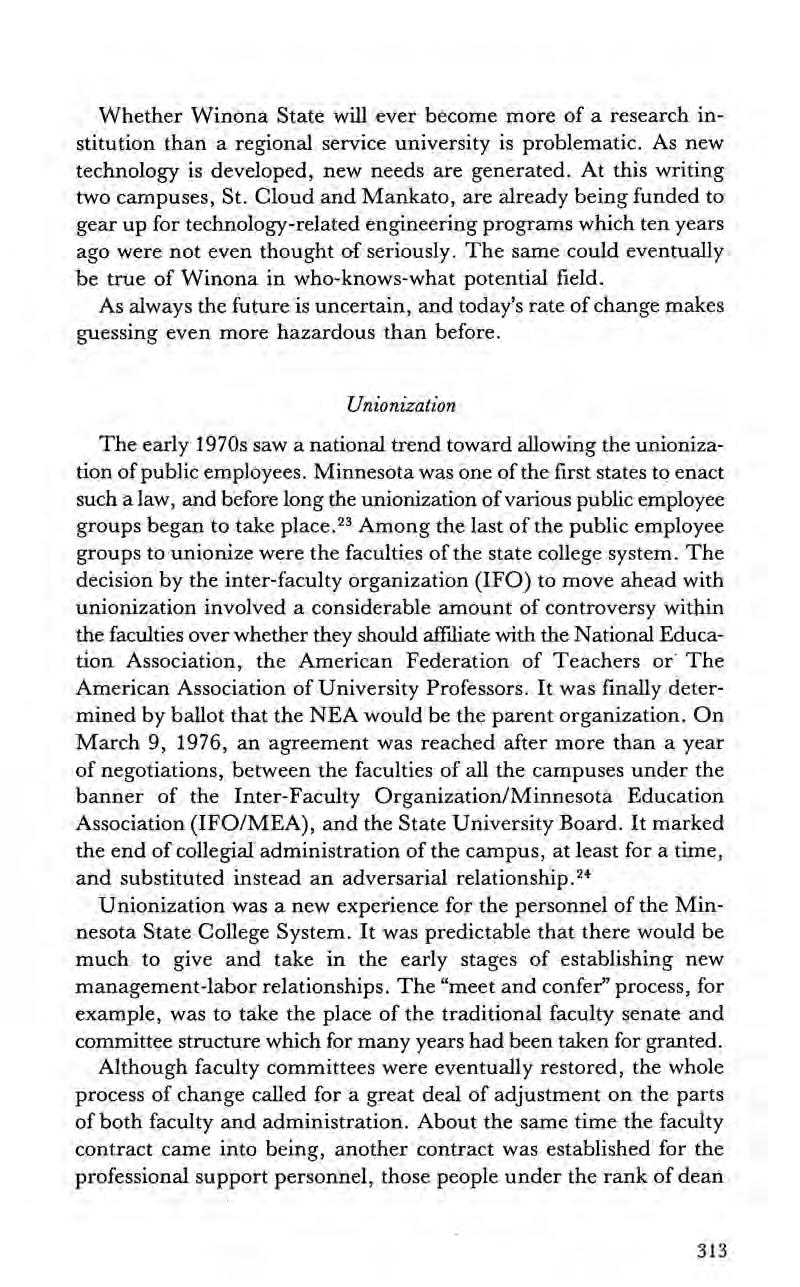
Whether Winona State will ever become more of a research institution than a regional service university is problematic. As new technology is developed, new needs are generated. At this writing two campuses, St. Cloud and Mankato, are already being funded to gear up for technology-related engineering programs which ten years ago were not even thought of seriously. The same could eventually be true of Winona in who-knows-what potential field.
As always the future is uncertain, and today’s rate of change makes guessing even more hazardous than before.
The early 1970s saw a national trend toward allowing the unionization ofpublic employees. Minnesota was one ofthe first states to enact such a law, and before long the unionization ofvarious public employee groups began to take place.2? Among thelast of the public employee groups to-unionize were the faculties of the state college system. The decision by the inter-faculty organization (IFO) to move ahead with unionization involved a considerable amount of controversy within the faculties over whether they should affiliate with the National Education Association, the American Federation of Teachers or The American Association of University Professors. It was finally determined by ballot that the NEA would be the parent organization. On March 9, 1976, an agreement was reached after more than a year of negotiations, between the faculties of all the campuses under the banner of the Inter-Faculty Organization/Minnesota Education Association (IFO/MEA), and the State University Board. It marked the end of collegial administration of the campus, at least for a time, and substituted instead an adversarial relationship.**
Unionization was a new experience for the personnel of the Minnesota State College System. It was predictable that there would be much to give and take in the early stages of establishing new management-labor relationships. The “meet and confer” process, for example, was to takethe place of the traditional faculty senate and committee structure which for many years had been taken for granted.
Although faculty committees were eventually restored, the whole process of change called for a great deal of adjustment on the parts of both faculty and administration. About the same time the faculty contract came into being, another contract was established for the professional support personnel, those people under the rank of dean

who ordinarily served on a twelve month basis in various administrative and quasi-administrative capacities. This was to be a separate union, so a number of people who had formally been considered faculty members were now cut off from the faculty. By virtue of their organizational status they were, in a sense, cut off from the top administration of the college also, all ofwhich further complicated the transition. Custodial and service personnel had affiliated with Council Six, the state employees union, several years earlier.
Unionization meant that a system which had tended toward centralization over the years, soon became even more centralized. Salary negotiations, for example, were no longer a matter of some kind of cooperative effort between the Chancellor’s Office, the Presidents and the faculty organization, but were now negotiated by representatives from the head office of the union, with the Chancellor’s Office representing the State College Board. In the event of a delay, the salary negotiations would be taken over by the Department of Personnel of the State of Minnesota, the whole process thereby being removed ‘even one step further from the local University’s control.
The union organization itself was also highly centralized with its main office in St. Paul. The various locals ofthe seven campuses looked to the St. Paul office for direction. The same was true of the presidents, vice presidents and deans on the local campuses, who had to look to their own Central Office in order to coordinate responses to the various union actions so that one campus would not contradict another in their procedures and responses to the sudden influxof demands and grievances.
The advent of unionism at Winona State University brought with it no unique contributions or problems other than the problem ofboth sides making their adjustments to it. Whether the unionism of the state university system would be seen as advantageous or disadvantageous several years later was really a matter of one’s point of view.
On October 21, 1976, the President sent the following letter to the Chancellor of the system:
Dear Chancellor Hays:
In 1973 the State University Board ruled in SUBIR 14 (F) (4) that Presidentsshould serve a maximum of ten years. My tenth
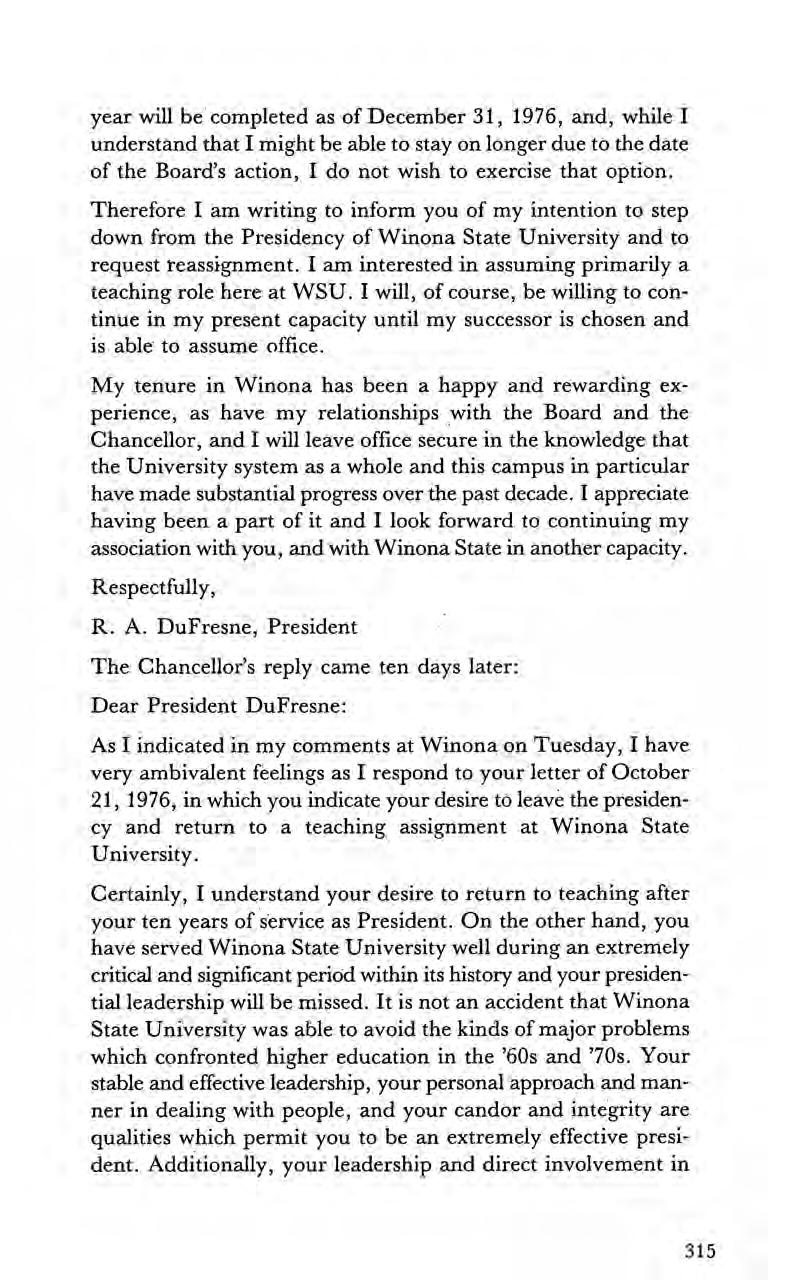
year will becompleted as of December 31, 1976, and, while I understand that I might be able to stay on longer due to the date of theBoard’s action, I do not wish to exercise that option.
Therefore I am writing to inform you of my intention to step down from the Presidency of Winona State University and to request reassignment. I am interested in assuming primarily a teaching role here at WSU. I will, of course, be willing to continue in my present capacity until my successor is chosen and is able to assume office.
My tenure in Winona has been a happy and rewarding experience, as have my relationships with the Board and the Chancellor, and I will leave office secure in the knowledge that the University system as a whole and this campus in particular have made substantial progress over the past decade. I appreciate having beena part of it and I look forward to continuing my association with you, and with Winona State in another capacity.
Respectfully,
R. A. DuFresne, President
The Chancellor’s reply came ten days later:
Dear President DuFresne:
As I indicated in my comments at Winona on Tuesday, I have very ambivalent feelings as I respond to your letter of October 21, 1976, in which you indicate your desire to leave the presidency and return to a teaching assignment at Winona State University.
Certainly, I understand your desire to return to teaching after your ten years of service as President. On the other hand, you have served Winona State University well during an extremely critical and significant period within its history and your presidential leadership will be missed. It is not an accident that Winona State University was able to avoid the kinds of major problems which confronted higher education in the 60s and ’70s. Your stable and effective leadership, your personal approach and manner in dealing with people, and your candor and integrity are qualities which permit you to be an extremely effective president. Additionally, your leadership and direct involvement in

the development of an external studies program has allowed Winona State University to make a major contribution to the region which it serves.
Ona personal note, I have very much enjoyed my association with you. Your insight and advice havebeen invaluable in administrative staff meetings. Moreover, I have valued your friendship and the personal relationship which we have developed over the years.
Therefore, it is in this spirit that I accept your letter of resignation from the Presidency and your request to return to a teaching assignment. I will forward that request to the State University Board during its meeting in Winona on November 17, 1976.
Again, let me express to you my genuine appreciation and admiration for the manner in which you have conducted the presidency at Winona State University; I look forward to working with you in your new role and to maintaining a continued personal friendship.
Sincerely,
Garry D. Hays, Chancellor
The University, now officially informed of the Board’s acceptance of the resignation, proceeded quickly to establish a committee to seek a replacement.
In keeping with required affirmative action procedures, the committee advertised nationally, interviewed a number ofcandidates and finally recommended three candidates to the Board. After due consideration the Board named Dr. Robert Hanson of Moorhead State to be the next President of Winona State to begin with the fall term of 1977.
Dr. Hanson had a long history of service to Minnesota education. He had beena classroom teacher and director of agricultural programs at the West Central School of the University of Minnesota for nearly ten years. In 1959 he went to Moorhead State as Director of Admissions. He had been academicvice president at Moorhead for five years prior to his appointment to Winona State.

A. HANSON President, 1977-1983
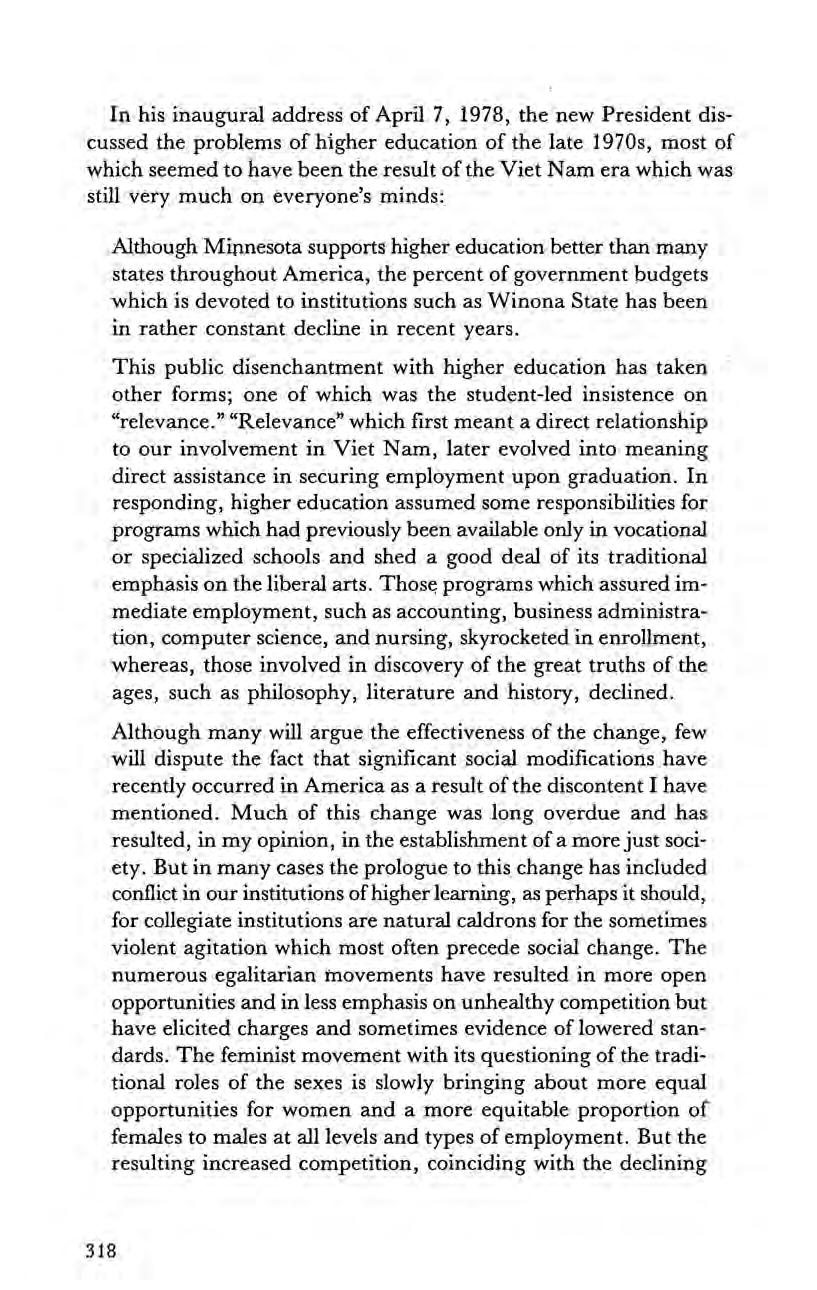
In his inaugural address of April 7, 1978, the new President discussed the problems of higher education of the late 1970s, most of which seemed to havebeen the result of the Viet Nam era which was still very much on everyone’s minds:
Although Minnesota supports higher education better than many states throughout America, the percent of government budgets which is devoted to institutions such as Winona State has been in rather constant decline in recent years.
This public disenchantment with higher education has taken other forms; one of which was the student-led insistence on “relevance.” “Relevance” which first meant a direct relationship to our involvement in Viet Nam, later evolved into meaning direct assistance in securing employment upon graduation. In responding, higher education assumed some responsibilities for programs which had previously been available only in vocational or specialized schools and shed a good deal of its traditional emphasis on the liberal arts. Those programs which assured immediate employment, such as accounting, business administration, computer science, and nursing, skyrocketed in enrollment, whereas, those involved in discovery of the great truths of the ages, such as philosophy, literature and history, declined.
Although many will argue the effectiveness of the change, few will dispute the fact that significant social modifications have recently occurred in America as a result of the discontent I have mentioned. Much of this change was long overdue and has resulted, in my opinion, in the establishment of a more just society. But in many cases the prologue to this change has included conflict in our institutions ofhigherlearning, as perhaps it should, for collegiate institutions are natural caldrons for the sometimes violent agitation which most often precede social change. The numerous egalitarian movements have resulted in more open opportunities and in less emphasis on unhealthy competition but have elicited charges and sometimes evidence of lowered standards. Thefeminist movement with its questioning of the traditional roles of the sexes is slowly bringing about more equal opportunities for women and a more equitable proportion of females to males at all levels and types of employment. But the resulting increased competition, coinciding with the declining

number of vacant faculty and administrative positions, is creating some tension as well. Efforts to overcome the effects of past racial and sexual discrimination through programs ofAffirmative Action have been only moderately successful in academia so far.
He felt that the answer to the drift away from traditional values was to return to the basics:
Liberal education is the core that distinguishes college programs from those available elsewhere, and the recent trend to diminish its relative importance must be reversed; for young citizens need more than justjob entry skills. Our colleges and universities have a major role in assuring both the stability and the progress of democratic institutions; for they provide the basis for the inquiry and debate so necessary for that orderly change which in turn prevents violent eruptions ina free society. The leaders of tomorrow must first learn to thinkfor themselves and to express themselves clearly. They must learn the rights and responsibilities of citizenship and the importance of exercising those rights and responsibilities. They must learn to question the values based upon principles which can logically lead to the common good. They must learn to appreciate the humanistic achievements of mankind, such as literature, art, music and theatre, so that the ecological and sociological pressures resulting from materialism may be lessened and, of course, so that the students’ lives may be enriched. Young men and women must learn to understand and appreciate the contributions of other peoples sn that they may adjust to living in a pluralistic society and help assure an harmonious relationship among diverse. cultures. The minds of all must be developed to their fullest, and especially so for the gifted, for this nation and the entire world faces many potentially devastating perplexities; the specters of war, drug abuse, crime, the energy shortage, and environmental pollution are but examples of these problems which only the best of minds, fully developed, can hope to conquer.
We must find ways of teaching our youth thatorder in society is both essential and inevitable, but at the same time, teach them how to develop or enhance a system in which equality of opportunity is a reality. Meritocracy and egalitarianism must co-exist in any successful democracy, and higher education must see to

it that excellence is dominant in both, for shoddiness in any form is detrimental to the good life that we all seek. These then are the unique and vital roles of institutions such as Winona State University.
It will be my primary goal, Mr. Chancellor, as President of Winona State University to work together with the faculty, the students, and the other administrators of this institution to make excellence the key word in all these endeavors. I am optimistic that we will not fail.*5
Tragically, fate did not allocate him enough time to carry out his plans. About the middle of December of 1981 the President suffered a severe stroke. He had hada history ofhigh blood pressure, but had been able to keep it under control with proper medication, so the episode came as a shock to everyone concerned.
The University was suddenly without a head. Chancellor Garry Hays convened the Board as soon as it became clear that Dr. Hanson was going to be incapacitated, at least for a while, and the Board upon his recommendation named Vice President Helen Popovich as Acting President. Dr. Popovich had been vice president for barely one year at the time of her appointment, but it was expected that she would not be in the president’s chair for more than a few months. Dr. Hanson never resumed the officehowever. His physical recovery went forward quite well, but his memory was affected enough so that it was clear that it would take months or even years fora full recovery to take place. The Board did not rush the matter, however, desiring to be as fair as possible, giving him ample time to see whether he would feel up to going back to work. But on April 8, 1983, President Hanson resigned to take early retirement.
In the meantime fifteen months had elapsed and things were not going well. Acting President Popovich and her assistants did not see things the same as the faculty saw them. The result was continuing friction between members ofthe faculty association and the administration. Discussion and meetings were tense and confrontational, with more and more polarization taking place as time went on. Soon the faculty was publicly calling for the resignations of the acting president and members of her staff, with the local newspaper using it all as front page and headline material.
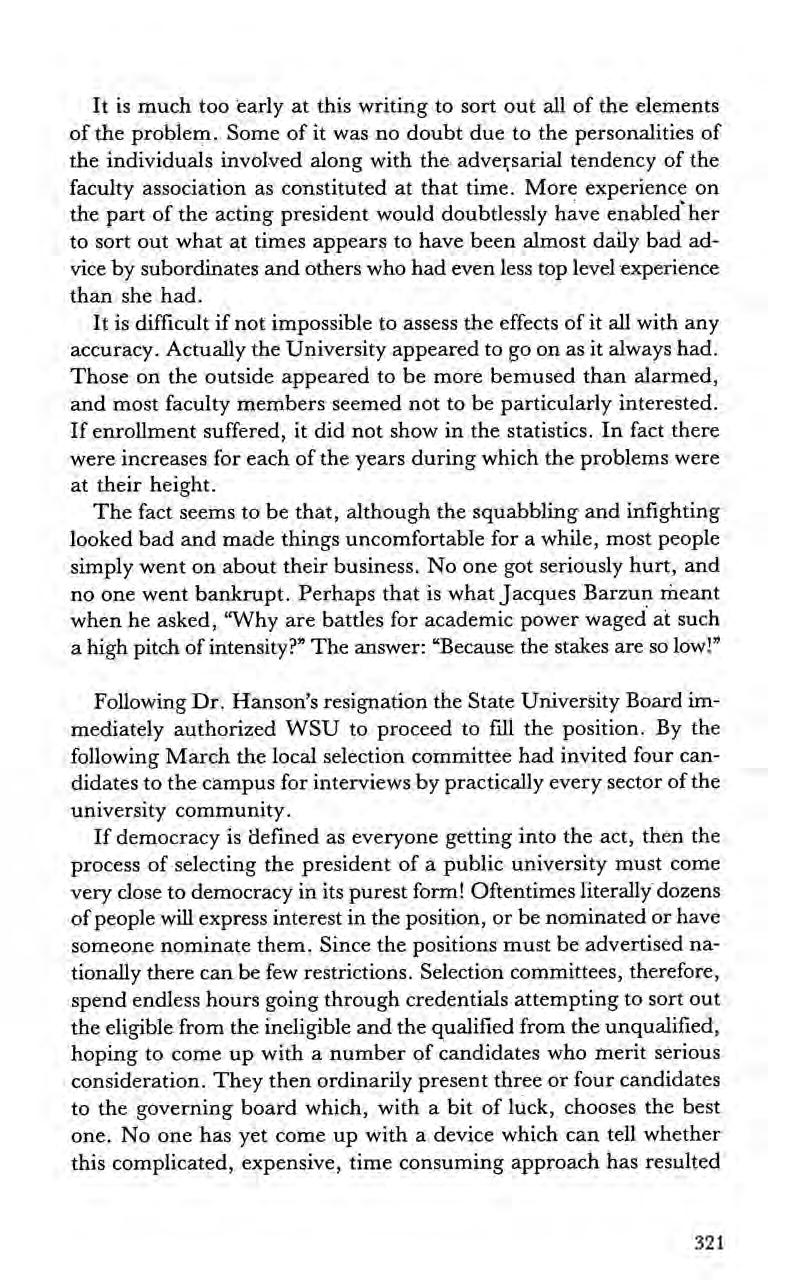
It is much too early at this writing tosort out all of the elements of the problem. Some of it was no doubt due to the personalities of the individuals involved along with the. adversarial tendency of the faculty association as constituted at that time. More experience on the part of the acting president would doubtlessly have enabledher to sort out what at times appears to havebeen almost daily bad advice by subordinates and others who had even less top level experience than she had.
It is difficult if not impossible to assess the effects of it all with any accuracy. Actually the University appeared to go on as it always had. Those on the outside appeared to be more bemused than alarmed, and most faculty members seemed not to be particularly interested. If enrollment suffered, it did not show in the statistics. In fact there were increases for each of the years during which the problems were at their height.
The fact seems to be that, although the squabbling and infighting looked bad and made things uncomfortable for a while, most people simply went on about their business. No one got seriously hurt, and no one went bankrupt. Perhaps that is what Jacques Barzun meant when he asked, “Why are battles for academic power waged at such a high pitch of intensity?” The answer: “Because the stakes are so low!”
Following Dr. Hanson’s resignation the State University Board immediately authorized WSU to proceed to fill the position. By the following March the local selection committee had invited four candidates to the campus for interviews by practically every sector of the university community.
If democracy is defined as everyone getting into the act, then the process of selecting the president of a public university must come very close to democracy in its purest form! Oftentimes literally dozens ofpeople will express interest in the position, or be nominated or have someone nominate them. Since the positions must be advertised nationally there can be few restrictions. Selection committees, therefore, spend endless hours going through credentials attempting to sort out the eligible from the ineligible and the qualified from the unqualified, hoping to come up with a number of candidates who merit serious consideration. They then ordinarily present three or four candidates to the governing board which, with a bitof luck, chooses the best one. No one has yet come up with a device which can tell whether this complicated, expensive, time consuming approach has resulted
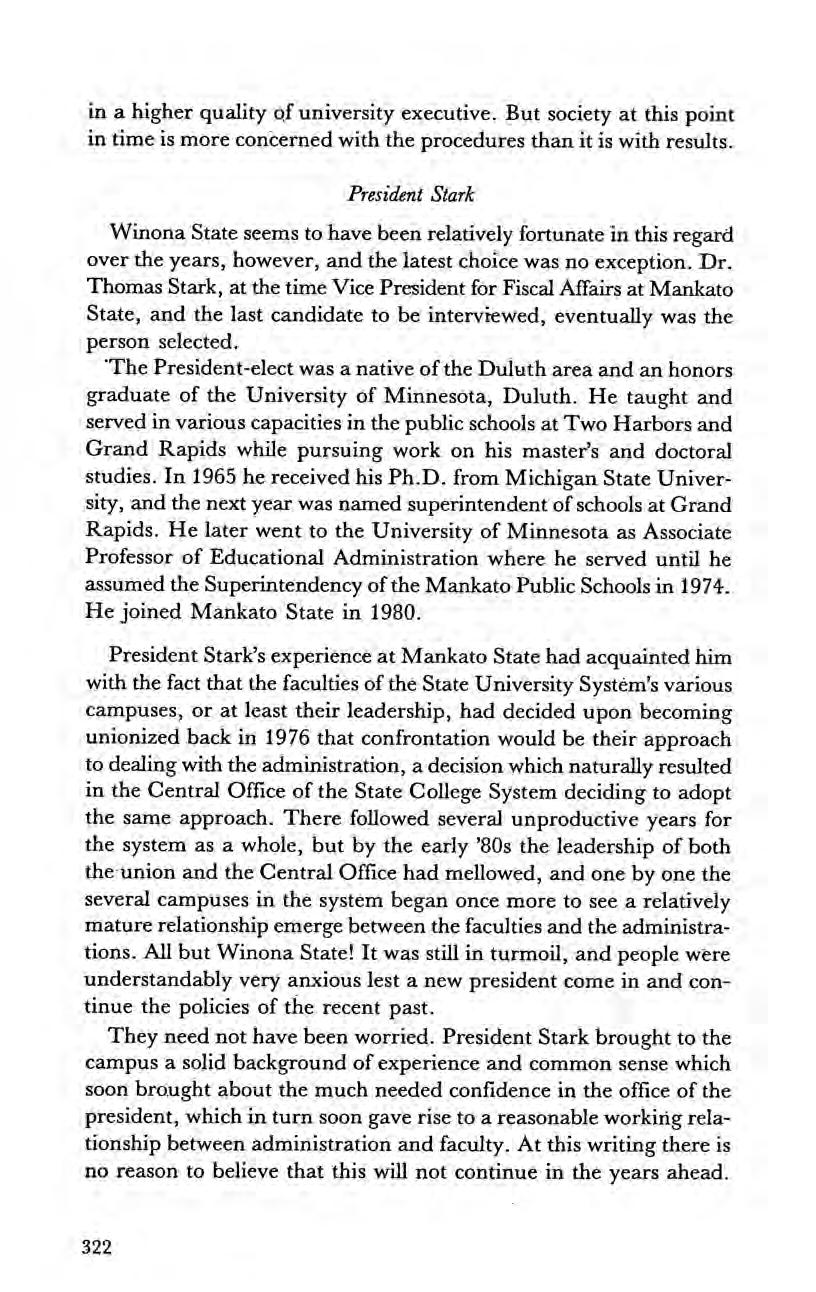
in a higher quality of university executive. But society at this point in time is more concerned with the procedures than it is with results.
Winona State seems to have been relatively fortunate in this regard over the years, however, and the latest choice was no exception. Dr. Thomas Stark, at the time Vice President for Fiscal Affairs at Mankato State, and the last candidate to be interviewed, eventually was the person selected.
“The President-elect was a native ofthe Duluth area and an honors graduate of the University of Minnesota, Duluth. He taught and served in various capacities in the public schools at Two Harbors and Grand Rapids while pursuing work on his master’s and doctoral studies. In 1965 he received his Ph.D.from Michigan State University, and the next year was named superintendent of schools at Grand Rapids. He later went to the University of Minnesota as Associate Professor of Educational Administration where he served until he assumed the Superintendency ofthe Mankato Public Schools in 1974. He joined Mankato State in 1980.
President Stark’s experience at Mankato State had acquainted him with the fact that the faculties of the State University Systém’s various campuses, or at least their leadership, had decided upon becoming unionized back in 1976 that confrontation would be their approach to dealing with the administration, a decision which naturally resulted in the Central Office of the State College System deciding to adopt the same approach. There followed several unproductive years for the system as a whole, but by the early ’80s the leadership of both the union and the Central Office had mellowed, and one by one the several campuses in the system began once more to seea relatively mature relationship emerge between the faculties andthe administrations. All but Winona State! It was still in turmoil, and people were understandably very anxious lest a new president come in and continue the policies of the recent past.
They need not have been worried. President Stark brought to the campusa solid background of experience and common sense which soon brought about the much needed confidence in the office of the president, which in turn soon gave rise to a reasonable working relationship between administration and faculty. At this writing there is no reason to believe that this will not continue in the years ahead.
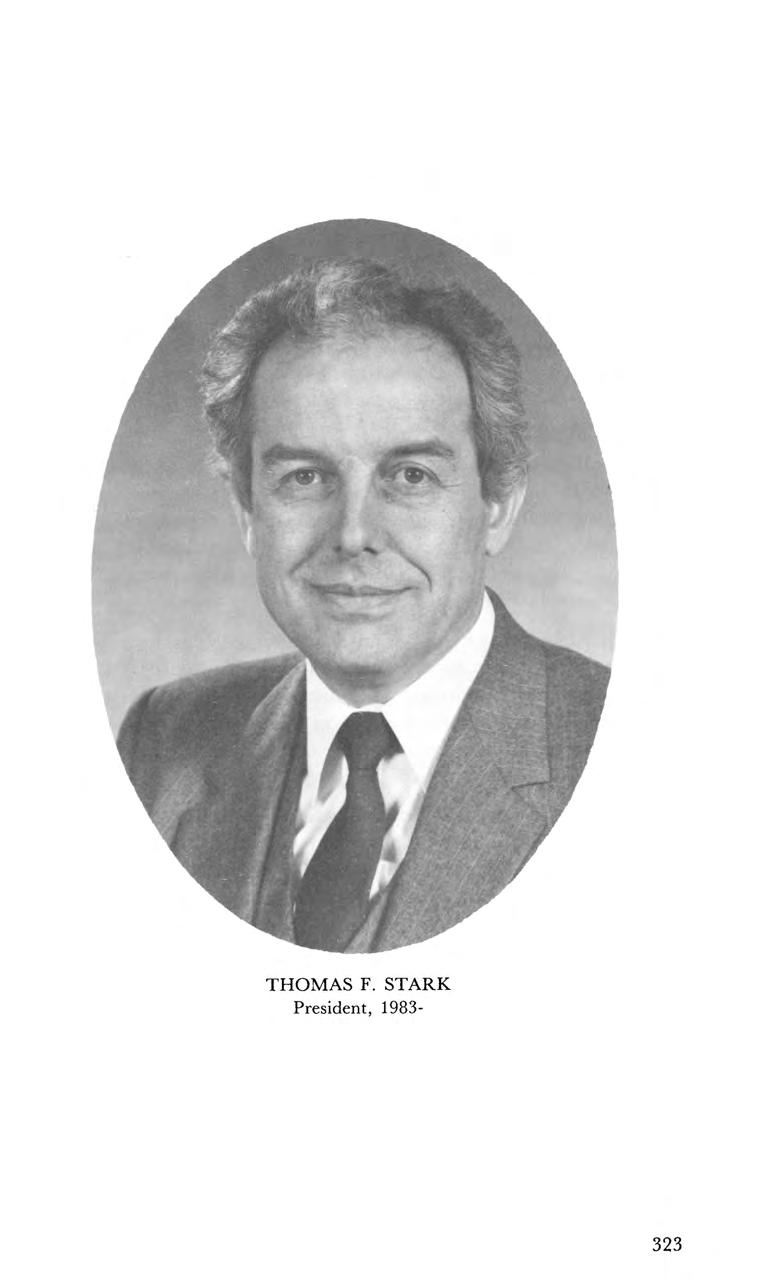
President, 1983-
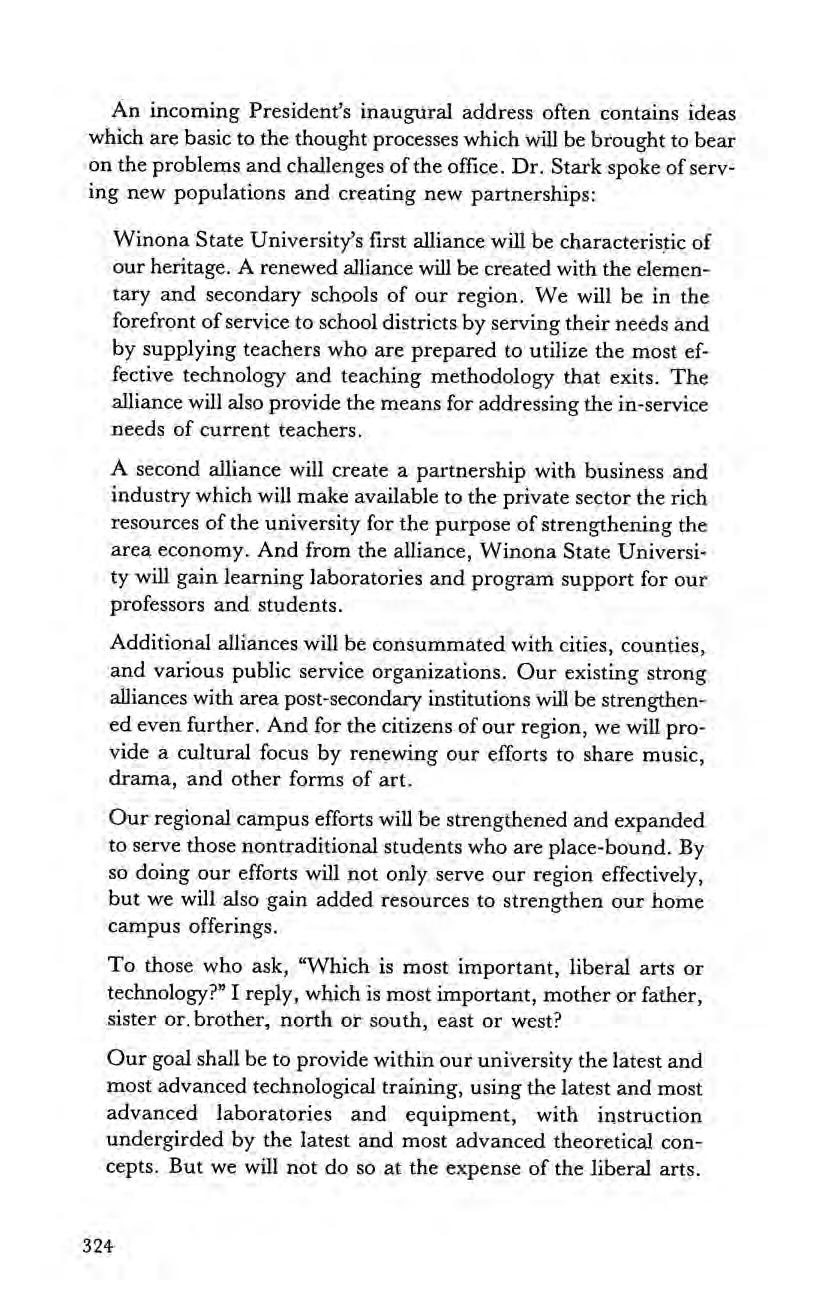
An incoming President’s inaugural address often contains ideas which are basic to the thought processes which will be brought to bear on the problems and challenges of the office. Dr. Stark spoke of serving new populations and creating new partnerships:
Winona State University’s first alliance will be characteristic of our heritage. A renewed alliance will be created with the elementary and secondary schools of our region. We will be in the forefront of service to school districts by serving their needs and by supplying teachers who are prepared to utilize the most effective technology and teaching methodology that exits. The alliance will also provide the means for addressing the in-service needs of current teachers.
A second alliance will create a partnership with business and industry which will make available to the private sector the rich resources of the university for the purpose of strengthening the area economy. And from the alliance, Winona State University will gain learning laboratories and program support for our professors and students.
Additional alliances will be consummated with cities, counties, and various public service organizations. Our existing strong alliances with area post-secondary institutions will be strengthened even further. And for the citizens of our region, we will provide a cultural focus by renewing our efforts to share music, drama, and other forms of art.
Our regional campus efforts will be strengthened andexpanded to serve those nontraditional students who are place-bound. By so doing our efforts will not only serve our region effectively, but we will also gain added resources to strengthen our home campus offerings.
To those who ask, “Which is most important, liberal arts or technology?” I reply, which is most important, mother or father, sister or. brother, north or south, east or west?
Our goal shall be to provide within our university the latest and most advanced technological training, using the latest and most advanced laboratories and equipment, with instruction undergirded by the latest and most advanced theoretical concepts. But we will not do so at the expense of the liberal arts.

President Stark revealed his attitude toward the faculty and its function in the final paragraphs of his address:
But most of all we have that key ingredient which makes a university truly outstanding — we have an outstanding faculty. Although committed to the time-honored tradition of teaching, research, and service, at Winona State we proudly boast that our highest priority is teaching. We are a teaching institution —and fine teaching abounds. In addition to excellence in the classroom, however, our professors have distinguished themselves as researchers, performers, writers, and scholars. And our outstanding support staff works tirelessly in facilitating the instructional process.
And so as we begin this task of preserving our heritage and enhancing our future, I ask that those of us assembled here today, together with all friends of education, join me in forwarding our agenda for success. Should we do so with spirit and energy and commitment, an illustrious future for our university is assured.
To paraphrase the words of our first president, let the friends of education rally around this institution and let us with wise counsel, willing hearts, and ready hands, cooperate to realize the perfect idea of this university.”®
As this historical account ofWinona State goes to press, the University is completing its 125th year of service. This book is part of the celebration of the life of an institution which has not only outlived its founders, but has grown and prospered beyond their most fervent hopes. Great indeed are its contributions to the thousands of students who have gone through its doors. What they did with their lives, who they touched and what they accomplished constitute the very reasons for the school’s existence.
Today there are hundreds of colleges and universities in the United States both private and public; some large and some small. It is a different scene from thewilderness which presented itself to the pioneer as he struggled West to forge a new life for himself and his family. The State of Minnesota in particular has prospered mightily, not only in financial terms, but more importantly, in the way in which it has
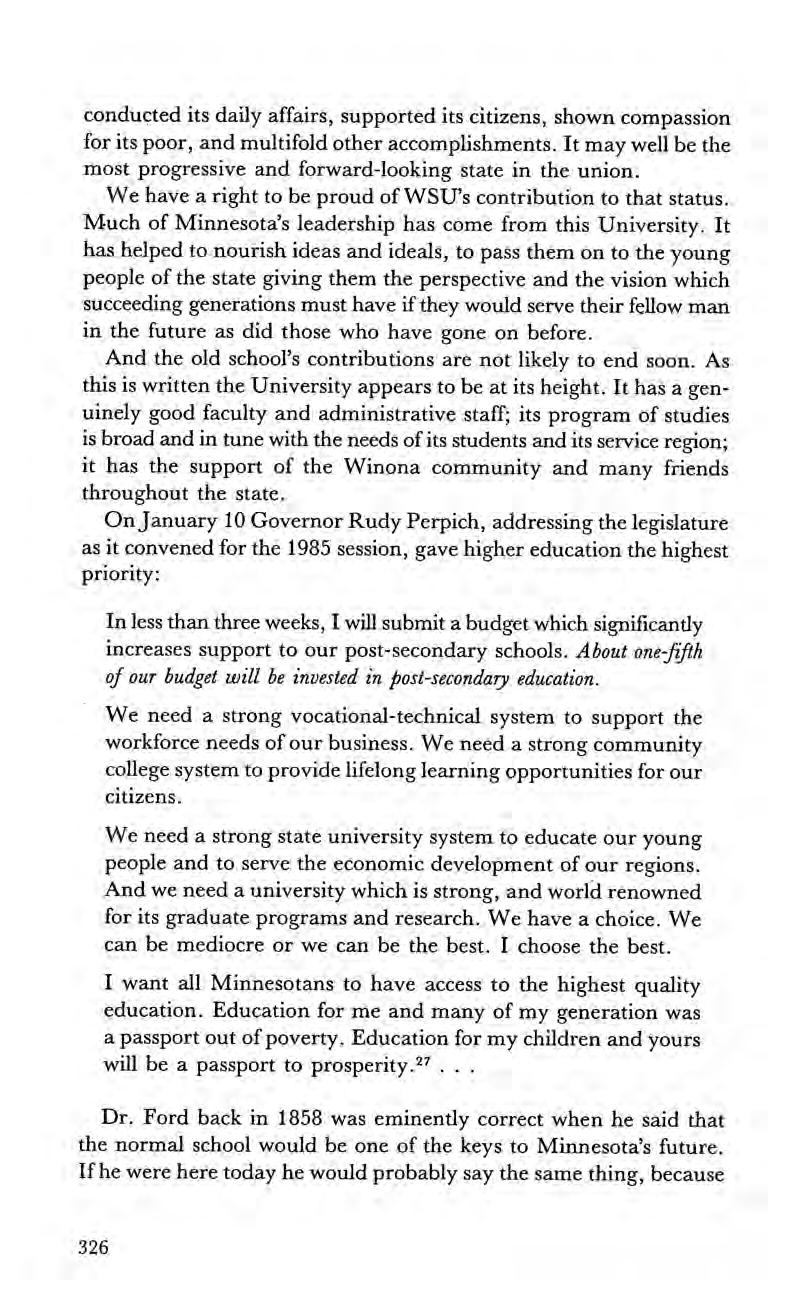
conducted its daily affairs, supported its citizens, shown compassion for its poor, and multifold other accomplishments. It may well be the most progressive and forward-looking state in the union.
We havea right to be proud of WSU’s contribution to that status. Much of Minnesota’s leadership has come from this University. It has helped to nourish ideas and ideals, to pass them on to the young people of the state giving them the perspective and the visionwhich succeeding generations must have if they would serve their fellow man in the future as did those who have gone on before.
And the old school’s contributions are not likely to end soon. As this is written the University appears to be at its height. It has a genuinely good faculty and administrative staff; its program of studies is broad and in tune with the needs of its students and its service region; it has the support of the Winona community and many friends throughout the state.
OnJanuary 10 Governor Rudy Perpich, addressing the legislature as it convened for the 1985 session, gave higher education the highest priority:
In less than three weeks, I will submit a budget which significantly increases support to our post-secondary schools. About one-fifth of our budget will be invested in post-secondary education.
We need a strong vocational-technical system to support the workforce needs of our business. We need a strong community college system to provide lifelong learning opportunities for our citizens.
We needa strong state university system to educate our young people and to serve the economic development of our regions. And we needa university which is strong, and world renowned for its graduate programs and research. We have a choice. We can be mediocre or we can be the best. I choose the best.
I want all Minnesotans to have access to the highest quality education. Education for me and many of my generation was a passport out of poverty. Education for my children and yours will be a passport to prosperity.?”7
Dr. Ford back in 1858 was eminently correct when he said that the normal school would be one of the keys to Minnesota’s future. Ifhe were here today he would probably say the same thing, because

he would know that the future stretches out just as far today as it did back in 1860 when Winona State opened its doors for the first time.
Lo, in Mississippi's waters Blue, the eternal sky; In our hearts, O Alma Mater, Clear thy spirit high!
Chorus
Lift the chorus, Send it ringing Far over hill and vale! Hail to thee, O Alma Mater! Hail, Winona, hail!
Noble hills watch o’er the valley Where thy dwelling lies; Steadfast hearts, O Alma Mater, Guard thy destinies.
Ever shall tomorrow better What today has won; Lead thy children, Alma Mater, On, forever on!
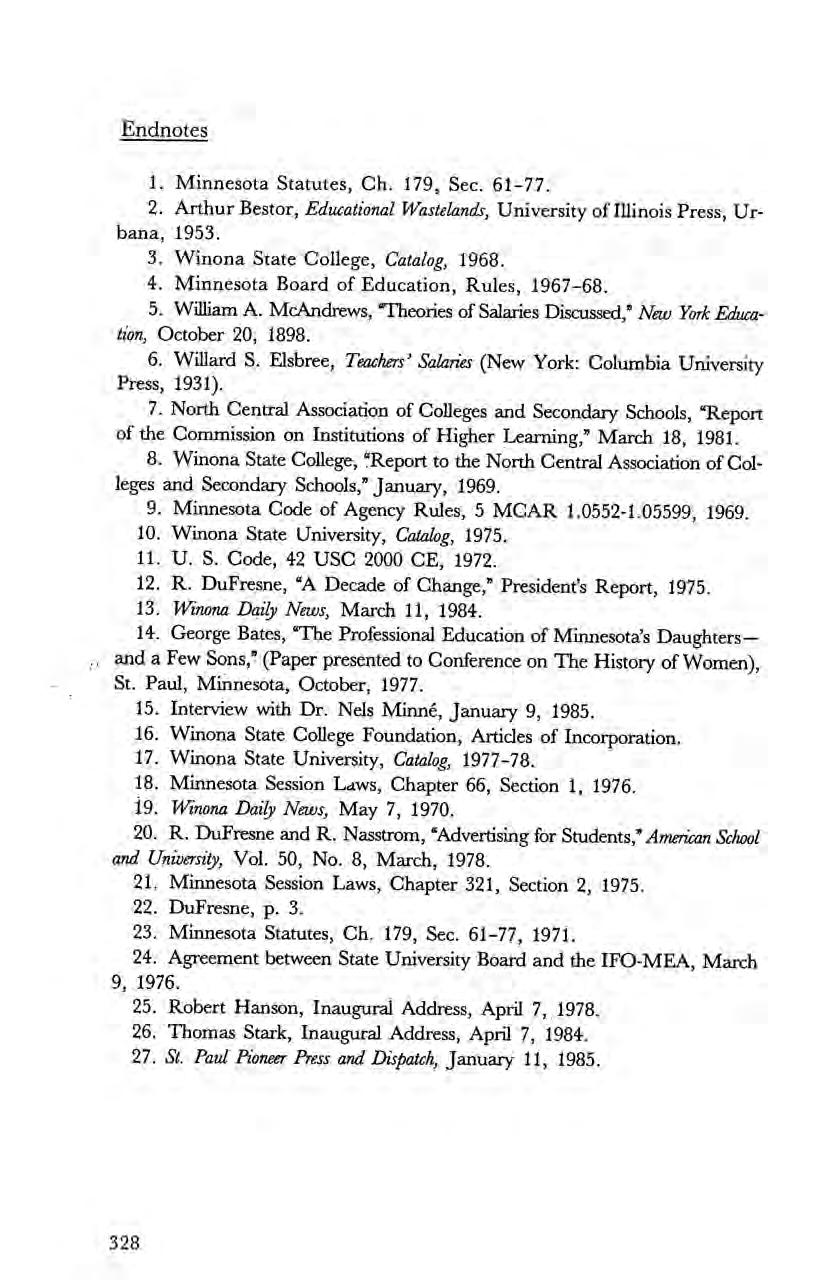
1. Minnesota Statutes, Ch. 179, Sec. 61-77.
2. Arthur Bestor, Educational Wastelands, University of Illinois Press, Urbana, 1953.
3. Winona State College, Catalog, 1968.
4. Minnesota Board of Education, Rules, 1967-68.
5. William A. McAndrews, “Theories of Salaries Discussed,” New York Education, October 20, 1898.
6. Willard S. Elsbree, Teachers’ Salaries (New York: Columbia University Press, 1931).
7. North Central Association of Colleges and Secondary Schools, “Report of the Commission on Institutions of Higher Learning,” March 18, 1981.
8. Winona State College, “Report to the North Central Association of Colleges and Secondary Schools,”January, -1969.
9. Minnesota Code of Agency Rules, MCAR 1.0552-1.05599, 1969.
10. Winona State University, Catalog, 1975.
11. U. S. Code, 42 USC 2000 CE, 1972.
12. R. DuFresne, “A Decade of Change,” President’s Report, 1975.
13. Winona Daily News, March 11, 1984.
14. George Bates, “The Professional Education of Minnesota’s Daughters— and a Few Sons,”(Paper presented to Conference on The History of Women), St. Paul, Minnesota, October, 1977.
15. Interview with Dr. Nels Minné, January 9, 1985.
16. Winona State College Foundation, Articles of Incorporation.
17. Winona State University, Catalog, 1977-78.
18. Minnesota Session Laws, Chapter 66, Section 1, 1976.
19. Winona Daily News, May 7, 1970.
20. R. DuFresne and R. Nasstrom, “Advertising for Students,” American School and Unwersity, Vol. 50, No. 8, March, 1978.
21. Minnesota Session Laws, Chapter 321, Section 2, 1975.
22. DuFresne, p. 3.
23. Minnesota Statutes, Ch. 179, Sec. 61-77, 1971.
24. Agreement between State University Board and the IFO-MEA, March 9, 1976.
25. Robert Hanson, Inaugural Address, April 7, 1978.
26. Thomas Stark, Inaugural Address, April 7, 1984.
27. St. Paul Pioneer Press and Dispatch, January 11, 1985.

The faculty listing which follows was compiled from the lists included in the 1910 and 1935 histories and the college catalogs from’ 1935 to the present time. A few catalogs covered more than one academic year. Some names, therefore, may have been inadvertently omitted, e.g., those who were here on a part time basis and/or for one year or less.
JOHN OGDEN, PRINCIPAL
D. B. Reid, CHEM
Wm. J. Stearns, ASST PRIN
V. J. Walker, Temp. Principal No Session
WILLIAM F. PHELPS, PRINCIPAL
Wm. Jay Youmans, CHEM
O. D. Adams, MUSIC
Mary V. Lees, EDUC
Belle S. Thompson, MATH
Sarah J. Timanus, LAB SCH
Christine Gilbert, LAB SCH
Clara P. Sheldon, LAB SCH
Emma Bancroft, MUSIC
Charilla Hamblin, MUSIC
Cooper G. Walker, LAB SCH
J. B. McGibeny, MUSIC
Eugenia A. Wheeler, GEOG
Minnie Hewitt, LAB SCH
Charles Curtiss, ENG
Ellen Williams, ASST
A. Jennie Farber, LAB SCH
Josie Stevens, LAB SCH
Anna Sanderson, EDUC
Sarah Wheeler, HIST, GEOG
Myra Kimball, LAB SCH
Mary Cooley, MUSIC, GYM
Franc E. Sharp, LAB SCH
Delia Browning, LAB SCH
Conrad Utzinger, LAB SCH
CHARLES MOREY, SCI, PRINCIPAL
John D. Lord, ENG, ART
Clarence Boutelle, MATH
1860-1861
1860-1861
1860-1861
1861-1862
1862-1864
1864-1876
1864-1867
1864-1868
1864-1872
1864-1875
1864-1869
1864-1870
1866-1868
1866-1868
1867-1868
1868-1869
1869-1873
1869-1876
1869-1872
1870-1883
1870-1871
1870-1872
1871-1872
1872-1874
1872-1876
1872-1879
1873-1877
1873-1877
1873-1879
1873-1874
1874-1879
1874-1875
1874-1883
Clara J. Armstrong, ENG
Corlis Pickert, HIST, ENG
Fanny J. Kimber, EDUC
Fayette L. Cook, ENG
L. W. Denton, LAB SCH
Jennie Stewart, MUSIC, GYM
Martha Brechbill, GEOG
Gertrude Chapin, ENG, MATH
Anna Baldwin, LAB SCH
IRWIN SHEPARD, PRESIDENT
Theo. Richardson, ENG, ART
Alice H. Bingham, LAB SCH
Mary Gorham, MUSIC
Kate Grant, ENG
Lillian Partridge, LAB SCH
Louie H. Benney, ENG
Blanch MacKie, MUSIC
Jennie Ellis, HIST, GOVT
Kate M. Ball, HOME EC
Alfaretta Haskell, LAB SCH
Mary Hartman, MATH, LATIN
Florence C. Wheat, ENG
Sophie L. Haight, ENG
Sarah Eccleston, KGT'N
Alcinda Morrow, ENG
Kate Sprague, MATH
Henrietta Gilbert, MUSIC
Vienna Dodge, IND ED
John M. Holzinger, SCI
Mary E. Couse, LAB SCH
Antoinette Choate, LAB SCH
Thomas H. Kirk, SCI
Ada L. Mitchell, MUSIC
Anna Fockens, LIB, ENG
1875-1876
1875-1879
1876-1881
1876-1879
1876-1877
1877-1878
1877-1889
1877-1879
1877-1883
1879-1898
1879-1880
1879-1883
1879-1880
1879-1880
1879-1880
1880-1881
1880-1882
1880-1882
1880-1882
1880-1882
1881-1882
1881-1882
1881-1883
1881-1883
1882-1883
1882-1918
1882-1883
1882-1891
1882-1922
1882-1884
1882-1883
1883-1887
1883-1887
1883-1887
Jeannette McCool, LAB SCH
Mary E. Sykes, LAB SCH
Belle Thomas, LAB SCH
Angeline Brooks, KGTN
Eudora Hailman, KGTN
Sarah E.-Whitaker, ENG
Irene M. Mead, ENG, REG
Georgia Timerson, LAB SCH
Florence A. Reed, LAB SCH
Harriet R. Donovan, KGTN
Gerturde Stapels, ENG
Clara L. Grow, LAB SCH
Ada L. Fairfield, LAB SCH
Anna Broadwell, HIST, LATIN
Ellor Carlisle, LAB SCH
Frances Elmer, LIB, LATIN
Elmer Whitted, ENG
Sarah M. Row, LAB SCH
Verna Sheldon, HIST, GOVT
Mary A. Keyes, LAB SCH
Caroline Smith, MUSIC, ENG
George E. Knepper, MUSIC
Kate E. Ernst, KGTN
Anna O. Yeaton, LAB SCH
Celia Mitchell, ENG, HIST
Charles A. McMurry, EDUC
Nellie Turner, LAB SCH
Linnaeus P. Cravens, MATH
L. S. Ross, SCI
Lydia E. Kniss, HIST, ENG
Ella Patterson, LAB SCH
Edwin J. Freeman, SCI
Manfred Holmes, HIST, GOVT
Mary Gilbert, ART, GEOG
Bertha Speckman, ART
Lona Washburn, LAB SCH
Mary Macintyre, KGTN
Grace Hopkins, REGISTRAR
Louis H. Galbreath, EDUC
E. A. Kirkpatrick, EDUC
Fanny G. French, MATH
Mary O’Brien, LAB SCH
Lillian Tompkins, LAB SCH
Harriet Packard, KGTN
Elizabeth Share, LAB SCH
S. L. Blaisdell, KGTN
Emily R. Harris, ENG
Nora Atwood, KGTN
Grace Leavitt, LAB SCH
Dimon H. Roberts, EDUC
Edward Lehnerts, GEOG
Clara A. Poe, LAB SCH
Mary Gilman, LAB SCH
Katherine Everts, ENG
Katherine Andrews, MATH
Miriam Winchester, LAB SCH
George O. Virtue, HIST
Lois Voswinkel, ENG
1883-1892
1883-1884
1883-1884
1883
1883-1884
1884-1885
1884-1909
1884-1885
1884-1885
1884-1889
1884-1889
1885-1890
1885-1887
1886-1888
1886-1887
1886-1907
1887
1887-1888
1888-1889
1888-1900
1889-1918
1889-1891
1889-1894
1889-1896
1889-1891
1889-1892
1889-1890
1890-1891
1890-1891
1890-1891
1890-1891
1891-1898
1891-1897
1891-1892
1891-1932
1891-1892
1891-1892
1891-1910
1892-1896
1892-1897
1892-1898
1892-1900
1892-1894
1893-1910
1894-1895
1894-1895
1895-1898
1895-1911
1895-1897
1896-1900
1896-1907
1896-1901
1896-1897
1896-1899
1897
1897-1898
1897-1909
1897-1898
Louise Montgomery, ENG
Joseph S. Gaylord, EDUC
Jeannette Morey, ENG
Mary Everts, ENG
Caroline Choate, KGTN
Frederick Searle, SCI
Theda Gildemeister, EDUC
Jessie Dillon, LAB SCH
IdaD. Aikins, LIB
Wilfred Manwaring, SCI
Frances Williston, ENG
Katherine Gill, ENG
Isabella Austin, LAB SCH
Edith Dixon, KGTN
GUY MAXWELL, EDUC, PRESIDENT
Mary Grant, LIB
Luella Tupper, ART
Elnora Richardson, LAB SCH
Lucy E. Browning, KGTN
Lottie Abbott, LAB SCH
Charlotte Kluge, PSYCH
William Munson, SCI
Carrie Saunders, LAB SCH
Mary Lowell, ENG, GEOG
Helen Willard, ENG
Fannie Johnston, LAB SCH
Estelle Dalbey, HOME EC
Harriet Goodrich, HOME EC
Ama C. Stevenson, LAB SCH
Helen Staples, LAB SCH
J. F. Messenger, PSYCH, PHIL
Alice M. Paine, LAB SCH
Virginia Jarman, ENG
Rebecca Martin, KGTN
Werrett Charters, EDUC
Charlotte Chorpenning, ENG
Mary R. McCutchen, ENG
Sara E. Buck, LAB SCH
Jean Weidensall, PSYCH
Mary E. Rich, LAB SCH
Ann L. Clarke, KGTN
Christine Boysen, ENG
Edith Penney, LATIN
Elizabeth Thompson, LAB SCH
Lou A. Sindlinger, KGTN
Harriet Carter, LAB SCH
J. H. Sandt, IND ED
Elizabeth Smith, LATIN
Alice Pratt, LAB SCH
Maude Thompson, LAB SCH
Edna G. Merriam, LAB SCH
Myrta M. Wilsey, LAB SCH
Frances Smith, LAB SCH
William Stephens, EDUC
Lu Lester Everly, GEOG

1900-1902
1900-1901 1901-1936
1901-1911
1901-1902
1901-1903
1901-1903
1901-1902
1902-1906
1902-1906
1902-1920
1903-1904
1903-1905
1904-1908
1904-1908
1904-1907
1904-1921 1904-1905
1905-1907
1905-1906
1905-1906
1905-1906
1905-1907
1905-1906
1905-1906
1906-1907
1906-1912
1906-1932
1906-1909
1906-1907
1907-1908
1907-1908
1907-1908
1907-1925
1907-1908
1907-1909
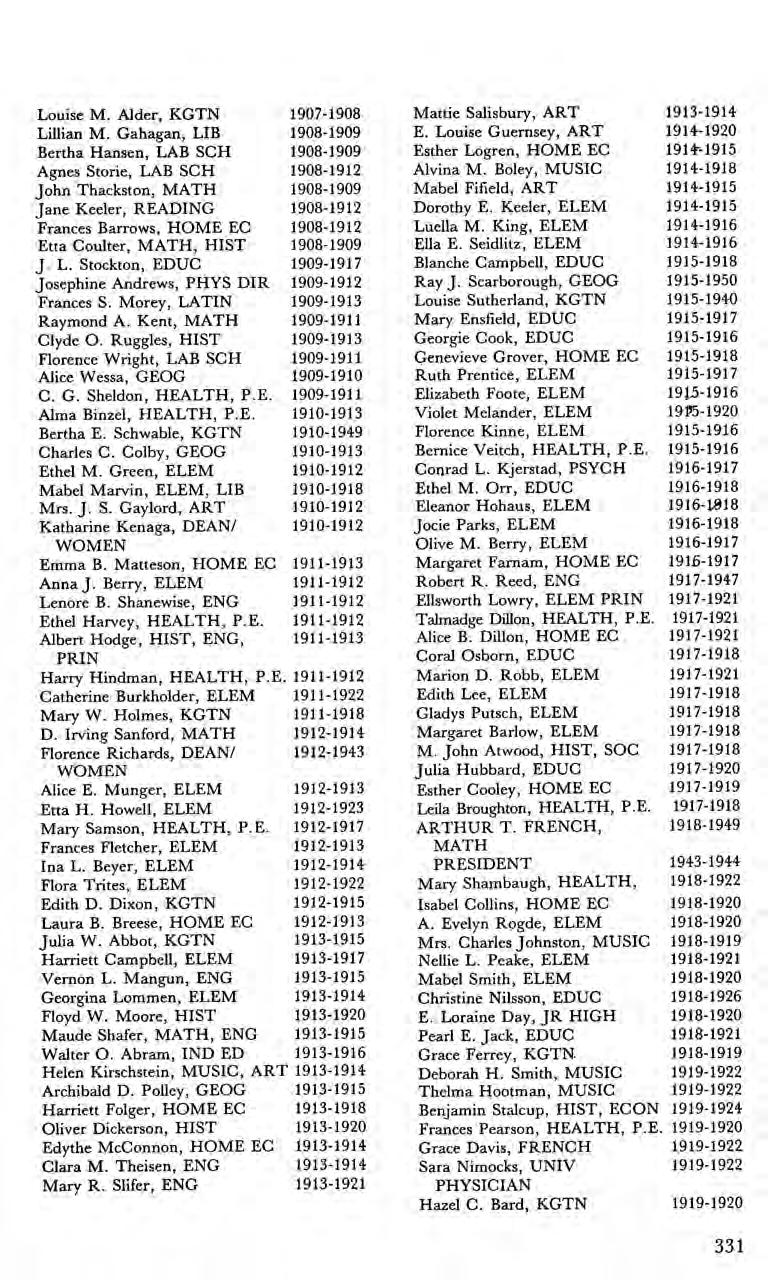
Louise M. Alder, KGTN
Lillian M. Gahagan, LIB
Bertha Hansen, LAB SCH
Agnes Storie, LAB SCH
John Thackston, MATH
Jane Keeler, READING
Frances Barrows, HOME EC
Etta Coulter, MATH, HIST
J. L. Stockton, EDUC
Josephine Andrews, PHYS DIR
Frances S. Morey, LATIN
Raymond A. Kent, MATH
Clyde O. Ruggles, HIST
Florence Wright, LAB SCH
Alice Wessa, GEOG
C. G. Sheldon, HEALTH, P.E.
Alma Binzel, HEALTH, P.E.
Bertha E. Schwable, KGTN
Charles C. Colby, GEOG
Ethel M. Green, ELEM
Mabel Marvin, ELEM, LIB
Mrs. J. 5. Gaylord, ART
Katharine Kenaga, DEAN/ WOMEN
Emma B. Matteson, HOME EC
Anna J. Berry, ELEM
Lenore B. Shanewise, ENG
Ethel Harvey, HEALTH, P.E.
Albert Hodge, HIST, ENG, PRIN
Harry Hindman, HEALTH, P.E.
Catherine Burkholder, ELEM
Mary W. Holmes, KGTN
D. Irving Sanford, MATH
Florence Richards, DEAN/ WOMEN
Alice E. Munger, ELEM
Etta H. Howell, ELEM
Mary Samson, HEALTH, P.E.
Frances Fletcher, ELEM
Ina L. Beyer, ELEM
Flora Trites, ELEM
Edith D. Dixon, KGTN
Laura B. Breese, HOME EC
Julia W. Abbot, KGTN
Harriett Campbell, ELEM
Vernon L. Mangun, ENG
Georgina Lommen, ELEM
Floyd W. Moore, HIST
Maude Shafer, MATH, ENG
Walter O. Abram, IND ED
Helen Kirschstein, MUSIC, ART
Archibald D. Polley, GEOG
Harriett Folger, HOME EC
Oliver Dickerson, HIST
Edythe McConnon, HOME EC
Clara M. Theisen, ENG
Mary R. Slifer, ENG
1907-1908
1908-1909
1908-1909
1908-1912
1908-1909
1908-1912
1908-1912
1908-1909
1909-1917
1909-1912
1909-1913
1909-1911
1909-1913
1909-1911
1909-1910
1909-1911
1910-1913
1910-1949
1910-1913
1910-1912
1910-1918
1910-1912
1910-1912
1911-1913
1911-1912
1911-1912
1911-1912
1911-1913
1911-1912
1911-1922
1911-1918
1912-1914
1912-1943
1912-1913
1912-1923
1912-1917
1912-1913
1912-1914
1912-1922
1912-1915
1912-1913
1913-1915
1913-1917
1913-1915
1913-1914
1913-1920
1913-1915
1913-1916
1913-1914
1913-1915
1913-1918
1913-1920
1913-1914
1913-1914
1913-1921
Mattie Salisbury, ART
E. Louise Guernsey, ART
Esther Logren, HOME EC
Alvina M. Boley, MUSIC
Mabel Fifield, ART
Dorothy E. Keeler, ELEM
Luella M. King, ELEM
Ella E. Seidlitz, ELEM
Blanche Campbell, EDUC
Ray J. Scarborough, GEOG
Louise Sutherland, KGTN
Mary Ensfield, EDUC
Georgie Cook, EDUC
Genevieve Grover, HOME EC
Ruth Prentice, ELEM
Elizabeth Foote, ELEM
Violet Melander, ELEM
Florence Kinne, ELEM
Bernice Veitch, HEALTH, P.E.
Conrad L. Kjerstad, PSYCH
Ethel M. Orr, EDUC
Eleanor Hohaus, ELEM
Jocie Parks, ELEM
Olive M. Berry, ELEM
Margaret Farnam, HOME EC
Robert R. Reed, ENG
Ellsworth Lowry, ELEMPRIN
Talmadge Dillon, HEALTH, P.E.
Alice B. Dillon, HOME EC
Coral Osborn, EDUC
Marion D. Robb, ELEM
Edith Lee, ELEM
Gladys Putsch, ELEM
Margaret Barlow, ELEM
M. John Atwood, HIST, SOC
Julia Hubbard, EDUC
Esther Cooley, HOME EC
Leila Broughton, HEALTH, P.E.
ARTHUR T. FRENCH, MATH
Mary Shambaugh, HEALTH,
Isabel Collins, HOME EC
A. Evelyn Rogde, ELEM
Mrs. Charles Johnston, MUSIC
Nellie L. Peake, ELEM
Mabel Smith, ELEM
Christine Nilsson, EDUC
E. Loraine Day, JR HIGH
Pearl E. Jack, EDUC
Grace Ferrey, KGTN.
Deborah H. Smith, MUSIC
Thelma Hootman, MUSIC
Benjamin Stalcup, HIST, ECON
Frances Pearson, HEALTH, P.E.
Grace Davis, FRENCH
Sara Nimocks, UNIV PHYSICIAN
Hazel C. Bard, KGTN
1913-1914
1914-1920
1914-1915
1914-1918
1914-1915
1914-1915
1914-1916
1914-1916
1915-1918
1915-1950
1915-1940
1915-1917
1915-1916
1915-1918
1915-1917
1915-1916
1995-1920
1915-1916
1915-1916
1916-1917
1916-1918
1916-1918
1916-1918
1916-1917
1916-1917
1917-1947
1917-1921
1917-1921
1917-1921
1917-1918
1917-1921
1917-1918
1917-1918
1917-1918
1917-1918
1917-1920
1917-1919
1917-1918
1918-1949
1943-1944
1918-1922
1918-1920
1918-1920
1918-1919
1918-1921
1918-1920
1918-1926
1918-1920
1918-1921
1918-1919
1919-1922
1919-1922
1919-1924
1919-1920
1919-1922
1919-1922
1919-1920

Helen Pritchard, REGISTRAR
Florence Kroeger, HOME EC
Walter L. Harris, SOC SCI
Martha Seeling, EDUC
Mildred Bartsch, EDUC
William A. Owens, PSYCH
Etta L. Davis, JR HIGH
Mrs. Lawrence Siewert, ELEM
Dorothy Coe, JR HIGH
Cornelia Fish, KGTN
Jessie Montgomery, EDUC
Ida N. Chambers, ART
Lillian L. Miller, EDUC
Pearle I. Mallory, ENG
William H. Burton, EDUC
Georgiana Hathaway, HOME EC
Alice B. Grannis, JR HIGH
Edgar Everts, HEALTH, P.E.
Agnes C. Loughlin, ENG
John W. Goddard, JR HIGH, Alice M. Peterson, ELEM
Mrs. Andre Dreux, FRENCH
Alice C. Brill, KGTN
Leslie Gage, EDUC
Ethel Parker, HOME EC
Dorothy Waterman, HEALTH, P.E.
Bernice E. Leary, JR HIGH
Naomi Wetzel, ELEM
Katherine Kennedy, ELEM
Etta Christensen, EDUC
Hazel Aldrich, EDUC
Mary McKay, MUSIC
Elberta Broadwell, MUSIC
A. Adalyne Artz, UNIV NURSE
Mrs. T. M. Cassidy, ART
Cyrus F. Jennings, IND ED
Angela L. Mensing, KGTN
Erwin Selle, SOCIOLOGY, GOVT
Martha Lewis, HEALTH, P.E.
Cecile Evans, LIB
Ferne Andrews Olson, MUSIC
Ruth Strickland, EDUC
Arnold Christensen, JR HIGH
Charles L. Simmers, EDUC
Beulah Brunner, EDUC
Walter Grimm, MUSIC
Lester K. Kirk, JR HIGH
Susan B. Davis, ENG
Ray Haberman, HEALTH, P.E.
Mrs. Charles Simmers, ENG
Grace Durrin, ENG
Genevieve Holcomb, HEALTH, P.E.
Janet Conklin, HEALTH, P.E.
O. Harry Gibson, HIST, GOVT
Adah E, Minard, ELEM
1919-1955
1920-1951
1920-1923
1920-1923
1920-1968
1920-1949
1920-1921
1920-1922
1920-1921
1920-1922
1920-1921
1920-1923
1920-1925
1920-1932
1921-1923
1921-1922
1921-1927
1921-1923
1921-1923
1921-1923
1921-1922
1922-1923
1922-1923
1922-1950
1922-1924
1922-1923
1922-1923
1922-1925
1922-1924
1922-1945
1922-1923
1922-1923
1922-1923
1922-1927
1923-1930
1923-1926
1923-1925
1923-1943
1923-1927
1923-1924
1923-1925
1923-1924
1923-1926
1923-1944
1923-1937
1923-1958
1923-1924
1923-1925
1923-1927
1923-1927
1923-1924
1923-1924
1924-1925
1924-1925
1924-1927
Vannita L. Wesely, LIB
Maria C. Ingberg, ELEM
Lucille Moritz, HOME EC
J. Lawrence Eason, ENG
Elizabeth Colwell, MUSIC
Muriel R. Meyer, MUSIC
Marguerite Stanton, LAB SCH
Jean Talbot, HEALTH, P.E.
Ruth Beth Watts, ENG
Natalie T. Huhn, LIB
Marion Hagler, KGTN
Maude Kavanagh, EDUC
Frederick Jederman, HIST
Mrs. F. A. Jederman, ELEM
Abbie B. Langmaid, ELEM
Edna J. Barnes, ELEM
Mildred L. Engstrom, LIB
Bernice Bryan, ELEM
Claire E. Harris, ELEM
Glenn E. Fishbaugher, EDUC
Mary F. Gregg, MUSIC
Willis Boots, ENG, PSYCH
Roland Torgerson, IND ED
Herbert Hess, SOC, GOVT
Mrs. Edwin Dahl, HOME EC
Florence McKinley, HEALTH, P.E.
Glendon Galligan, HEALTH, P.E.
Cora Ebert, JR HIGH
Louise Strohbehn, ELEM
Phila Humphreys, ELEM
Margaret Clark, LIB
Evelyn Ellingson, UNIV NURSE
Theodora Densmore, KGTN
Merle 8S. Adams, MUSIC
Helen Coleman, FRENCH
Evelyn Semling, KGTN
Valeta Jeffrey, MUSIC
Grace M. Muir, JR HIGH
Erna R. Stech, LIB
Fra Samuels, ELEM
Martha Dallman, ELEM
Cathryn Cramer, ELEM
Clara Stroud, ELEM
Florence Rasmussen, MUSIC
Dorothy Clark, ART
Viola M. Beery, HOME EC
Alice E. Washburn, ELEM
Ella C. Clark, EDUC
Minnie Zimmerman, LIB
Grace A. Selleck, ELEM
Margaret Browning, UNIV NURSE
Mrs. Inez Mattison, CHEM
Jeanne Brouillette, ELEM
Helen Pendergast, HEALTH, PLE.
1924-1927
1924-1929
1924-1926
1924-1925
1925-1926
1925-1929
1925-1926
1925-1962
1925-1932
1925-1927
1925-1927
1925-1929
1925-1960
1925-1926
1925-1929
1925-1928
1926-1949
1926-1929
1926-1927
1926-1966
1926-1928
1926-1952
1926-1936
1926-1927
1926-1927
1927-1931
1927-1948
1927-1929
1927-1931
1927-1929
1927-1929
1927-1929
1927-1929
1928-1929
1928-1932
1929-1935
1929-1943
1929-1934
1929-1930
1929-1930
1929-1940
1929-1946
1929-1930
1929-1930
1929-1937
1930-1934
1930-1931
1930-1944
1930-1949
1930-1933
1930-1969
1930-1932
1931-1947
1931-1937
Laura Opal Foster, ELEM 1931-1968
Janet R. Rohweder, MUSIC 1931-1934
Walter Rupp, IND ED 1931-1932
Jean Brady*Jones, ENG 1932-1936
NELS MINNE, CHEM, 1932-1970 PHYSICS, PRESIDENT 1944-1967
Roy Tozier, EDUC, SOC SCI 1932-1940
Stanley Pawelek, IND ED 1932-1941
Marion Davis, FRENCH 1932-1971
Floretta Murray, ART 1932-1976
Edna Justman, MUSIC 1932-1933
Agnes Bard, MUSIC 1933-1976
Ella Murphy, ENG 1934-1948
Earl Greene, HEALTH, P.E. 1934-1935
Jennie Lorenz, ENG 1934
Maurine Scovell, JR HIGH 1935-1937
Elizabeth McDowell, EDUC 1935-1936
Manley MacDonald, DEAN/ 1935-1945 MEN
Gladys Lynch, THEATRE ARTS 1936-1943
Marion Raymond, VP, DEAN 1936-1974
Harry Jackson, IND ED 1936-1969
Barbara Andrews, HEALTH, 1937-1945 P.E.
Everett Edstrom, MUSIC 1937-1938
Ethel Taylor, RURAL ED 1937-1942
Catherine Crossman, ART 1937-1945
Edna Leake, JR HIGH 1937-1940
Josephine Edstrom, KGTN 1939-1940
Blanid Redmond, MATH 1939-1940
O. MYKING MEHUS, 1939-1943 PRESIDENT
Charles Fisk, HEALTH, P.E. 1939-1946
Andrew Langum, MUSIC 1939-1945
Mady M. Ziegler, MUSIC 1939-1945
Amanda Aarestad, EDUC 1940-1975
John Biesanz, SOC SCI 1940-1945
Hugh Capron, IND ED 1940-1979
William Griffiths, HEALTH, 1940-1944 P.E.
Alice Hickey, UNIV NURSE 1940-1941
Verna Hoyman, EDUC 1940-1945
Beverly Martin, EDUC 1940-1941
Virginia Robb, HEALTH, P.E. 1940-1941
Marianna Irwin, EDUC 1941-1943
Nora Lewison, ENG 1941-1942
Lena Vangstad, RURAL ED 1942
José B. Acuna, SOC SCI 1942-1944
Olive Christiansen, UNIV 1942-1945 NURSE
Luther McCown, HEALTH, P.E. 1942-1973
Ruth Richards, HEALTH, P.E. 1943-1949
Frieda Grieder, DEAN/WOMEN 1943-1945
Dorothy Magnus, THEATRE 1943-1972 ARTS
Mabel Sampson, EDUC 1943-1944
Jessie Knapp, EDUC 1944-1945
Lewis G. Stone, EDUC
Michael Bambenek, HEALTH, P.E,
William Coppock, CHEM, MATH
Rose Strand Hilden, EDUC
Alice Hitchcock, EDUC
Donna Loughrey, EDUC
Helen Wardeberg, EDUC
Edward Davis, SOC STU
Pearle Landfair, EDUC
Otallia Stafford, UNIV NURSE
Lois Turner, MATH, DEAN/WOMEN
Laurena Beadle, EDUC
Anna Clute, EDUC, MUSIC
Robert Fiester, MUSIC
Blanch A. Graff, BIOL
Mildred Greene, EDUC
Mae Sweeney, EDUC
Laura Tarras, EDUC
Olaf Anfinson, PHYS SCI
Luther Arnold, CHEM
E. Frederic Bailey, BUS AD
Eugene Brodhagen, HEALTH, P.E.
Roger Busdicker, MUSIC
Jeanne Fry, MUSIC, ART
Patricia Giddings, MATH, SCI
Irene Harney, EDUC
Robert Hosokawa, ENG
Rudolph Lokensgard, MATH
Stella Pedersen, DEAN/WOMEN
Fred J. Raniele, SOC STU
Violet Steinbauer, SPANISH
Madeline Tews, MUSIC
William Verhage, COLLEGE DEAN
Melvin Wedul, EDUC, PLACEMENT
Marion Carmody, EDUC
Bernard Schultz, ENG
Harold Anderson, SCI, MATH
Mathew Barry, EDUC

1946-1947
1946-1947
1946-1948
1946-1947
1946-1947
1946-1970
1946-1948
1946-1949
1946-1947
1946-1947
1946-1947
1946-1977 1947 1947 1947-1950
1947-1976
H. W. F. Freudenthal, GERMAN 1947-1949
John Fuller, COLLEGE DEAN
Lillian Hammer, EDUC
Elsie Henning, EDUC
Fred Heyer, MUSIC
Mary Hiedermann, EDUC
Grace Hiler, ENG
Maurice Mariner, DEAN/MEN
Marjorie Monroe, MUSIC
Mary Murray, EDUG
Augusta Nelson, ENG, LIT
Shirley Ness, BUS AD
Virginia Richter, ART
Caroline Smart, HOME EC
1947-1968
1947-1949
1947-1948
1947-1972
1947-1948
1947-1950
1947-1974
1947-1950
1947-1948
1947-1976
1947-1951
1947-1949
1947-1948
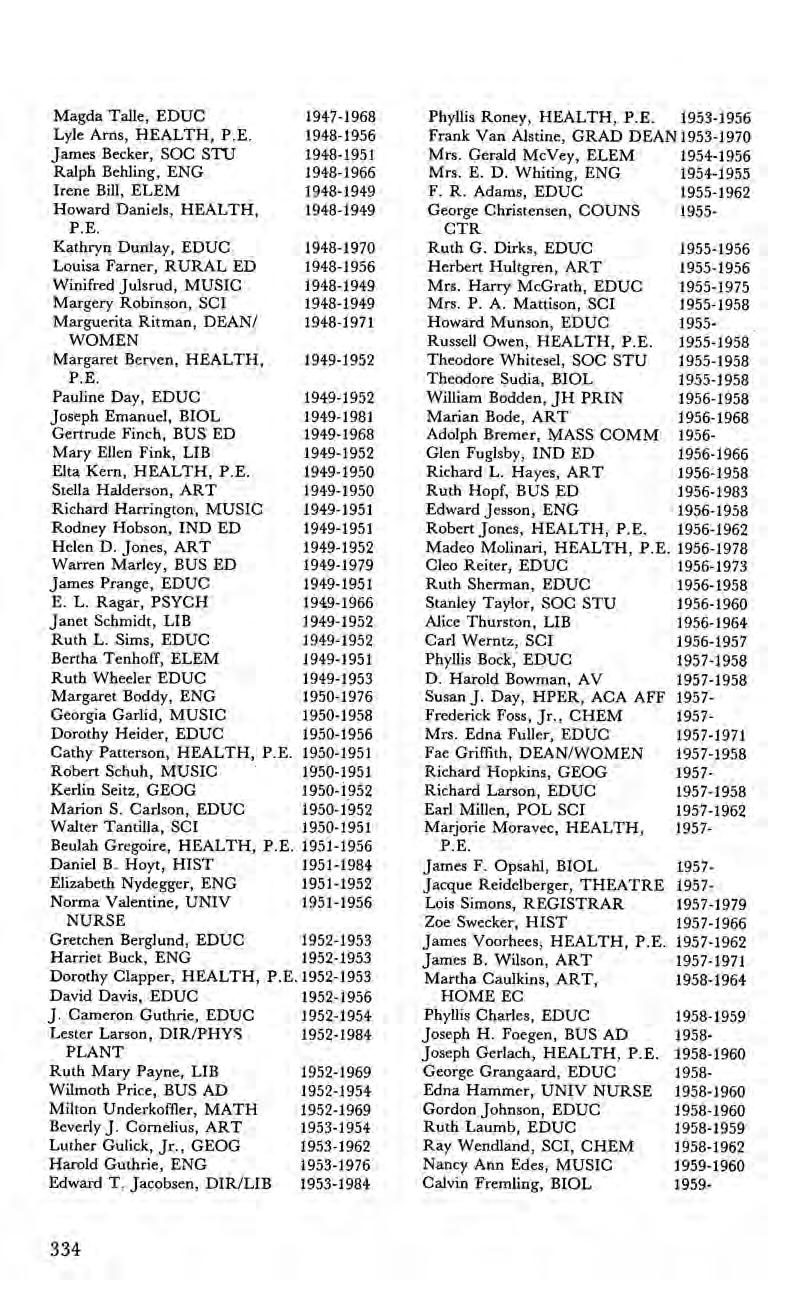
Magda Talle, EDUC
Lyle Arns, HEALTH, P.E.
James Becker, SOC STU
Ralph Behling, ENG
Irene Bill, ELEM
Howard Daniels, HEALTH, PLE.
Kathryn Dunlay, EDUC
Louisa Farner, RURAL ED
Winifred Julsrud, MUSIC
Margery Robinson, SCI
Marguerita Ritman, DEAN/ WOMEN
Margaret Berven, HEALTH, P.E.
Pauline Day, EDUC
Joseph Emanuel, BIOL
Gertrude Finch, BUS ED
Mary Ellen Fink, LIB
Elta Kern, HEALTH, P.E.
Stella Halderson, ART
Richard Harrington, MUSIC
Rodney Hobson, IND ED
Helen D. Jones, ART
Warren Marley, BUS ED
James Prange, EDUC
E. L. Ragar, PSYCH
Janet Schmidt, LIB
Ruth L. Sims, EDUC
Bertha Tenhoff, ELEM
Ruth Wheeler EDUC
Margaret Boddy, ENG
Georgia Garlid, MUSIC
Dorothy Heider, EDUC
Cathy Patterson, HEALTH, P.E.
Robert Schuh, MUSIC
Kerlin Seitz, GEOG
Marion S. Carlson, EDUC
Walter Tantilla, SCI
Beulah Gregoire, HEALTH, P.E.
Daniel B. Hoyt, HIST
Elizabeth Nydegger, ENG
Norma Valentine, UNIV NURSE
Gretchen Berglund, EDUC
Harriet Buck, ENG
Dorothy Clapper, HEALTH, P.E.
David Davis, EDUC
J. Cameron Guthrie, EDUC
Lester Larson, DIR/PHYS PLANT
Ruth Mary Payne, LIB
Wilmoth Price, BUS AD
Milton Underkoffler, MATH.
Beverly J. Cornelius, ART
Luther Gulick, Jr.,. GEOG
Harold Guthrie, ENG
Edward T. Jacobsen, DIR/LIB
1947-1968
1948-1956
1948-1951
1948-1966
1948-1949
1948-1949
1948-1970
1948-1956
1948-1949
1948-1949
1948-1971
1949-1952
1949-1952
1949-1981
1949-1968
1949-1952
1949-1950
1949-1950
1949-1951
1949-1951
1949-1952
1949-1979
1949-1951
1949-1966
1949-1952
1949-1952
1949-1951
1949-1953
1950-1976
1950-1958
1950-1956
1950-1951
1950-1951
1950-1952
1950-1952
1950-1951
1951-1956
1951-1984
1951-1952
1951-1956
1952-1953
1952-1953
1952-1953
1952-1956
1952-1954
1952-1984
1952-1969
1952-1954
1952-1969
1953-1954
1953-1962
1953-1976
1953-1984
Phyllis Roney, HEALTH, P.E. 1953-1956
Frank Van Alstine, GRAD DEAN 1953-1970
Mrs. Gerald McVey, ELEM
Mrs. E. D. Whiting, ENG
F. R. Adams, EDUC
George Christensen, COUNS CTR
Ruth G. Dirks, EDUC
Herbert Hultgren, ART
Mrs. Harry McGrath, EDUC
Mrs. P. A. Mattison, SCI
Howard Munson, EDUC
Russell Owen, HEALTH, P.E.
Theodore Whitesel, SOC STU
Theodore Sudia, BIOL
William Bodden, JH PRIN
Marian Bode, ART
Adolph Bremer, MASS COMM
Glen Fuglsby, IND ED
Richard L. Hayes, ART
Ruth Hopf, BUS ED
Edward Jesson, ENG
Robert Jones, HEALTH, P.E.
Madeo Molinari, HEALTH, P.E.
Cleo Reiter, EDUC
Ruth Sherman, EDUC
Stanley Taylor, SOC STU
Alice Thurston, LIB
Carl Werntz, SCI
Phyllis Bock, EDUC
D. Harold Bowman, AV
Susan J. Day, HPER, ACA AFF
Frederick Foss, Jr., GHEM
Mrs, Edna Fuller, EDUC
Fae Griffith, DEAN/WOMEN
Richard Hopkins, GEOG
Richard Larson, EDUC
Earl Millen, POL SCI
Marjorie Moravec, HEALTH, P.E.
James F. Opsahl, BIOL
Jacque Reidelberger, THEATRE
Lois Simons, REGISTRAR
Zoe Swecker, HIST
James Voorhees, HEALTH, P.E.
James B. Wilson, ART
Martha Caulkins, ART, HOME EC
Phyllis Charles, EDUC
Joseph H. Foegen, BUS AD
Joseph Gerlach, HEALTH, P.E.
George Grangaard, EDUC
Edna Hammer, UNIV NURSE
Gordon Johnson, EDUC
Ruth Laumb, EDUC
Ray Wendland, SCI, CHEM
Nancy Ann Edes, MUSIC
Calvin Fremling, BIOL
1954-1956
1954-1955
1955-1962
1955-
1955-1956
1955-1956
1955-1975
1955-1958
19551955-1958
1955-1958
1955-1958
1956-1958
1956-1968 19561956-1966
1956-1958 1956-1983
1956-1958
1956-1962
1956-1978 1956-1973
1956-1958
1956-1960
1956-1964
1956-1957 1957-1958
1957-1958
195719571957-1971
1957-1958
19571957-1958
1957-1962
1957195719571957-1979
1957-1966
1957-1962
1957-1971
1958-1964
1958-1959
19581958-1960
19581958-1960 1958-1960
1958-1959
1958-1962
1959-1960
1959-
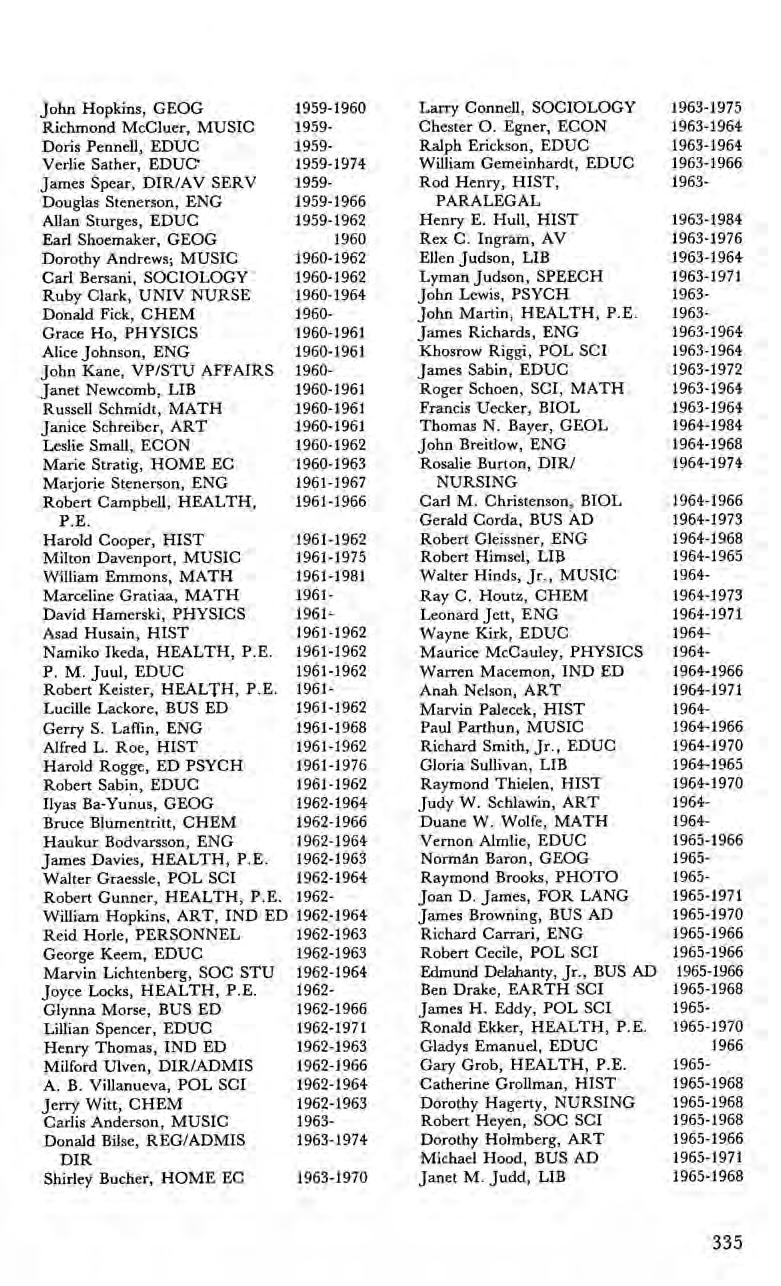
John Hopkins, GEOG
Richmond McCluer, MUSIC
Doris Pennell, EDUC
Verlie Sather, EDUC
James Spear, DIR/AV SERV
Douglas Stenerson, ENG
Allan Sturges, EDUC
Earl Shoemaker, GEOG
Dorothy Andrews, MUSIC
Carl Bersani, SOCIOLOGY
Ruby Clark, UNIV NURSE
Donald Fick, CHEM
Grace Ho, PHYSICS
Alice Johnson, ENG
John Kane, VP/STU AFFAIRS
Janet Newcomb, LIB
Russell Schmidt, MATH
Janice Schreiber, ART
Leslie Small, ECON
Marie Stratig, HOME EC
Marjorie Stenerson, ENG
Robert Campbell, HEALTH, P.E.
Harold Cooper, HIST
Milton Davenport, MUSIC
William Emmons, MATH
Marceline Gratiaa, MATH
David Hamerski, PHYSICS
Asad Husain, HIST
Namiko Ikeda, HEALTH, P.E.
P.M. Juul, EDUC
Robert Keister, HEALTH, P.E.
Lucille Lackore, BUS ED
Gerry S. Laffin, ENG
Alfred L. Roe, HIST
Harold Rogge, ED PSYCH
Robert Sabin, EDUC
Ilyas Ba-Yunus, GEOG
Bruce Blumentritt, CHEM
Haukur Bodvarsson, ENG
James Davies, HEALTH, P.E.
Walter Graessle, POL SCI
Robert Gunner, HEALTH, P.E.
William Hopkins, ART, IND ED
Reid Horle, PERSONNEL
George Keem, EDUC
Marvin Lichtenberg, SOG STU
Joyce Locks, HEALTH, P.E.
Glynna Morse, BUS ED
Lillian Spencer, EDUC
Henry Thomas, IND ED
Milford Ulven, DIR/ADMIS
A. B. Villanueva, POL SCI
Jerry Witt, CHEM
Carlis Anderson, MUSIC
Donald Bilse, REG/ADMIS
DIR
Shirley Bucher, HOME EC
1959-1960
1959-
19591959-1974
1959-
1959-1966
1959-1962
1960
1960-1962
1960-1962
1960-1964
1960-
1960-1961
1960-1961
1960-
1960-1961
1960-1961
1960-1961
1960-1962
1960-1963
1961-1967
1961-1966
1961-1962
1961-1975
1961-1981
1961-
19611961-1962
1961-1962
1961-1962
1961-
1961-1962
1961-1968
1961-1962
1961-1976
1961-1962
1962-1964
1962-1966
1962-1964
1962-1963
1962-1964
1962-
1962-1964
1962-1963
1962-1963
1962-1964
1962-
1962-1966
1962-1971
1962-1963
1962-1966
1962-1964
1962-1963
1963-
1963-1974
1963-1970
Larry Connell, SOCIOLOGY
Chester O. Egner, ECON
Ralph Erickson, EDUC
William Gemeinhardt, EDUC
Rod Henry, HIST, PARALEGAL
Henry E. Hull, HIST
Rex C. Ingram, AV
Ellen Judson, LIB
Lyman Judson, SPEECH
John Lewis, PSYCH
John Martin, HEALTH, P.E.
James Richards, ENG
Khosrow Riggi, POL SCI
James Sabin, EDUC
Roger Schoen, SCI, MATH
Francis Uecker, BIOL
Thomas N. Bayer, GEOL
John Breitlow, ENG
Rosalie Burton, DIR/ NURSING
Carl M. Christenson, BIOL
Gerald Corda, BUS AD
Robert Gleissner, ENG
Robert Himsel, LIB
Walter Hinds, Jr., MUSIC
Ray C. Houtz, CHEM
Leonard Jett, ENG
Wayne Kirk, EDUC
Maurice McCauley, PHYSICS
Warren Macemon, IND ED
Anah Nelson, ART
Marvin Palecek, HIST
Paul Parthun, MUSIC
Richard Smith, Jr., EDUC
Gloria Sullivan, LIB
Raymond Thielen, HIST
Judy W. Schlawin, ART
Duane W. Wolfe, MATH
Vernon Almlie, EDUC
Norman Baron, GEOG
Raymond Brooks, PHOTO
Joan D. James, FOR LANG
James Browning, BUS AD
Richard Carrari, ENG
Robert Cecile, POL SCI
Edmund Delahanty, Jr., BUS AD
Ben Drake, EARTH SCI
James H. Eddy, POL SCI
Ronald Ekker, HEALTH, P.E.
Gladys Emanuel, EDUC
Gary Grob, HEALTH, P.E.
Catherine Grollman, HIST
Dorothy Hagerty, NURSING
Robert Heyen, SOC SCI
Dorothy Holmberg, ART
Michael Hood, BUS AD
Janet M. Judd, LIB
1963-1975
1963-1964
1963-1964
1963-1966
1963-
1963-1984
1963-1976
1963-1964
1963-1971
196319631963-1964
1963-1964
1963-1972
1963-1964
1963-1964
1964-1984
1964-1968
1964-1974
1964-1966
1964-1973 1964-1968
1964-1965
19641964-1973
1964-1971
196419641964-1966
1964-1971
19641964-1966
1964-1970
1964-1965
1964-1970
196419641965-1966
196519651965-1971
1965-1970
1965-1966
1965-1966
1965-1966
1965-1968
19651965-1970 1966 19651965-1968
1965-1968
1965-1968
1965-1966
1965-1971
1965-1968 335
Leon King, LIB
Ronald Klocke, SOCIOLOGY
Lorraine Krenz, EDUC
Frederick Lauritsen, LIB
Louise Moberly, ART
Frederick Olson, MATH
Sandra Olson, MATH
Richard O’Rourke, BIOL
Muriel Palecek, ENG
Charlotte Reidelberger, ENG
Wayne A. Sanford, EDUC
Delores Schiller, NURSING
William Schmid, MUSIC
Esther Schmidt, EDUC
Janet Sheeran, ENG
LeRoy Stadler, HEALTH, P.E.
Irving Wallace, ENG
Arthur Wilke, SOC SCI
Sylvia Zastrow, SPEECH
Wayne Zook, IND ED
Dwight Anderson, BIOL
Charles Austad, PSYCH
Johannes Bjornhaug, BIOL
Brian Blakely, HIST
Marilyn Blesius, PSYCH SERV
Norm Doty, SOC WORKER
Everett Eiken, ED PSYCH
Shirley Eiken, BUS ED
Margaret Erickson, BIOL
Robert Fahey, BUS AD
Edith Franzen, MATH
John C. Gavan, CHEM
Charles Gill, PHYSICS
N. Anthony Gullickson, IND ED
Beatrice Heyen, SOC SCI
Ray S. Hibbs, BUS AD
Gloria Hippe, EDUC
Richard Hirtzell, POL SCI
William Hossick, PSYCH
Robert Hungerford, MUSIC
Vernell Jackels, PHYS SCI
Stanley Jessop, IND ED
Herbert Johnson, MATH
Theodore Kearly, HEALTH, P.E.
Leslie Kloempken, EDUC ADMIN
Paul Koprowski, SOC STU
Sandra Kottke, NURSING
Joan M. Kuzma, ENG
Charles Lane, SPEECH
Jean Lightfoot, PSYCH SERV
Gary Livermore, PSYCH
Henry J. Long, IND ED
Harry McArdle, MATH
Dennis McConville, ECON
W. Grant McKenzie, ART
Dwight Marston, DIR/MEN’S ATH
1965-1966
1965-1966
1965-1966
1965-1966
1965-1966
1965-1966
1965-
1965-
1965-1968
1965-1968
1965-
1965-
1965-1967
1965-1968
1965-1966
1965-1974
1965-1968
1965-1968
1965-1966
1965-1966
1966-
1966-1968
1966-1967
1966-1970
1966-1968
1966-1969
1966-
1966-
1966-1970
1966-1967
1966-1967
1966-1973
1966-1973
1966-1971
1966-1967
1966-1968
1966-1967
1966-1968
1966-1967
1966-
1966-1970
1966-1969
1966-
1966-1967
1966-1977
1966-1967
1966-1968
1966-1970
1966-1968
1966-1968
1966-1968
1966-1970
1966-1967
1966-1969
1966-
1966-
Larry D. Minock, GEOG
Joseph Motivans, SOCIOLOGY
Evelyn Nappe, NURSING
Wendell R. Nelson, ENG
Kenneth Patz, PSYCH SERV
Paul Rekstad, PSYCH SERV
Charles Romig, PSYCH SERV
Charlotte Santelman, EDUC
Wilfred Snyder, BIOL
Rhetta Speltz, FOR LANG
Joanne Sprenger, HEALTH, P.E.
Barry N. Stein, POL SCI
James Stevenson, POL SCI
1966-1969
1966-1967
1966-1968
1966-1968
1966-1968
1966-1969
1966-1968
1966-1971
1966-1971
1966-1973
1966-1969
1966-1968
1966-1968
Michael Stevenson, HEALTH, P.E.1966-1967
John Storck, PSYCH SERV
Lawrence Suid, HIST
Gerald Tobin, IND ED
R. Vande Veegaeta, PSYCH SERV
Edward Votruba, BUS AD
Gayle Tompkins, PSYCH SERV
Dorothy Wheeler, LIB
Richard Wilk, ENG
Charles Zane, DIR/STU UNION
ROBERT A. DUFRESNE, PRESIDENT DISTINGUISHED SERV PROF
Mary Frazier, SPEECH PATH
Thelma Kloempken, PSYCH SERV
Harold Knoll, ENG
P. R. Ohnstad, SCI
Betty Rogge, BUS ED
Eugene Sweasey, AV
Robert Tompkins, PSYCH SERV
Arthur Barsky, HIST
Archie Beighley, EDUC
Donald Bendel, ART
Jean Woodsend, DIR/HOUSING
Delores Auge, ENG
Ronald Butterfield, REGISTRAR
Glenn Carlson, EDUC
Roger Carlson, GEOG
Neale Deters, BIOL
Melvin Doner, BIOL
Rhoda Drake, BIOL
Wayne Erickson, EDUC
Robert Ferris, Jr., BUS AD
Jack L. Forrest, HIST
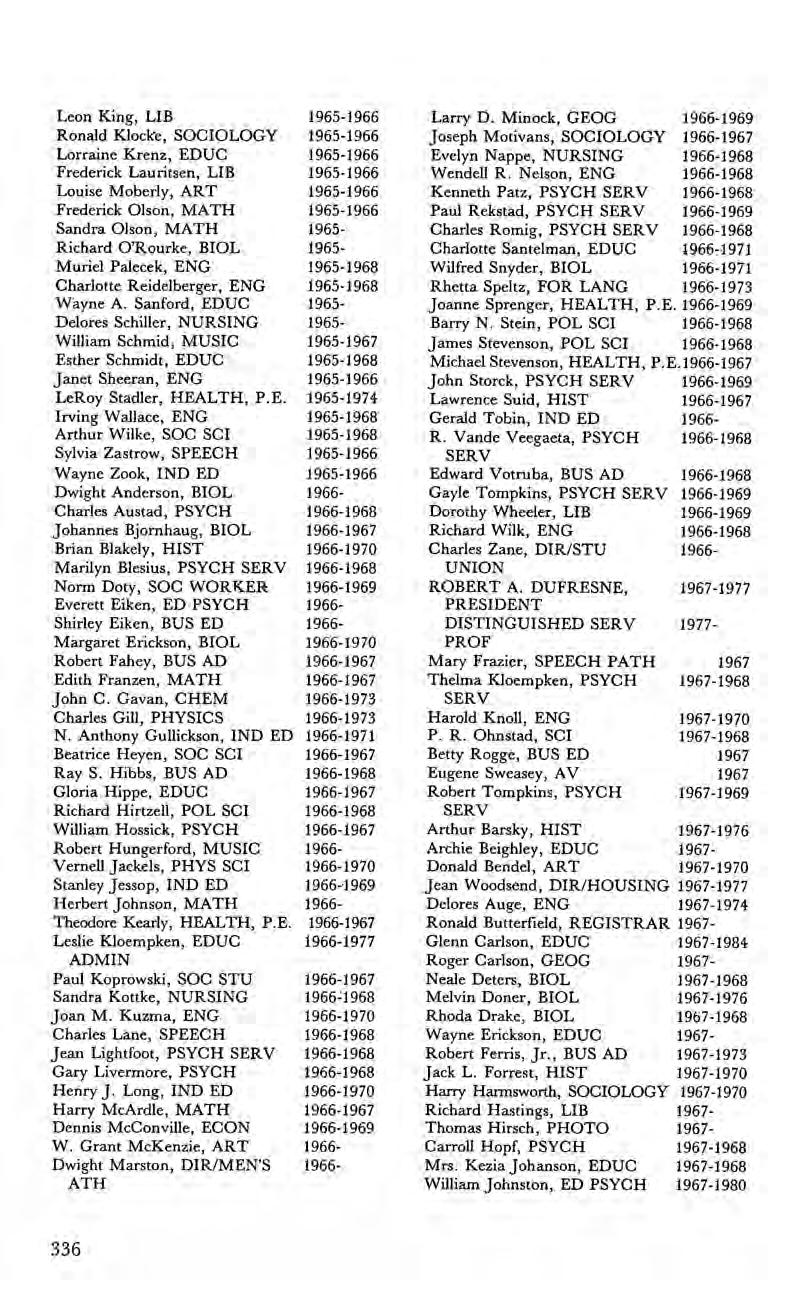
1966-1969
1966-1967 19661966-1968
1966-1968 1966-1969 1966-1969 1966-1968 19661967-1977
19771967 1967-1968
1967-1970 1967-1968 1967 1967 1967-1969 1967-1976 19671967-1970 1967-1977 1967-1974 19671967-1984 19671967-1968 1967-1976 1967-1968 19671967-1973 1967-1970
Harry Harmsworth, SOCIOLOGY 1967-1970
Richard Hastings, LIB
Thomas Hirsch, PHOTO
Carroll Hopf, PSYCH
Mrs. Kezia Johanson, EDUC
William Johnston, ED PSYCH
196719671967-1968 1967-1968 1967-1980
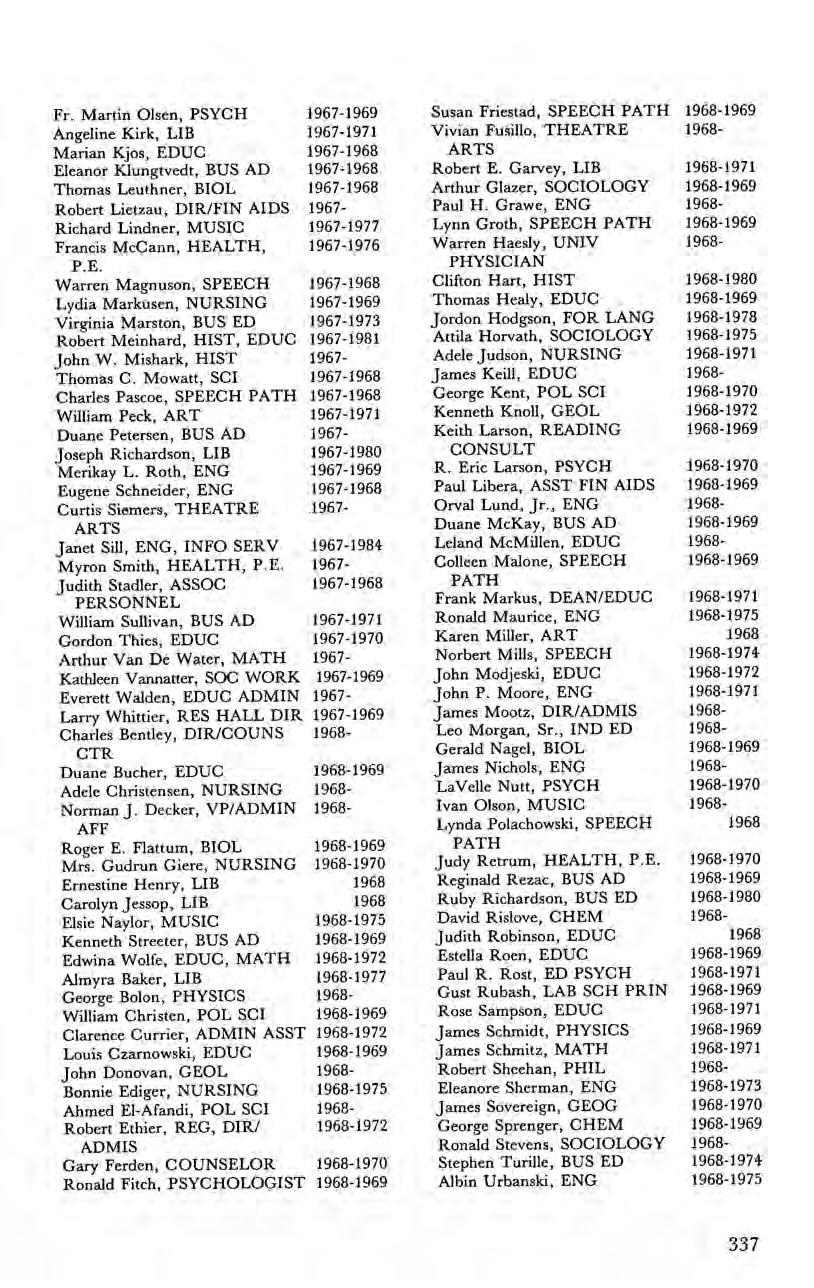
Fr. Martin Olsen, PSYCH
Angeline Kirk, LIB
Marian Kjos, EDUC
Eleanor Klungtvedt, BUS AD
Thomas Leuthner, BIOL
Robert Lietzau, DIR/FIN AIDS
Richard Lindner, MUSIC
Francis McCann, HEALTH, P.E.
Warren Magnuson, SPEECH
Lydia Markusen, NURSING
Virginia Marston, BUS ED
Robert Meinhard, HIST, EDUC
John W. Mishark, HIST
Thomas C. Mowatt, SCI
Charles Pascoe, SPEECH PATH
William Peck, ART
Duane Petersen, BUS AD
Joseph Richardson, LIB
Merikay L. Roth, ENG
Eugene Schneider, ENG
Curtis Siemers, THEATRE ARTS
Janet Sill, ENG, INFO SERV
Myron Smith, HEALTH, P.E.
Judith Stadler, ASSOC PERSONNEL
William Sullivan, BUS AD
Gordon Thies, EDUC
Arthur Van De Water, MATH
Kathleen Vannatter, SOC WORK
Everett Walden, EDUC ADMIN
Larry Whittier, RES HALL DIR
Charles Bentley, DIR/COUNS CTR
Duane Bucher, EDUC
Adele Christensen, NURSING
Norman J. Decker, VP/ADMIN AFF
Roger E. Flattum, BIOL
Mrs. Gudrun Giere, NURSING
Ernestine Henry, LIB
Carolyn Jessop, LIB
Elsie Naylor, MUSIC
Kenneth Streeter, BUS AD
Edwina Wolfe, EDUC, MATH
Almyra Baker, LIB
George Bolon, PHYSICS
William Christen, POL SCI
Clarence Currier, ADMIN ASST
Louis Czarnowski, EDUC
John Donovan, GEOL
Bonnie Ediger, NURSING
Ahmed El-Afandi, POL SCI
Robert Ethier, REG, DIR/ ADMIS
Gary Ferden, COUNSELOR
Ronald Fitch, PSYCHOLOGIST
1967-1969
1967-1971
1967-1968
1967-1968
1967-1968
1967-
1967-1977
1967-1976
1967-1968
1967-1969
1967-1973
1967-1981
1967-
1967-1968
1967-1968
1967-1971
1967-
1967-1980
1967-1969
1967-1968
1967-
1967-1984
19671967-1968
1967-1971
1967-1970
1967-
1967-1969
1967-
1967-1969
1968-
1968-1969
1968-
1968-
1968-1969
1968-1970
1968
1968
1968-1975
1968-1969
1968-1972
1968-1977
1968-
1968-1969
1968-1972
1968-1969
1968-
1968-1975
1968-
1968-1972
1968-1970
1968-1969
Susan Friestad, SPEECH PATH 1968-1969
Vivian Fusillo, THEATRE ARTS
Robert E. Garvey, LIB
Arthur Glazer, SOCIOLOGY
Paul H. Grawe, ENG
Lynn Groth, SPEECH PATH
Warren Haesly, UNIV PHYSICIAN
Clifton Hart, HIST
Thomas Healy, EDUC
Jordon Hodgson, FOR LANG
Attila Horvath, SOCIOLOGY
Adele Judson, NURSING
James Keill, EDUC
George Kent, POL SCI
Kenneth Knoll, GEOL
Keith Larson, READING CONSULT
R. Eric Larson, PSYCH
Paul Libera, ASST FIN AIDS
Orval Lund, Jr., ENG
Duane McKay, BUS AD
Leland McMillen, EDUC
Colleen Malone, SPEECH PATH
Frank Markus, DEAN/EDUC
Ronald Maurice, ENG
Karen Miller, ART
Norbert Mills, SPEECH
John Modjeski, EDUC
John P. Moore, ENG
James Mootz, DIR/ADMIS
Leo Morgan, Sr., IND ED
Gerald Nagel, BIOL
James Nichols, ENG
LaVelle Nutt, PSYCH
Ivan Olson, MUSIC
Lynda Polachowski, SPEECH PATH
Judy Retrum, HEALTH, P.E.
Reginald Rezac, BUS AD
Ruby Richardson, BUS ED
David Rislove, CHEM
Judith Robinson, EDUC
Estella Roen, EDUC
Paul R. Rost, ED PSYCH
Gust Rubash, LAB SCH PRIN
Rose Sampson, EDUC
James Schmidt, PHYSICS
James Schmitz, MATH
Robert Sheehan, PHIL
Eleanore Sherman, ENG
James Sovereign, GEOG
George Sprenger, CHEM
Ronald Stevens, SOCIOLOGY
Stephen Turille, BUS ED
Albin Urbanski, ENG
19681968-1971 1968-1969 19681968-1969 19681968-1980 1968-1969 1968-1978 1968-1975 1968-1971 19681968-1970 1968-1972 1968-1969
1968-1970 1968-1969 19681968-1969 19681968-1969
1968-1971 1968-1975 1968 1968-1974 1968-1972
1968-1971 196819681968-1969 19681968-1970 19681968 1968-1970 1968-1969 1968-1980 19681968 1968-1969 1968-1971 1968-1969 1968-1971 1968-1969 1968-1971 19681968-1973 1968-1970 1968-1969 19681968-1974 1968-1975
Henry Van Kirk, ED PSYCH
James Wagner, PUBLICATIONS
Sarah Walter, ENG
Donald Warner, VP/ACA AFF
Dan Willson, DEAN/ARTS & SCI
Robert K. Wilson, LIB
Marlys J. Youngck, LIB
Urban Bergsten, EDUC
Jana Brox, SPEECH PATH
Eleanore O'Meara, NURSING
Frances Rowan, NURSING
Ray Amundson, ASST to PRES
Mary M. Barnett, LIB SCI
Richard Behnke, HEALTH, P.E.
Audrey Berndt, LIB
Marvin Davis, AV
Emilio DeGrazia, ENG
Glenn Dukes, IND. ED.
Lavonne Fiereck, HEALTH, P.E.
David Forsythe, DIR/COMP SERV
Otto J. Frank, EDUC ADMIN
Harry J. C. Hill, ENG
Carolyn Hines, NURSING
Daniel Kieselhorst, POL SCI
Florence Mauro, UNION PROG ADV
Donald K. Moely, MUSIC
Richard Newgren, BUS AD
Hosea Perry, SOCIOLOGY
Richard Poepple, ART
Judith Pope, EDUC
Wayne Purtzer, IND ED
Maury Rabinowitz, BUS AD
James Reynolds, SOCIOLOGY
Marvin Rouse, FIN AIDS
James Rusco, HOUSING
David Ruzek, EDUC
Barbara Stiska, EDUC
Warren Stiska, IND ED
Melvin Sundby, ART
Robert Tetzloff, BUS AD
Harold A. Tye, ADMISSIONS
David Weiler, BUS AD
Derrell White, BIOL
Marvin Wolfmeyer, BUS AD
Pamela Wolfmeyer, BUS AD
George Bates, Jr., HIST
Dorothy McBride, EDUC
Bernadine Rowan, NURSING
Margaret Welch, NURSING
Robert A. Bauman, AV
Ervin Bublitz, SOCIOLOGY
John Burros, FACILITIES MGMT
19681968-1972
1968-1970
1968-1977
1968-
1968-
1968-
1969-1970
1969
1969-1975
1969-1975
1969-1979
1969-1974
1969-
1969-
1969-1970
1969-
1969-
1969-
1969-
1969-
1969-1970
1969-
1969-1973
1969-1972
1969-1971
1969-1970
1969-
1969-1970
1969
1969-
1969-1970
1969-
1969-1974
1969-1970
1969-1970
1969-1970
1969-1970
1969-1970
1969-1970
1969-1984
1969-1973
1969-
1969-
1969-
1970-1981
1970
1970
1970-1975
1970-1973
1970-
1970-
Seymour Byman, HIST
Pauline Christensen, REG CAMPUS
B. Kent Cowgill, ENG
Donald Cramer, IND ED
Robert Envick, IND ED
Ronald Flint, PSYCH
Judy Gernander, BUS AD
James B. Goke, IND ED
Robin A. Grawe, ENG
William Hanlon, BUS AD
Harold Heckart; MATH
Joellyn Howell, EDUC
Gordon Jasperson, RES HALL DIR
Rees M. Johnson, Jr., ELEM
Eldon Koplin, EDUC
Sue Ann Mullen, HEALTH, P.E.
Dorothy McBride, EDUC
Elizabeth Maliszewski, EDUC
Charles Meyer, POL SCI
Frank P. Morello, POL SCI
Dennis N. Nielsen, GEOL
Douglas Norland, BUS AD
A. C. Nydegger, BUS AD
William F. Palzer, LIB
Warren H. Puhl, CHEM
Robert W. Raz, ENG
William Reynolds, HEALTH, P.E.
Richard Schaber, BOOKSTORE MGR
Theresa Schulz, ENG
Mary L. Schwager, EDUC
Gerd Schwendenwein, GEOG
Henry K. Shearer, GEOG
John C. Shields, PSYCH
Norman Sobiesk, HIST
Barbara Sorenson, ART
Richard Sovinec, MUSIC
Robert Tritz, DIR/PUB INFO
Paul L. Tucker, PSYCH
Stephen Twenge, ASST REG
John Vermeulen, DIR/LAB SCH
Edna Wlodkowski, NURSING
Leslie Wothke, HEALTH, P.E.
Sherman Toensing, IND ED
Ronald Zwonitzer, BIOL
Marion Anderson, BUS ED
Elaine Baron, NURSING
Ollie Belcher, EDUC
James Bromeland, POL SCI
Gary Bunce, MATH
John Cleveland, ED PSYCH
Richard Davis, PUBLICATIONS
Marjorie Dorner, ENG
Mary Ann Dressel, CHEM
William Floyd, HEALTH, P.E.
19701970-
197019701970-1972
1970-1977
1970-
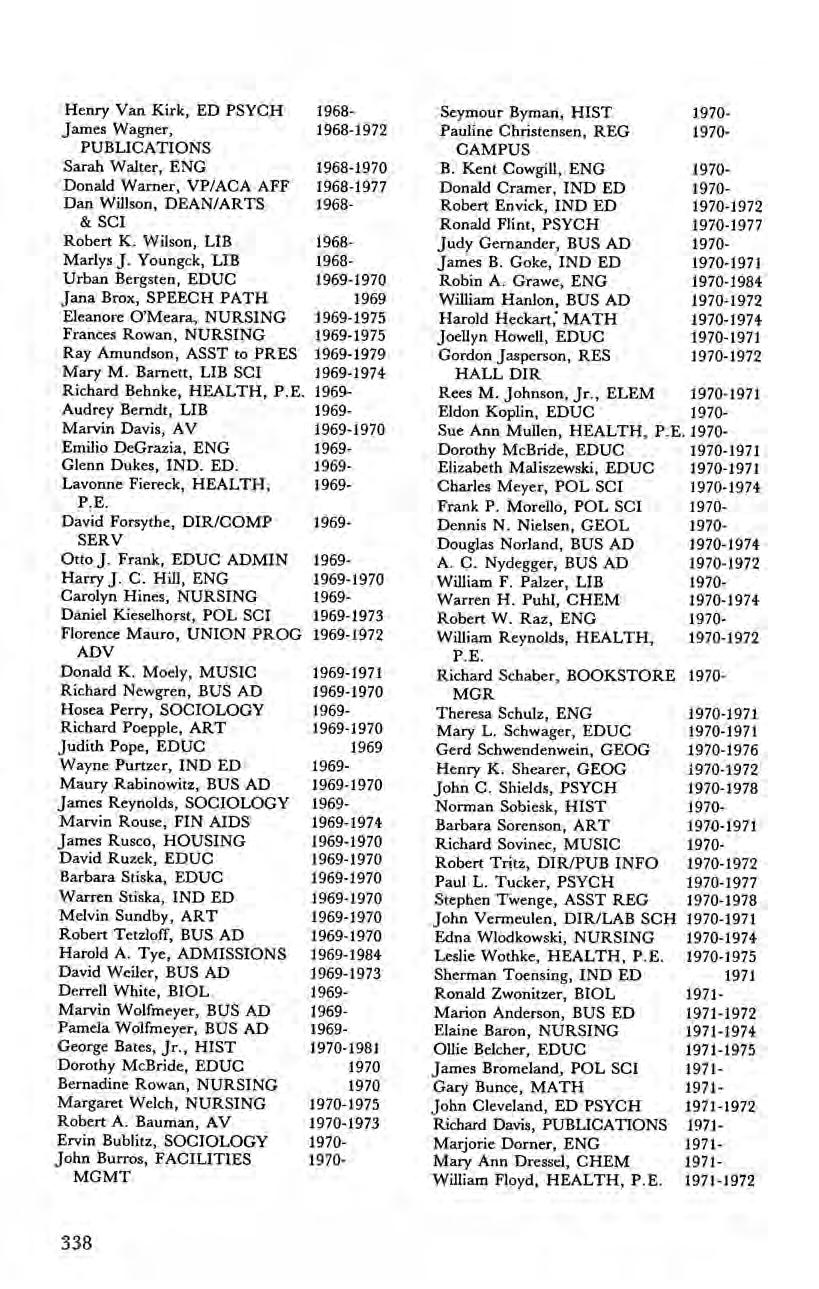
1970-1972
1970-1978
19701970-1971 19701970-1972 1970-1977 1970-1978
1970-1971
1970-1974
1970-1975 1971 19711971-1972 1971-1974
1971-1975
197119711971-1972
1971197119711971-1972

William Franzen, MATH
David E. Giannasi, BIOL
David S. Gross, ENG
Robert W. Hahn, BUS AD
Richard Harper, ED PSYCH
Marjorie P. Haugen, LIB
Joy A. Holm, ART
Terry Markos, INTL STUDENTS
John Michalowski, PRINT SHOP
Richard L, Miller, ART
Patricia A. Nolte, LIB
Mickey Olson, HEALTH, P.E.
Thomas Papacek, BUS AD
John E. Pfitzer, AV
Elizabeth Raab, FOR LANG
Anthony Reynolds, GEOG
Jack Rhodes, HEALTH, P.E.
Eugene Ridings, Jr. HIST
Mary Rieder, BUS AD
David Robinson, ENG
William Schaefer, EDUC
Paul Schell, AV
Karen Shogren, NURSING
Jacob Steigerwald, FOR LANG
Lynn Theurer, NURSING
Virginia Vint, ART
Gerald Watson, POL SCI
Brice Wilkinson, THEATRE ARTS
Kermit Almos, STU AFF COUNS
Gene Anderson, MUSIC
Gaye Bennes, MUSIC
Leland Bjorklund, ART
Stephen Clark, BIOL
Edwin Clemmer, ART
Betty Darby, NURSING
Charles Dietrick, FOR LANG
Pamela Folk, SOCIOLOGY
Sharon Fruetel, EXT STUDIES
Gerald E. Gannon, MATH
Michael Gieske, BUS AD
Lawrence Green, ED PSYCH
James Kern, ED PSYCH
Annabelle Korda, BIOL
Paul Kuchenmeister, IND ED
Wesley Matson, ED ADMIN
Hugh Ouellette, MATH
Shyamala Rajender, CHEM
Frank Rocco, DIR/SPEC ED
Emalou Roth, EXT STUDIES
Terry L. Schwarze, AV
Jerome Varner, UNIV MGMT OFF
Lorene Wedeking, NURSING
David Fries, CHEM
Richard Beck, IND ED
19711971-1972
1971-1973
1971-1972
1971-1972
1971-1981
1971-1975
1971-
1971-
1971-1972
1971-1973
1971-1973
1971-1973
1971-1977
1971-1972
1971-1972
1971-1974
1971-
1971-
1971-
1971-1973
1971-1974
1971-1974
1971-
1971-1975
1971-
1971-1972
1971-
1972-1973
1972-1975
1972-1973
1972
1972-1974
1972-1974
1972-
1972-1974
1972-1975
1972-1976
1972-1973
1972-
1972
1972-1979
1972
1972-1973
1972-
1972-
1972-1973
1972-
1972-1977
1972-
1972-
1972-1975
1973
1973-1976
Beryl Byman, EXT STUDIES 1973-1978
G. Howard Clark, BUS AD 1973-1976
Marilyn Foss, EXT STUDIES 1973-1978
Karen Gleason, NURSING 1973-1976
Ronald Greenwood, BUS AD 1973-1975
Marion Hopkins, REG CAMPUS __1973Rosemary Hurst, EDUC 1973-1974
Thomas Lee, Jr. BUS AD 1973-
Shirley Polejewski, BUS AD 1973-1976
Martha Roberson, RESOURCE 1973-1974 CTR
Steven Samuels, SPEECH 1973-1974
Margaret Scanlan, EXT STUDIES1973-1975
Richard Schumacher, DIR/VET 1973-1974 AFF
R. Stephen Schwartz, 1973SOCIOLOGY
Richard Shields, PHYSICS 1973Robert Simonson, BUS AD 1973-1974
Stephen Smith, BUS AD 1973-1975
Charlotte Tripp, NURSING 1973jill C. Tye, BUS ED 1973-1974
Carol Beeston, NURSING 1974-1975
Emilie Berkenpas, RES HALL ~—1974-1975 DIR
David Dapkus, BIOL 1974James Erickson, REG CAMPUS 1974Charles F. Evans, ART 1974-1980
John Ferden, DIR/HOUSING 1974-
Janie Gordon, ADMIS COUNS = 1974-1976
Donald Hunter, BUS AD 1974Larry Larson, ASST REG 1974-1975
Peter Lehrer, RES HALL DIR = 1974-1975
David Lejk, PERSONNEL 1974-1979
Walter McCormick, THEATER 1974-1979 ARTS
Norma CG. McGeoch, EDUC 1974-1976
Randolph Miller, HEALTH, P.E. 1974Gretchen Mooningham, 1974-1977 PHYSICS
John Mooningham, 1974-1977 EXT STUDIES
Dale C. Pedersen, AV 1974-1977
Nancy Robinson, COUNS CTR = 1974-1976
John Scanlan, Jr., EXT STUDIES1974-1975
Richard Schneider, BUS AD 1974Carol Spaag, NURSING 1974-1977
Frank Conroy, HEALTH, P.E. 1975-1978
Veronica Decker, NURSING 1975-1978
Grace Deloughery, NURSING = 1975-1977
Karen Fitzpatrick, EDUC 1975-1976
Dennis Martin, ASSOC REG 1975Diane Dingfelder, STU AFF 1975-1981
Norma Dison, NURSING 1975Ben R. Hix, HPER, BUS AD 1975-1978
Gary Janikowski, DIR/ 1975PERSONNEL
Stephen Juaire, HEALTH, P.E. 1975-
Wallace N. Johnson, ART
Victoria Keller, NURSING
Betty Rehn, NURSING
Ann Sawyer, NURSING
Nancy Piper, BIOL
Carl A. Rose, EDUC
Donald Salyards, BUS AD
Joanne Stejskal, NURSING
Janet Wilke, NURSING
Sandra Wunderlich, NURSING
Peggy Yost, RES HAL DIR
Brian Aldrich, SOCIOLOGY
Therese Barrett, ADMIS COUNS
Lawrence Bengston, VET AFFAIRS
Sandra Bennett, ENG
Jean Billman, EDUC
Danning Bloom, PHYSICS
Eric Bodelson, NURSING
Patricia Bodelson, NURSING
David Bratt, THEATRE ARTS
Lois Bueler, ENG
Douglas Delano, IND ED
Wayne Dunbar, CHEM
Thomas Eitter, HEALTH, P.E.
1975-1979
1975-1977
19751975-1980
1975-1981
1975-1977
1975-
1975-
1975-
1975-1980
1975-1977
1976-
1976-1980
1976-1978
1976-
1976-
1976-
1976-1977
1976-1977
1976-
1976-1980
1976-1981
19761976-1980
Mickey Ellenbecker, SOCIOLOGY 1976-
Denman Gerstung, MUSIC
Cynthia Hauwiller, NURSING
Clare Jarvis, BUS AD
Carol Jefferson, BIOL
Marcia Justic, NURSING
Lynn Kaehler, COUNS CTR
Raymond Kiihne, ART
Kay Luinstra, ASST REG
Patricia Midboe, NURSING
Roy Nasstrom, EDUC ADMIN
Romelle Pier, BUS AD
Sandra Roraff, ASST/FIN AID
Ronald Salzberger, PHIL
Leodegario Soriano, PSYCH
Clayton Walker, BUS AD
Janie Wimberly, SOCIOLOGY
ROBERT A. HANSON, PRESIDENT
Judy A. Appelt GEOG
Virginia Buchli, EXT STUDIES
Ted Cudnick, RES HALL DIR
Donald English, BUS AD
Pat Finley, NURSING
John Fisk, AV
Ruth Forsythe, ENG
Annette Horton, NURSING
Michael Meeker, ENG
Lee Mendyk, MUSIC
Florence Nelson, NURSING
Lyelle Palmer, EDUC
Carol Smith, NURSING
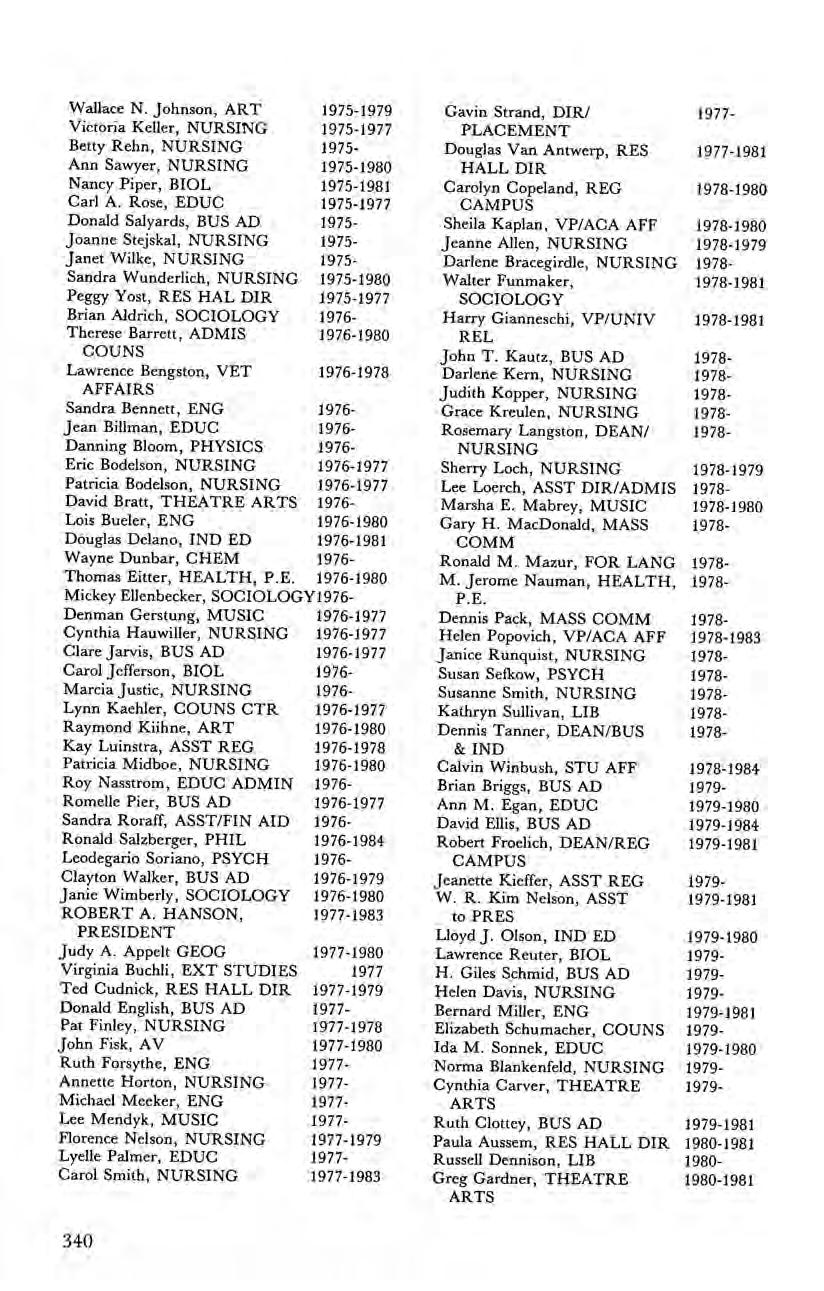
1976-1977
1976-1977
1976-1977
1976-
1976-
1976-1977
1976-1980
1976-1978
1976-1980
1976-
1976-1977
1976-
1976-1984
1976-
1976-1979
1976-1980
1977-1983
1977-1980
1977
1977-1979
1977-
1977-1978
1977-1980
1977-
1977-
1977-
1977-
1977-1979
1977-
1977-1983
Gavin Strand, DIR/ PLACEMENT
Douglas Van Antwerp, RES HALL DIR
Carolyn Copeland, REG CAMPUS
Sheila Kaplan, VP/ACA AFF
Jeanne Allen, NURSING
Darlene Bracegirdle, NURSING
Walter Funmaker, SOCIOLOGY
Harry Gianneschi, VP/UNIV REL
John T. Kautz, BUS AD
Darlene Kern, NURSING
Judith Kopper, NURSING
Grace Kreulen, NURSING
Rosemary Langston, DEAN/ NURSING
Sherry Loch, NURSING
Lee Loerch, ASST DIR/ADMIS
Marsha E. Mabrey, MUSIC
Gary H. MacDonald, MASS COMM
Ronald M. Mazur, FOR LANG
M. Jerome Nauman, HEALTH, P.E.
Dennis Pack, MASS COMM
Helen Popovich, VP/ACA AFF
Janice Runquist, NURSING
Susan Sefkow, PSYCH
Susanne Smith, NURSING
Kathryn Sullivan, LIB
Dennis Tanner, DEAN/BUS & IND
Calvin Winbush, STU AFF
Brian Briggs, BUS AD
Ann M. Egan, EDUC
David Ellis, BUS AD
Robert Froelich, DEAN/REG CAMPUS
Jeanette Kieffer, ASST REG
W. R. Kim Nelson, ASST to PRES
Lloyd J. Olson, IND ED
Lawrence Reuter, BIOL H. Giles Schmid, BUS AD
Helen Davis, NURSING
Bernard Miller, ENG
Elizabeth Schumacher, COUNS
Ida M. Sonnek, EDUC
Norma Blankenfeld, NURSING
Cynthia Carver, THEATRE ARTS
Ruth Clottey, BUS AD
Paula Aussem, RES HALL DIR
Russell Dennison, LIB
Greg Gardner, THEATRE ARTS
1978197819781978-
19781978-1980 19781978197819781978-1983 197819781978197819781978-1984 19791979-1980 1979-1984 1979-1981 19791979-1981 1979-1980 1979197919791979-1981 19791979-1980 197919791979-1981 1980-1981 19801980-1981
Kenneth Gorman, BUS ED
Timothy Hatfield, COUNS ED
Susan Kallestad, EDUC
Robert King, MUSIC
Maj. Russell Lohmann, MIL SCI
Michael Martin, MASS COMM
James Meyers, GEOL
Gayle Olsen, NURSING
Scott Peak, ASST DIR/ HOUSING
Rill Ann Reuter, MATH
Robert Ries, BUS AD
Kristi Ruttle, PSYCH
Paula Scheevel, RES HALL DIR
Thomas Sternal, ART
Pat Tolmie-Frisby, SPEC SERVICES
Patricia Thompson, NURSING
Mark Young, BUS AD
Janice Andrews, SOCIOLOGY
Joell Bjorke, BUS AD
David Ferris, REG CAMPUS
Robert Guthrie, ENG
Robert Hayden, MATH
Frederick Ihrke, BUS AD
Kathleen A. Kane, ENG
Betty Kelley, HEALTH, P.E.
Jonathon Lawson, DEAN/LIB ARTS
Louise Loftness, NURSING
Capt. Ronald Miller, MIL SCI
Susan Rickey THEATRE ARTS
Don Schmidlapp, ART
Paul Schollmeier, PHIL
Christina Thomas, SPEC SERVICES
John H. Vivian, MASS COMM
Helen A. Voigt, NURSING
David Weldon, MATH
Linda Wood, ASST DIR/DEV
J. Lawrence Bergin, BUS AD
Wendell Jahnke, VP/ UNIV REL
Christianne Keiper, NURSING
Holly Landauer, ADMIS COUNS
Eugene Lundak, MATH
Ann Nichols, ENG
Mary Jo Welhaven, NURSING
Michael Bozonie, MATH
Roberta Bumann, NURSING
Ajit Daniel, MASS COMM
Joanne Landers, ASST REG
Marjorie Larison, SM BUS DEV
Sang-Ho Lee, BUS AD
19801980-
1980-1981
1980-
1980-1981
1980-1981
1980-
1980-
1980-
1980-
1980-1981
1980-
1980-
1980-1984
1980-
19801980-
1981-
1981-
1981-1983
1981 198119811981
19811981-1984
1981 19811981
19811981-1984
1981-
19811981
1981-1984
19811981-
1981-1983
19811981-1983
1981-1983
1981-
1981-
19821982-1983
1982-
19821982-1984
1982-1983
Christine Nauman, ADMIS COUNS
Captain Robert Seal, MIL SCI
Bonnie Sue Smith, BUS ED
David K. Urion, MATH
Kerry G. Williams, PSYCH
Brian Barker, IND ED
John O. Bremer, ENG
Ruth Davis, ENG
Paul Findorff, BUS AD
Christine Glenski, NURSING
Darryl Hattenhauer, ENG
Deborah Leuchovious, ART
Kathleen McNellis, THEATRE ARTS
Nola M. Smith, EDUC
Walter Steiner, BUS AD
Timothy Turner, BUS AD
Kerry Williams, PSYCH
THOMAS F. STARK, PRESIDENT
Major James Taylor, MIL SCI
Jeff Baker, ADMIS COUNS
Larry Basenshpiler, MATH
Amy Caucutt, BUS AD
Gerald Cichanowski, COMP SCI
Ruth Clottey, BUS AD
William Davis, BUS AD
Carol Ebert, NURSING
Caroline Garrett, ART
Maureen Gerson, NURSING
Barbara Heddle, SPEC ED
James Howitz, BIOL
James Hurley, BUS AD
Daniel Kauffman, ECON
Shirley Kessler, EDUC
Guy McCann, ADVERTISING
Ramesh Misra, PHYSICS
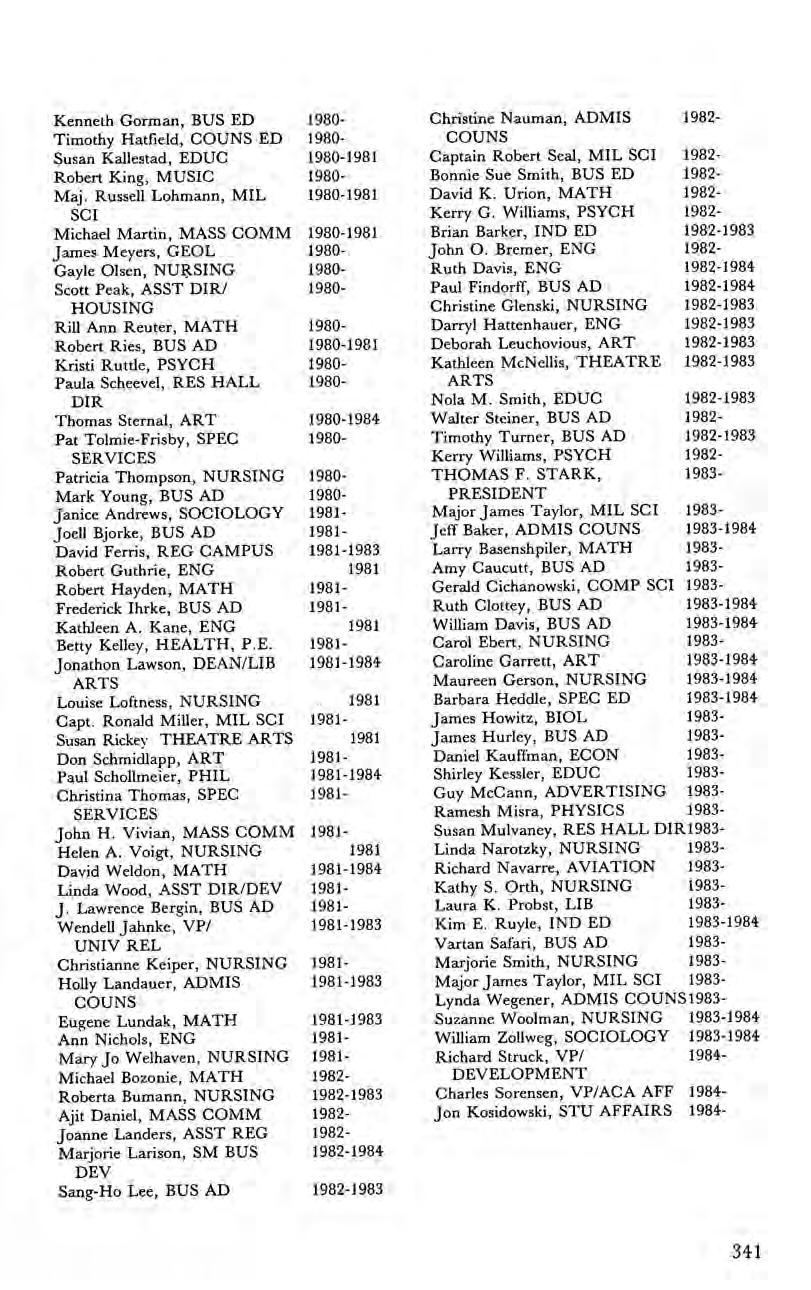
198319831983198319831983-
Susan Mulvaney, RES HALL DIR1983Linda Narotzky, NURSING
Richard Navarre, AVIATION
Kathy S. Orth, NURSING
Laura K. Probst, LIB
Kim E. Ruyle, IND ED
Vartan Safari, BUS AD
Marjorie Smith, NURSING
Major James Taylor, MIL SCI
19831983198319831983-1984 198319831983-
Lynda Wegener, ADMIS COUNS1983Suzanne Woolman, NURSING
William Zollweg, SOCIOLOGY
Richard Struck, VP/ DEVELOPMENT
Charles Sorensen, VP/ACA AFF
Jon Kosidowski, STU AFFAIRS 1983-1984 1983-1984 198419841984-
by G. E. Maxwell
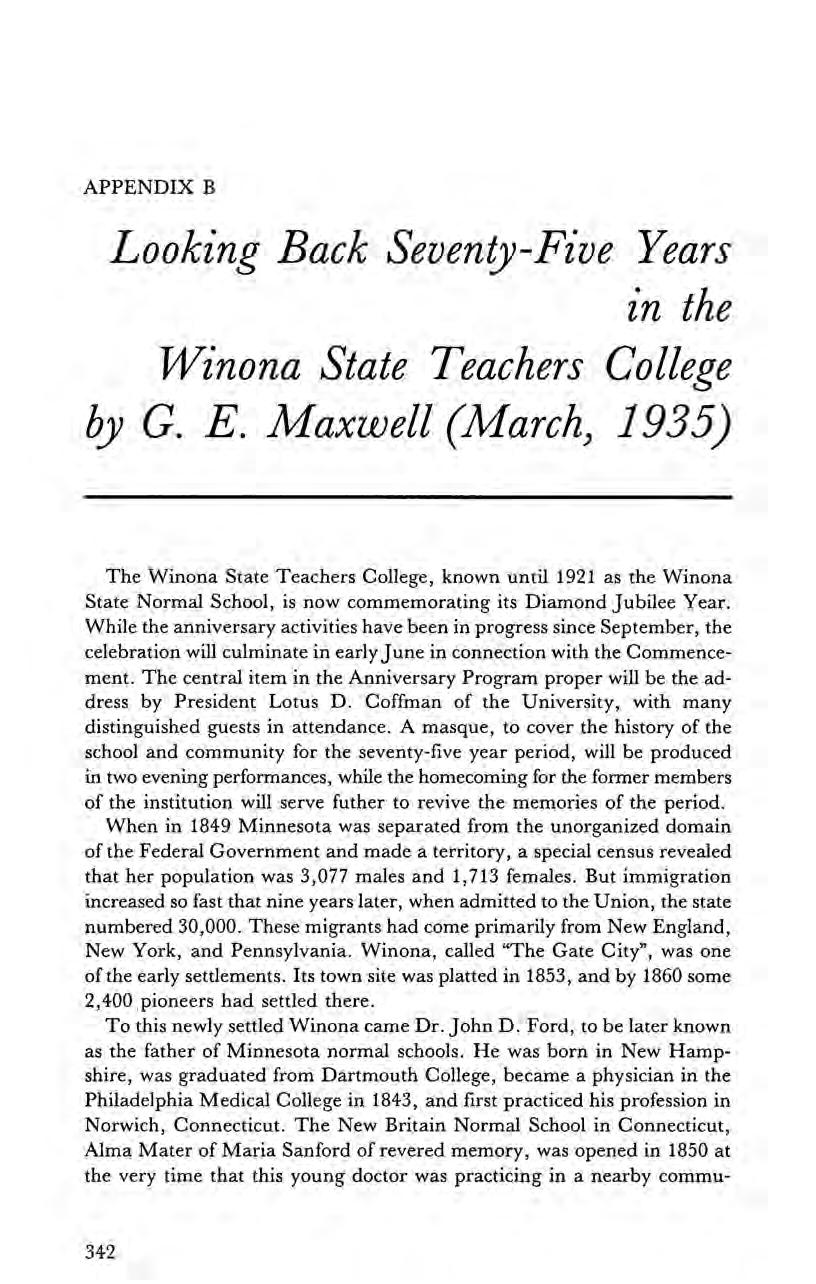
The Winona State Teachers College, known until 1921 as the Winona State Normal School, is now commemorating its Diamond Jubilee Year. While the anniversary activities have been in progress since September, the celebration will culminate in earlyJune in connection with the Commencement. The central item in the Anniversary Program proper will be the address by President LotusD. Coffman of the University, with many distinguished guests in attendance. A masque, to cover the history of the school and community for the seventy-five year period, will be produced in two evening performances, while the homecoming for the former members of the institution will serve futher to revive the memories of the period. When in 1849 Minnesota was separated from the unorganized domain of theFederal Government and madea territory, a special census revealed that her population was 3,077 males and 1,713 females. But immigration increased so fast that nine years later, when admitted to the Union, the state numbered 30,000. ‘These migrants had come primarily from New England, New York, and Pennsylvania. Winona, called “The Gate City”, wasone of the early settlements. Its town site was platted in 1853, and by 1860 some 2,400 pioneers had settled there.
To this newly settled Winona came Dr. John D. Ford, to be later known as the father of Minnesota normal schools. He was born in New Hampshire, was graduated from Dartmouth College, became a physician in the Philadelphia Medical College in 1843, and first practiced his profession in Norwich, Connecticut. The New Britain Normal School in Connecticut, Alma Mater of Maria Sanford of revered memory, was opened in 1850 at the very time that this young doctor was practicing in a nearby commu-

nity. When he came west in 1856 he brought to Minnesota the gospel of teacher-training as known to him in Connecticut. “The crowning labors in the life of this good man,” it is recorded in the minutes of the Normal School Board, “are those which he so unselfishly and nobly gave toward the establishment of the normal school system of this state. The generous people of the state will ever cherish (him) as one of its best friends and noblest benefactors.”
In the first Minnesota Legislature, meeting in June, 1858, the state having been admitted on May 11, there was present, as a member thereof, another man from New England, a Congregational minister who had also reached Minnesota in 1856,to settle at Cannon Falls. This was Joseph Peckham, born in Boston, educated at Amherst, and a student at Union Theological Seminaryjust at the time when the first American normal school was opened at Lexington, Massachusetts in 1839. This young educated easterner was chosen for our Minnesota Constitutional Convention of 1857, saw the state admitted to the Union, and as a member in the first session of the House of Representatives, introduced the bill to create the first Minnesota normal school.
Thus it was that on August 2, 1858, 83 days after our admission to the Union, Governor Henry H. Sibley approved the act establishing the Minnesota normal school “in which to educate and prepare teachers for teaching in the common schools of this state.” Thus it was that two teachers and twenty applicants for admission, meeting in the upper room of the little town hall, began on September 3, 1860, the State Normal School at Winona, the first state supported independent normal school west of the Mississippi. Said Principal John Ogden, “She launches forth freighted with the dearest hopes, the earnest prayers and the highest ambition of the leading minds of the great and free people of the Northwest.”
These pioneers had a profound faith in the normal school. They believed that the trained teacher and the public school were indispensable to preserve the new state and to insure its progress and saw that the normal school was the agency whereby to prepare the teacher.
Said Lieutenant Governor Holcombe, at Winona, just before the school opened:
I have had in my hand a paper which contains the origin, the source, and the earnest of the first Normal School of Minnesota. It had its origin here in this city, and the names written on that paper are as pictures of gold, and should be handed down to the future generations as evidence of their wisdom and benevolence. This paper subscribes (about) $7,000 to the establishment of the Normal School here. The City of Winona has distinguished herself in taking the lead in establishing a school for the benefit of the rising generation of this state and for all who shall yet call the state their home. When this school shall be in operation, it may be regarded as an auspicious era, whence to date in future the origin of many blessings, and the commencement of a perpetual course of improvement and prosperity to the people at large.
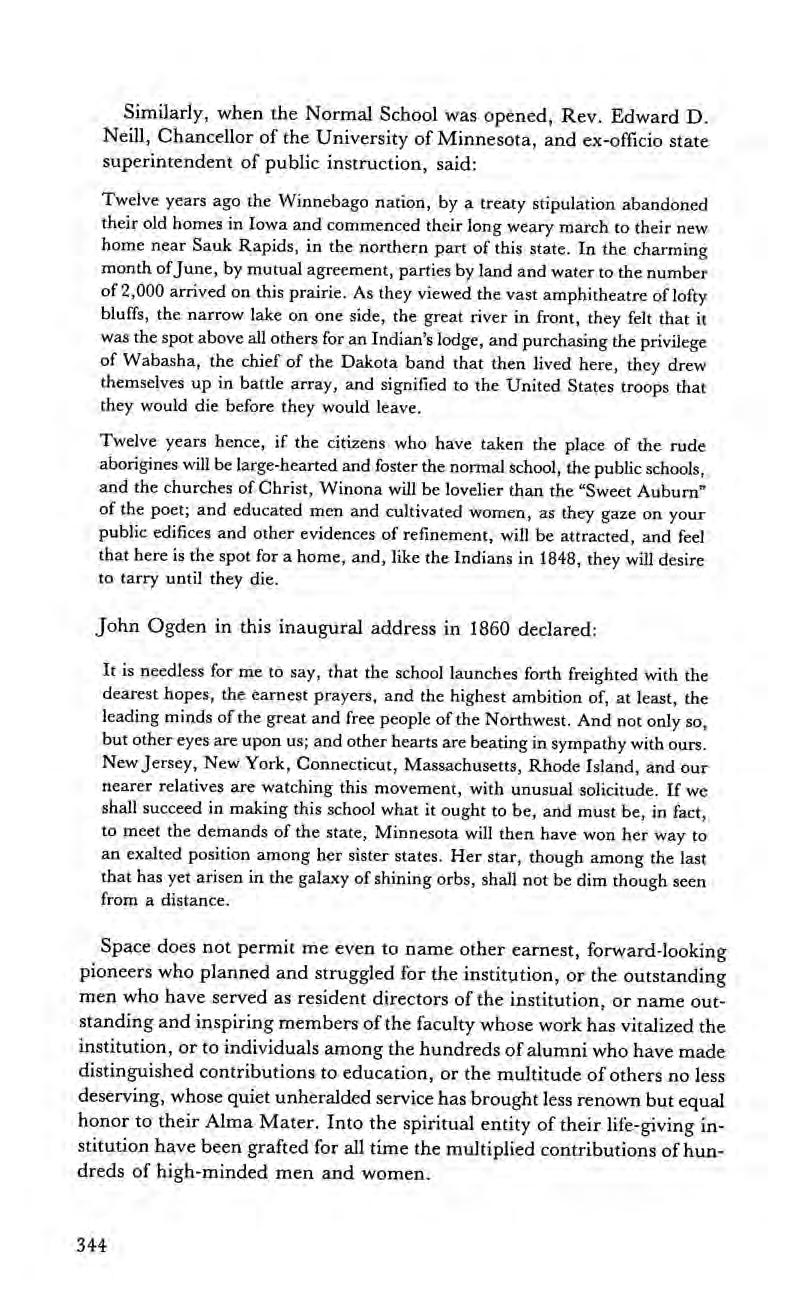
Similarly, when the Normal School was opened, Rev. Edward D. Neill, Chancellor of the University of Minnesota, and ex-officio state superintendent of public instruction, said:
Twelve years ago the Winnebago nation, bya treaty stipulation abandoned their old homes in Iowa and commenced their long weary march to their new home near Sauk Rapids, in the northern part of this state. In the charming month ofJune, by mutual agreement, parties by land and water to the number of 2,000 arrived on this prairie. As they viewed the vast amphitheatre of lofty bluffs, the narrow lake on one side, the great river in front, they felt that it was the spot above all others for an Indian’s lodge, and purchasing the privilege of Wabasha, the chief of the Dakota band that then lived here, they drew themselves up in battle array, and signified to the United States troops that they would die before they would leave.
Twelve years hence, if the citizens who have taken the place of the rude aborigines will be large-hearted and foster the normal school, the public schools, and the churches of Christ, Winona will be lovelier than the “Sweet Auburn” of the poet; and educated men and cultivated women, as they gaze on your public edifices and other evidences of refinement, will be attracted, and feel that here is the spot for a home, and, like the Indians in 1848, they will desire to tarry until they die.
John Ogden in this inaugural address in 1860 declared:
It is needless for me to say, that the school launches forth freighted with the dearest hopes, the earnest prayers, and the highest ambition of, at least, the leading minds of the great and free people of the Northwest. And not only so, but other eyes are upon us; and other hearts are beating in sympathy with ours. New Jersey, New York, Connecticut, Massachusetts, Rhode Island, and our nearer relatives are watching this movement, with unusual solicitude. If we shall succeed in making this school what it ought to be, and must be, in fact, to meet the demands of the state, Minnesota will then have won her way to an exalted position among her sister states. Her star, though among the last that has yet arisen in the galaxy of shining orbs, shall not be dim though seen from a distance.
Space does not permit me even to name other earnest, forward-looking pioneers who planned and struggled for the institution, or the outstanding men who have served as resident directors of the institution, or name outstanding and inspiring members of the faculty whose work has vitalized the institution, or to individuals among the hundreds of alumni who have made distinguished contributions to education, or the multitude of others no less deserving, whose quiet unheralded service has brought less renown but equal honor to their Alma Mater. Into the spiritual entity of their life-giving institution have been grafted for all time the multiplied contributions of hundreds of high-minded men and women.
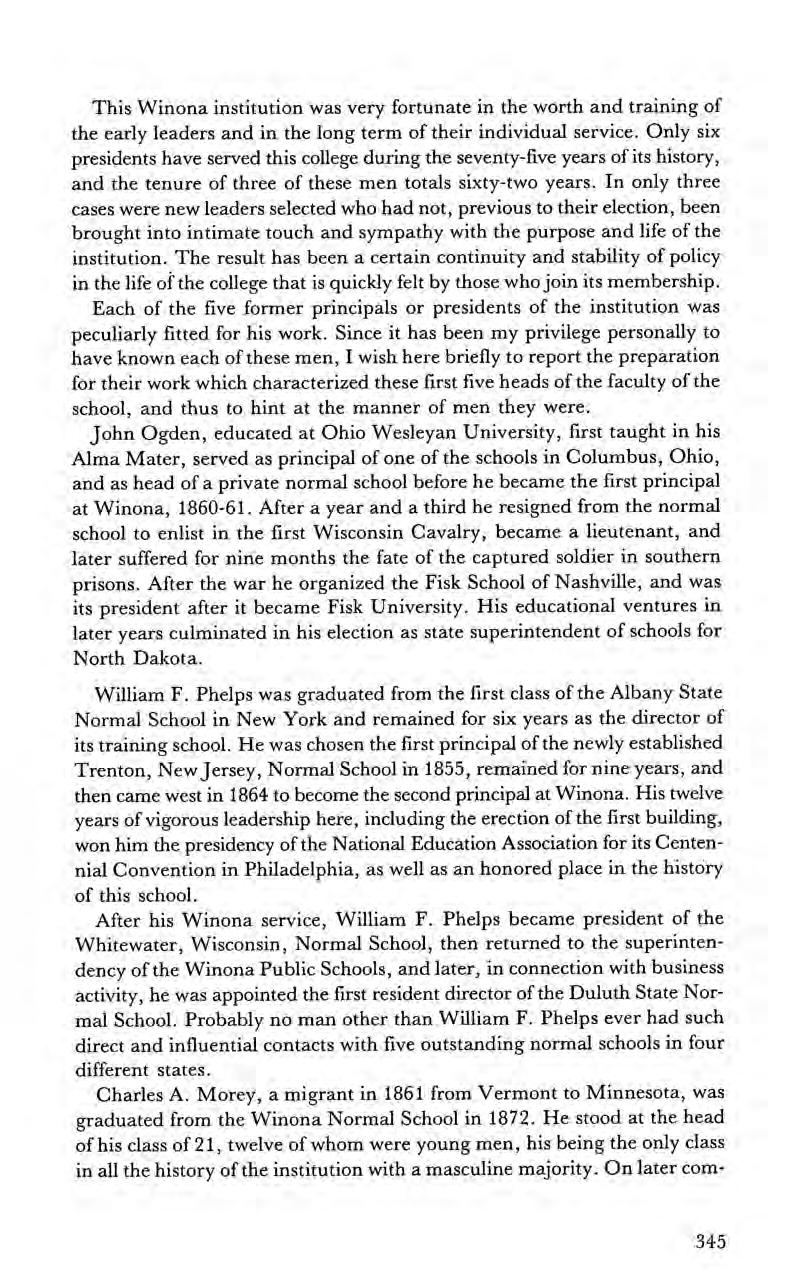
This Winona institution was very fortunate in the worth and training of the early leaders and in the long term of their individual service. Only six presidents have served this college during the seventy-five years of its history, and the tenure of three of these men totals sixty-two years. In only three cases were new leaders selected who had not, previous to their election, been brought intointimate touch and sympathy with the purpose and life of the institution. The result has been a certain continuity and stability of policy in the life of the college that is quickly felt by those who join its membership.
Each of the five former principals or presidents of the institution was peculiarly fitted for his work. Since it has been my privilege personally to have known each of these men, I wish here briefly to report the preparation for their work which characterized these first five heads of the faculty of the school, and thus to hint at the manner of men they were.
John Ogden, educated at Ohio Wesleyan University, first taught in his Alma Mater, served as principal of one of the schools in Columbus, Ohio, and as head of a private normal school before he became the first principal at Winona, 1860-61. After a year anda third he resigned from the normal school to enlist in the first Wisconsin Cavalry, became a lieutenant, and later suffered for nine months the fate of the captured soldier in southern prisons. After the war he organized the Fisk School of Nashville, and was its president after it became Fisk University. His educational ventures in later years culminated in his election as state superintendent of schools for North Dakota.
William F. Phelps was graduated from the first class of the Albany State Normal School in New York and remained for six years as the director of its training school. He was chosen the first principal of the newly established Trenton, NewJersey, Normal School in 1855, remained for nine years, and then came west in 1864 to become the second principal at Winona. His twelve years of vigorous leadership here, including the erection of the first building, won him the presidency ofthe National Education Association for its Centennial Convention in Philadelphia, as well as an honored place in the history of this school.
After his Winona service, William F. Phelps became president of the Whitewater, Wisconsin, Normal School, then returned to the superintendency of the Winona Public Schools, and later, in connection with business activity, he was appointed the first resident director of the Duluth State Normal School. Probably no man other than William F. Phelps ever had such direct and influential contacts with five outstanding normal schools in four different states.
Charles A. Morey, a migrant in 1861 from Vermont to Minnesota, was graduated from the Winona Normal School in 1872. He stood at the head of his class of 21, twelve of whom were young men, his being the only class in all the history of the institution with a masculine majority. On later com-

pleting two years of study in science in the Massachusetts Institute of Technology, Charles A. Morey returned to teach science in the Winona Normal School, and in 1876, he followed William F. Phelps as principal. He retained the position for three years, when he entered the profession of law in Winona. Later he became the resident director of the school and retained this office until his death. In his twenty-two years of membership in this school, as student, teacher, principal, and resident director, and in other years as lawyer and citizen, Charles A. Morey rendered extensive and invaluable service to school, to community, and to state.
Irvin Shepard as a boy left his studies in the Ypsilanti Normal School to enlist as a soldier in the Union army and rendered striking service for which he received the Congressional Medal of Honor. Returning to the Ypsilanti Normal School and later to Olivet College for his degree, he found himself within four years the principal of the Winona Public High School. After three years he became superintendent of the Winona Public Schools, and then, (in 1879) the president of the Normal School, where he served with singular success for nineteen years. He resigned his presidency to become the permanent and full-time secretary of the National Education Association, having held the office in connection with his Normal School work for five years and giving his full time to the office for 14 years more.
Dr. Jesse F. Millspaugh, graduate of the University of Michigan and of the Medical School of the University of Pennsylvania, practiced medicine in Nebraska, became the superintendent of the Gentile Schools of Salt Lake City, Utah, and then the first superintendent of the Salt Lake City joint system of schools of both Mormons and Gentiles. Coming to the presidency at Winona in 1898, he withdrew in six years to become the equally successful head for the Los Angeles State Teachers College in California.
Each of these five men has passed to his reward, but his work survives in the spirit and worth of the institution whose seventy-five years are under review.
An evidence of the permanency of the institution which was opened at Winona in 1860 and of this indispensable and vital character of its work, is the fact that this school has passed through three separate and severe calamities. The first of these was the resignation of the first principal and the temporary closing of the school for a period of two years during the Civil War. It was the vital purpose within the infant school, the preparation of teachers for the growing state, by which it was resuscitated even before the close of the Civil War.
The second calamity struck in 1876 when, “partly by design and partly by neglect,” the legislature failed to vote the regular maintenance appropriation and the school was left with its 300 students and eleven teachers, to carry on with the meager standing appropriation of $5,000 which had been voted in 1864. The record states that it was only “by temporary reductions of teaching force, by abatements of teacher’s salaries, by certain extra charges
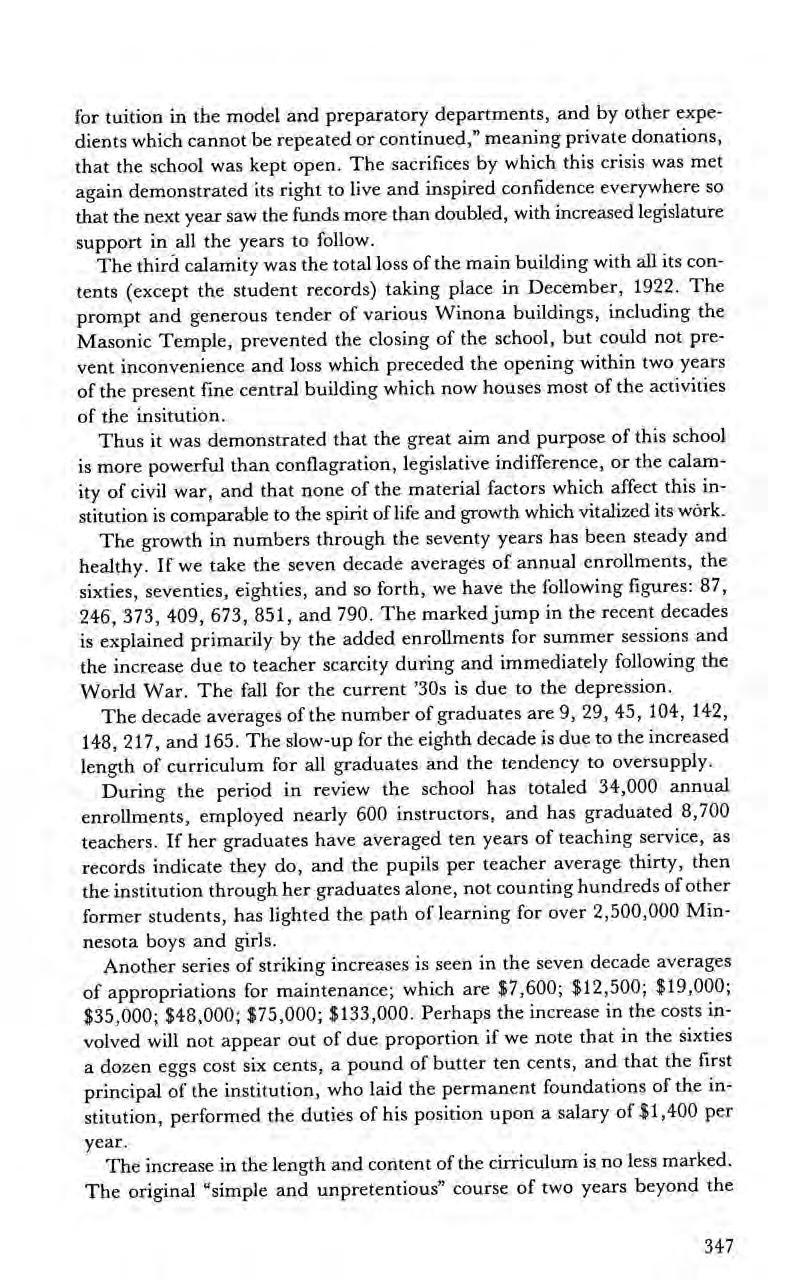
for tuition in the model and preparatory departments, and by other expedients which cannot be repeated or continued,” meaning private donations, that the school was kept open. The sacrifices by which this crisis was met again demonstrated its right to live and inspired confidence everywhere so that the next year saw the funds more than doubled, with increased legislature support in all the years to follow.
The third calamity was the total loss of the main building with all its contents (except the student records) taking place in December, 1922. The prompt and generous tender of various Winona buildings, including the Masonic Temple, prevented the closing of the school, but could not prevent inconvenience and loss which preceded the opening within two years of the present fine central building which now houses most of the activities of the insitution.
Thus it was demonstrated that the great aim and purpose of this school is more powerful than conflagration, legislative indifference, or the calamity of civil war, and that none of the material factors which affect this institution is comparable to the spirit of life and growth which vitalized its work.
The growth in numbers through the seventy years has been steady and healthy. If we take the seven decade averages of annual enrollments, the sixties, seventies, eighties, and so forth, we have the following figures: 87, 246, 373, 409, 673, 851, and 790. The marked jump in the recent decades is explained primarily by the added enrollments for summer sessions and the increase due to teacher scarcity during and immediately following the World War. The fall for the current 30s is due to the depression.
The decade averages of the number of graduates are 9, 29, 45, 104, 142, 148, 217, and 165. The slow-up for the eighth decade is due to the increased length of curriculum for all graduates and the tendency to oversupply.
During the period in review the school has totaled 34,000 annual enrollments, employed nearly 600 instructors, and has graduated 8,700 teachers. If her graduates have averaged ten years of teaching service, as records indicate they do, and the pupils per teacher average thirty, then the institution through her graduates alone, not counting hundreds of other former students, has lighted the path of learning for over 2,500,000 Minnesota boys and girls.
Another series of striking increases is seen in the seven decade averages of appropriations for maintenance; which are $7,600; $12,500; $19,000; $35,000; $48,000; $75,000; $133,000. Perhaps the increase in the costs involved will not appear out of due proportion if we note that in the sixties a dozen eggs cost six cents, a pound of butter ten cents, and that the first principal of the institution, who laid the permanent foundations of the institution, performed the duties of his position upon a salary of $1,400 per year.
The increase in the length and content of the cirriculum is no less marked. The original “simple and unpretentious” course of two years beyond the

elementary school had by the fourth decade been trebled in length, while today the student who completes the full program pursues four times as much work as did his fellow of sixty and seventy years ago. The steps in this forward movement have been steady and definite. Avoiding alluring by paths the authorities of the college have appreciated the enlarging conception of the place of the common schools in the life and progress of our state and have steadily set up higher standards ofhealth, teaching technique, scholarship, and culture.
Advances in entrance requirements, equipment, teaching personnel, student activities, and organization have been no less marked.
But to fulfill the high hopes of the founders, the institution also must meet increased responsibilities. Today’s standards ofliving have changed, temptations are more severe, the problems of democracy are increasingly difficult, the future uncertain. It is an obligation resting upon the institution to preserve and enhance the inheritance received from the fathers. They were loyal to a great vision which is as yet unrealized. To inspire our own loyalty to that cause we have both their fine tradition, and our own new outlook, even more far reaching and challenging than theirs.
And so we pay high tribute to the institution which through seventy-five years has been dominated by the deep conviction that the only hope of salvation in this democracy of ours is the high quality of our citizenship, that the most vital constructive force in citizenship is the public school, and that in turn the most vital element in the public school is the well-prepared teacher.
APPENDIX C
by George EL. Bates, Jr.

The rapid extension of education to women and their consequent entry into teaching as trained professionals stands as a watershed in the cultural, social, and economic history of late 19th century America. Despite the far reaching implications of this development, few specific studies have been made of the professional education of women as teachers, and what has been done is almost entirely of a non-quantitative nature.
The questions upon which this paper focuses are three: What sort of students attended the Winona Normal School? What did they study? And why did they commit themselves to higher education, i.e., what did they plan to do with their skills? Because the vast majority of students who attended were women, our tentative conclusions will have a great deal to say about the professional education of women in a late 19th century frontier environment. But men were also enrolled in the same curricula, and their presence introduces the ability to make and test conclusions about sex roles in coeducation. We also often know students’ and parent’s nativities, and with reasonable accuracy in many instances, we can estimate socio-economic status. Sex, and to a lesser degree ethnicity, geographic factors, and status, become the independent variables in this preliminary report. Finally, whenever possible, we will compare data from our study of the Normal
The footnotes for this article have not been included for reasons of space limitations. They are, however, available in the original document.

School student body with statistical evidence and conclusions reported in other studies about Winona, frontier communities, and institutions ofhigher education.
One generally recognized characteristic of Americans in the Early Republic was a reinvigorated interest in education which increasingly embraced the common man. In his Essays, Literary, Moral, and Philosophical, Benjamin Rush noted, “The Business of education has acquired a new complexion by the independence of our country. The form of government we have assumed has created a new class of duties to every American.” These duties soon became differentiated by sex and seem to have been assigned to roles which were compensatory, not competing. Men had citizens’ responsibilities, and more and more to act on the stage of politics and economy, formal education became important. Women retained the responsibilities of domestic establishment, but an increasing emphasis was placed on nurturing, or, educating. In perpetuating American culture and society, a task to which men were too busy to pay much attention, 19th century Americans often affirmed that women had “a much greater natural adaptation to the work of instruction than men.” Thus, they became the moral guardians of youth and the instructors of both sexes.
Beyond their natural capacities, there were two other good reasons why 19th century women became the teachers of children. First, there were not enough men to go around, and the shortage became more acute during the Civil War and on the frontier. Second, not only were they better, they could be had two to four times cheaper. By 1870, sixty percent ofAmerican teachers were women, and teaching had become the most respectable occupation open to women.
To achieve the generally desired civic ideal of a minimum level ofuniversal male education, women had to be employed as teachers. This led to a genuine dilemma for those who believed women either should not be educated at all or should be put in a curricula different from men. Since teachers ought to know at least as much as the pupil preferably more it became necessary to concede that a very substantial number of females must be educated in the male curricula. Once this point was won problems facing those who fought for equal higher education of women were far from resolved. Most important, perhaps, few existing eastern institutions would open their doors to women. It is for this reason that established colleges and universities played an insignificant part in the early training of American teachers.
Initially the existing system of women’s education, the academy and seminary, were modified and pressed into service. No less a person than Emma Willard saw the future of teacher training for the lower schools in the seminary. Her general argument was soon accepted by most connected with the rising system of common schools, andthe seminary prepared the way for the normal school.
About mid-century, two new solutions were advanced. In the east a series
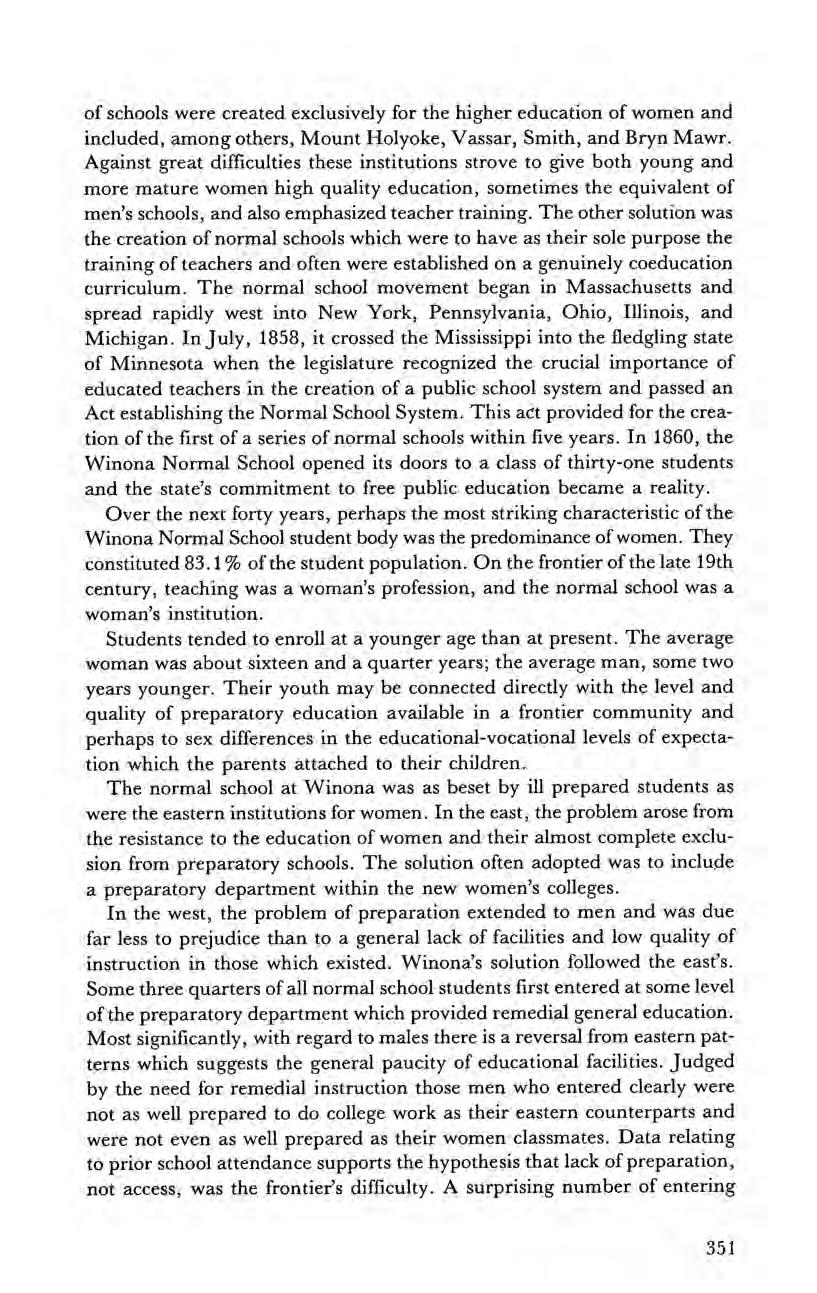
of schools were created exclusively for the higher education of women and included, among others, Mount Holyoke, Vassar, Smith, and Bryn Mawr. Against great difficulties these institutions strove to give both young and more mature women high quality education, sometimes the equivalent of men’s schools, and also emphasized teacher training. Theother solution was the creation of normal schools which were to have as their sole purpose the training of teachers and often were established on a genuinely coeducation curriculum. The normal school movement began in Massachusetts and spread rapidly west into New York, Pennsylvania, Ohio, Illinois, and Michigan. In July, 1858, it crossed the Mississippi into the fledgling state of Minnesota when the legislature recognized the crucial importance of educated teachers in the creation of a public school system and passed an Act establishing the Normal School System. This act provided for the creation of the first of a series of normal schools within five years. In 1860, the Winona Normal School opened its doors to a class of thirty-one students and the state’s commitment to free public education becamea reality.
Over the next forty years, perhaps the most striking characteristic of the Winona Normal School student body was the predominance of women. They constituted 83.1% of the student population. On the frontier of thelate 19th century, teaching was a woman’s profession, and the normal school was a woman’s institution.
Students tended to enroll at a younger age than at present. The average woman was about sixteen and a quarter years; the average man, some two years younger. Their youth may be connected directly with the level and quality of preparatory education available in a frontier community and perhaps to sex differences in the educational-vocational levels of expectation which the parents attached to their children.
The normal school at Winona was as beset by ill prepared students as were the eastern institutions for women. In the east, the problem arose from the resistance to the education of women and their almost complete exclusion from preparatory schools. The solution often adopted was to include a preparatory department within the new women’s colleges.
In the west, the problem of preparation extended to men and was due far less to prejudice than to a general lack of facilities and low quality of instruction in those which existed. Winona’s solution followed the east’s. Some three quarters of all normal school students first entered at some level of the preparatory department which provided remedial general education. Most significantly, with regard to males there is a reversal from eastern patterns which suggests the general paucity of educational facilities. Judged by the need for remedial instruction those men who entered clearly were not as well prepared to do college work as their eastern counterparts and were not even as well prepared as their women classmates. Data relating to prior school attendance supports the hypothesis that lack of preparation, not access, was the frontier’s difficulty. A surprising number of entering
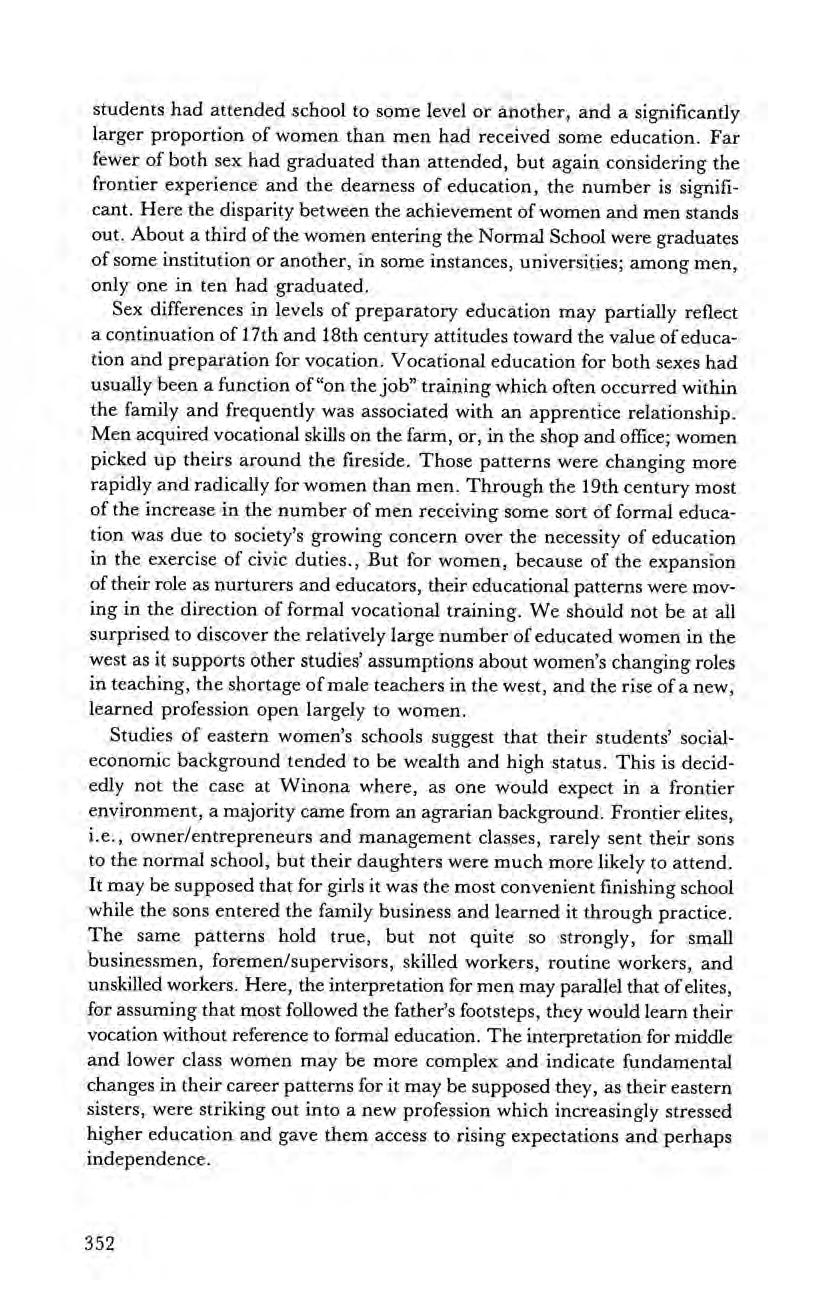
students had attended school to some level or another, anda significantly larger proportion of women than men had received some education. Far fewer of both sex had graduated than attended, but again considering the frontier experience and the dearness of education, the number is significant. Here the disparity between the achievement of women and men stands out. About a third of the women entering the Normal School were graduates of some institution or another, in some instances, universities; among men, only one in ten had graduated.
Sex differences in levels of preparatory education may partially reflect a continuation of 17th and 18th century attitudes toward the value of education and preparation for vocation. Vocational education for both sexes had usually been a function of“on the job” training which often occurred within the family and frequently was associated with an apprentice relationship. Men acquired vocational skills on the farm, or, in the shop and office; women picked up theirs around the fireside. Those patterns were changing more rapidly and radically for women than men. Through the 19th century most of the increase in the number of men receiving some sort of formal education was due to society’s growing concern over the necessity of education in the exercise of civic duties., But for women, because of the expansion of their role as nurturers and educators, their educational patterns were moving in the direction of formal vocational training. We should not be at all surprised to discover the relatively large number of educated women in the west as it supports other studies’ assumptions about women’s changing roles in teaching, the shortage of male teachers in the west, and the rise of a new, learned profession open largely to women.
Studies of eastern women’s schools suggest that their students’ socialeconomic background tended to be wealth and high status. This is decidedly not the case at Winona where, as one would expect in a frontier environment, a majority came from an agrarian background. Frontier elites, i.e., owner/entrepreneurs and management classes, rarely sent their sons to the normal school, but their daughters were much more likely to attend. It may be supposed that for girls it was the most convenient finishing school while the sons entered the family business and learned it through practice. The same patterns hold true, but not quite so strongly, for small businessmen, foremen/supervisors, skilled workers, routine workers, and unskilled workers. Here, the interpretation for men may parallel that of elites, for assuming that most followed the father’s footsteps, they would learn their vocation without reference to formal education. The interpretation for middle and lower class women may be more complex and indicate fundamental changes in their career patterns for it may be supposed they, as their eastern sisters, were striking out into a new profession which increasingly stressed higher education and gave them access to rising expectations and perhaps independence.
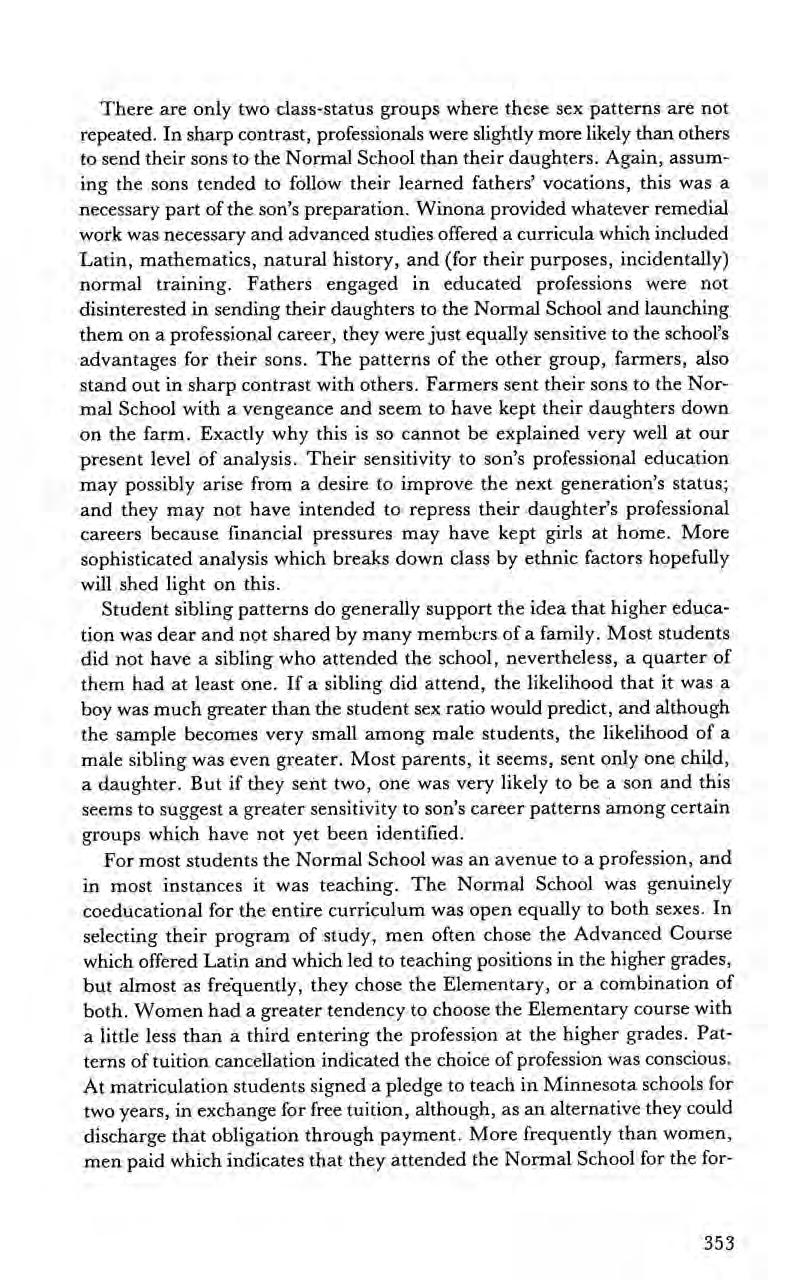
There are only two class-status groups where these sex patterns are not repeated. In sharp contrast, professionals were slightly more likely than others to send their sons to the Normal School than their daughters. Again, assuming the sons tended to follow their learned fathers’ vocations, this was a necessary part of the son’s preparation. Winona provided whatever remedial work was necessary and advanced studies offered a curricula which included Latin, mathematics, natural history, and (for their purposes, incidentally) normal training. Fathers engaged in educated professions were not disinterested in sending their daughters to the Normal School and launching them on a professional career, they were just equally sensitive to the school’s advantages fortheir sons. The patterns of the other group, farmers, also stand out in sharp contrast with others. Farmers sent their sons to the Normal School with a vengeance and seem to have kept their daughters down on the farm. Exactly why this is so cannot be explained very well at our present level of analysis. Their sensitivity to son’s professional education may possibly arise from a desire to improve the next generation’s status; and they may not have intended to repress their daughter’s professional careers because financial pressures may have keptgirls at home. More sophisticated analysis which breaks down class by ethnic factors hopefully will shed light on this.
Student sibling patterns do generally support the idea that higher education was dear and not shared by many membcrs of a family. Most students did not have a sibling who attended the school, nevertheless, a quarter of them had at least one. If a sibling did attend, the likelihood that it was a boy was much greater than the student sex ratio would predict, and although the sample becomes very small among male students, the likelihood of a male sibling was even greater. Most parents, it seems, sent only one child, a daughter. But if they sent two, one was very likely to be a son and this seems to suggest a greater sensitivity to son’s career patterns among certain groups which have not yet been identified.
For most students the Normal School was an avenue to a profession, and in most instances it was teaching. The Normal School was genuinely coeducational for the entire curriculum was open equally to both sexes. In selecting their program of study, men often chose the Advanced Course which offered Latin and which led to teaching positions in the higher grades, but almost as frequently, they chose the Elementary, or a combination of both. Women had a greater tendency to choose the Elementary course with a little less than a third entering the profession at the higher grades. Patterns of tuition cancellation indicated the choice of profession was conscious. At matriculation students signed a pledge to teach in Minnesota schools for two years, in exchange for free tuition, although, as an alternative they could discharge that obligation through payment. More frequently than women, men paid which indicates that they attended the Normal School for the for-
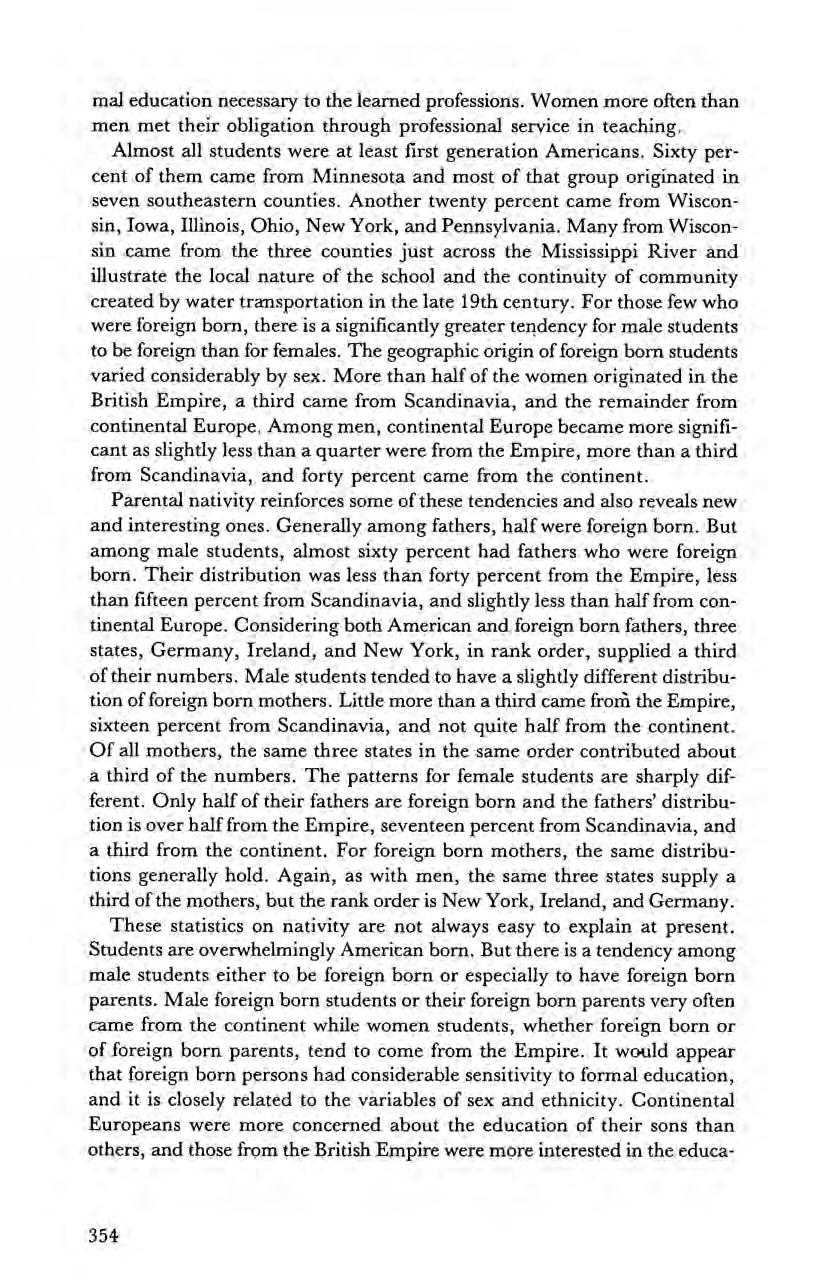
mal education necessary to the learned professions. Women more often than men met their obligation through professional service in teaching.
Almost all students were at least first generation Americans. Sixty percent of them came from Minnesota and most of that group originated in seven southeastern counties. Another twenty percent came from Wisconsin, Iowa, Illinois, Ohio, New York, and Pennsylvania. Many from Wisconsin came from the threecounties just across the Mississippi River and illustrate the local nature of the school and the continuity of community created by water transportation in the late 19th century. For those few who were foreign born, there is a significantly greater tendency for male students to be foreign than for females. The geographic origin of foreign born students varied considerably by sex. More than halfof the women originated in the British Empire, a third came from Scandinavia, and the remainder from continental Europe. Among men, continental Europe became more significant as slightly less than a quarter were from the Empire, more than a third from Scandinavia, and forty percent came from the continent.
Parental nativity reinforces some of these tendencies and also reveals new and interesting ones. Generally among fathers, half were foreign born. But among male students, almost sixty percent hadfathers who were foreign born. Their distribution was less than forty percent from the Empire, less than fifteen percent from Scandinavia, and slightly less than half from continental Europe. Considering both American and foreign born fathers, three states, Germany, Ireland, and New York, in rank order, supplied a third oftheir numbers. Male students tended to havea slightly different distribution offoreign born mothers. Little more than a third came from the Empire, sixteen percent from Scandinavia, and not quite half from the continent. Of all mothers, the same three states in the same order contributed about a thirdof the numbers. The patterns for female students are sharply different. Only half of their fathers are foreign born and the fathers’ distribution is over halffrom the Empire, seventeen percent from Scandinavia, and a third from the continent. For foreign born mothers, the same distributions generally hold. Again, as with men, the same three states supply a third of the mothers, but the rank order is New York, Ireland, and Germany. These statistics on nativity are not always easy to explain at present. Students are overwhelmingly American born. But there is a tendency among male students either to be foreign born or especially to have foreign born parents. Male foreign born students or their foreign born parents very often came from the continentwhile women students, whether foreign born or of foreign born parents, tend to come from the Empire. It would appear that foreign born persons hadconsiderable sensitivity to formal education, and it is closely related to the variables of sex and ethnicity. Continental Europeans were more concerned about the education of their sons than others, and those from the British Empire were more interested in the educa-

tion of their daughters than others. Future analysis should help explain these patterns more fully.
This preliminary study tends to support some of the general conclusions suggested by others. Teaching as a profession offered young women access to higher education. Generally, it was a woman’s profession as men tended to adopt established vocations which most often did not require formal education. But on the frontier the normal school could also provide the sort of formal education necessary for the learned male professions and many educated fathers sent their sons to Winona. There appears to have been significant differences between the educational patterns ofthe east and west. In the east, men had access, and as most often women did not, they required remedial work. In the west, both had access, but the quality of education appears to have been so low that many, especially men, still required remedial work.
Final conclusions on these and other problems must be delayed until higher level analysis is complete, but the basic outlines are clear —for the first time women were becoming educated and inducted into a learned profession. Their independence could not be far behind.
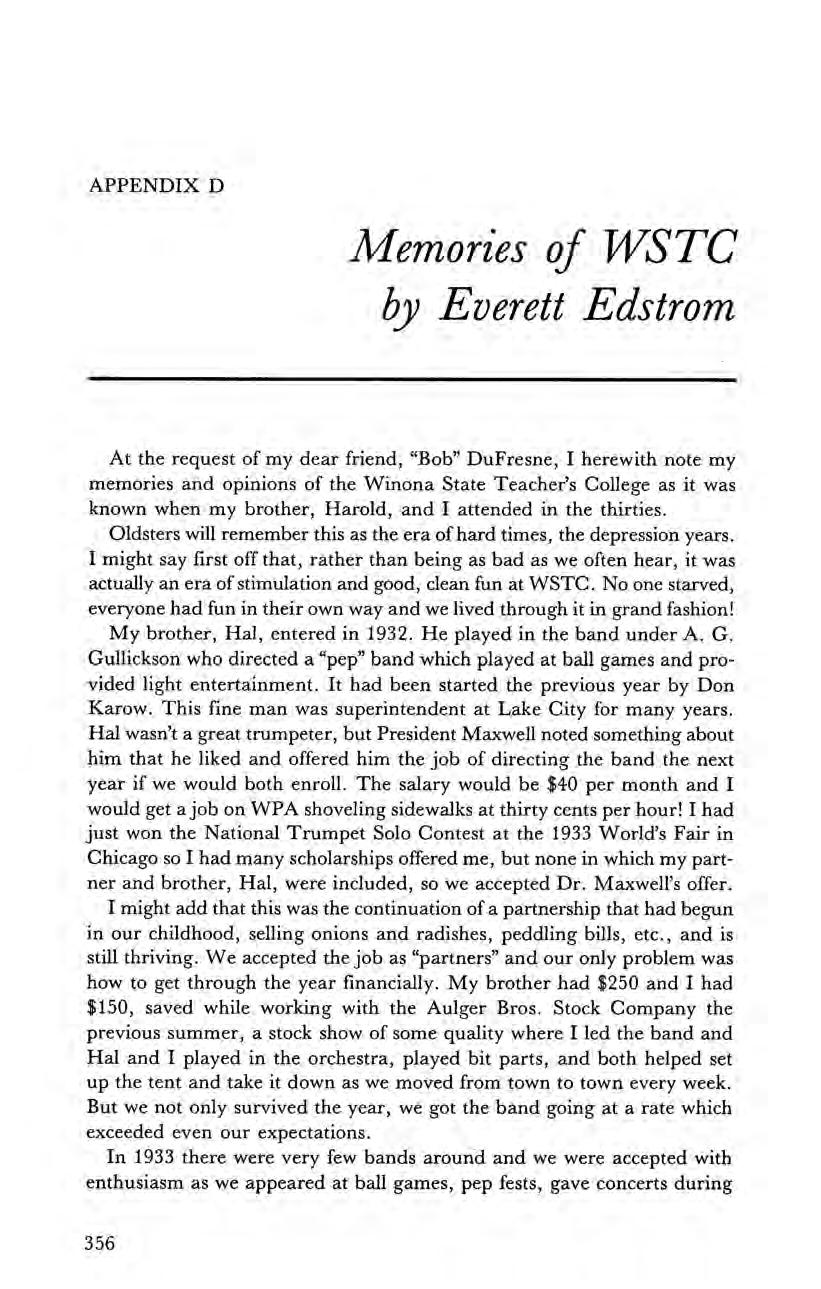
At the request of my dear friend, “Bob” DuFresne, I herewith note my memories and opinions of the Winona State Teacher’s College as it was known when my brother, Harold, and I attended in the thirties.
Oldsters will rememberthis as the era of hard times, the depression years. I might say first off that, rather than being as bad as we often hear, it was actually an era of stimulation and good, clean fun at WSTC. No one starved, everyone had fun in their own way and we lived through it in grand fashion!
My brother, Hal, entered in 1932. He played in the band under A. G. Gullickson who directed a “pep” band which played at ball games and provided light entertainment. It had been started the previous year by Don Karow. This fine man was superintendent at Lake City for many years. Hal wasn’t a great trumpeter, but President Maxwell noted something about him that he liked and offered him the job of directing the band the next year if we would both enroll.The salary would be $40 per month and I would get a job on WPA shoveling sidewalks at thirty cents per hour! I had just won the National Trumpet Solo Contest at the 1933 World’s Fair in Chicago so I had many scholarships offered me, but none in which my partner and brother, Hal, were included, so we accepted Dr. Maxwell’s offer.
I might add that this was the continuation of a partnership that had begun in our childhood, selling onions and radishes, peddling bills, etc., and is still thriving. We accepted the job as “partners” and our only problem was how to get through the year financially. My brother had $250 and I had $150, saved while working with the Aulger Bros. Stock Company the previous summer, a stockshow of some quality where I led the band and Hal and I played in the orchestra, played bit parts, and both helped set up the tent and take it down as we moved from town to town every week. But we not only survived the year, we got the band going at a rate which exceeded even our expectations.
In 1933 there were very few bands around and we were accepted with enthusiasm as we appeared at ball games, pep fests, gave concerts during

“assembly” and generally created quite a stir. Most of the other State Colleges either had no band or very poor ones so we had lots of fun playing at Mankato, St. Cloud,. Bemidji or Moorhead, and showing off our marching innovations.
But we were not satisfied. Fortunately for us, we’d hada veritable genius for an instructor at our home town, Worthington, by the name of Vic Moeller. He had taught us more about music and band directing by the time we graduated from high school than most anyone else ever learned. Hence, our standards were high and our goals were ambitious. In addition to our good fortune in high school, we were to meet whatI still consider to be the finest administrator I’ve ever seen operate, Dr. Guy E. Maxwell! This little Scotsman brooked no nonsense. He knew exactly where he was going and got there. Discipline, that one ingredient so sadly lacking in later years, was second nature to him, and it worked wonders in all those around him. One felt secure. One felt as if he were going somewhere. One sensed leadership and quality and all that such a man can inspire! So here we were at the right place, at the right time, with the right product and the right price.
President Maxwell wanted three things, only one of which the college had: 1) a good athletic program; 2) a top rated educational program; and last but not particularly least, 3) a fine music program. The one he had of course was top education ratings. I remember the end of every quarter when we all quaked if we failed to escape the dreaded “D” and had to appear before the “committee”. Even though we got down to as low as 325 students, one was sure to be put on “probation” with a “D” and expelled at the second offense. It was, indeed, a truly “educational” institution with no thought of trying to increase enrollment to increase state aid or make friends of generous donors. One either produced or got out! We always heard that there were three Teachers Colleges in the entire USA which continually vied for top scholastic honors— one in Milwaukee, one somewhere in California and our dearly beloved WSTC.
To get on with the story of the band—we felt that in order to raise the standards we must have three things: credit for band towards graduation, band practice during regular classroom hours and during the best hour of the day at that—8:00 a.m.! We proposed this to Dr. Maxwell and didn’t know what to expect. However, about a week later he called us in to inform us that our requests were granted! We knew we were on our way! Now the problem was to sell the idea to Miss Pritchard, the registrar, a tough assignment indeed. Miss Pritchard was aware of her authority, and it was seldom that anyone dared challenge her. When she was informed that our band program was to get the best hour of the day, she was livid. Her immediate response was that we couldn’t possibly have that hour and she made no bones about it in a very loud and displeased voice. Hal and I walked into President Maxwell’s office and told him the story. He flew out to the registrar’s desk, announced his wishes and said, “And I don’t want to hear any more
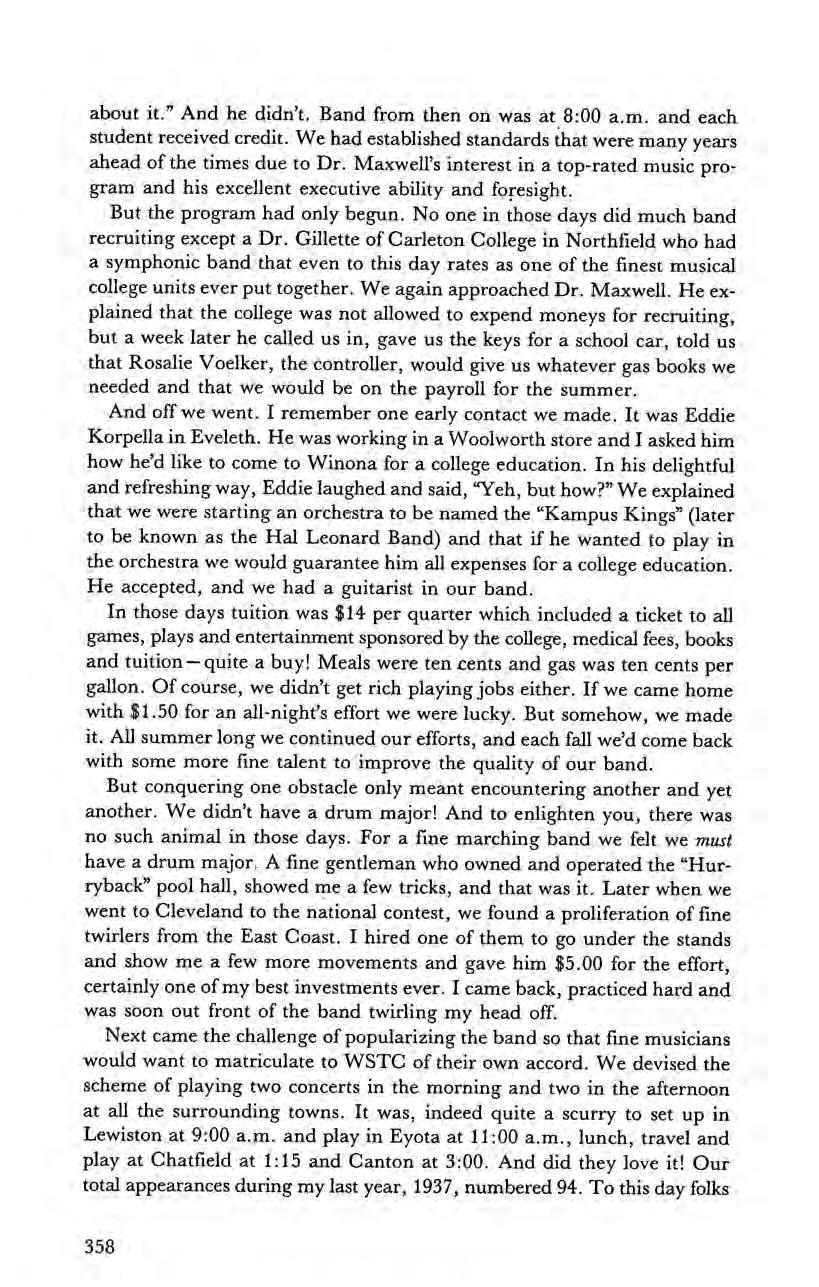
about it.” And he didn’t. Band from then on was at 8:00 a.m. and each student received credit. We had established standards that were many years ahead of the times due to Dr. Maxwell’s interest in a top-rated music program and his excellent executive ability and foresight.
But the program had only begun. No one in those days did much band recruiting except a Dr. Gillette of Carleton College in Northfield who had a symphonic band that even to this day rates as one of the finest musical college units ever put together. We again approached Dr. Maxwell. He explained that the college was not allowed to expend moneys for recruiting, but a week later he called us in, gave us the keys for a school car, told us that Rosalie Voelker, the controller, would give us whatever gas books we needed and that we would be on the payroll for the summer.
And off we went. I remember one early contact we made. It was Eddie Korpella in Eveleth. He was working in a Woolworth store and I asked him how he’d like to come to Winona for a college education. In his delightful and refreshing way, Eddie laughed and said, “Yeh, but how?” We explained that we were starting an orchestra to be named the “Kampus Kings” (later to be known as the Hal Leonard Band) and that if he wanted to play in the orchestra we would guarantee him all expenses for a college education. He accepted, and we had a guitarist in our band.
In those days tuition was $14 per quarter which includeda ticket to all games, plays and entertainment sponsored by the college, medical fees, books and tuition — quite a buy! Meals were ten cents and gas was ten cents per gallon. Of course, we didn’t get rich playingjobs either. If we came home with $1.50 for an all-night’s effort we were lucky. But somehow, we made it. All summer long we continued our efforts, and each fall we’d come back with some more fine talent to improve the quality of our band.
But conquering one obstacle only meant encountering another and yet another. We didn’t have a drum major! And to enlighten you, there was no such animal in those days. For a fine marching band we felt we must have a drum major. A fine gentleman who owned and operated the “Hurryback” pool hall, showed mea few tricks, and that was it. Later when we wentto Cleveland to the national contest, we founda proliferation of fine twirlers from the East Coast. I hired one of them to go under the stands and show me a few more movements and gave him $5.00 for the effort, certainly one of my best investments ever. I came back, practiced hard and was soon out front of the band twirling my head off.
Next came the challenge of popularizing the band so that fine musicians would want to matriculate to WSTC of their own accord. We devised the scheme of playing two concerts in the morning and two in the afternoon at all the surrounding towns. It was, indeed quite a scurry to set up in Lewiston at 9:00 a.m. and play in Eyota at 11:00 a.m., lunch, travel and play at Chatfield at 1:15 and Canton at 3:00. And did they love it! Our total appearances during my last year, 1937, numbered 94. To this day folks

tell me of how they heard the band on those tours and vowed to one day attend WSTC and play in the band—and they did!
When we needed uniforms, Dr. Maxwell would confer with Rosalie Voelker and arrange to switch funds or raise them somehow. When we needed music, he saw that a regular and ever-increasing budget was appropriated for the purpose. But now came another new idea and it loomed large. We needed instruments, lots of them, and wanted nothing but the best. Again, Dr. Maxwell came through with a regular budget. WhenI left in ’37, all instruments were first-line and owned by the College. They included French horns (only in the finest organizations then), bass viols, all the double reeds, tympani and even a bass trombone.
The finest musical organization or group of that day or any day had to be the Carleton Symphonic Band. Of course the U of M Band because of it’s size was always good too, but we were proud to have our little school come from no place to right behind these fine organizations. There was immense satisfaction in having established the band and music program as worthwhile enough to receive credit and recognition that entitled it to budget considerations and long-term planning.
Our labors and education at WSTC eventually led to the formation and growth of the Hal Leonard Publishing Company, Inc., second largest of its kind which has pioneered practically all of the modern techniques in arranging for modern band, orchestra and all musical instruments.
An interesting sidelight is that, while building the WSTC band, the Mabel High School Band was also formed under our direction. Students from WSTC were used for private instruction, among them Dr. B. Busse, Roger Busdicker, later to be the director, and a partner in Hal Leonard Publishing, Walter Grimm, Jr., and Charles Gholz. The band was the first in Minnesota to win National first place honors.
And so it goes, the old gives away to the new, but never has there been as thrilling a time as with the birth of a new era when music came of age in WSTC.
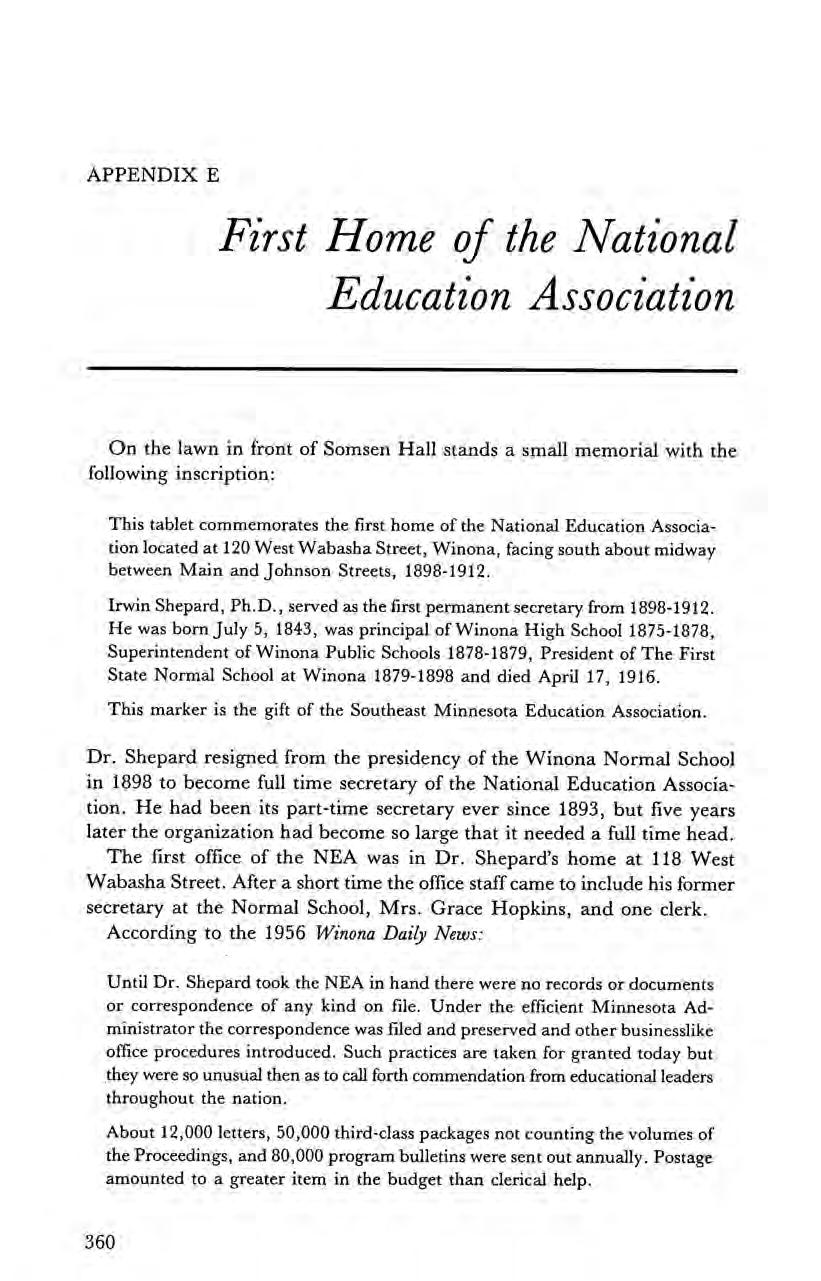
On the lawn in front of Somsen Hall stands a small memorial with the following inscription:
This tablet commemorates the first home of the National Education Association located at 120 West Wabasha Street, Winona, facing south about midway between Main and Johnson Streets, 1898-1912.
Irwin Shepard, Ph.D., served as the first permanent secretary from 1898-1912. He was born July 5, 1843, was principal of Winona High School 1875-1878, Superintendent of Winona Public Schools 1878-1879, President of The First State Normal School at Winona 1879-1898 and died April 17, 1916.
This marker is the gift of the Southeast Minnesota Education Association.
Dr. Shepard resigned from the presidency of the Winona Normal School in 1898 to become full time secretary of the National Education Association. He had been its part-time secretary ever since 1893, but five years later the organization had become so large that it neededa full time head.
The first office of the NEA was in Dr. Shepard’s home at 118 West Wabasha Street. After a short time the office staff came to include his former secretary at the Normal School, Mrs. Grace Hopkins, and one clerk.
According to the 1956 Winona Daily News:
Until Dr. Shepard took the NEA in hand there were no records or documents or correspondence of any kind on file. Under the efficient Minnesota Administrator the correspondence was filed and preserved and other businesslike office procedures introduced. Such practices are taken for granted today but they were so unusual then as to call forth commendation from educational leaders throughout the nation.
About 12,000 letters, 50,000 third-class packages not counting the volumes of the Proceedings, and 80,000 program bulletins were sent out annually. Postage amounted to a greater item in the budget than clerical help.
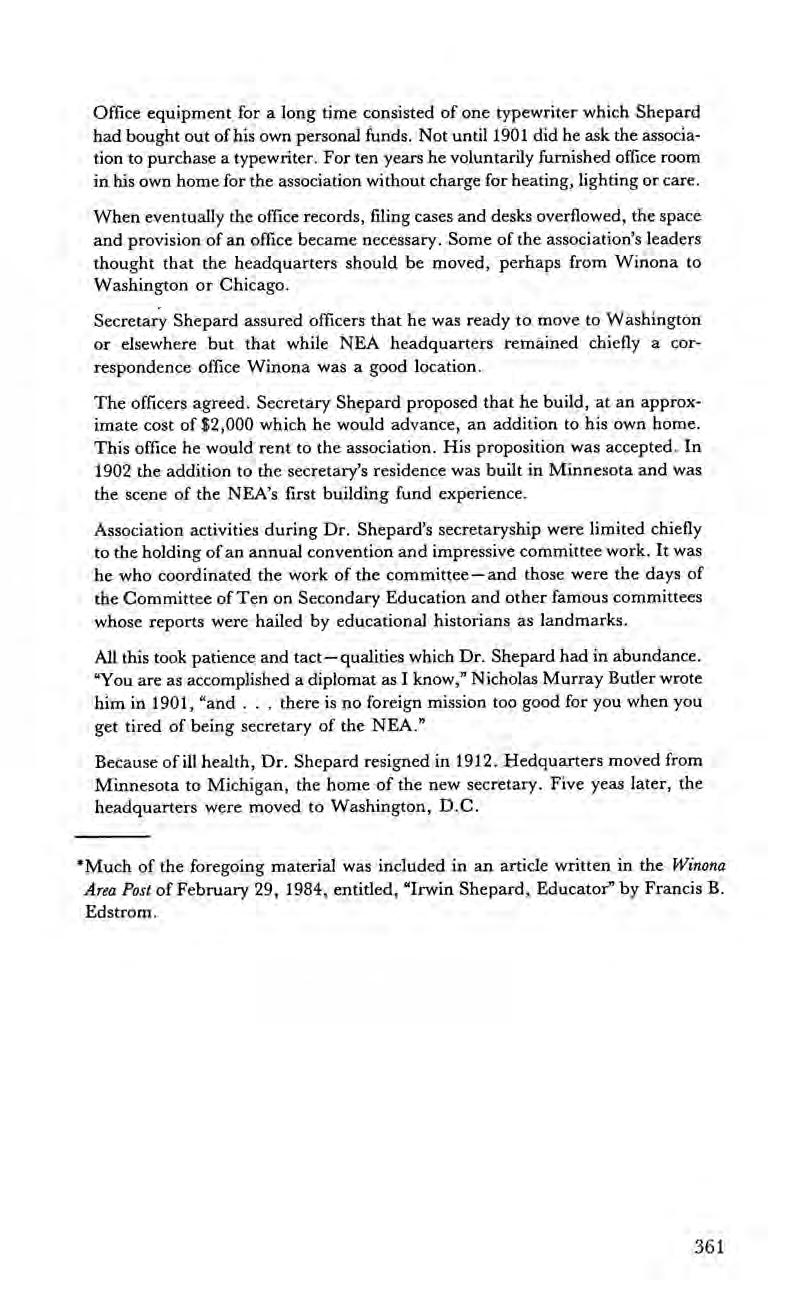
Office equipment for a long time consisted of one typewriter which Shepard had bought out of his own personal funds. Not until 1901 did he ask the association to purchase a typewriter. For ten years he voluntarily furnished office room in his own home for the association without charge for heating, lighting or care.
When eventually the office records, filing cases and desks overflowed, the space and provision of an office became necessary. Some of the association’sleaders thought that the headquarters should be moved, perhaps from Winona to Washington or Chicago.
Secretary Shepard assured officers that he was ready to move to Washington or elsewhere but that while NEA headquarters remained chiefly a correspondence office Winona was a good location.
The officers agreed. Secretary Shepard proposed that he build, at an approximate cost of $2,000 which he would advance, an addition to his own home. This office he would rent to the association. His proposition was accepted. In 1902 the addition to the secretary’s residence was built in Minnesota and was the scene of the NEA’s first building fund experience.
Association activities during Dr. Shepard’s secretaryship were limited chiefly to the holding of an annualconvention and impressive committee work. It was he who coordinated the work of the committee —and those were the days of the Committee of Ten on Secondary Education and other famous committees whose reports were hailed by educational historians as landmarks.
All this took patience and tact qualities which Dr. Shepard had in abundance. “You are as accomplished a diplomat as I know,” Nicholas Murray Butler wrote him in 1901, “and there is no foreign mission too good for you when you get tired of being secretary of the NEA.”
Because of ill health, Dr. Shepard resigned in 1912. Hedquarters moved from Minnesota to Michigan, the home of the new secretary. Five yeas later, the headquarters were moved to Washington, D.C.
*Much of the foregoing material was included in an article written in the Winona Area Post of February 29, 1984, entitled, “Irwin Shepard, Educator” by Francis B. Edstrom.
The President’s medallion is more than the insignia of office. It is a symbol of a people’s faith in education, in the responsibility of the presidential office, and in the guardianship of the College by the State of Minnesota.
The Medallion was donated in 1967 by the following:
The Medallion:
The 1967-68 students of Winona State College
The Gems:
Aquamarine Mrs. James Browning, Winona State College
Alexandrite Dr. John J. Fuller, Winona State College
Topaz Mrs. Ward Lucas, Winona, Minnesota
Garnet

Allyn S. Morgan, Jr., Winona, Minneosta
Opal Miss Floretta M. Murray, Winona State College
Diamonds Mrs. R. H. Watkins, Winona, Minnesota
The Design:
Miss Floretta M. Murray, Head of the Art Department, Winona State College
The Execution: Morgan’sJewelryCompany, Winona, and Josten’s, Owatonna, Minnesota

Abbe De La Salle, 14
American Ass’n of Teacher’s Colleges, 171
American Association of University Professors, 251, 252
American Association of University Women, 251 Academy for Schoolmasters, 15
Accreditation, 223; by North Central Association, 230, 285
Act establishing Normal Schools in Minnesota, 18, 19, 20, 21
Act organizing Territory of Minnesota, 17
Adams, O. D., 129
Admission of students, 24, 25 Admissions policies, 269 Agriculture, 65
Albany, N. Y., Normal School, 16, 23 Allen, A., 36
Allyn, Clara, 145 Allyn, Franc, 145
Alpha Epsilon Literary Society, 137, 138 Alumni Society, 212, 283
American Normal Schools Association, 86 Ames, Dr. A. E., 21 Apollo Club, 201 Annual, 159, 209
Argentine Republic, 144,145, 146 Armstrong, Clara, 145 Armstrong, Frances, 145 Arrowhead Range Club, 211 Art Club, 203
Associate in Arts, 240
Associate in Education, 240 Athletics, 136, 206, 221, 246, 276; Women’s, 205, 278
Avery, Bernice, 145
Bachelor of Arts in Education, 181, 230
Bachelor of Education, 181 Bachelor of Science, 230 Bancroft, Emma, 129 Band, 201
Bard, Agnes, 256 Barnard, Chancellor, 30 Basketball, 276
Bates, George, 279, Appendix C Benjamin, Rev. Jerry D., 293
Berry, C. H., 125,194, 195
Blakely David, 50 Blatnic, Rep. John, 225 Board of Control Act, 20 Board of Directors; see State Normal Board of Directors
Booster Club, 209, 210 Boutelle, Clarence M., 83 Boutwell, Gov. ofMass., 16 Bray, Dr. E., 21 Bridgewater, Mass., Normal School, 16, 23 Buck, H. L., 194, 195 Budd, George F., 256 Buildings, plans and specifications; First State Building, 79, 80 Buildings and Grounds, 218, 249 Business, 275 Burt, Rev. David, 22, 72
Cambodia, 292 Camille, Sister M., 256
Campus Development (70s), 305,306, 307 Carbondale, Il., Normal School, 82 Carter, Rev. James G., 15 Centennial Celebration, 254 Certificates for undergraduates, 103 Choate, Antoinette, 145 Chorpenning, Charlotte B., 152, 237 Civil War, 43 Class memorials, 158, 159 Closing of the Normal, 41 College Colors, 206 College Designation, 250 College Hall, 174 Commencement, First, 36 Common Council 78 Computer Technology, 275 Cone, R. D. (Mayor), 78 Constitution of Minnesota, 43 Continuous sessions, 106, 107 Cook, Fayette L., 53 Country Life Club, 210 Cornerstone, First Normal Building, 79 Costs, 217 Council Six, 314
Course of Study of 1870, 86; Middle Years, 177, Four-Year Curriculum, 96, 113, 114 178, 179, 180, 181, 186, 197
Couse, Mary E., 127

Four-Year Degree, 181, 182, 183
Framingham, Mass., Normal School, 16, 23 Curricular Development, 270
Franke, Hermann August, 14 Curriculum, Four-Year, 96, 113, 114 French, A. T., 214,228, 229, 230, 233, 234 Curtiss, C. C., 125 Froebel, 132, 133 Debate, 207, 208 Gage, Kelton, 261
Debating societies; see Literary Societies Garvin Heights, 221 Degrees and Programs (1975), 283, 284 Geography, 193, 194 Delta Delta Delta Literary Society, 138 Gettysburg, 44 Depression Years, 214 G. I. Bill, 240, 241, 242 Dickerson, Major O. M., 158, 159 Gildemeister, Theda, 257 Die-No-Mo, 209 Girard College, 15 Diplomas, 103 Gould, O. B., 125 Districts, 20 Graded Schools, 21 Domestic science and arts, 187 Graduate Council, 254 Donnelly, Ignatius, 43
Graduate Studies, 242, 254 Dormitory, See Buildings and Grounds
Graduation, first, 75; first four-year, 168 Drawing, 129 Graham, Mary, 144 Drew, William S., 22, 79 Gullickson, A. G., 201 DuFresne, R.A., 264, 293, 315 Gymnasium, 136 Dumke, Glenn, 251, 252 Hail Winona, 327 Eccleston, Sara, C., 145
Hamline University, 162 Ecole Normal, 14
Handwriting, 196 Edstrom Everett, 201, 255, Appendix D
Hanson, Robert, 316, 318, 319, 320 Edstrom, Harold, 201, 225 Harris, William, 132 Education in Minnesota, Courses, 191
Harwood, A. A., 52, 53 Elementary School, 136 Hays, Gary, 316 Elmer, Fanny, 124 Hecker, Johann Julius, 14 Emporia, Kansas Normal School, 82 Herbartian theory, 101 English department, 192 Heyer, Fred, 256 Enrollment, 1860-1910, 120, 122, 123
High School Teaching, Preparation for, 183 Enrollment, Middle Years, 162, 166; In the Seven-
History, 196, 197 ties, 305
Holcombe, William 21, 26, 27
Enrollment Decline, 300
Holzinger, John M., 127, 136 Ernst, Kate E., 134 Howell, Etta Hudson, 249 Establishment, 290 Huff, Henry D., 77, 78 Ethiopian Situation, 298
Human Rights Department, 299 Examinations, by accrediting agencies, 285 Hygiene, 189 Executive Secretary, (System), 247, 248 In Loco Parentis, 241, 288 External Studies, 279,280, 281 Industrial Arts, 187, 188 Faculty Register; Appendix A Industrial museum, 187 Father of Normal School, 21 IFO, 231; IFO-MEA, 313 Fifth Year Program, 251 Inglis, M. F., 152, 154 Fine Arts, 190 Institutional Affiliations, 170, 171 Finkelnburg, Wm. A., 127 International Relations Club, 208 Fire, 171, 172 Inter-Faculty Policy Council, 231 First Minnesota Regiment, 43 Kappa Delta Pi, 207 First Normal Board, 21 Karow, Don, 20t First Normal Building, 33 Kiehle, David L., 106 First State Building, 79, 80 Kindergarten, 101, 131 Fockens, Anna, 124 Korean Conflict, 252 Football Field, 221 Kryzsko Commons, 257, 259, 307 Ford, Dr. John D., 21, 22, 44,46, 71, 194, 195 Kryzsko, S. J., 194,195, 248, 257, 259 Foreign Language, 193 La Crosse State, 310 Foreign Studies, 281 League of Women Voters, 208 Fort Snelling, 43 Land Grant Act, 140
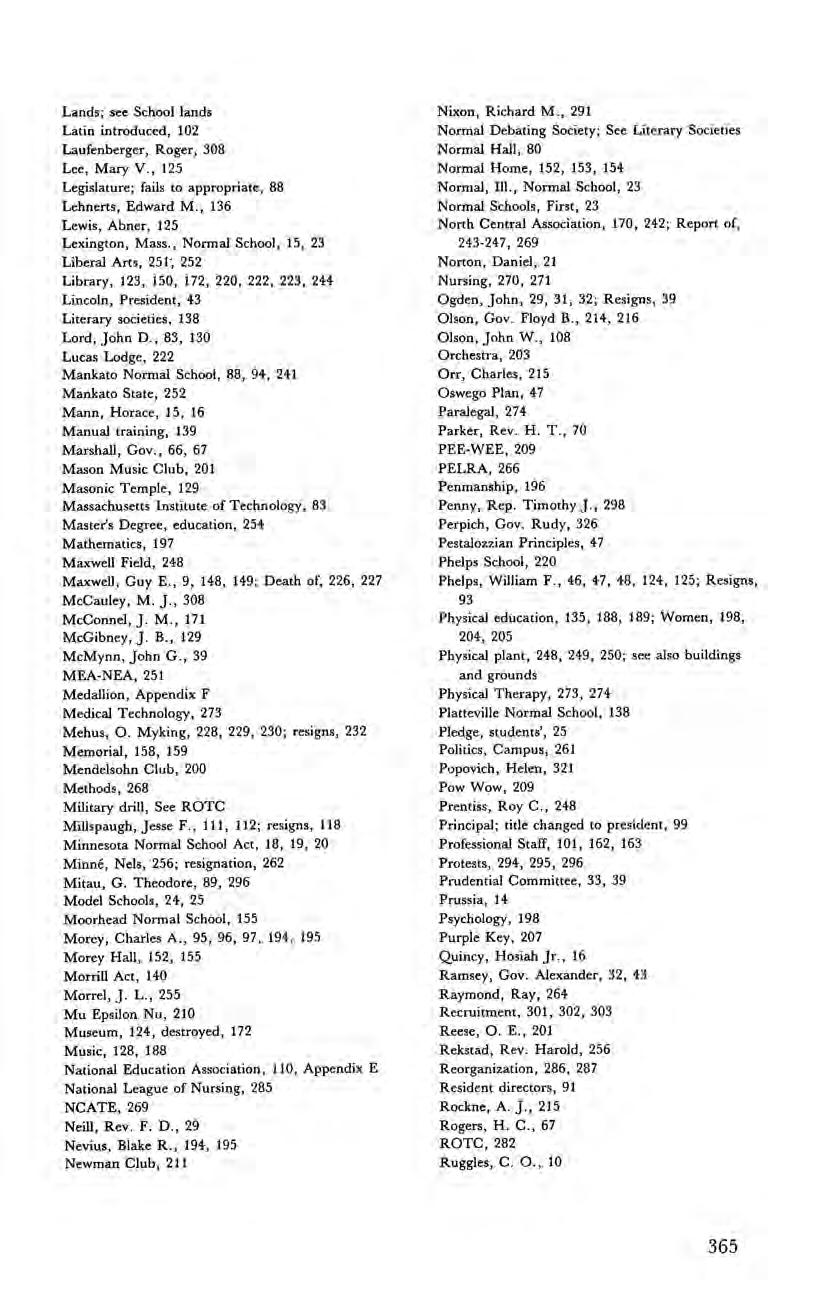
Lands; see Schoollands Latin introduced, 102 Laufenberger,Roger, 308 Lee, Mary V., 125 Legislature; fails to appropriate, 88 Lehnerts, Edward M., 136 Lewis, Abner, 125
Lexington, Mass., Normal School, 15, 23 Liberal Arts, 251, 252 Library, 123, 150,172, 220, 222, 223, 244 Lincoln, President, 43 Literary societies, 138 Lord, John D., 83, 130 Lucas Lodge, 222
Mankato Normal School, 88,94, 241 Mankato State, 252 Mann, Horace, 15, 16 Manual training, 139 Marshall, Gov., 66, 67
Mason Music Club, 201 Masonic Temple, 129 Massachusetts Institute of Technology, 83 Master’s Degree, education, 254 Mathematics, 197 Maxwell Field, 248
Maxwell, Guy E., 9, 148, 149; Death of, 226, 227
McCauley, M. J., 308
McConnel, J. M., 171 McGibney, J. B., 129
McMynn, John G., 39 MEA-NEA, 251 Medallion, Appendix F Medical Technology, 273
Mehus, O. Myking, 228, 229, 230; resigns, 232 Memorial, 158, 159 Mendelsohn Club, 200 Methods, 268 Military drill, See ROTC Millspaugh, Jesse F., 111, 112; resigns, 118 Minnesota Normal School Act, 18,19, 20 Minné, Nels, 256; resignation, 262 Mitau, G. Theodore, 89, 296 Model Schools, 24, 25
Moorhead Normal School, 155
Morey, Charles A., 95,96, 97, 194, 195 Morey Hall, 152, 155 Morrill Act, 140 Morrel, J. L., 255 Mu Epsilon Nu, 210 Museum, 124, destroyed, 172 Music, 128, 188
National Education Association, 110, Appendix E
National League of Nursing, 285 NCATE, 269
Neill, Rev. F. D., 29 Nevius, Blake R., 194, 195 Newman Club, 211
Nixon, Richard M., 291 Normal Debating Society; See Literary Societies Normal Hall, 80 Normal Home, 152, 153, 154 Normal, Ill., Normal School, 23 Normal Schools, First, 23 North Central Association, 170, 242; Report of, 243-247, 269 Norton, Daniel, 21 Nursing, 270, 271 Ogden, John, 29, 31, 32; Resigns, 39 Olson, Gov. Floyd B., 214, 216 Olson, John W., 108 Orchestra, 203 Orr, Charles, 215 Oswego Plan, 47 Paralegal, 274 Parker, Rev. H. T., 70 PEE-WEE, 209
PELRA, 266 Penmanship, 196 Penny, Rep. Timothy J., 298 Perpich, Gov. Rudy, 326 Pestalozzian Principles, 47 Phelps School, 220 Phelps, William F., 46, 47, 48, 124, 125; Resigns, 93
Physical education, 135,188, 189; Women, 198, 204, 205
Physical plant, 248, 249, 250; see also buildings and grounds Physical Therapy, 273, 274 Platteville Normal School, 138 Pledge, students’, 25 Politics, Campus, 261 Popovich, Helen, 321 Pow Wow, 209 Prentiss, Roy C., 248 Principal; title changed to president, 99 Professional Staff, 101, 162, 163 Protests, 294, 295, 296 Prudential Committee, 33, 39 Prussia, 14 Psychology, 198 Purple Key, 207 Quincy, Hosiah Jr., 16 Ramsey, Gov. Alexander, 32, 43 Raymond, Ray, 264 Recruitment, 301, 302, 303 Reese, O. E., 201 Rekstad, Rev. Harold, 256 Reorganization, 286, 287 Resident directors, 91 Rockne, A. J., 215 Rogers, H. C., 67 ROTC, 282 Ruggles, C. O., 10
Rural Education, 191 Rutgers, 33
Sabbatical leaves, 230
St. Cloud Normal School, 88, 94
St. Cloud State, 252
Sanborn’s Addition, 78
Sarmiento, General D. F., 144
Sauer, Rev. Alfred, 194, 195
School lands, see Land Grant Act
School paper, see Winonan Science, 198
Searle, Rodney, 302
Selle, Erwin S., 10
Seventy-Fifth Anniversary, 224, 225, 226
Sex Distribution of Student Body, 167
Sheehan, Frank A., 194, 195 Sheldon, Edward, 47
Shepard Hall, 220
Shepard, Irwin, 99, 100,101; Resigns, 109
Sibley, Gov. Henry H., 18
Simpson, Thomas, 79, 92, 125, 194, 195
Simpson, Mrs. Thomas (Margaret), 83, 92
Simson, George, 83
Smith, E. 8., 22
Smog, 259
Social Science, 199 Soldiers’ Orphans Home, 82, 121
Somsen, S. H., 194, 195
Song, School, 152, 327
South America; see Argentine Republic Specialist Degree, 272 Speech, 199, 200
Stark, Thomas, 322, 323, 324
State Normal Board of Directors; Established, 19; Revised, 155, 286
Stearns, J. W., 29, 144
Stowe, Edmond, 15
Students’ Loan Fund, 142, 143
Student Organizations, 200
Subscription, 32
Subscriptions to Winona Normal School, 22 Sullivan, Senator George H., 158
Summer Training Schools for Teachers, 106, 107, 108
Sumpter, 37, 43
Superintendents of Public Instruction, 30, 99, 106, 171
Swift, Mary, 15
Talbot, Jean, 10, 250
Teacher Education, 267, 268 Teachers Institute, 29
Tearse, W. P., 194, 195
Thesis Option, 254
Timanus, Sarah, 56
Title Nine, 278
Tomorrow, 325
Tozier, Roy, 231

Trenton, N. J., Normal School, 16 Tuition, 25 Turmoil, 320, 321 Unionization, 313 University for Winona, 22, 23 University of Minnesota, 310 University Status, 307, 308,309, 310, 311 Veterans, 241
Viet Nam Years, 290,291, 294, 296 W Club, 206, 207
Walker, V. J., 41, 72 War Annual, 159 Watkins, Mr. and Mrs. Paul, 203 Wendland, R. T., 256
Wenonah Players, 204 West Lodge, 220 Wheeler, Sarah L., 125
Whitewater Normal, Phelps becomes President, 93 Willson, Samuel B., 174 Winonan, 208, 209 Winona, City of, 33 Winona Normal Bulletin, 143 Winona Normal School, established, 118; closed for Civil War, 41; reopened, 44
Winona Plan, 107 Winona Public Schools, Shepard Superintendent of, 99; Phelps Superintendent of, 93 Winona Republican, 52
Winona Society of Arts, Sciences and Letters, 126
Winona State College, named, 250 Winona State Teachers College, 161, 181 Winonah, 209 Woodman Collection, 126
World War I, 158, 160 World War I, 232, 240
W.P.A., 248 WSU Foundation, 282 Yale, Wm. H., 79 Youmans, Edward L., 44, 79

